Please see the Transcriber’s Notes at the end of this text.

PICTURED PUZZLES AND
WORD PLAY
BY THE SAME AUTHOR
UNIFORM WITH THIS VOLUME
THE TWENTIETH CENTURY
STANDARD PUZZLE BOOK
Crown 8vo. Cloth Extra. Gilt.
FRONTISPIECE
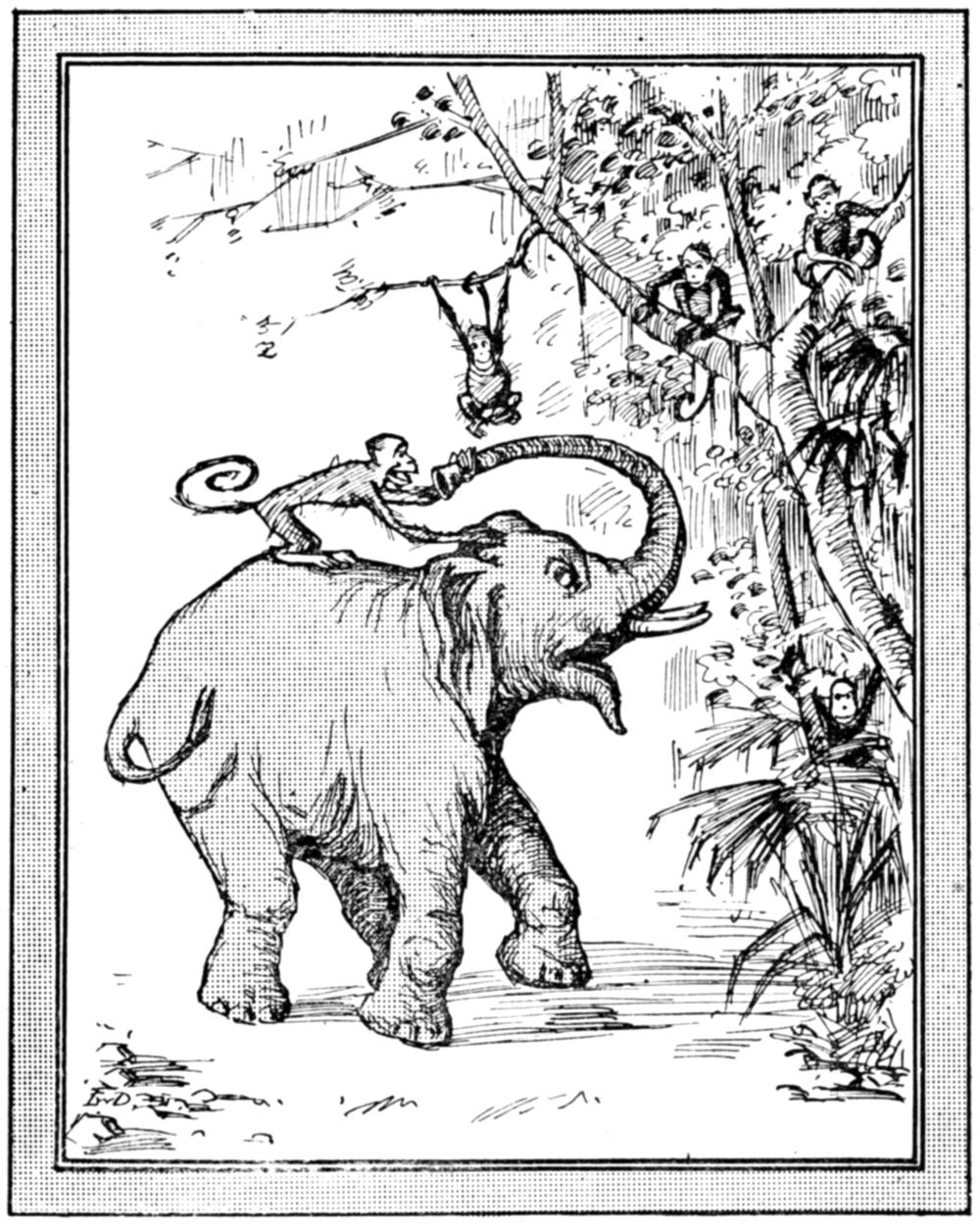
Can you discover by anagram what the ape is saying to the elephant, from this descriptive sentence?
A sly tree-ape, he tries a rum telephone.
Exactly the same letters must be used.
Pictured Puzzles
AND
Word Play
A Companion to
THE TWENTIETH CENTURY STANDARD
PUZZLE BOOK
EDITED BY
A. CYRIL PEARSON, M.A.
AUTHOR OF
“100 Chess Problems,” “Anagrams, Ancient and Modern,”
Etc.
PROFUSELY ILLUSTRATED
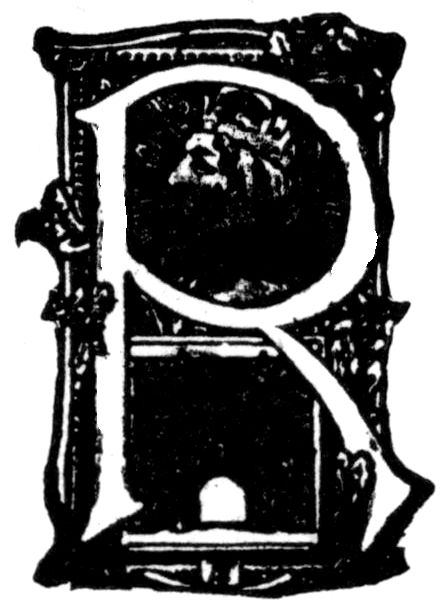
LONDON
GEORGE ROUTLEDGE & SONS, LTD.
NEW YORK: E. P. DUTTON & CO.
CONTENTS.
| Frontispiece Puzzle | |
| PAGE | |
| Pictured Puzzles and Word Play | 1 |
| Enigmas, Charades, Puzzles, &c., &c. | 130 |
| Odds and Ends | 188 |
| Solutions to Pictured Puzzles | 202 |
| Solutions to Word Play | 283 |
| Solutions to Odds and Ends | 375 |
[1]
PICTURED PUZZLES
No. I.—A GOOD SPECIMEN
Here is a nest of magic squares, seven of them within the four corners of one diagram:—
| 149 | 16 | 33 | 196 | 47 | 197 | 44 | 208 | 42 | 203 | 57 | 194 | 38 | 54 | 217 |
| 177 | 62 | 183 | 52 | 213 | 59 | 160 | 15 | 161 | 85 | 156 | 190 | 105 | 28 | 49 |
| 56 | 147 | 201 | 146 | 75 | 155 | 2 | 220 | 3 | 153 | 53 | 26 | 209 | 79 | 170 |
| 162 | 76 | 148 | 180 | 83 | 187 | 41 | 104 | 22 | 195 | 145 | 60 | 78 | 150 | 64 |
| 74 | 176 | 4 | 124 | 119 | 37 | 154 | 48 | 186 | 138 | 109 | 102 | 222 | 50 | 152 |
| 221 | 24 | 175 | 63 | 86 | 116 | 93 | 135 | 94 | 127 | 140 | 163 | 51 | 202 | 5 |
| 10 | 215 | 69 | 159 | 134 | 95 | 98 | 126 | 115 | 131 | 92 | 67 | 157 | 11 | 216 |
| 219 | 19 | 165 | 1 | 136 | 97 | 130 | 113 | 96 | 129 | 90 | 225 | 61 | 207 | 7 |
| 8 | 205 | 84 | 191 | 87 | 158 | 111 | 100 | 128 | 68 | 139 | 35 | 142 | 21 | 218 |
| 214 | 34 | 144 | 27 | 112 | 99 | 133 | 91 | 132 | 110 | 114 | 199 | 82 | 192 | 12 |
| 14 | 123 | 55 | 106 | 117 | 189 | 72 | 178 | 40 | 88 | 107 | 120 | 171 | 103 | 212 |
| 206 | 89 | 181 | 166 | 143 | 39 | 185 | 122 | 204 | 31 | 81 | 46 | 45 | 137 | 20 |
| 58 | 101 | 17 | 80 | 151 | 71 | 224 | 6 | 223 | 73 | 173 | 200 | 25 | 125 | 168 |
| 118 | 198 | 43 | 174 | 13 | 167 | 66 | 211 | 65 | 141 | 70 | 36 | 121 | 164 | 108 |
| 9 | 210 | 193 | 30 | 179 | 29 | 182 | 18 | 184 | 23 | 169 | 32 | 188 | 172 | 77 |
As each border is removed a fresh magic square remains, in which the numbers in the cells of each row, column, and diagonal add up to the same sum, while each of these sums is a multiple of the central 113.
[2]
No. II.—A BORDERED DIAMOND
By G. Slater
| 1 | ||||||||||||||||||||||||
| 91 | 117 | |||||||||||||||||||||||
| 3 | 20 | 160 | ||||||||||||||||||||||
| 27 | 25 | 129 | 65 | |||||||||||||||||||||
| 156 | 154 | 42 | 38 | 165 | ||||||||||||||||||||
| 161 | 15 | 138 | 36 | 103 | 26 | |||||||||||||||||||
| 130 | 153 | 136 | 124 | 81 | 54 | 159 | ||||||||||||||||||
| 162 | 147 | 120 | 69 | 75 | 135 | 151 | 52 | |||||||||||||||||
| 39 | 22 | 55 | 112 | 111 | 110 | 33 | 64 | 78 | ||||||||||||||||
| 4 | 152 | 76 | 57 | 56 | 62 | 61 | 63 | 93 | 7 | |||||||||||||||
| 168 | 146 | 139 | 100 | 99 | 98 | 97 | 96 | 102 | 142 | 158 | ||||||||||||||
| 6 | 21 | 29 | 45 | 44 | 43 | 49 | 48 | 47 | 133 | 51 | 104 | |||||||||||||
| 157 | 80 | 30 | 88 | 87 | 86 | 85 | 84 | 83 | 82 | 140 | 90 | 13 | ||||||||||||
| 53 | 41 | 134 | 123 | 122 | 121 | 127 | 126 | 125 | 52 | 145 | 79 | |||||||||||||
| 10 | 132 | 89 | 74 | 73 | 72 | 71 | 70 | 34 | 16 | 167 | ||||||||||||||
| 105 | 67 | 35 | 109 | 108 | 114 | 113 | 50 | 155 | 143 | |||||||||||||||
| 5 | 116 | 137 | 60 | 59 | 58 | 115 | 17 | 14 | ||||||||||||||||
| 144 | 19 | 107 | 95 | 101 | 94 | 23 | 9 | |||||||||||||||||
| 11 | 106 | 68 | 46 | 31 | 148 | 40 | ||||||||||||||||||
| 118 | 77 | 37 | 41 | 18 | 8 | |||||||||||||||||||
| 92 | 38 | 128 | 24 | 131 | ||||||||||||||||||||
| 163 | 148 | 149 | 166 | |||||||||||||||||||||
| 12 | 130 | 2 | ||||||||||||||||||||||
| 66 | 164 | |||||||||||||||||||||||
| 169 | ||||||||||||||||||||||||
It is a perfect magic diamond as it stands, and equally perfect are the diamonds that remain when each border of cells is removed, as is indicated by the lines.
WORD PLAY
1. A PARADOX
And claim, through the passage of years
That neither the pages of Johnson disclose,
While either in Murray appears.
[3]
No. III.—A MULTIFOLD MAGIC SQUARE
Here is a magic square of 81 cells.
| 53 | 8 | 71 | 28 | 73 | 10 | 51 | 6 | 69 |
| 62 | 44 | 26 | 19 | 37 | 55 | 60 | 42 | 24 |
| 17 | 80 | 35 | 61 | 1 | 46 | 15 | 78 | 33 |
| 66 | 21 | 30 | 14 | 59 | 50 | 34 | 79 | 16 |
| 3 | 39 | 75 | 77 | 41 | 5 | 25 | 43 | 61 |
| 48 | 57 | 12 | 32 | 23 | 68 | 70 | 7 | 52 |
| 31 | 76 | 13 | 72 | 27 | 36 | 11 | 56 | 47 |
| 22 | 40 | 58 | 9 | 45 | 81 | 74 | 38 | 2 |
| 67 | 4 | 49 | 54 | 63 | 18 | 29 | 20 | 65 |
If divided, as is shown, into 9 small squares, each of these is also a magic square, and yet another magic square is formed by the totals of these 9 squares arranged thus:—
| 396 | 333 | 378 |
| 351 | 369 | 387 |
| 360 | 405 | 342 |
[4]
No. IV.—A MODEL MAGIC SQUARE
This magic square, which has in its cells the first sixteen numbers, is so constructed that these add up to 34 in very many ways.
| 4 | 15 | 14 | 1 |
| 9 | 6 | 7 | 12 |
| 5 | 10 | 11 | 8 |
| 16 | 3 | 2 | 13 |
How many of these, in addition to the usual rows, columns, and diagonals, can you discover? They must, of course, be in some sort symmetrical.
2. A PREDOMINANT VOWEL
Can you fill in the missing letters which are needed to turn the oft-repeated “u” below into rhyming verse:—
.u... .u.., .u. .u..u.. .u..u... ..u...u. ..u..;
...u.. .u...., .u.. .u..u.. ..u... .u... .u... u..u..,
U. .u...., .u.. ..u..-.u.u., .u..u.’. .u...u. .u..
[5]
No. V.—TESSELATED DIAMOND
By G. Slater
| 106 | ||||||||||||||||||||
| 13 | 109 | |||||||||||||||||||
| 113 | 16 | 14 | ||||||||||||||||||
| 12 | 110 | 107 | 15 | |||||||||||||||||
| 42 | 9 | 11 | 100 | 78 | ||||||||||||||||
| 74 | 81 | 112 | 10 | 56 | 71 | |||||||||||||||
| 67 | 53 | 87 | 111 | 83 | 43 | 34 | ||||||||||||||
| 27 | 49 | 50 | 35 | 59 | 63 | 84 | 6 | |||||||||||||
| 96 | 26 | 46 | 72 | 68 | 39 | 37 | 115 | 7 | ||||||||||||
| 30 | 95 | 97 | 76 | 75 | 33 | 85 | 3 | 116 | 114 | |||||||||||
| 91 | 31 | 28 | 94 | 40 | 61 | 82 | 120 | 2 | 5 | 117 | ||||||||||
| 92 | 90 | 25 | 64 | 89 | 47 | 41 | 119 | 121 | 8 | |||||||||||
| 29 | 93 | 58 | 62 | 54 | 69 | 86 | 4 | 118 | ||||||||||||
| 32 | 66 | 60 | 57 | 73 | 52 | 80 | 1 | |||||||||||||
| 44 | 79 | 65 | 19 | 45 | 48 | 36 | ||||||||||||||
| 51 | 38 | 104 | 18 | 55 | 70 | |||||||||||||||
| 88 | 22 | 103 | 105 | 77 | ||||||||||||||||
| 99 | 23 | 20 | 102 | |||||||||||||||||
| 100 | 98 | 17 | ||||||||||||||||||
| 21 | 101 | |||||||||||||||||||
| 24 | ||||||||||||||||||||
In this ingenious diamond all rows and both diagonals add up to 671; in the four corner diamonds all add up to 244; and in the central diamond, and the 16 rows of threes surrounding it, to 183.
3. AN ENIGMA
And both I sigh and see
Joined to my third, which much perplexed
And sorely puzzled me.
’Twas fifty, and ’twas something more,
Reversed ’twas scarce an ell,
With first and next it forms a whole
Clear as a crystal bell.
What is my whole? A splendid tear
Upheld in cruel thrall;
Blow soft, ye gales, bright sun appear!
And bid me gently fall.
[6]
No. VI.—MAGIC SQUARE BY MULTIPLICATION
Here is a magic square, in which the rows, columns, and diagonals yield the same product, 4096, by multiplication:—
| 128 | 1 | 32 |
| 4 | 16 | 64 |
| 8 | 256 | 2 |
It will be seen that the numbers in this square, 1, 2, 4, 8, 16, 32, 64, 128, 256, are in regular progression, and 4096 is also the cube of the central 16.
[7]
No. VII.—ANOTHER BORDERED MAGIC SQUARE
Here is quite a good example of a bordered magic square of sixty-four cells:—
| 1 | 56 | 55 | 11 | 53 | 13 | 14 | 57 |
| 63 | 15 | 47 | 22 | 42 | 24 | 45 | 2 |
| 62 | 49 | 25 | 40 | 34 | 31 | 16 | 3 |
| 4 | 48 | 28 | 37 | 35 | 30 | 17 | 61 |
| 5 | 44 | 39 | 26 | 32 | 33 | 21 | 60 |
| 59 | 19 | 38 | 27 | 29 | 36 | 46 | 6 |
| 58 | 20 | 18 | 43 | 23 | 41 | 50 | 7 |
| 8 | 9 | 10 | 54 | 12 | 52 | 51 | 64 |
It is a perfect specimen itself, and as each border is removed a fresh perfect magic square is revealed.
4. A CHARADE
Transpose one for my second;
My whole, a biped, quick or dead,
Is dainty reckoned.
5. BYRON’S ENIGMA
But in infancy ever am known;
I’m a stranger alike to the fool and the sage,
And though I’m distinguish’d in history’s page
I always am greatest alone.
You may search all the sky—I’m not there;
In the morning and evening—though not in the noon—
You may plainly perceive me—for, like a balloon,
I am midway suspended in air.
I am never in sorrow nor gloom;
Though in wit and in wisdom I equally reign,
I’m the heart of all sin, and have long lived in vain,
Yet I ne’er shall be found in the tomb!
[8]
No. VIII.—A HARDY ANNUAL
A magic square can be formed with the 81 numbers from 172 to 252 inclusive, which in all its rows, columns, and diagonals will total 1908. It may interest our solvers to complete the square.
| 216 | 175 | 224 | 240 | 199 | 248 | |||
| 247 | 215 | 174 | 190 | 239 | 207 | |||
| 206 | 246 | 214 | 230 | 198 | 238 | |||
| 213 | 172 | 221 | ||||||
| 244 | 212 | 180 | ||||||
| 203 | 252 | 211 | ||||||
| 186 | 226 | 194 | 210 | 178 | 218 | |||
| 217 | 185 | 234 | 250 | 209 | 177 | |||
| 176 | 225 | 184 | 200 | 249 | 208 |
We have filled in, as a solid start, 45 of the 81 cells.
[9]
No. IX.—ANOTHER “ANNO DOMINI”
This magic square adds up in rows, columns, and diagonals to 1908:—
| 469 | 484 | 472 | 483 |
| 481 | 474 | 478 | 475 |
| 482 | 471 | 485 | 470 |
| 476 | 479 | 473 | 480 |
Can you decide in how many other symmetrical ways the same total is to be made?
[10]
No. X.—A DOMINO MAGIC SQUARE
In this magic square the rows, columns, and diagonals add up always to 33.
| ● | ● | ● | ● | ● | ● | ● | ● | ● | ||||||||||
| ● | ● | ● | ● | ● | ● | |||||||||||||
| ● | ● | ● | ● | ● | ● | ● | ● | ● | ||||||||||
| ● | ● | ● | ||||||||||||||||
| ● | ● | ● | ||||||||||||||||
| ● | ● | ● | ||||||||||||||||
| ● | ● | ● | ● | ● | ||||||||||||||
| ● | ● | |||||||||||||||||
| ● | ● | ● | ● | ● | ||||||||||||||
| ● | ● | ● | ● | ● | ● | ● | ● | |||||||||||
| ● | ● | ● | ● | ● | ||||||||||||||
| ● | ● | ● | ● | ● | ● | ● | ● | |||||||||||
| ● | ● | ● | ● | ● | ● | |||||||||||||
| ● | ● | |||||||||||||||||
| ● | ● | ● | ● | ● | ● | |||||||||||||
| ● | ● | ● | ● | ● | ● | ● | ● | |||||||||||
| ● | ● | ● | ||||||||||||||||
| ● | ● | ● | ● | ● | ● | ● | ● | |||||||||||
| ● | ● | ● | ● | |||||||||||||||
| ● | ● | ● | ● | ● | ||||||||||||||
| ● | ● | ● | ● | |||||||||||||||
| ● | ● | ● | ● | ● | ● | ● | ● | |||||||||||
| ● | ● | ● | ● | |||||||||||||||
| ● | ● | ● | ● | ● | ● | ● | ● | |||||||||||
| ● | ● | ● | ● | ● | ● | ● | ||||||||||||
| ● | ● | ● | ● | ● | ||||||||||||||
| ● | ● | ● | ● | ● | ● | ● | ||||||||||||
| ● | ● | ● | ● | ● | ● | |||||||||||||
| ● | ● | |||||||||||||||||
| ● | ● | ● | ● | ● | ● | |||||||||||||
Can you rearrange it so that the first stone (three-ace) shall occupy the centre, now filled by the double six, and it shall still add up in all ways to 33?
6. SHIFTING LETTERS
Till you cut off my head;
Then as black as a coal,
Or a mortal instead.
We with science are found,
Read us back from the last
And we live underground.
[11]
No. XI.—CHESS AND NUMBERS
The arrangement of numbers in the 36 cells of this square discloses a very close affinity between chess and arithmetic.
| 30 | 21 | 6 | 15 | 28 | 19 |
| 7 | 16 | 29 | 20 | 5 | 14 |
| 22 | 31 | 8 | 35 | 18 | 27 |
| 9 | 36 | 17 | 26 | 13 | 4 |
| 32 | 23 | 2 | 11 | 34 | 25 |
| 1 | 10 | 33 | 24 | 3 | 12 |
Can you follow this out?
7. A GOOD CHARADE
By Horace Smith, one of the authors of
“Rejected Addresses.”
All prejudice must bend the knee before its iron will;
Yet “Onward!” is the Briton’s cry—a cry that doth express
A holy work but half begun, and speaks of hopefulness.
And in the Senate’s lordly halls sit my second and my third.
Strange paradox, though for my first my total is designed,
Sad marks of vice and ignorance we in that whole may find.
[12]
No. XII.—NUMBERS PATIENCE
Those who combine a fancy for “Patience” with some skill in numbers will find amusement in filling the empty cells of this diagram with appropriate numbers, each of which must consist of two figures:—
| 17 | 24 | |||
| 32 | 46 | |||
| 14 | ||||
| 19 | 16 | |||
| 22 | 20 |
It is required that each of the rows across from side to side shall add up, when all the cells are filled, to 143 exactly. No number must be used more than once.
[13]
No. XIII.—THE WINDMILL
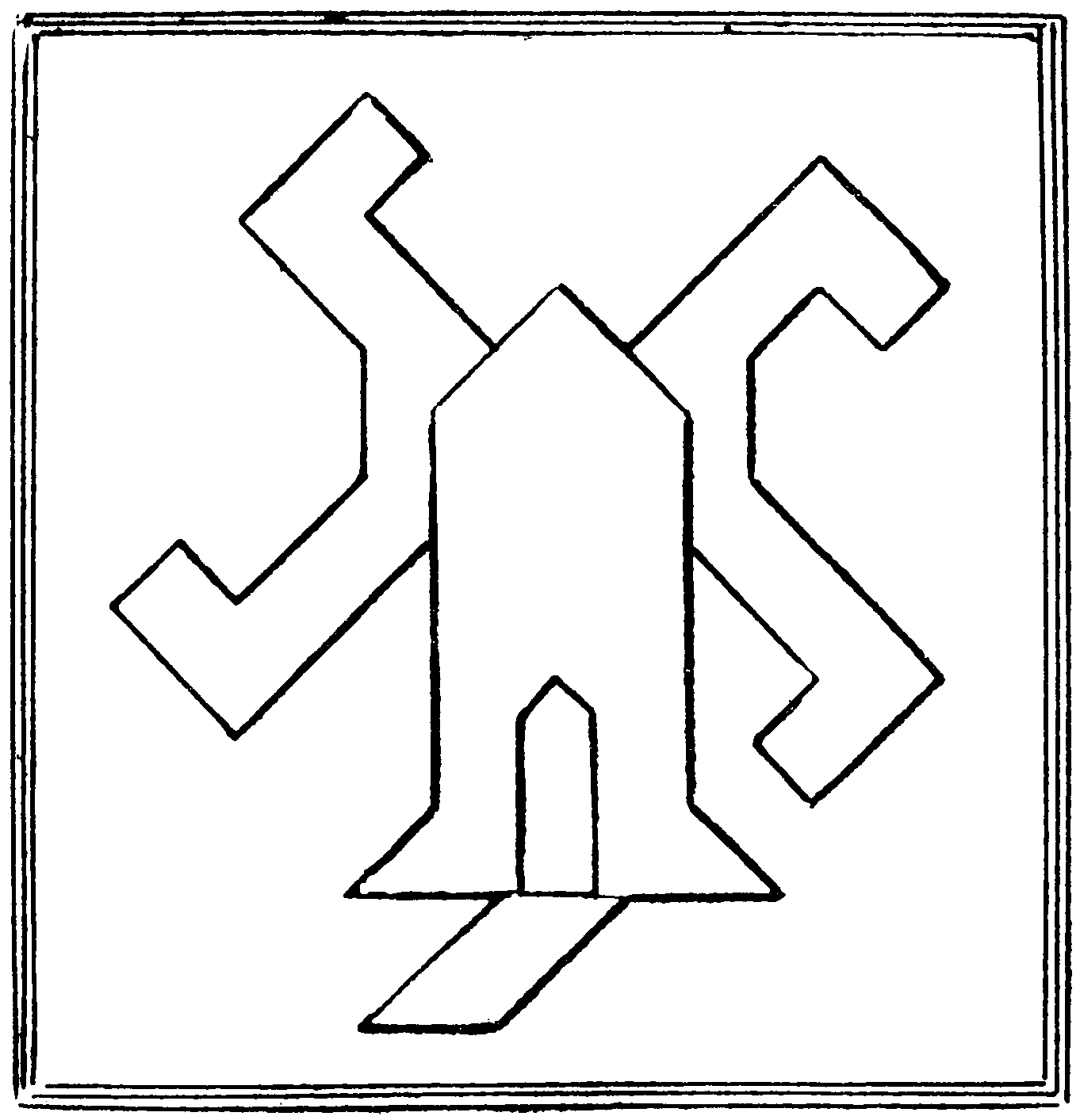
Can you divide a square into 15 parts, which can be built up into this windmill?
8. THRICE BEHEADED
Beheaded I lead upward more or less;
Again—with varied fragrance I am rife;
Again—but little value I express.
[14]
No. XIV.—A NEST OF RECTANGLES
In this nest of 49 squares it is possible to count a great number of distinct and interlacing figures, whose opposite sides are equal, and whose angles are all right angles.
Can you decide exactly the number of these rectangles, and say how many of them are square?
9. AN ENIGMA
A victory was won by me.
Behead me, and I may be found
In water or on hilly ground.
Behead again, and then transpose,
A snare my letters now disclose.
If yet again my head you sever,
No matter how sharp-set or clever
’Tis all in vain you look about,
For no one yet has found me out.
[15]
No. XV.—ANOTHER DOMINO MAGIC SQUARE
Can you, using all the dominoes except double five, five-six, and double six, construct with the twenty-five stones a magic square that adds up in all rows, columns, and diagonals to 27, and in which the stones in the cells marked by the same figures in this diagram also add up to that number?
| 2 | 1 | 2 | ||
| 4 | 3 | 4 | ||
| 1 | 3 | 3 | 1 | |
| 4 | 3 | 4 | ||
| 2 | 1 | 2 |
[16]
No. XVI.—DOMINO PATIENCE
The problem is to construct, with all the twenty-eight stones, a domino pyramid of seven stages, starting with a single stone, and adding one stone on each successive stage.
The stones must be so arranged that the number of pips in any row or column are in all cases exactly three times the number of half-dominoes of which that line or column is composed. There are many solutions to exercise the solver’s patience.
10. LEGAL PLEASANTRIES
“Now I’d bet, were we not in this place,
That my first is my second a bottle of port,”
Then bright with my whole shone his face.
11. RIVALS ON THE ROAD
Six horse buses and four motor buses travel each hour from Temple Bar to the Bank. The horses take 15 minutes, and the motors 10 minutes on the journey.
If I come to Temple Bar, and wish to reach the Bank as soon as possible, shall I take the first horse bus that turns up, or wait for a motor? It must be assumed that I can only see a bus as it actually passes me.
[17]
No. XVII.—A FRIENDLY HINT
The father of this venturesome lad, who was on the point of breaking out of bounds, came on the scene just in time to warn him in a sentence of nine words, five of which were “Never throw a leg, lad.”
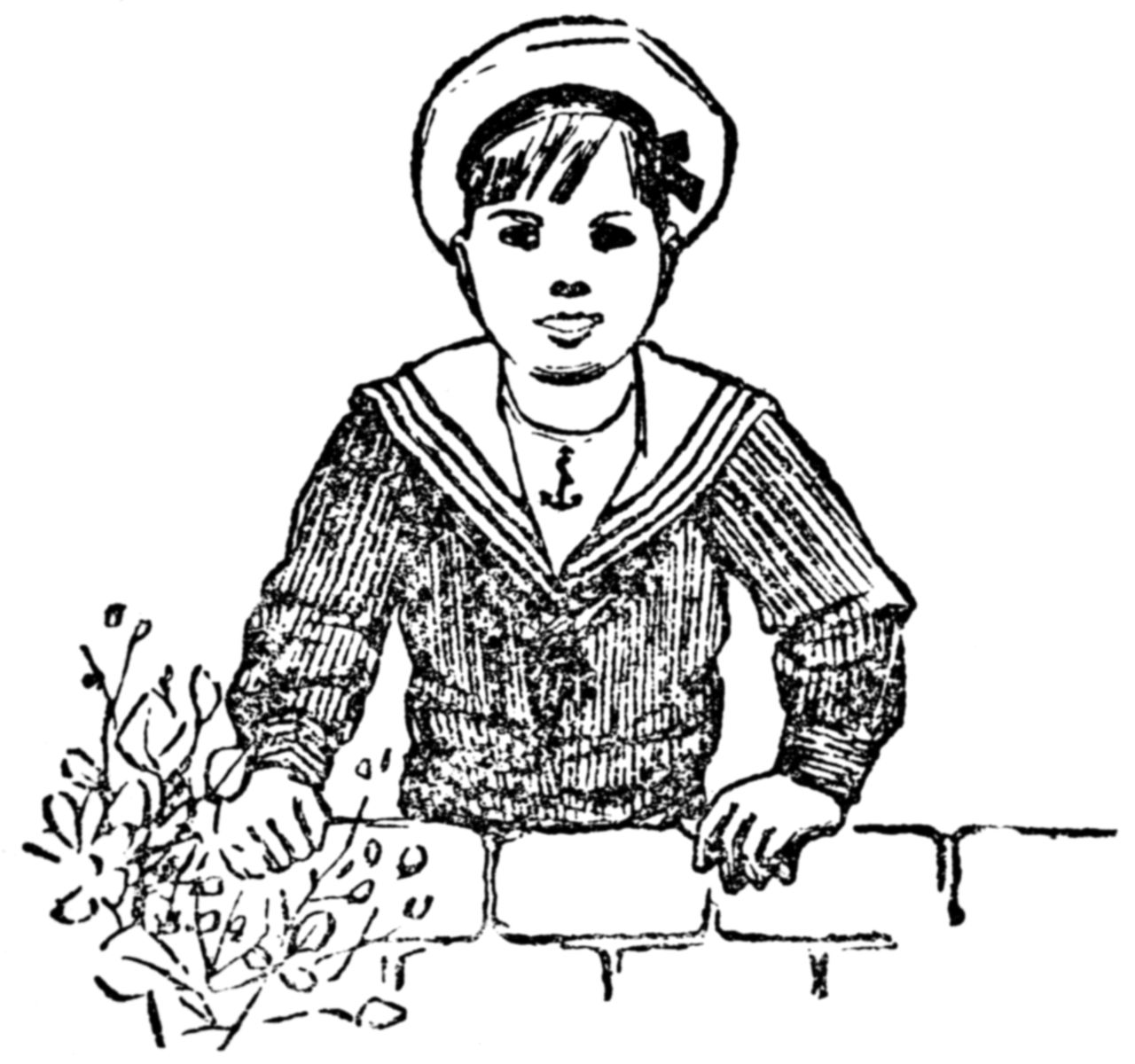
Can you supply the other four words, which are spelt with exactly the same letters?
[18]
No. XVIII.—CATASTROPHE
In this picture we see that a cat has sprung upon the table to interview the parrot.
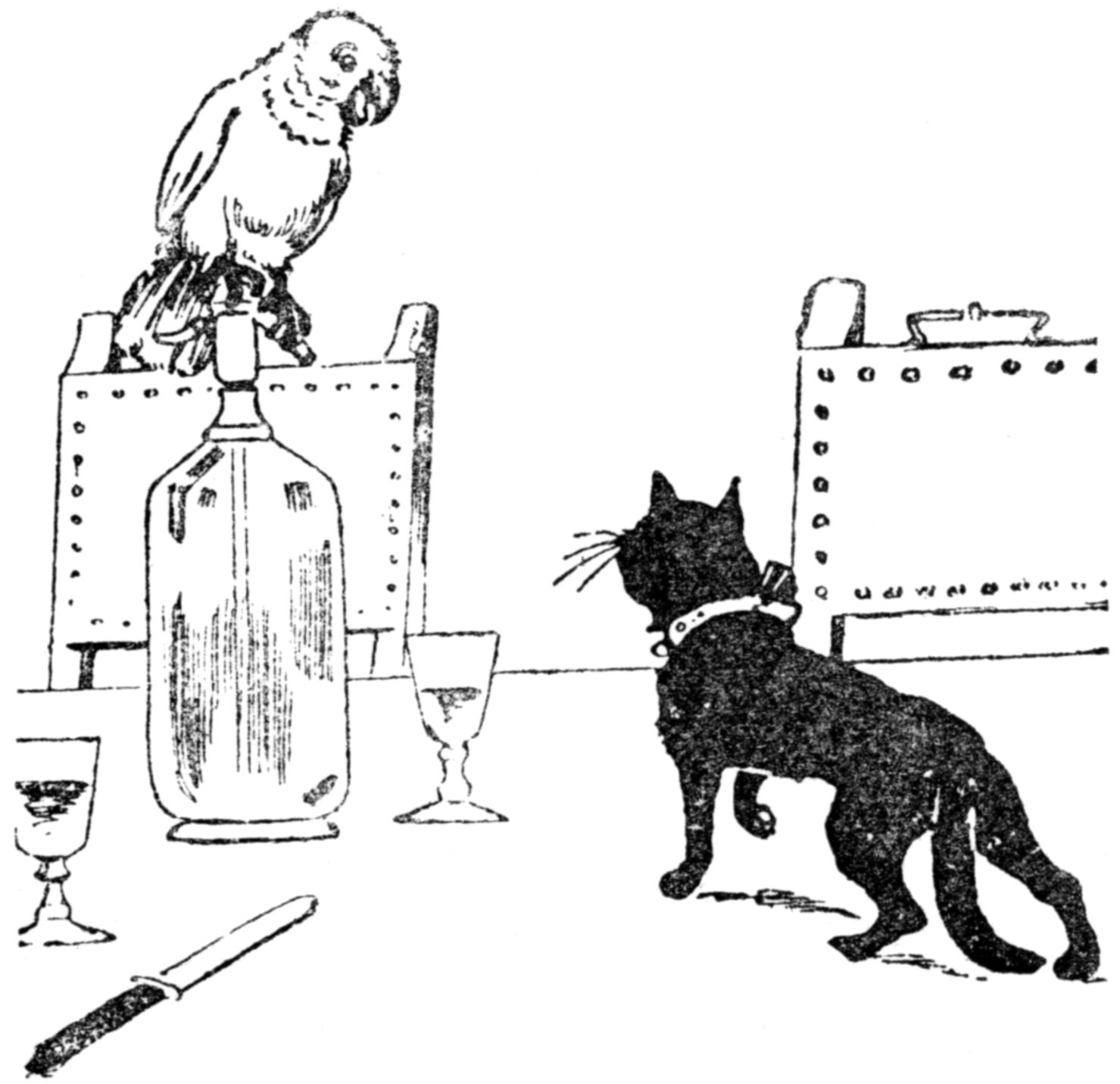
The title “Catastrophe” recast by anagram, tells the parrot’s happy thought at this critical moment, and the appropriate sentence,
“New parrot-stand in a house,”
tells, also by anagram, how he put this into instant operation.
12. A HISTORICAL CHARADE
May mar the future prospects of your life.
My second, by her fickle lord forsaken
(Sad type of many a gentle, patient wife),
May toil and moil to feed his many babies,
While he goes flirting off with other ladies.
The thrifty monarch of a former age
My whole a place in Britain’s history fills.
Immortalised in Shakespeare’s magic pages
As one who’d fain reform his tailor’s bills!
[19]
No. XIX.—A PRECOCIOUS BOY
This is the picture of the first prize boy at a baby show. The judge, noticing the position of one chubby fist, said to the proud mother, “Your lad Tommy likes such tit-bits.”
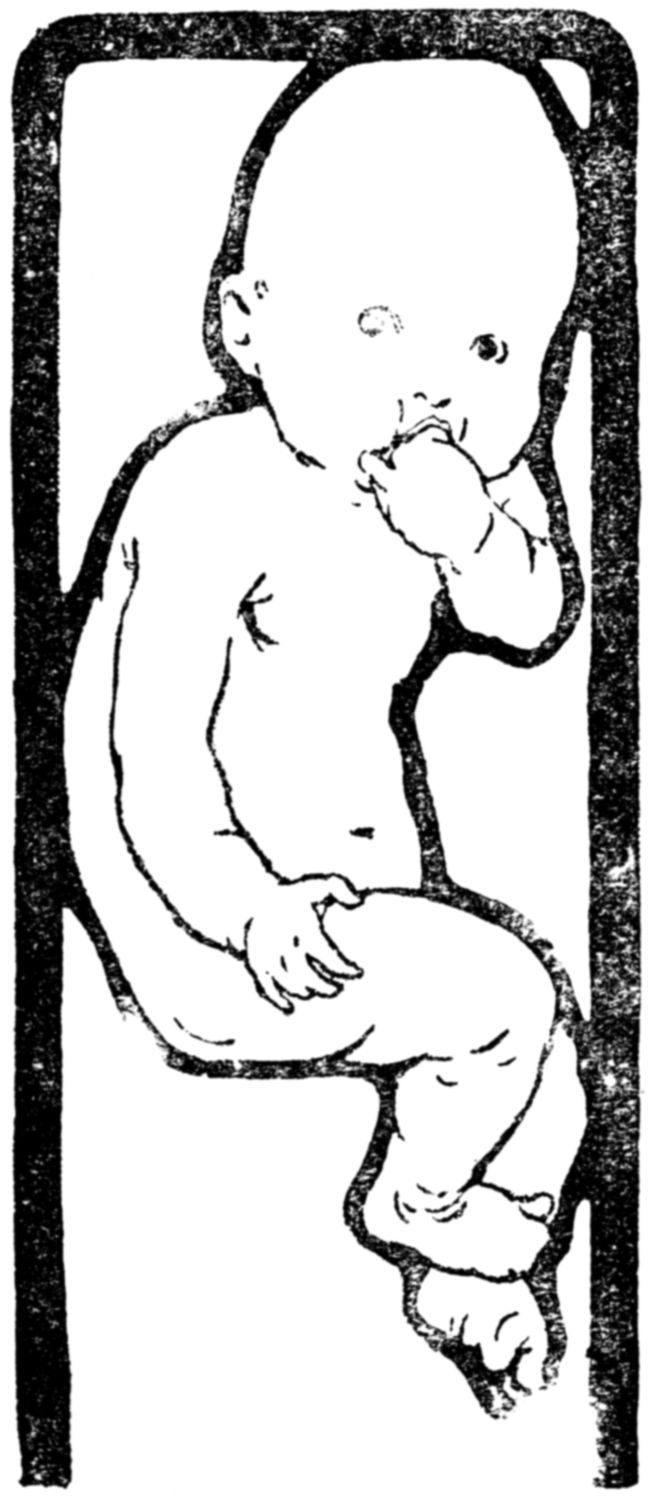
To his amazement the baby, removing the comforting hand, replied in eight words composed of exactly the same letters, “So to-day, sir, . .... .. ...... .....” Can you complete the sentence?
[20]
No. XX.—AGAINST THE COLLAR
The lady who is sitting at the back of this overloaded waggonette cries out, in her sympathy with the struggling horse, “This big load quite hinders his pull.”
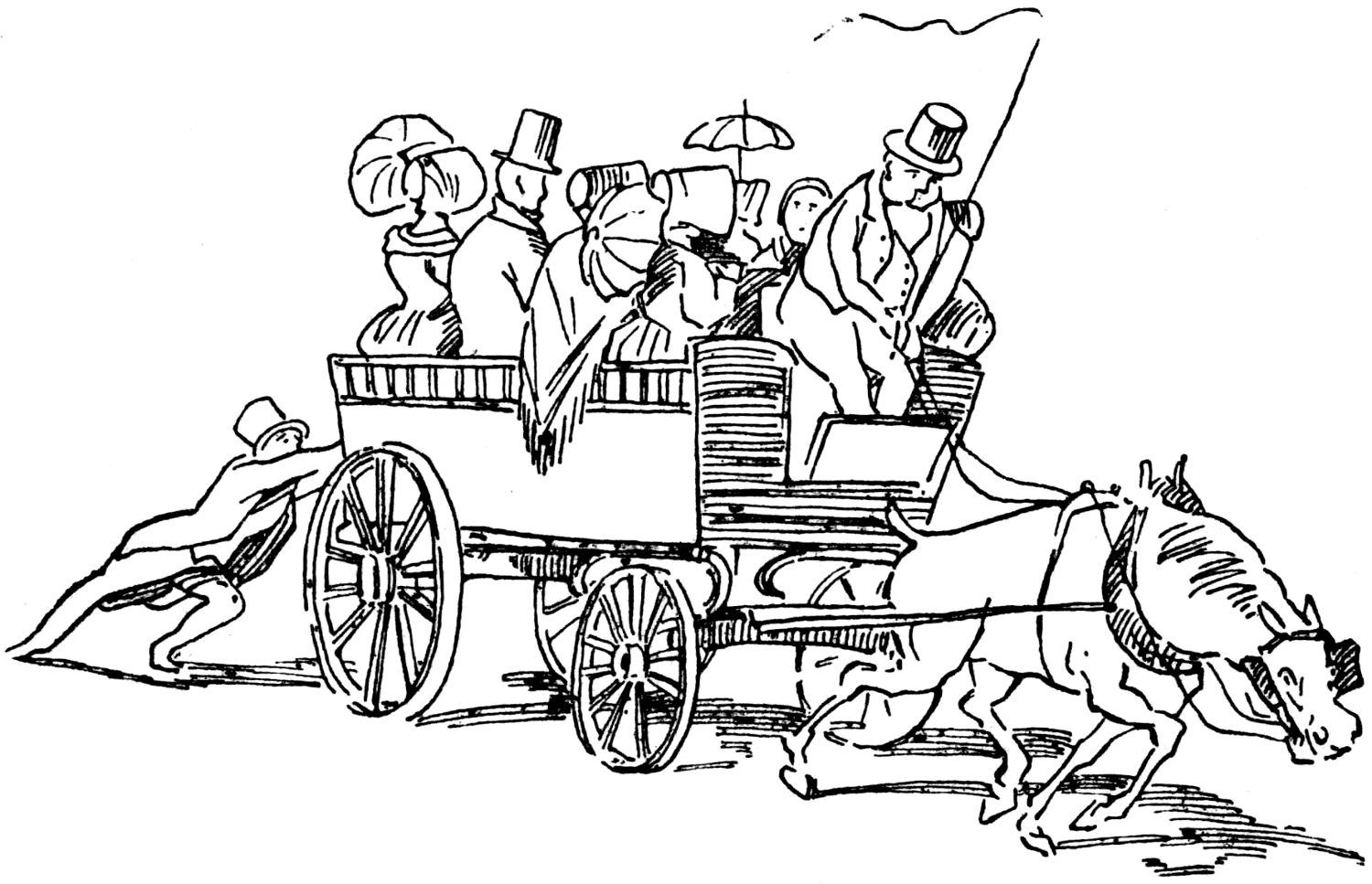
Her husband, full of holiday spirits and energy, answers her in a sentence of mingled reproof and determination, which forms a perfect anagram of the words of his wife, and describes his feelings and action. Can you recast the letters?
[21]
No. XXI.—IN A BILLIARD-ROOM
At the moment when a burly and keen player was in this strange and striking attitude,
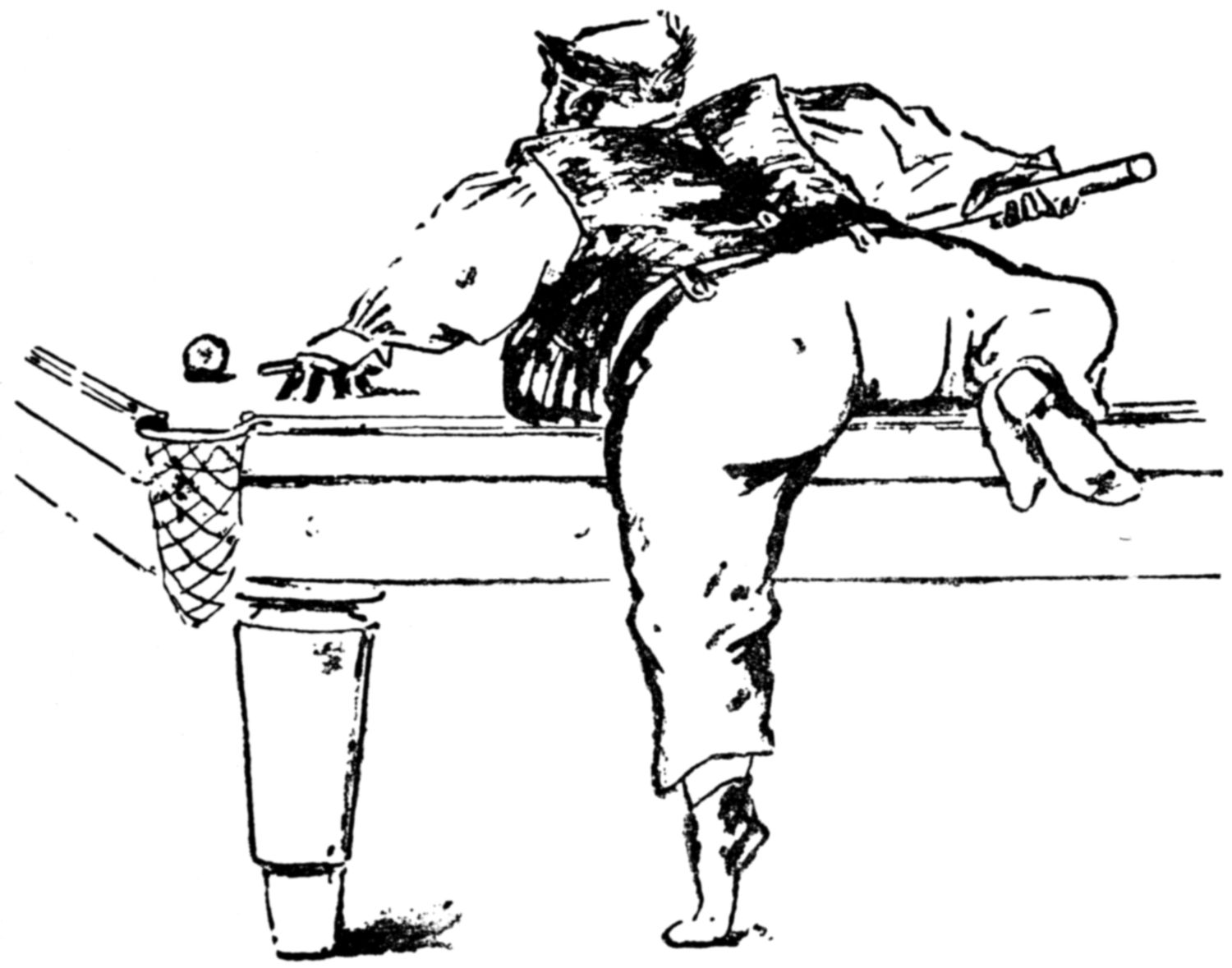
a bystander whispered to the marker, “Eh! what a stout player is striking!”
Can you, using exactly the same letters, put into the mouth of the marker a reply appropriate to the position?
13. A SAUCY MAIDEN
My first had dangling at his side,
On chain securely hooked.
My first he came from o’er the sea,
A bundle of conceit looked he,
And he was all he looked.
Where in desponding mood was seen
My whole, with drooping head.
“Behold,” she said, “a perfect, true,
And striking likeness, sir, of you!”
And, laughing, gaily fled.
[22]
No. XXII.—EVOLVING A PAINTER
There are two English words which are appropriate to this picture—
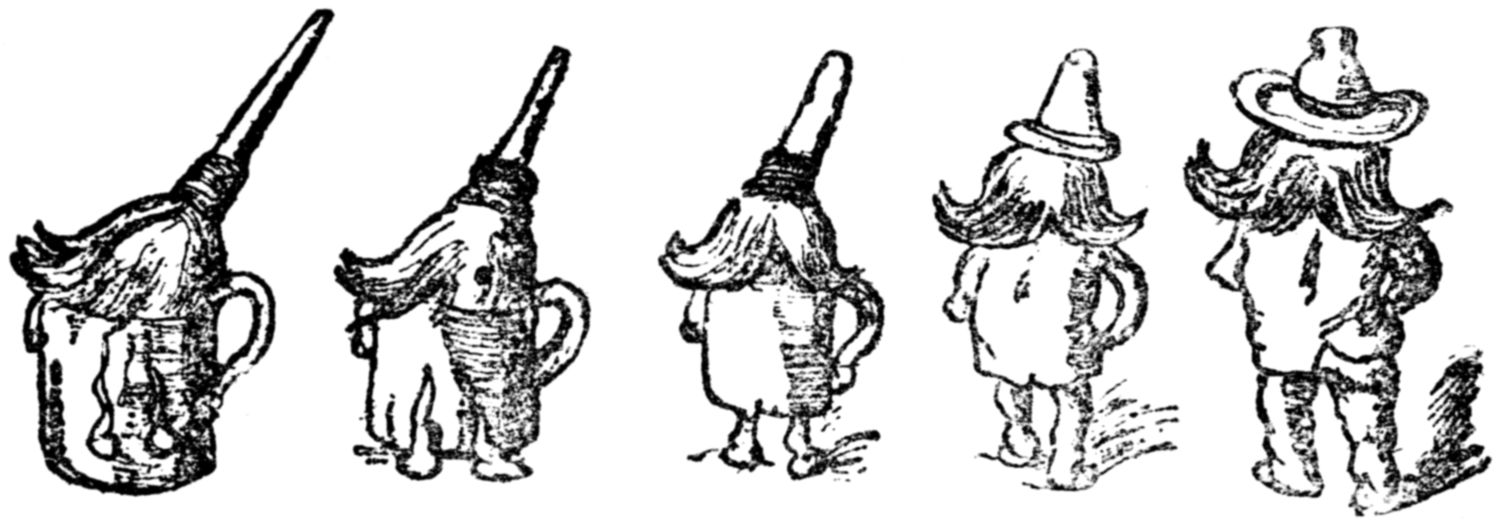
One of them has as its anagram the very apposite sentence, “Or not a man first;” the other treated in similar fashion becomes, “O I love nuts!” What are the two words?
14. DOUBLETS
Who can turn WHEAT into BREAD with six links, changing one letter each time, and preserving the general order of the letters throughout?
[23]
No. XXIII.—THE PICK OF THE PACK
How can we decide by anagram whether this is a fancy portrait of “William or dear Jack?”
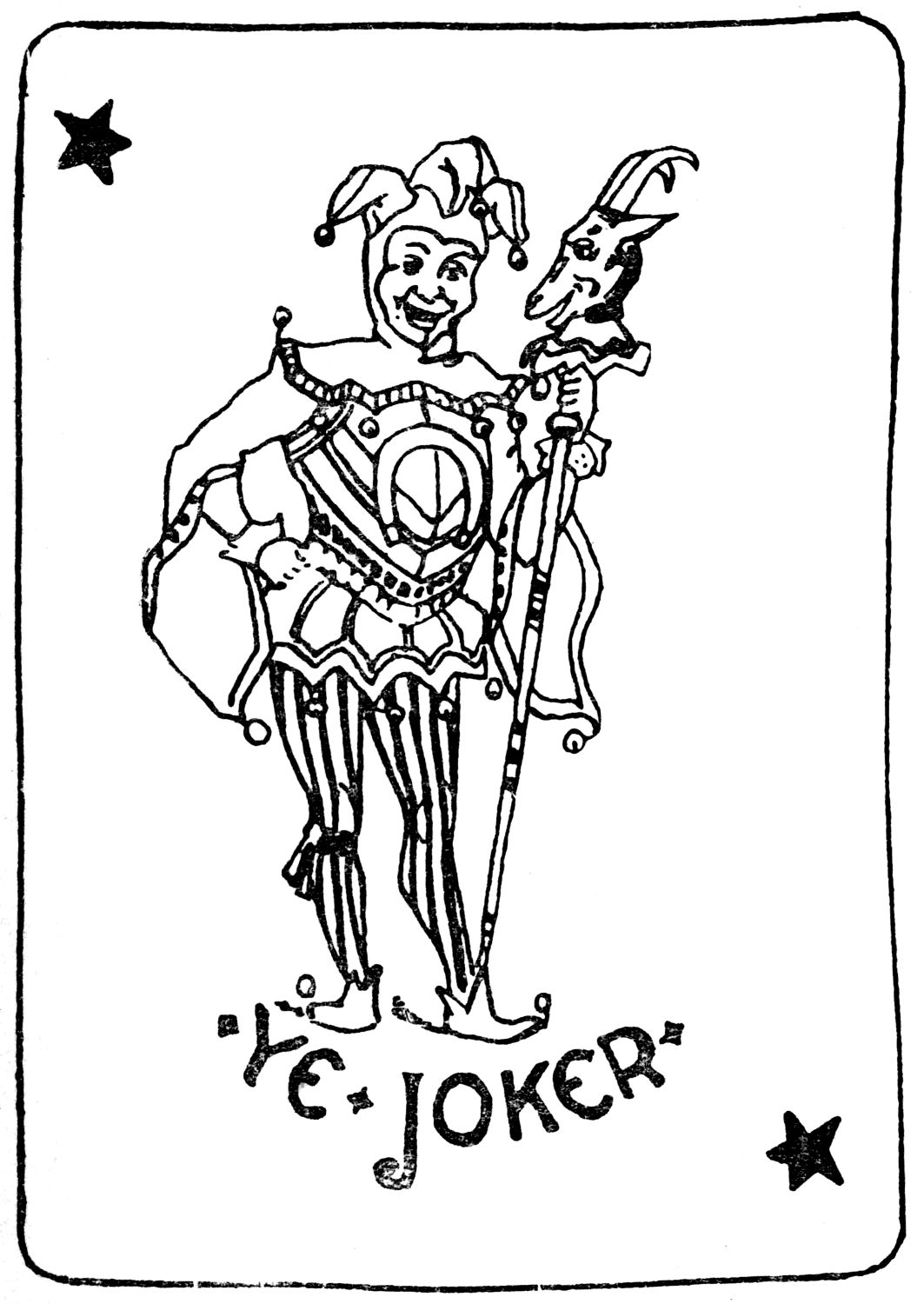
Shake up and recast the words in inverted commas.
15. AN OLD ENIGMA
Can our readers solve this enigma, which was published in 1811, and to which no answer seems to be known?
And very useful in my post;
There’s not a house in all the land
Without me properly can stand.
Though men disputed long ago
Whether I did exist or no,
Once more some thousands have been slain
Because they could not me attain.
[24]
No. XXIV.—A PICTURE PUZZLE
Take this picture in connection with the lines below it, and find out what it represents.
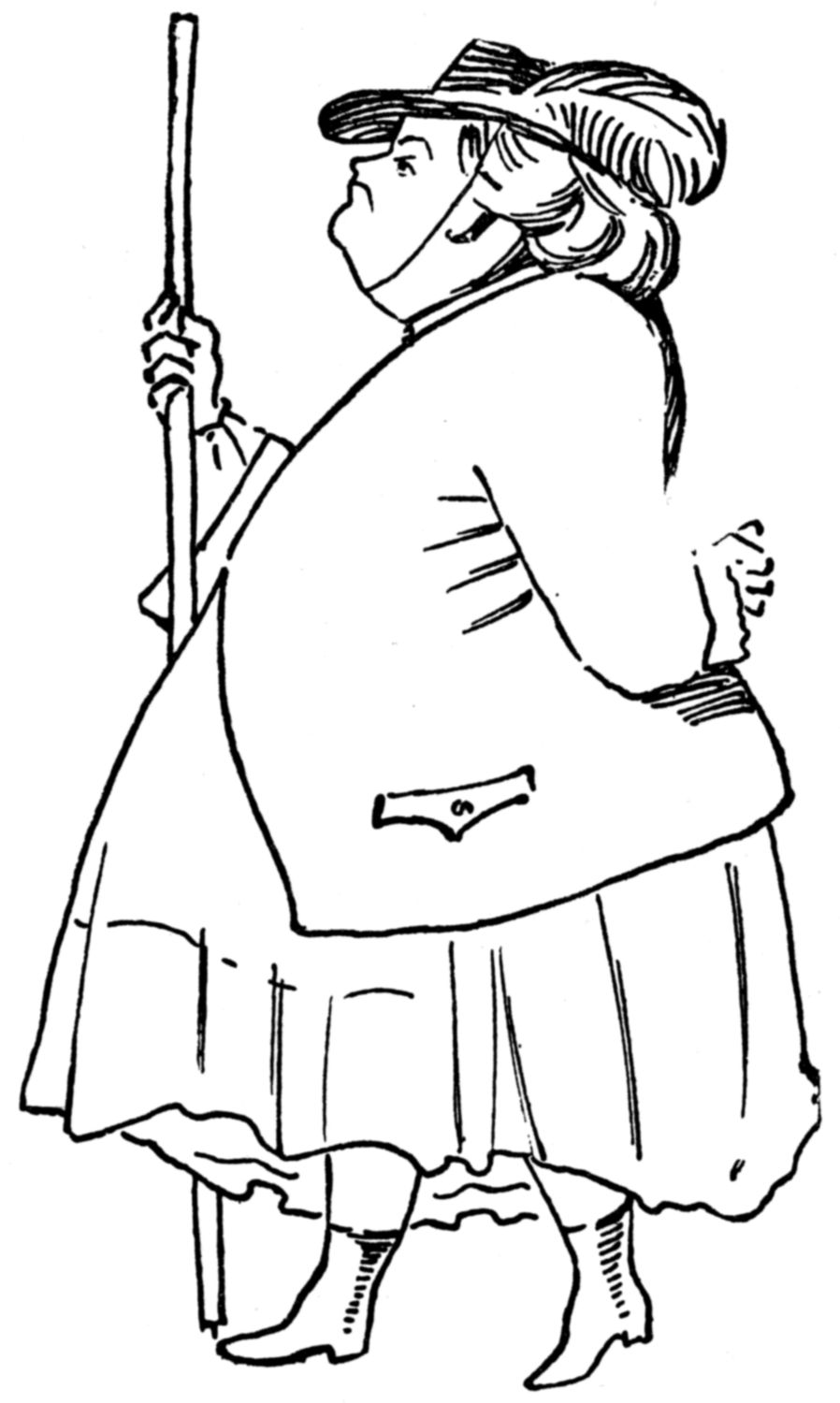
then you will find out the rest;
For it all will appeal to your thirst,
Or point to a ponderous guest.
[25]
No. XXV.—AN ANXIOUS POSE
His wife, who chanced to see Jiggers at the trying moment here depicted, said that he seemed to be in a “sad pet.”
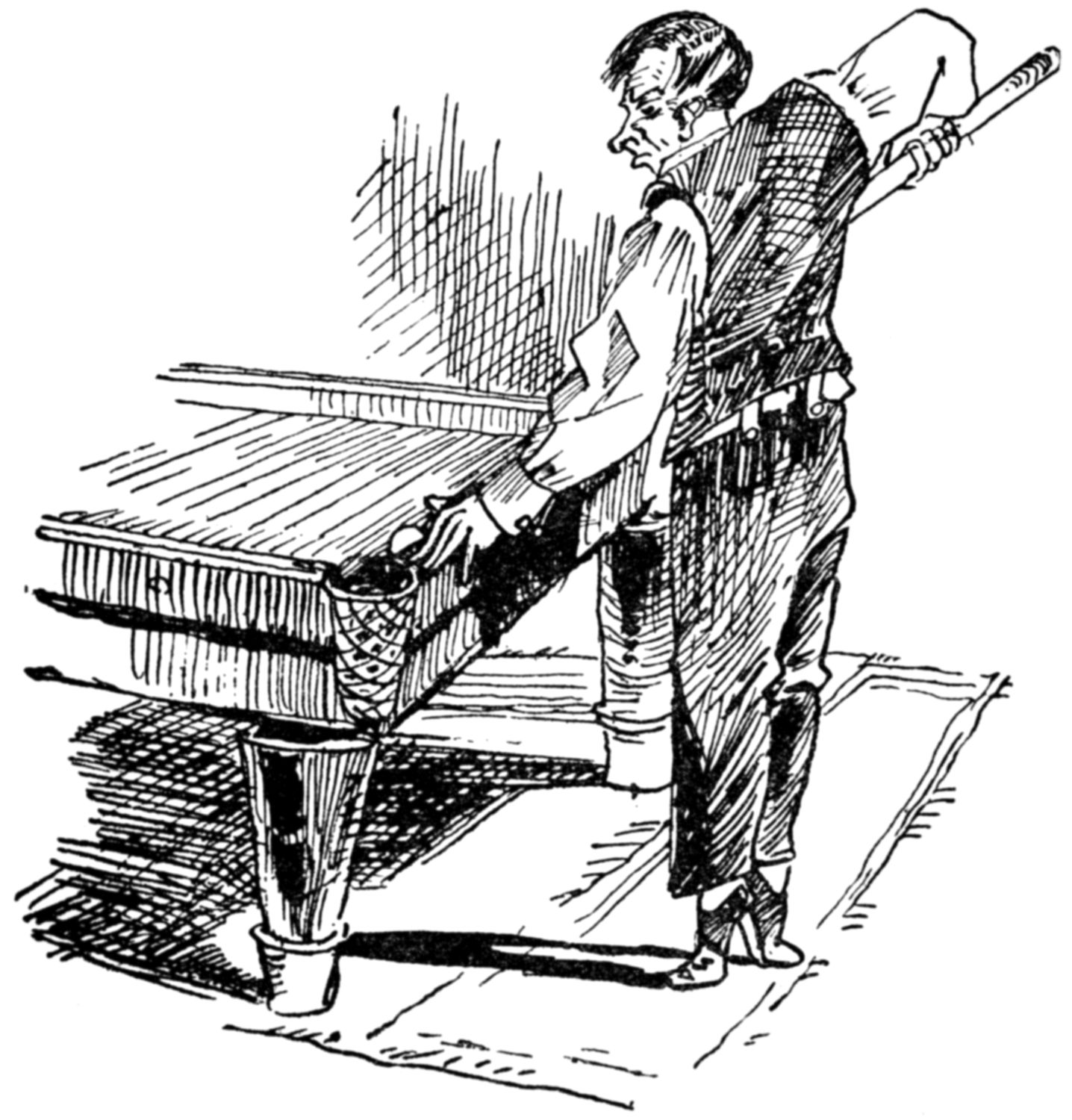
How was this literally true?
[26]
No. XXVI.—TOSS NEITHER HEAD NOR TAIL
Never was a cow so troublesome at milking-time.
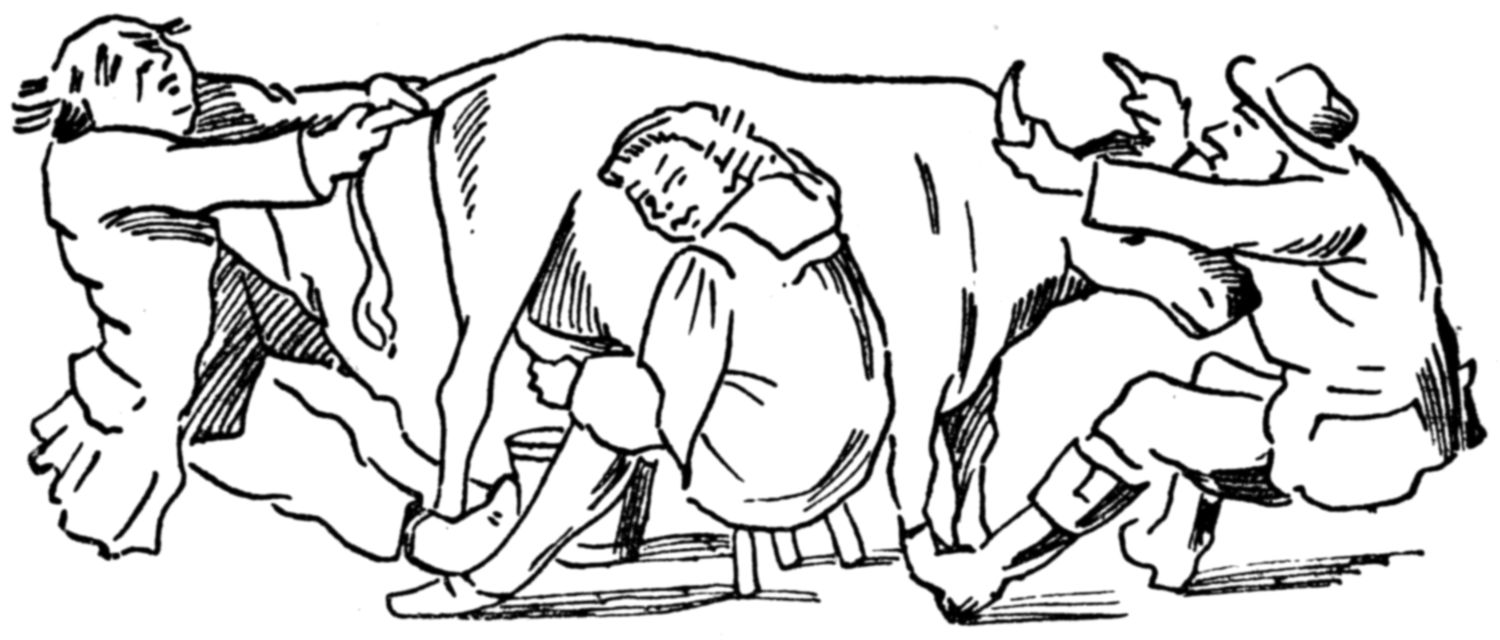
Our picture was taken at the moment when Farmer Hayseed was exclaiming, as he held on behind, “See, we hold this cow’s horns and tail!”
The same letters, recast by anagram, form this sentence spoken by his foreman—
“She cannot toss, ... .... .... .. ..”
Can you fill in the five missing words?
16. ANAGRAM PROVERBS
These grave lips chatter no ill.
or
Elephants, all to richest giver!
Can you recast the letters of these sentences so that either of them forms the same homely proverb, to which the first anagram is most akin?
[27]
No. XXVII.—ACTION AND PASSION
This very resolute horse and his anxious driver take quite different views of the situation shown in this picture.
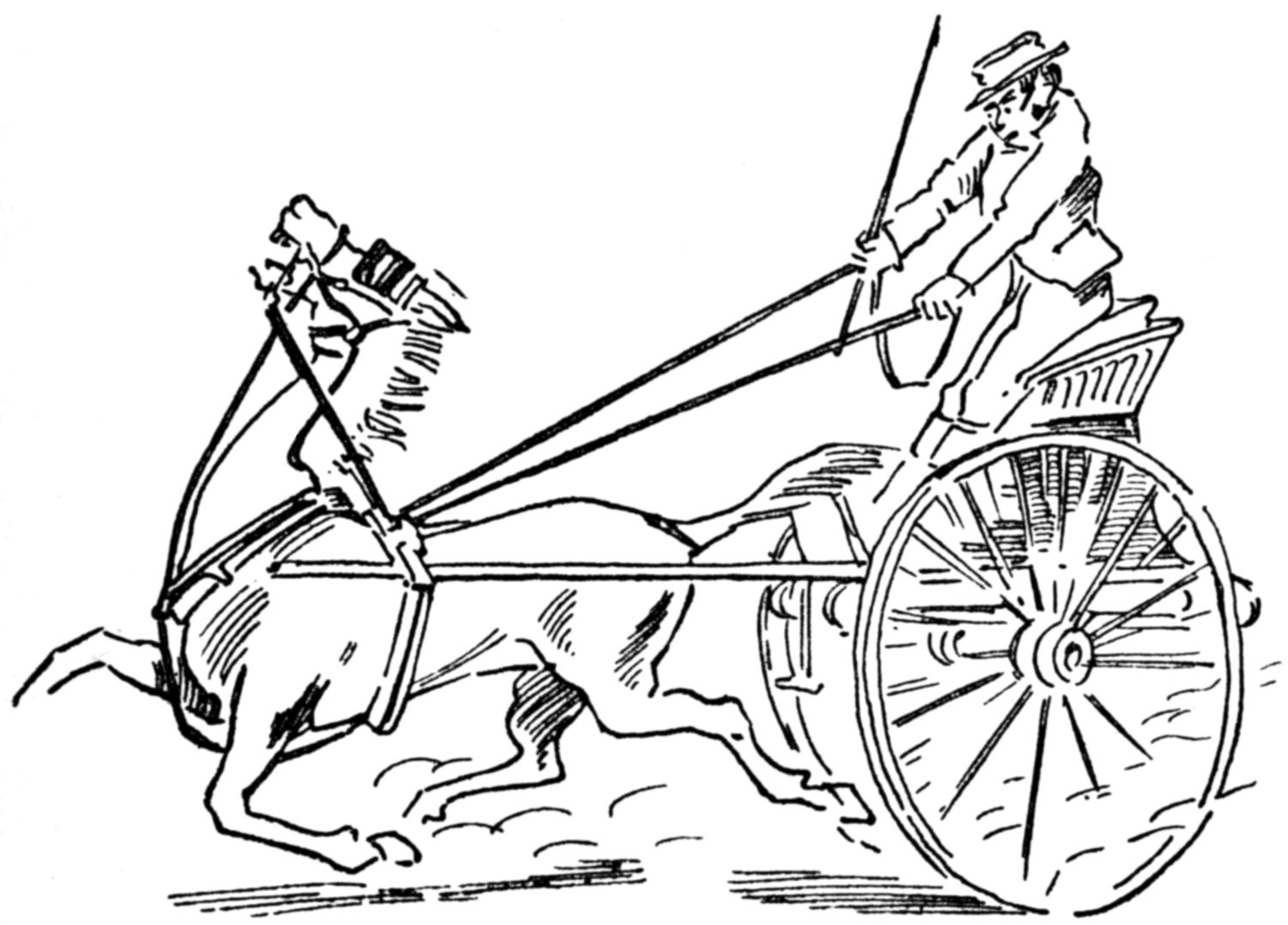
We can fancy that the fast trotter, if he could be endowed with speech, would say, “I’m a train’d stepper!”
Can you take these same letters, and recast them into a sentence which would seem to express the driver’s point of view?
17. A SHORT CHARADE
The rest is in a city found;
My whole to win its way is bound.
[28]
No. XXVIII.—A FEAT WITHOUT ARMS
In this picture a clever artist who has no arms is seen calmly painting with his feet.
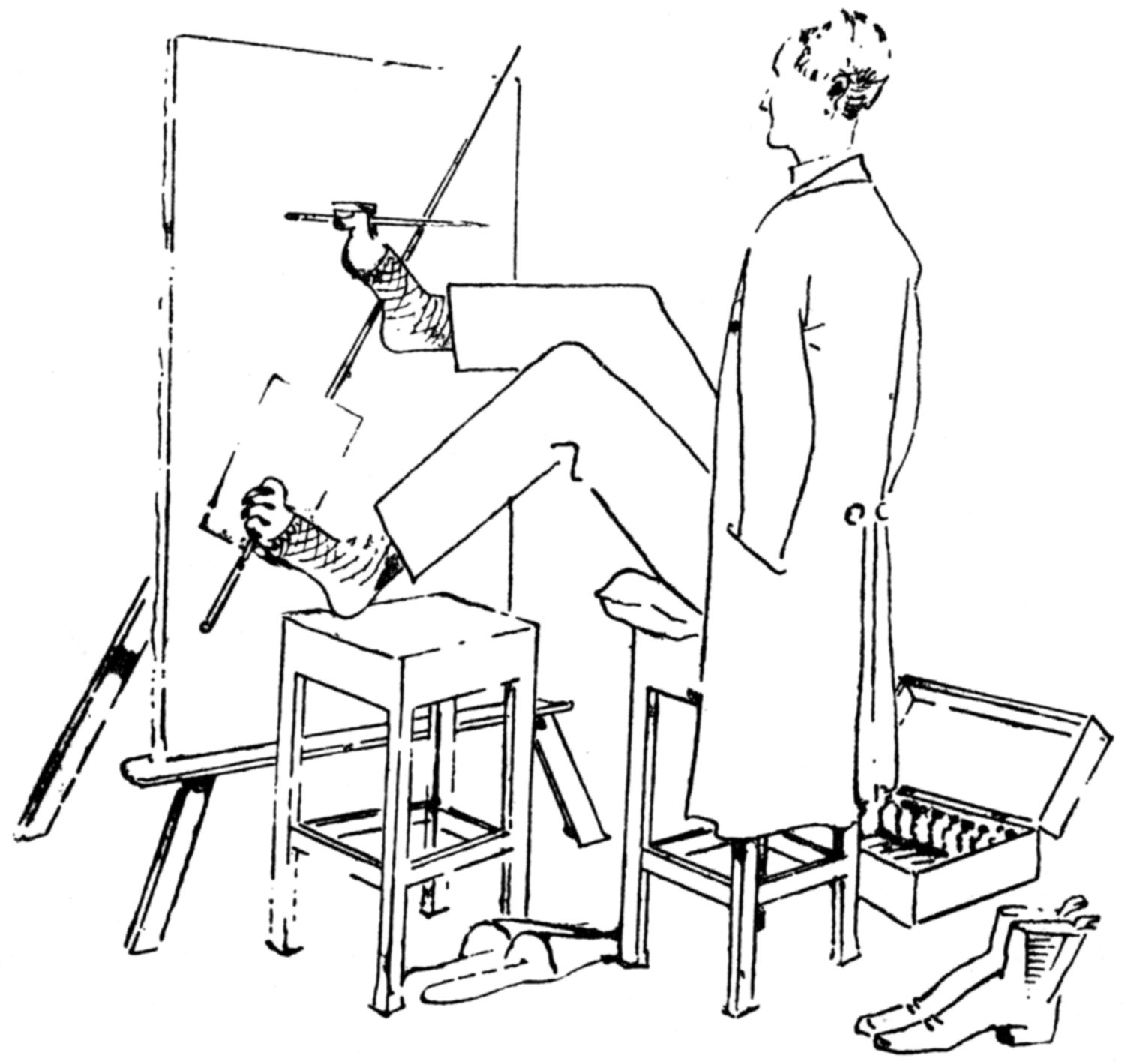
One onlooker says to another, “Why, now I see this fine artist has no hand!” The other replies in a sentence which contains exactly the same letters:
“He draws in any fashion .... ... ... ... .”
Can you fill in the four missing words?
[29]
No. XXIX.—NOT TAKING ANY
“This is a wine bottle, dear, on a lure,” said a crafty fisher of men to his better half, who was helping him, as he showed her this illustration of their aims.
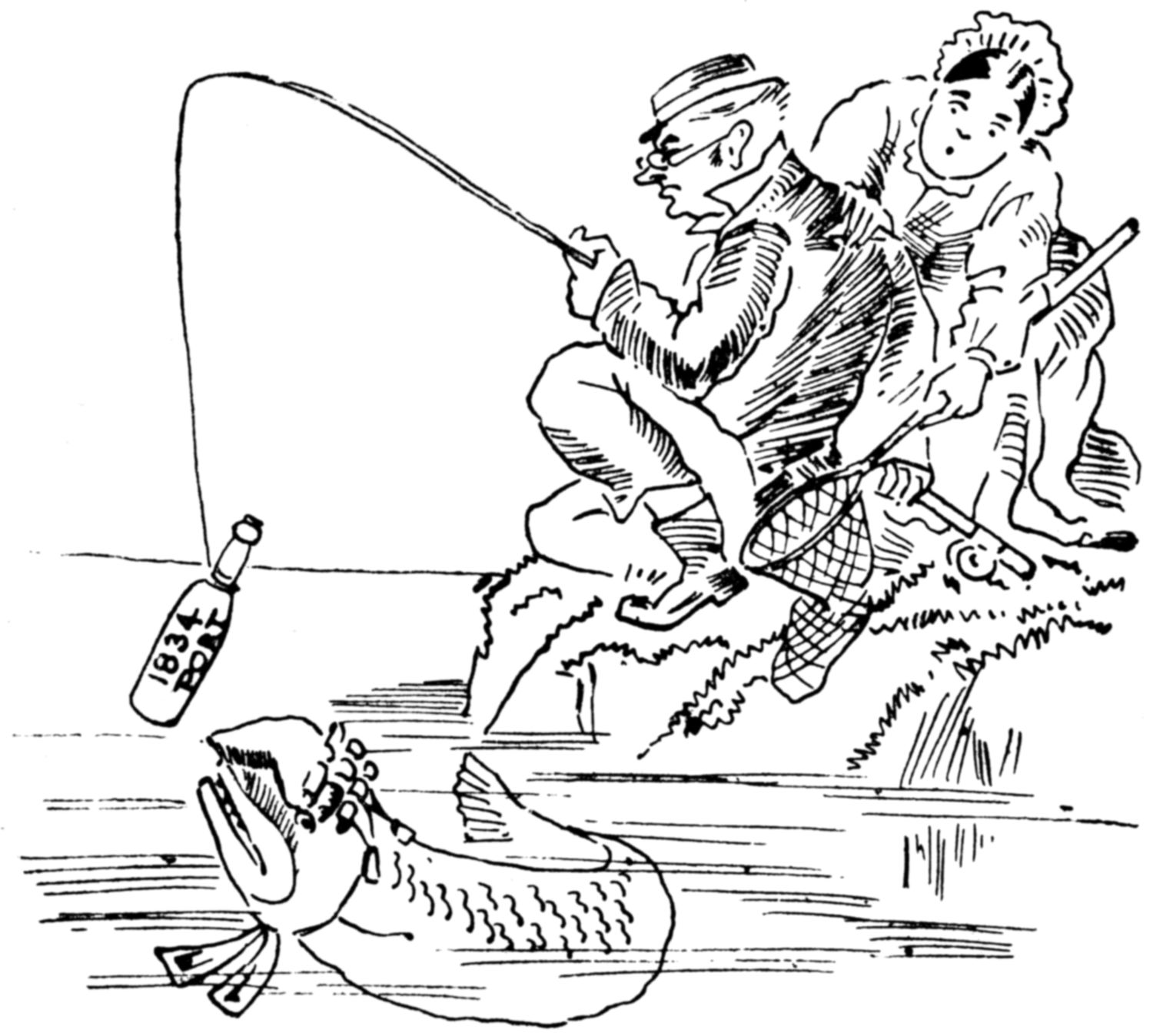
1834
PORT
She knew, however, that the fish he sought to catch was not to be tempted in this way, and she replied in words spelt with exactly the same letters, “And see, he will not .... .. ... ....!”
Can you fill in the four missing words?
[30]
No. XXX.—MUSIC HATH CHARMS
This sturdy musical enthusiast, as he settled himself upon his chair, said, “What shall I play?” and some one replied, “Any strains of Beethoven, he charms all!”
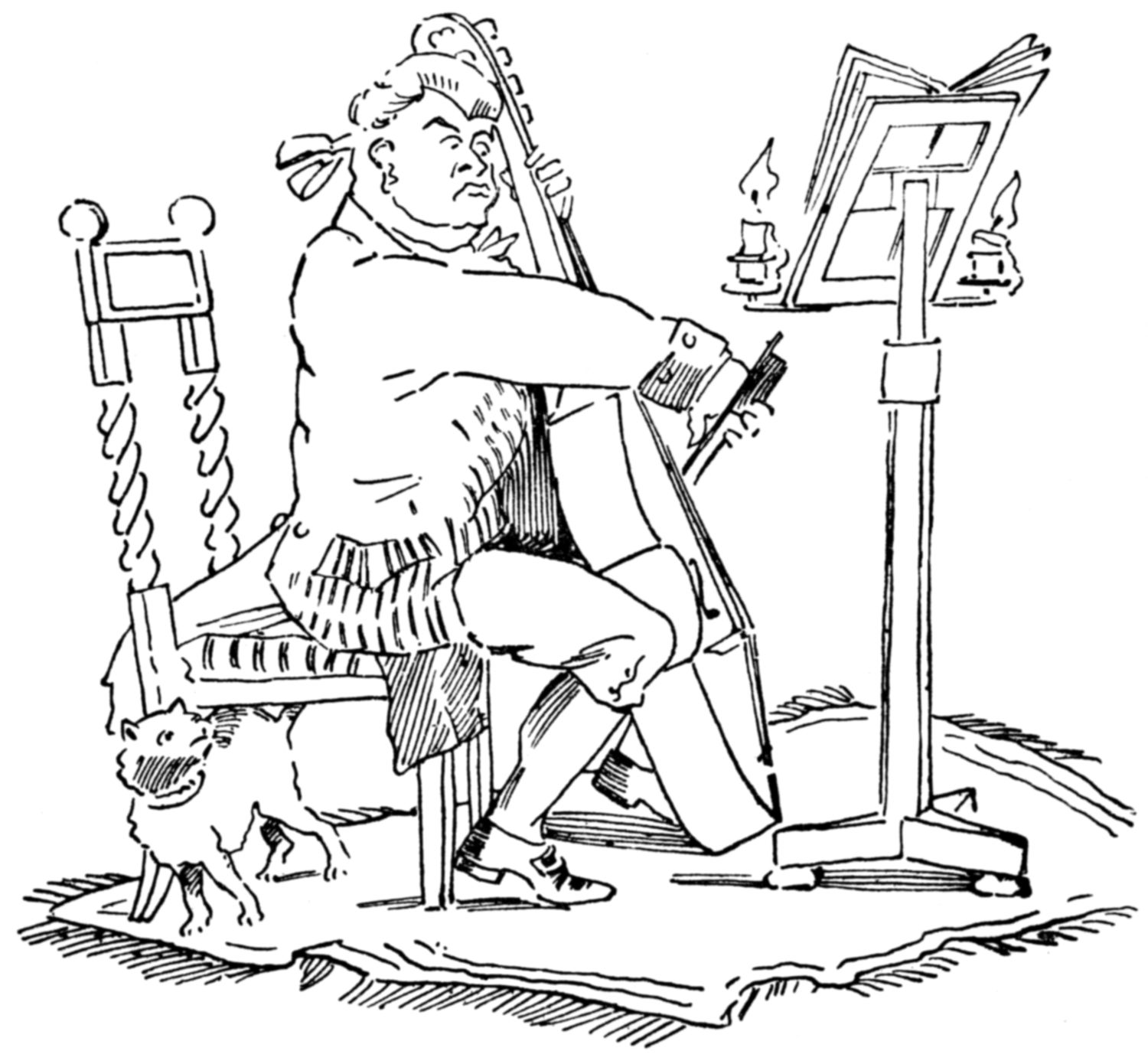
This suggestion, however, was not acceptable, and he, as he struck up a piece after his own heart, exclaimed, in a sentence composed of exactly the same letters—
“Nay, for this ’cello ...... .... . ......!”
Can you supply the missing words?
[31]
No. XXXI
This picture represents a parsnip lying across a sturdy swede.
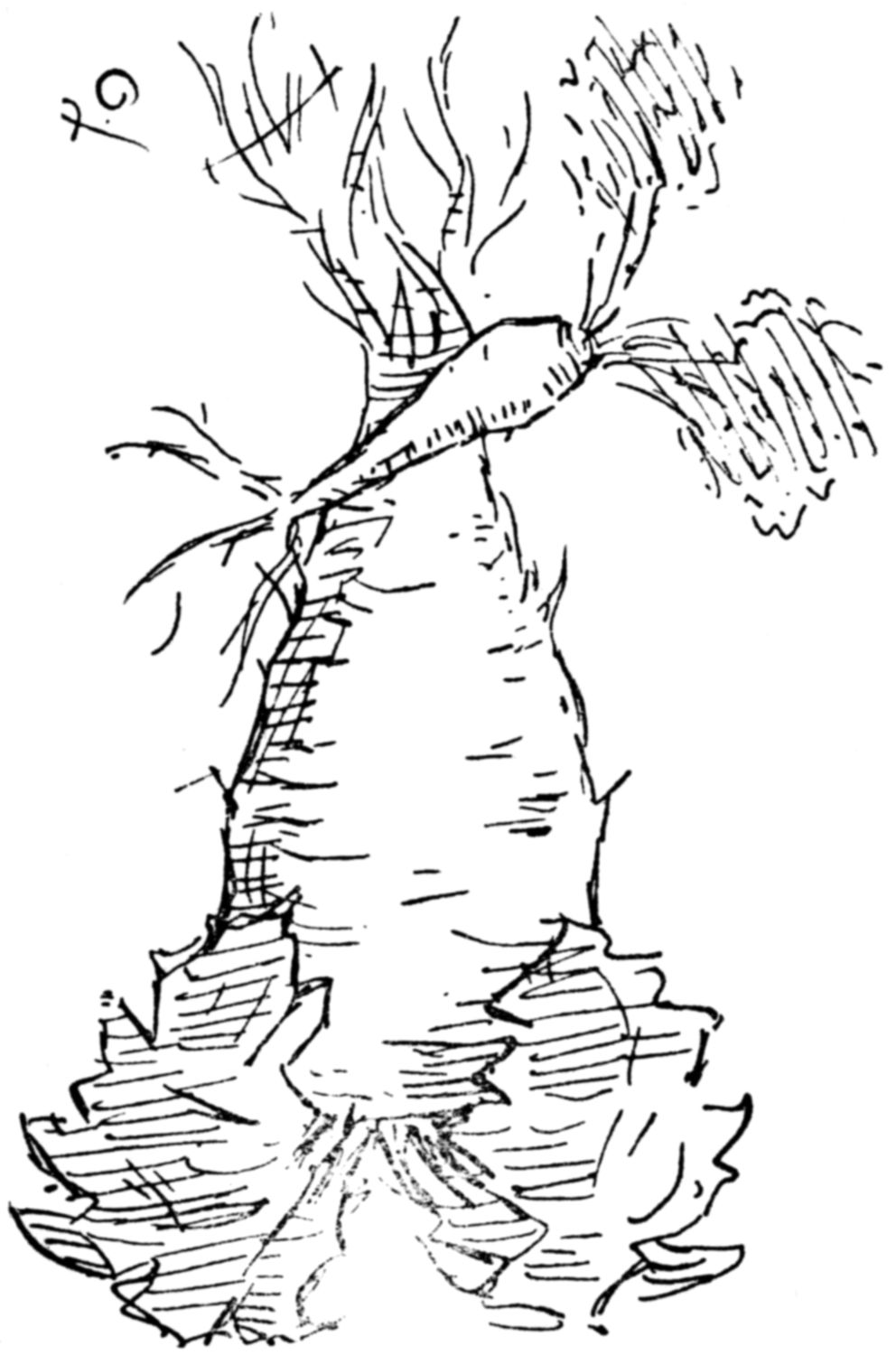
Can you so readjust them that they seem to suggest a successful dramatist of the day? We give this broad hint by anagram—
“Here is our parsnip on swede.”
ANAGRAM
Wise and superior person he!
[32]
No. XXXII.—A GOOD LETTER PUZZLE
Can you fill the places of these 21 asterisks with only three different letters, arranging them so that they spell a common English word in twelve different directions?
| ● | ● | ● | ● | ● |
| ● | ● | ● | ● | |
| ● | ● | ● | ||
| ● | ● | ● | ● | |
| ● | ● | ● | ● | ● |
18. A BURIED POTENTATE
My second in light, but not in sun;
My third is in night, but not in day;
My fourth is in game, but not in play;
My fifth is in head, but not in tail,
My sixth is in wind, but not in sail;
My seventh in wrong, but not in right,
My eighth is in battle, but not in fight;
My ninth is in sword, but not in knife,
My tenth is in lady, but not in wife;
My whole is a monarch at war with strife.
[33]
No. XXXIII.—ANAGRAM ARITHMETIC
First form a short sentence with the ten letters that are above the line in this diagram:—
| S | B | |
| R | E | |
| Y | D | |
| O | T | |
| U | O | |
| O | E | E |
Next number the letters of the sentence consecutively 1, 2, 3, 4, 5, 6, 7, 8, 9, 0, and then work out a sum in addition with these numbers substituted for the letters with which they correspond.
[34]
No. XXXIV.—A BUNCH OF FLOWERS
Find within these borders twelve specimens of flowers and foliage:—
| 1L | 2L | 3B | 4H | 5P | 6E | 7F |
| 8L | 9Y | 10E | 11L | 12O | 13R | 14N |
| 15I | 16V | 17B | 18R | 19I | 20V | 21K |
| 22A | 23L | 24E | 25T | 26O | 27N | 28I |
| 29C | 30N | 31A | 32S | 33U | 34L | 35P |
Move in any direction one square at a time, and so spell out their names, using the same square only once in each case.
19. A CHARADE
Is never seen or heard;
When it is heard the sound is tolled
Out of a Jewish beard.
My next was in Imperial Rome,
It was her power and might;
Then you had but to write you wish,
And straightway ’twas in sight.
Of royal rank.
[35]
No. XXXV.—ON A BLACKBOARD
To test the powers of his young pupils, Dr Puzzlewitz set the following little problem on his blackboard:—
| A | - | B | = | 4 | ||
| A | ÷ | B | = | 4 | ||
What are the values of A and of B, when 4 is the result of dividing A by B, or of subtracting B from A?
20. RECAST
Oft have I saved a castle tower
From war’s invading tide.
Transpose me, and how great my fall!
I am then the smallest of the small,
That nothing can divide.
21. WORD-BUILDING
All apart its letters shake.
Let your 6, 3, 5 be high,
Like 5, 1, 2 do or die.
Who 4, 6, 5, 1 enjoys
More than 5, 6, 2 by boys?
While 5, 3, 2, 1 are mine,
May 4, 6, 3, 2 be thine.
4, 1, 5 is rich and rare,
6, 5, 1, 2 ends my prayer.
The figures indicate the position of the letters, which spell new words, in the original six-letter word.
[36]
No. XXXVI.—SQUARING A DIAMOND
Can you fill in the empty cells with letters, so that they form English words which read alike from top to bottom and from left to right?
| s | ||||||
| s | u | s | ||||
| s | ||||||
22. AN ENIGMA
Half an hour after his head was cut off.”
Old Couplet.
A warrior formed to deal a heavy blow.
Halve what remains, my second is a thing
Which nothing but my third can e’er make go.
My third will vary as you take your line.
This less than human, that way all divine!
[37]
No. XXXVII.
Taking the letters as arranged on this diagram for a starting point, can you place in some of the unoccupied cells five more of A, five of E, five of I, and five of O, making eight in all of each letter, so that in no case shall the same vowel be in the same row, column, or diagonal?
| A | I | E | O | ||||
| O | A | ||||||
| I | E | ||||||
| E | O | A | I | ||||
Each vowel is to be regarded without any reference to the other vowels, and, of course, only one may be placed in a cell.
[38]
No. XXXVIII.—AN ANAGRAM SQUARE
Mix together the letters which form the eight words on this draught board—
| V | O | T | E | ||||
| W | O | V | E | ||||
| P | R | O | W | ||||
| C | A | L | L | ||||
| S | T | E | W | ||||
| N | E | W | S | ||||
| C | O | R | E | ||||
| N | A | P | E |
and recast them so that they form eight fresh words, which when placed in proper order on the white squares, are a word square in which each word reads alike from left to right, or from top to bottom. The first of the fresh words is CROW.
[39]
No. XXXIX.—ARITHMETIC BY ANAGRAM
Form a short sentence with the letters above the line in this diagram:—
| D | U | |
| E | H | |
| E | D | |
| A | P | |
| S | T | |
| D | E | A |
Number the letters consecutively 1, 2, 3, 4, 5, 6, 7, 8, 9, 0, and then work a sum in addition, substituting these numbers for the letter with which they correspond.
23. A LOGOGRAPH
Behead, I’m used by rich and poor;
In house and cottage, hut and hall,
I stand of service to them all.
Behead again, in time of need
I tell that strength and skill succeed.
[40]
No. XL.—ANAGRAMS SQUARED
Shake up the sixteen letters of these four words, and recast them into four other words:—
| S | E | E | K | ||||
| S | L | A | B | ||||
| L | E | E | K | ||||
| M | O | A | N |
These fresh words, placed on the white squares, must read alike from side to side, and zigzag from top to bottom. The first word is MASK.
24. A SINGLE ACROSTIC
Which Pope says does with eels abound?
What Scottish lake, by high hills bounded,
Is with bright birch and oak surrounded?
What stream is said in Devon to run
Into the sea near Otterton?
What bay on Cuba’s distant coast
Is justly deemed its pride and boast?
The initials of these names will show
A Scotch reformer, who, we know,
Flourished three hundred years ago.
[41]
No. XLI.—A WORD SQUARE BY ANAGRAM
Take the letters which form the words in these sixteen cells—
| A | F | A | R |
| T | A | S | K |
| S | E | A | T |
| L | E | A | L |
and recast them so that they form a perfect word square.
25. A CHARADE
So former may, or latter;
But twist my tail, and I become as mad
As any hatter!
Who never was called mister;
Cut off my tail, and instantly I can
Become a sister!
[42]
No. XLII.—QUITE A NOVELTY
There are five English words in this square:—
| c | h | e | s | s |
| g | r | e | e | d |
| c | a | n | e | s |
| r | e | a | r | s |
| c | h | e | e | r |
Can you shake up their letters, and recast them into five other words which form a perfect word square, and read alike from top to bottom and from left to right? The first fresh word is CRESS.
[43]
No. XLIII.—HIDDEN PROVERBS
Five familiar proverbs are hidden in this square of 169 letters,
| R | E | N | O | W | N | E | D | T | H | A | N | W |
| S | Y | O | U | R | C | A | K | E | A | N | D | A |
| S | T | E | T | O | B | E | F | E | A | R | H | R |
| E | A | R | K | S | S | P | O | I | L | E | A | F |
| L | E | O | O | H | E | R | S | N | T | D | V | O |
| O | T | M | O | T | L | I | N | O | H | T | E | U |
| N | O | S | C | A | L | A | G | M | E | H | I | R |
| S | N | I | Y | G | O | R | S | O | B | A | T | S |
| E | N | G | N | E | N | O | T | S | R | N | P | A |
| I | A | O | A | M | O | O | T | S | O | A | E | W |
| R | C | D | E | V | I | L | A | H | T | D | A | S |
| O | U | O | Y | N | O | I | L | D | A | E | C | A |
| T | C | I | V | R | E | H | H | T | A | H | E | Z |
The proverbs are arranged in a regular sequence.
26. RINGING SWEET CHANGES
We are familiar with the anagram that so charmingly points to the ministrations on the battle-field of Florence Nightingale—Flit on, cheering angel—but it is not so well known that her name can also be recast with an appropriate wish for her continuance in our loving memory. Can you frame this?
[44]
No. XLIV.—A CLEVER CRYPTOGRAM
A French sentence of 100 letters in twenty-two words is concealed in these 100 cells.
| D | L | A | N | N | E | S | M | P | A |
| L | I | R | D | L | E | E | M | L | H |
| I | L | U | E | E | A | I | N | T | J |
| C | U | R | S | E | M | N | T | U | P |
| E | U | É | S | N | P | R | E | O | S |
| O | L | I | É | D | X | S | M | A | N |
| U | D | E | A | E | É | I | X | N | T |
| T | E | T | P | E | D | N | U | Q | E |
| B | U | U | U | F | L | I | J | I | N |
| Z | U | E | J | I | O | E | U | N | R |
It can be deciphered by means of a cardboard mask of similar size, with circular holes cut out in some of its cells. This is placed squarely over the diagram, turned round in four successive positions. And thus the sequence of letters is found, and falls into words.
[45]
No. XLV.—SAM LOYD’S PONY PUZZLE
The instant popularity of this clever puzzle was amazing, and its sale is said to have run into millions years ago in America.
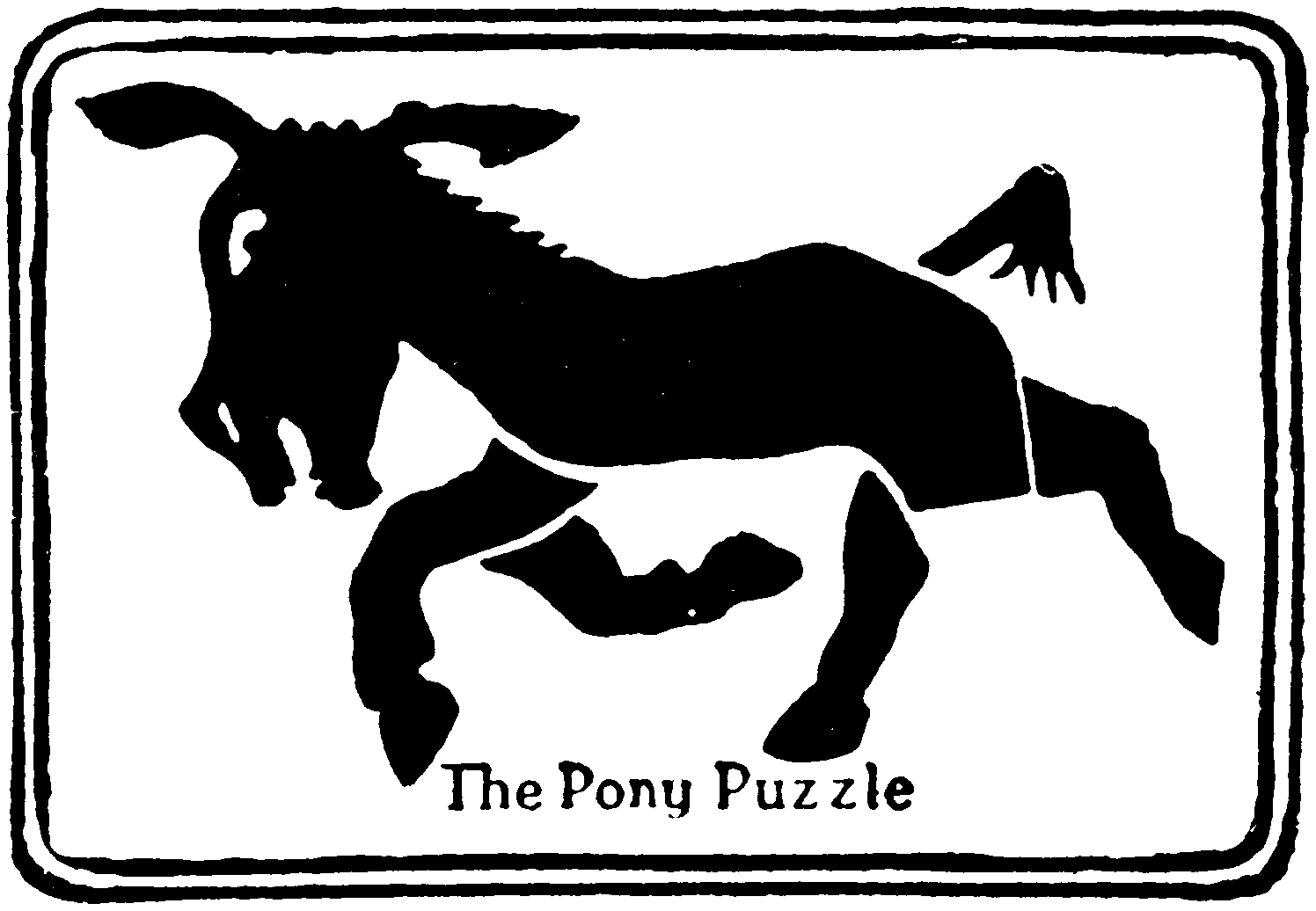
Cut the pony into six pieces, as is indicated in the picture, and rearrange these so that they show a trotting horse.
27. A REBUS
I am
a man
I rate you
a beast
You know me.
Can you put this into shape?
[46]
No. XLVI.—A CLEVER PUZZLE
Here is another of Sam Loyd’s famous trick pictures:—
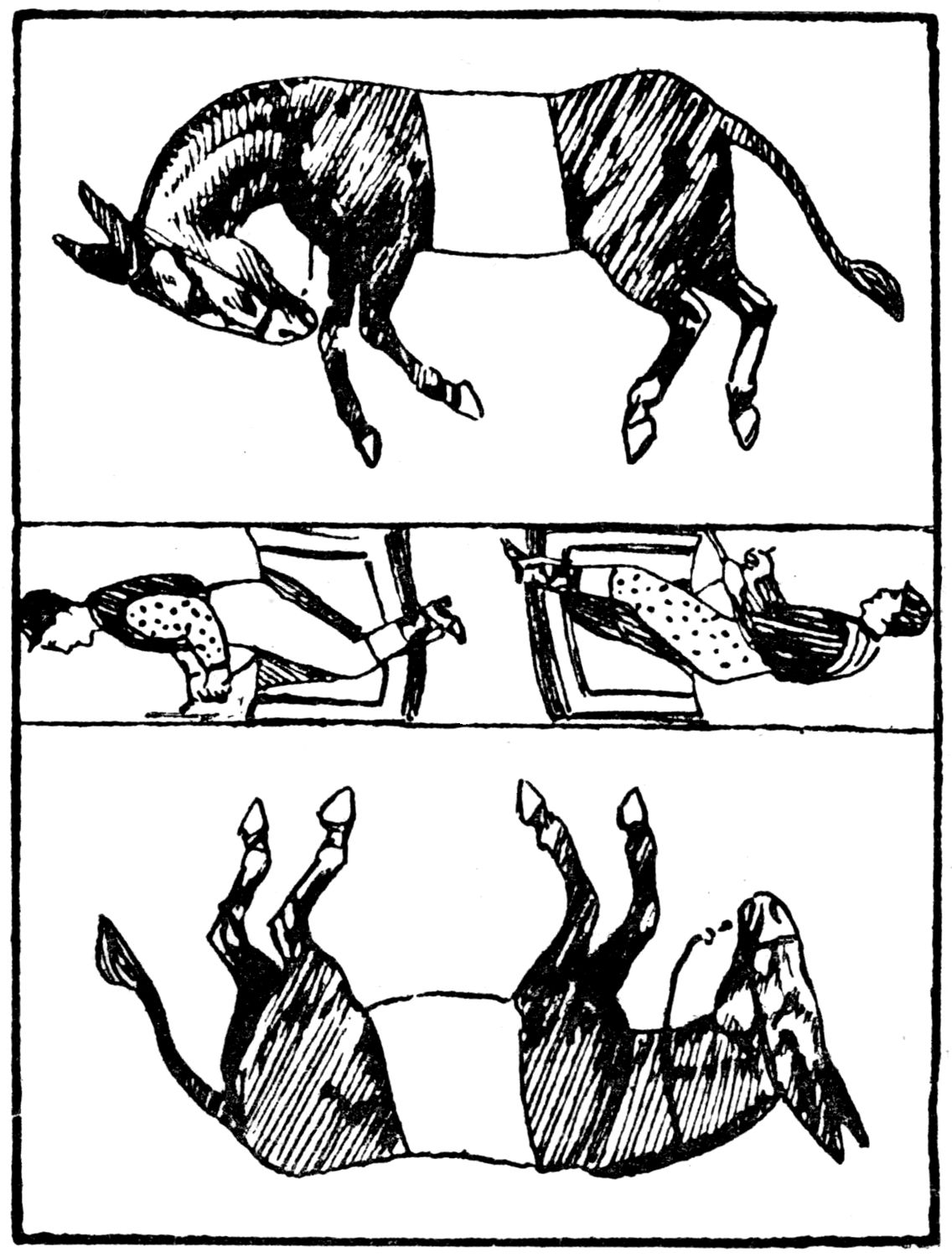
Can you rearrange the parts to show jockeys and horses in racing trim?
28. A CHARADE
(With Latin parts.)
Rome’s fate my next, and one that all may dread.
Long may it be before that fate shall come,
And sever with my whole thy life’s last thread!
[47]
No. XLVII.—A NICE BALANCE
This boy is sure that if he takes his time, and watches his opportunity, he will be able to reach and secure with his mouth the sugar on the chair. Will he?
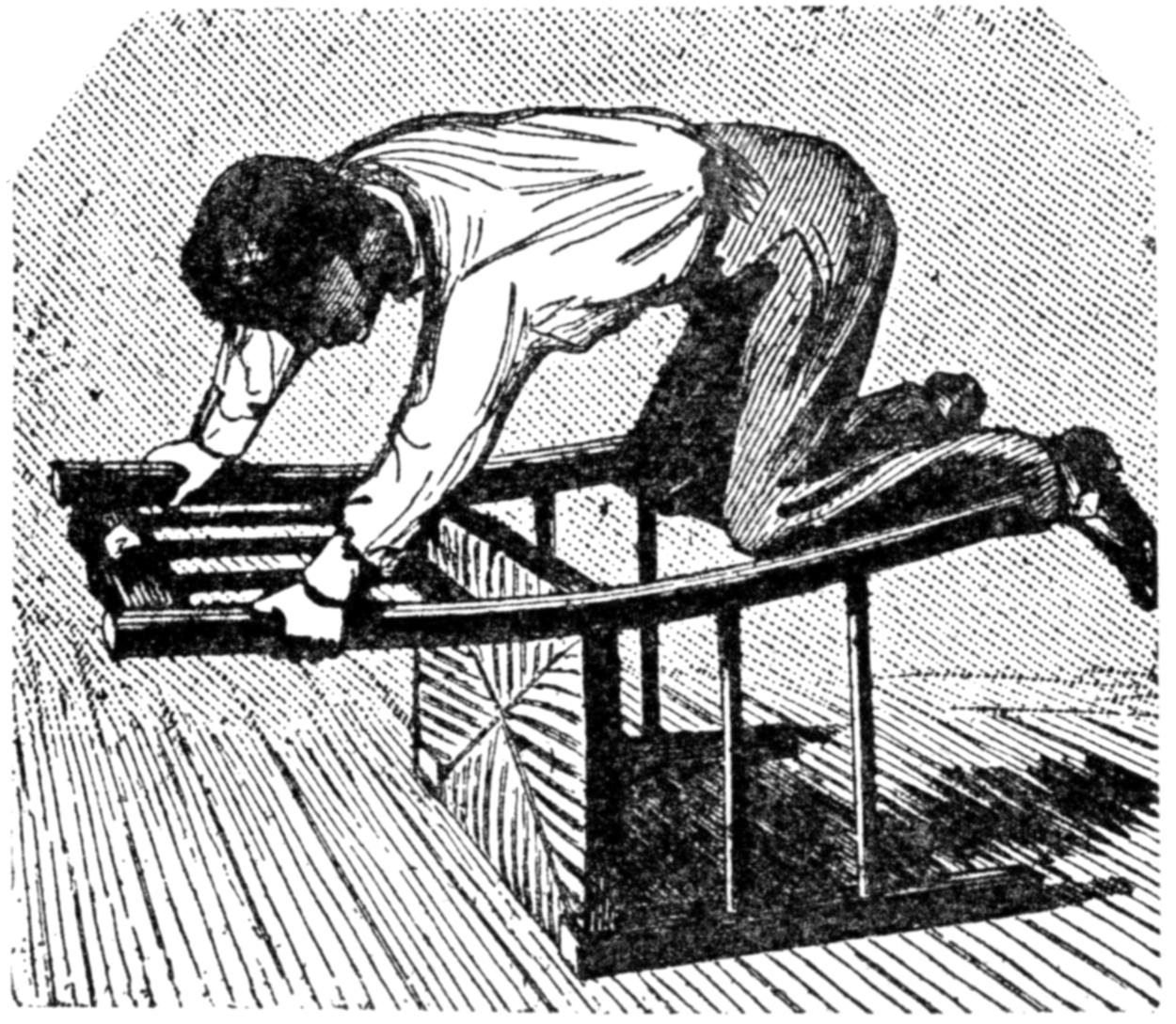
29. BURIED POETS
The names of eight famous British poets are buried in these lines—that is to say, the letters that spell the names form in their proper order parts of different words:—
Upon the moor, enchanting spot,
Whose purpled heights, by Ronald loved,
Up open to his shepherd cot.
Are flying—aye, each to his nest;
And eager make at such an hour
All haste to reach the mansions blest.
Can you dig them up?
[48]
No. XLVIII.—LEAF-FROG
Here are six little hoptoads, as our cousins across the water call them, three white and three black, going in opposite directions. A frog may jump, one, two, or three steps, but no two may be together at any time.

In how few jumps can the black frogs be seated to the left of their white brothers? It is obvious that one of the white frogs must jump first to the stool marked 1.
30. AN ENIGMA
Though it reduces one;
A sty is foul if it is there,
By it a deed is done.
31. MISSING WORDS
Studying ...... fable;
Lennie’s mother ...... the bread,
Sophy ...... the table.
“Work while you are ......,” they said
“...... while you are able!”
[49]
No. XLIX.—DIGITS IN THE FIDGETS
A very curious old print, of which this might well be the title, was picked up on a bookstall. This picture shows clever designs for two of the digits:
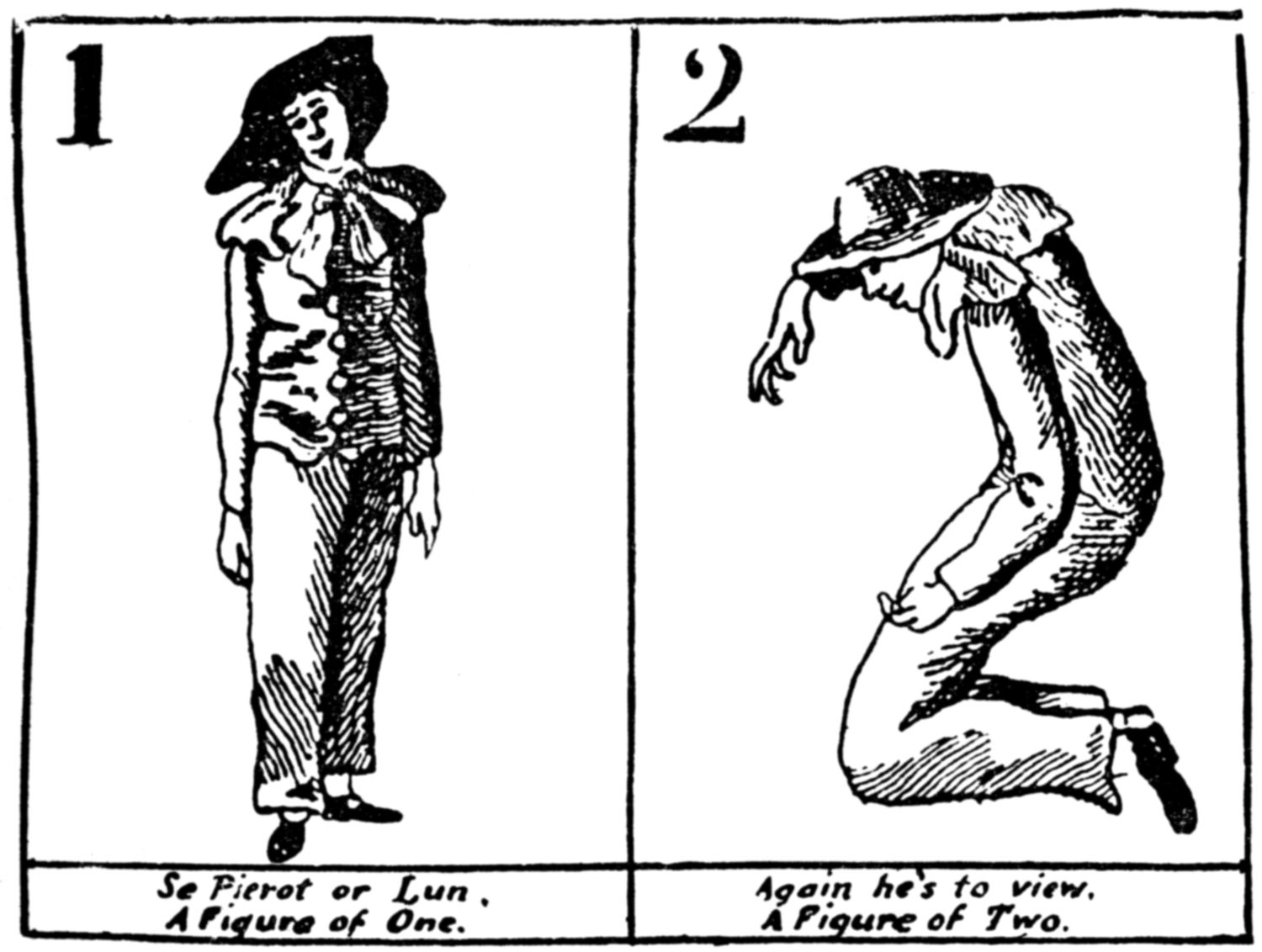
1
Se Pierot or Lun,
A Figure of One.
2
Again he’s to view,
A Figure of Two.
32. A CHARADE
My whole is quite sure to be in.
Divided afresh, there is reckoned
A wit, or a something that’s thin.
Prefix a letter, and, as dear as paint,
You see the name of an old English Saint.
[50]
No. L.—DIGITS IN THE FIDGETS
Here is the second pair of this queer company:—
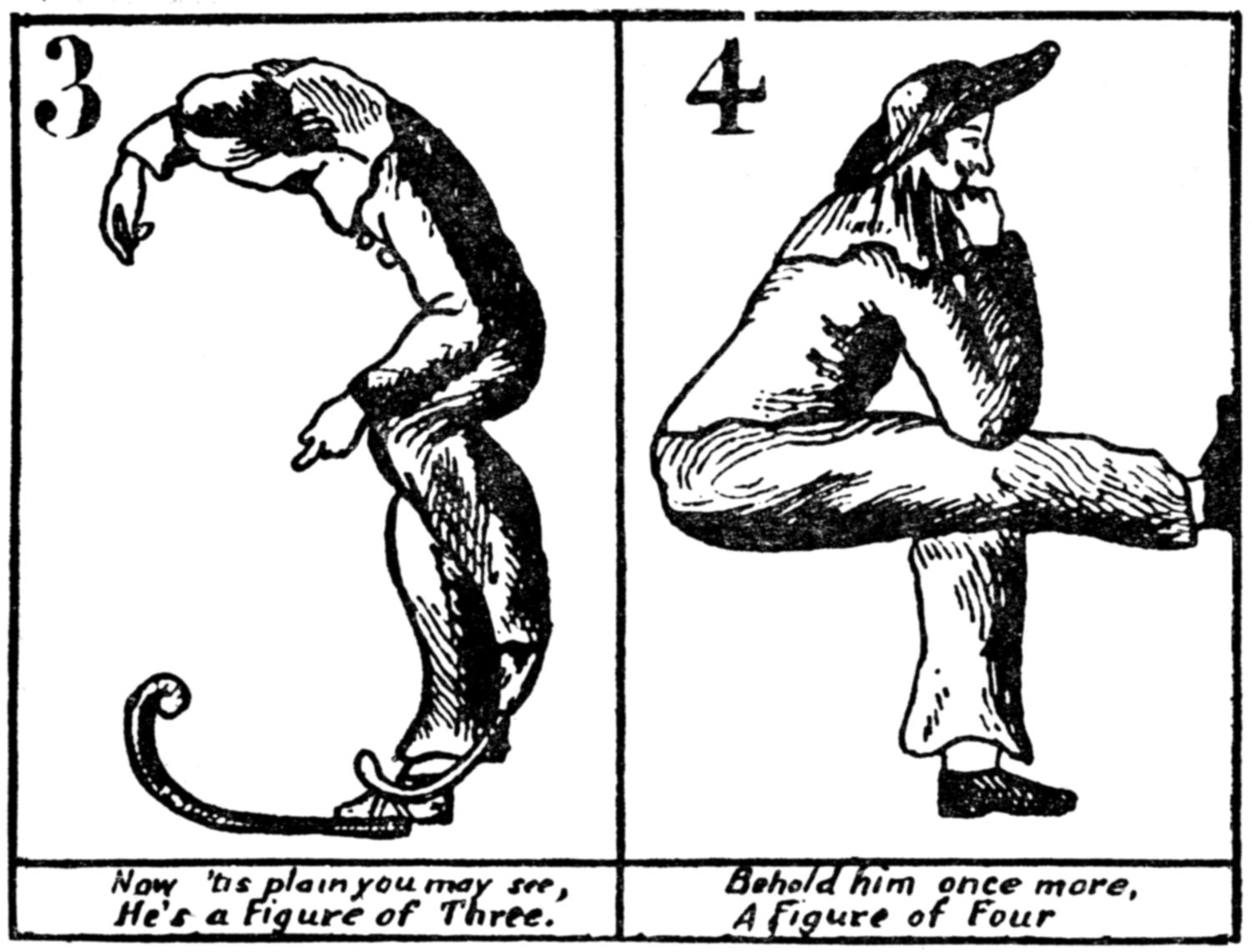
3
Now ’tis plain you may see,
He’s a Figure of Three.
4
Behold him once more,
A Figure of Four.
33. ONE GOOD TURN DESERVES ANOTHER
To a slight noise may turn;
My second twist, a stately word,
And it will bend we learn.
34. AN ENIGMA
Then half a score.
When this is duly done
Almost ten more.
This can be good for none,
But trial sore.
[51]
No. LI.—DIGITS IN THE FIDGETS
Here is the third pair of these quaint characters:—
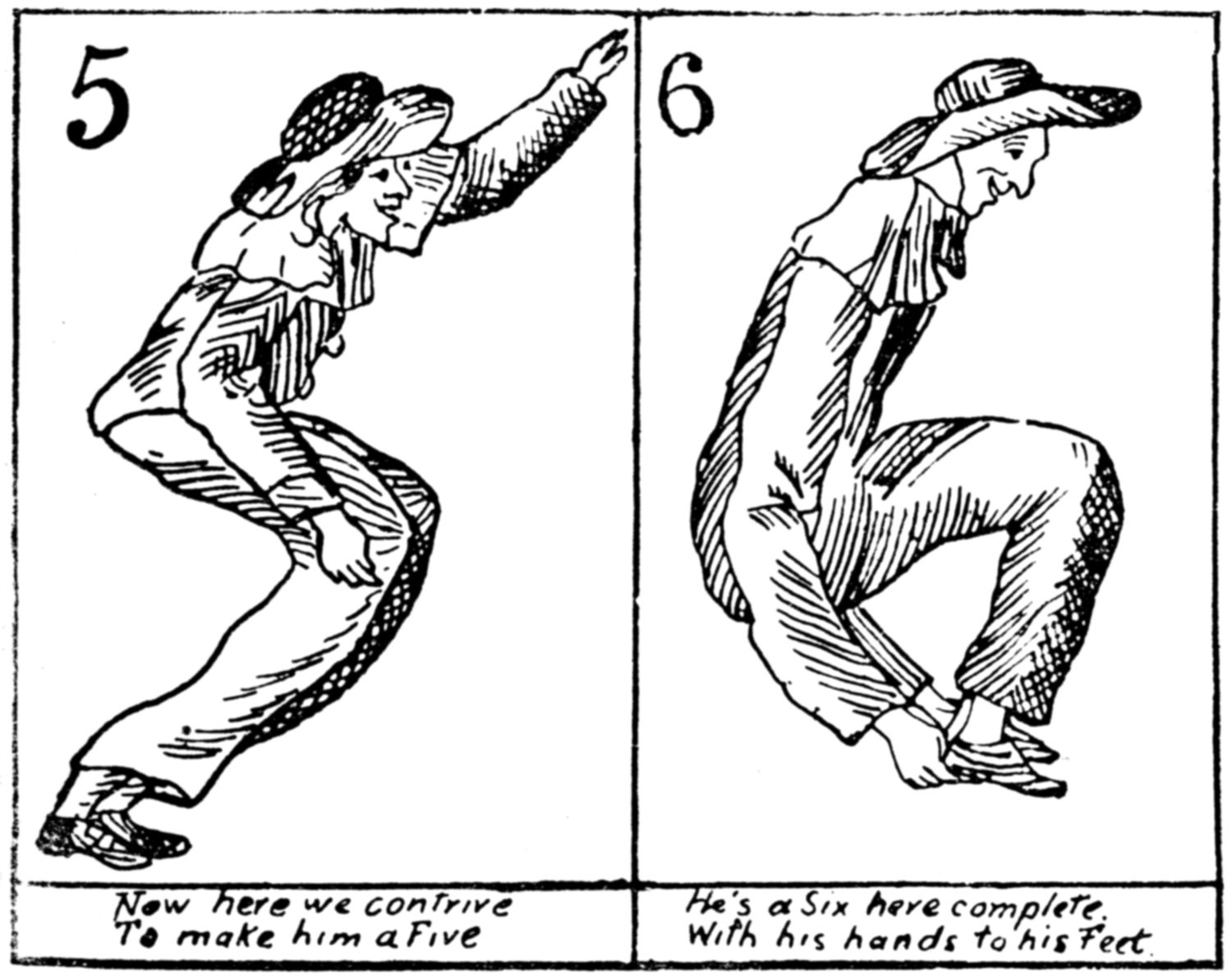
5
Now here we contrive
To make him a Five
6
He’s a Six here complete,
With his hands to his feet.
35. A BURIED PROVERB
A proverb of eight words is buried here:—
I fancy this Tory outcry, this weary outrageous attempt to show illegality, is as a cat chasing snow-flakes. I must be forgiven if I shun his example.
36. MISSING WORDS
Like ....... of ropes far too rotten to hold,
....... a ....... ....... and disasters
For a State that ....... not incapable masters.
The six missing words are spelt with the same seven letters.
[52]
No. LII.—DIGITS IN THE FIDGETS
Here is another pair of these quaint figures:—
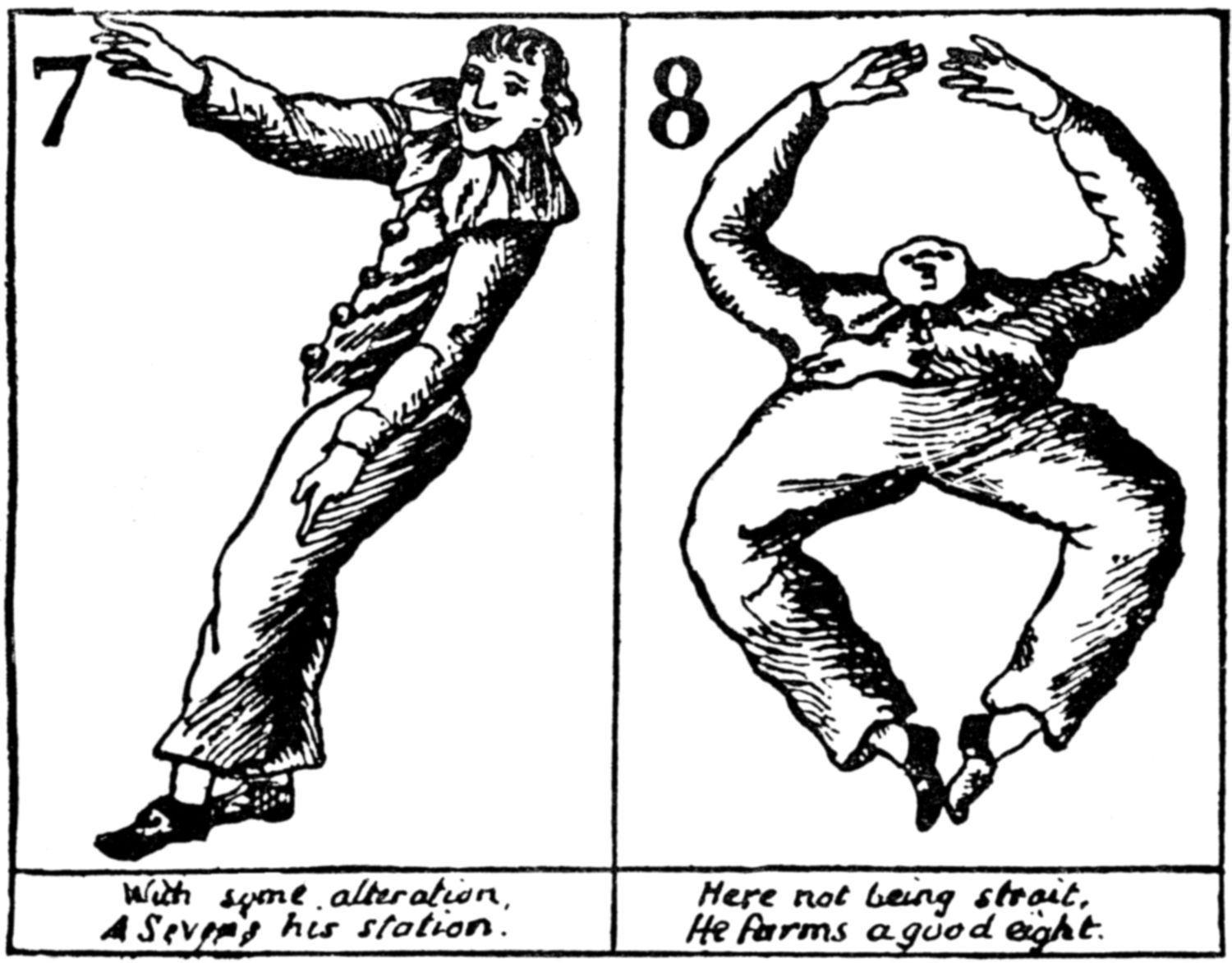
7
With some alteration,
A Seven’s his station.
8
Here not being strait,
He forms a good eight.
37. A CHARADE
My second a snare,
My whole is the offspring of fancy,
Which I sent on its way
Last Valentine’s Day,
As a token of love to my Nancy.
38. A LOVER’S VOW
Shall never be my second;
It shall my all, come best, come worst,
Be surely reckoned.
[53]
No. LIII.—DIGITS IN THE FIDGETS
Here is the final pair:—
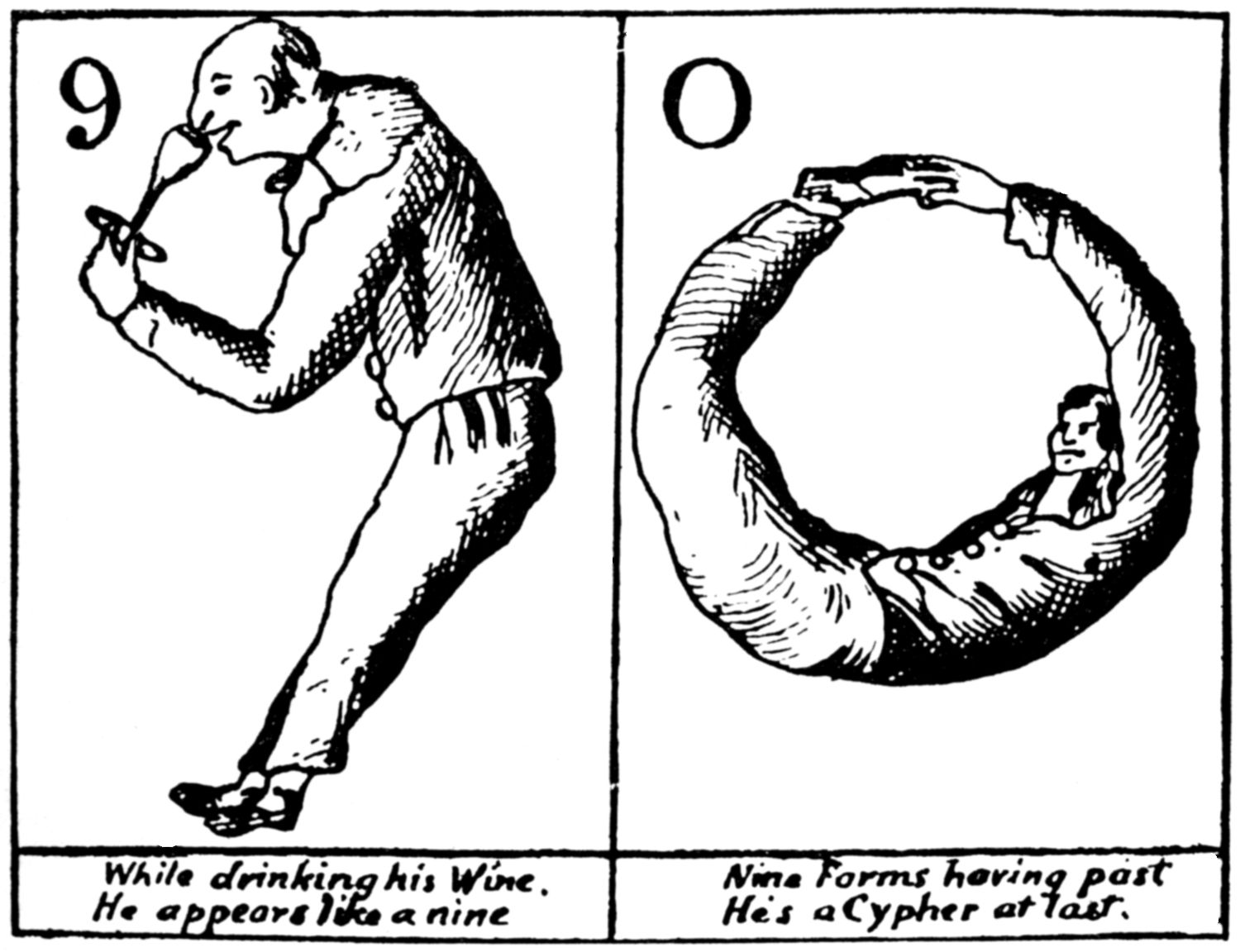
9
While drinking his Wine,
He appears like a nine.
0
Nine Forms having past
He’s a Cypher at last.
39. AN ENIGMA
I am a tree, I am a name,
Cut me in pieces with a sword,
You and your act would be the same.
Thrice you must leave the aspirate in doubt,
And use it twice if you would find me out.
40. ANSWER BY ANAGRAM
If you “resist disasters,” how may this affect one of your home circle?
[54]
No. LIV.—A FREAK OF FIGURES
1 × 8 + 1 = 9
12 × 8 + 2 = 98
123 × 8 + 3 = 987
1234 × 8 + 4 = 9876
12345 × 8 + 5 = 98765
123456 × 8 + 6 = 987654
1234567 × 8 + 7 = 9876543
12345678 × 8 + 8 = 98765432
123456789 × 8 + 9 = 987654321
41. A CHARADE
When in rich hues it glows.
My next has vowels three;
My third was once a tree.
My fourth begins the year,
My whole the past makes clear.
42. ASK A SCHOOLBOY
If you tell a schoolboy that the longest side of a triangular field measures 100 rods, and that each of the other sides measures 50 rods, and ask him to estimate the value of its grass at £1 per acre, how should he answer?
43. A WHOLE LESS THAN ITS PART
Between my first and second:
Second has body, arms and face;
First is by inches reckoned.
[55]
No. LV.—SPINNING WHEELS
What is the smallest number of straight lines which can be drawn within this square so as to enclose each of the wheels within separate boundaries?
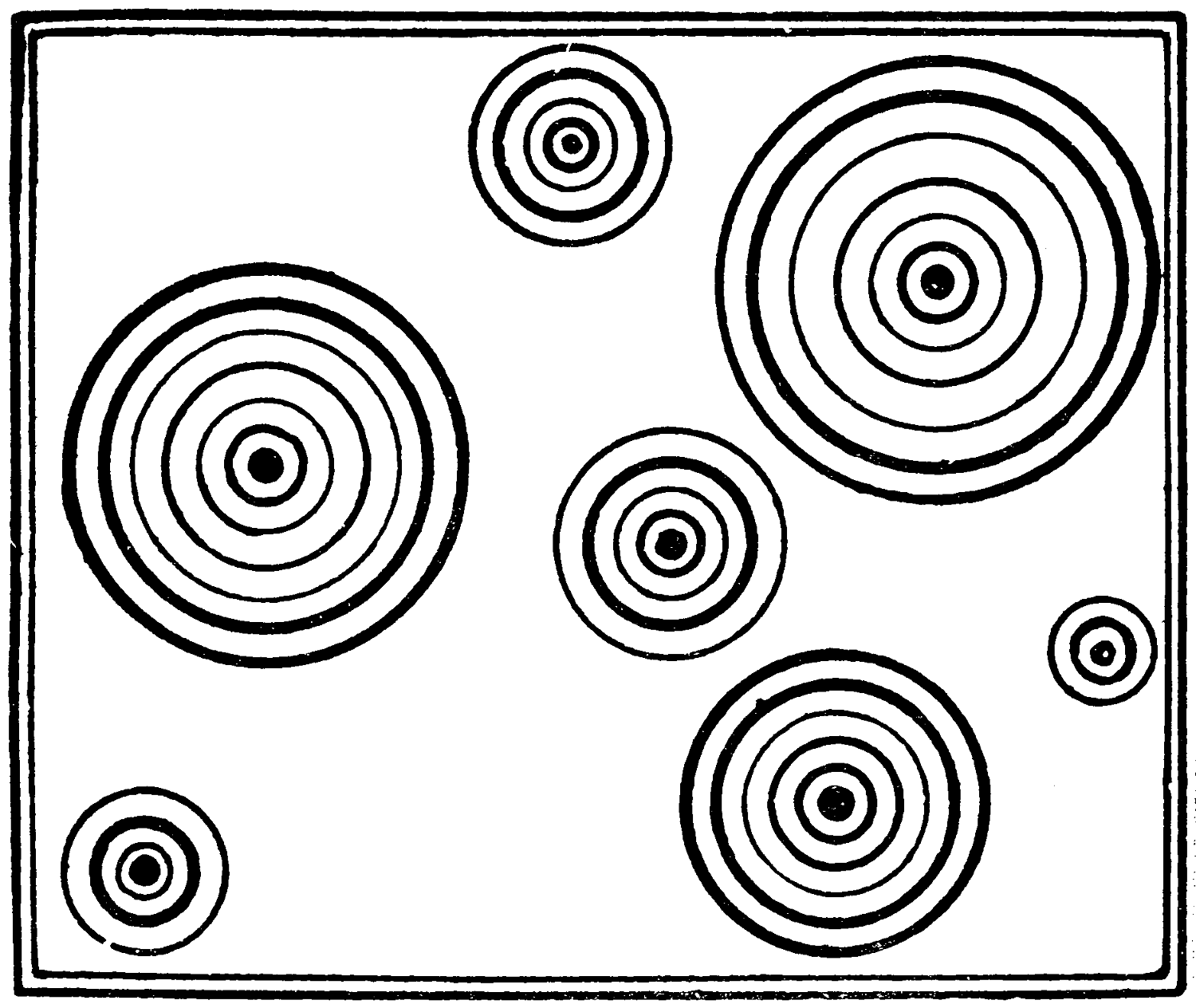
While solving this, rotate the paper in your hand, and see the wheels spin.
44. A HISTORICAL CHARADE
And at its sound the soldier springs to arms;
My second nowadays fair ladies scorn,
Though in less dainty days it oft was worn.
My whole, a battle fought on Scottish ground,
With victory the rebel forces crowned.
[56]
No. LVI.—FOUR QUARTERS AMONG FIVE
A market gardener who has a large square plot of ground wishes to reserve a fourth of it in the shape of a triangle for himself, as is shown in the diagram—
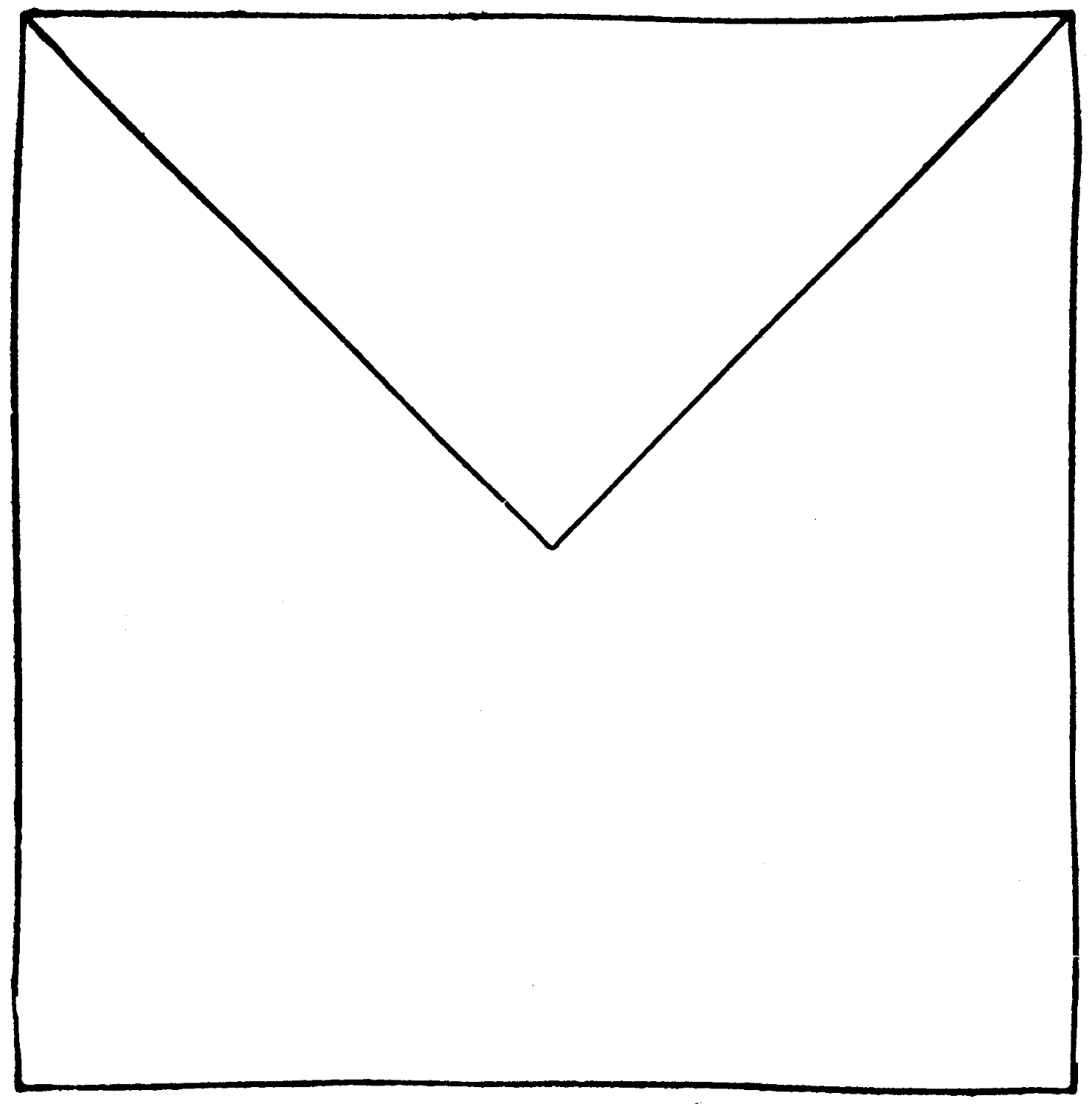
and to divide the remainder among his four sons, so that each shares equally, with plots of similar shape. How did he mark it out for them?
This appears in a less perfect form in “The Twentieth Century Standard Puzzle Book.”
[57]
No. LVII.—USE YOUR PENCIL
Here is a simple little puzzle which may amuse anyone who has paper and pencil at hand:—
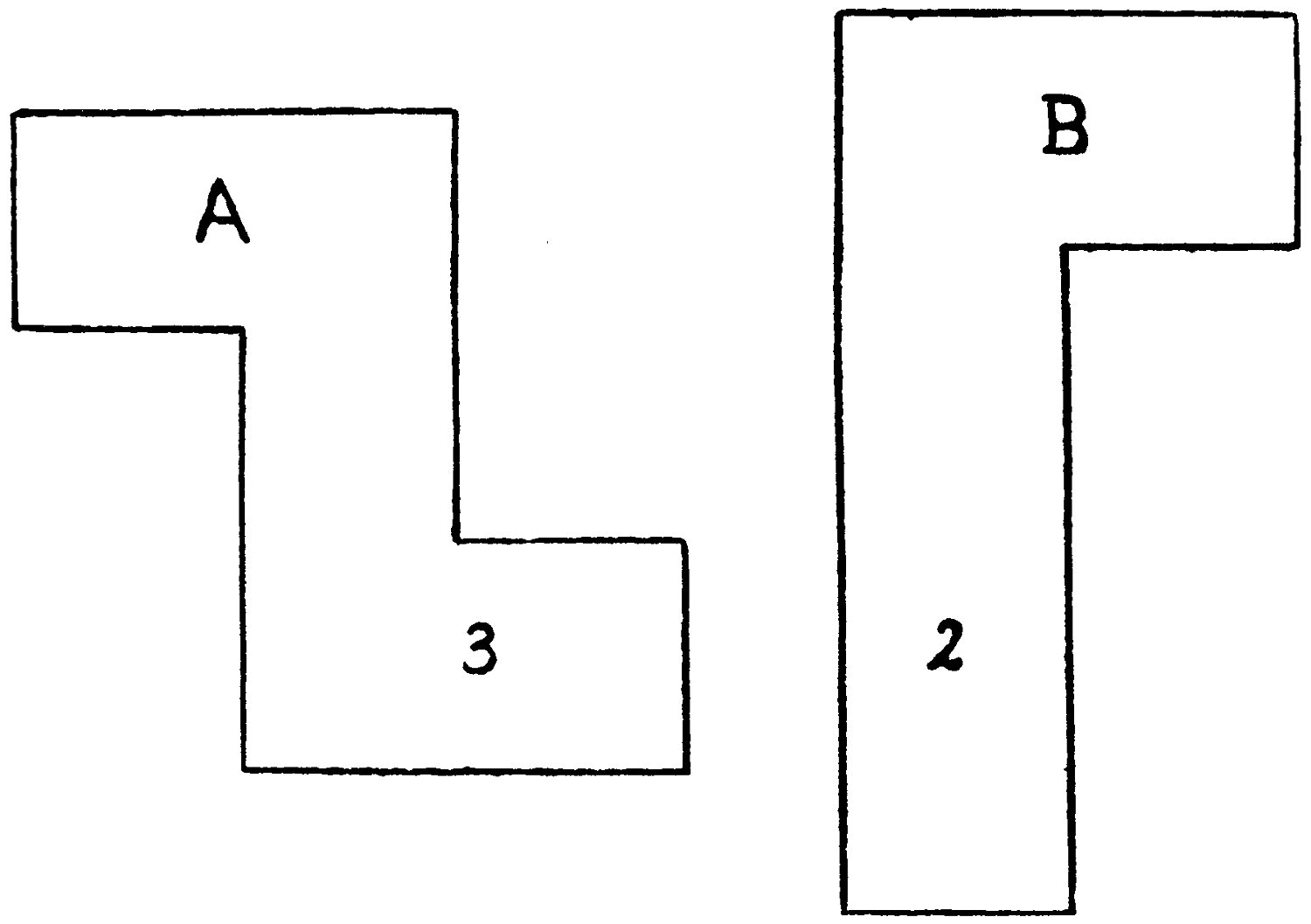
Can you combine three figures similar to Fig. A with two similar to Fig. B, so that a perfect Latin cross is formed?
It is, of course, an easier matter to cut out five such pieces in paper or cardboard, and arrange them in the form required.
45. MISSING WORDS
Each ....... a ....... in versatile skill;
Each ....... so quaint, each idea so profound,
My barn’s at their service, whenever they will.
A company played there last night, but to-day
Ducks ......., and poultry have vanished away!
The missing words are spelt with the same seven letters.
[58]
No. LVIII.—SUBTLE SELFISHNESS
Four poor men were living in the cottages shown in this diagram, round a central lake well stocked with fish. Four rich men built their houses further afield, and selfishly determined to exclude their neighbours from access to the water.
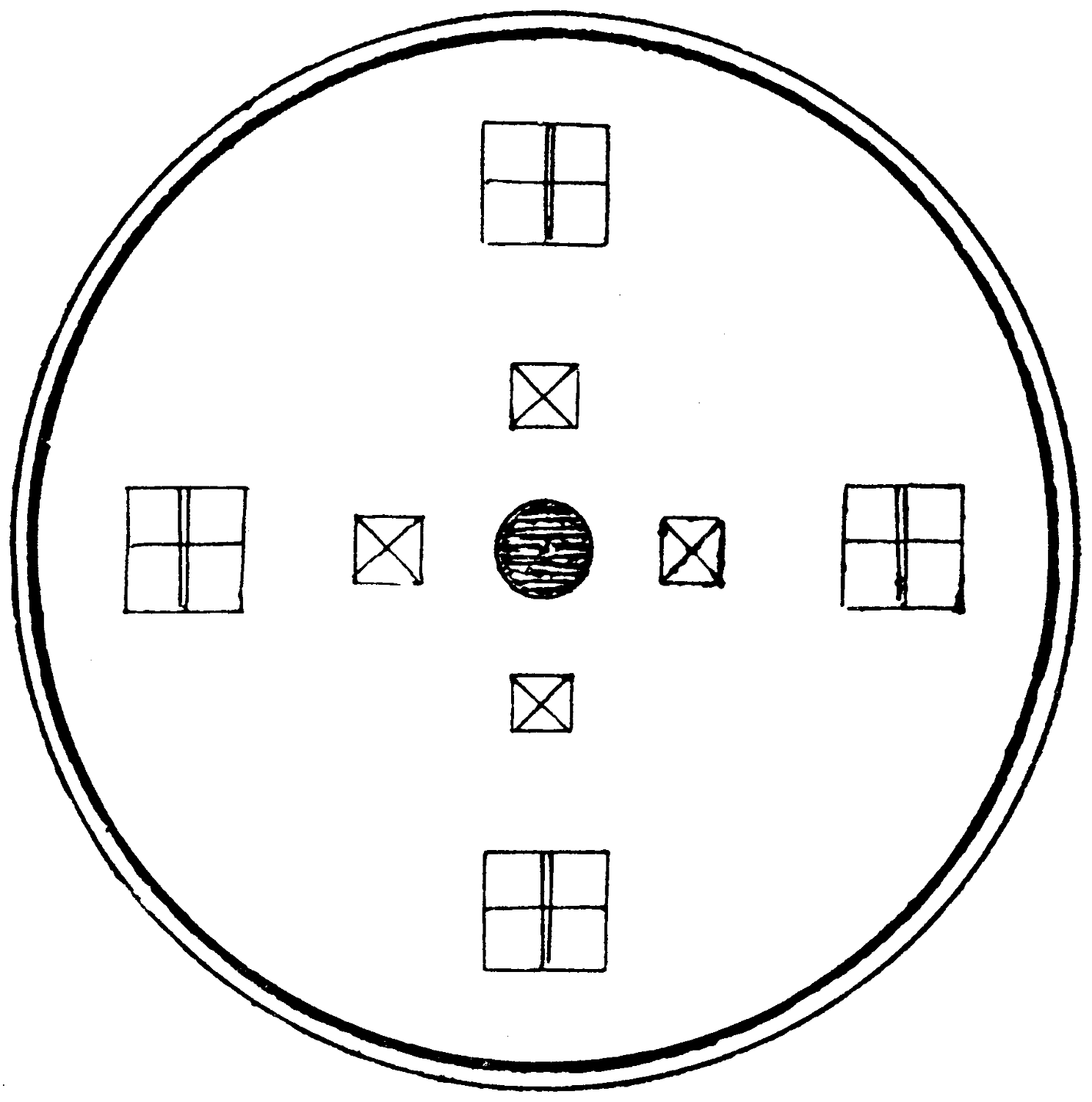
How could they do this effectually without cutting themselves off from the lake?
46. AN ARITHMOREM
150 hat robe or tent
Can you form from this the name of a famous British author, treating the 150 as Roman numerals?
[59]
No. LIX.—FOR THE CHILDREN
Cut out in cardboard four pieces of the shape and size of each of the large patterns, and two pieces of the small one:—
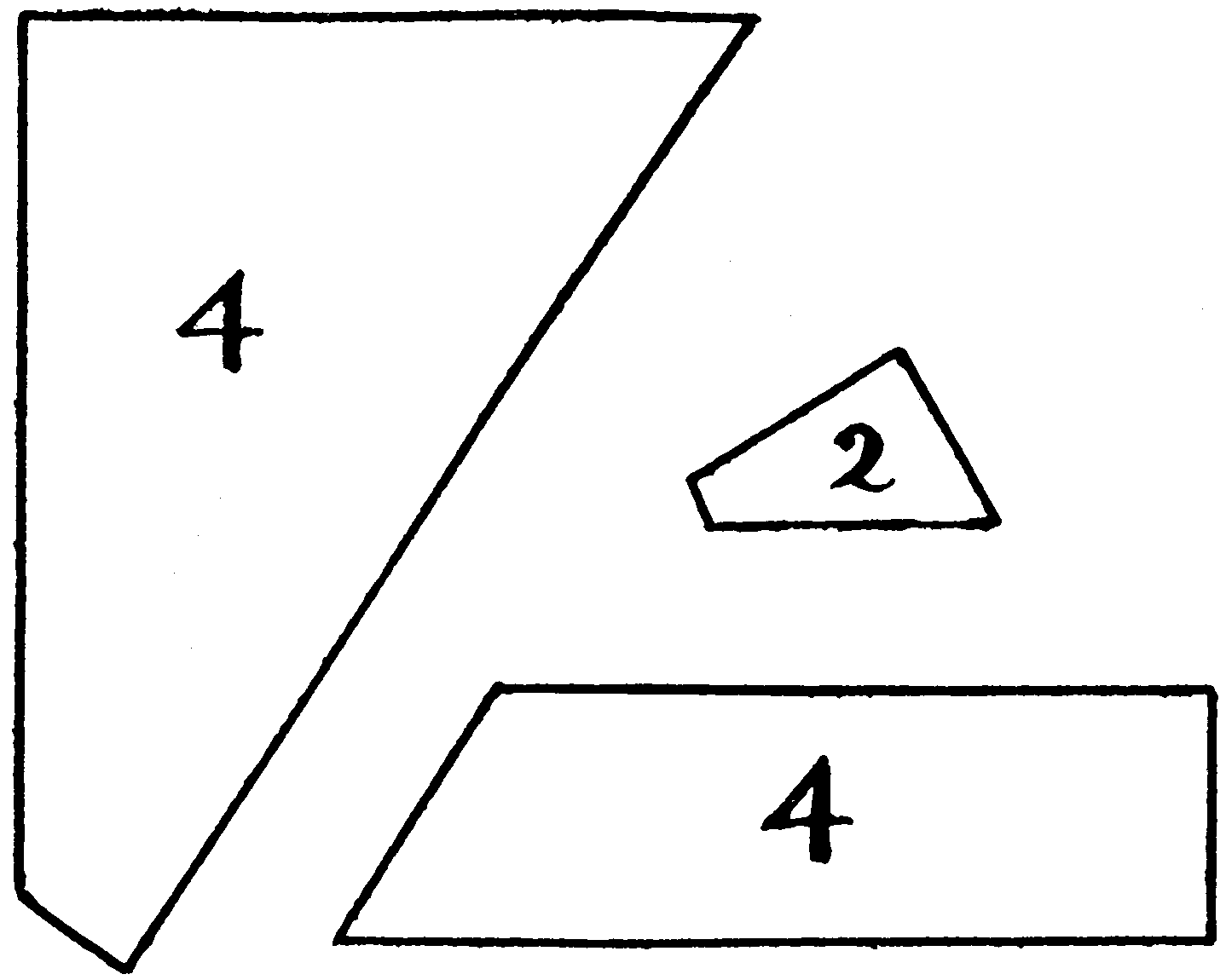
Now arrange these ten pieces so that they form a perfect square.
47. SHEDDING LETTERS
Of all that are busy in country and town.
Take from me one letter, and yet my good name
In spite of this loss will continue the same.
Take from me two letters, and still you will see
That precisely the same in effect I shall be.
Take from me three letters, or even take more,
Yet still I continue as sound as before.
[60]
No. LX.
The dotted lines in this diagram show how the figure can be divided into nine parts by four straight cuts
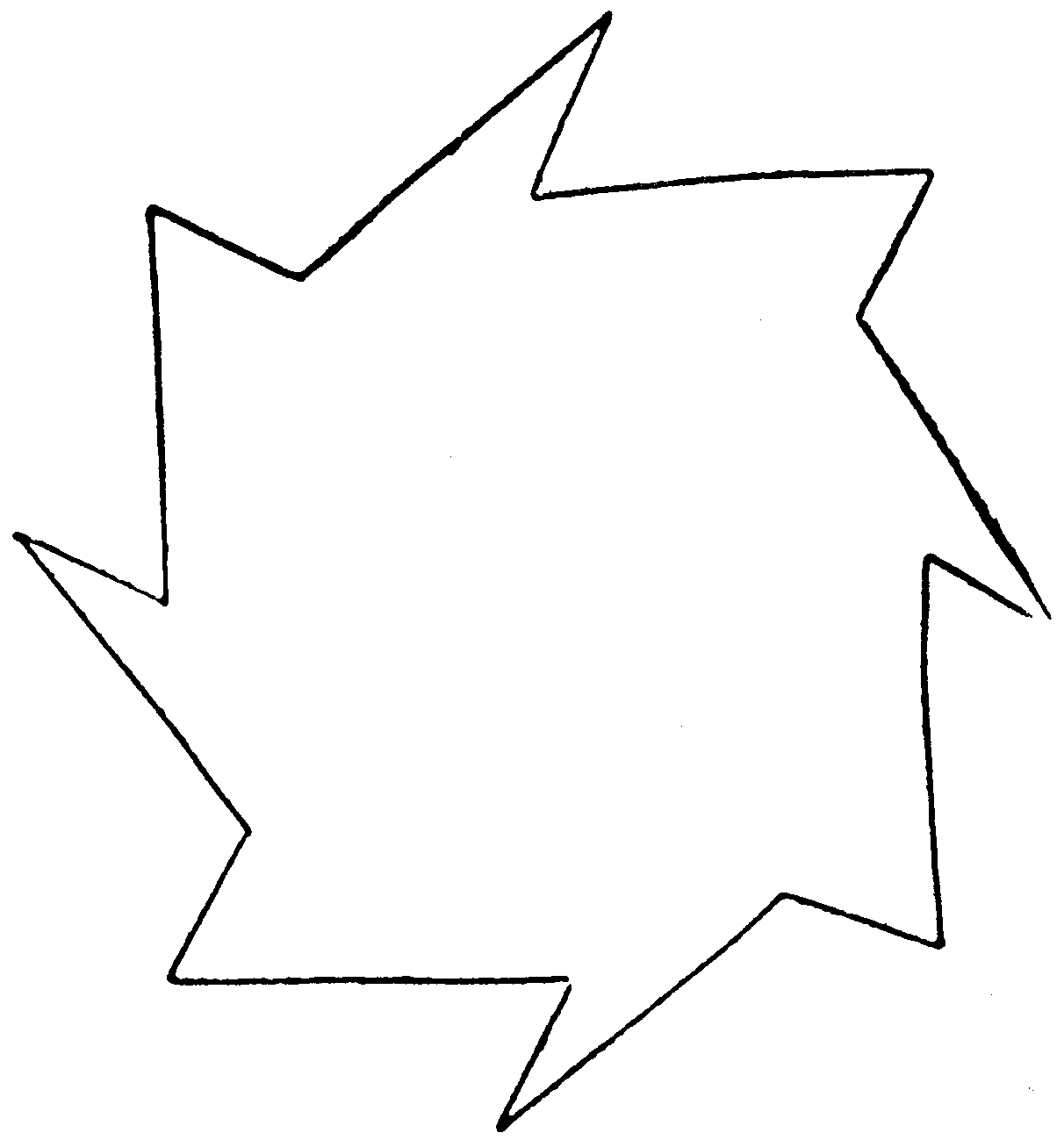
which can be reunited to form a perfect cross.
48. A SHARP BOY
Tom Larkins, proud of his prize for arithmetic, challenged his sisters to show on a blackboard that if 50 is subtracted from the sum of the nine digits, the result is equal to the number obtained by dividing their sum by 3. How did he prove his point?
[61]
No. LXI.—AN EASY ONE
Take in paper or cardboard a figure made up of a square and half of a similar square, thus:—
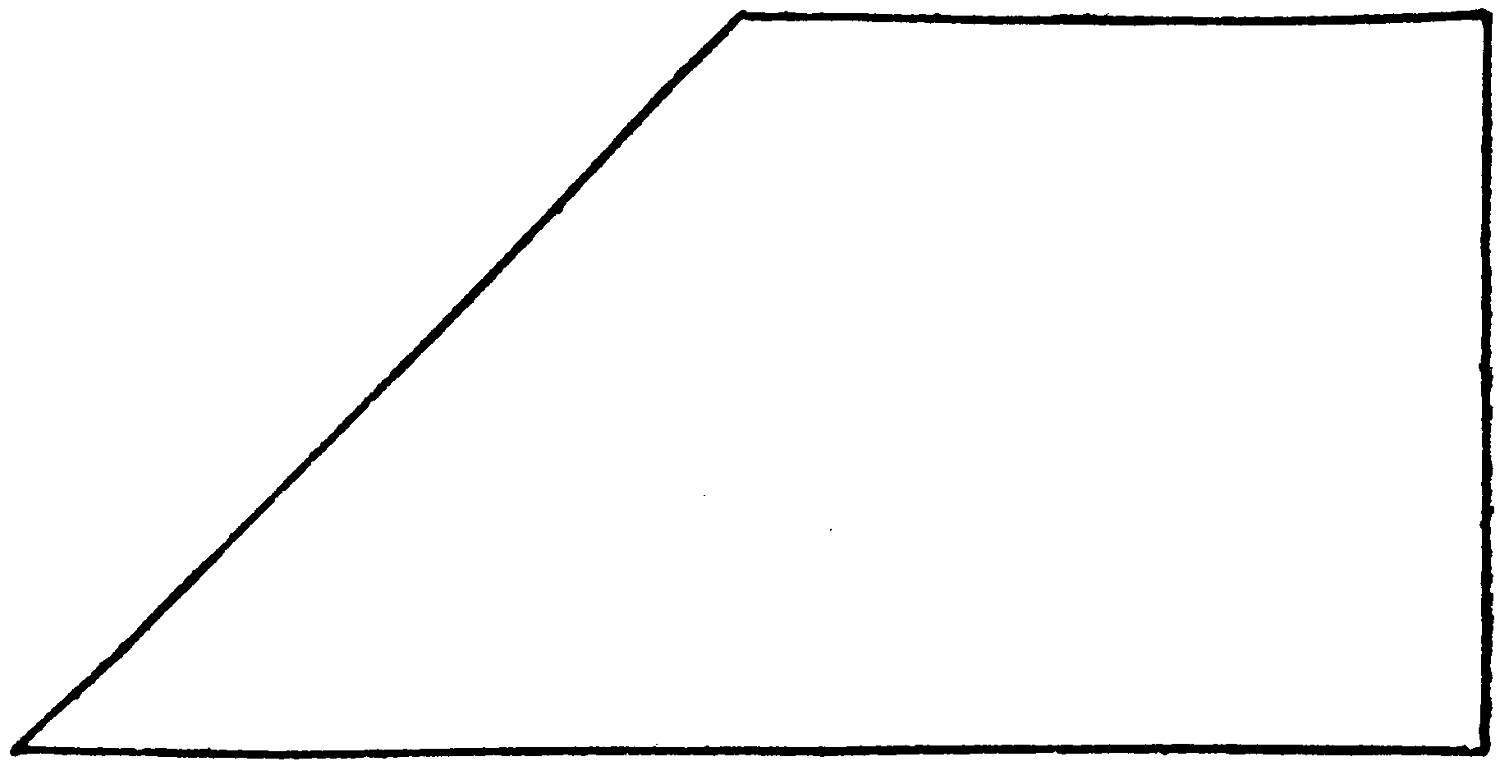
How can you, in the simplest way, divide it into four equal and similar parts by four straight cuts?
49. GEESE TO MARKET
And met with Farmer A;
Said Farmer A, “How much apiece
For this lot did you pay?”
Said B, “I paid for all I drive
Just six pounds and a crown,
And I am selling all but five
At the next market town.
If fifteen pence a head I charge
Beyond the price I paid.
I shall secure a sum as large
As he who sold all made.”
[62]
No. LXII
Can you draw twenty-two straight lines within this circle so that they divide it into four similar parts, each having three of the dots within its borders?
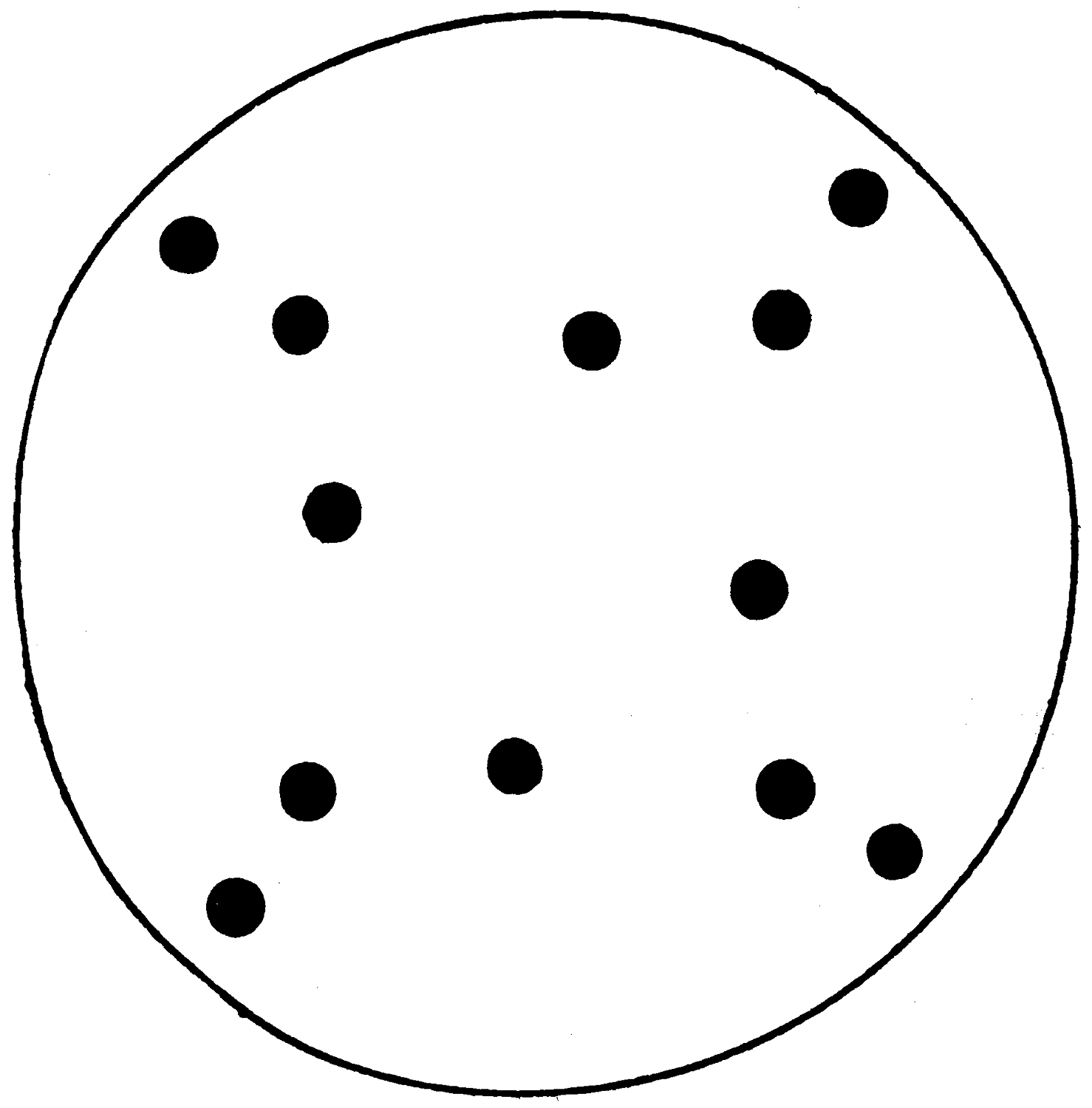
Each line must be at right angles to another.
50. A QUAINT CHARADE
For best or for worst,
I thought myself happy to win her.
But what could I say
When the very next day
She gave me the whole for my dinner?
[63]
No. LXIII
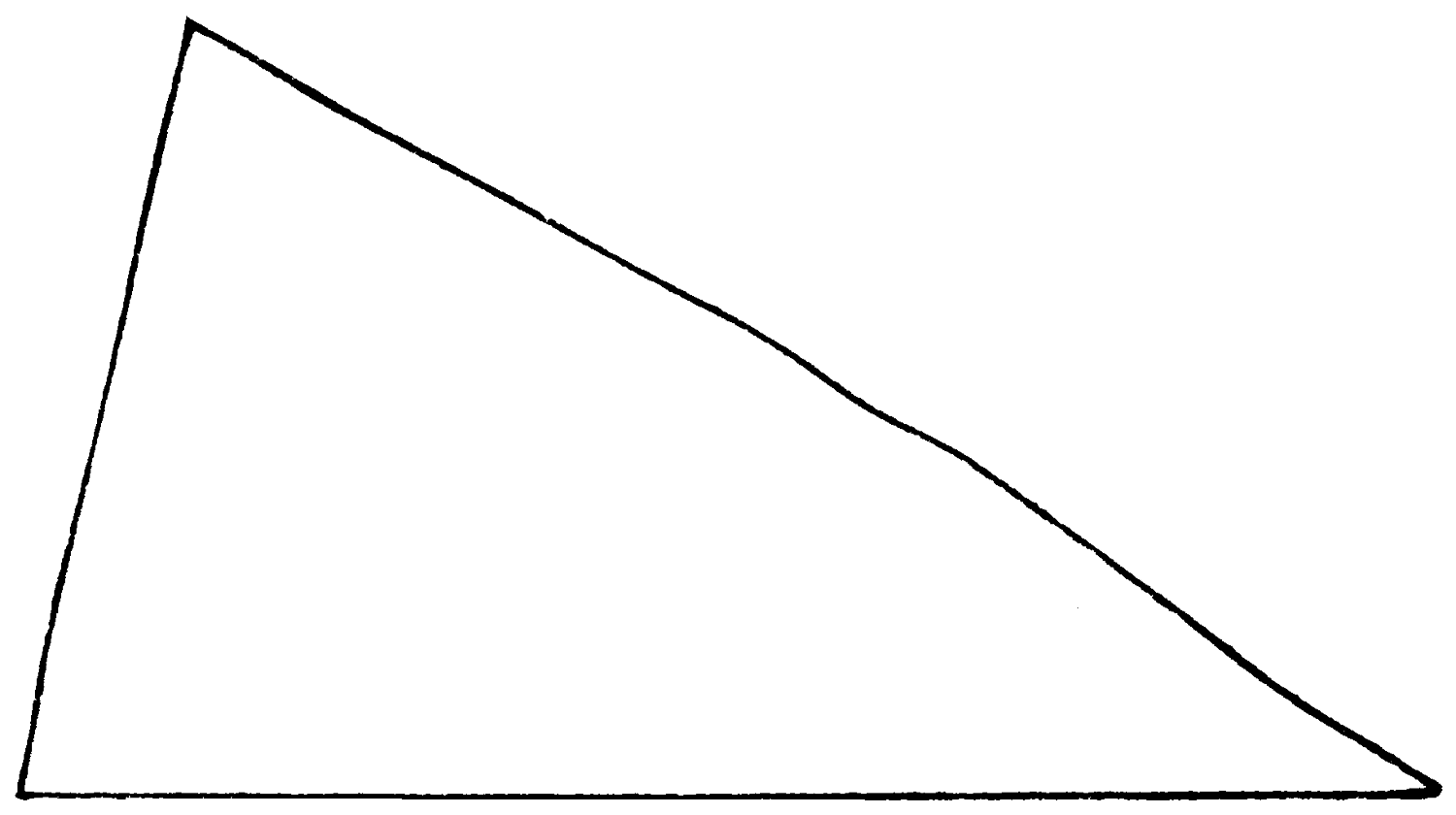
Cut up this triangle into 5 parts,
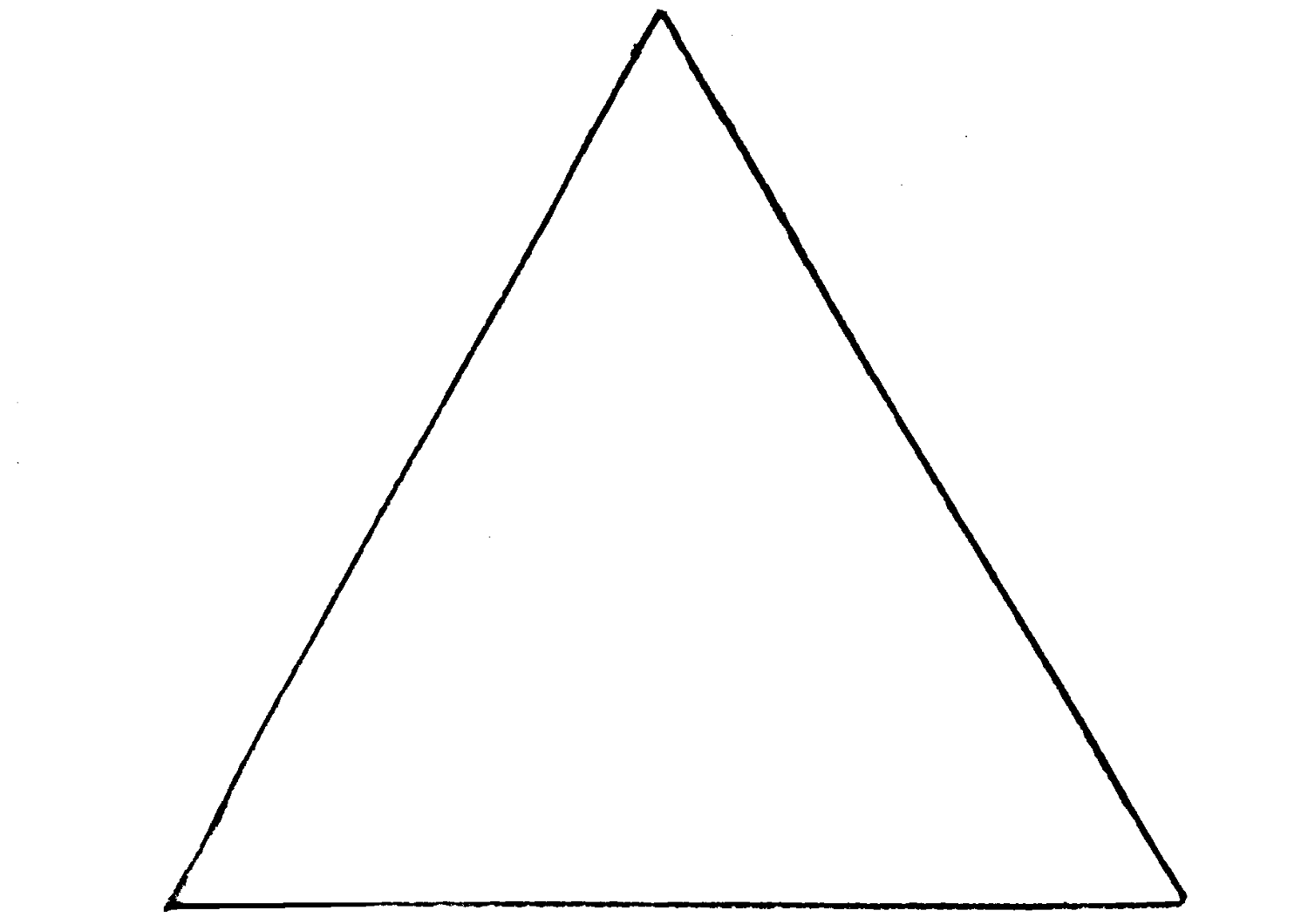
which can be reassembled to form this triangle.
[64]
No. LXIV.—ARITHMETICAL TRIANGLE
The peculiar series of numbers, as arranged in this triangular form, is said to have been perfected by Pascal.
| 1 | |||||||
| 2 | 1 | ||||||
| 3 | 3 | 1 | |||||
| 4 | 6 | 4 | 1 | ||||
| 5 | 10 | 10 | 5 | 1 | |||
| 6 | 15 | 20 | 15 | 6 | 1 | ||
| 7 | 21 | 35 | 35 | 21 | 7 | 1 | |
| 8 | 28 | 56 | 70 | 56 | 28 | 8 | 1 |
It has the property of showing, without calculation, how many selections or combinations can be made at a time out of a larger number. Thus to find how many selections of 3 at a time can be made out of 8 we look for the third number on the horizontal row that commences with 8, and find the answer 56.
The series is formed thus: Set down the numbers 1, 2, 3, etc., as far as you please, in a vertical row. To the right of 2 place 1, add them together, and set 3 under the 1. Then add 3 to 3, and set the result below, and so on, always placing the sum of two numbers that are side by side below the one on the right.
[65]
No. LXV.—MULTIPLICATION NO VEXATION
This diagram shows an ancient and curious method of multiplication, which will be novel to most of our readers.
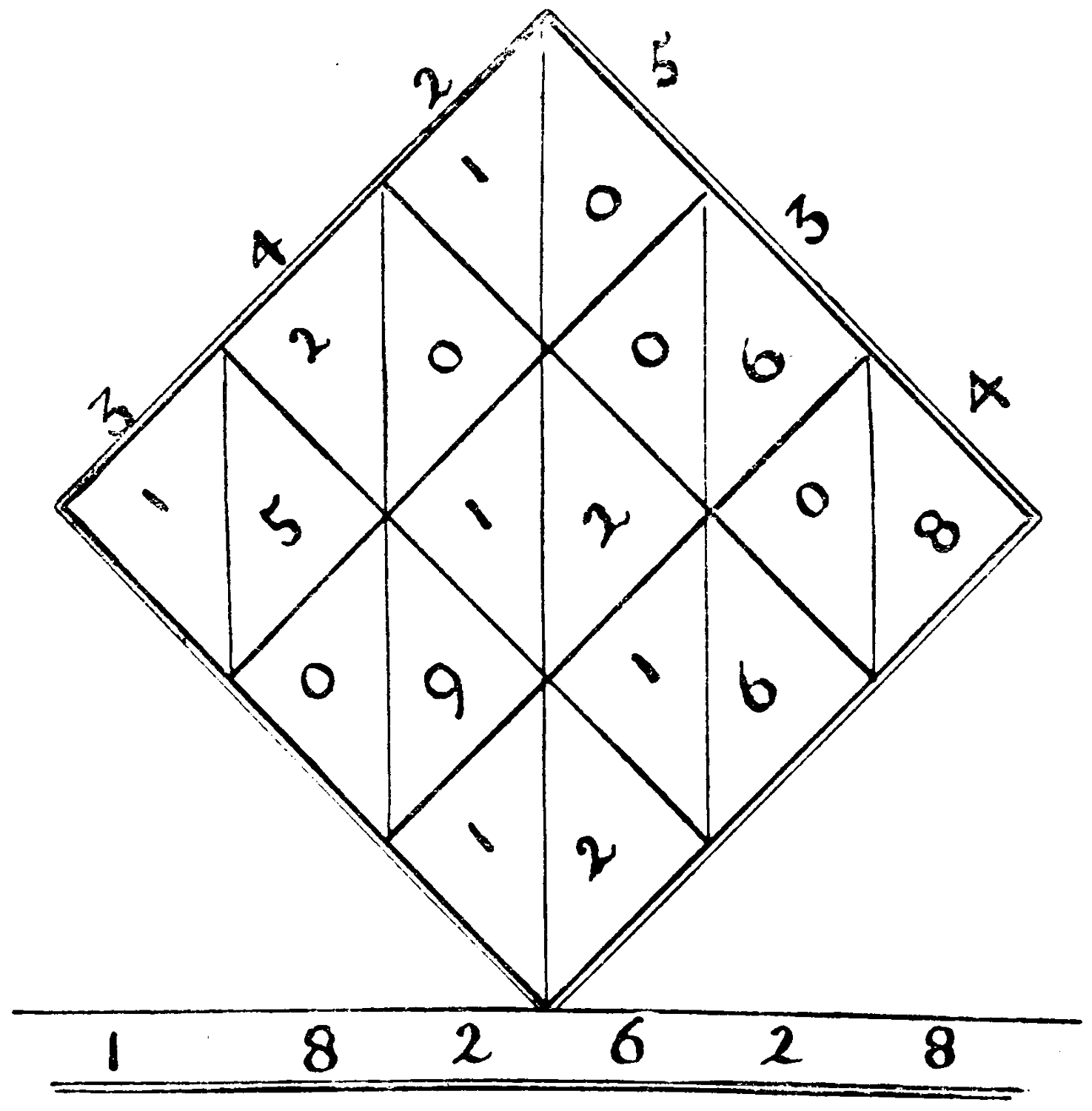
In this instance 534 is multiplied by 342. Draw a square of nine cells with diagonals, fill the three top cells, as is shown, by multiplying the 5 by the 3, the 4 and the 2. Then multiply in similar way the 3 and the 4 by these same figures. Turn the square round so that the diagonals are upright, and add. Of course, placing the numbers thus is the same practically as carrying them by our ordinary rule.
[66]
No. LXVI
In this diagram 27 counters are arranged in 9 rows, with 6 in each row.
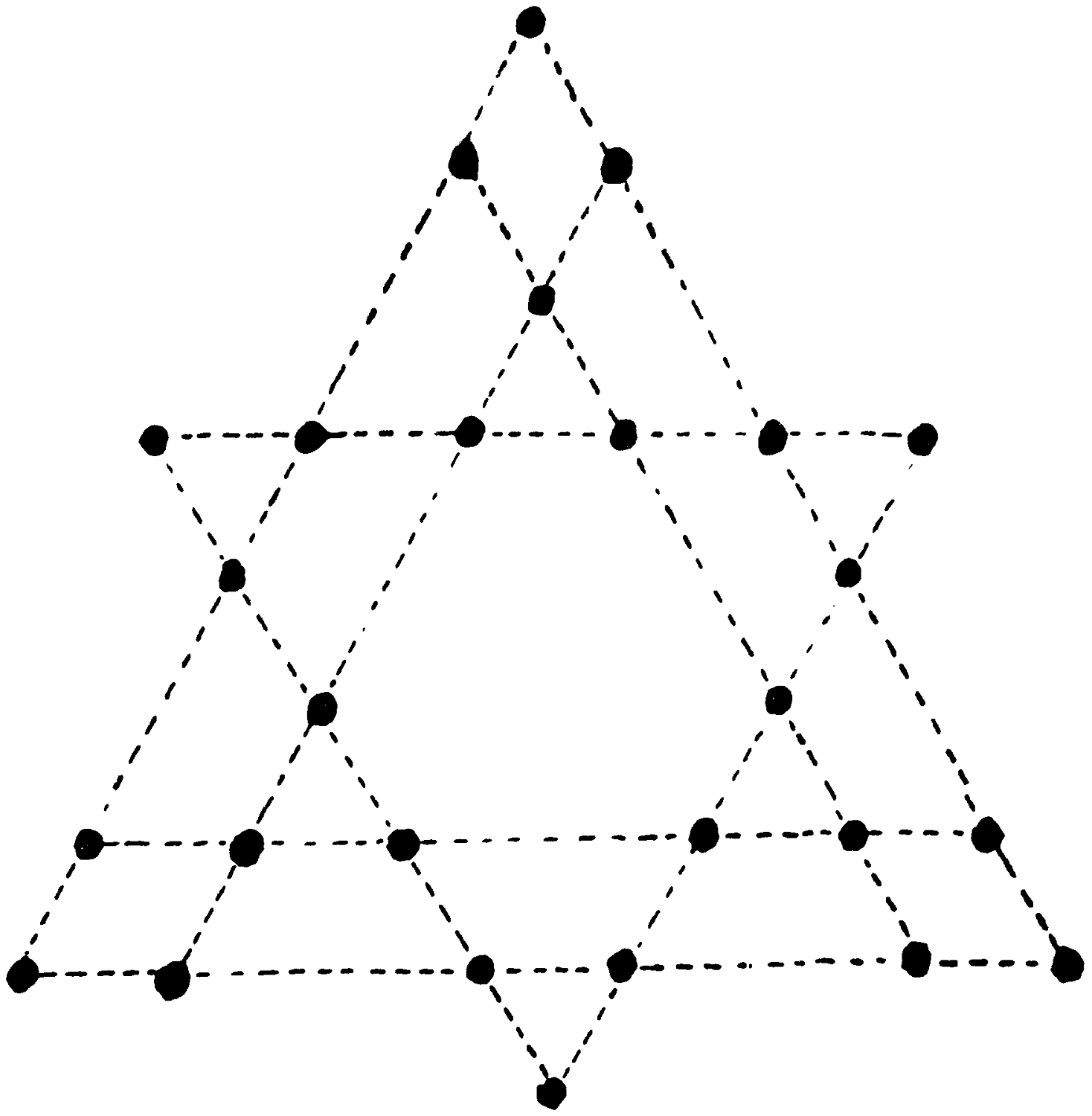
Can you rearrange them so that with similar conditions they all fall within the borders of one equilateral triangle?
51. A BURIED ADAGE
Blending so sweetly with the restful air;
The noiseless, deep-laced twilight shadows come,
And well I ken the lass who meets me there.
Can you discover a very familiar saying that is buried in these lines?
[67]
No. LXVII.—AN EIGHT-CARD PUZZLE
Place eight cards of two different colours alternately in one row, then with four moves bring all of one colour together.
| A ♠ |
2 ♡ |
3 ♣ |
4 ♢ |
5 ♣ |
6 ♢ |
7 ♣ |
8 ♡ |
Two cards (without altering their relative position) are to be moved at a time, and placed somewhere in the same line, one of them at least touching another card.
52. MUTILATIONS
Becomes a mighty beast instead;
But then the subject of my riddle
Is cut asunder in the middle;
And nothing this division gains,
Though unknown quantity remains.
53. MISSING WORDS
Writing ..... dramatic.
Did she ..... the plots she planned?
Negative emphatic!
..... to us the ..... may be
But at ..... they’re new to she!
The missing words are spelt with the same five letters.
[68]
No. LXVIII.—THOUGHT READING
Cut out this diagram, and paste it on a card. Hand it to anyone, and ask him to fix upon whichever number he pleases, and merely to tell you in which columns this appears.
| I. | II. | III. | IV. | |||||||||||||||
| 1 | 33 | 65 | 97 | 2 | 34 | 66 | 98 | 4 | 36 | 68 | 100 | 8 | 40 | 72 | 104 | |||
| 3 | 35 | 67 | 99 | 3 | 35 | 67 | 99 | 5 | 37 | 69 | 101 | 9 | 41 | 73 | 105 | |||
| 5 | 37 | 69 | 101 | 6 | 38 | 70 | 102 | 6 | 38 | 70 | 102 | 10 | 42 | 74 | 106 | |||
| 7 | 39 | 71 | 103 | 7 | 39 | 71 | 103 | 7 | 39 | 71 | 103 | 11 | 43 | 75 | 107 | |||
| 9 | 41 | 73 | 105 | 10 | 42 | 74 | 106 | 12 | 44 | 76 | 108 | 12 | 44 | 76 | 108 | |||
| 11 | 43 | 75 | 107 | 11 | 43 | 75 | 107 | 13 | 45 | 77 | 109 | 13 | 45 | 77 | 109 | |||
| 13 | 45 | 77 | 109 | 14 | 46 | 78 | 110 | 14 | 46 | 78 | 110 | 14 | 46 | 78 | 110 | |||
| 15 | 47 | 79 | 111 | 15 | 47 | 79 | 111 | 15 | 47 | 79 | 111 | 15 | 47 | 79 | 111 | |||
| 17 | 49 | 81 | 113 | 18 | 50 | 82 | 114 | 20 | 52 | 84 | 116 | 24 | 56 | 88 | 120 | |||
| 19 | 51 | 83 | 115 | 19 | 51 | 83 | 115 | 21 | 53 | 85 | 117 | 25 | 57 | 89 | 121 | |||
| 21 | 53 | 85 | 117 | 22 | 54 | 86 | 118 | 22 | 54 | 86 | 118 | 26 | 58 | 90 | 122 | |||
| 23 | 55 | 87 | 119 | 23 | 55 | 87 | 119 | 23 | 55 | 87 | 119 | 27 | 59 | 91 | 123 | |||
| 25 | 57 | 89 | 121 | 26 | 58 | 90 | 122 | 28 | 60 | 92 | 124 | 28 | 60 | 92 | 124 | |||
| 27 | 59 | 91 | 123 | 27 | 59 | 91 | 123 | 29 | 61 | 93 | 125 | 29 | 61 | 93 | 125 | |||
| 29 | 61 | 93 | 125 | 30 | 62 | 94 | 126 | 30 | 62 | 94 | 126 | 30 | 62 | 94 | 126 | |||
| 31 | 63 | 95 | 127 | 31 | 63 | 95 | 127 | 31 | 63 | 95 | 127 | 31 | 63 | 95 | 127 | |||
| V. | VI. | VII. | |||||||||||
| 16 | 48 | 80 | 112 | 32 | 48 | 96 | 112 | 64 | 80 | 96 | 112 | ||
| 17 | 49 | 81 | 113 | 33 | 49 | 97 | 113 | 65 | 81 | 97 | 113 | ||
| 18 | 50 | 82 | 114 | 34 | 50 | 98 | 114 | 66 | 82 | 98 | 114 | ||
| 19 | 51 | 83 | 115 | 35 | 51 | 99 | 115 | 67 | 83 | 99 | 115 | ||
| 20 | 52 | 84 | 116 | 36 | 52 | 100 | 116 | 68 | 84 | 100 | 116 | ||
| 21 | 53 | 85 | 117 | 37 | 53 | 101 | 117 | 69 | 85 | 101 | 117 | ||
| 22 | 54 | 86 | 118 | 38 | 54 | 102 | 118 | 70 | 86 | 102 | 118 | ||
| 23 | 55 | 87 | 119 | 39 | 55 | 103 | 119 | 71 | 87 | 103 | 119 | ||
| 24 | 56 | 88 | 120 | 40 | 56 | 104 | 120 | 72 | 88 | 104 | 120 | ||
| 25 | 57 | 89 | 121 | 41 | 57 | 105 | 121 | 73 | 89 | 105 | 121 | ||
| 26 | 58 | 90 | 122 | 42 | 58 | 106 | 122 | 74 | 90 | 106 | 122 | ||
| 27 | 59 | 91 | 123 | 43 | 59 | 107 | 123 | 75 | 91 | 107 | 123 | ||
| 28 | 60 | 92 | 124 | 44 | 60 | 108 | 124 | 76 | 92 | 108 | 124 | ||
| 29 | 61 | 93 | 125 | 45 | 61 | 109 | 125 | 77 | 93 | 109 | 125 | ||
| 30 | 62 | 94 | 126 | 46 | 62 | 110 | 126 | 78 | 94 | 110 | 126 | ||
| 31 | 63 | 95 | 127 | 47 | 63 | 111 | 127 | 79 | 95 | 111 | 127 | ||
You can then in a moment, and at a glance, pick out the number that is chosen.
[69]
No. LXIX.—FROM PILLAR TO POST
Let us suppose that these black dots represent a succession of pillar boxes. It will be seen that a postman, starting from the circle, and going along the dotted lines, turns round 18 corners.
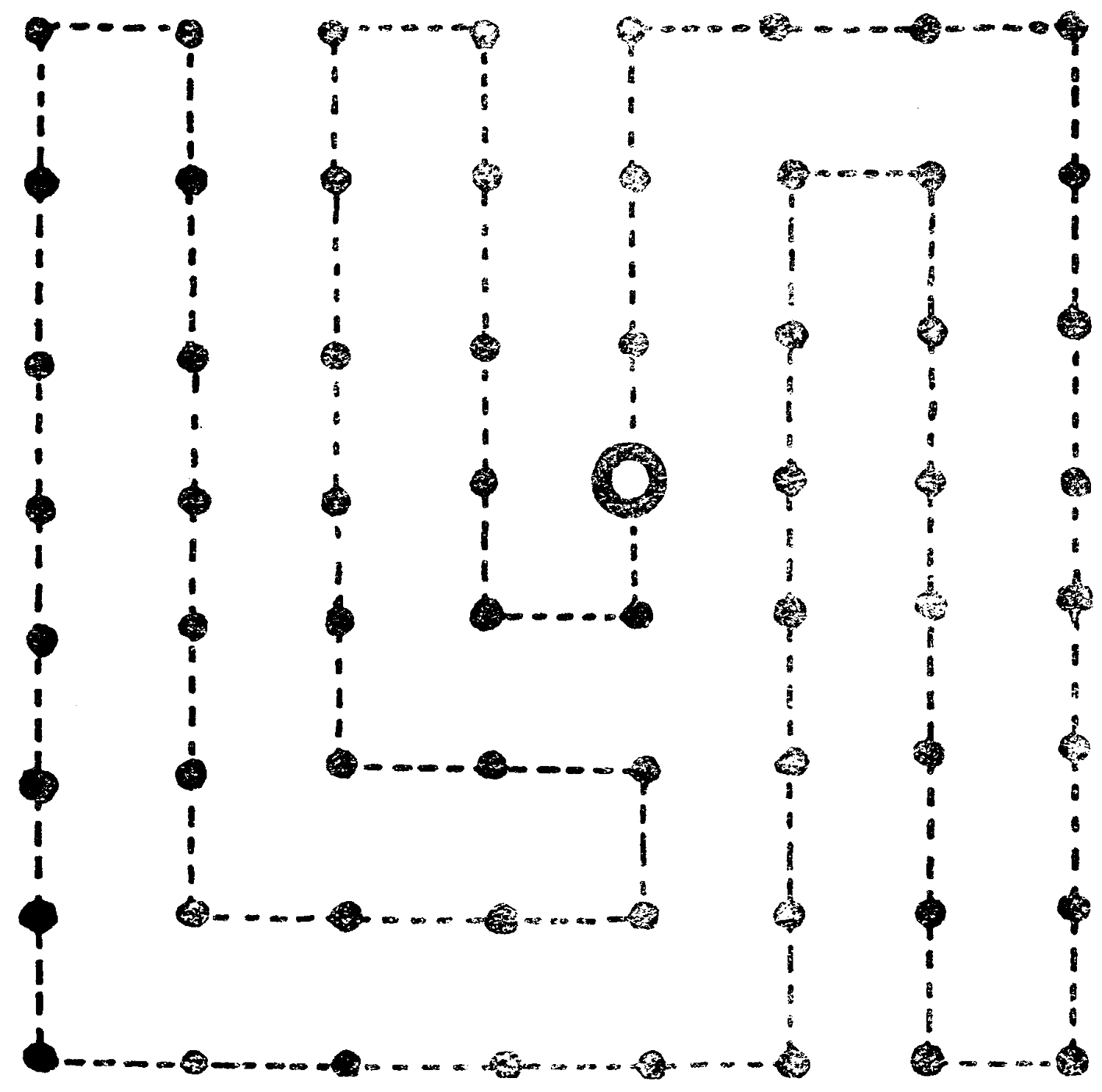
Can he take a course which involves fewer turnings?
[70]
No. LXX.—TRANSFORMATIONS
Here is an ingenious paper and scissors puzzle:—
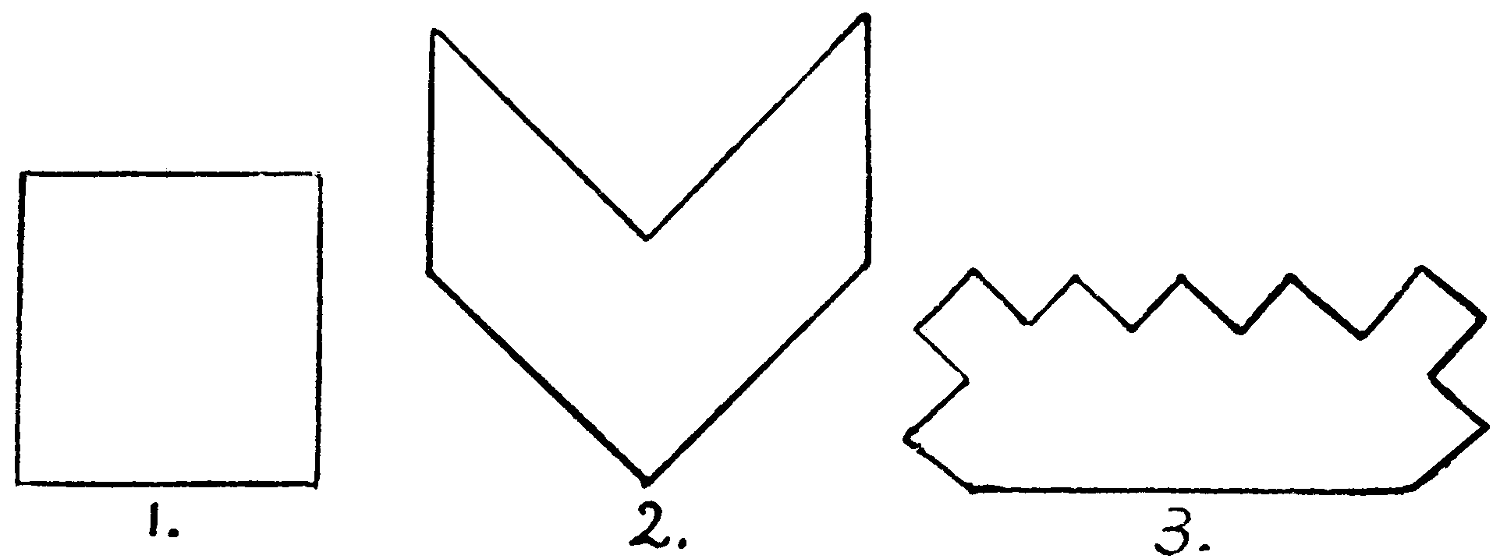
Divide a square card into three pieces, so that these can be reunited to form No. 2 or No. 3 of this diagram.
54. COUNTING THE GEESE
(From an old Sanscrit source, quoted by Longfellow in his “Kavanagh.”)
Ten times the square root of a flock of geese, seeing the clouds collect, flew to the Manus lake. One-eighth of the whole flew from the edge of the water among a tangle of water lilies, and three couples were seen playing in the water. Tell me, my young girl with beautiful locks, what was the whole number of geese?
55. A THIRD IS A HALF
That if you divide the whole number by three
You find the result will exactly express
The half of six hundred and sixty, no less.
[71]
No. LXXI.—A PUZZLE WITH CHESS PIECES
| ♚ | |||||||
| ♖ | ♘ | ♖ |
Leaving the Black King in his position, place the three white men so that he stands checkmated.
56. PRESS PARODIES
An American paper published the following:—
It cost very little to dress her;
She was sweet as a rose
In her everyday clothes,
But had no young man to caress her.
Next day this parody appeared in a rival paper:—
It cost very little to dress her;
Some ........... and .....
About Thanksgiving time,
And they ... the last bit from the ........
Can you fill in the missing words?
[72]
No. LXXII.—HEXAGONAL ILLUSIONS
If we look with one eye only, or with eyes half-closed, at these groups of circular dots, they assume the appearance familiar to us in honeycomb. This is an effect of the contrast and opposition of the black and white in the sensation of the retina.
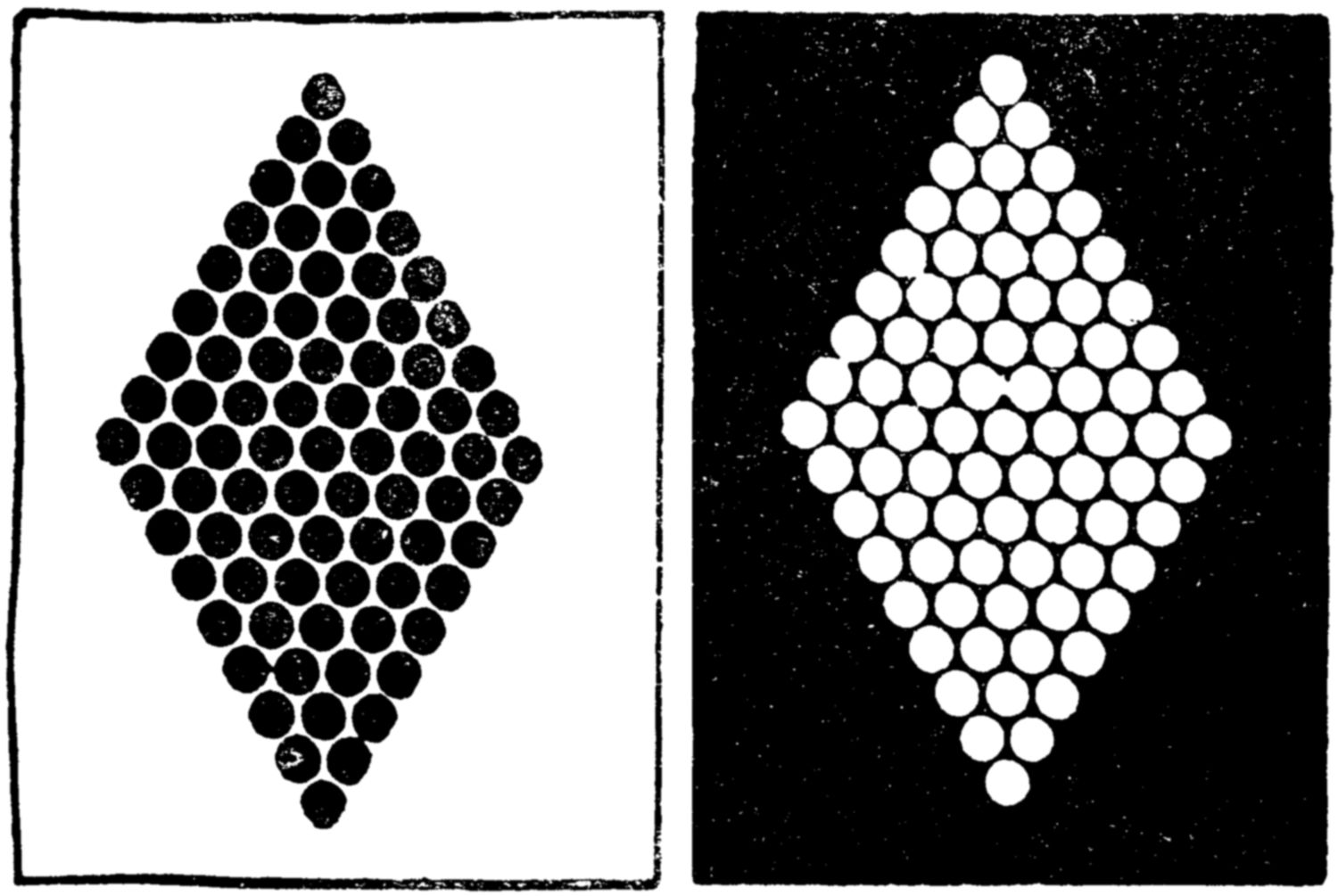
Although the black and the white circles are of the same diameter the irradiation is in their case so intense that the white circles appear to be larger than the black.
[73]
No. LXXIII.—AN ILLUSION OF ARCHES
This excellent illusion appeared in a recent number of the “Strand Magazine”:—
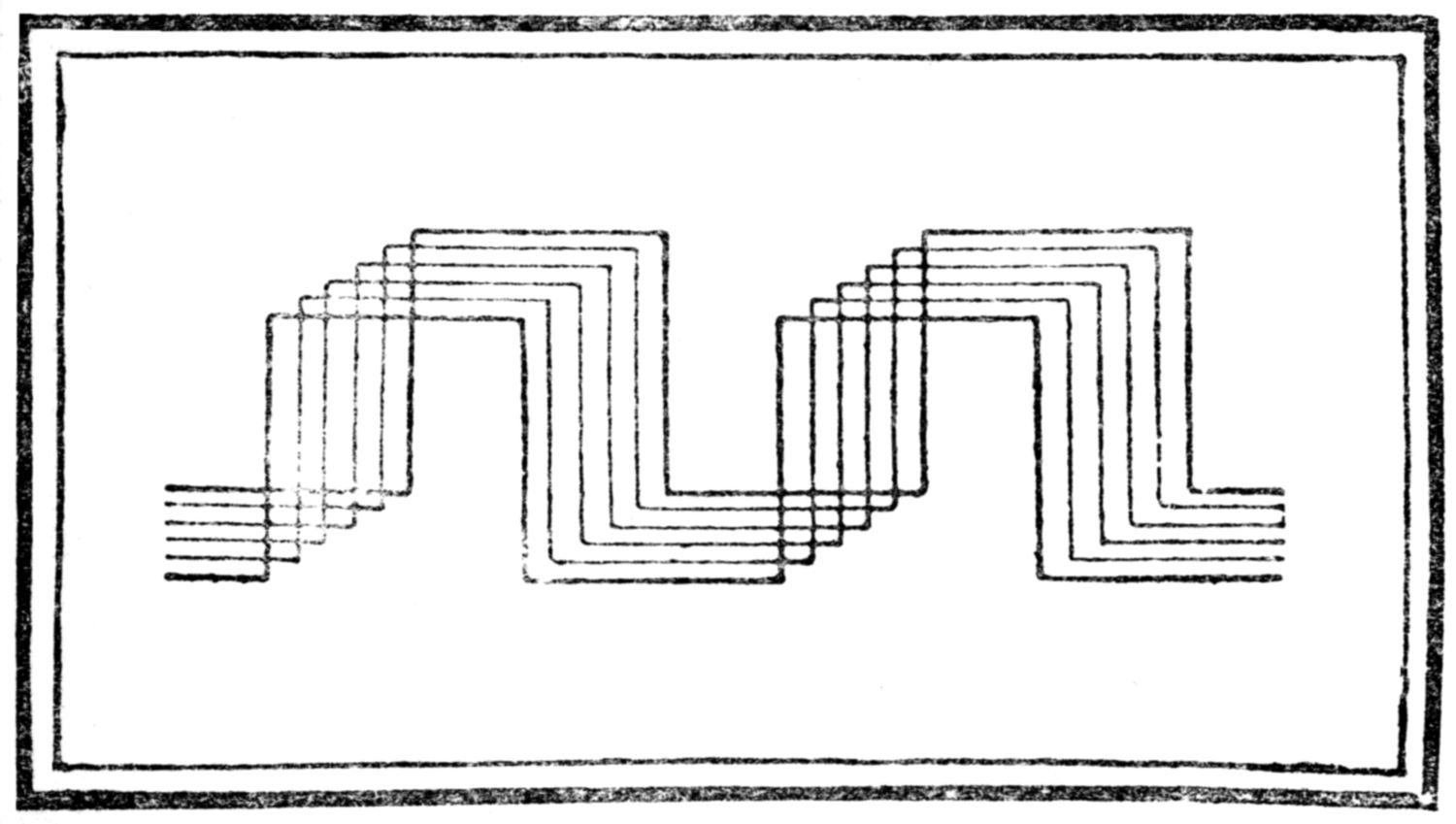
Most persons will at first see the passages under these arches as running upwards from left to right, but presently, as their line of vision shifts, the arches will take a downward course from right to left. This very curious effect will well repay a little patience, if it is not realised at once.
57. WHERE WAS THE WEDDING?
He joins them after tea;
But both are swept by ruthless tides
Away on the western sea.
58. ON A BANANA BARROW
I have 91 bananas on my barrow, of two qualities; some I sell at four a penny, and the better sort at three a penny. If I had sold them in mixed lots at seven for twopence, I should have made a penny more. How many were there of each quality?
[74]
No. LXXIV.—IN THE TRAIN
The Puzzle Problem—
A passenger in a first-class railway carriage notices that the top of a factory window due S.W. of him coincides with a mark on the carriage window, and does not move from it while the train is running five and a half miles.
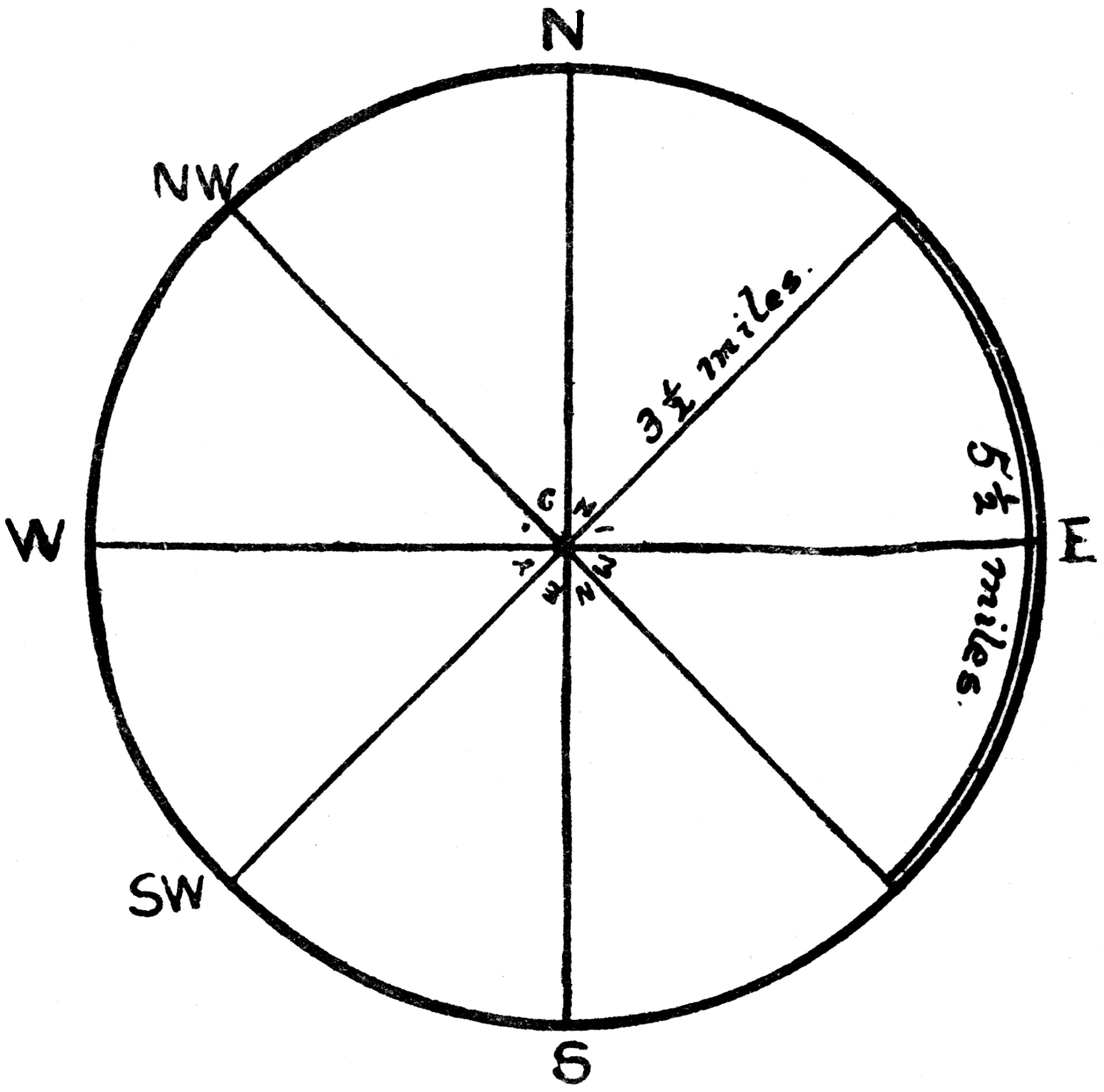
At the end of that distance the compass bearing of the chimney is due N.W. How far was the passenger from the chimney when he first noticed it?
is solved by 31⁄2 miles.
We give a diagram to make the points clear.
As the chimney top does not move from its place on the window, it is clear that the train is running on a segment of a circle having the chimney for its centre. It follows that the observer’s distance throughout is equal to the radius of that circle, and the radius of a circle of which the quadrant measures 51⁄2 miles is 31⁄2 miles within about 11 ft.
[75]
No. LXXV.—MENDING THE FLAG
The cross had been taken out from the centre of this flag, and its owner, who had an ingenious turn of mind, found that by cutting what remained into two pieces, and rejoining them, he could make it into a perfect flag without any waste of material.
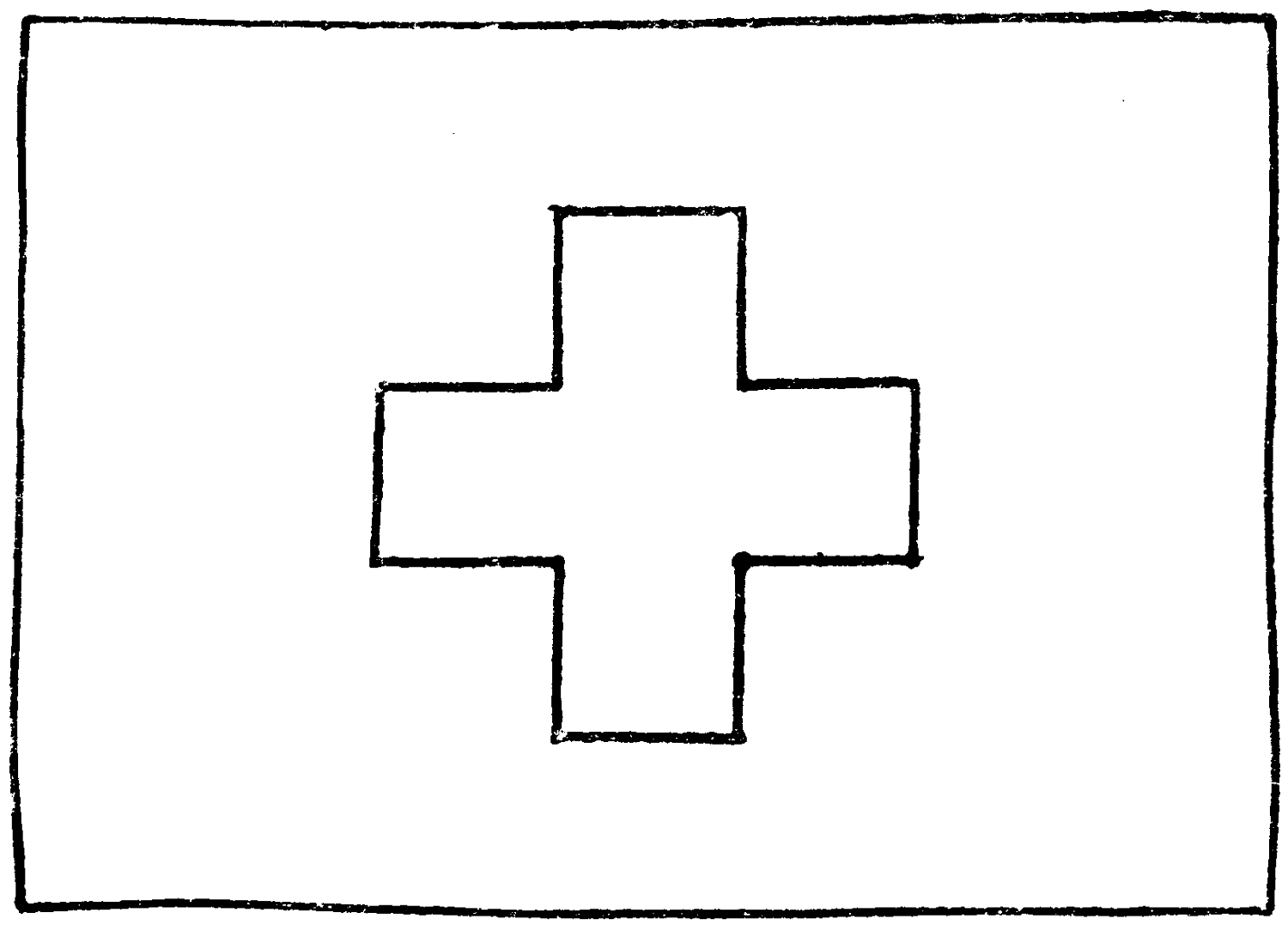
How did he accomplish this?
[76]
No. LXXVI.—FOR THE CHILDREN
Add two more pieces similar in shape and size to that marked A, and one similar to B, C, and D respectively, and then readjust the eleven parts so that they form a perfect square.
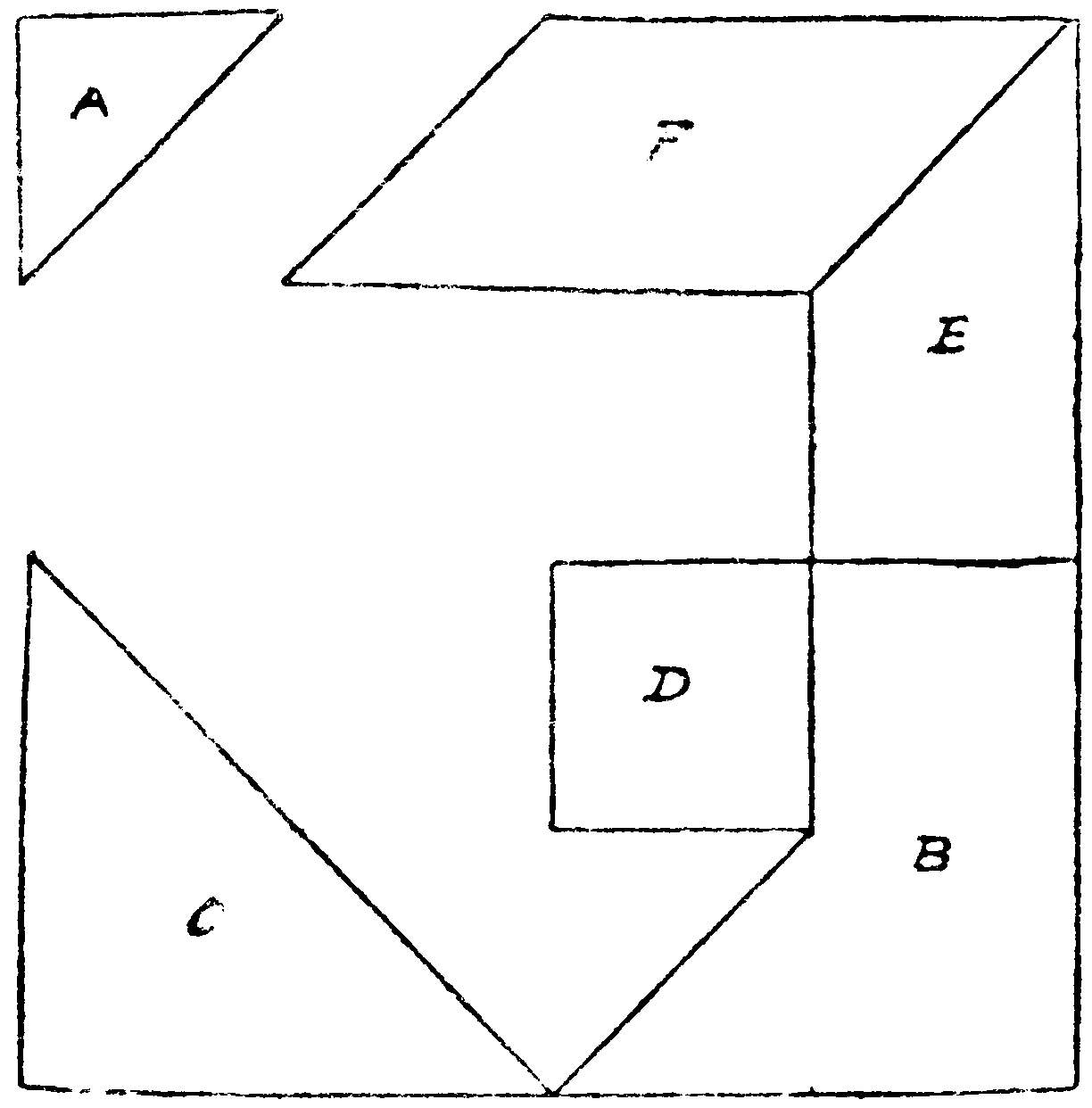
59. MISSING WORDS
When ..... are high results are low.
His borders ..... and bindweed spoil,
No careful culture ..... the soil;
But weeds that ..... are all alive
Where ..... pink or rose should thrive.
The missing words are spelt with the same letters.
[77]
No. LXXVII.—AN EASY MATCH PUZZLE
This is a simple arrangement of eight matches, by which two squares and four similar triangles are formed.
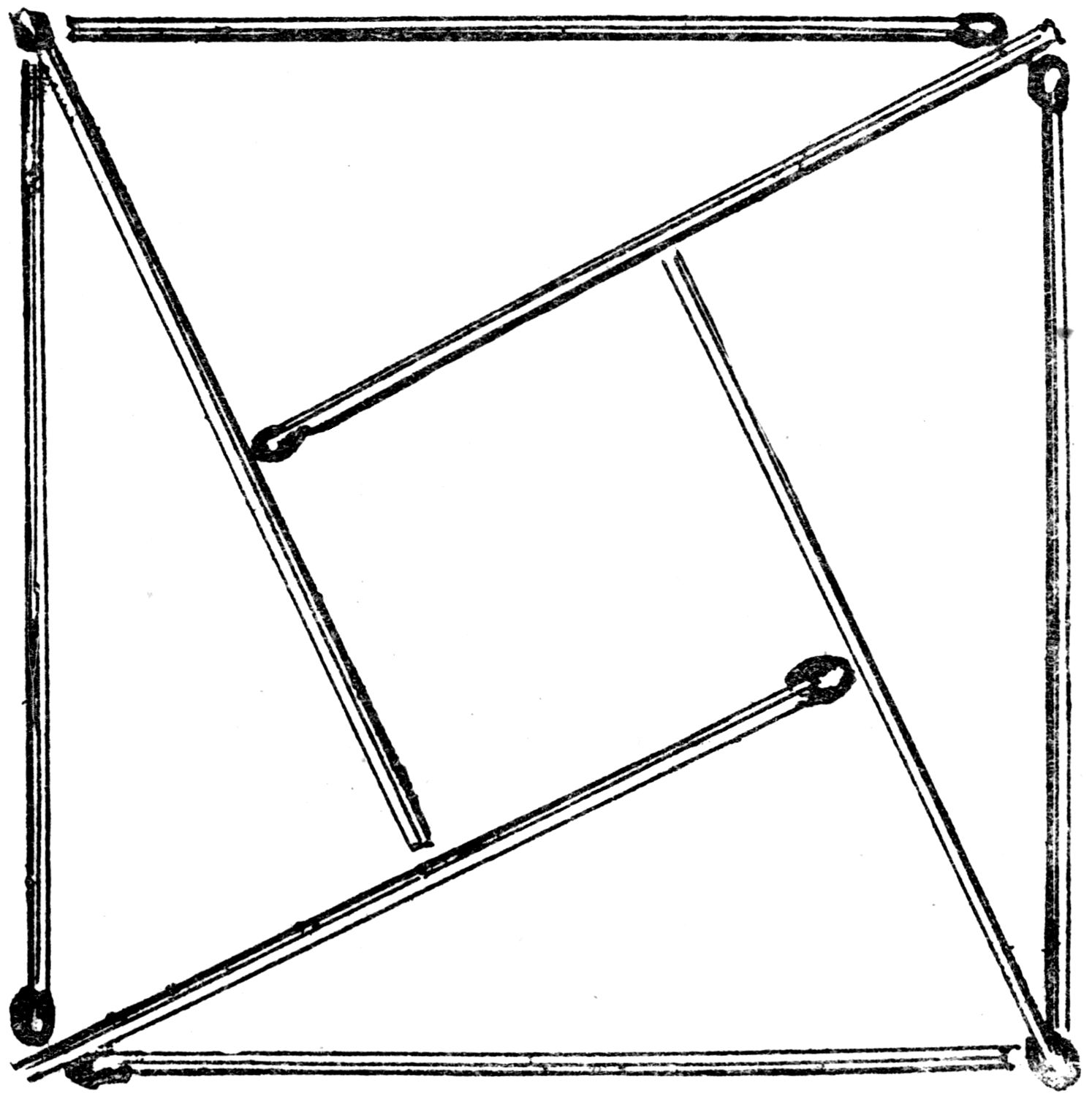
60. WHAT AM I?
Varied, but welcome everywhere;
But met with in the open field
I’m banned if frequent, blest if rare.
To this peculiar difference the clue
Is called with much significance the cue.
61. BURIED TOWNS
On holiday intent;
The best I’ve seen is surely Dover,
That pretty port of Kent.
Three towns are buried in these lines.
[78]
No. LXXVIII.—WALKING THE ROUNDS
A hospital was built in six detached blocks, and it was the duty of the night watchman to go completely round every block at fixed hours to see that all was safe.
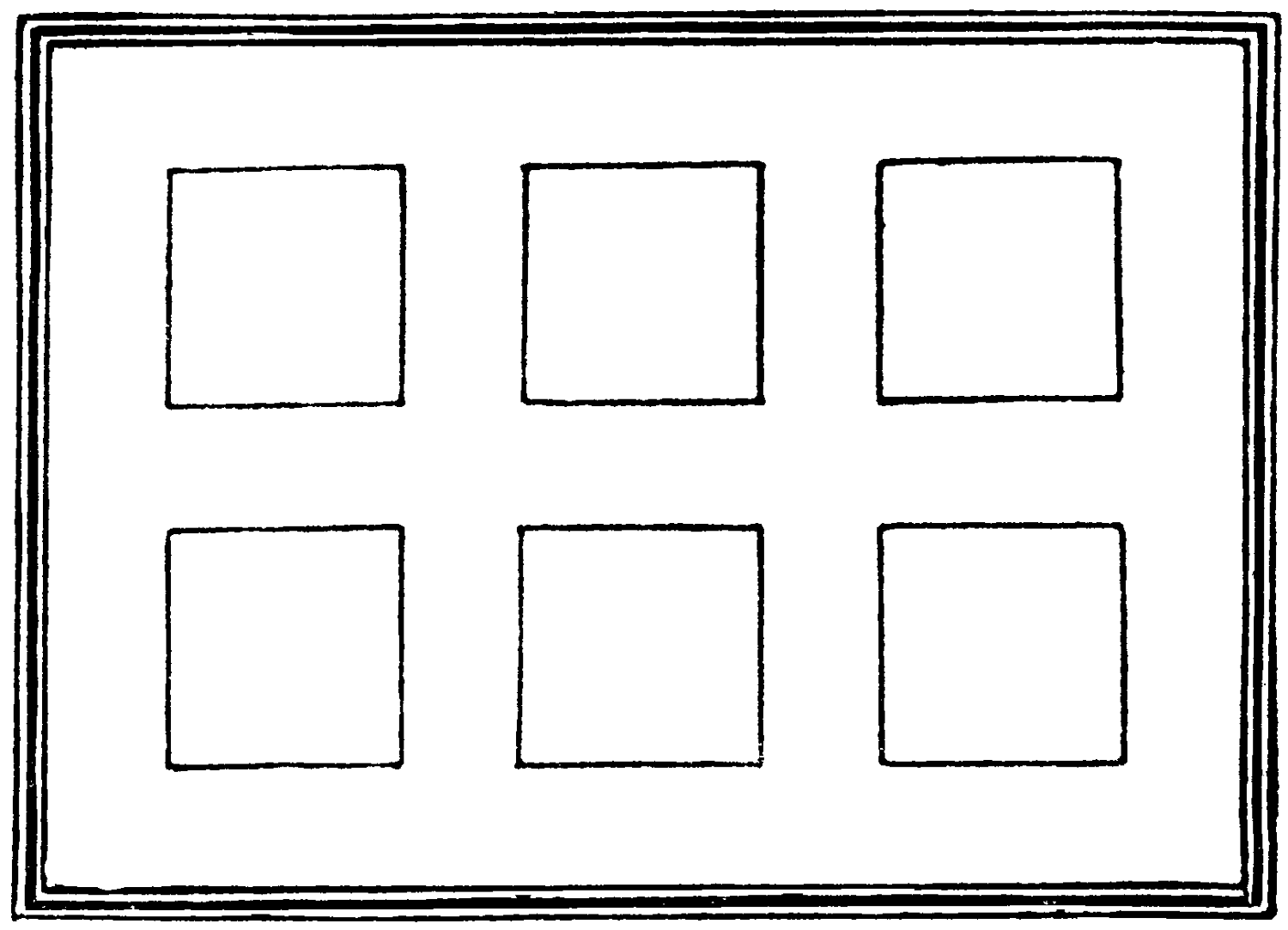
What was his shortest course?
62. THE ARAB AND HIS ASS
With a donkey bearing an obelisk,
But he did not venture to ford the tide,
For he had too good an *.
Secure till the tide had ceased to swell,
For he knew that whenever the donkey died
No other could be its ‖.
[79]
No. LXXIX
Can you rearrange the twelve counters on this board of 36 squares so that there are two counters on each row, column, and diagonal?
| ◎ | ◎ | ◎ | ◎ | ◎ | ◎ |
| ◎ | ◎ | ◎ | ◎ | ◎ | ◎ |
There must not be more than these two counters in the same straight line.
63. A CHARADE
While my final you can find in Amsterdam.
Think how a sound whole stays your hunger and your thirst,
Deftly readjusting bread and meat and jam.
[80]
No. LXXX.—THE QUEEN’S TOUR
This is a course by which the queen on a chessboard, starting from K R sq., passes over every square in fourteen moves.
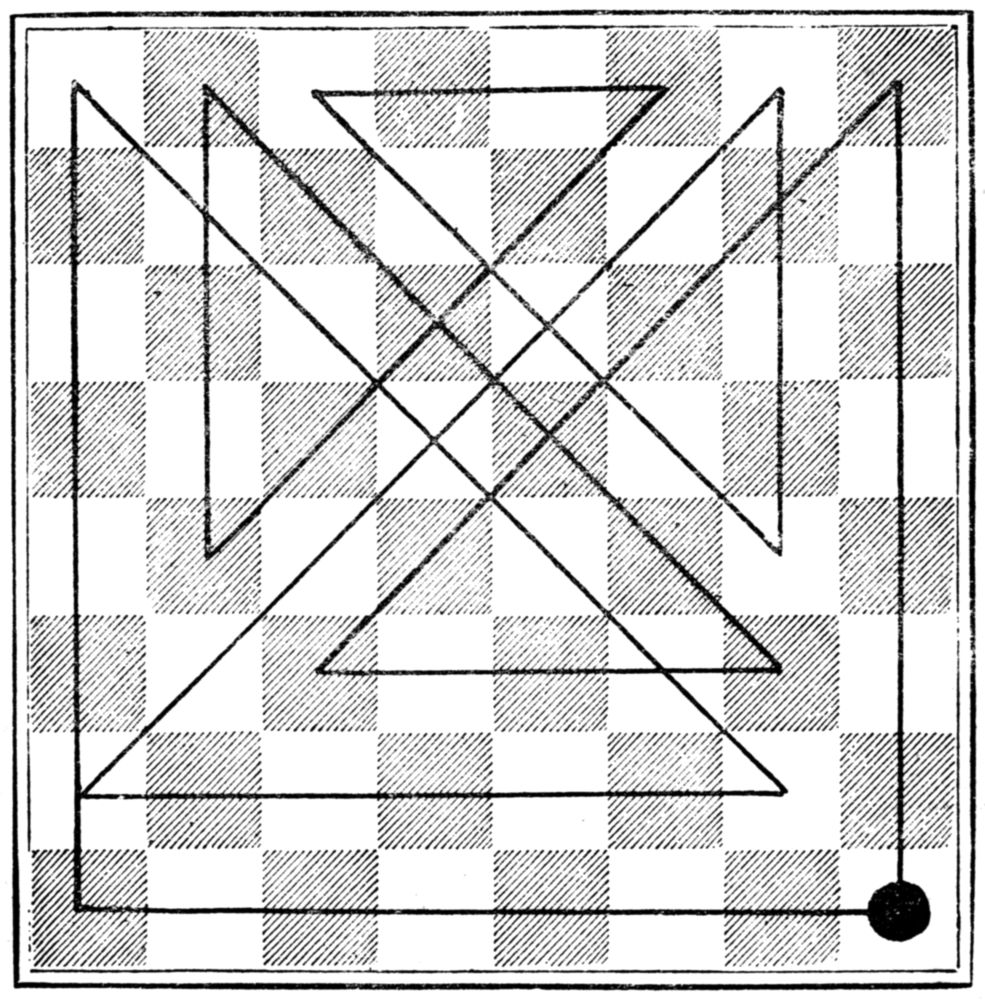
64. AFTER THE MATCH
“Did you score a score?” said Funniman to his schoolboy nephew, after a local cricket match. “No, uncle,” said the youngster, “but if I had made as many more runs, half as many more, and two runs and a half, I should have made my twenty.” How many runs did he get?
[81]
No. LXXXI.—A NEST OF TRIANGLES
In the “Twentieth Century Standard Puzzle Book” we gave a figure similar to this, in which there were 653 interlacing triangles in four tiers of this character.
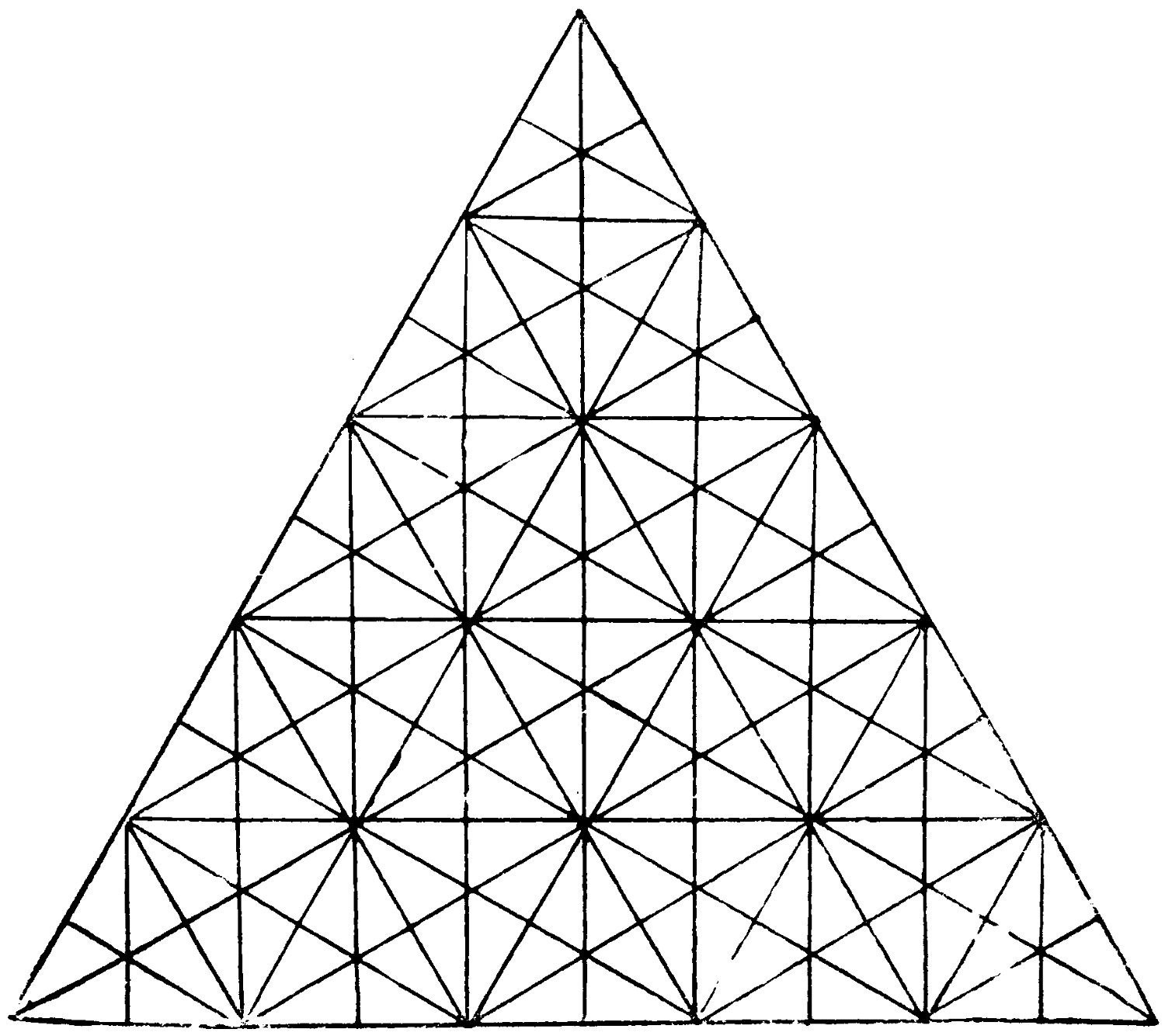
We now add a fifth tier at the base, and ask our solvers to determine how many triangles of all shapes and sizes can be counted within its enlarged borders.
65. AN ENIGMA
Of two in love made one.
The same six letters tell the fate
Of marriage ties undone.
[82]
No. LXXXII.—A SIMPLE MATCH PUZZLE
Place eight matches in a row, about an inch apart, as indicated in the diagram.
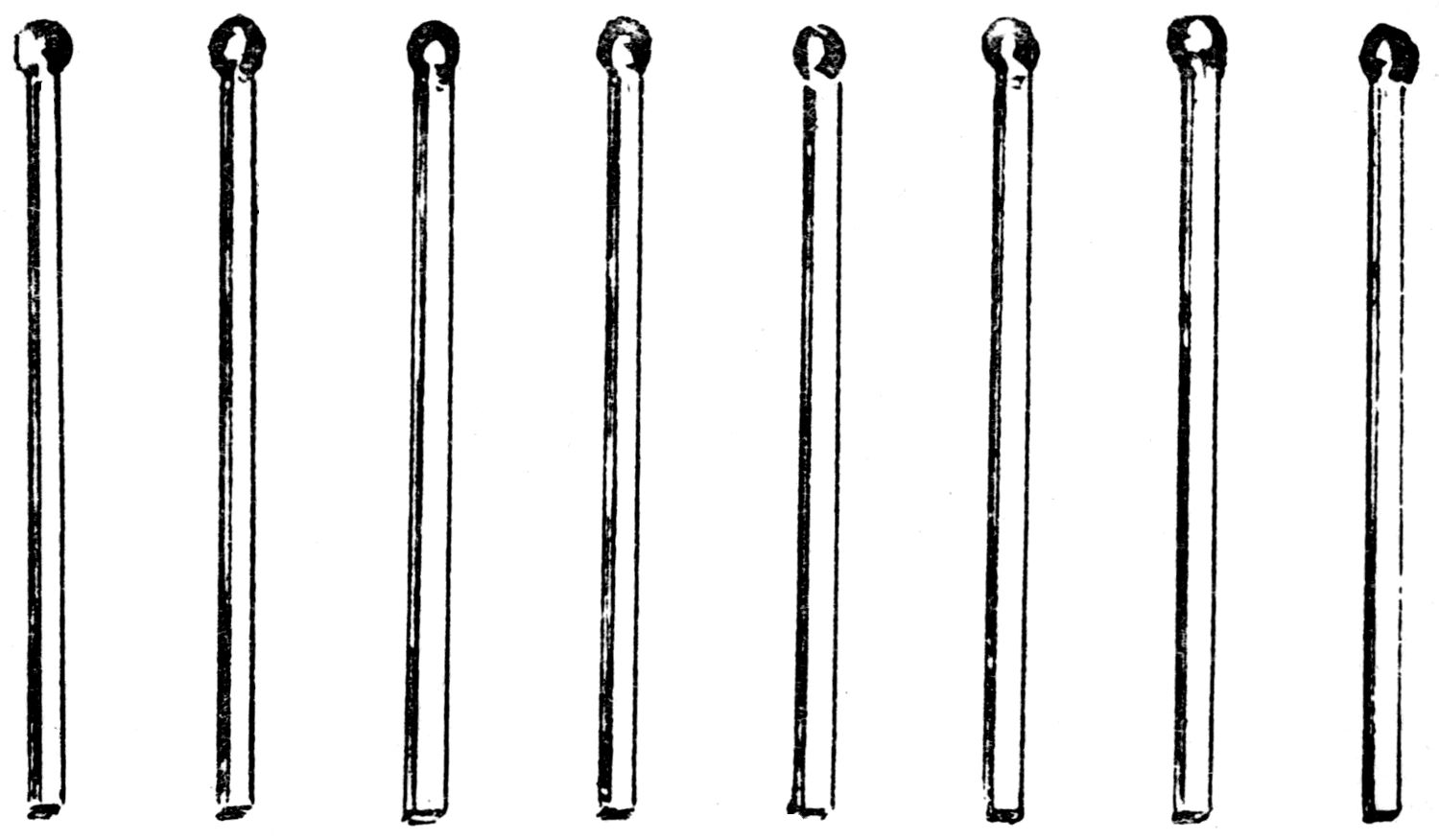
The puzzle is to form these into four pairs in four moves, by moving one match clear over two matches every time.
66. A TOPICAL RIDDLE
These own the Rest of all my lay;
Busy my Third; Fourth like the Pole,
Whose opposite my Fifth makes goal.
67. MISSING WORDS
Ere we were .... to Lord’s;
Alas! the score our champion made
Was what a .... affords!
The crowd in .... of thousands came
But took scant notice of the game.
[83]
No. LXXXIII.—A MATCH PUZZLE
Place twelve matches, as is shown in the diagram, so that they form four squares.
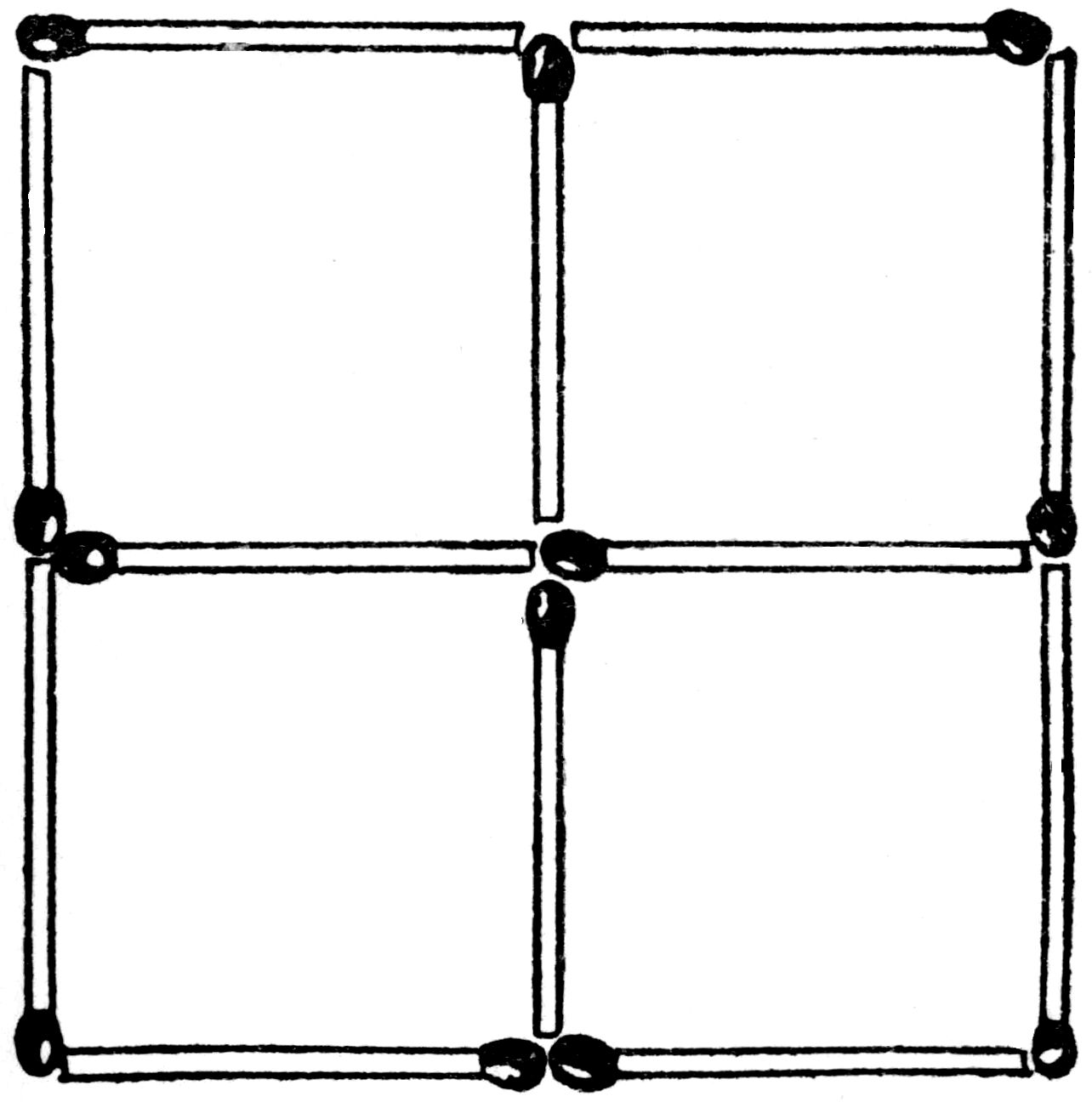
Now remove three of the matches, and readjust the nine that remain so that they represent three squares.
68. MARCONIGRAMS
Edwin and Angelina were far apart, when this message, with its touch of jealous resentment, reached her on the wings of a Marconigram—
“No fickle girl is bonnie to my mind!”
Quite equal to the occasion, she flashed back the reply—
“In love inconstant I no pleasure find!”
How did these messages reveal the places from which they were despatched?
[84]
No. LXXXIV.—MATHEMATICS WITH MATCHES
In the four corner and four central cells of this nest of squares four matches are so placed as to represent 1⁄2, 1, 4, 1⁄50, 11, 12, 41, and 49.
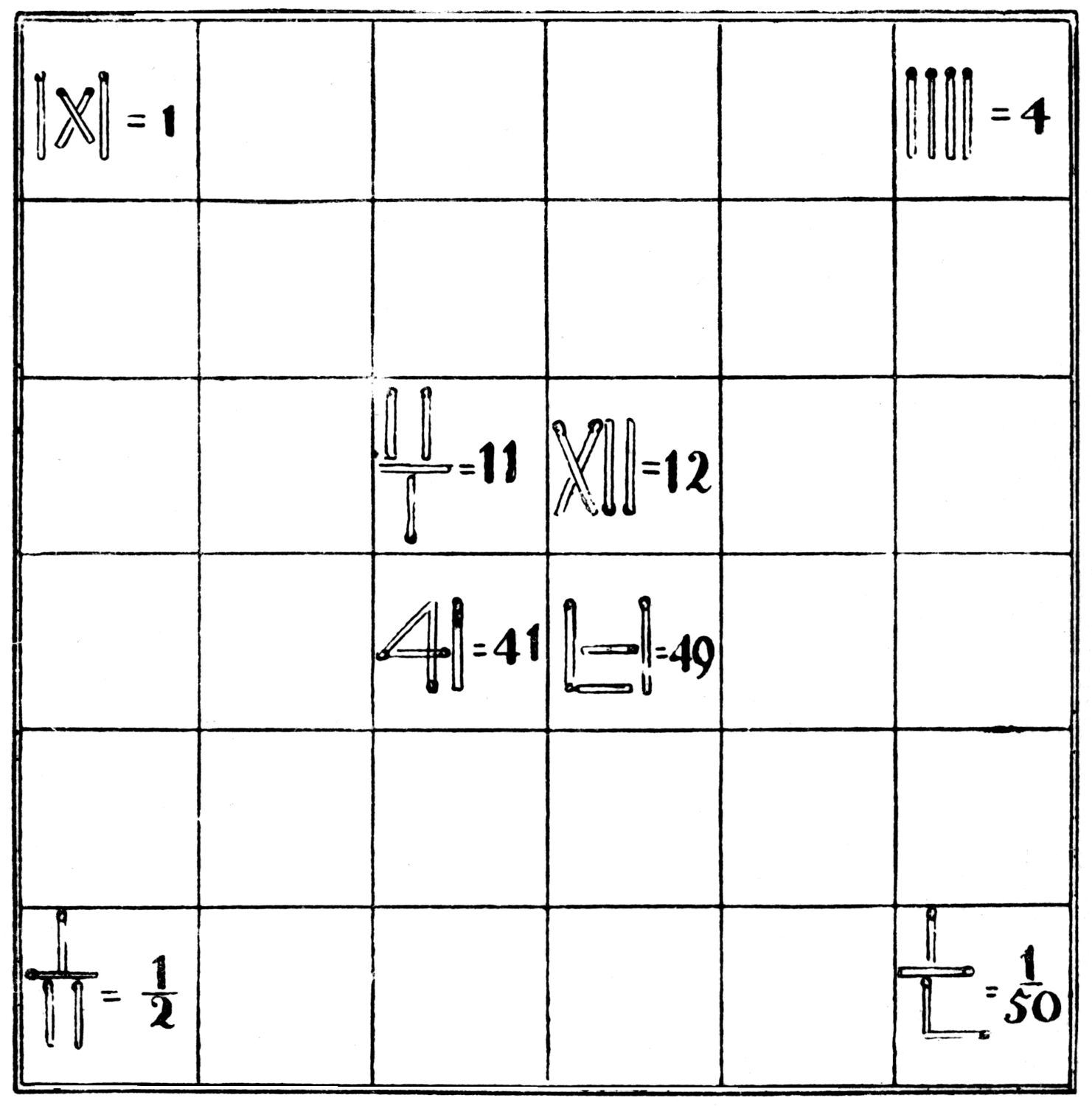
Can you, still using only four matches in each case, fit different whole numbers or fractions in similar fashion into the other 28 cells?
69. EASY MENTAL ARITHMETIC
Then multiply by four;
This, if you use the proper sign,
Makes five and nothing more.
[85]
No. LXXXV.—MANY READINGS
Can you complete the top and bottom rows, the two side columns, and the two diagonals of this square by forming in each of them the same sentence so that it can be read in twenty different directions?
| R | I | V | I | R | ||||||||
| I | I | I | I | |||||||||
| V | V | V | ||||||||||
| I | I | I | I | |||||||||
| R | I | V | I | R |
There are four words in the sentence of thirteen letters.
[86]
No. LXXXVI.—TOLD AT A GLANCE
Ask anyone to fix upon a number between 1 and 60 inclusive, and to point out to you the square or squares in which it appears:—
| 3 | 5 | 7 | 9 | 11 | 1 | 5 | 6 | 7 | 13 | 12 | 4 | |
| 13 | 15 | 17 | 19 | 21 | 23 | 14 | 15 | 20 | 21 | 22 | 23 | |
| 25 | 27 | 29 | 31 | 33 | 35 | 28 | 29 | 30 | 31 | 36 | 37 | |
| 37 | 39 | 41 | 43 | 45 | 47 | 52 | 38 | 39 | 44 | 45 | 46 | |
| 49 | 51 | 53 | 55 | 57 | 59 | 47 | 53 | 54 | 55 | 60 | 13 |
| 9 | 10 | 11 | 12 | 13 | 8 | 3 | 6 | 7 | 10 | 11 | 2 | |
| 14 | 15 | 24 | 25 | 26 | 27 | 14 | 15 | 18 | 19 | 22 | 23 | |
| 28 | 29 | 30 | 31 | 40 | 41 | 26 | 27 | 30 | 31 | 34 | 35 | |
| 42 | 43 | 44 | 45 | 46 | 47 | 38 | 39 | 42 | 43 | 46 | 47 | |
| 56 | 57 | 58 | 59 | 60 | 13 | 50 | 51 | 54 | 55 | 58 | 59 |
| 17 | 18 | 19 | 20 | 21 | 16 | 33 | 34 | 35 | 36 | 37 | 32 | |
| 22 | 23 | 24 | 25 | 26 | 27 | 38 | 39 | 40 | 41 | 42 | 43 | |
| 28 | 29 | 30 | 31 | 48 | 49 | 44 | 45 | 46 | 47 | 48 | 49 | |
| 50 | 51 | 52 | 53 | 54 | 55 | 50 | 51 | 52 | 53 | 54 | 55 | |
| 56 | 57 | 58 | 59 | 30 | 60 | 56 | 57 | 58 | 59 | 60 | 41 |
You can find the number at a glance, by simply adding together the numbers in the right-hand top corner cells of the square indicated. Thus, if 45 has been chosen, 32 + 8 + 4 + 1 = 45.
[87]
No. LXXXVII.
Here is a little subtraction sum, which is not quite so simple as it appears to be:—
| miles | furlongs | rods | yards | feet | inches | |||||||
| 1 | „ | 0 | „ | 0 | „ | 0 | „ | 0 | „ | 0 | ||
| 7 | „ | 39 | „ | 5 | „ | 1 | „ | 5 | ||||
Try it as it stands, without reducing the distance to inches.
70. A DOUBLET BY MISSING WORDS
Can you, by supplying the missing words, turn a grilse into a salmon? One letter is changed each time, and, except in one case, the order of the letters varies:—
The grilse of ......, ...... gay,
Glides on; the ...... ...... draws
When salmon follows Nature’s laws.
71. AN ENIGMA
From place to place all day;
Some loving swain, hot foot for fun,
Sees Dora in my way.
[88]
No. LXXXVIII.—RANGING THE DIGITS
These are the arrangements of the nine digits, by which they add up alike in rows, columns, and diagonals in a square; on all sides in a triangle; and from top to bottom and from side to side in a cross:—
|
|
|
The totals are 15, 20, and 27 respectively.
72. WHAT IS THIS WORD?
HAATTCEUMSSSS
73. MULTUM IN PARVO
Five English, and one Latin;
No need to twist them, or afresh to mix,
If puzzles you are pat in.
74. THE GENTLE CRAFT
The question was asked in a puzzle competition—“Why is every angler ipso facto an Ananias?” Although no such method was asked for or expected, we find that the very letters of the question can be recast into a most apposite reply. Our answer by anagram runs thus—
A liar, .. ..... gay fancies to a ..... ....
Can you complete the sentence by filling in the missing words?
[89]
No. LXXXIX.—NO TWO IN A ROW
On a board of sixty-seven squares, arranged as is shown in the diagram, place nine counters, so that no two are in the same row, column, or diagonal.
The indentations do not affect the simple conditions.
75. A QUAINT RIDDLE
Will never go right;
Shall I tell you the reason why?
Wherever he goes,
He follows his nose;
And that stands all awry!
If this appendage had slanted more
Why would it serve a hole to bore?
[90]
No. XC.—EXACT ALIGNMENT
Can you arrange these nine cards so that they form ten rows with three cards in each row?
| A ♣ |
||||||
| A ♢ |
10 ♡ |
A ♠ |
||||
| Q ♠ |
K ♣ |
K ♢ |
J ♢ |
|||
| K ♡ |
||||||
This may, of course, be done with any nine cards.
76. A MISSING LETTER
Aitutoaeucceorlo;
Pringweetnetillpoeemoygra,
Aummertreemaofthadeacro.
Separate these strings of letters into words that scan and rhyme, adding the same missing letter in 55 places.
[91]
No. XCI.—AT A FANCY BALL
Two ladies and their squires, here represented by the White Knights and the Black, were dressed to impersonate Light, Liberty, Love, and Learning, and took their places on the corners of a pavement chequered to represent a chessboard, as is shown below:—
| ♘ | ♞ | ||||||
| ♞ | ♘ |
They undertook to step a figure which should exhibit at each pause a revolving square, and in three paces bring them together in the centre, by a course traced upon the lines of their combined monograms. What were their successive steps?
[92]
No. XCII.—PROVERBIAL PHILOSOPHY IN CELLS
Can you disentangle all this good advice?
| tell | you know | tells | knows | tells | he should not |
| do | you think of | does | thinks of | does | is not good |
| believe | you hear | believes | hears | believes | is false |
| spend | you have | spends | has | spends | he needs |
| judge | you see | judges | sees | judges | is not there |
| never | all | he who | all he | often | what |
It forms 5 excellent maxims in its 36 cells.
77. THRICE DOCKED
Without my tail I’m flat;
I’m round curtailed again;
Again, you have me pat.
[93]
No. XCIII.—A DISLOCATED CIRCLE
Study this quaint figure carefully, and try to discover how it can be divided into two pieces, so that these can be reunited to form a perfect circle.
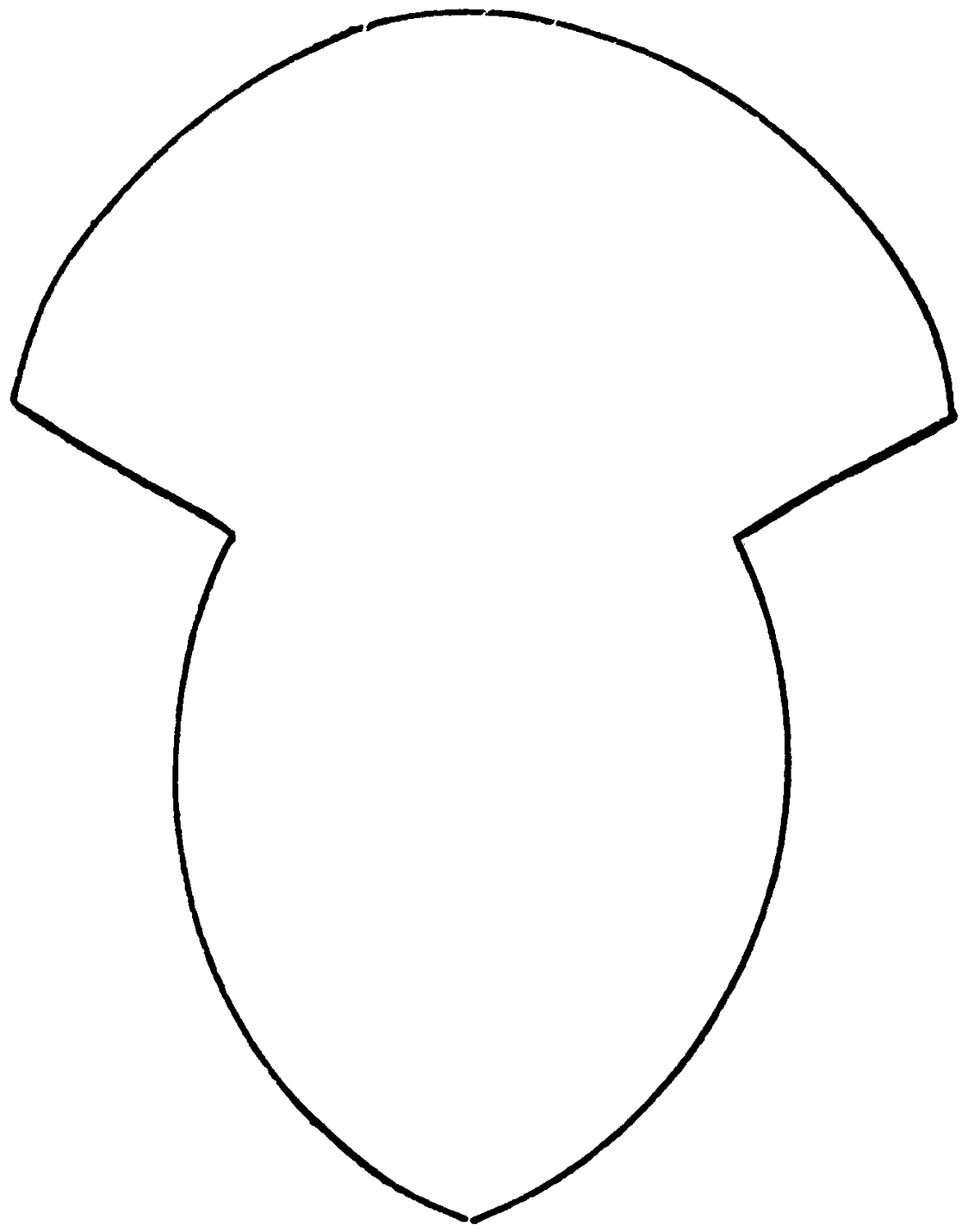
78. A LOGOGRIPH
But take a letter out,
That change of fare is ruling there,
You see, without a doubt.
Behead me twice; it is not nice
To have this in your skin;
Lop head and tail, and find a nail
Or tack to drive it in.
Behind his right, and in your sight
A little word you find;
But you will never make it out,
Though it is in your mind.
[94]
No. XCIV.
When Tommy was offered all the money by his uncle if he could place 15 half-crowns and 15 pennies in such order in a circle that, counting always by nines, and starting at a fixed point, he came always upon a penny, and removed it from the circle, he found the key to success in this Latin line, given to him by a school friend, who shared the spoil—“Populeam virgam mater regina ferebat.” The vowels, from a to u, are numbered from 1 to 5, and when they are thus marked in the sentence—
| “ | P | o | p | u | l | e | a | m | v | i | r | g | a | m | m | a | t | e | r | r | e | g | i | n | a | f | e | r | e | b | a | t | , | ” | ||||
| 4 | 5 | 2 | 1 | 3 | 1 | 1 | 2 | 2 | 3 | 1 | 2 | 2 | 1 | |||||||||||||||||||||||||
they show the necessary sequence of half-crowns and pennies.
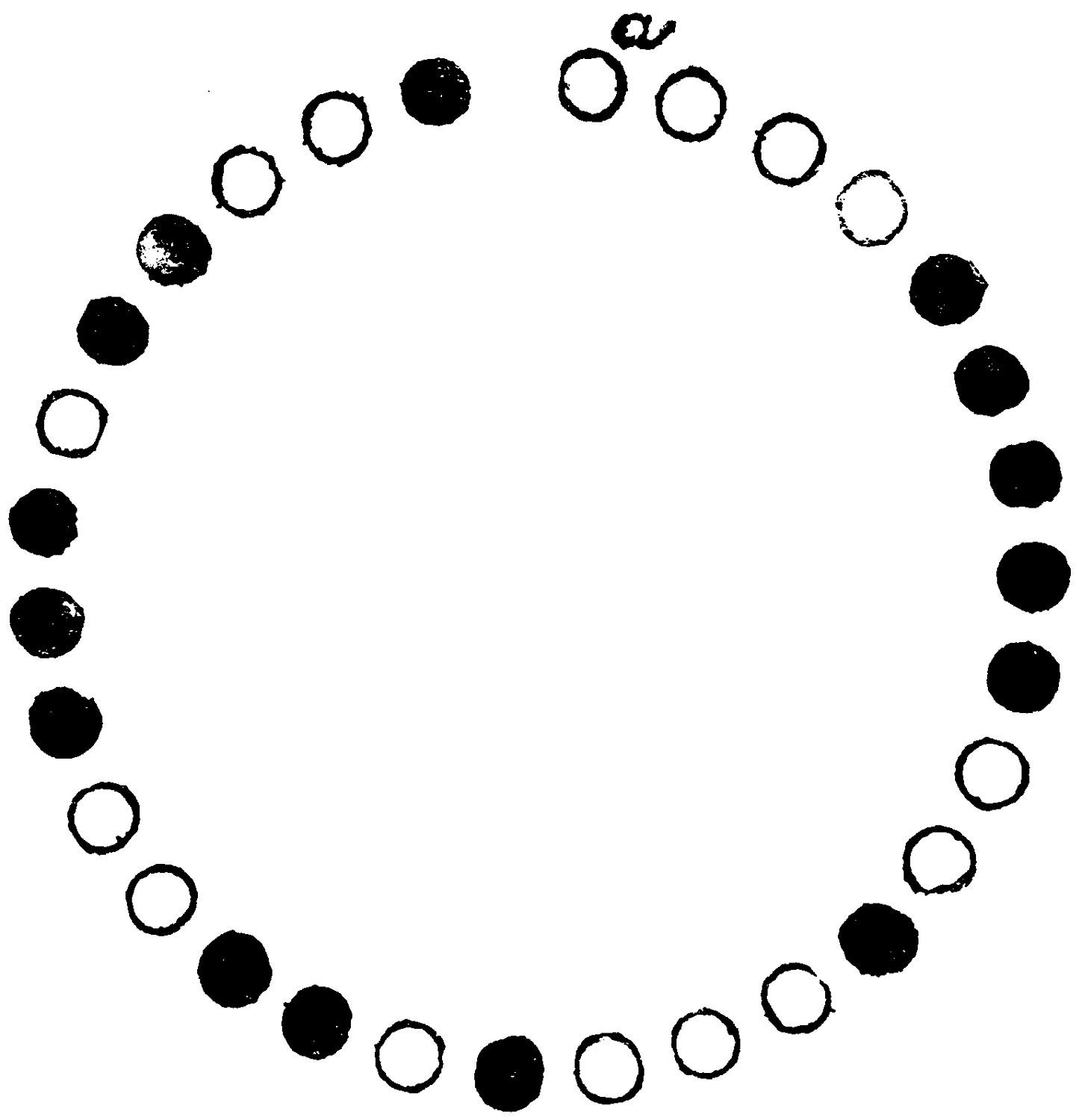
Start counting with the half-crown marked a, and remove each penny as you come to it on counting up to nine, and the conditions are fulfilled.
[95]
No. XCV.—A BUSINESS ANAGRAM
This smart advertisement of a polish known as “Old Dutch Cleanser” appeared in an American paper:—
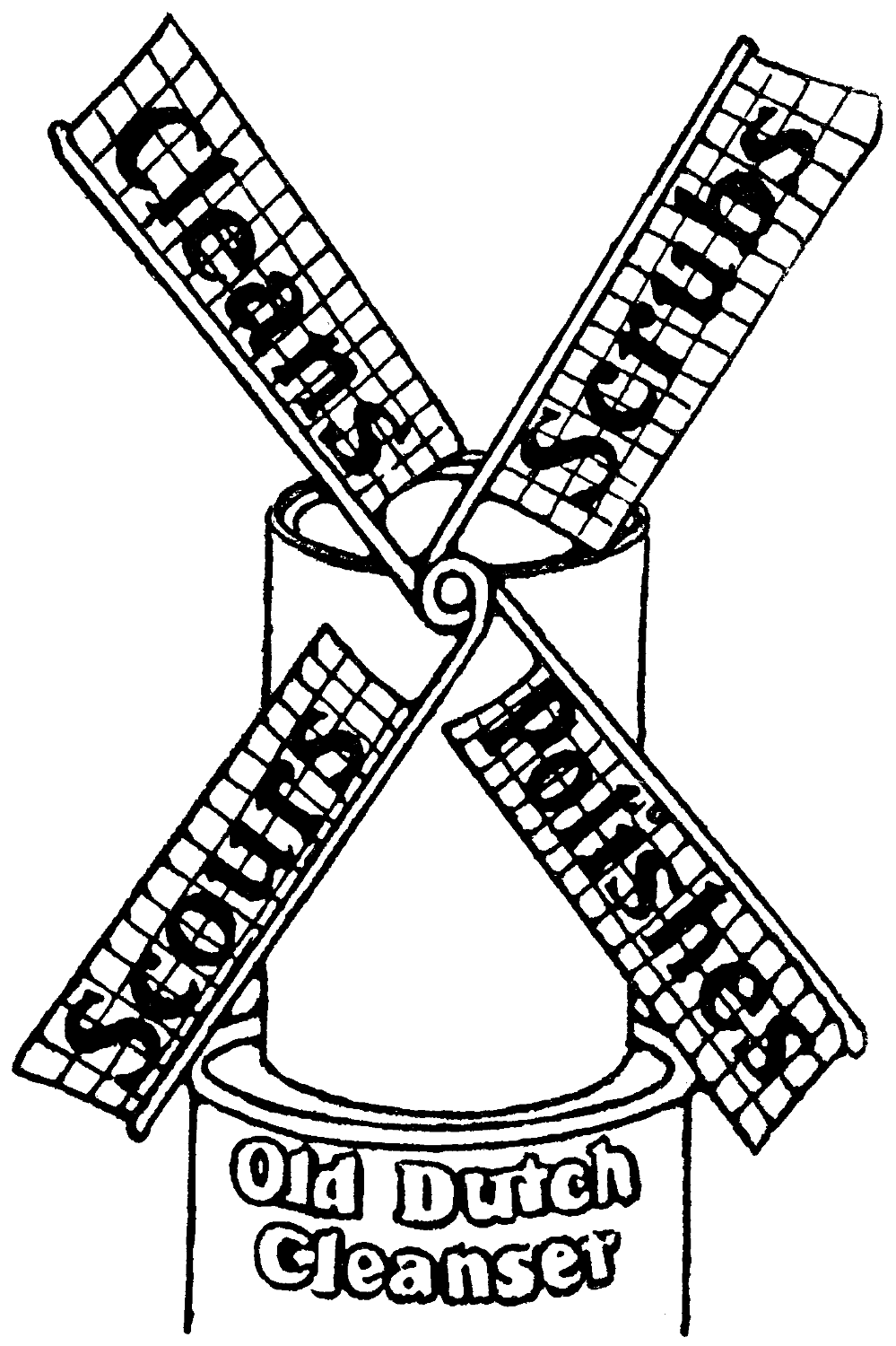
Cleans Scrubs
Scours Polishes
Old Dutch
Cleanser
If the eyes of the proprietor should fall upon this column, he will be surprised to find that his catch words Cleans, Scrubs, Scours, Polishes, can be recast into a perfect anagram, singularly appropriate to the powder advertised.
The opening words of the anagram are “O rub on, sir.”—Can our solvers complete the sentence?
[96]
No. XCVI.—A NEW CHESS PUZZLE
By Henry E. Dudeney.
Replace all these 51 pieces on the chessboard, so that no Queen attacks another Queen, no Rook another Rook, no Bishop another Bishop, and no Knight another Knight.
| Q | Q | Q | Q | Q | Q | Q | Q |
| B | B | B | B | B | B | ||
| B | B | ||||||
| B | B | B | B | B | B | ||
| R | R | R | R | R | R | R | R |
| Kt | Kt | Kt | Kt | Kt | |||
| Kt | Kt | Kt | Kt | Kt | Kt | Kt | Kt |
| Kt | Kt | Kt | Kt | Kt | Kt | Kt | Kt |
No account is to be taken of the intervening pieces, but each type of piece is to be considered as if it stood alone upon the board.
[97]
No. XCVII.—A GOOD KNIGHT’S TOUR
Here is a beautifully symmetrical specimen of the Knight’s tour:—
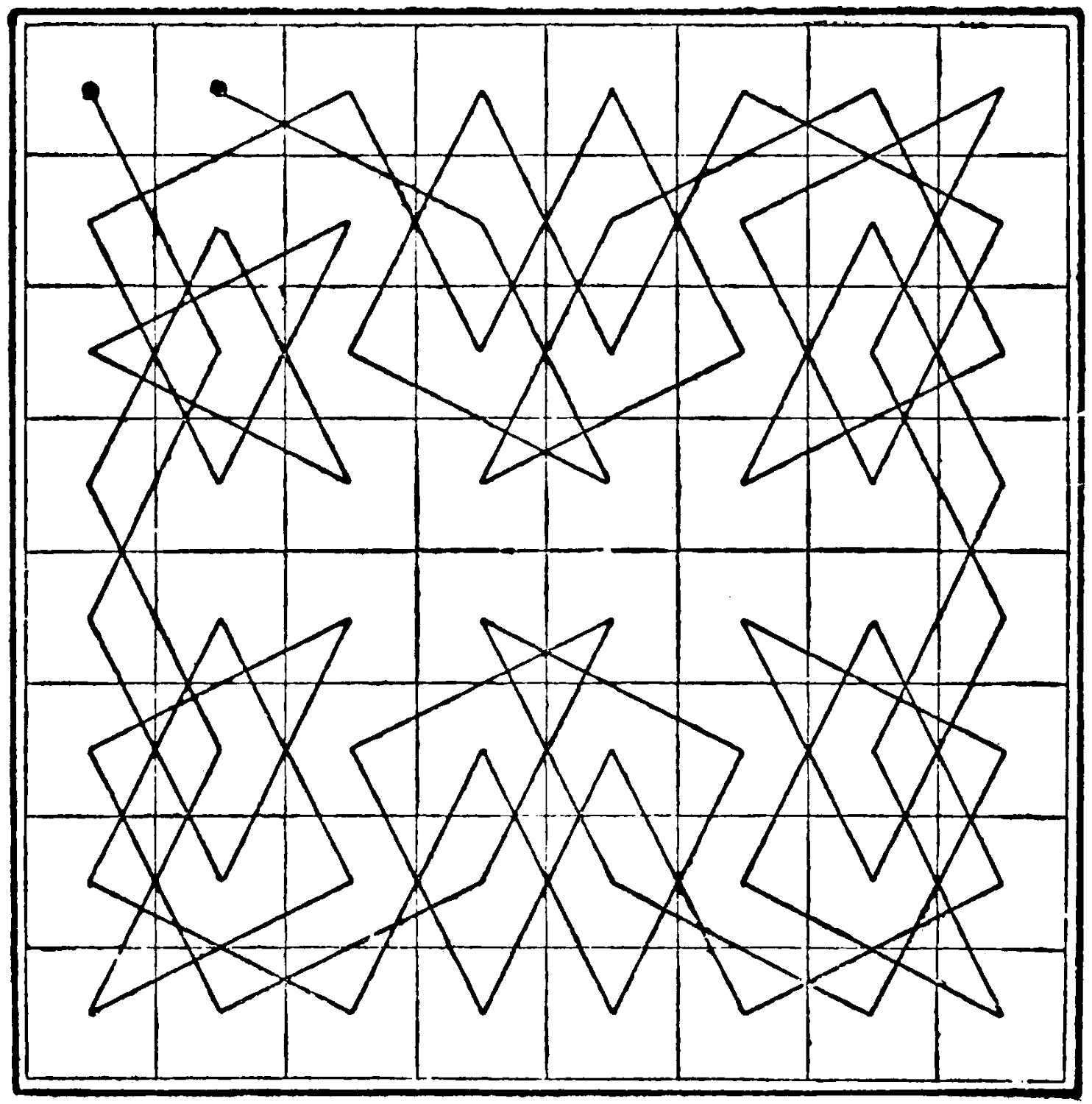
[98]
No. XCVIII.—A KNIGHT’S TOUR
Here is another beautifully symmetrical Knight’s tour:—
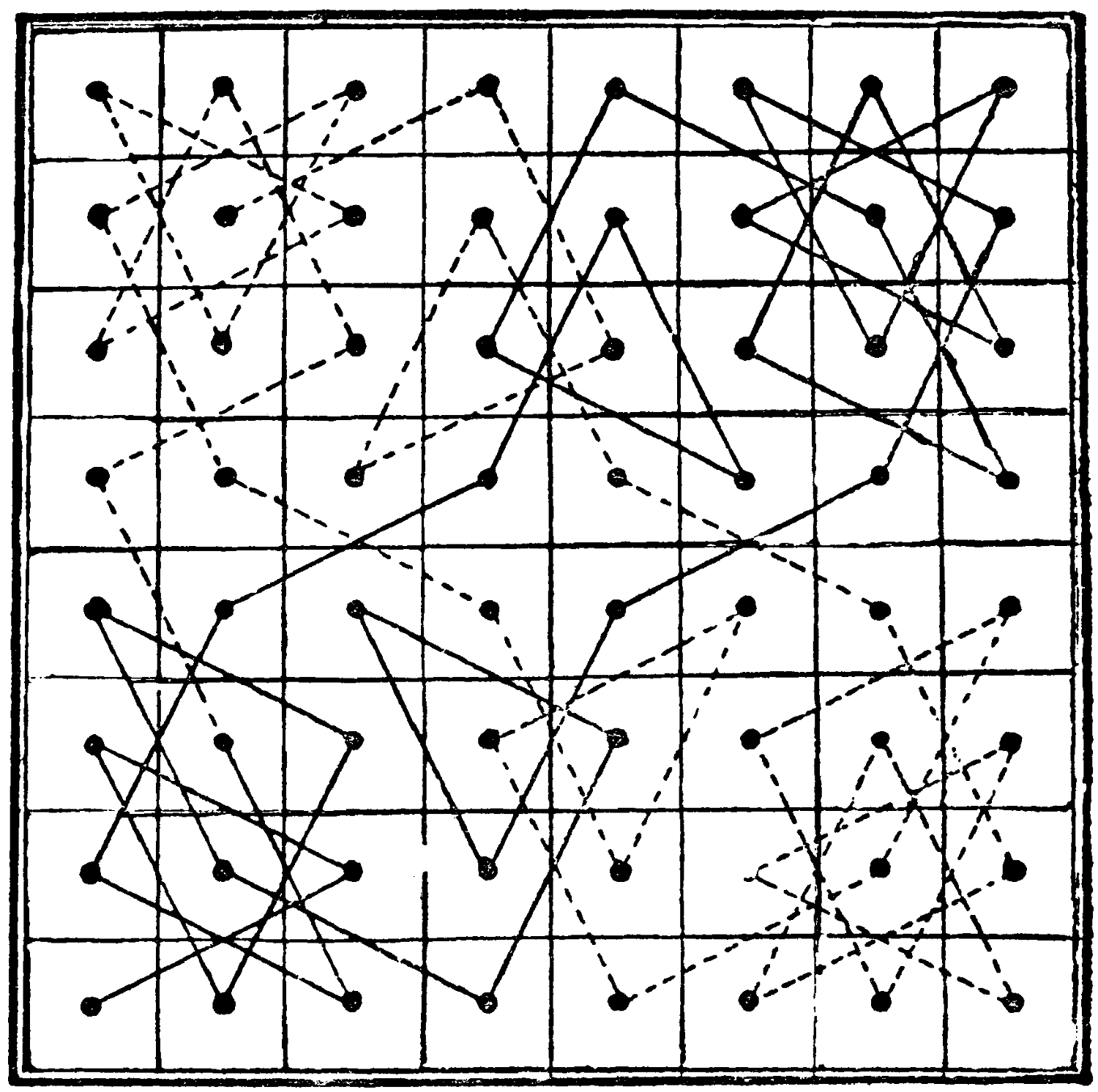
It starts from the corner square, and the second half of the course has dotted lines.
79. MISSING WORDS
In many a burglary tried;
But when he ...... open the till
There was only a ...... inside.
The missing words are spelt with the same six letters.
[99]
No. XCIX.—A KNIGHT’S TOUR
Here is quite a curious pattern described by another Knight’s tour:—
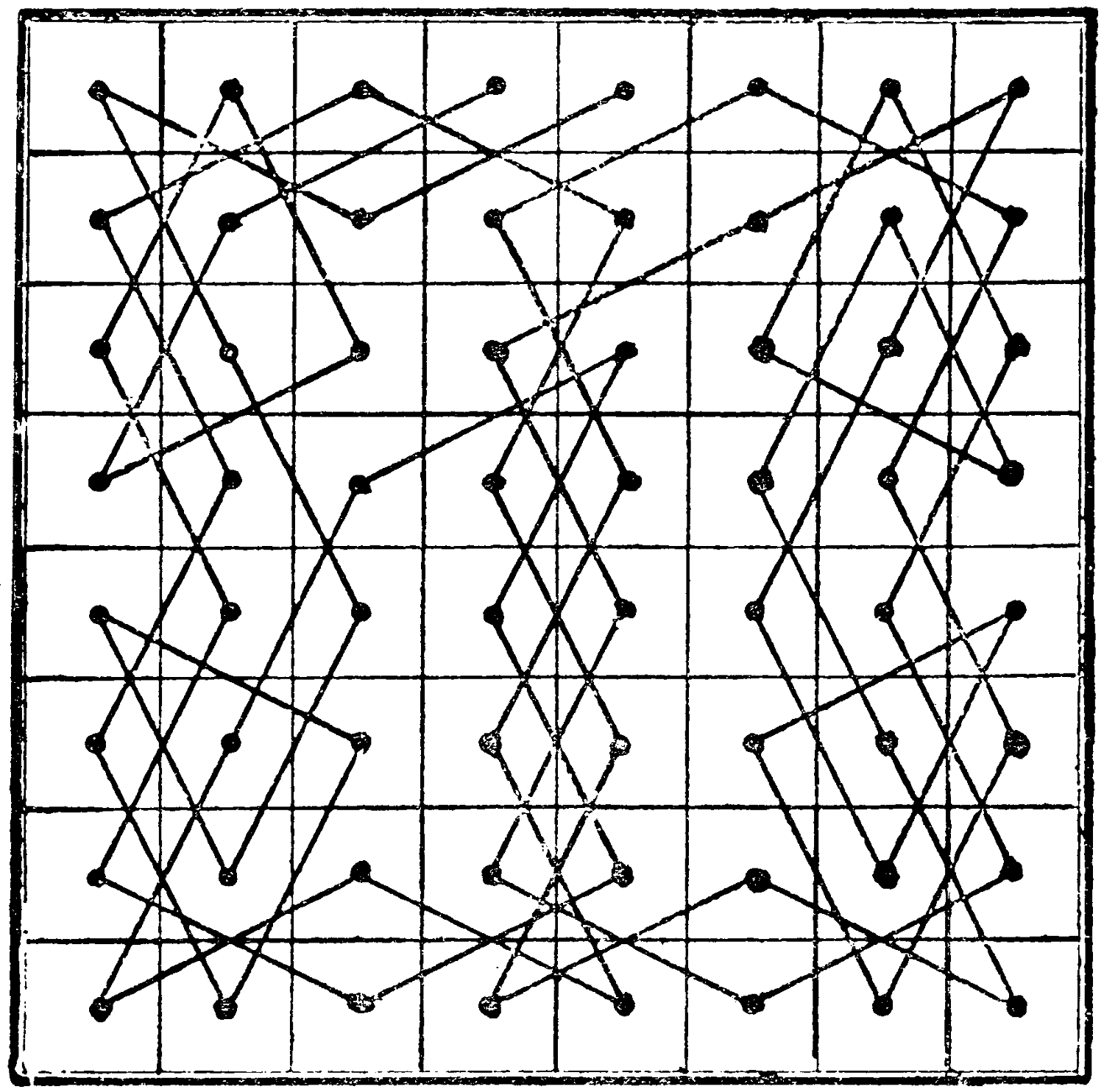
80. AN ENIGMA
Three-fourths a bed for man;
Three-fourths have legs that cannot stray,
Three-fourths have legs that can.
I have a back without a spine;
An arm without a bone is mine.
81. A CHARADE
My whole a narcotic is reckoned.
[100]
No. C.—A GOOD PATTERN
Here is a very symmetrical Knight’s tour, in which half of the moves are indicated by dotted, and half by unbroken lines:—
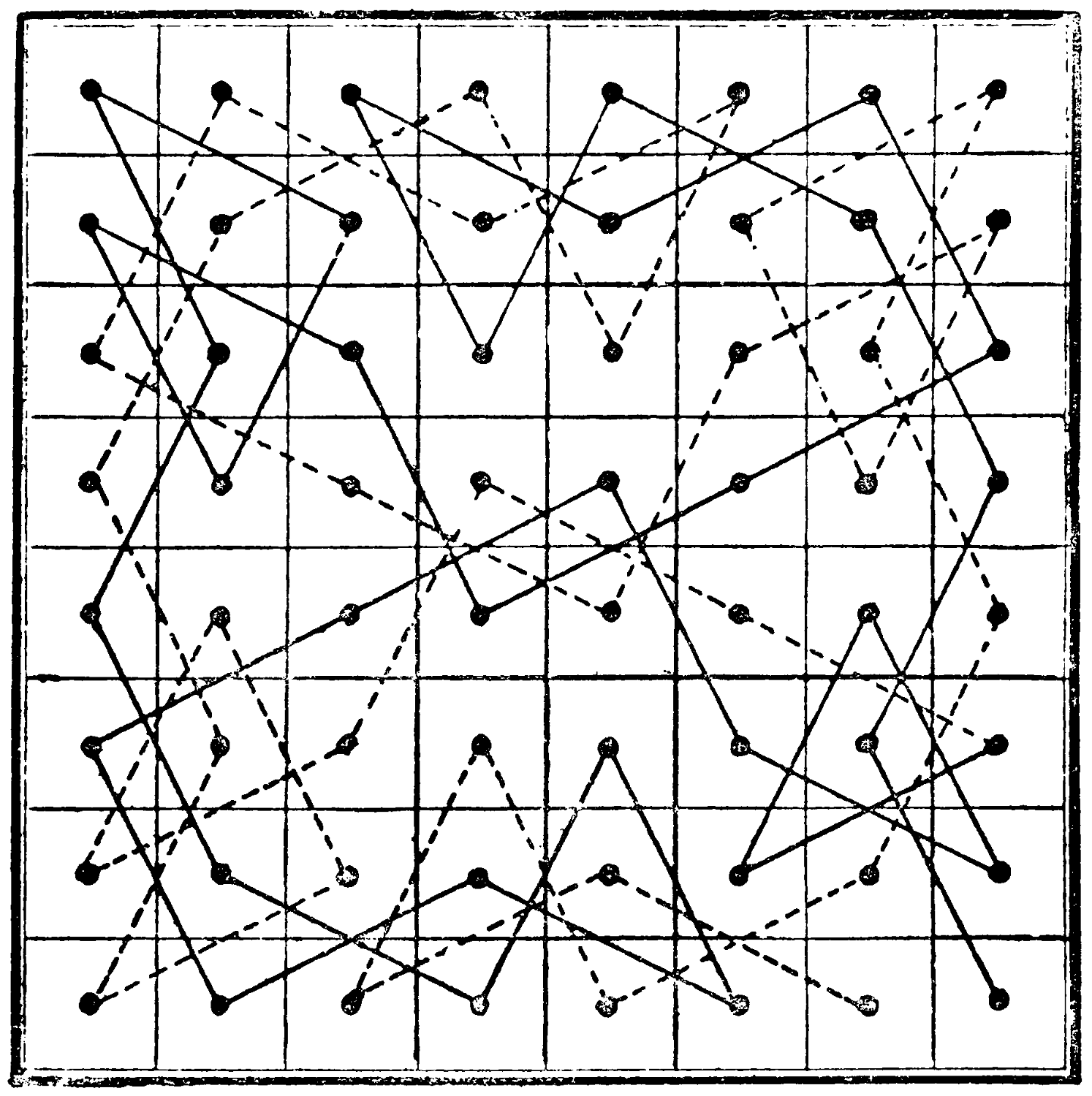
82. PALINDROME WORDS
The letters of this sentence “Arrive to vote at it,” can be so recast as to form two palindrome words, or words that read alike from either end. What are they?
[101]
No. CI.—A KNIGHT’S TOUR
Here is another specimen of the Knight’s tour, which is beautifully symmetrical—
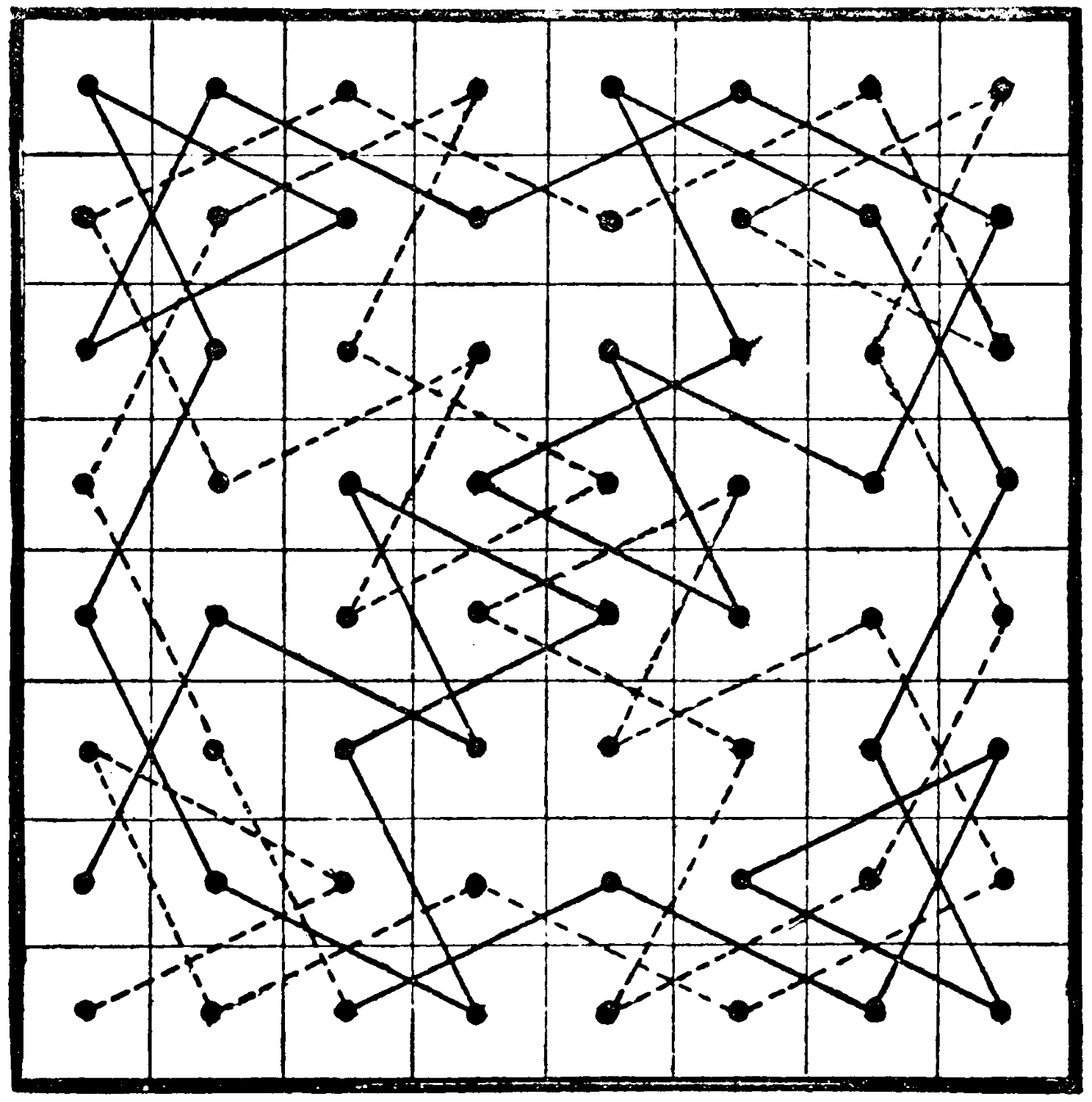
Half of the course is marked with dotted lines.
83. AN ENIGMA
Sweet-hearted then I show;
Decapitate again, I spread,
And cannot be below.
Served so once more, I am not dead,
But with fresh beauty glow.
[102]
No. CII.—A KNIGHT’S POETIC TOUR
On the board below a verse of eight lines runs on the course of a Knight’s move from square to square:—
| sor | to | king | good | say | luck | loy | eth |
| and | moth | a | soon | dis | our | to | bad |
| place | ry | church | his | force | is | hat | al |
| er | queen | him | wight | he | to | may | truth |
| man | his | and | and | chess | es | knight | op’s |
| a | sneer | the | and | un | lawn | of | tates |
| cas | that | at | less | pawn | no | bish | lant |
| eth | faith | tles | hath | the | gal | in | love |
Can you disentangle the little poem?
84. TOMMY’S MONEY BOX
“Dad,” said little Tommy, “give me as much as I have in my purse, and I will put a shilling in my money-box.” This was done, and the process was repeated for three more days. How much had Tommy originally in his purse, which was now quite empty?
[103]
No. CIII.—THE MANX RABBITS
This is the way to draw three rabbits so that they have but three ears among them all:—
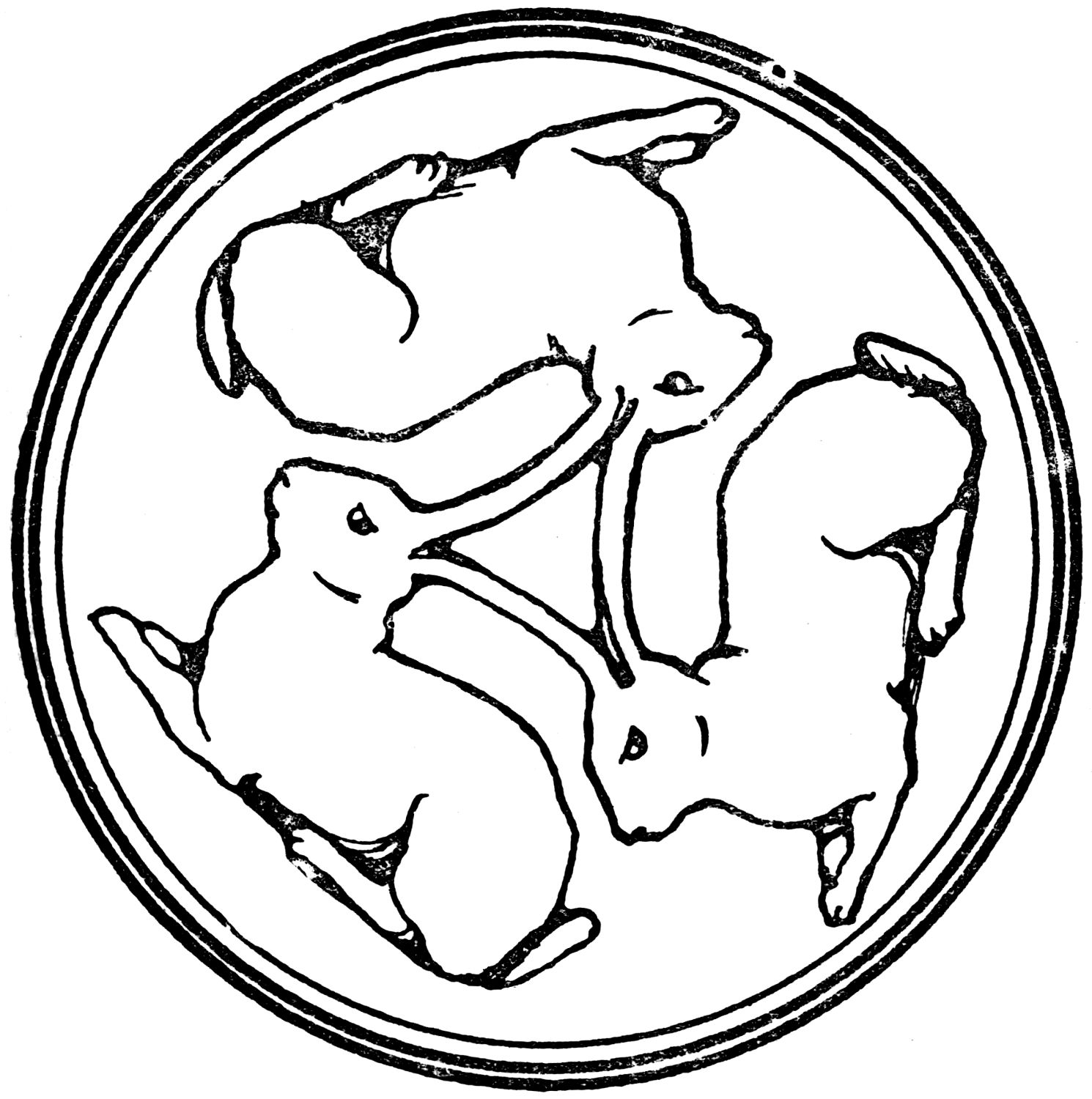
85. AN ENIGMA
And three from foreign source.
All these together you must take
Where dramas run their course.
[104]
No. CIV.—SCORING A CENTURY
On this table is shown in ten different ways how exactly 100 can be arrived at by the use of the nine digits, each appearing only once.
| 1 | 2 | 3 | 4 | 5 | 6 | 7 | 8 | 9 | |||||||||
|---|---|---|---|---|---|---|---|---|---|---|---|---|---|---|---|---|---|
| 1 | 1 | 4 | 95 | 3⁄7 | 56 | 98 | 6 | 15 | 15 | ||||||||
| 3 | 45 | 53 | 4 | 16⁄28 | 34 | 1 | 2 | 2 | 36 | ||||||||
| 5 | 7 | 6 | 7 | 3⁄6 | 8 | 79 | 47 | ||||||||||
| 8 | 9 | 8 | 1 | 27⁄54 | 9 | 8⁄4 | 98 | ||||||||||
| 9 | 62 | 71 | 98 | 1 | 6⁄3 | 2 | |||||||||||
| 26 | 38 | 29 | 2 | 3 | |||||||||||||
| 74 | 4 | ||||||||||||||||
| 75 | |||||||||||||||||
| 100 | 100 | 100 | 100 | 100 | 100 | 100 | 100 | 100 | |||||||||
| 9 × 8 + 7 + 6 + 5 + 4 + 3 + 2 + 1 = 100. | |||||||||||||||||
86. IF WE COULD CHOOSE
“If it were possible, I should choose,” said young Hopeful, “a life double as long.”
“Yes,” said old Sobersides, “and you might turn it to better account if it was also begun old.”
How did their actual words bear this out?
[105]
No. CV.—SEEING THROUGH A VEIL
On a piece of clear tracing paper draw with pen and ink a close network of lines, such as is shown in this diagram, near enough together to conceal type of ordinary size.
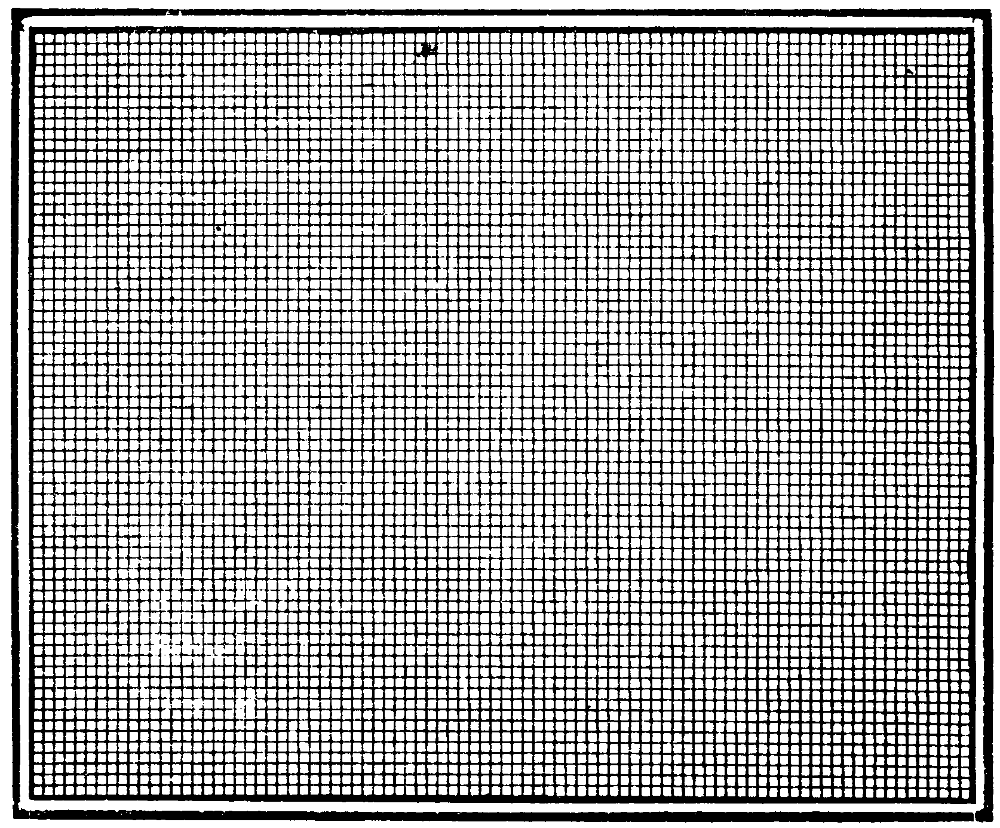
Place this on the page of a book, and challenge any one to read a sentence, or even a word, through it, saying that you can do so easily. How can you succeed?
87. A CHARADE
I have both tail and head.
Or if for spirits you’ve a mind
Set my tail first instead.
With many a darker page,
My whole in picture will disclose,
For “all the world’s a stage!”
[106]
No. CVI.—THE PAPER RINGS
In the diagram a strip of paper is shown (1), with its ends simply gummed together; (2), with a single twist; and (3), with a double twist. Can you decide, without actual experiment, what will be the result in each case if these are cut completely round, as is indicated by the dotted lines?
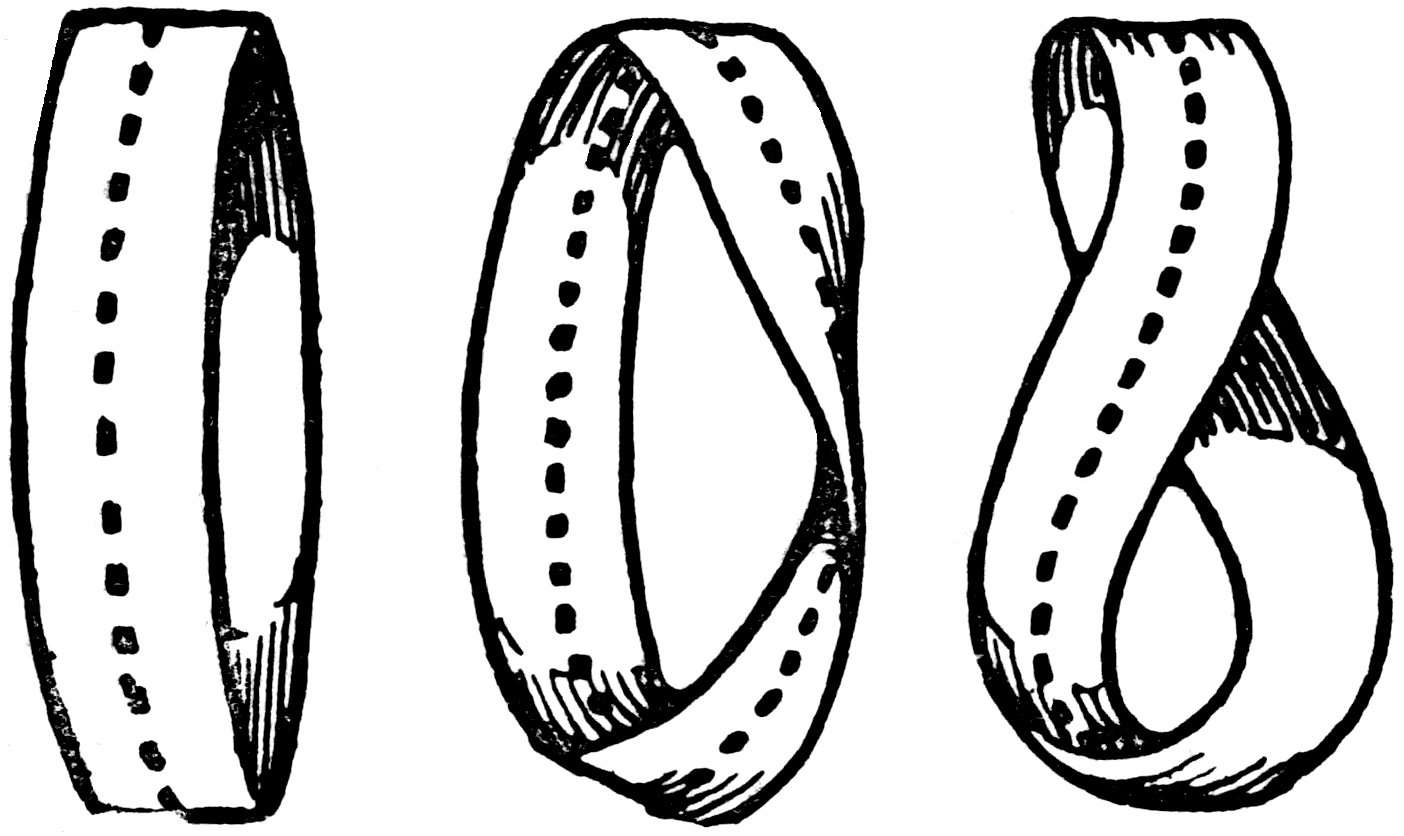
88. MISSING WORDS
With ........ that true art has traced.
89. ANSWER BY ANAGRAM
How do the actual letters of these words in their union prove that anæsthetics are “blessed in pain?”
[107]
No. CVII.—THE MAGIC BUTTONS
Make two parallel cuts with a penknife along the centre of a slip of leather or other material, and below them a hole of the same width. Pass a piece of string under the slit, and through the hole, and tie two buttons, each much larger than the hole, to the ends of the string.

How can the string be released without removing either of the buttons?
[108]
No. CVIII.—THE CAPTIVE SCISSORS
Fasten a pair of scissors securely with a piece of string to some convenient article, as is shown in this diagram:—
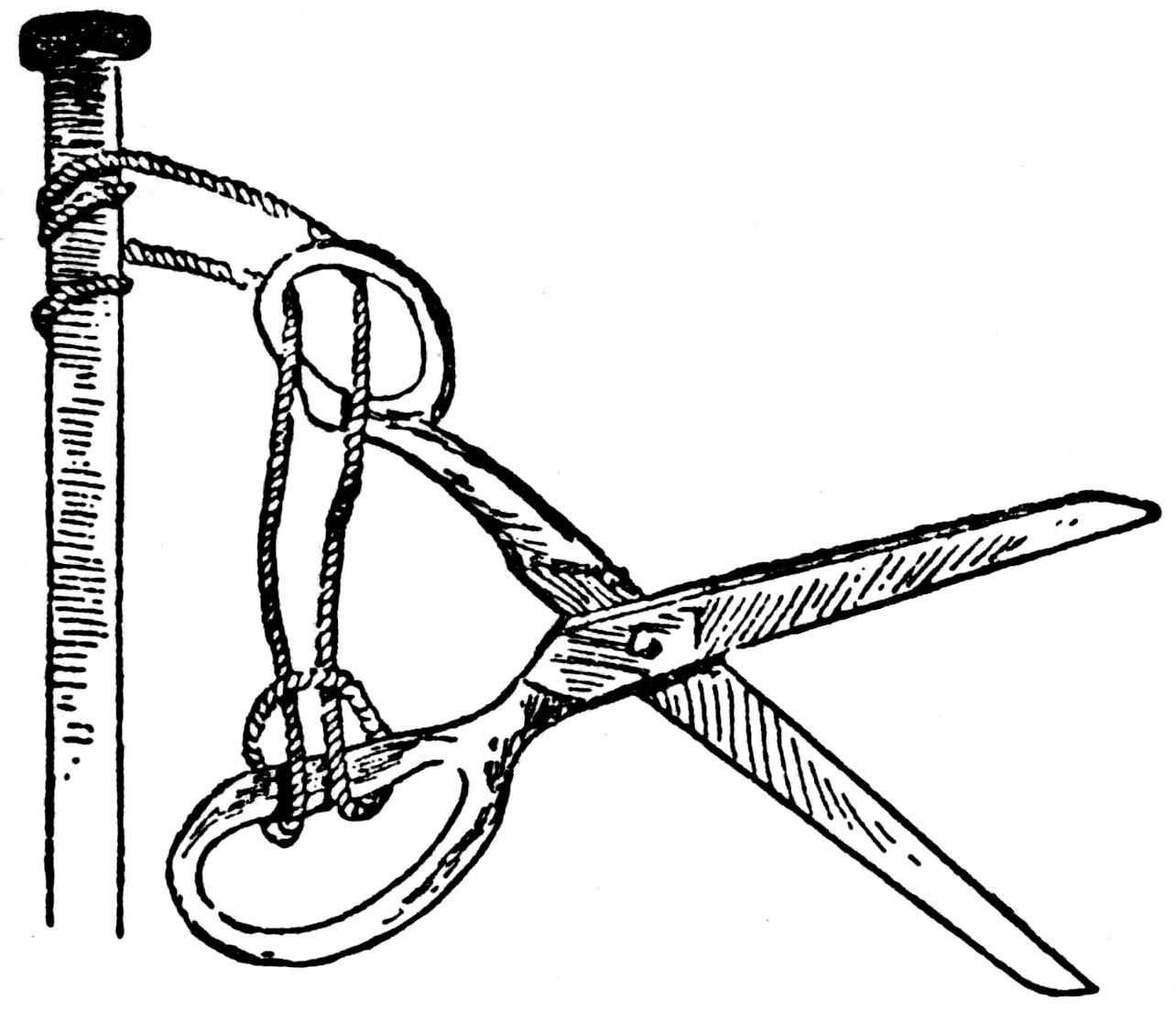
Can you release them without cutting or unfastening the string?
90. A BURIED QUOTATION
“What sin was it, sonny?” said an American negress to her lover, when she sat on his best hat, which was flattened. Wearily he heard her musical laugh, and arose to go. His hobby was botany, but not hers, for she was then a merry girl. “Bother the flowers! I would prefer this mellow pine-apple, Leonidas,” she said; “I guess we Ethiopians just love fruit!”
[109]
No. CIX.—A PRIMITIVE TRAP
This diagram represents in the simplest outline a primitive wolf-trap.
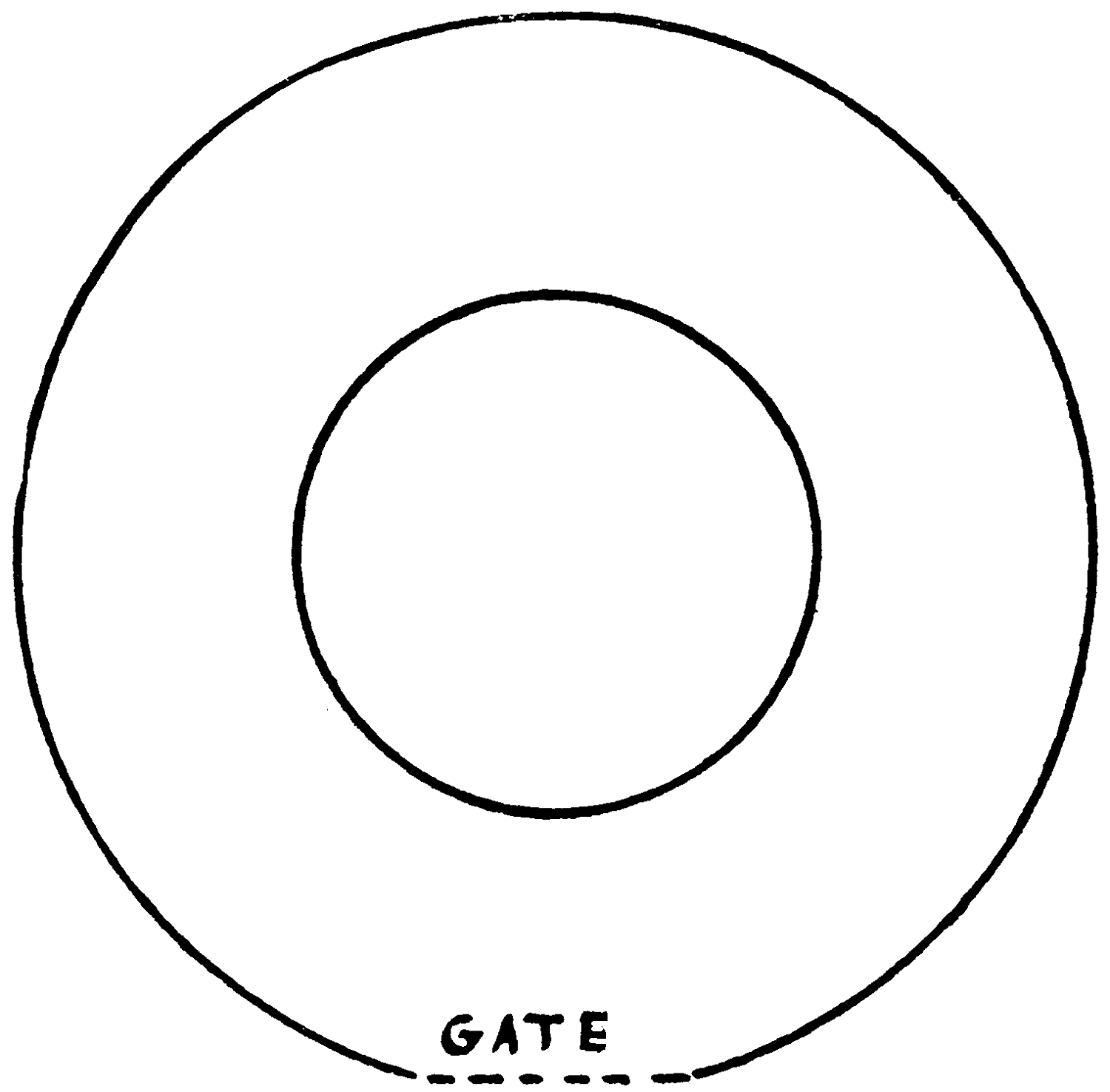
The dotted line is a gate opening into a circular enclosure. How was the trap set and the wolf caught?
91. LADIES AT A SALE
That half the .... gives way;
And home return with purses lean
To .... of “bargain-day!”
What are the missing words?
[110]
No. CX.—A SPINNING NEEDLE
To balance a needle on the head of a pin, push the pin into the cork of a wine bottle, and the needle into a separate cork.
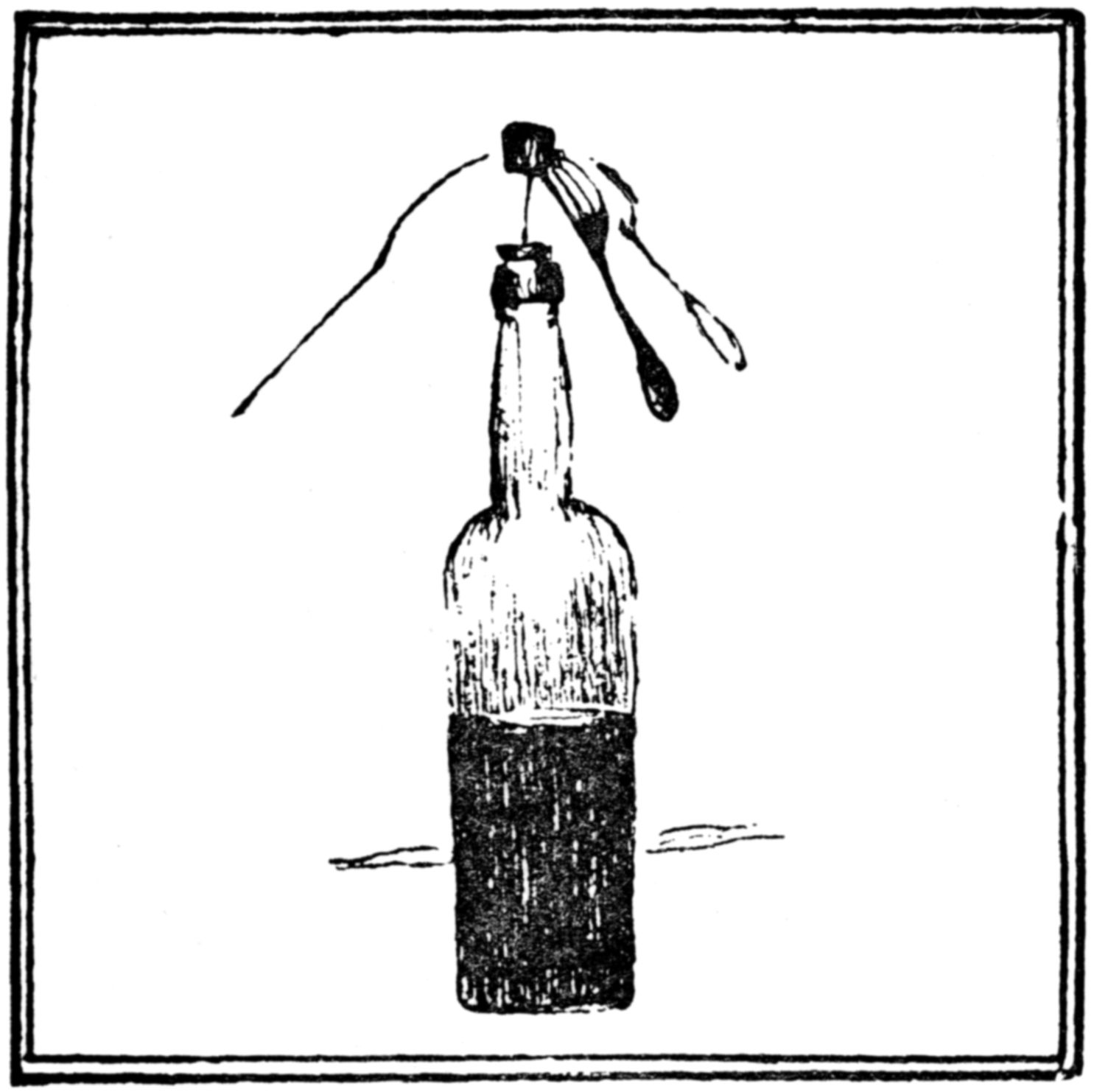
With the aid of three forks, as is shown in the picture, the needle may be balanced and spun round on the head of the pin.
92. MISSING WORDS
Air—“Three fishers went sailing.”
Out into the west as the sun sank low;
Each thought as they ...... of the lad she loved best,
For they all had ......, and each had a beau.
But seas will rise, and spirits will sink,
And they all were too ill of ...... to think,
So these ...... ...... back moaning.
Each missing word has the same six letters.
[111]
No. CXI.—AFTER DINNER
This diagram shows how, as an after-dinner trick, four similar wineglasses can be placed on the table
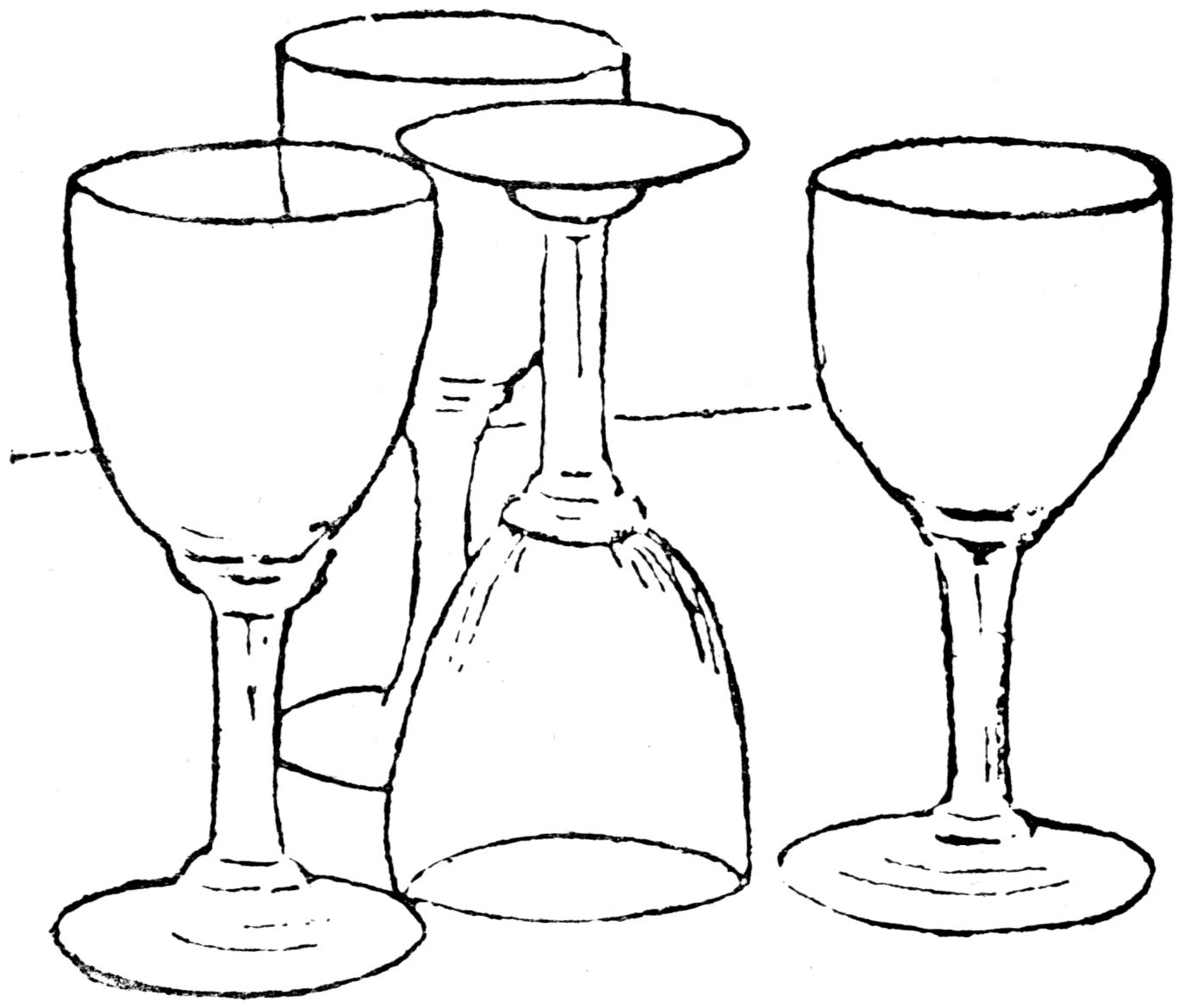
so that the centres of the lowest parts of their stems are equidistant from each other.
93. A CHARADE
My second should in ample stores abound,
Or help to make the sweetest songster heard.
Peculiar, and quite proper, is my third.
My whole has found with England’s monarch grace,
The verdant home of many a goodly race.
[112]
No. CXII.—SECOND SIGHT
Ask any one, with this diagram to work upon, to think of any number between 5 and 15, and, while your back is turned, to count up to it, beginning at the lowest step, and saying one, two, three, four, and so on, as each step of cards or single card is reached in the direction indicated by the arrow. When the number thought of has been thus arrived at, tell him to stop, and beginning afresh on that card, to count one, two, three, etc., backwards, this time skipping over the double six and the 3 steps until he again reaches the number thought of, and notices which card he has touched last.
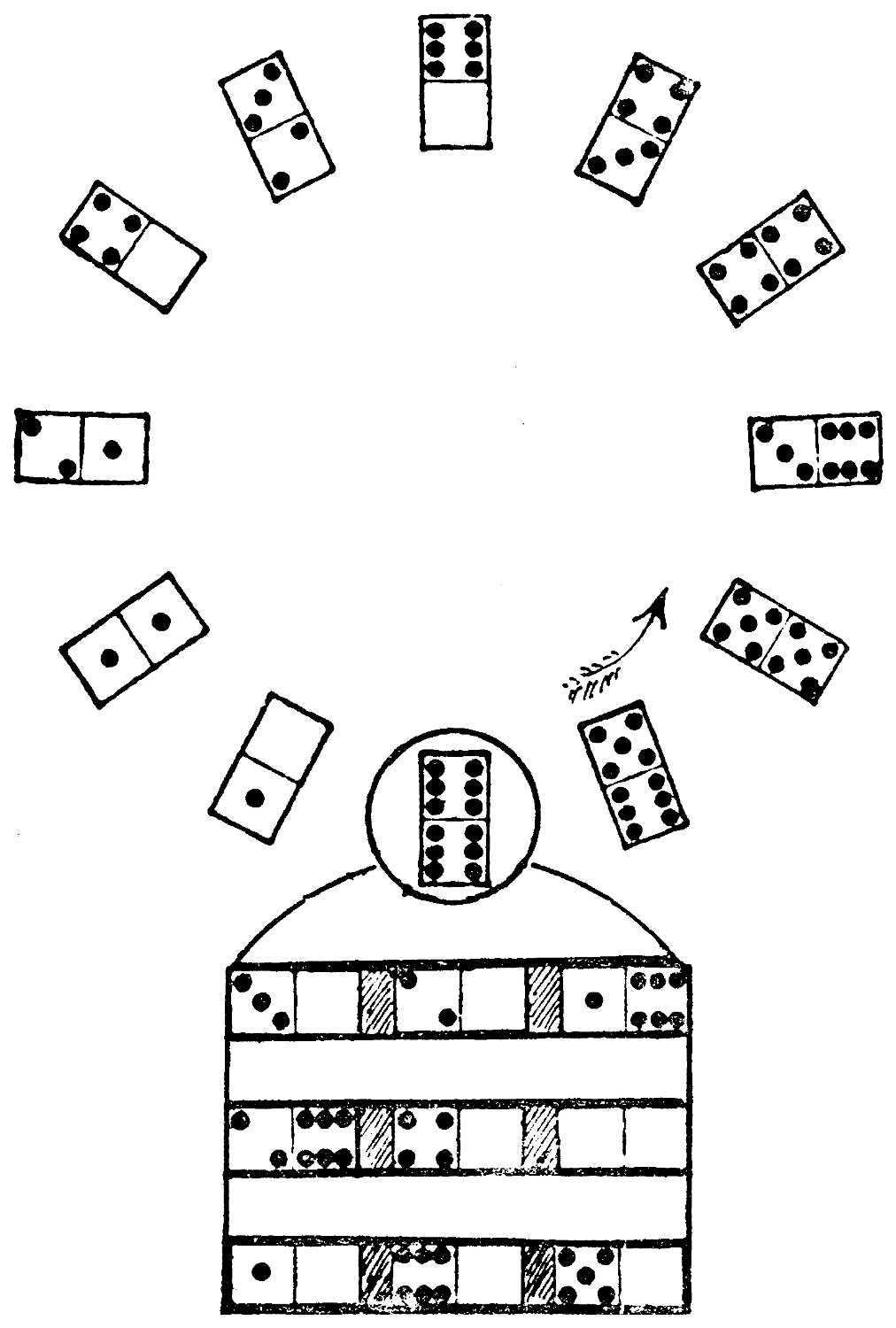
How can you, without having seen any of his movements, at once find that card?
[113]
No. CXIII.—AN AFTER DINNER TRICK
Cut a wedge out of an apple, as is indicated in the diagram, and make six gashes as is shown.
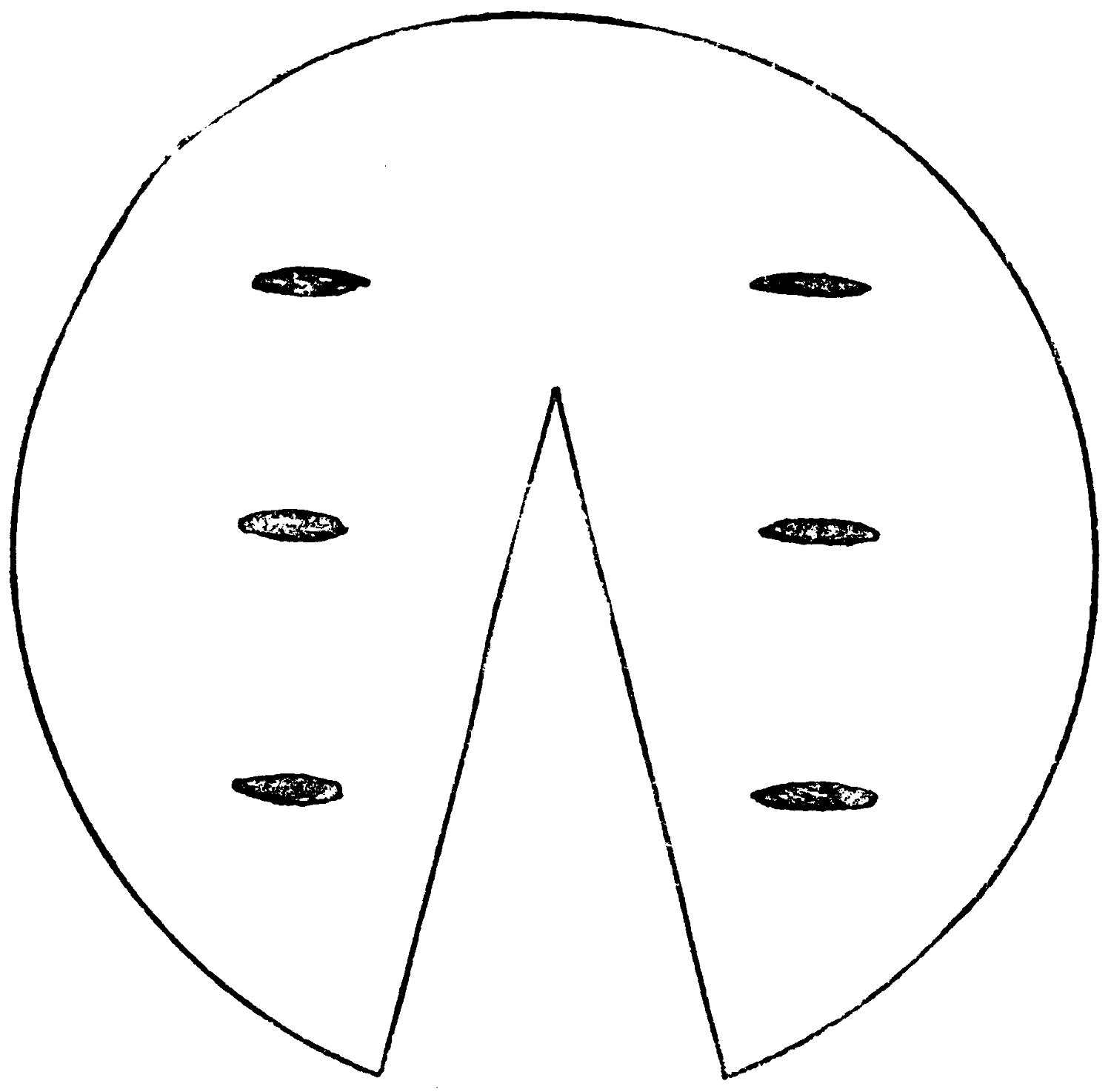
When this has been done, challenge anyone to divide the apple into six pieces by only two straight cuts, so that there shall be one of the gashes in each piece.
94. ALIKE TO THE EYE
An opening I appear
In other fashions said
I charm all far and near.
[114]
No. CXIV.—A TOY BOOMERANG
Cut out in cardboard a boomerang as nearly as possible of the size and pattern given here:—

Place it flat on the back of the first three fingers of the left hand, sloping them upward; then flick it smartly with the second finger of the right hand. It will fly off and return to your lap. Try it.
95. LONDON BY ANAGRAM
Here are two simple sentences:—
A lamp shines out for thee.
Win me best by tears.
Can you recast the letters, so that they form the names of two of the most important buildings in London?
96. HEARD ON THE BRIGHTON BEACH
It was low tide; two children were throwing pebbles into the sea, and sending their excited collie in pursuit of them. The Puzzle Editor, who was on holiday, quickened perhaps by the salt air, bethought him of this appropriate riddle:—What is the difference between that dog and a hungry man?
[115]
No. CXV.—IN THE GRIP OF A RADISH
Cut a radish in half, press the lower surface firmly against a plate, as is shown in the diagram:—
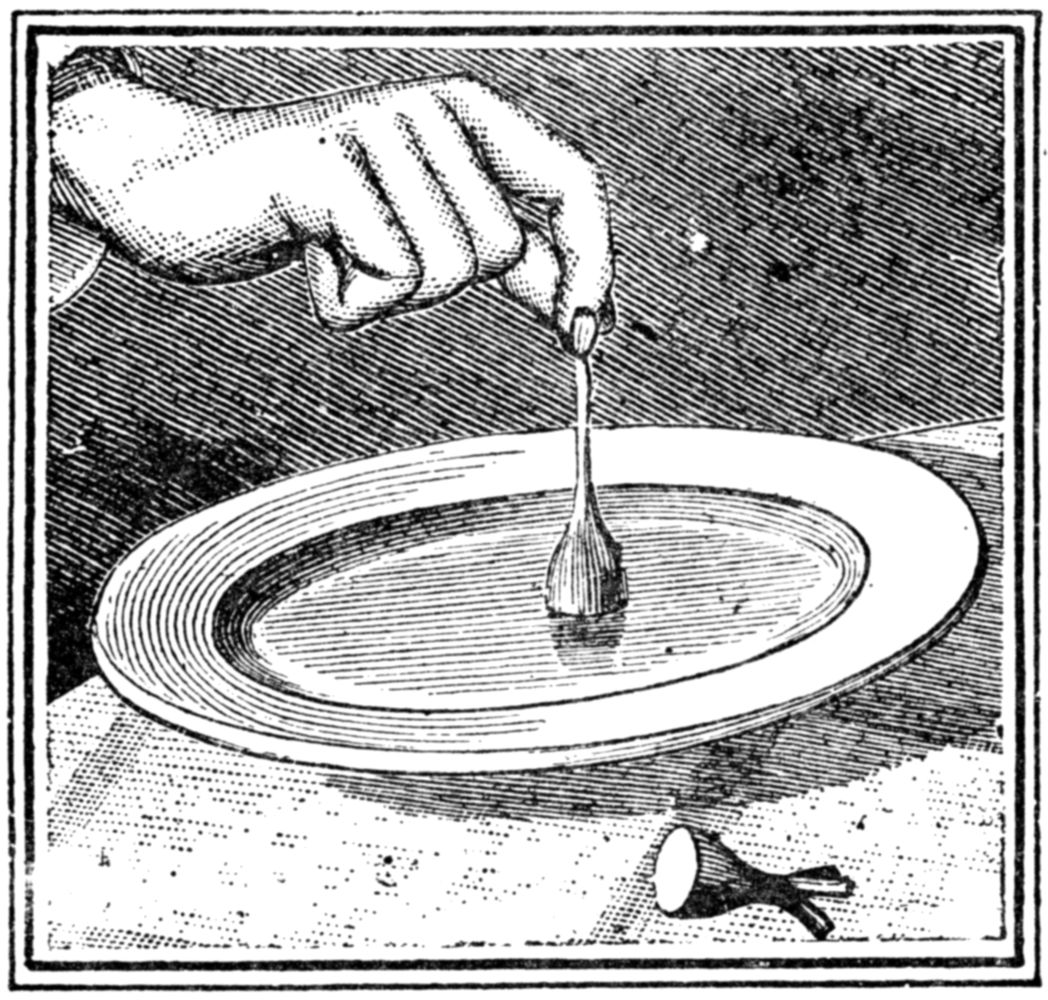
and you can lift the plate, to which it clings as closely as a boy’s wet leather disc to the pavement.
97. FIND THE ANIMAL
A part in hail must be,
A part belongs to pain,
A part in bones we see,
A part in gleaming gold,
A part in common copper.
A part in peace behold,
A part in any topper;
Two parts are heard in sound,
And in our finals found.
[116]
No. CXVI.—ELASTIC PAPER
The countryman who cut one hole in his door for the cat and another for the kitten would find it difficult to pass a penny through a hole the size of a shilling cut in a stout piece of paper.
This diagram shows how easily it can be done:—
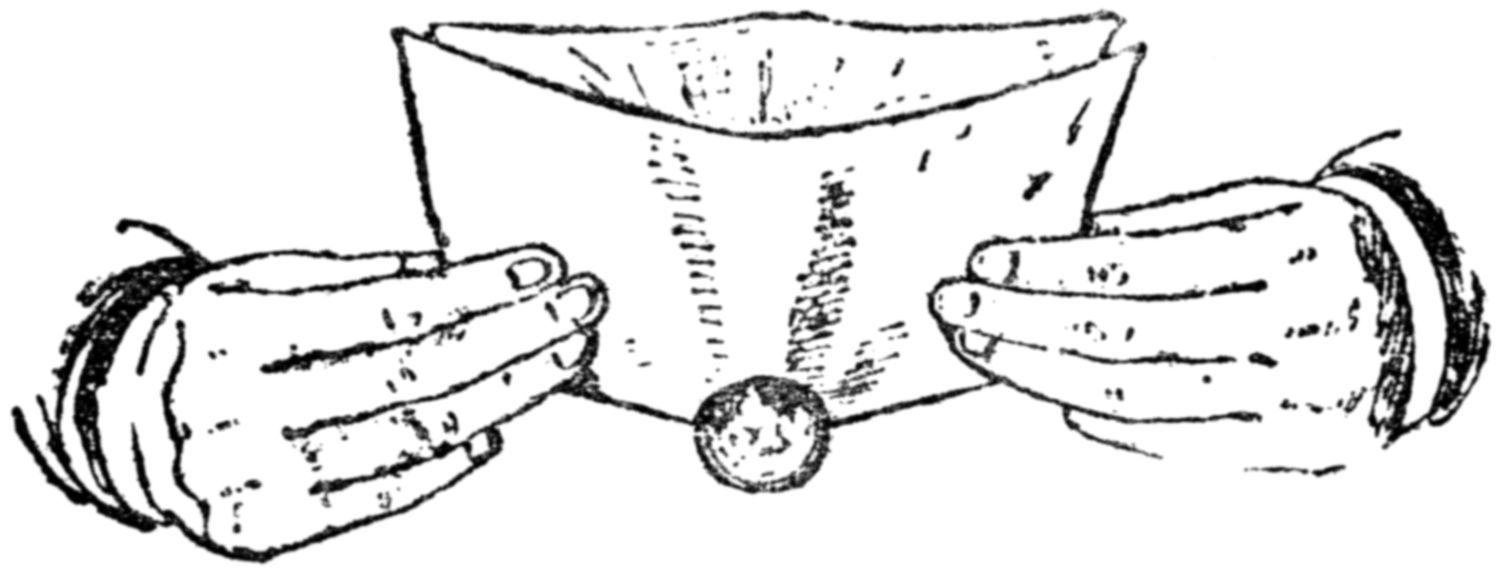
Fold the paper across the centre of the hole, place the penny in the fold, and bend the lower corners of the paper upwards. This elongates the opening, and the coin falls through.
98. A SMART ENIGMA
Book-learning I never could boast;
Yet I turn the leaves inside the cover,
And when I am found I am lost.
99. MISSING WORDS
Comparative, a ..... is like a . ...;
For when their substances in liquor sink
Both properly are said to be in drink.
One of the letters of the two short words is used twice in the longer word.
[117]
No. CXVII.—THE NIMBLE SIXPENCE
Place a sixpence on the tablecloth, and over it set a tumbler, as is shown in the picture below.
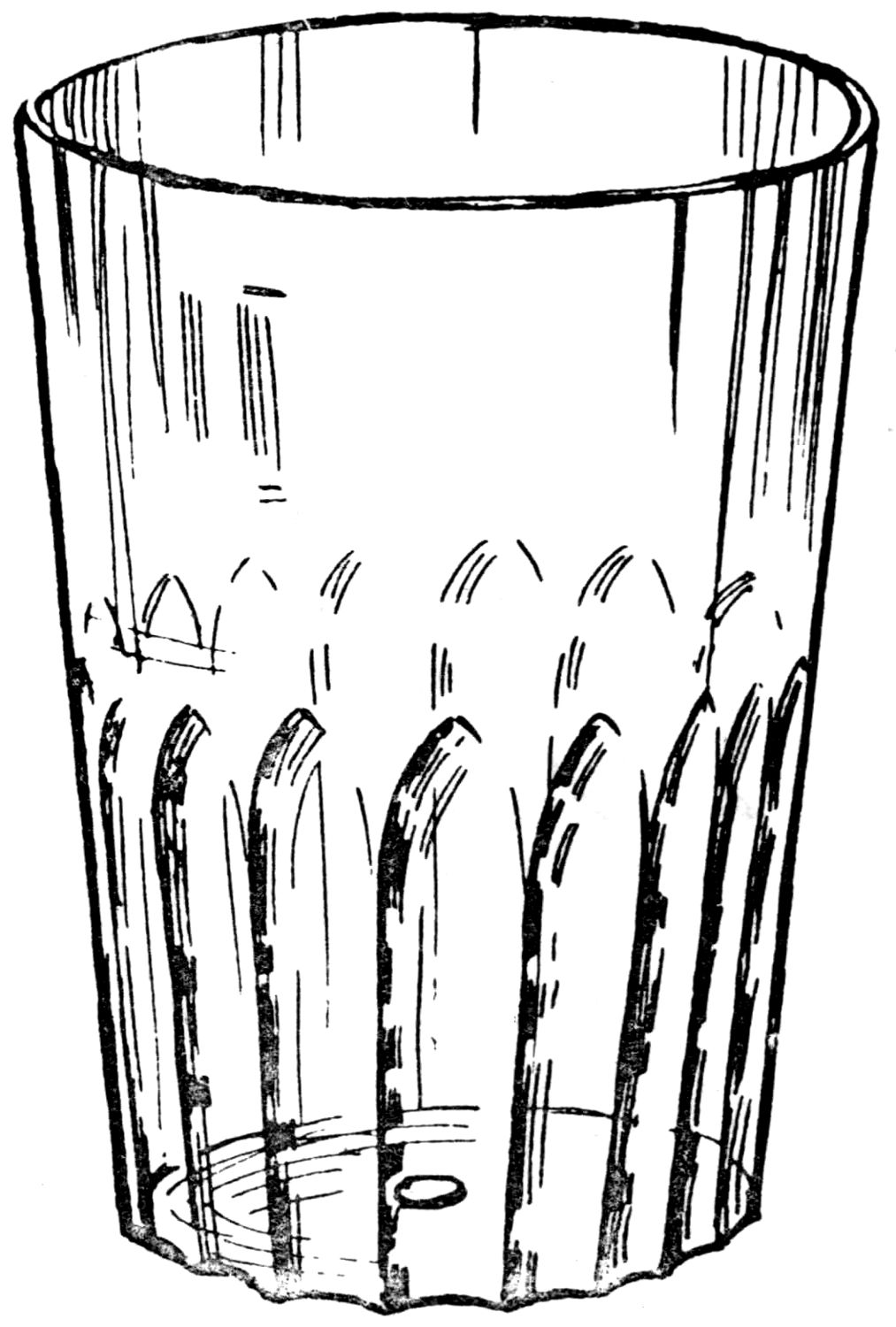
How can you pocket the sixpence without removing the glass, or having it removed?
100. A PIED PROVERB
abdeefiinnnoopprrrsssttuw
101. SELF-DEFINED
In youth its joys none need descry;
But where our elders take to it
Its name points loss of dignity.
[118]
No. CXVIII.—HOW TO DRAW A SPIRAL
How can you draw such a spiral as this with very simple appliances?
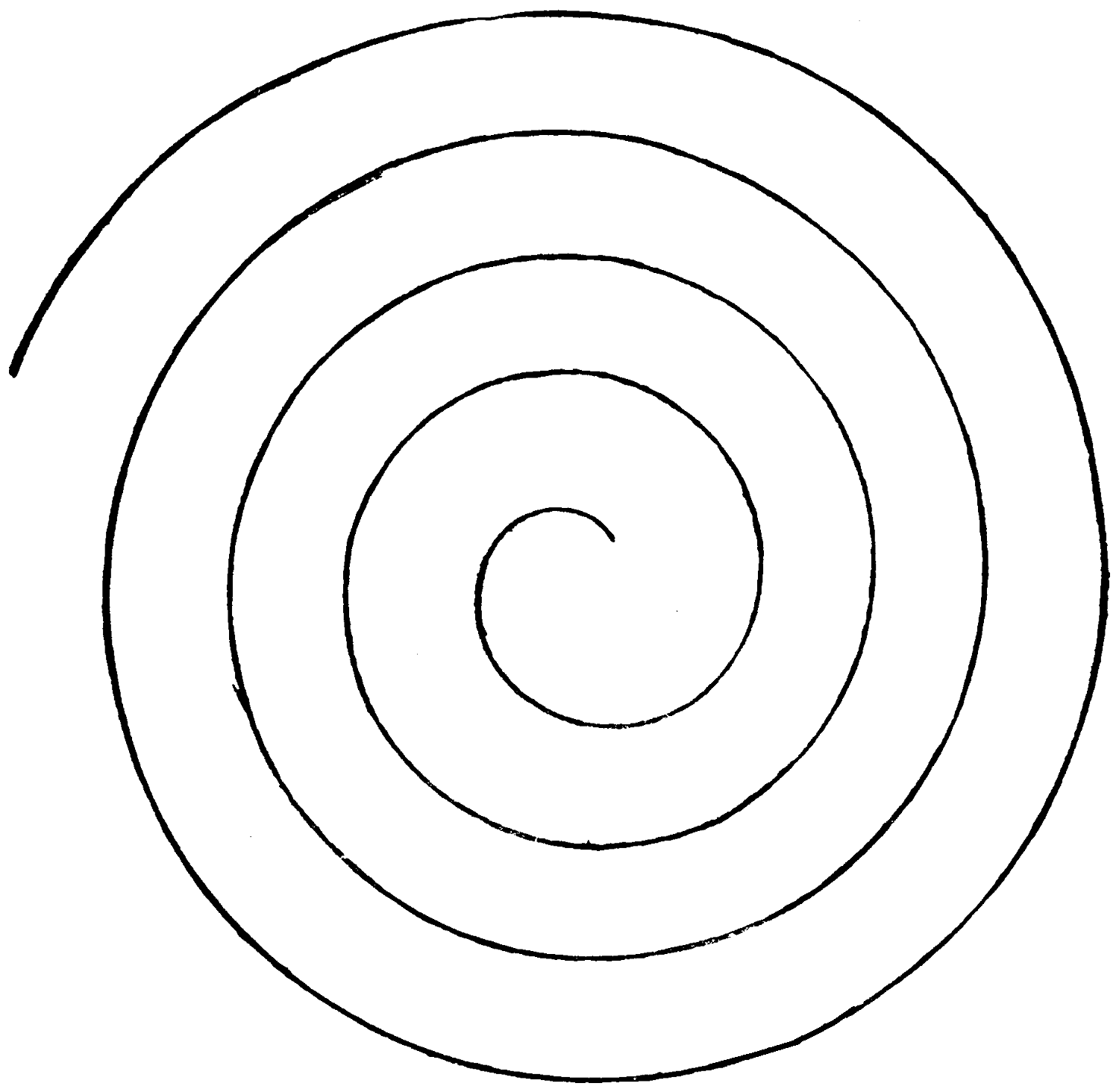
This spiral is drawn rapidly without removing the pencil from the paper.
102. FIND THE HERO
My next’s in praise, but not in bliss;
My third’s in man, but not in miss;
My fourth’s in we.
My sixth’s in cat, but not in dog;
My next’s in calm, but not in fog;
My eighth’s in we.
My tenth’s in light, but not in shine;
My next’s in four, but not in nine;
My twelfth’s in we.
[119]
No. CXIX.—FOR HANDY FINGERS
Take a piece of stout paper or thin cardboard, about 10 in. by 8 in., and cut it as is shown below, removing the parts that are shaded in the diagram.
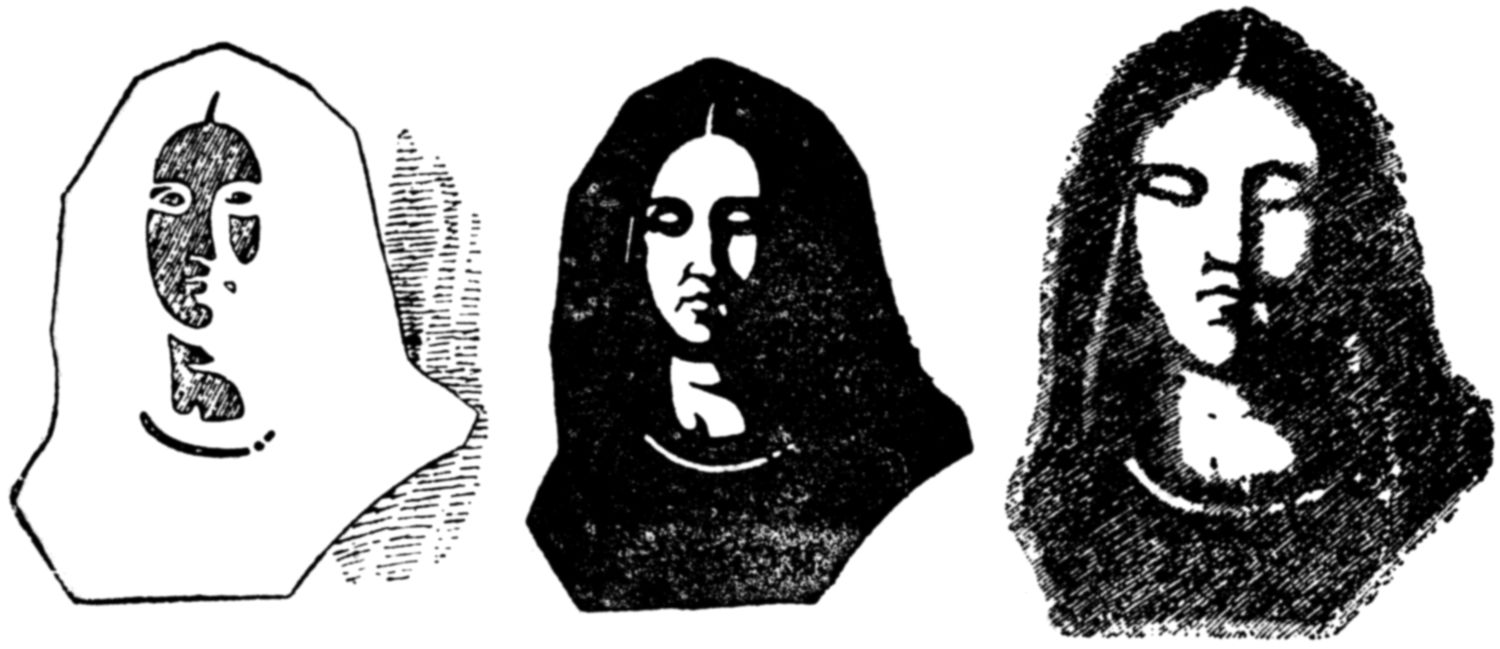
If you hold this between a plain wall, or other surface, and a strong light, you will, with a little practice, be able to cast a shadow similar to one or other of these Madonna heads, which will vary in intensity and expression with the positions of the paper and the light.
[120]
No. CXX.—THE FOUR KINGS
This excellent and easy little card trick will commend itself for fireside use in the long evenings.
Take the four Kings from a pack, and two other cards. Hold the Kings thus, in the form of a fan—
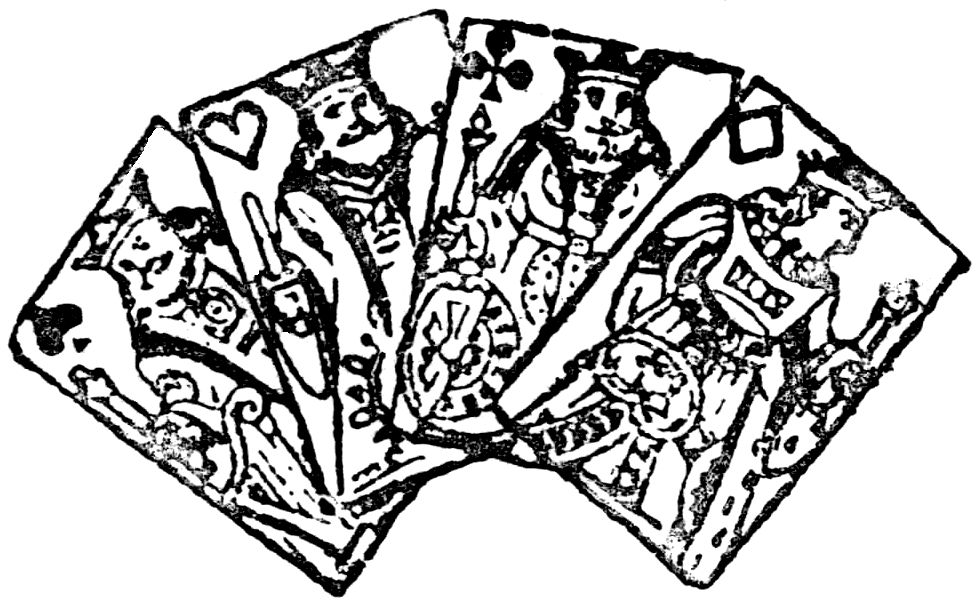
hiding the two other cards behind the King of Diamonds.
After showing them, place the six cards at the bottom of the pack. Now move the lowest card to the top, and the two next cards to any part of the pack, apparently leaving but one King at the bottom. Ask some one to cut the pack, and all the Kings will be found together. Some appropriate patter will help the effect.
103. PROVERB BY ANAGRAM
Can you recast this sentence—
A defeat whose test is very sure—
so that the same letters form an appropriate proverb?
[121]
No. CXXI.—DOMINO SQUARE
Its cells add up in columns and rows to 22, and those of the corner squares add up to 10 and 12 respectively.
| ● | ● | ● | ● | ● | ● | ● | ● | ● | ||||||||||||
| ● | ● | ● | ● | |||||||||||||||||
| ● | ● | ● | ● | ● | ● | ● | ● | ● | ||||||||||||
| ● | ● | ● | ● | ● | ● | ● | ● | |||||||||||||
| ● | ● | ● | ● | ● | ● | |||||||||||||||
| ● | ● | ● | ● | ● | ● | ● | ● | |||||||||||||
| ● | ● | ● | ● | ● | ● | ● | ● | ● | ||||||||||||
| ● | ● | ● | ● | |||||||||||||||||
| ● | ● | ● | ● | ● | ● | ● | ● | ● | ||||||||||||
| ● | ● | ● | ● | ● | ● | ● | ● | ● | ||||||||||||
| ● | ● | ● | ● | |||||||||||||||||
| ● | ● | ● | ● | ● | ● | ● | ● | ● | ||||||||||||
| ● | ● | ● | ● | ● | ● | ● | ● | ● | ||||||||||||
| ● | ● | ● | ● | |||||||||||||||||
| ● | ● | ● | ● | ● | ● | ● | ● | ● | ||||||||||||
| ● | ● | ● | ● | ● | ● | ● | ||||||||||||||
| ● | ● | ● | ● | ● | ● | ● | ● | |||||||||||||
| ● | ● | ● | ● | ● | ● | ● |
104. PHONETIC MISSING WORDS
To .... a .... of ....s;
A .... may often take a ....
To .... away the ....s.
[122]
No. CXXII.—THE TALKING HEAD
This, though quite an old illusion, may be a mystery to some of our readers, so we give it a place among our many curiosities.
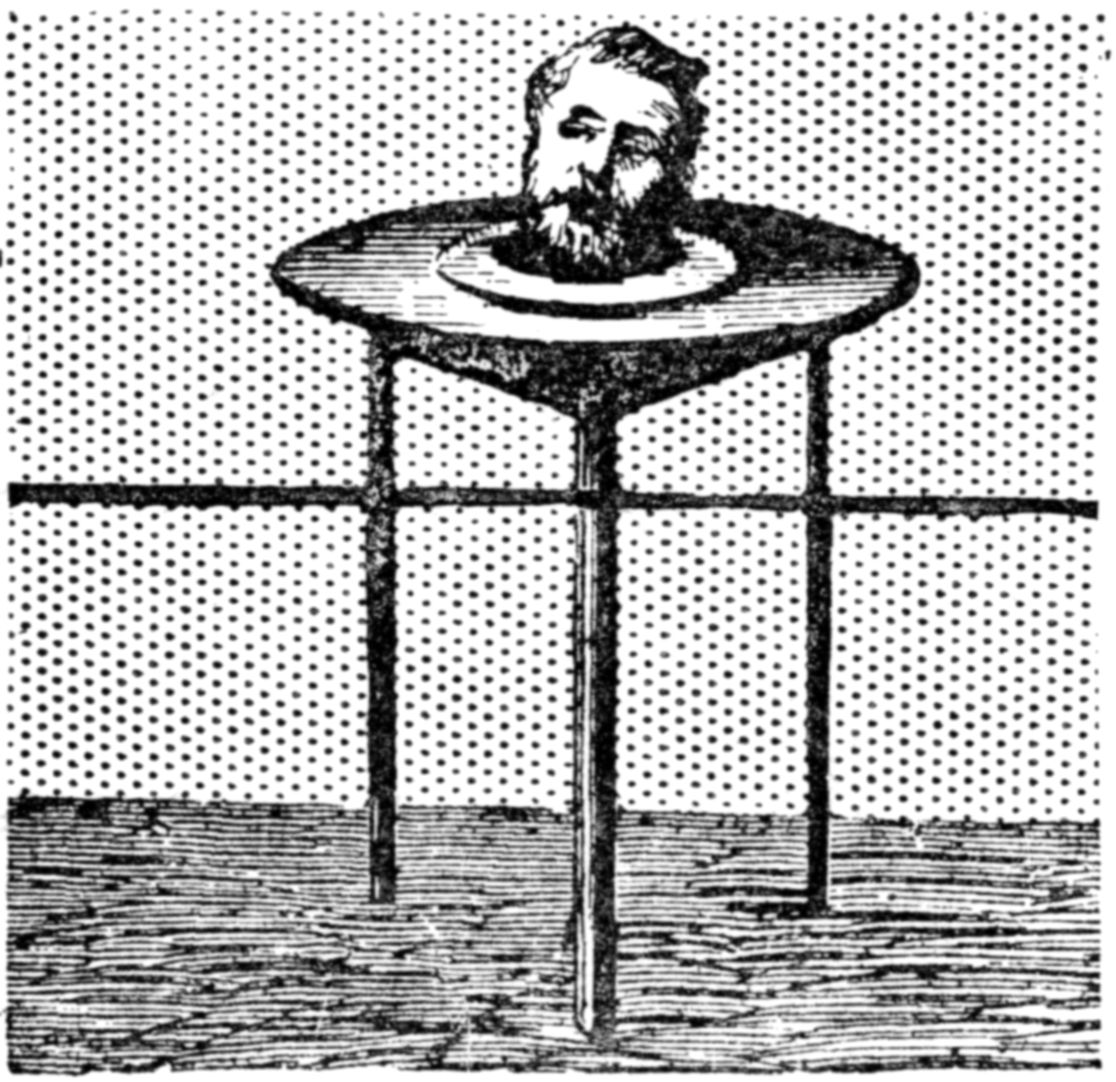
The table is placed on the middle of a platform, well away from the background, and the head, which is very much alive, is prepared to answer questions, or to whistle, or to sing, at the will of the audience. “How it is done” will be explained.
105. A QUEER OBSTACLE
Yet no one I stop.
My four horns each day
Horizontally play,
And my head is nailed on at the top.
[123]
No. CXXIII.—A GENERAL OF THE LIGHT BRIGADE
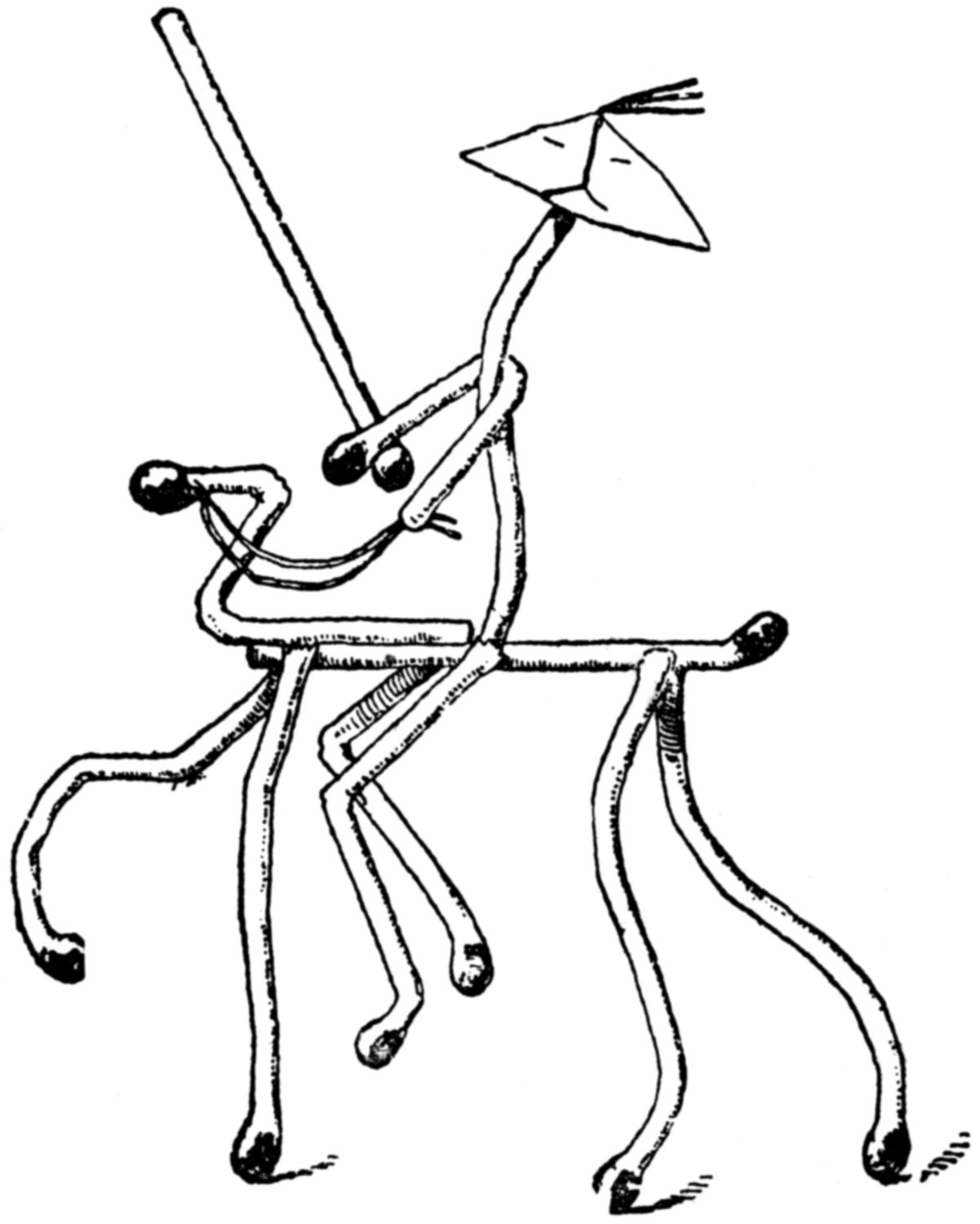
With a little ingenuity, and by slightly warming the wax, and shredding the matches for some effects, all sorts of comical figures can be contrived, similar in character to this dignified general on his high-stepping charger.
106. AN OLD ENIGMA
(By a former Fellow of Trinity College, Dublin.)
Put fifty in the middle;
Twice ten times five times ten
Will finish off my riddle,
And bring it to your ken
As fit as any fiddle!
[124]
No. CXXIV.—ANOTHER BOOMERANG
Cut out in cardboard a cross similar to that shown in this diagram:—
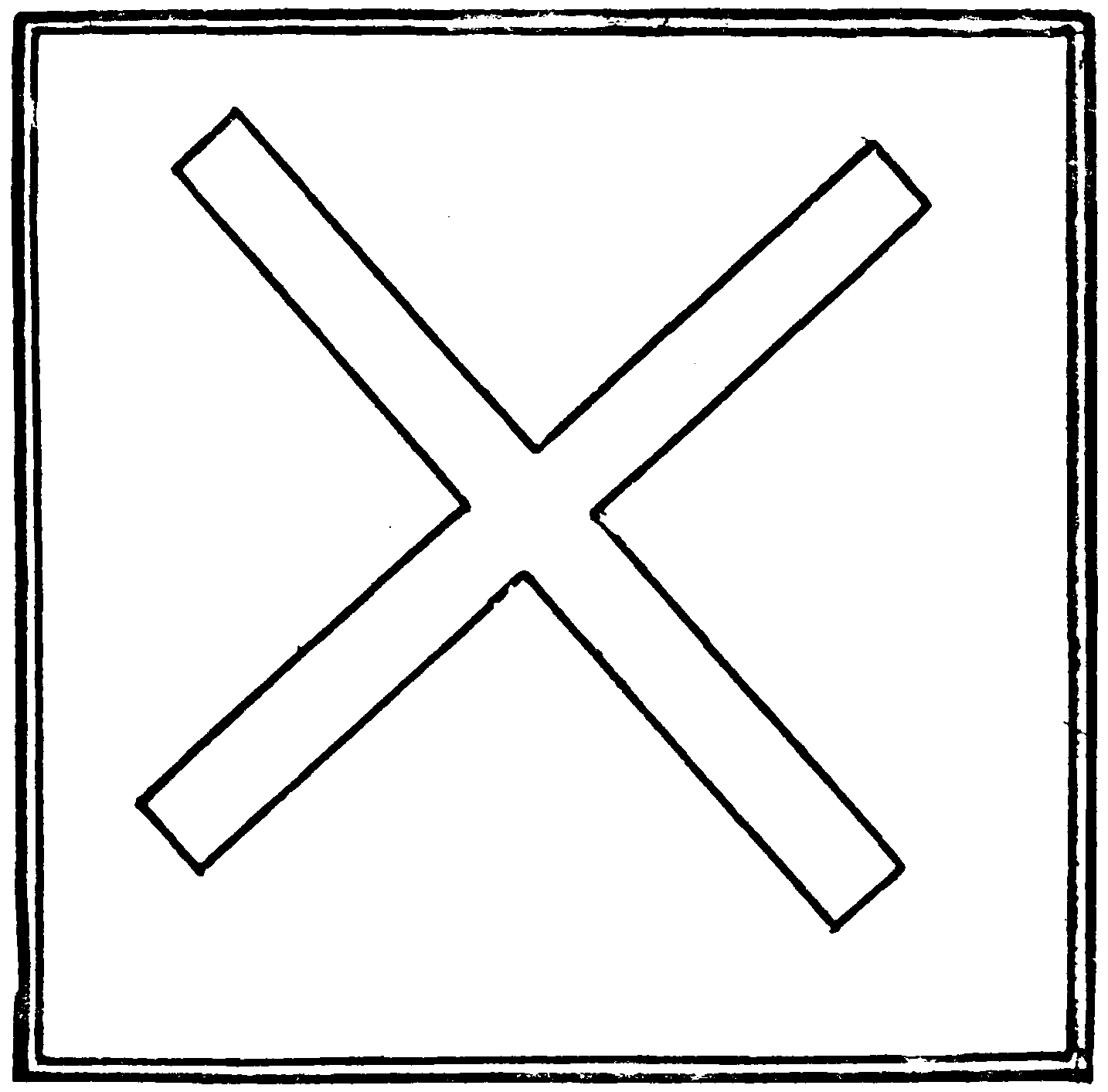
Place one of its limbs under the thumbnail of the left hand, and give the next projecting limb a sharp flick with the middle finger of the right hand. The little boomerang will fly sharply forward, and invariably return rapidly on its tracks. Try it.
107. PHONETIC GAPS
Can you fill these gaps with words of similar sound?
A ..... will ... before it;
We cannot .... the ...., or find
That earthly powers ..... o’er it.
The gaps in line 1 take words that sound alike; so do those in line 2; and so do the other three in lines 3 and 4.
[125]
No. CXXV.—A PICTURE CHARADE
Can you fill in the missing words so as to complete this picture charade?
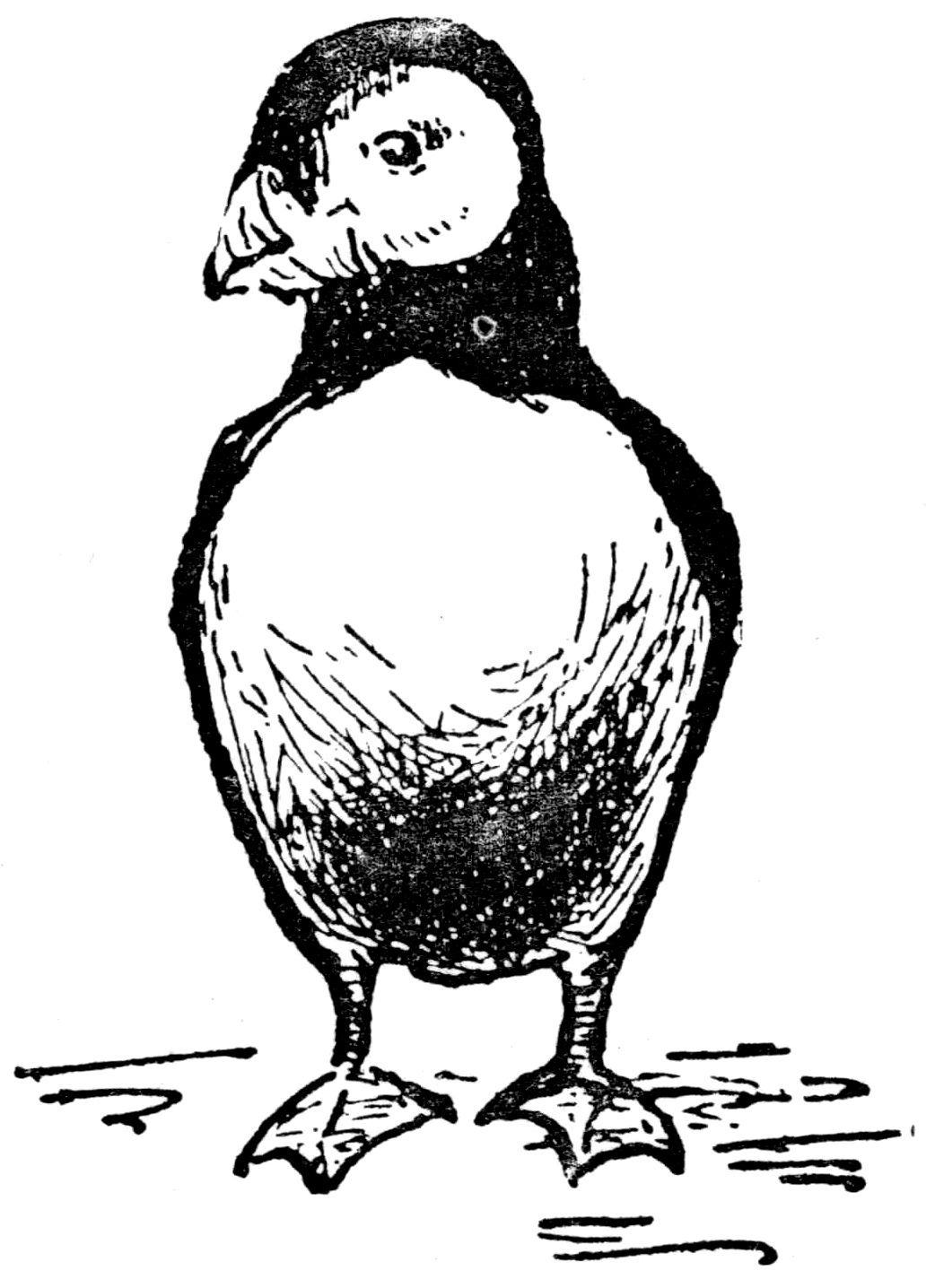
My second then ..... ..;
My whole in ..... moves .....
....... an oar or ...
108. SOUND SENSE
Reverse us, and we indicate a county.
109. A CRYPTOGRAM
LLSKMTMXTTLLTSTHN!
Can you so deal with this as to form a rhyming couplet?
[126]
No. CXXVI.—WALNUTS AND COBS
A good after dinner trick
Place four walnuts and four cobnuts in a row, as indicated on the diagram.

Now, moving always two that stand together, transfer them to some other positions along the line, and in four such moves leave them so that the large and small nuts range alternately. It may, of course, be done with large and small coins, or with other things that are at hand.
110. A BURIED PROVERB
Old memories steal anew;
With a tear, with a sigh, with an old, old cry
They return in ghostly hue!
111. DOUBLETS
Here is another exercise in Doublets, from Lewis Carroll’s book on the subject:—
Turn ELM into OAK by seven links, introducing the name of another tree as one of them.
[127]
No. CXXVII.—A PICTURE RIDDLE
Can you read in this picture the question of our riddle?
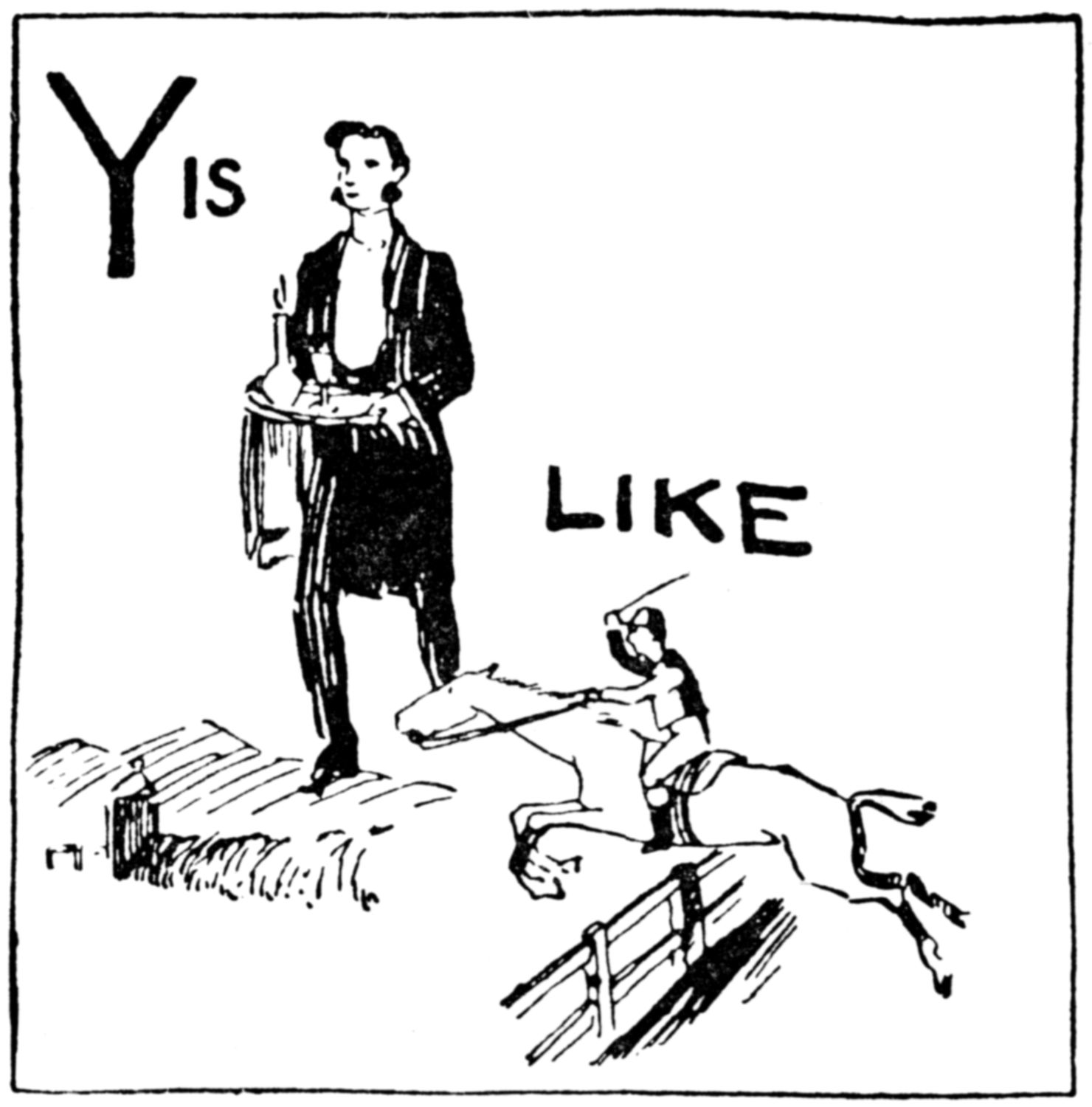
112. TWO POSERS
1.
We are giving a ball;
First second we third,
Pray give us your all.
2.
Till I became my whole;
And told the tale of my repast,
A sad and greedy soul.
[128]
No. CXXVIII.—BUY A BROOM
Here is an excellent example of how a characteristic figure may be contrived by shredding, warming, and uniting a few wax matches:—
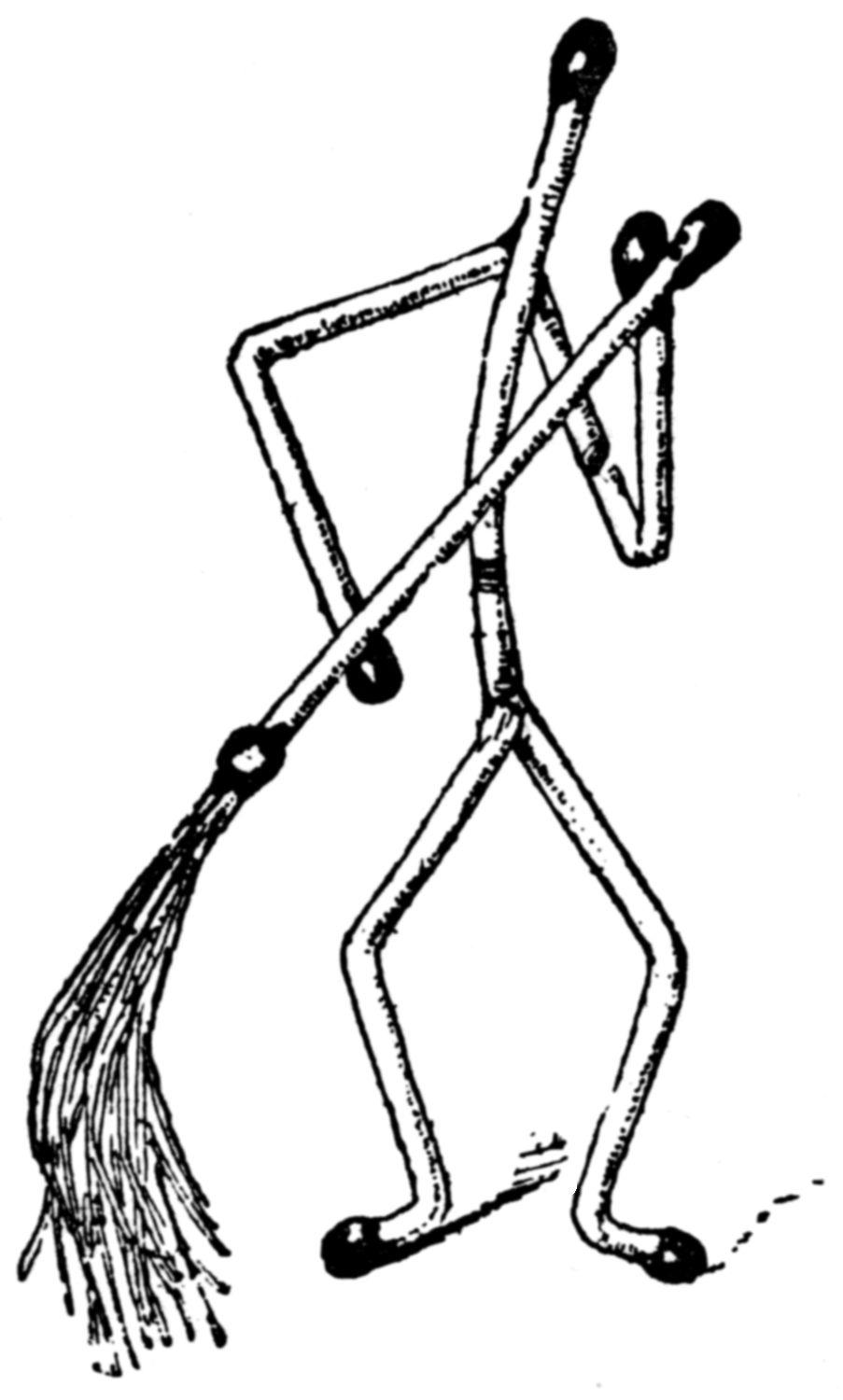
Many similar figures can be made by handy fingers.
113. A CHARADE
His daily task to meet;
Behead, transpose, and lo! a sound
Of music soft and sweet;
Behead again, I make my way
With swiftness past belief;
Again, and where the fields are gay
My bounty brings relief.
[129]
No. CXXIX.—JEU DE PARQUET
(For the children)
An old book, published more than 100 years ago, gives the following samples of patterns which may be formed with very simple materials:—
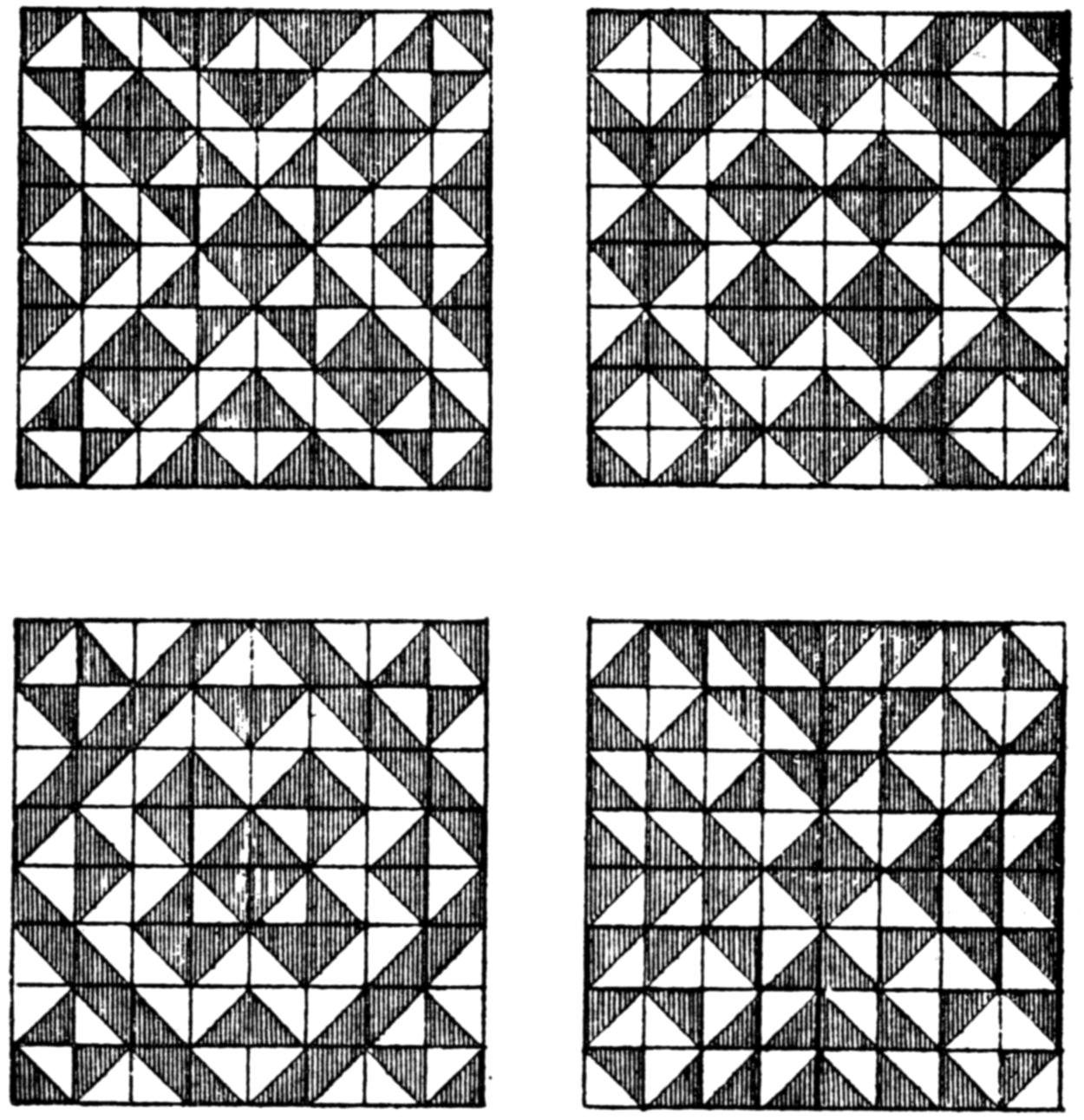
All that is needed for this pastime is a set of 128 coloured triangles, 64 of each colour, with which an endless variety of patterns can be arranged by the exercise of taste and ingenuity.
[130]
114. LINES BY AN OLD OXBRIDGE DON
Women should try for a B.A.
To College honours forward looking;
They’d best confine themselves to cooking!
How could a Girton girl retort, using the same words?
115. LESS AND MORE
Three syllables contain;
Take one away, and see
Four syllables remain!
116. BURIED BEASTS
Can you dig out nineteen beasts that are buried in these lines?—
Ireland’s lot heals slowly. Troubles came long ago—at times in battalions—to attack and harass her. Ambitious democrats now countermine famous enthusiasts nearly akin to heroes. Anarchy enables cowards to sow hot terror and all amazement.
117. PALINDROMIC VERSE
Can you recast the following sentences so that their words form a verse of four lines, which makes good sense, with lines that rhyme alternately, when read from either end?:—
Fading slowly day dies, mournful winds sigh, Stars are waking brightly; owlet holding high revel flies hooting, breaking nightly silence.
[131]
118. AN ANAGRAM IN THE MAKING
“The Observatory at Greenwich, in England,” has been turned into an excellent anagram, which starts—On landing here begin—Can you complete it?
119. AN ENIGMA
And, if you turn me round,
To hear my warning cry
Not any men are found.
120. ASK A SAILOR
When times are harder?
How do they greet with merry jest
An empty larder?
121. AN ENIGMA
Transpose me I am three;
Look in a book, you find me there,
And with me her and he.
122. MISSING WORDS
The circle to a .......;
His friends ....... that a brain so rare
Required attention ........
The missing words are spelt with the same seven letters.
[132]
123. A HUMAN PRODIGY
And I’m my mother’s mother;
My daughter and sister are one,
I’m grandam to my brother!
How was this?
124. A CHARADE
Add a simple word;
Then my whole may help a bit
Opportunely heard.
125. A PARADOX
Some little space we were apart.
When we had run a mile or more
We kept our distance, as before;
Shade of Colenso! could this be,
When twice as fast as I ran he?
126. AN ENIGMA
(From Lewis Carroll’s Papers.)
Am I in all sincerity,
Half cat, half hindrance made.
If head and tail removed should be,
Then most of all you strengthen me.
Replace my head, the stand you see
On which my tail is laid.
127. A CHARADE
And my worth by a child may be reckoned;
The least thing in nature is double my first,
And my whole is just half of my second.
[133]
128. WHAT IS IT?
Is one and undivided;
My second shows its teeth, is frail,
And as a rule one-sided.
The two to hold my first avail,
My busy toil provided.
129. BURIED TOWNS
In each of these sentences a town is buried:—
His sister played the piano while we sang.
I saw Nell out here last evening.
The general rode a large black mare.
I have ordered a cab at half-past one.
Meet me in the lane at half-past nine.
Can you dig them out?
130. A GOOD ANAGRAM
“The leaning tower of Pisa, in Tuscany, Italy.” The first seven words of its anagram are “A funny spot in a sweet city.” Can you complete the anagram by adding four more appropriate words?
131. MISSING WORDS
Near the ....... at Rome
’Twas the ....... discussion of the season;
But the ....... effect
Of the skeletons select
Deprived the poor Professor of his reason!
[134]
132. A CHARADE
My second a dandy;
When fogs are most dense
My whole will be handy.
133. A DECISIVE ANAGRAM
Can you prove by anagram that, whatever may be true of other plays accredited to Shakespeare, Bacon had certainly no hand in “Much Ado About Nothinge,” if we adopt the old spelling of the final word?
134. RATHER OBSCURE
Can any guess it right?
Transposed, and never seen at all,
It still is felt in sight.
Behead, transpose, then let it be,
And you at last a clue may see.
135. SHUFFLE THE LETTERS
Can you recast “Insanitary” and “Sanitary Reform” so as to form two very appropriate anagrams?
136. A CHARADE
When I come to table;
Though I cannot quench your thirst
Eat me—you are able.
[135]
137. MISSING LETTERS
whtdyssdrksdysthtwrslrm?
lssknyskthndfr,
llshllcllwrhrssndhrm.
whycllsblldstlkthtghstlyrt
llgllntctsgrndndmntyprt?
Can you supply the missing letters?
138. A CHARADE
The moon fresh brightness brings;
Cut off my tail, I’m blunt, but meet
To sharpen other things.
Soldiers to face the foe;
Headless and tailless, one remains
Though all the rest may go.
139. IS IT BANTING?
Then there’s an end of you.
A vengeful goddess shows at last
What Antifat will do.
140. A CHARADE
To seek some hidden goal,
Over my first my second comes, and then
Quite overcomes my whole.
[136]
141. A PRIZE CRYPTOGRAM
The following cryptic lines were sent as a reliable tip before a race in which Petronel was to run:—
“Tell me, Ben, who tore it
Seek a plant for it, see Bob.”
Can you discover their hidden meaning?
142. AN ENIGMA
From me all come, in me all end.
And it is strange but very true
That I am here and nowhere too.
143. FACING BOTH WAYS
Can you fill in this broken sentence, first to describe a curse, and then to proclaim its cure:—
A sed end ought eat ease ain.
using 16, and then 17, extra letters.
144. A CHARADE
My second a city;
The whole you discover
With this if you’re witty.
145. BURIED RIVERS
The deaf and dumb girl began gesticulating with a message, and her delivery was ever neat, with graceful pose in every attitude.
Four rivers are buried here.
[137]
146. ANSWER BY ANAGRAM
If the “shingle” on the beach at Brighton could speak, what would be its boast?
147. A SIMPLE RECIPE
Incurable I fear;
She is my guest, I am her host,
How can I make her hear?
148. THE PLAINT OF THE REJECTED
A May-Day Dirge
149. “BETA IN GREEK MEANS LETTER B.”
The clever play-writer who suggested these words as a phonetic excuse for wife-beating might in another fashion invite a man to beat his wife by merely calling him. What would he say?
150. A REBUS
| storm? a th |
an umbrella me who |
with alls |
all mud. |
[138]
151. BONES OF A PALINDROME
NRNRMMHDLVLDHMMRNRN.
Can you, keeping these consonants in their order, fill in vowels so as to form a sentence which is a perfect palindrome, and reads alike from either end?
152. A NICE POINT
“Can you tell me,” said an undergraduate to his tutor, who was great at Ecclesiastical Law, “whether the Pope would be allowed to bury the Archbishop of Canterbury?” As some slight stress was laid on the syllables Canterbury, the tutor for a moment suspected some trick, but being assured that it was quite a serious question, promised to consider the point. What should he reply?
153. A BURIED PROVERB
While there are very many as kind as this, they know no task unkind. Can you dig a proverb out from this sentence?
154. IN THE OPEN
Tom, Jane, and Mary, chatter;
He leads the way, and then we see
The other two come at her!
155. A BURIED QUOTATION
(From Shakespeare)
Strange weather! What could equal it? Yesterday sunshine and soft breezes, to-day a summer cyclone raging noisily; then other changes, as floods of fiercest rain eddy beneath the blast.
[139]
156. PALINDROME ON A BEETROOT
Fill in the necessary vowels, and form thus with these consonants in their present order a perfect palindrome:—
RDRTPTPTRDR
It must read alike from either end.
157. A CHARADE
My next is heard in rain or hail;
My fourth a sheep of gender male;
My third is one without its tail;
My whole for foreign countries sail.
158. AMBIGUOUS
On the outer wall of a Western college this was written: “Young women should set a good example, for young men .... ...... ....!” What three words will give a most ambiguous sense to the inscription?
159. AN ENIGMA
I have my duties to fulfil;
If off you take
My tail, and make
An alteration in my lot,
Though I seem shorter I am not.
160. DIABOLUS!
Why is it that the devil,
In spite of all his naughty ways,
Can never be uncivil?”
To any mind that’s bright;
Because the ... .’ ........, sir,
Cannot be ... .’ .....!”
Can you supply the missing words?
161. MISSING WORDS
Her bicycle she mounted,
And with a ....., ere she had gone
An hour, ten ..... she counted.
It rained, it snowed, but nought could stop her,
Till in the ..... she came a cropper!
162. AN INSCRIPTION WITH A POINT
On the comparatively new organ at Ober Ammergau, on a brass plate above the keyboard, is the following Latin inscription:—
QVI CHRISTI LAVDES CANTANT
SANCTÆ PASSIONIS SVÆ VIRTVTE
IN IPSO ET PATRE VNVM SINT
which may be freely rendered—“May those who sing the praises of Christ be, by virtue of His Sacred Passion, one in the Father and in Him.”
These lines contain a hidden point, beyond their obvious interpretation. Can you discover it?
163. BY ANAGRAM
Of foreign fame,
Hers was a noble mind.
Now, sir, transpose,
And I suppose
No smaller thing you’ll find.
[141]
164. A FRENCH CHARADE
Femme qui cache mon dernier
Manque souvent mon entier.
165. A CHARADE
Or you will make my second;
A stream of words will then outburst,
Swift as my whole is reckoned.
166. OUT OF DATE
And oft in frosty skies is seen to shine.
To an impulsive child the way that’s best.
Travelled by tube before the tube was known.
167. AN ENIGMA
Last we end the same.
Starting merrily, our pleasure
Is to finish lame.
168. TESTED BY DICTATION
Tom, home for the holidays, and in teasing mood, declared that he could give his sister quite a simple sentence of seven common words of one syllable, which she could not produce with her new typewriter. What was his sentence?
[142]
169. ASCRIBED TO VOLTAIRE
This French charade, ascribed by some to Lady Waterford, and by others to Voltaire, has neat points:—
Mon tout est le diable lui-même.
Mais si mon premier est bon, mon second ne fait rien,
Et mon tout est le bonheur suprême.
170. AT THE GUILDHALL
Sydney Smith, when questioned as to the value and satisfaction of a City feast, said: “I cannot wholly value a dinner by the .... ... ..” Can you supply the finish of his witty reply?
171.
Or bathing in the streamlet fair,
Nature to form me took delight
And clothed my body all in white;
My person tall and slender waist
On either side with fringes graced;
Till me that tyrant Man espied,
And dragg’d me from my mother’s side.
No wonder that I look so thin,
The monster stripp’d me to the skin;
My body flay’d, my hair he cropp’d,
And head and foot both off he lopp’d;
And then, with heart more hard than stone,
Pick’d all the marrow from my bone.
To vex me more, he took a freak
To slit my tongue, and make me speak.
[143] But that which wonderful appears,
I speak to eyes and not to ears.
All languages I now command
Yet not a word I understand.
172. A YOUNG SHAVER
Happy in the possession of a Keen Kut, the newest form of safety razor, and meeting a friend whose chin bore painful traces of a less trusty blade, an undergraduate who had a turn for puzzles propounded this riddle: “What is the difference between my razor and yours?” Can you answer it?
173. DECAPITATIONS
Asleep ...... the master lay.
A ..... and rugged man was he
And, like a .... at home at sea.
Like swooping ... he caught his prey
Whene’er an .. came his way.
But while due . the needle kept
He in his cabin lay and slept.
The missing word in the first line has seven letters; its first letter is cut off to form the second missing word, and this process is repeated throughout the seven lines.
174. A CHARADE
Oft my first a shelter proves.
Say what fair one, though the proudest,
Spurns my next from one she loves?
When the storms of life are past
Earth provides my whole at last.
[144]
175. SHUFFLE THE LETTERS
Of party strife or faction;
Recast me, and two syllables avail
To stop all further action.
176. FILL IN THE VOWELS
Lines to an owl:—
THLVSTTHTTHLVSTTHWL
RNLDKSRHLLWTN
SLSTSSLMNSNDSLN
SMRNFLNNLVSTG
RFRHTNGHWLSTKNW
As a hint, the last line is:—
Or of your hooting howls to know.
177. ARMY ANAGRAMS
Here is an excellent little exercise for patient or quick-witted solvers:—
O no cell now have I to dread;
For this one happy day to me
Are glen and hill and forest free.
I, if I will, can ride, or fish,
A pit can enter, if I wish,
In search of chalk or sand.
In peace alone I now can dine,
And sing to Anna’s lute at nine,
Nor fear a reprimand.
Each word or group of words in italics forms, when the letters are shuffled and recast as an anagram, a military title. Can you decipher them?
[145]
178. A CHARADE
Which may quite mean be reckoned,
Two syllables combine the same,
With one or two for second.
And softly blows the wind,
Where the first signs of spring are seen
Within the woods we find.
179. AN ANAGRAM ENIGMA
Bare is the woodland bough;
For waving trees in wintry breeze
Have “no buds now.”
Can you recast the three words at the end, so that their letters form a word descriptive of the scene?
180. A QUESTION OF TIME
Killed the fattest young lamb of his flock.
To divide it these children between,
What must be the time by the clock?
181. A DONKEY DRIVE
Hitch on a pair of neddies;
Then you will hear, like steps of Cain,
The threat that in their tread is.
[146]
182. EATING BY ALPHABET
Its final letter out;
Then set the first where was the last,
And this you bring about:
Without a cook, without a fire,
A dainty dish which men desire.
183. A CHARADE
My whole in earlier days
Gave understanding to the feet
That moved in tragic plays.
184. PROVERB ANAGRAM
Here is another proverb in anagram:—
Behest on thy lips, Society!
Can you recast it, and so recover the proverb, with which it is quite in keeping?
185. WHAT’S IN A NAME?
An epidemic of anagrams broke out in a public school, and eight of the prefects, having turned their Christian names into other words, fashioned from them this sentence, which contains them all in order.
“I, thy Tom, am sober and lie or live in dew, but her brain sinned.”
Can you decipher them?
186. AN ENIGMA
That I have place.
Cut off my head, and from your mind
All wrong erase.
[147]
187. A DOUBLE ACROSTIC
(From Punch, 1875)
Chooses my second to expose his view.
1. I sit or stand for good or ill.
2. And when I am not am is right.
188. ANSWER BY ANAGRAM
Why should a man in a rage go to a “shooting gallery?” Each word has its complete anagram.
189. QUITE A BEATITUDE
Give her little ease;
Then in safety seat her
All among the bees!
190. CLEARING IT UP
“Are not quite satisfied.”
“The story may be reckoned
Imperfect,” fourth replied.
Said third, “The fact indeed I tell,”
And so at last all ended well.
191. PROVERB IN ANAGRAM
“I dare not admit faint women.”
Can you recast these words so that their letters form a well-known proverb?
[148]
192. A CHARADE
My third in Latin mouth is what it would be.
My whole would soon be ashes if it could be.
193. MISSING WORDS
...... this haunted house to me,
In ...... funk I ...... round,
And fear a ghost in every sound!
The missing words are spelt with the same letters.
194. WHAT IS IT?
What is that which is found in the centre of Australia and of America, and in no other place?
195. GRANDFATHER’S TURN
“It’s grandfather’s turn,” cried the children at a Christmas party where jokes and riddles have been rife.
With a quiet twinkle in his eye, the old man said, “Do you know why is the fourth of July?” Not one of them could understand or answer his question, which seemed to lack finish and grammar. Can you?
[149]
196. A CHARADE
My next in Latin found;
My third may rage by night or day;
All make melodious sound.
197. MISSING WORDS
Softly coo the doves;
Let a ...... breeze
...... youthful loves!
198. AN ENIGMA
Then for my second write;
And let your table help to make
The total cosy quite.
199. A CHARADE
Beheaded I fall to your feet.
Behead me again and I fry,
Or am baked in a savoury pie.
200. ANAGRAM WORDS
Can you recast these short sentences into six single words?
See a pug dog.Red paper.
Fat reward.
Stay, O morn.Set on a dish.
[150]
201. AN ENIGMA
One more than ten thousand it gives.
In the land of my birth I have dwindled and died,
In museums my memory lives.
202. A PARADOX
Of perfect form a token;
And all that centres round my ear
Is heard, though never spoken.
203. BEST WHEN BEHEADED
That I my perfect self regain;
Restore both heads and you shall see
That most perfect I remain.
204. MISSING WORDS
And give the coming ..... to him,
For this will ..... his jealous heart,
Stricken so sore by Cupid’s dart.
If not he ..... his hands of you,
To seek fresh ..... and pastures new.
205. A SEASONABLE PUZZLE
(Quite an ice one)
“That thirty-two is freezing-point;
And I can tell you, if you will,
Exactly what is squeezing-point!”
[151]
206. ILLUMINATING FIGURES
A third to five attach;
You have the means, when this is done,
To kindle any match.
207. MISSING WORDS
Is robbed by .......... without pity.
The missing words are spelt with the same ten letters.
208. A CHRISTMAS CRACKER
Comes Christmas merry? Hungry birds; no bright berries; rents high, not paid; long bills; empty barns; no peace and prosperity.
How can we amend this gloomy forecast?
209. ANAGRAM FLOWERS
Six common plants are concealed by anagram in the following sentence. The letters which spell each plant follow each other, but are in disorder.
O rise love it lad never let this lamb chase trains.
210. AN ENIGMA
My third its simple cure;
My second puts an end to fame,
My whole of ease is sure.
[152]
211. A PARADOX
Cut off my tail, you turn it round;
But if both head and tail are taken,
Unconquered still I hold my ground.
212. WHAT ARE THEY?
With nought between us but a word?
To heal the breach these letters made.
You find my whole disjointed there.
213. A CRYPTIC ADDRESS
“Next week,” wrote Funniboy from Naples to his friend, “I am going to ‘plant onions, etc.’ Let me hear from you.” How did his friend gather his destination from these words?
214. AMONG THE GHOSTS
My dread first was my chum.
“With second of my first,” I cried,
“My whole I should become.”
215. AN ENIGMA
My second possessive and first.
Such banks most attractive are reckoned
By those for rich treasure athirst.
[153]
216. BONES OF A PALINDROME
RPLVLSLVLPR
Can you insert the missing letters, and complete the palindrome so that it reads alike from either end?
217. A WORD AND A BLOW
“Now, dad,” said Tom Pickles to his father in the Christmas holidays, “take this bottle in your left hand, and when I say ‘three!’ try how far you can blow the cork into it.”
The cork, smaller than the neck of the bottle, was placed just inside, and as Tom cried, “One, two, three!” his father gave a lusty blow. What was the result?
218. A GOOD RIDDLE
When are acorns as strong as oaken posts?
219. THE BONES OF A PALINDROME
PTTPBTNTNTBPTTPBTNTNTBPTTP.
Can you add the vowels, and make a palindrome that reads alike from either end?
220. MISSING WORDS
Have fair and dainty features;
But she I ..... my hopes upon
Excels those lovely creatures.
From ..... she ..... her name so dear,
She lives on ..... and honey;
She cannot ..... but she can steer,
And Madeline has money.
[154]
221. A NOVEL ANAGRAM
A politician used a high-flown phrase, which implied inaccurate wording, though some spoke of it as dust thrown in people’s eyes. Can you recover the two long words which he used, by anagram, from this sentence?
Axiomatic intelligence, or dust.
222. A CHARADE
Whom you can trust, secure and unafraid.
Or sounded single puts an end to hate.
That lies beyond the gate with ivory barr’d.
223. IS THIS TRUE?
Woman without her man would be helpless.
224. SOME ANAGRAMS
Can you recast these short sentences so that each of them forms a single word?
A moment’s cure. The old rocks.
Cod is nice. It lures a cat.
225. AN ENIGMA
With speed and inclination;
Without my tail, at any rate,
I still have circulation.
I then receive the ashes of the great.
[155]
226. ANSWER BY ANAGRAM
Many will remember how often the great tenor, Sims Reeves, was prevented from singing by his delicate throat. An excellent anagram can be evolved from his name which, with some exaggeration, proclaims this. Can you discover it?
227. MISSING WORDS
Like ..... ..... mars both love and life.
228. FROM BEDLAM
Here are the bones of a palindrome sentence that might be spoken by some unhappy criminal lunatic. Can you clothe them with their vowels, so that the sentence reads alike from either end?
MNCLVDDVLCNM.
229. FRUITS AND FLOWERS.
A long aim I’d say, a libel O!
Fruit and flowers are hidden here in anagrams, each in its order separately.
230. ANSWERS BY ANAGRAM
NOW ONE OLD FORT.
What place is this?
RABID OWL.
Change this bird into a beast.
[156]
231. CHARADE
By W. M. Praed
When chivalry was nourish’d,
When none but friars learn’d to pray,
And beef and beauty flourish’d;
And fraud in kings was held accursed,
And falsehood sin was reckon’d,
And mighty chargers bore my first,
And fat monks wore my second!
And casque with flaunting feather,
And earn’d my spurs in battle-field,
In winter and rough weather;
And polish’d many a sonnet up
To ladies’ eyes and tresses;
And learn’d to drain my father’s cup,
And loose my falcon’s jesses!
The mongrel mob grows prouder;
And everything is done by steam,
And men are kill’d by powder;
And now I feel my swift decay,
And give unheeded orders;
And rot in paltry state away
With sheriffs and recorders.
232
My next harbours nonsense, and wisdom, and dust;
But, oh! what disaster might chance to accrue,
Should my whole, from my second, step into my first!
[157]
233. DECAPITATION
Decapitation makes an organ play.
Behead again, it sounds o’er hill and vale;
Again, it tells of what we do not pay.
Take nothing off, it is an eagle’s sail.
Again behead, and half a string denote;
Again, and lo! a horse’s head and tail;
And last of all on music’s notes I float.
234. A BURIED PROVERB
Society—how her enthusiasts worship at her Juggernaut car. Cases exist here, proving how illogical are these eagle-sighted, place-hunting beings, scoffing at hereditary position, yet striving to get her smile.
A well-known proverb is buried in this sentence. Can you dig it out?
235. ANSWER BY ANAGRAM
What should we put on a bird’s tail to catch it without a steel trap?
236. AN ENIGMA
By Praed
The stately vessel glides alone.
And mournful on the crowded shore
There stands an aged crone,
Watching my second’s parting smile,
As he bids farewell to his native isle.
[158]
With beauteous change of fruit and flowers,
But dim to her are those bright skies,
And sad those joyous hours;
For, alas! my first is dark and deep,
And my second cannot hear her weep.
237. THE ARAB AND HIS ASS
The Sequel
The pair crossed over ’neath Allah’s ..........,
And the Arab was happy beyond a doubt,
For he had the best donkey in all that §.
Though the donkey was bravest of all his ....;
He luxuriates now in perpetual clover,
And his master has gone to the prophet’s em⏞.
238. MISSING WORDS
Caught Pat’s heart in her meshes;
He left the ..... in Cupid’s hands,
And watched her ..... her tresses;
Tresses of ..... coloured gold,
Veiling, like any frock,
A tail which, as it did unfold,
Gave to poor Pat a shock.
239. ANSWER BY ANAGRAM
Where can you be “in a stone-pine garden”?
[159]
240. MISSING WORDS
Than when ..... news from Kingston ..... was known.
The three missing words are spelt with the same five letters.
241. ANSWER BY ANAGRAM
What bodily discomfort follows an ague-fit?
242. A TANGLED SQUARE
Can you readjust the 16 letters in this square so that they form a perfect word square?
| I | E | I | T |
| I | S | A | S |
| A | S | I | S |
| E | D | E | D |
243. RIVERS IN ANAGRAM
What European rivers are concealed in these eight anagrams:—Set in red robe Henri Le Roi O sell me red pine nerves biter.
244. A PIED PALINDROME
Rearrange these letters so that they form a palindrome, or sentence that reads alike from either end:—
F PPPP RRRR SSSS TT
EEEEII OOOO
[160]
245
What political parrot cry can be evolved by anagram from this sentence, which condemns it?
O fool! O musty cry! O lurid woe!
246. ANSWER BY ANAGRAM
What statesman’s name was a “terrible poser?”
247. A PROVERB IN ANAGRAM
Can you recast the letters of this sentence into a well-known English proverb?
Yea, a glad sun rose red.
248. ANSWER BY ANAGRAM
Has there been a poet of unusual solemnity?
249. ANAGRAM ENIGMA
The thing which many love so much.
It has a place within these lines,
But is taboo where Delia dines.
250. HE SQUARED THE CIRCLE
“Yes,” said young Biceps of St Boniface, who had failed to satisfy the examiners, “they have ploughed me in Euclid, and yet if I had half a chance I could teach them how to square a circle!”
“Bravo, Biceps!” cried his chum, who was helping him to drown dull care in fruity port, “don’t keep the great secret to yourself!” And so he told him—what?
[161]
251. TO EXTRACT A CIRCLE FROM A GIVEN SQUARE
When his friend had recovered from the shock of the atrocity described in our last, he retaliated by assuring Biceps that he could extract a circle from a given square. What was his method?
252. MISSING WORDS
He said, “Don’t ......” when one sped,
His glass held ...... at his side;
He can ...... what he denied.
As all your wits “entranced” you bend
To find the key omit the end.
253. A CHARADE
Might surlily bemoan his fate accurst;
Bemoan, or as alternative you find
My whole the word that fits his state of mind.
For meet enclosure, you can take a score
Of captive seconds, first deducting four.
254. A CIPHER ADVERTISEMENT
MNFTNRDRNRGTNNTHSPT.
Add two vowels alternately to complete the couplet.
255. ANSWER BY ANAGRAM
Can you discover by anagram what his brother was when he put “Tim in a pet?”
[162]
256. MISSING WORDS
Famed for its ...., and long ago
A .... of sage and seer.
The native there, so full of tricks,
To .... his hunger .... with sticks,
Nor knows his ways are queer!
257. A CHARADE
Let third and second be reversed.
But if my last you would behold
Increase my first a hundredfold.
Combine them all, and you can trace
The four within an empty space.
258. IN THE HAY-FIELD
In the words welcome to a thirsty toiler, “Mower, I will tap the cask!” are hidden by anagram the names of an English poet and of one of his poems. Can you discover them?
259. A CHARADE
My next not large enough to heed or prize;
My whole is altogether consequential;
My third, though small, is counted very wise.
260. A LETTER PUZZLE
To be
aaaaaaaaaa
tCrIiOfUlSes
standing
is the mark of a mean
[163]
261. WITH IVORY LETTERS
Can you recast the letters that spell RED NUTS AND GIN so that they form one long word?
262. A HIDDEN NOVEL
Can you rearrange these letters so that they form the title of a well-known novel by Charles Dickens?
CDEHHIILOOOPRSSTTUY
263. “COME OUT, ’TIS NOW SEPTEMBER!”
—Old Song.
Fresh ...... to the heaps of slain;
And still, with lust of slaughter mad,
The ...... plies his hand amain!
The missing words are spelt with the same six letters.
264. A CHARADE
My second still more small,
My whole shows such a lack of fame
It has no name at all.
265. A BREAKFAST TABLE PUZZLE
“If father gives us a new dog, it will wake the lazy ones!” Can you discover from these words which of his children were often late for breakfast?
266. A CIPHER
NGOTRDSREAOHR
ETNSVEENUDOEO
Can you decipher the common proverb here concealed?
[164]
267. AN UNKNOWN NAME
I died a death unknown before,
Nor ever to corruption came;
My shroud the waves cast on the shore.
268. UNDA WATER
How might an oyster, if it could speak, and knew that unda is Latin for wave or water, complain in similar phonetic iteration when disturbed by thunder under unda?
269. MISSING WORDS
Over ..... he ....., all frolic and fun;
For no whistle ..... he in his desperate hurry,
The slow sheep to ....., and the old cow to worry.
The five missing words are spelt with the same five letters.
270. FIND THE GIRLS
Bad hero set by thy door hurt me ma. Army may get ruder daily.
Ten girls’ names are here in anagrams.
271. A GOOD DESCRIPTION
Lord Beaconsfield’s statue,
True as old ———
Can you can complete this anagram?
272. SHAKESPEARE ANAGRAMS
These three lines are perfect anagrams of three consecutive lines in “Romeo and Juliet,” Act II., Scene V.:—
[165]
The tub sold has old rough shelves.
And e’en this fisherman caught best white smelts.
A living lord’s black dress, worn high, I vow!
Can you discover the original lines?
273. MISSING WORDS
Who ...... the ...... in Orient soil;
Yet ...... mortals will ever abound
To ...... all the soil till the treasure is found.
274. A PUZZLE ACROSTIC
Unfledged my second swings its wings;
My third on blackest pinions flies,
My fourth can float beneath the skies.
The letters to my first that fall
Are the initials of them all.
| ◯ | ◯ | ◯ | ◯ |
| ◯ | ● | ● | ● |
| ◯ | ● | ● | ● |
| ◯ | ● | ● | ● |
Can you substitute words which fulfil the conditions?
275. DROP LETTER PUZZLE
Their ..... captain, hot and riled,
To .... his men found vain indeed,
They only ... and smoked, and smiled!
One letter is dropped each time.
[166]
276. DOUBLETS
Can you convert HARE into SOUP, using not more than six links, changing only one letter with each link, and preserving the order of the letters from link to link?
277. A NEW ENIGMA
To the beginning of an end,
A pointed weapon you will make
To wound a foe or praise a friend.
278. ANSWER BY ANAGRAM
If a “newspaper” could speak, what might it say of the general work of its staff?
279. BY RULE OF THUMB
How can you turn the positive quantity 1011 into a negative?
280. ANSWER BY ANAGRAM
What one word can you form from the sentence—
“O, I’m man’s trial!”
281. A REBUS
EEE and xxx URXXI XXX and eee.
282. A RIDDLE
Why may not the owner of a pine forest fell his timber?
[167]
283. MISSING WORDS
But he potted the dog, and ....... was his lot!
The missing words are spelt with the same seven letters.
284. DOUBLETS
Can you change ARMY into NAVY with seven links, changing one letter every time, and preserving their sequence?
285. BY ANAGRAM
Turn these six words into one.
286. CAN SUCH THINGS BE?
When is an onion like music?
287. ANSWER BY ANAGRAM
What is the bitter cry of “Christianity?”
288. NO TURNCOAT
Show by anagram that a Conservative is constant to his cause.
289. WHY NOT?
Christmas Day and New Year’s Day fall as a rule upon the same day of the week. Can any ingenious reader discover why they will not fall upon the same day of the week in the year 1910.
[168]
290
Kings would not play at,” wrote the poet’s pen;
But in war’s issue will be staked the prize,
While kings and subjects are but erring men;
So Britain—native empress of the seas—
On ocean cradled, by her storm-king nursed—
Friend of the fallen, guardian of the free,
Rests on her well-tried last and trusty first.
Her first alone can well maintain her right,
Unscathed by any threat or mutinous blast;
And though, when needed, foremost in the fight,
Her first (strange paradox!) is always last!
But should the tide of war approach the shore
And threaten to engulf her island seat,
My whole, replying with defiant roar,
Would crash the audacious foe beneath her feet!
291. AN EASY CHARADE
And turns at once to satisfy its master.
My next will ripen as a pleasant fruit,
For those whose simple taste its flavours suit.
My whole, when breezes blow and pennons fly,
Stands up aloft and points us to the sky.
292. NOT BY CANNING
In daily use from here to Humber.
Now almost any noun you take
By adding “S” you plural make;
But if you add an “S” to this,
Strange is the metamorphosis!
Plural is plural now no more;
Useless what useful was before.
[169]
293
Add to this another
Figure of two little lines
Meeting with each other;
Then a perfect circle form,
Truly, neat, compactly,
Add another form to these,
Like the first exactly;
Then, to make it all complete,
Form a kind of angle,
With a straight line, that should meet
In a kind of tangle;
When you this have rightly done
(’Tis the truth I’m telling),
You will get an article
Useful in a dwelling:
Should you this decapitate,
You may have another
Article, which, in its place,
Is useful as the other.
294. A CHARADE
Late autumn’s listless air;
And with my tainting second creep
On idle spade and share.
And sunny faces shine,
May both combined, a subtle whole,
Be far from me and mine!
[170]
295. A CHARADE
By Mark Lemon
Was brought up at my first for making my second;
He was fined, and because he no money would pay
Had to work with my whole on the King’s highway.
296
And pleasant pasture often yield;
Behead me once, a suitor then
Is quickly brought before your ken;
Behead again, I am a word
That on the cricket-ground is heard.
Restore my heads, cut off my tail,
To name a spice you’ll not then fail;
Behead me now, and you will find
The master passion left behind.
Put on my head, my tail restore,
Complete me as I was before,
My second letter take away,
An envelope I am, you’ll say;
But now curtail me just once more,
I am an inlet on the shore.
297
My first is but half of my second;
And I’m sure you’ll admit that my whole
Is ten times the latter when reckon’d.
[171]
298
And pretty surely reckon’d
A basket of fine fish to catch,
With hook and rod and second.
A very pretty she
Of her fair face show’d just my whole—
And pretty soon hook’d me.
299
A stranger to myself in every part;
Each India has a native in my breast,
The West my sweetness, and my fire the East.
While milder climes my virtue to complete,
Quicken my softness, and correct my heat;
My dearest friends upon my vitals prey,
And as they see me sinking, grow more gay.
300. A FLIGHT OF FANCY
That my next is not left a great distance behind;
But join them together, and plain to your view
It all is as firm and as tight as a screw.
301
Then, let two semi-circles a perpendicular meet;
Next, add a triangle that stands on two feet;
Then, two semi-circles, and a circle complete.
[172]
302. A CHARADE
My head is reckoned;
A Turkish captain will suffice
To be my second.
My third is firm if well selected;
My whole a wanderer neglected.
303
Nothing, and one,
Transposed, give a word
Expressive of fun.
304. A CHARADE
By Praed
Through the mists of a dull October day,
When a minstrel came to its muddy bed,
With a harp on his shoulder, a wreath on his head;
“And how shall I reach,” the poor boy cried,
“To the courts and the cloisters on t’other side?”
And he dash’d the harp and the garland down;
Then he led the bard, with a stately march,
O’er my second’s long and cellar’d arch;—
“And see,” said the sage, “how every ass
Over the sacred stream must pass!”
He sigh’d for his laurel, he sobb’d for his lute;—
The youth took comfort, the youth took snuff,
And follow’d the lead of that teacher gruff;
And he sits, ever since, in my whole’s kind lap,
In a silken gown and a trencher cap.
[173]
305
My second you may see
Upon the frozen lake or stream;
My whole is equity.
306
A glittering and a stately band—
Of sturdy stuff, but graceful form,
In summer cold, in winter warm;
From hottest duty never swerving,
Night and day our place preserving;
Each serving to a different use,
Not to be changed without abuse.
And, pray, mark well another fact—
In unison we never act,
Except, as on occasion dread,
We watch the ashes of the dead;
When we are ranged, as you may see
As awful sentries, one, two, three.
307. A CHARADE
My next is vital to both man and brute.
It should be dear to all who hate the devil,
For it is ever the reverse of evil.
My all, when whole, is eloquent of peace,
Divided it invokes to life that will not cease.
308. A CHARADE
In English Sapphics
Covered with rings, and whiskered like a dandy.
Wrapped up in furs, ’tis often on the housetop,
Oft in the chimney!
[174]
Stands at the head of quite a band of others,
Like a virago, straddling with feet apart,
And arms akimbo.
Parting the lovelocks on Neæra’s forehead;
Setting the golden lines wherewith she angles
For the unwary.
Tread on the dust of holy saints and martyrs,
Holy the place, may holy thoughts attend you,
Peacefully dreaming!
309
Chief ’midst the monuments of every land;
I may not lengthen life, but I
For centuries forbid to die.
The greatest truth in me you meet
Is but deception most complete.
Unchanged I last the changing crowds among,
And as I older grow, I grow too young.
310
Two letters there are, and two only in me;
I’m double, I’m single, I’m black, blue, and gray,
I’m read from both ends, and the same either way.
[175]
311
My next old ladies wear;
My whole’s my first, as you will see,
As false, I do declare.
312. SHUFFLED LETTERS
To puzzle you a bit;
Though parts of me are hard, at Bridge
The others make a hit;
Or you may make a car of some,
And fix a head to it.
313. FIVE VOWELS
How to mitigate bodily pains;
The five vowels are there,
And four consonants share
This function for medical brains.
314. A CHARADE
For pleasure, trade, and war;
My first and second by my third
Are oft transported far.
But when my first my third doth pull,
’Tis then his lot is worst;
And should my second lack my whole,
He’s apt to leave my first.
315. MISSING WORDS
It is a ...... fact that neither ...... nor ...... grow .. .....
[176]
316. THE BONES OF A PALINDROME
DRWNDRRDNWRD.
Insert the missing letters, and so form a perfect palindrome, which reads alike from either end.
317
For healthful sport I bring,
Yet I can harm create,
Though such a little thing:
Connubial bliss is form’d by me;
My nature is equality.
318. A RIDDLE
What person’s name is doubly evil?
The answer may be given in a line that rhymes.
319
If made wrong, I come undone;
O’er sweet strings I swift run,
Or appear with the bright sun,
And though by me fights were won,
I can greet you every one.
320. A CHARADE
My next is always bad.
A rogue in grain much harm may do
And make the farmer mad.
[177]
321. A CHARADE
My first is welcome, as of old;
And though its grip may make you thinner,
It helps to cook your Christmas dinner.
At early dawn with cheerful voice,
I haste to find, with eager pleasure,
Some specimen of hidden treasure.
Far from his English kith and kind;
Though some at home, to England’s shame,
Are this in fact, if not in name.
322.
It will be yesterday;
Now it is near at hand
What is it? Who can say?
323. A CHARADE
The second shadows all the mother’s brow;
My whole all men, all women, girls and boys,
Have had, and long to lose, and lost for ever now;
But know not, nor can know, when it was lost, and how.
324. ON THE BLOCK
A soul in me may dwell;
Behead, I held a higher place,
Until, like man, I fell.
[178]
Of Burns I’m all your own;
Behead once more, it would be wrong
To find me out when known.
325. AN ENIGMA
And with tail always drunk,
You know well what to say
Of the worth of my trunk.
First cut off my tail,
I am Greek, and I’m not;
Then cut off my head,
And some Latin you’ve got.
Lopping both you know best
What remains, as I said,
For I really am you
If I lose tail and head!
326. AN ENIGMA
In running through the gaps;
My tail, as on I speed,
Is caught in many traps.
327. A CHESS CHARADE
By H. J. C. Andrews
In the ’seventies no one was more popular at Simpson’s Chess Room in the Strand than the gentle and brilliant subject of these lines, a clever water-colourist. The charade is by his friend, the well-known problem composer. Both have passed away, but they are not forgotten by those who had the happiness to know them:—
[179]
My first is to but one appropriate,
So speak the word! nor silence shyly woo.
To find my next, go! wander in the Zoo!
My whole is a magician of the squares,
But Art, with Chess, his best affections shares,
So this, indeed, to him may be a law
When winning’s hopeless, grandly still to draw.
328. WHAT AM I?
I sit enthroned on high;
My footsteps far above the earth,
My canopy the sky.
I bear despotic sway;
Yet on them hand and foot I wait
At break and close of day.
329.
Yet have I many a bone;
No limbs, except one leg,
And can’t stand on that alone.
In all lands of the human race;
But they poke my poor nose into the mud,
And shamefully spatter my face.
Stick me in gutter and rut;
I have never a window, and never a door,
Yet I often open and shut.
[180]
330. AN ENIGMA
The head of England’s Queen,
Four Kings upon that royal throne
Of the same name had been.
Now if the signs which marked their name
Be joined unto a beast,
We have a food on which the same
(A quadruped) will feast.
331. AN OLD ENIGMA
By Charles James Fox
Though I tempt some poor mortals to shorten their days;
Behead me, and then in my place will appear
What youngsters admire every day in the year;
Behead me once more, and without any doubt,
You must be what is left if you don’t find it out.
332. A CHARADE
(Its doer by applauses warmed),
Bespeaks both skill and vigour.
When with my whole, so soft and light,
I saw my second gay bedight,
She made a splendid figure.
333. MISSING WORDS
Above the ..... chaste,
..... as he may, the world declares
Is not a man of taste.
And though my sympathy he shares,
No ..... on him I waste!
[181]
334. A CHARADE
Endangered the peace of his soul,
To atone for my second my first he repeated
Quite ten times a day on my whole.
335. AN ENIGMA
Makes a weird sound,
If, as its name you spell,
You turn it round.
Shift what remains,
Another insect will
Reward your pains.
336. A DECAPITATION
I am as slender as a bee;
Whether I stand on head or feet
My figure shows its symmetry.
The metamorphosis is strange;
Though both of them unaltered stay,
Body and head to nothing change.
337. A NUT TO CRACK
Third must be reckoned part of second;
Fourth in boat, fifth in float,
Sixth you will find within your mind.
Seventh in blue, eighth in true,
These letters tell a fruit that they spell.
[182]
338.
My first to see.
Though men may call my next a stone,
Wood it may be.
My whole, an exile from his home,
Is doomed from place to place to roam.
339. A CHARADE
My next that it is done.
To be my whole belongs to few,
And perfectly to none.
340. A CHARADE
All the sweetest sounds may dwell;
In my second, shells abound
That can catch no sort of sound;
In my whole securely rest
Those who neither jeer nor jest.
341. A CHARADE
Is never known to fly;
My next all who improve their mind
Seize as it passes by.
My whole may much occasion find
To make the truthful lie.
342. AN ENIGMA
Without the aid of knife and fork;
It gives a shelf, rejoined with skill,
Where you may set this if you will.
[183] Strike off instead the end, its place
Is plain as nose upon your face.
Cut this asunder in your mind,
And what is first put now behind;
Part of our foot you thus discover,
And in a measure all is over.
343. A CHARADE
Akin to strife and malice;
Split, it may grace a princely brow,
Or crown the curls of Alice.
That nourishment is lacking;
Stir them afresh until they spell
The needle’s help in tacking.
344. AN ENIGMA
My whole you can never find out;
Add a letter, and all will be reckoned
A patron of water devout.
345. WHAT DID THE COLONEL SAY?
After officers’ mess, when cigars were well alight, the old conundrum was propounded, “What is most like a cornet of horse?” A sharp sub. was ready with the reply, “A hornet, of course”; it was presently capped by this variant which occurred to a married captain, “a corset of horn”; and yet another reading was suggested by the deaf old colonel, “How much did you say the ..............” Can you complete this?
[184]
346. WHERE WAS IT?
Never can be nice;
Yet we live where Venus
Changes us to ice.
347. A LOVER TO HIS LASS
Why are your feet
Like fairy tales?
348. MISSING WORDS
To study ....... windows, the glory of fanes;
And ....... of devoting his income to pleasure,
Our ....... old dean spends his money on panes.
349. AN EASY ONE
Or crime for a variety,
To prison I am never sent,
But sparkle in society.
350. A CHARADE
No pudding worth its sauce is made.
Take on my third, my fourth I am,
My fifth includes myself and Sam.
My whole describes the royal fiddler Nero,
And shows him as an unheroic hero.
351. BURIED PLACES
What geographical names are buried in these lines?
He has my R. N. as a monogram
I am her stupid sister.
The calmest man is sometimes made irate.
[185]
352.
Sweet to the taste, in price not dear;
My second does my first produce,
And yet my whole my first doth bear.
353. AN ENIGMA
My firm embrace is harbinger of death;
Not made by hands, a work of wondrous art,
Complete and perfected in every part;
Crush me to-day with all-determined care,
Then look to-morrow, and I shall be there!
354. AN ENIGMA
Though only three we see and sound;
The shepherd by the running river
May hear me where the rushes quiver;
And should a stroke my whole divide,
Leaving but half on either side,
These, backward read, will surely tell
What many a toper loves too well.
355. A RIDDLE
Hundred and fifty were by none divided.
“Now,” said the bishop, “add two-thirds of ten
And so you’ll guess the riddle just as I did.”
356.
And the last is the head of his race;
Yet he, just as often as any,
Is won by my first’s fell embrace;
[186] Yet we most of us apt are to fall,
When our heads cease our hearts to control,
Let us hope that not one of us all
May be e’er in the state of my whole.
357. WHAT IS IT?
And light as the air,
Yet it is good on the platter,
And excellent fare.
Curtail and transpose,
And a lady you see,
Who will flatter and pose,
And with many do me.
358. WHAT IS IT?
All men have always worn behind;
And yet alike by sea and land
They carry it upon their hand.
My second, carefully matured,
Is never ill but often cured.
My whole, within unchanging lines
Black men and white alike confines.
359. WHAT IS THIS?
“We westand fall.”
360. A CHARADE
To guard from any ill;
And when preparing to engage,
Men find it useful still.
My first against attraction set
Will neutralise its power;
[187] Aided by it, with bargains, some
May spend a happy hour.
You find my whole by careful search
Which must not be forsaken;
It stands before what comes beyond,
Which may from it be taken.
361. A GOOD ANAGRAM
George Thompson, the zealous anti-slavery advocate, was asked to go into Parliament, the better to press his point and cause. When he hesitated a friend produced, as a conclusive reason, this anagram, spelt with the letters of his name—“O go, the negro’s M.P.!”
362. WHAT AM I?
And often by the vain possessed,
Heard by the deaf, seen by the blind,
I give the troubled spirit rest.
[188]
ODDS AND ENDS
1. A SUM WITHOUT FIGURES
Here is a long-division sum without figures:—
| U | G | I | ) | G | E | V | P | P | N | D | O | ( | I | D | T | P | O |
| G | V | N | I | ||||||||||||||
| D | N | T | P | ||||||||||||||
| U | G | I | |||||||||||||||
| N | E | T | N | ||||||||||||||
| N | E | O | T | ||||||||||||||
| D | U | D | O | ||||||||||||||
| D | U | D | O | ||||||||||||||
These letters form a sentence of three words .... .... .., and represent the figures 1234 5678 90; the puzzle is to discover this key sentence, by working out the sum in the corresponding figures.
2. A DAY’S SPORT
At the invitation of a farmer in the country I went out with my gun for a day’s shooting on his farm. “What sport had you?” said a friend afterwards at the Club. “I shot only birds and rabbits,” was my reply, “and the bag showed 36 heads and 100 feet.” How many birds were there, and how many bunnies?
[189]
3. THE SQUAREST WORD
| D | E | L | F |
| E | V | I | L |
| L | I | V | E |
| F | L | E | D |
How many distinct readings of these four words can you find, taking their letters in any “go as you please” direction, without jumping over any letter?
4. A CROSS PURPOSE
Can our readers rearrange these letters in the form of a similar cross, so that they form two words familiar to us all?
| A | ||||||
| A | ||||||
| E | ||||||
| D | N | R | E | G | D | N |
| I | ||||||
| T | ||||||
| V | ||||||
| S | ||||||
One of the letters, to be placed where the lower E now stands, is common to both words.
5.
“Take this sovereign, my boy,” said a man to his son who had a turn for arithmetic, “and buy for yourself and for your three sisters the best present possible for each, of different values, expending in each case an aliquot part of the pound, that is to say, a fraction of it whose numerator is one. If there is any change you can give it to the Fresh Air Fund.” How was this commission carried out?
[190]
6. A WORD SQUARE
Can you complete this word-square?
| . | E | . | A | . |
| E | . | A | . | E |
| . | A | . | . | E |
| A | . | . | E | . |
| . | E | E | . | . |
7. VERBAL ARITHMETIC
First find a word that is spelt with the ten letters above the line, and number its letters consecutively 1, 2, 3, 4, 5, 6, 7, 8, 9, 0.
| A | I | |
| L | C | |
| P | R | |
| U | N | |
| B | E | |
| E | C | C |
Substitute the corresponding figures for the letters, and then work out the addition sum which they represent.
8. A WORD SQUARE
Can you complete this word square?
| T | . | . | . | T |
| . | T | . | . | . |
| . | . | O | . | . |
| . | E | . | S | . |
| T | . | . | . | S |
[191]
9.
Take the twelve first prime numbers, 1, 2, 3, 5, 7, 11, 13, 17, 19, 23, 29, 31, which have no factors but themselves and unity, and write down the value of their product, using no figures but 0, 1, 2, and 3, and of these using 2 and 3 only once.
10. AT THE WASH
When pence we charge you thirty-three;
Seven collars and six cuffs to do
The charge is only thirty-two;
The work is good and up-to-date,
So figure out in pence the rate.
11. GAPS TO FILL
Can you complete this word square?
| W | . | E | . | S |
| . | . | . | . | . |
| E | . | U | . | E |
| . | . | . | . | . |
| S | . | E | . | R |
12. IS IT POSSIBLE?
Fill a wineglass with water to the brim, and set it on the corner of a table-napkin, which should be in immediate contact with the polished surface of a table, allowing the rest of the napkin to fall over the edge. Can you remove the napkin without touching the glass or spilling any of the water?
[192]
13. A NICE CALCULATION
My third and fourth are a quarter of my first and second; my fourth is half of them, and my third is half. What am I?
14. FOR THE CHILDREN
A London firm, having sent an order by telegram to a manufacturer in Paris for 480 sets of Diabolo, received to their amazement a huge consignment of 6336 sets. How did this mistake arise?
15. A WINTER VALENTINE
On whose cold brink I stand;
On my sore plight sweet pity take,
And lead me by the hand.
Then buckle on my spirit’s skate
Where all the ice is thin,
That it may break beneath my weight,
And let a lover in!
16. A QUESTION OF AGES
“My husband’s age,” said Mrs Evergreen, “is represented by the figures of my age reversed. He is older than I am, and the difference between our ages is one-eleventh of their sum.” What were their respective ages?
[193]
17. MISSING FIGURES
Can you complete this multiplication sum?
| 4 | * | * | ||
| 3 | * | |||
| 3 | 6 | * | * | |
| * | * | 7 | * | |
| * | * | 3 | * | * |
18. STRANGE ADDITION
Till 8 the sum has satisfied.
19. BEDDING OUT
I bought less than 100 plants for my new rosery, and found that if I set them 3 in a row there would be one over; if 4 in a row there would be two over; if 5 in a row, three over; and if 6 in a row, four over. How many rose trees did I buy?
20.
Can you arrange three nines so that they represent exactly 20?
21.
A house has nine windows on its front. How many signals can be given by merely leaving one or more of them open?
[194]
22. ON MY BIRTHDAY
(By Sir John Evans)
Write my age in figures Roman.
My first divided by my second
Will make my third, if rightly reckoned;
Ten times the whole, and then you see
My university degree.”
23. MOSAIC VERSE
Ye vales, ye streams, ye groves, adieu! (Pope)
Farewell for aye; e’en love is dead; (Proctor)
Would I could add remembrance too! (Byron)
24. SIGNS AND SEASONS
Shoot forward one and all;
Though summer kills the flowers, it leaves
The leaves to fall in fall!
25. THE TEN DIGITS
This arrangement of the digits represents 20, one being a whole number, the others a fraction:—
613258 947 = 20
26. CHRONOGRAM
The battle of Montl’héry was fought in 1465. Its date can be committed to memory in the sentence which might have been a battle-cry—“A cheval, à cheval, gendarmes, à cheval!” For it is arrived at by the addition of the Roman numerals which this contains, thus:—
[195]
| C | = | 100 |
| V | = | 5 |
| L | = | 50 |
| C | = | 100 |
| V | = | 5 |
| L | = | 50 |
| M | = | 1000 |
| C | = | 100 |
| V | = | 5 |
| L | = | 50 |
| Total | = | 1465 |
27. A TOUR DE FORCE
In this most remarkable sentence of only twenty-eight letters, every letter of the alphabet is used—
IF JACK QUIZ BALD NYMPHS GROW VEXT.
28. AN OLD TALE OF A TUB
Tom Hood, seeing over the door of a public-house BEAR SOLD HERE, said that it was rightly spelt if it was the landlord’s own bruin!
29. ALL THE ALPHABET
Here is an ingenious rhyming couplet of only 33 letters, in which every letter of the alphabet is used—
Stop lazy fox? Drive by!
[196]
30. AN IMPERIAL ANAGRAM
A sa Majesté impériale le Tsar Nicolas, souverain et autocrate de toutes les Russies.
The same letters exactly spell—
O, ta vanité sera ta perte. O, elle isole la Russie; tes successeurs te maudiront à jamais!
This most remarkable anagram was published in the early days of the Crimean war.
31. A FOURFOLD ANAGRAM
“Notes and Queries.”
A question sender.
Enquires on dates.
Reasoned inquest.
I send on a request.
32. A GOOD ANAGRAM
The name of John Abernethy, a very brusque doctor of bygone days, lends itself to this most apposite anagram—Johnny the bear!
33. TWO EXCELLENT ANAGRAMS
(After the Irish famine.)
Duchess of Marlborough.
She labours much for God.
Or,
The Duchess of Marlborough.
Lo, she sought much for bread.
34. “ENGLISH AS SHE IS SPOKE”
French guest to his host after a big shoot:—
“How many braces have you to your bags?”
[197]
35. A PRIZE ANAGRAM
It would be difficult to find a more ingenious and appropriate anagram than this, which took a prize in “Truth” in 1902, and connects the King’s recovery with the Coronation.
The sentence set was—
“God save our newly crowned King and Queen! Long life to Edward and Alexandra!”
The letters of this were recast thus—
Can we wonder an anxious devoted England followed drear danger quakingly?
36. A PRIZE ANAGRAM
“Truth” offered a prize for the best anagram on the sentence—“‘Truth’ Toy and Doll Fund, Christmas, nineteen hundred and seven.” The winning anagram, by the Editor of these pages, was, “A sunny tender mind understands that the children do love fun!”
37. TAKE CARE OF THE PENCE
In a moment of economy I told my wife that I would put by a farthing the first week of the New Year, a halfpenny the second week, a penny the third, and so on, doubling the sum each week to the end of the year. She had a turn for figures, and staggered me by showing that I should have to provide £4,691,249,611,844, 5s. 33⁄4d. to carry out my plan!
38
Now that Ellen Terry has written “The Story of My Life,” this anagram has a special interest:—
LYCEUM THEATRE, STRAND.
Teach and melt us, Terry!
[198]
38a. RING OUT, WILD BELLS!
More startling than the well-known calculation of payment by continuously doubling the farthing given for the first nail in a horse’s shoe, is the fact that the possible changes on a peal of 24 bells would not be exhausted if every minute of 4000 years were prolonged to a period of 10,000 years!
39. A SCHOLAR AT PLAY
Erasmus himself was responsible in one of his lighter moments for the following ingenious play upon his name:—
Quæritur unde mihi sit nomen Erasmus, eras mus;
Si sum mus ego, te judice, summus ero!
40. QUITE AN EYESORE!
“Well!” cried an agitated carpenter to his mate, “of all the saws that I ever saw saw, I never saw a saw saw as this saw saws!”
41. THE PUNSTER’S LAMENT
For every foolish pun I shed,
I shall not find one puny shed
In which to hide my punnish head!
42. A GOOD ANAGRAM
CONFESSIONS OF AN OPIUM EATER.
The same letters recast spell—
If so, man, refuse poison at once!
[199]
43. A TOUR DE FORCE
The following curiosity, constructed some years ago for prize purposes by the Editor, shows how, in word or letter juggling, difficulties can be overcome:—
A sentence in which each letter of the alphabet is used exactly twice:
“XLV gruff nymphs jerk XLV jaws,” quoth wag B. Dick, Q.C., to Ben Dizzy, M.P.
44. THE MISSING LINK
If anagrams count, our “ancestor” was not a monkey but a Norse cat!
45. A STRIKING ANAGRAM
The name of Randle Holmes, author of a notable book on heraldry, was so recast that it formed the words: “Lo, men’s herald!”
46. A CURIOUS PALINDROME
Dog as a devil deified lived as a god.
47. AFTER THE EVENT
An Anagram.
The Oxford and Cambridge annual Boat-race.
Cantab blue had raced in an extra good form.
48. TO FIND THE GOLD
Tell a person who holds a sovereign in one hand and a shilling in the other to reckon 4 for the gold, and 3 for the silver. Then bid him triple what is in the right hand, and double what is in the left, and give you the added product. If this is an even number the gold is in the right hand, if odd it is in the left.
[200]
49. A MUSICAL ANAGRAM
Adelina Patti.
Adept Italian.
50. A HAPPY THOUGHT
Sir Charles Napier’s witty despatch, “Peccavi!” “I have Scinde!” is familiar to us. Not so well known is the happy phrase attributed to Sir Colin Campbell, “Nunc sum fortunatus!” “I am in Lucknow!”
51. A CLEVER TRIPLE ANAGRAM
Owen, the Welsh epigrammatist, composed this very clever Latin line:—
In verbis, ubi res postulat, esto brevis.
(“In words, where the matter requires it, be brief.”)
The words in italics are spelt with the same six letters.
52. CAN SUCH THINGS BE?
Take a long strip of paper, say 9 in. by 2 in., which will have, of course, an upper and an under surface and two edges along its length. How can you arrange this strip, by quite a simple method so that it will have only one surface and one edge?
53.
Can you divide nine into two parts which are together equal to ten?
[201]
54. FOLDING A FLOCK
A shepherd had a flock of sheep in a fold enclosed by 100 hurdles. His master made a large purchase at the annual fair, and required him to pen some pigs with 16 of the hurdles, and to arrange the remainder so that they could accommodate nine times as many sheep as the 100 hurdles had contained. How was this possible?
55. A NEAT TRICK
Here is a neat final trick, if you have some reputation for sleight of hand. Place three biscuits on the table in a row, and cover each of them with a borrowed hat. Raise each hat in turn, gravely eat the biscuit, and replace the hat. Then undertake that the three biscuits shall be under whichever hat is selected. How can you contrive this?
56. VERY SMALL CHANGE
In how many different ways can 7s. 3d. be paid away in current coin of the realm, without ever using exactly the same set of coins a second time?
[202]
SOLUTIONS
FRONTISPIECE
The words which describe this picture can be recast, letter for letter, into the perfect anagram—
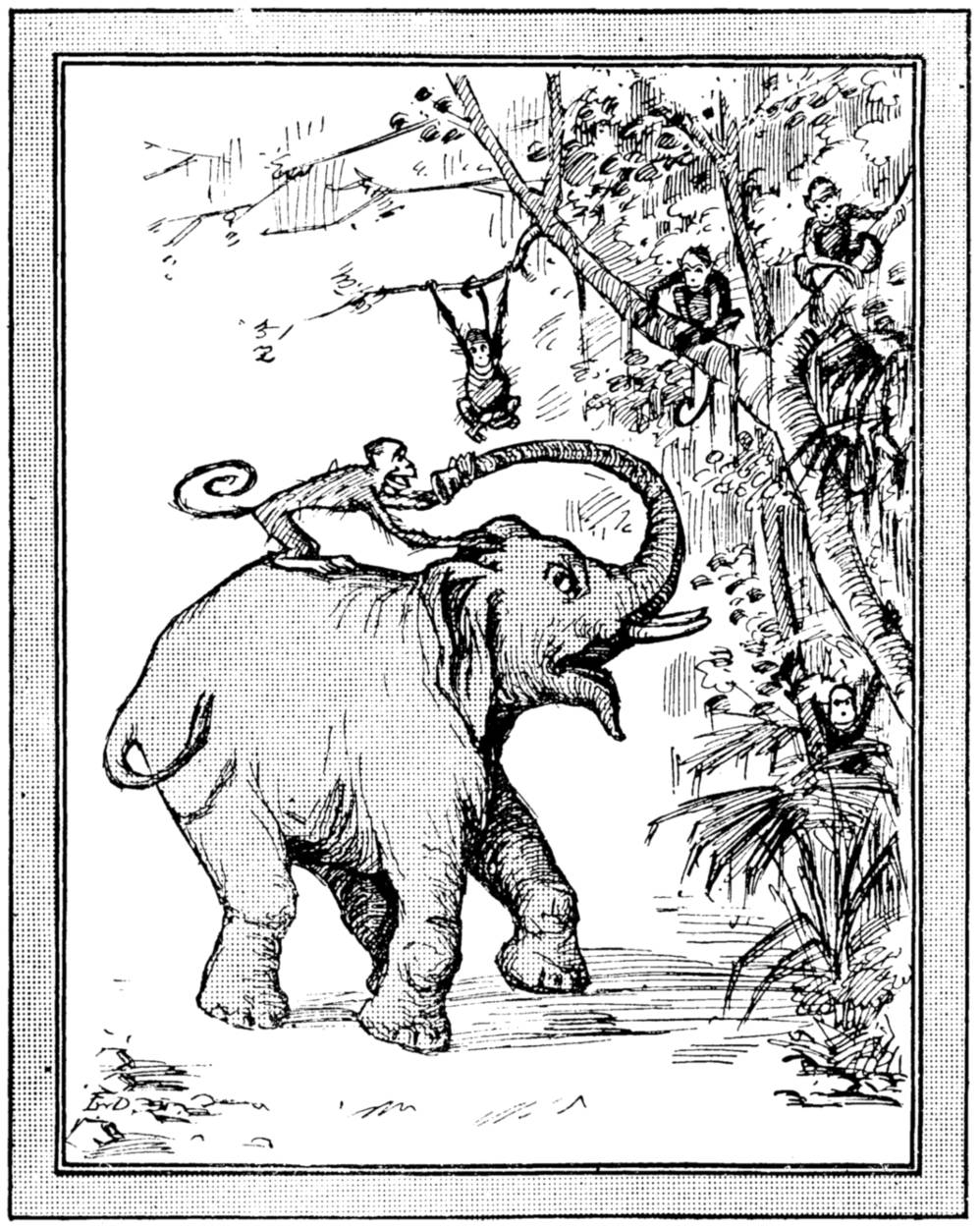
“Please, Mister Elephant, are you there?”
Return to description
[203]
No. IV.
It is said that there are 86 ways in which the numbers in this model magic square can be added up so that they make 34.
| 4 | 15 | 14 | 1 |
| 9 | 6 | 7 | 12 |
| 5 | 10 | 11 | 8 |
| 16 | 3 | 2 | 13 |
It is not difficult to discover more than half this number that are symmetrical, including, of course, the 4 rows, 4 columns and 2 diagonals. Here are a dozen samples, from which others can be seen—
| 4, | 1, | 16, | 13. |
| 15, | 14, | 3, | 2. |
| 14, | 12, | 5, | 3. |
| 6, | 7, | 10, | 11. |
| 15, | 8, | 9, | 2. |
| 1, | 6, | 11, | 16. |
| 14, | 8, | 9, | 3. |
| 9, | 15, | 2, | 8. |
| 4, | 5, | 12, | 13. |
| 4, | 5, | 11, | 14. |
| 4, | 9, | 8, | 13. |
| 9, | 14, | 3, | 8. |
Return to description
[204]
No. VIII
Here is the completed magic square—
| 216 | 175 | 224 | 183 | 232 | 191 | 240 | 199 | 248 |
| 247 | 215 | 174 | 223 | 182 | 231 | 190 | 239 | 207 |
| 206 | 246 | 214 | 173 | 222 | 181 | 230 | 198 | 238 |
| 237 | 205 | 245 | 213 | 172 | 221 | 189 | 229 | 197 |
| 196 | 236 | 204 | 244 | 212 | 180 | 220 | 188 | 228 |
| 227 | 195 | 235 | 203 | 252 | 211 | 179 | 219 | 187 |
| 186 | 226 | 194 | 243 | 202 | 251 | 210 | 178 | 218 |
| 217 | 185 | 234 | 193 | 242 | 201 | 250 | 209 | 177 |
| 176 | 225 | 184 | 233 | 192 | 241 | 200 | 249 | 208 |
Every row, column and diagonal adds up to exactly 1908.
Return to description
[205]
No. IX
This up-to-date magic square adds up to 1908 in quite 56 different symmetrical ways.
| 469 | 484 | 472 | 483 |
| 481 | 474 | 478 | 475 |
| 482 | 471 | 485 | 470 |
| 476 | 479 | 473 | 480 |
Here are 44 of them—
| Rows | 4 |
| Columns | 4 |
| Diagonals | 2 |
| The corners | 1 |
| Corners of squares of 9 cells | 4 |
| Squares of 4 cells | 9 |
| Opposite pairs of outside cells | 6 |
| Opposite pairs of short diagonals | |
| Such combinations as 469, 481, 485, 473 | 8 |
| Such combinations as 482, 484, 472, 470 | |
| Total | 44 |
There are a dozen other ways, more or less symmetrical, such as 481, 474, 483, 470; or 474, 485, 470, 479.
Return to description
[206]
No. X
This is the rearrangement of the domino magic square—
| ● | ● | ● | ● | |||||||||||||||
| ● | ● | ● | ● | ● | ||||||||||||||
| ● | ● | ● | ● | |||||||||||||||
| ● | ● | ● | ● | ● | ● | ● | ● | |||||||||||
| ● | ● | ● | ● | |||||||||||||||
| ● | ● | ● | ● | ● | ● | ● | ● | |||||||||||
| ● | ● | ● | ● | ● | ● | ● | ||||||||||||
| ● | ● | ● | ● | ● | ||||||||||||||
| ● | ● | ● | ● | ● | ● | ● | ||||||||||||
| ● | ● | ● | ● | ● | ● | |||||||||||||
| ● | ● | |||||||||||||||||
| ● | ● | ● | ● | ● | ● | |||||||||||||
| ● | ● | ● | ● | ● | ● | ● | ||||||||||||
| ● | ● | ● | ● | ● | ● | |||||||||||||
| ● | ● | ● | ● | ● | ● | ● | ||||||||||||
| ● | ● | ● | ● | ● | ||||||||||||||
| ● | ● | ● | ||||||||||||||||
| ● | ● | ● | ● | ● | ||||||||||||||
| ● | ● | ● | ● | ● | ||||||||||||||
| ● | ● | |||||||||||||||||
| ● | ● | ● | ● | ● | ||||||||||||||
| ● | ● | ● | ● | ● | ● | ● | ● | |||||||||||
| ● | ● | ● | ● | ● | ||||||||||||||
| ● | ● | ● | ● | ● | ● | ● | ● | |||||||||||
| ● | ● | ● | ● | ● | ● | |||||||||||||
| ● | ● | |||||||||||||||||
| ● | ● | ● | ● | ● | ● | |||||||||||||
| ● | ● | ● | ● | ● | ● | ● | ● | |||||||||||
| ● | ● | ● | ||||||||||||||||
| ● | ● | ● | ● | ● | ● | ● | ● | |||||||||||
The three-ace, which was a corner stone in the former diagram now occupies the centre, and the rearrangement was effected by first transferring the two bottom rows to the top, and then the fourth and fifth columns to the extreme left. This method of shifting the stones does not affect the magic quality of the square.
Return to description
[207]
No. XI
The affinity between chess and numbers is well illustrated by the Knight’s tour on this diagram—
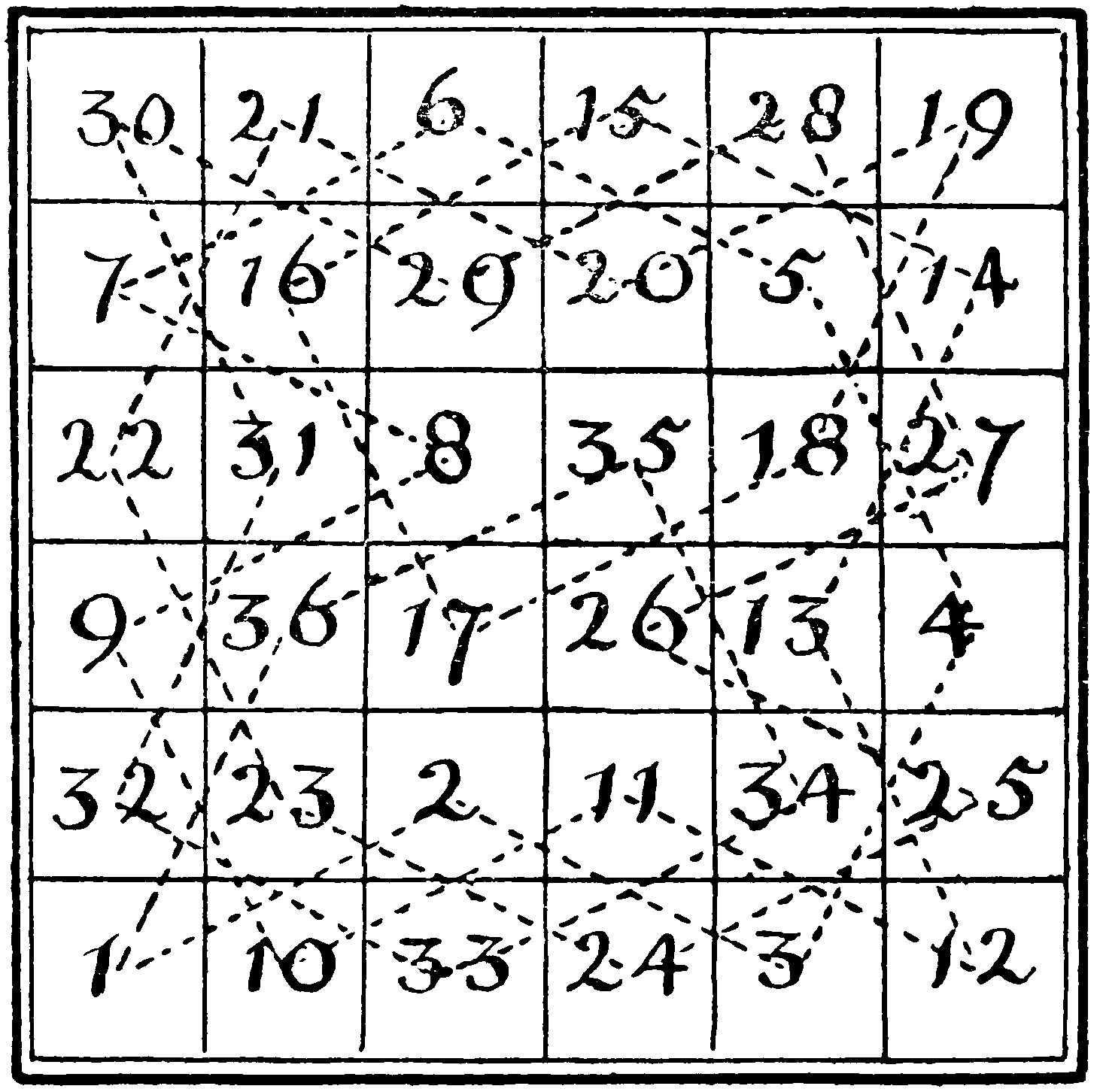
The Knight starts from the square marked 1, and returns at last to it. The constant difference between any opposite and corresponding numbers in cells that are equidistant from the centre is 18.
Return to description
[208]
No. XII
Here are the cells in the diagram of our Numbers Patience, so filled in that each of the rows across from side to side adds up exactly to 143.
| 17 | 30 | 41 | 31 | 24 |
| 18 | 32 | 13 | 46 | 34 |
| 11 | 12 | 14 | 50 | 56 |
| 51 | 19 | 42 | 16 | 15 |
| 22 | 21 | 35 | 45 | 20 |
Each cell contains, in accordance with the conditions, a different number.
Return to description
[209]
No. XIII
This is the division of a square into fifteen parts, which will form the windmill:—
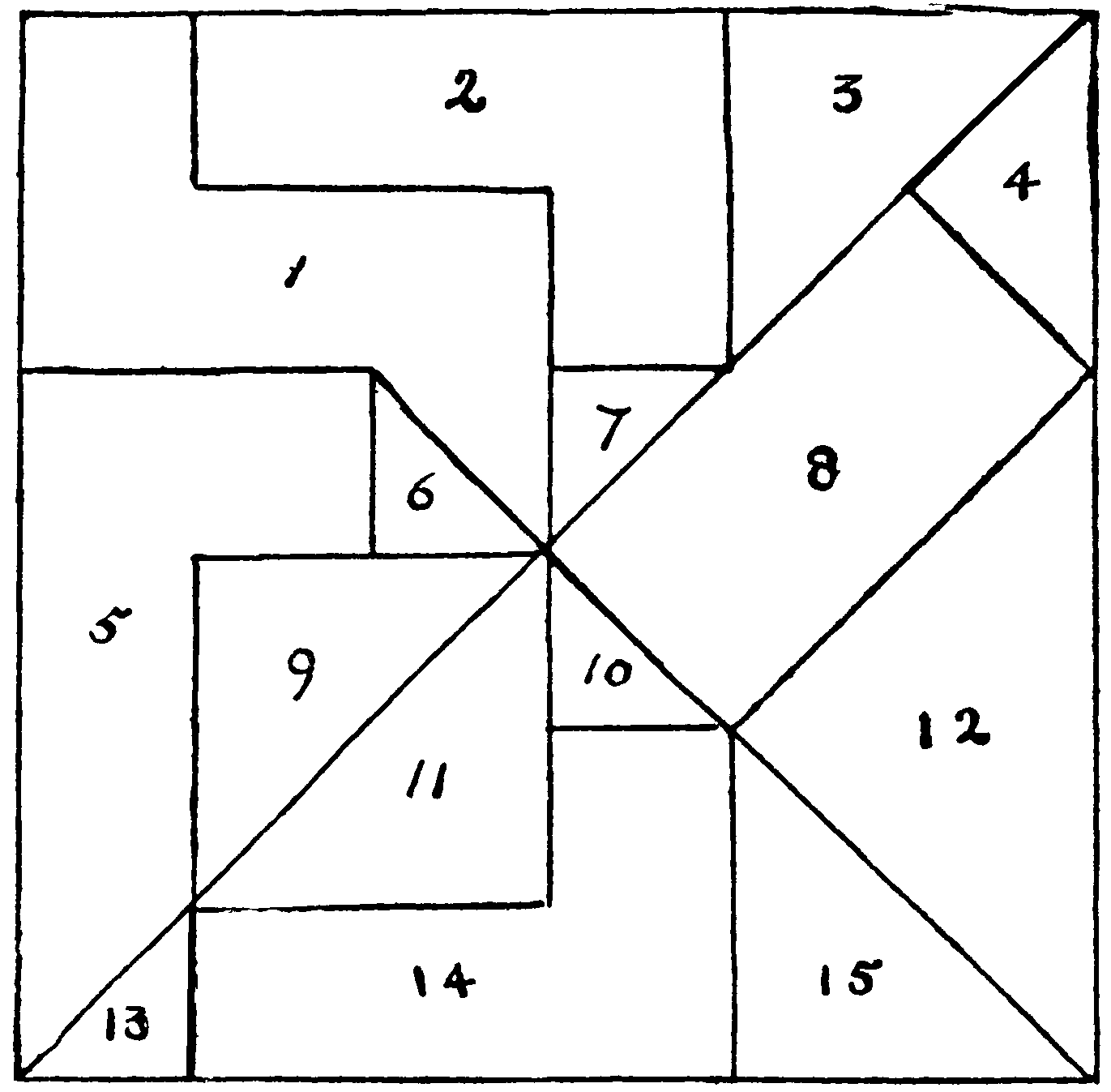
This puzzle may, of course, be reversed, the parts of the square being given, and the solver asked to form with them a symmetrical windmill.
Return to description
[210]
No. XIV
In this nest of 49 squares it is possible to count 784 distinct interlacing figures, whose opposite sides are equal, and whose angles are all right angles.
Of these 784 rectangles 140 are squares.
Return to description
[211]
No. XV
This is the domino magic square, in which all the stones are used except double-six, double-five and six-five.
| ● | ● | ● | ||||||||||||||||
| ● | ● | ● | ||||||||||||||||
| ● | ● | ● | ||||||||||||||||
| ● | ● | ● | ● | ● | ● | ● | ||||||||||||
| ● | ● | ● | ● | |||||||||||||||
| ● | ● | ● | ● | ● | ● | ● | ||||||||||||
| ● | ● | ● | ||||||||||||||||
| ● | ● | ● | ● | |||||||||||||||
| ● | ● | ● | ||||||||||||||||
| ● | ● | ● | ● | ● | ● | ● | ||||||||||||
| ● | ● | ● | ||||||||||||||||
| ● | ● | ● | ● | ● | ● | ● | ||||||||||||
| ● | ● | ● | ● | ● | ||||||||||||||
| ● | ● | |||||||||||||||||
| ● | ● | ● | ● | ● | ||||||||||||||
| ● | ● | ● | ● | ● | ● | |||||||||||||
| ● | ● | ● | ||||||||||||||||
| ● | ● | ● | ● | ● | ● | |||||||||||||
| ● | ● | ● | ● | |||||||||||||||
| ● | ● | ● | ● | |||||||||||||||
| ● | ● | ● | ● | |||||||||||||||
| ● | ● | ● | ● | ● | ||||||||||||||
| ● | ● | ● | ● | ● | ||||||||||||||
| ● | ● | ● | ● | ● | ||||||||||||||
| ● | ● | ● | ● | ● | ||||||||||||||
| ● | ||||||||||||||||||
| ● | ● | ● | ● | ● | ||||||||||||||
| ● | ● | ● | ● | ● | ● | ● | ||||||||||||
| ● | ● | |||||||||||||||||
| ● | ● | ● | ● | ● | ● | ● | ||||||||||||
All rows, columns and diagonals add up to 27, as do the stones in the four corner cells and the four central border cells of the full square, and of the square of nine cells in the middle.
Return to description
[212]
No. XVI
Those to whom games of Patience appeal will find an interesting and pretty form of it in the construction of a pyramid with a complete set of dominoes.
| ● | ● | ||||||||||||||||||||||||||||||||||||||||
| ● | ● | ||||||||||||||||||||||||||||||||||||||||
| ● | ● | ||||||||||||||||||||||||||||||||||||||||
| ● | ● | ● | ● | ||||||||||||||||||||||||||||||||||||||
| ● | ● | ● | ● | ||||||||||||||||||||||||||||||||||||||
| ● | ● | ● | ● | ||||||||||||||||||||||||||||||||||||||
| ● | ● | ● | ● | ● | ● | ● | ● | ||||||||||||||||||||||||||||||||||
| ● | ● | ||||||||||||||||||||||||||||||||||||||||
| ● | ● | ● | ● | ● | ● | ● | ● | ||||||||||||||||||||||||||||||||||
| ● | ● | ● | ● | ● | ● | ● | ● | ● | ● | ||||||||||||||||||||||||||||||||
| ● | ● | ● | ● | ||||||||||||||||||||||||||||||||||||||
| ● | ● | ● | ● | ● | ● | ● | ● | ● | ● | ||||||||||||||||||||||||||||||||
| ● | ● | ● | ● | ● | ● | ● | ● | ● | ● | ● | ● | ● | ● | ||||||||||||||||||||||||||||
| ● | ● | ||||||||||||||||||||||||||||||||||||||||
| ● | ● | ● | ● | ● | ● | ● | ● | ● | ● | ● | ● | ● | ● | ||||||||||||||||||||||||||||
| ● | ● | ● | ● | ● | ● | ● | ● | ● | ● | ● | ● | ● | ● | ● | ● | ||||||||||||||||||||||||||
| ● | ● | ● | ● | ||||||||||||||||||||||||||||||||||||||
| ● | ● | ● | ● | ● | ● | ● | ● | ● | ● | ● | ● | ● | ● | ● | ● | ||||||||||||||||||||||||||
| ● | ● | ● | ● | ● | ● | ● | ● | ● | ● | ● | ● | ● | ● | ● | ● | ● | ● | ||||||||||||||||||||||||
| ● | ● | ● | ● | ● | |||||||||||||||||||||||||||||||||||||
| ● | ● | ● | ● | ● | ● | ● | ● | ● | ● | ● | ● | ● | ● | ● | ● | ● | ● | ||||||||||||||||||||||||
Solvers may like to study the position given, which is one of many that are possible, and to discover for themselves the ruling conditions which are its characteristics.
Return to description
[213]
No. XVII
When the boy’s father came up just in time to stop him from breaking out of bounds, and said, “Never throw a leg, lad,”
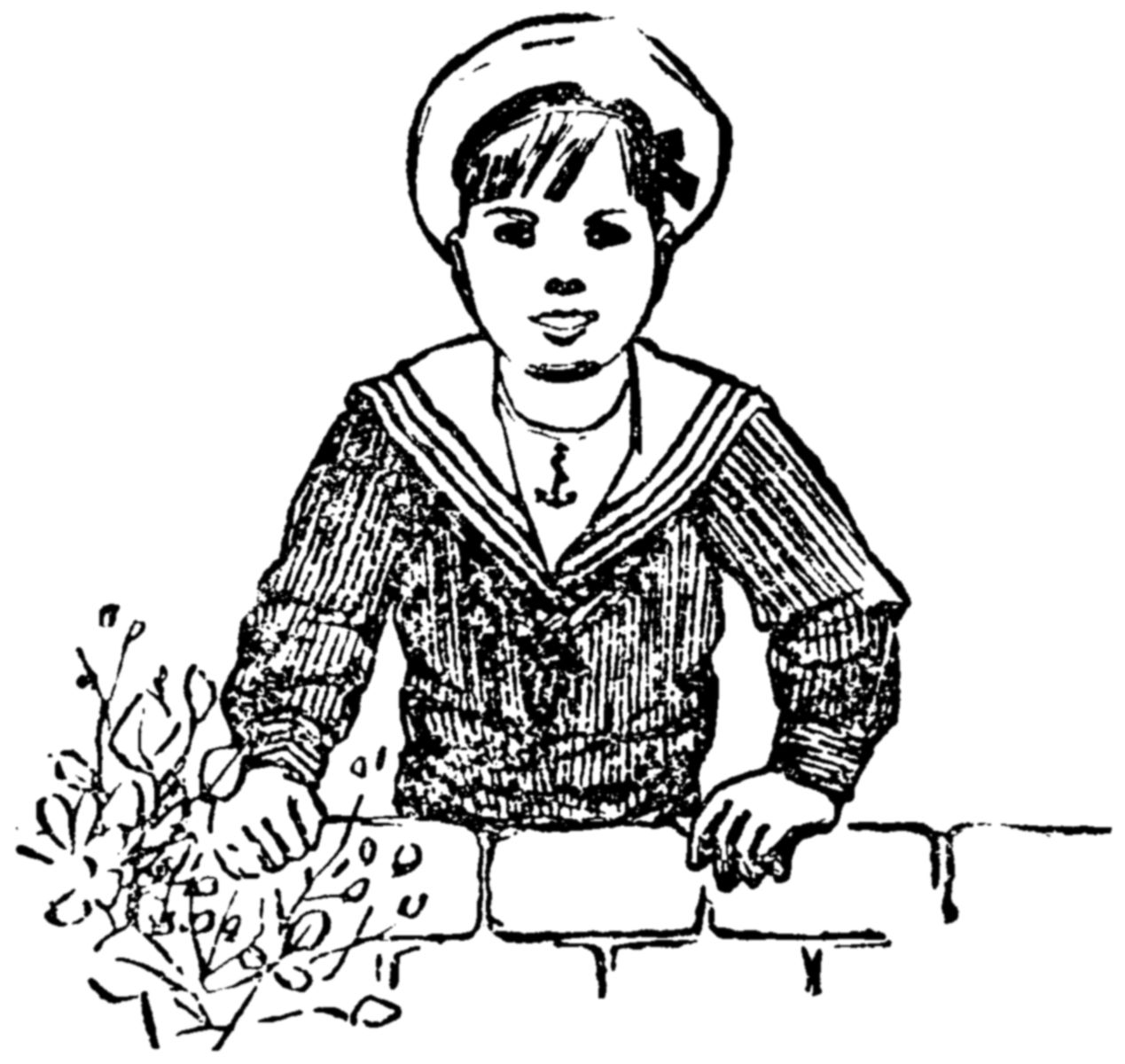
the rest of the sentence, spelt with exactly the same letters, was “over the garden wall!”
Return to description
[214]
No. XVIII
“Catastrophe,” the title of the tragedy foreshadowed, can be recast into “A cat! stop her!” By similar process the words, “New parrot stand in a house,” become “He turns on a soda-water tap!”
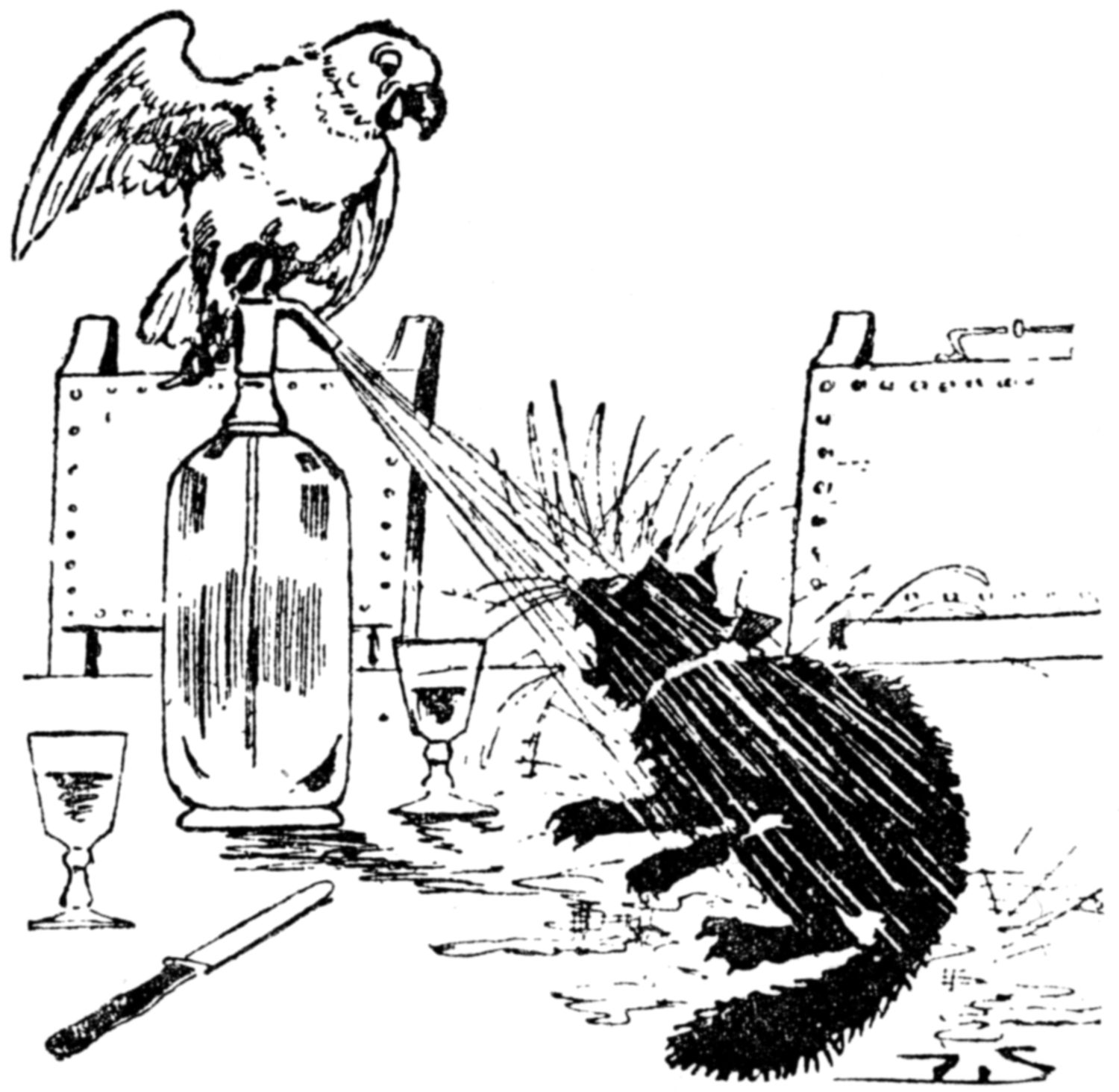
The parrot’s ready resource and triumph is depicted here with striking effect.
Return to description
[215]
No. XIX
When the judge at a baby show said to the mother of the small boy whose thumb was in his mouth, “Your lad Tommy likes such tit-bits,” the precocious child replied, as he removed his comforting hand, in a sentence spelt with exactly the same letters, “So to-day, sir, I suck my little thumb.”
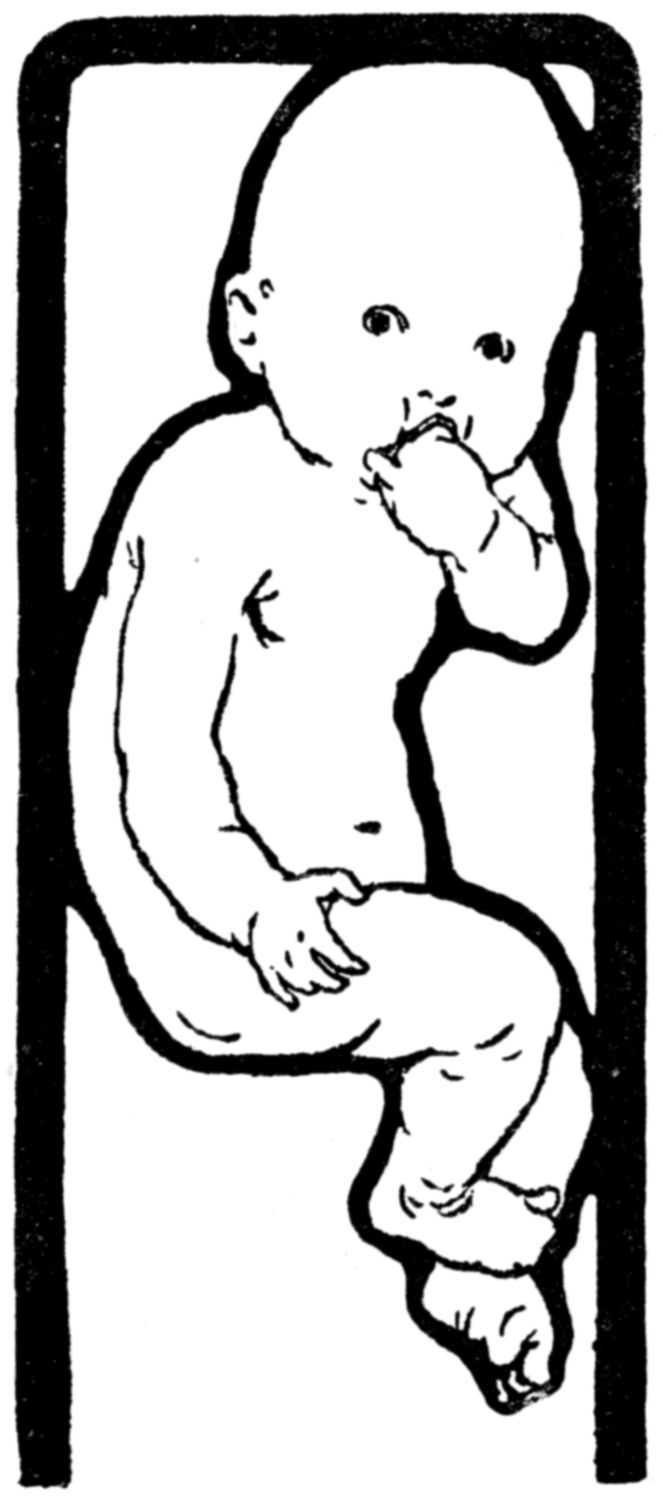
Return to description
[216]
No. XX
When the lady sitting at the back of this overloaded wagonette said to her husband, “This big load quite hinders his pull,” in her sympathy with the struggling horse,
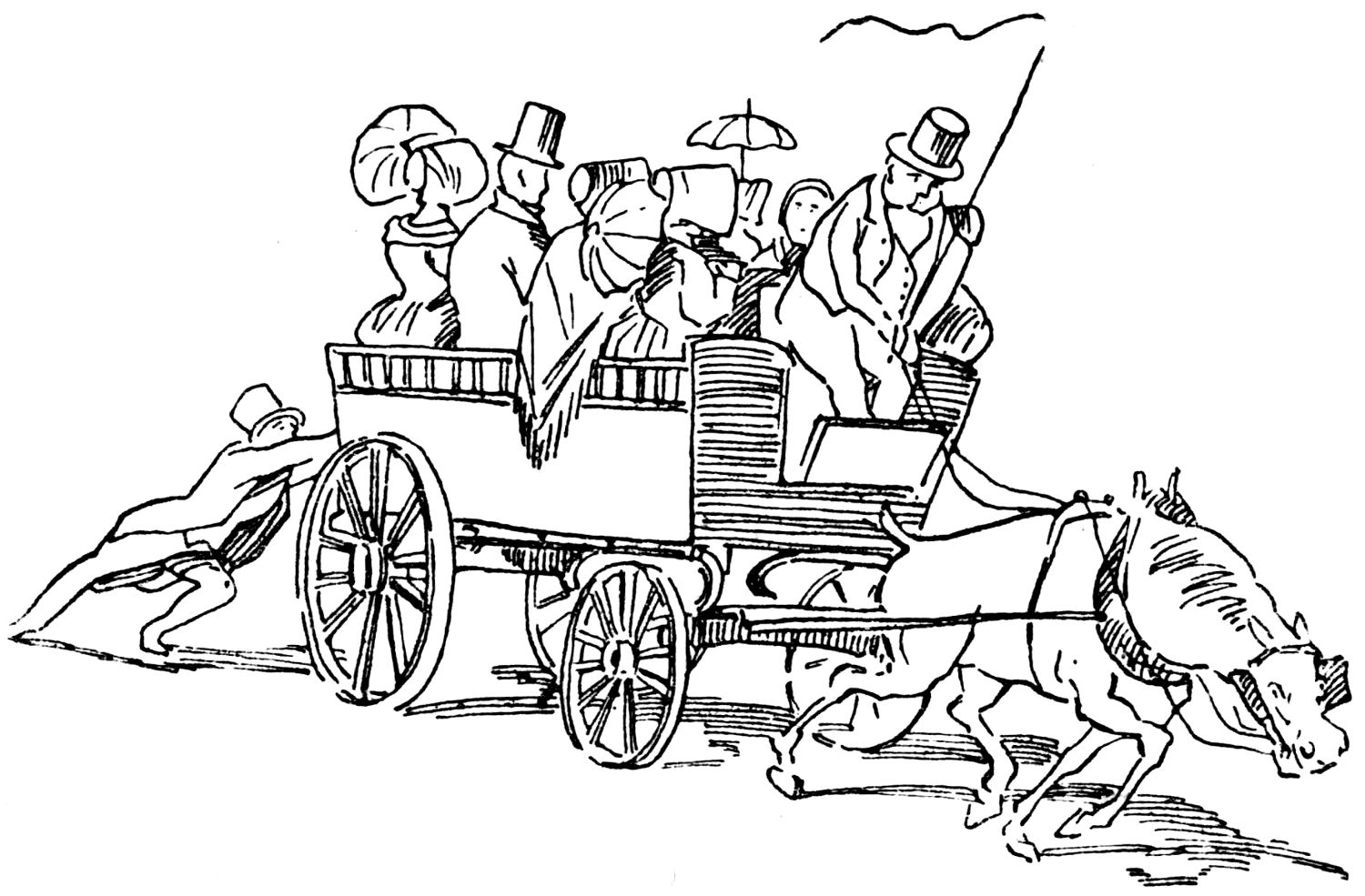
he made this very practical reply, in a sentence spelt with exactly the same letters: “Do sit quiet, girl; I shall push behind!”
Return to description
[217]
No. XXI
When a bystander whispered to the marker, “Eh! what a stout player is striking!”
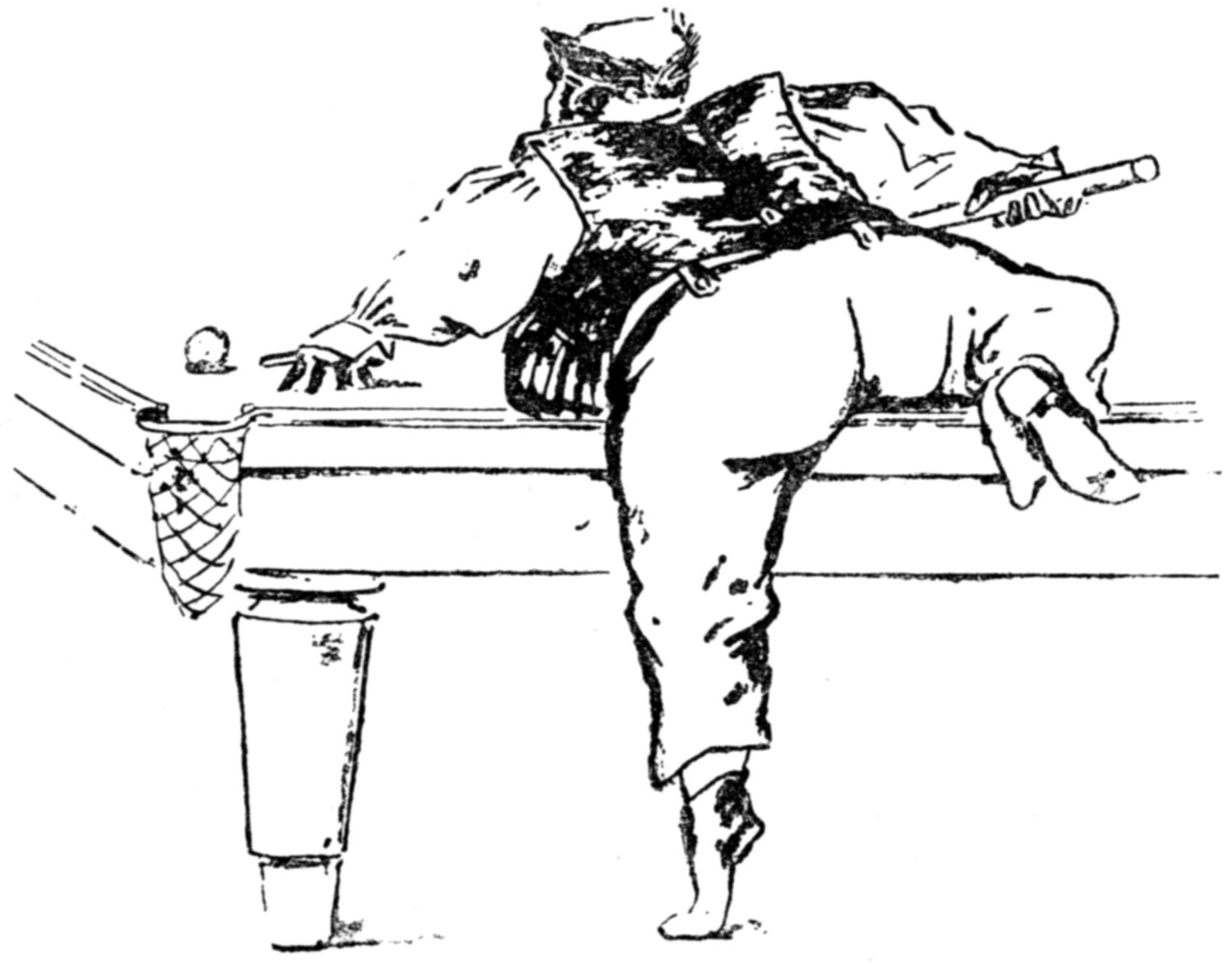
an appropriate reply, spelt with exactly the same letters, would have been: “He plays without taking a rest, sir.”
Return to description
No. XXII
The two English words appropriate to this picture—
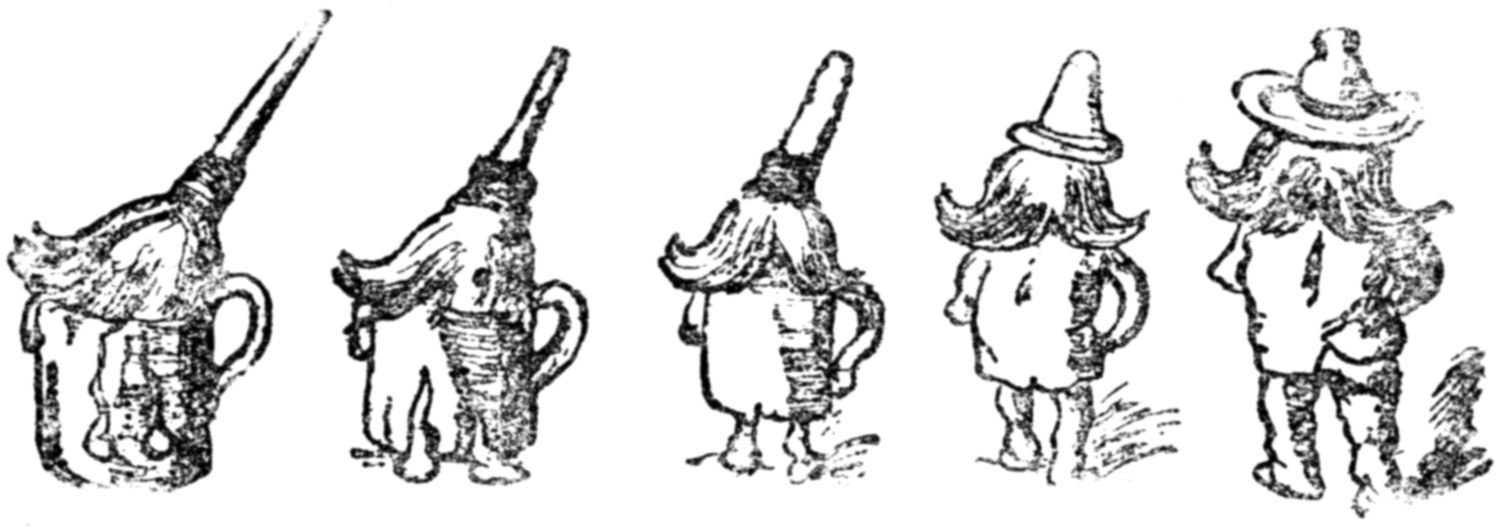
which have as their anagrams “Or not a man first,” and “O I love nuts!” are Transformation and Evolutions.
Return to description
[218]
No. XXIII
This is a fancy portrait of William—
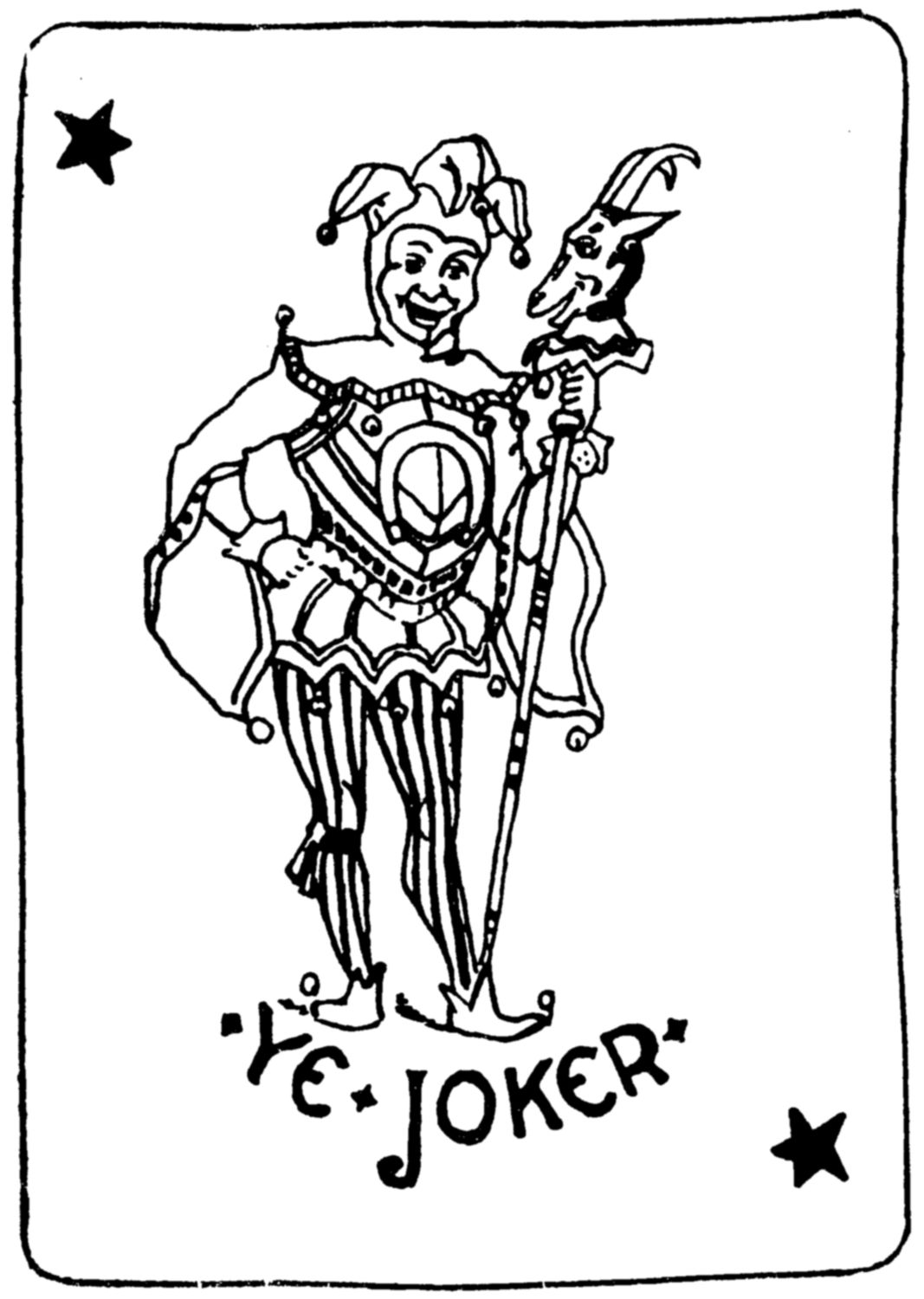
We decide by anagram whether this is William or dear Jack, for these words, when recast, spell “I am Will, a card joker!”
Return to description
[219]
No. XXIV
The word indicated by this picture in combination with the lines below it—
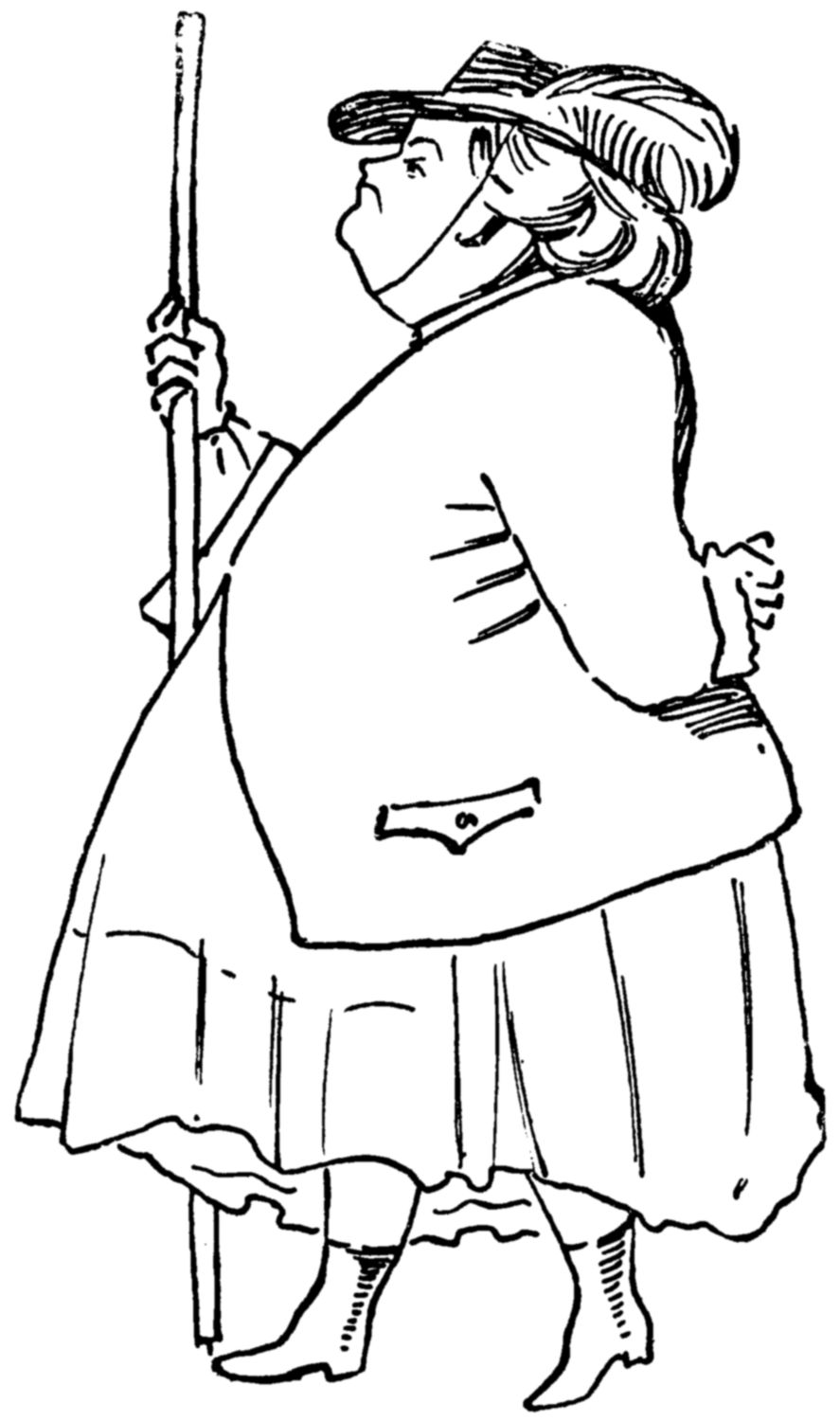
And then you will find out the rest;
For it all will appeal to your thirst,
Or point to a ponderous guest.
is Stout.
Return to description
[220]
No. XXV
The words of Jigger’s wife, when she said that he seemed to be in a “sad pet,” were true by anagram.
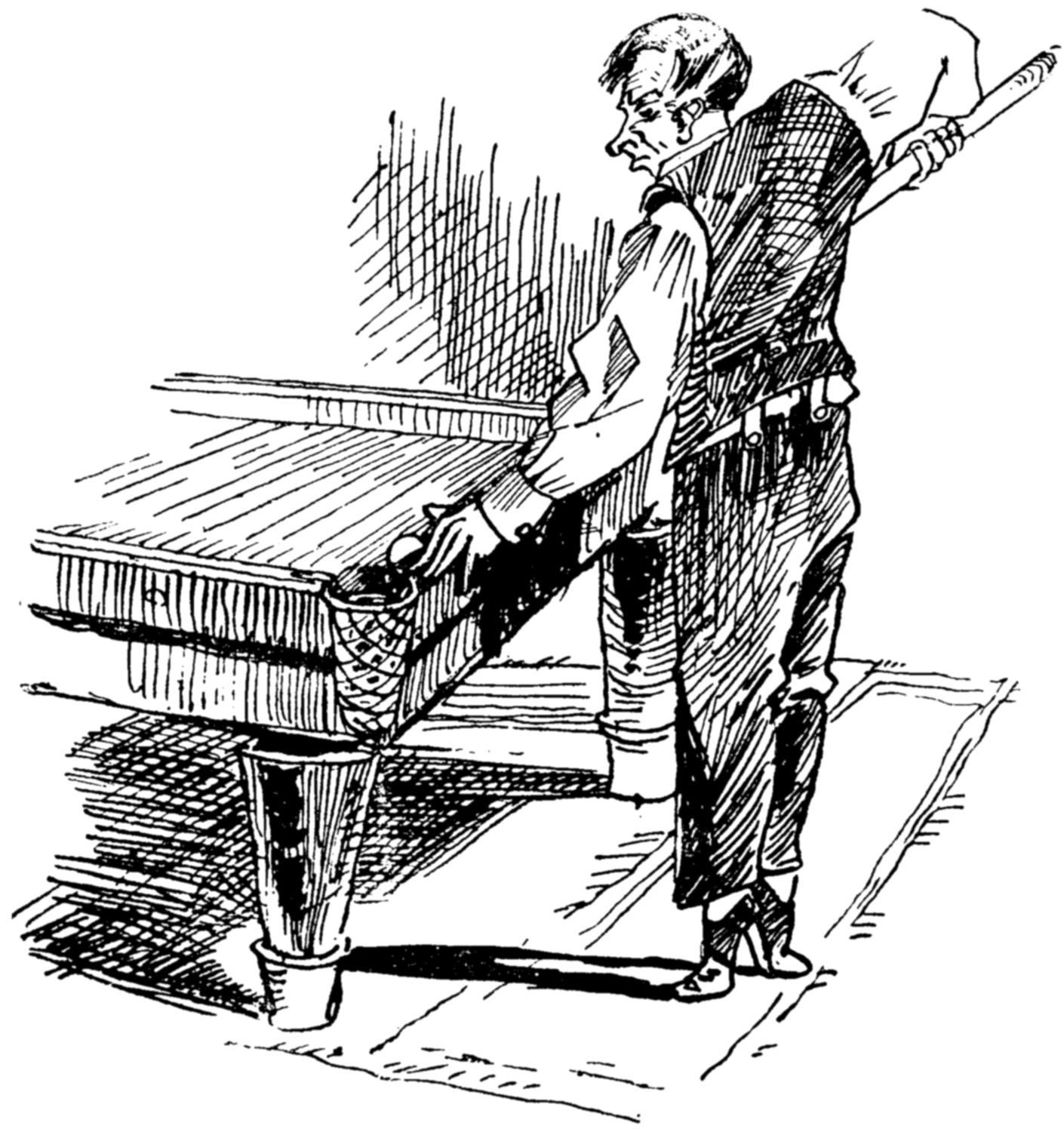
His ball hugs the cushion so closely as to be completely pasted.
Return to description
[221]
No. XXVI
When, as they held on to the fractious cow, the farmer exclaimed, “See, we hold this cow’s horns and tail,”
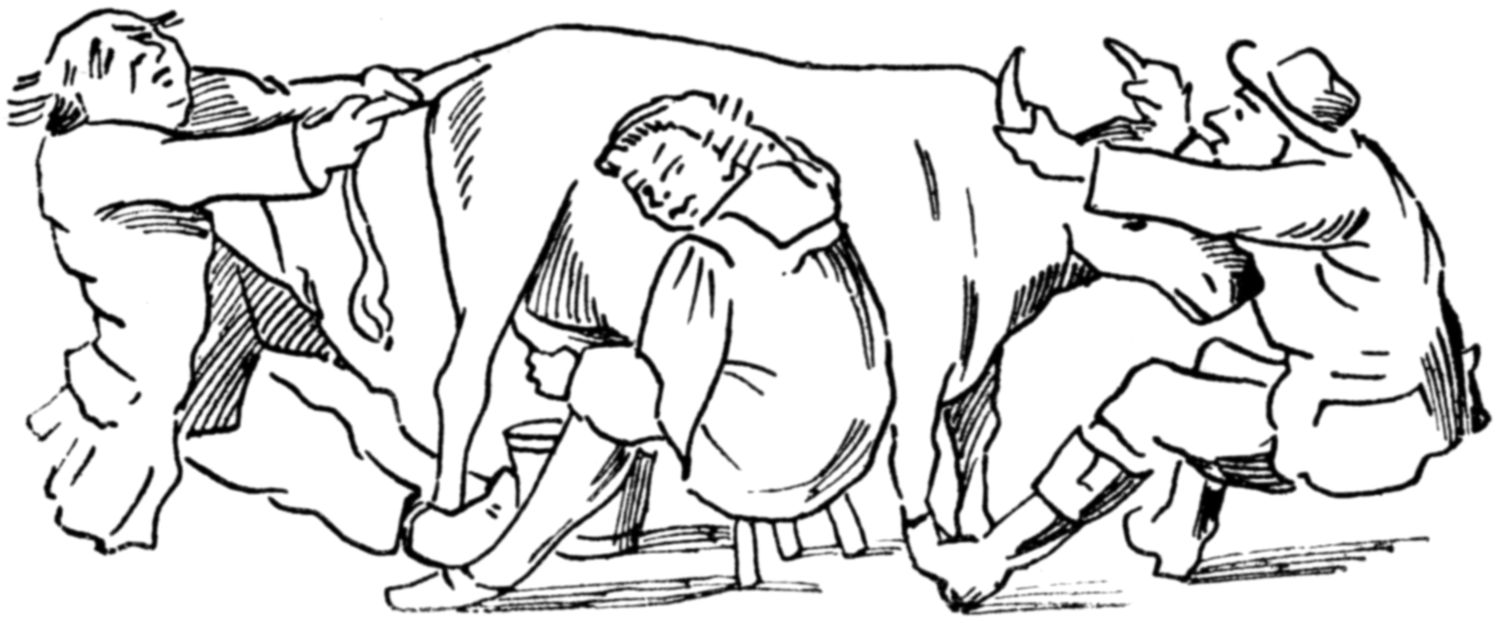
his foreman, using exactly the same letters in his sentence, said—
“She cannot toss, her wild head is low.”
Return to description
[222]
No. XXVII
While the horse shown in this picture might be saying, if it could speak, “I’m a train’d stepper!”—
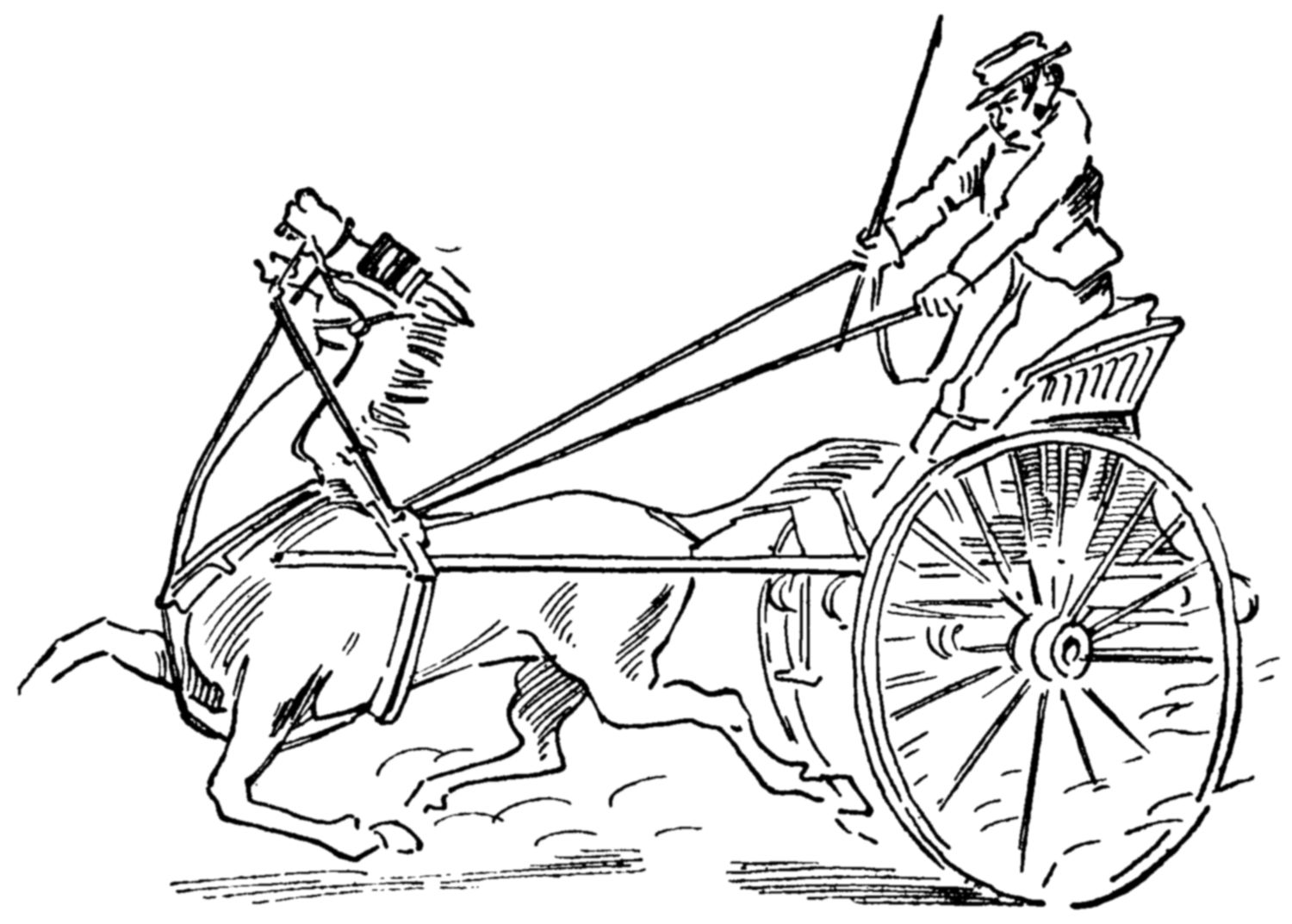
the driver, from his point of view, might say, as he held him in check, “Spirit and a temper!” making use in his words of exactly the same letters.
Return to description
[223]
No. XXVIII
When one onlooker, seeing the artist working with his feet, said—
“Why, now I see this fine artist has no hand!”
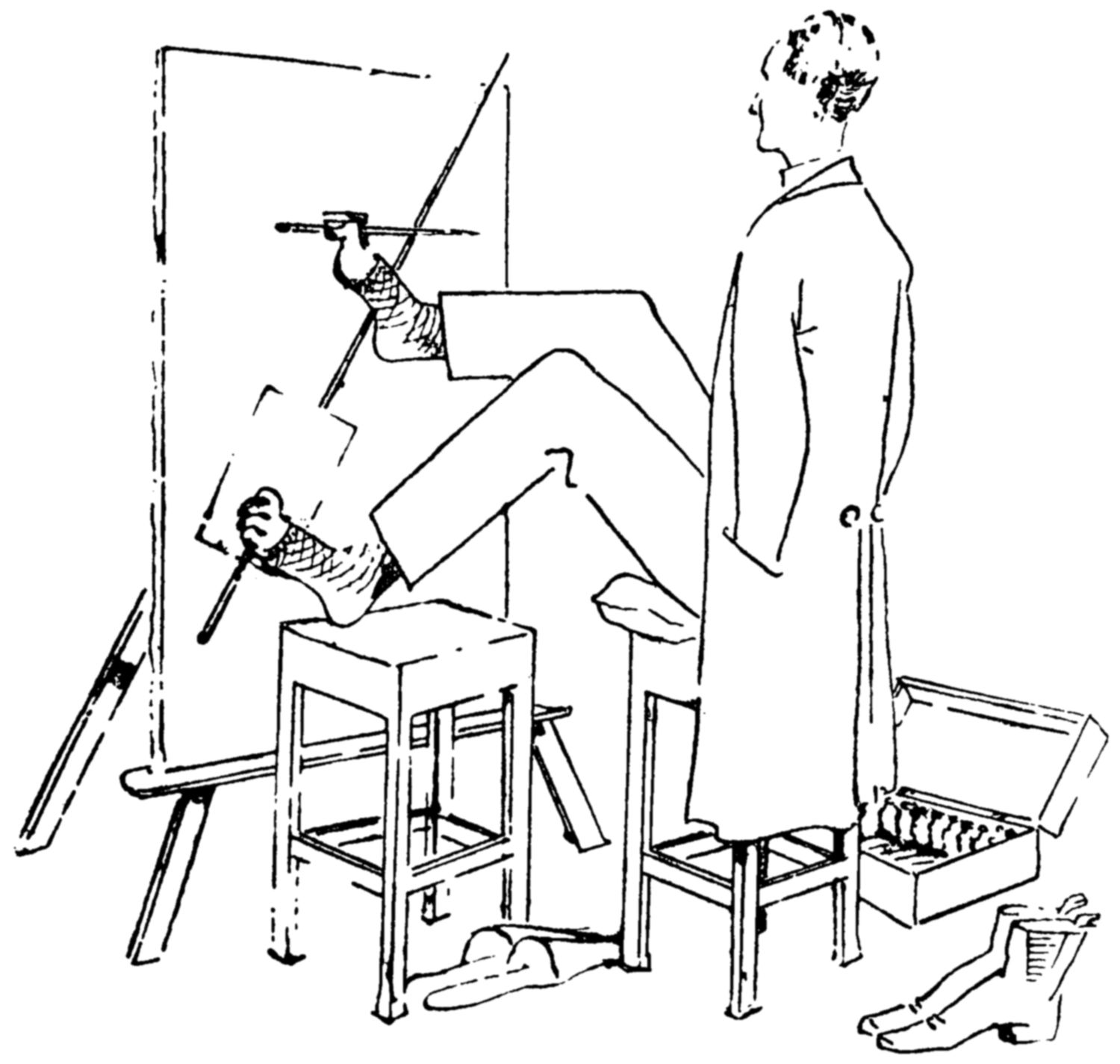
the other replied, using exactly the same letters,
“He draws in any fashion with his ten toes!”
Return to description
[224]
No. XXIX
When her husband, showing this picture
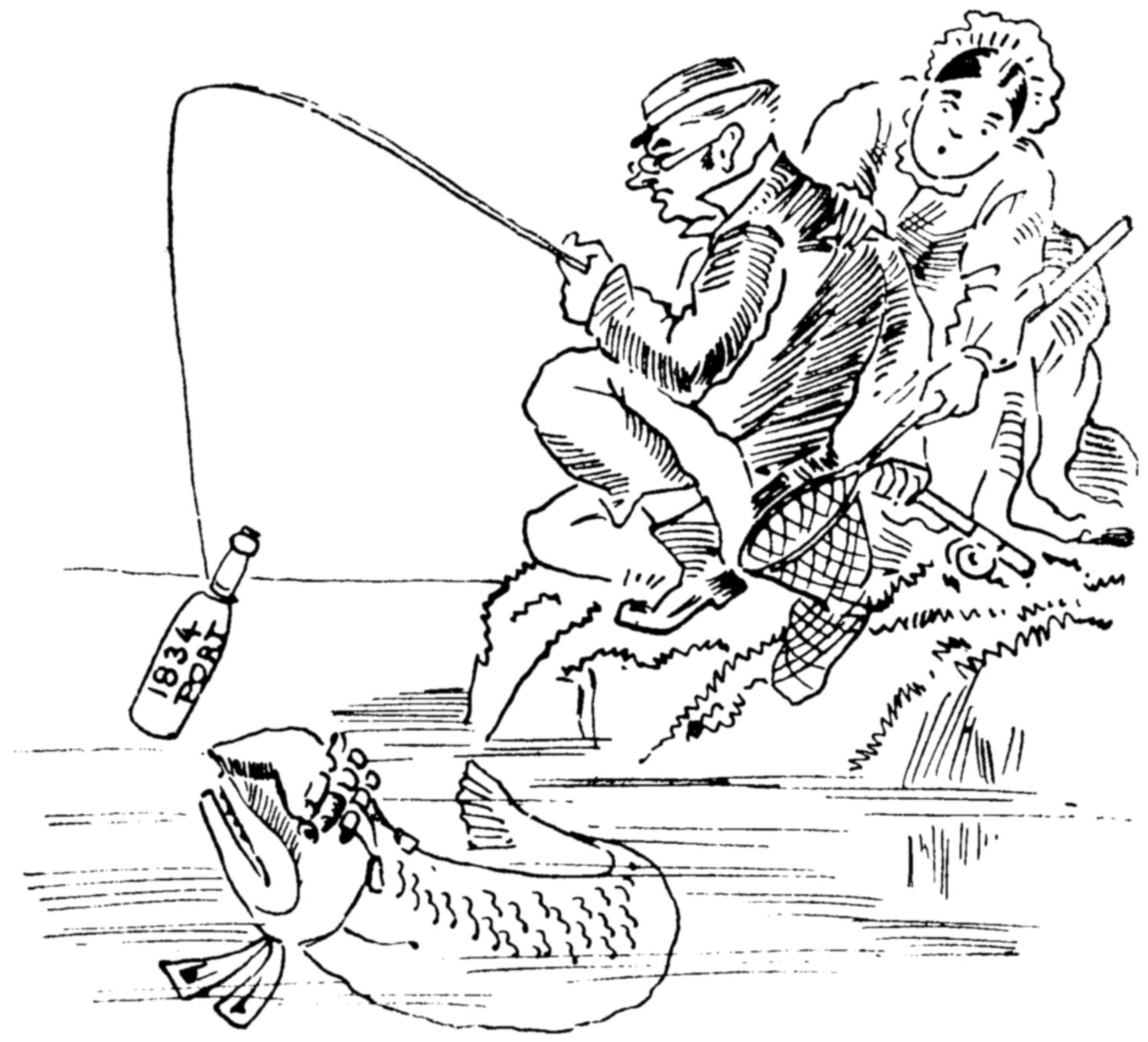
said to his wife, “This is a wine bottle, dear, on a lure,” she, knowing that temptation in this form would fail, said, as she glanced at his illustration of their aims, in words spelt with exactly the same letters:—
“And see, he will not rise at our bait!”
Return to description
[225]
No. XXX
The sturdy musician, who had said, “What shall I play?” to which some one replied, “Any strains of Beethoven, he charms all!” as this was not an acceptable suggestion, struck up a piece after his own heart.
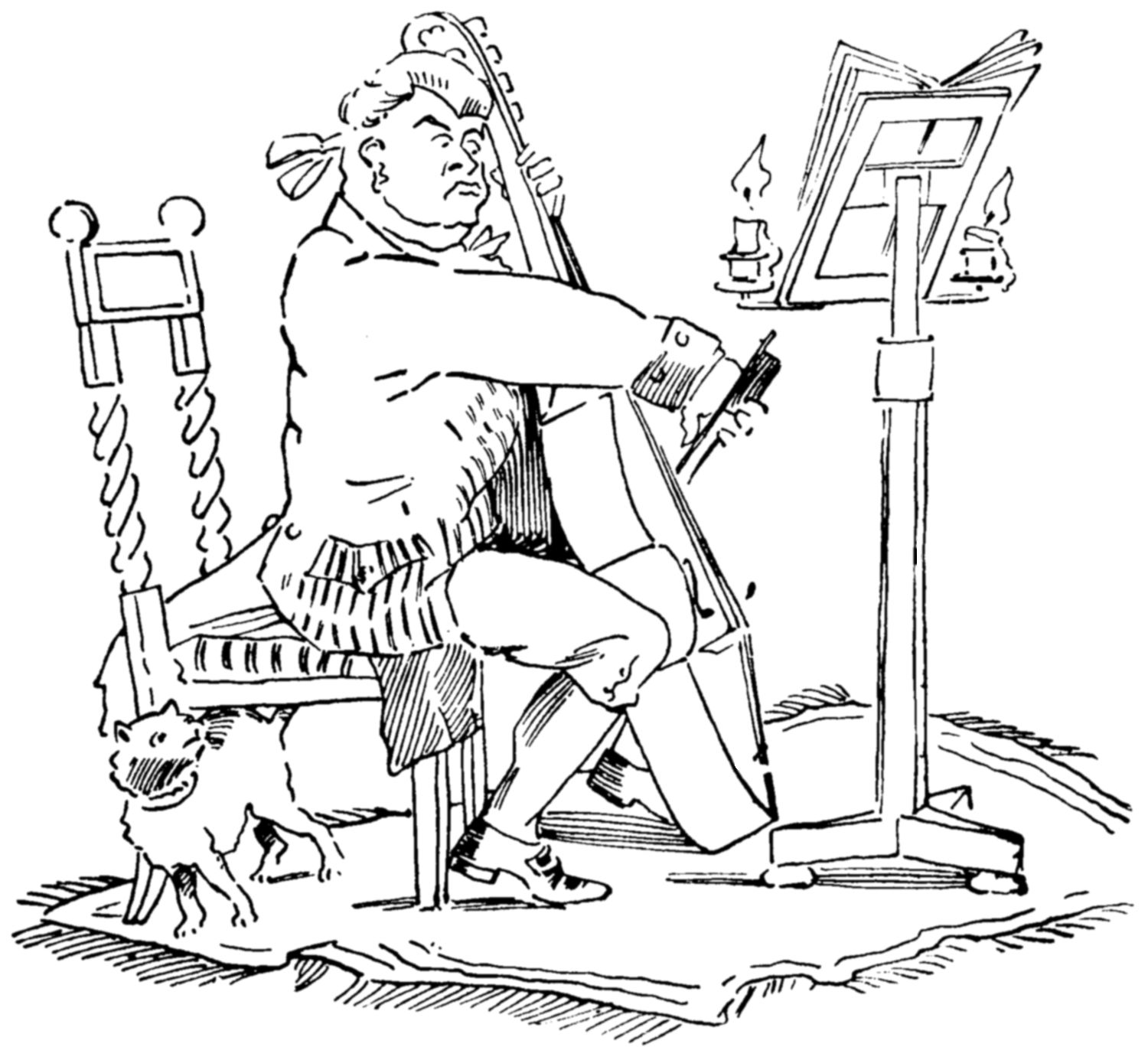
He said, as he struck the strings, in a sentence composed of exactly the same letters—“Nay, for this ’cello heaven sent a Brahms!”
Return to description
[226]
No. XXXI
Here is the picture of a parsnip lying across a swede readjusted and reversed.
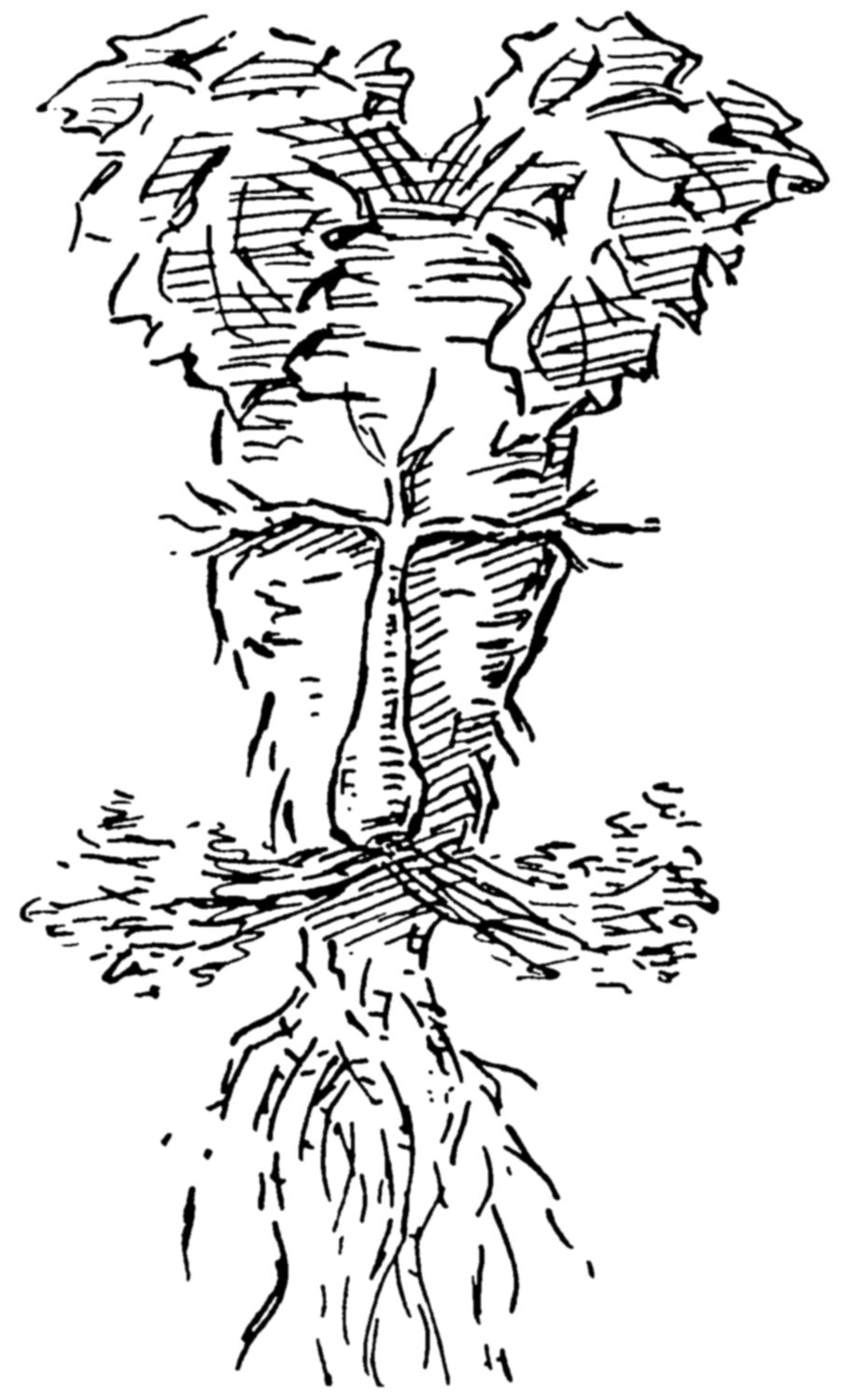
We gave as a clue the anagram—
“Here is our parsnip on swede.”
ANAGRAM
Wise and superior person he!
but this is now hardly needed to show who is thus represented in friendly caricature: (With apologies to G. B. S.)
Return to description
[227]
No. XXXII
The letter puzzle is solved thus—
| L | E | V | E | L |
| E | E | E | E | |
| V | V | V | ||
| E | E | E | E | |
| L | E | V | E | L |
Within this square the word LEVEL runs in twelve different directions, being itself a palindrome.
Return to description
[228]
No. XXXIII
The sentence formed with the ten letters above the line, which is the key to this sum, is Do your best. If these letters are numbered consecutively 1, 2, 3, 4, 5, 6, 7, 8, 9, 0, and the corresponding figures are substituted for the letters, the sum works out as is shown in the second diagram—
| S | B | 9 | 7 | |||
| R | E | 6 | 8 | |||
| Y | D | 3 | 1 | |||
| O | T | 4 | 0 | |||
| U | O | 5 | 2 | |||
| O | E | E | 2 | 8 | 8 |
Return to description
[229]
No. XXXIV
The twelve names of flowers and foliage that may be gathered within these borders, by moving in any direction one square at a time,
| 1L | 2L | 3B | 4H | 5P | 6E | 7F |
| 8L | 9Y | 10E | 11L | 12O | 13R | 14N |
| 15I | 16V | 17B | 18R | 19I | 20V | 21K |
| 22A | 23L | 24E | 25T | 26O | 27N | 28I |
| 29C | 30N | 31A | 32S | 33U | 34L | 35P |
are 18, 26, 32, 24, Rose; 25, 33, 34, 28, 35, Tulip; 35, 28, 27, 21, Pink; 31, 32, 25, 24, 18, Aster; and, in similar ways, Verbena; Salvia; Ivy; Lily; Lilac; Heliotrope; Fern; and Bell.
Return to description
No. XXXV
The solution of this little problem, set by Dr Puzzlewitz on his blackboard to test the powers of his young pupils—“What are the values of A and B, when 4 is the result of dividing A by B, or of subtracting B from A?”—
| A | - | B | = | 4 | ||
| A | ÷ | B | = | 4 | ||
is that A = 51⁄3 and B = 11⁄3.
Return to description
[230]
No. XXXVI
This is the diamond squared:—
| s | ||||||
| h | i | s | ||||
| h | i | n | t | s | ||
| s | i | n | u | o | u | s |
| s | t | o | r | m | ||
| s | u | m | ||||
| s | ||||||
in which the words read alike from top to bottom, and from left to right.
Return to description
[231]
No. XXXVII
This is the arrangement of the 32 letters in the 64 cells—
| A | E | I | O | ||||
| E | O | A | I | ||||
| A | I | E | O | ||||
| I | O | A | E | ||||
| O | I | E | A | ||||
| E | O | A | I | ||||
| A | I | E | O | ||||
| E | A | O | I |
No A is in the same column, row, or diagonal with another A, no E with another E, no I with another I, and no O with another O.
Return to description
[232]
No. XXXVIII
This is the anagram square, with the letters, which in the former diagram spelt the words vote, wove, prow, call, stew, news, core, nape, recast into fresh words which now read alike from top to bottom and from left to right of the square.
| C | R | O | W | ||||
| C | L | A | W | ||||
| L | O | V | E | ||||
| R | O | P | E | ||||
| A | P | E | S | ||||
| O | V | E | N | ||||
| W | E | N | T | ||||
| W | E | S | T |
The empty squares and diagonal setting are necessary for this particular puzzle, as the words would not form a word square if their letters were placed below one another in the usual way.
Return to description
[233]
No. XXXIX
The sentence formed with the ten letters above the line, which is the key to this sum, is—Add these up. If these letters are numbered consecutively 1, 2, 3, 4, 5, 6, 7, 8, 9, 0, and the corresponding figures are substituted for the numbers, the sum works out as is shown below.
| D | U | 2 | 9 | |||
| E | H | 6 | 5 | |||
| E | D | 8 | 3 | |||
| A | P | 1 | 0 | |||
| S | T | 7 | 4 | |||
| D | E | A | 2 | 6 | 1 |
Return to description
[234]
No. XL
The four words, seek, slab, leek, moan, which were placed on the white squares when recast form the following combination:—
| M | A | S | K | ||||
| A | B | L | E | ||||
| S | L | O | E | ||||
| K | E | E | N |
These fresh words read alike from side to side, and zigzag from top to bottom.
Return to description
[235]
No. XLI
These are the four words, recast by anagram from afar, task, seat, leal, and which now form a perfect word square.
| F | A | S | T |
| A | R | E | A |
| S | E | A | L |
| T | A | L | K |
Return to description
[236]
No. XLII
The word square is recast thus—
| c | r | e | s | s |
| r | e | a | c | h |
| e | a | g | e | r |
| s | c | e | n | e |
| s | h | r | e | d |
Its words are spelt with the same letters as the words chess, greed, canes, rears, cheer, which formed the original square, but did not read alike from top to bottom, and from left to right, as these do.
Return to description
[237]
No. XLIII
The five familiar proverbs hidden in this square of 169 letters are: A rolling stone gathers no moss. Too many cooks spoil the broth. A live dog is more to be feared than a dead lion. You cannot eat your cake and have it. Peace hath her victories no less renowned than war.
| R | E | N | O | W | N | E | D | T | H | A | N | W |
| S | Y | O | U | R | C | A | K | E | A | N | D | A |
| S | T | E | T | O | B | E | F | E | A | R | H | R |
| E | A | R | K | S | S | P | O | I | L | E | A | F |
| L | E | O | O | H | E | R | S | N | T | D | V | O |
| O | T | M | O | T | L | I | N | O | H | T | E | U |
| N | O | S | C | A | L | A | G | M | E | H | I | R |
| S | N | I | Y | G | O | R | S | O | B | A | T | S |
| E | N | G | N | E | N | O | T | S | R | N | P | A |
| I | A | O | A | M | O | O | T | S | O | A | E | W |
| R | C | D | E | V | I | L | A | H | T | D | A | S |
| O | U | O | Y | N | O | I | L | D | A | E | C | A |
| T | C | I | V | R | E | H | H | T | A | H | E | Z |
Return to description
[238]
No. XLIV
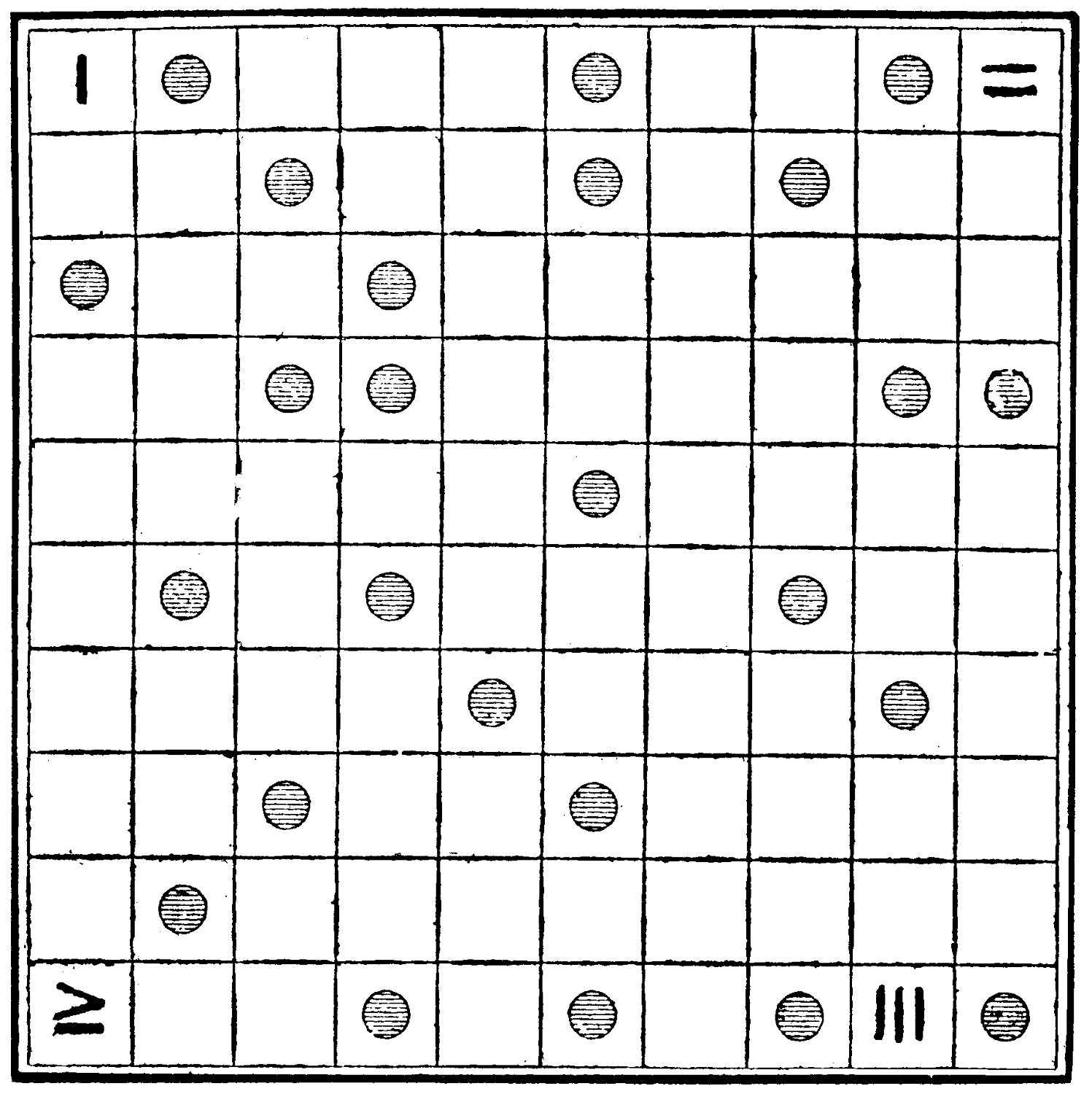
If the shaded circles are cut out and the diagram is placed squarely over the jumbled letters, with the I., II., III., IV. in turn at the top left-hand corner, this sentence is disclosed—
Le premier Supplément du Journal de la Jeunesse a été publié dans le Numéro du Dix-neuf Juin Mil huit cent soixante-quinze.
Return to description
[239]
No. XLV
This is the way to reconstruct Sam Loyd’s black pony—so that, while its legs and tail are strangely misplaced, they form the spirited outline of a white galloping horse.
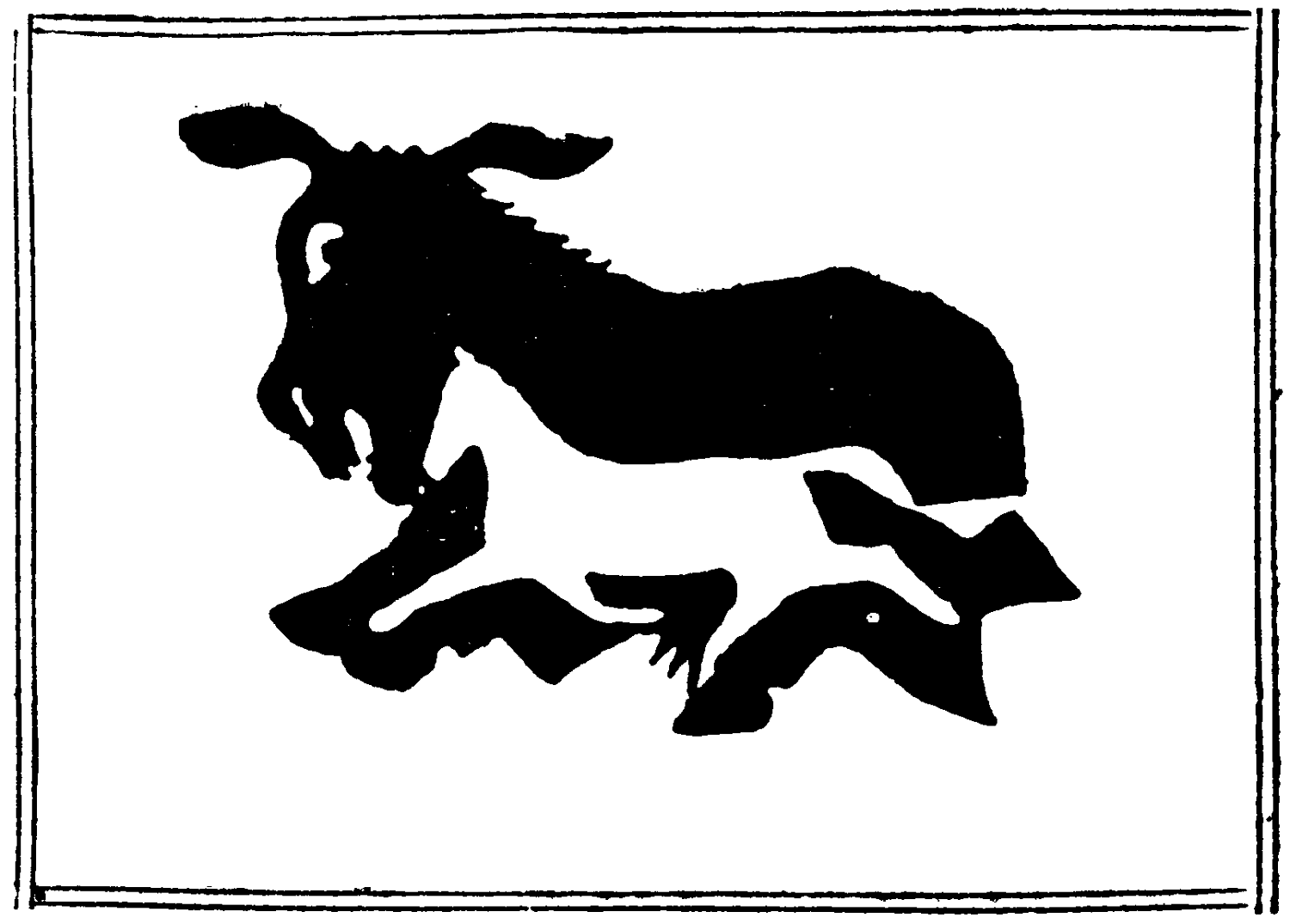
Return to description
No. XLVI
Here is the key to Sam Loyd’s ingenious puzzle—
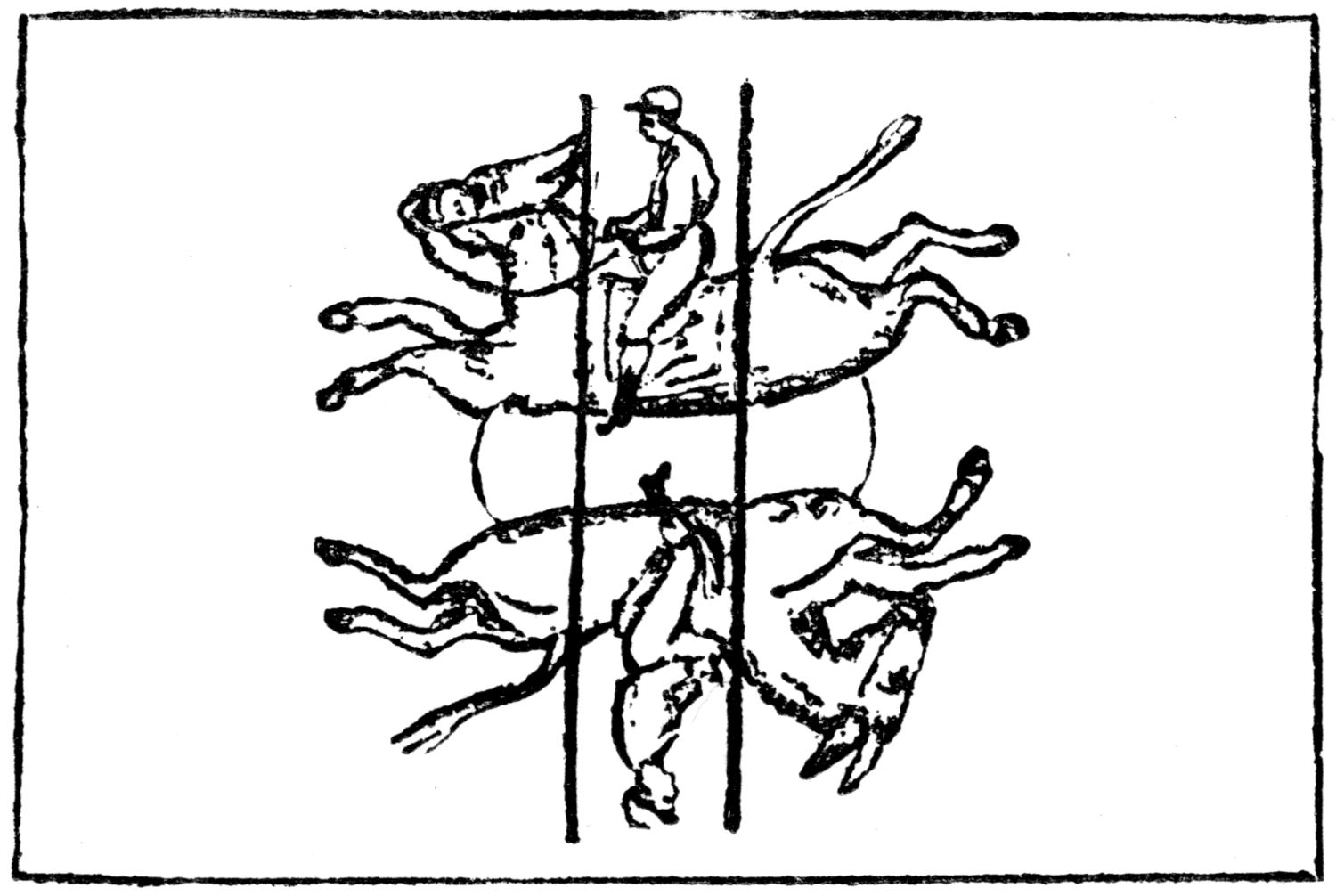
which shows the jockeys and horses in full racing trim.
Return to description
[240]
No. XLVII
This is the inevitable result of the boy’s attempt to annex with his mouth the sugar on the chair—
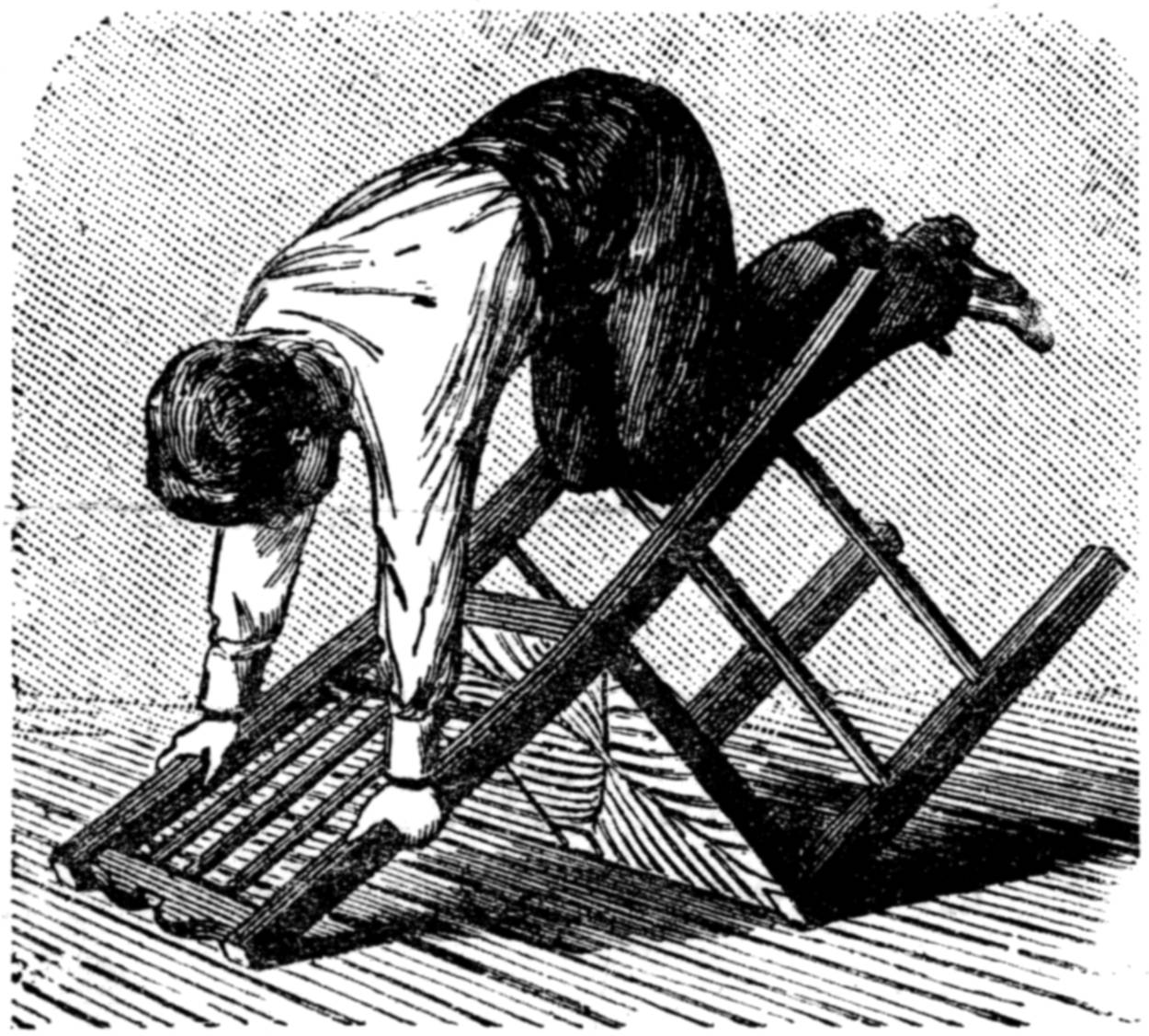
Return to description
No. XLVIII
The leap-frog puzzle is solved in nine hops thus:—

First jump from stool 2, then from 5, 3, 6, 7, 1, 3, and 6 in turn to the vacant stools.
Return to description
[241]
No. LV
This diagram shows that the seven wheels, which spin so merrily when the paper is rotated in the hand, can be divided off into separate enclosures by only three straight lines—
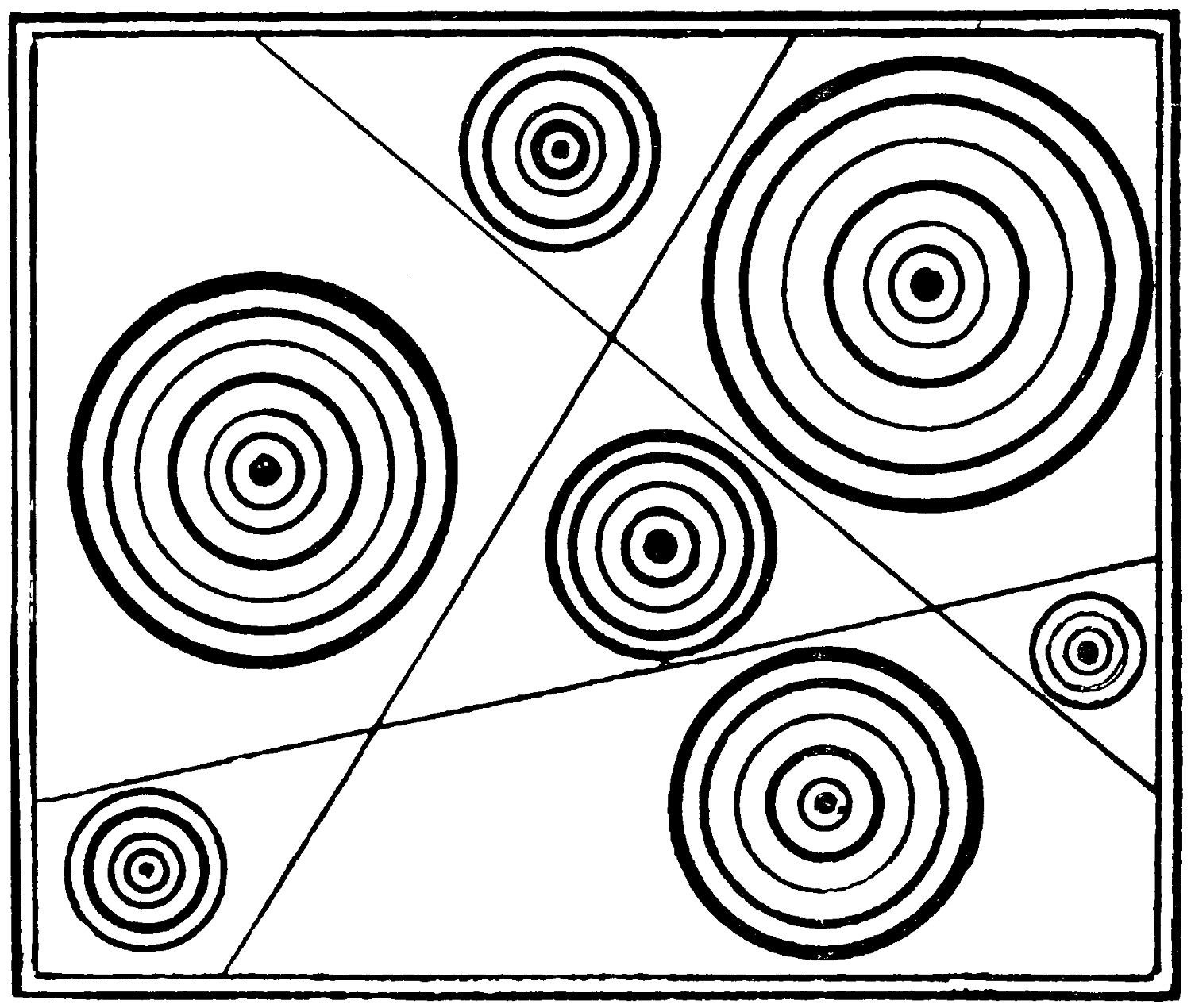
Return to description
[242]
No. LVI
The diagram below shows how the market-gardener, keeping one-fourth of his square field for himself in the shape of a triangle, was able to divide the remainder so that each of his four sons had an equal portion of similar shape—
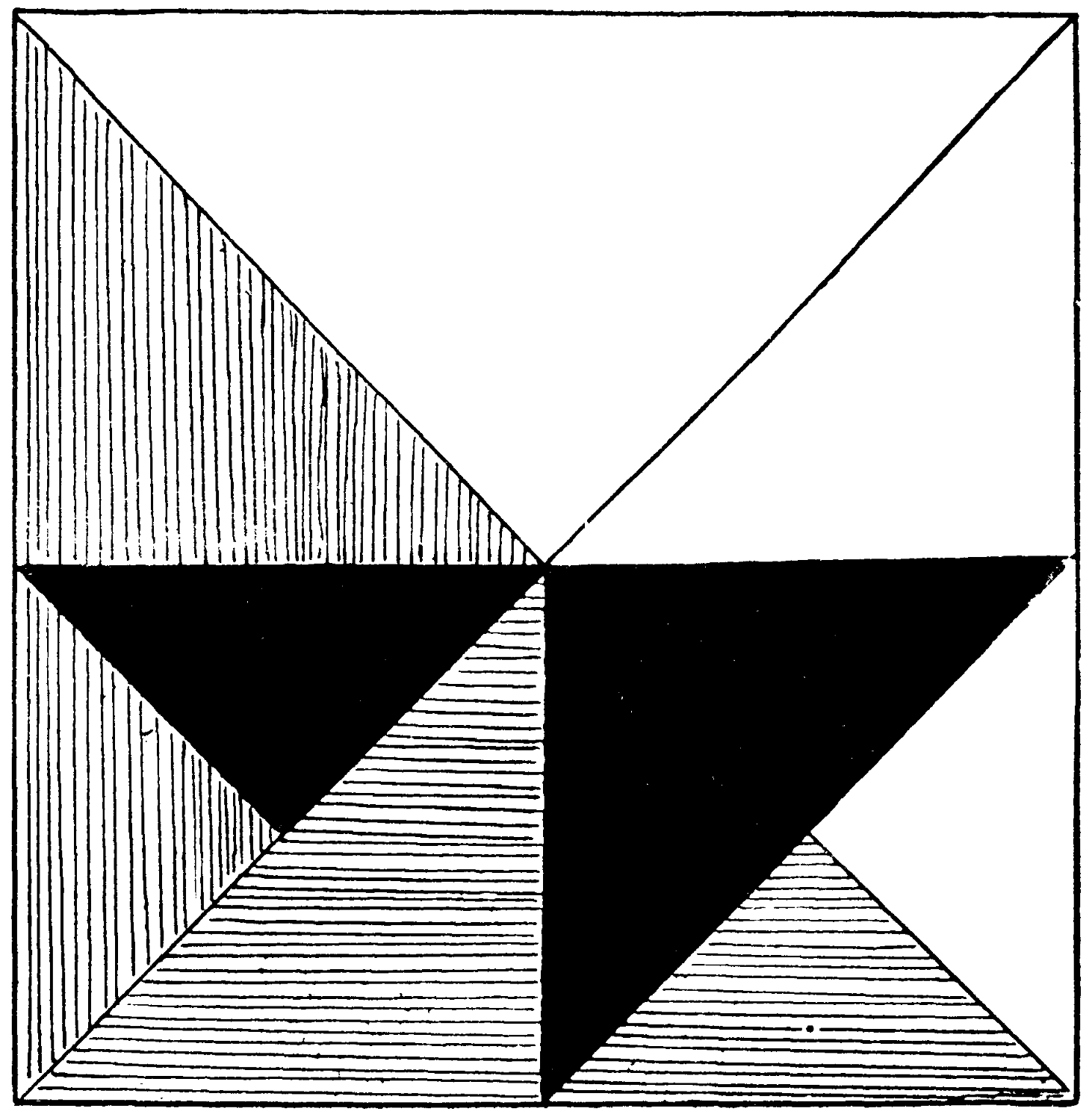
Return to description
[243]
No. LVII
Here is a drawing of the perfect Latin cross—
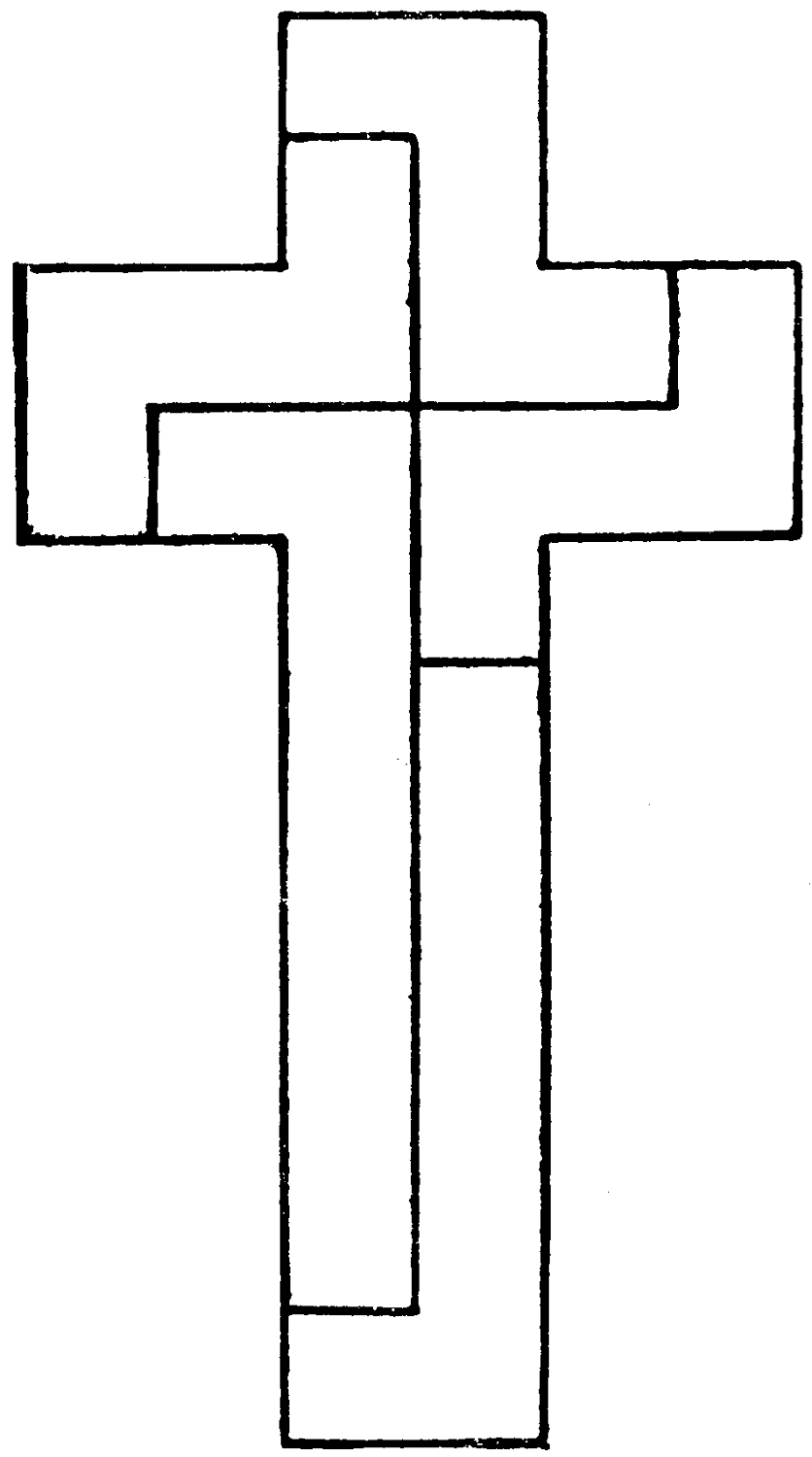
The position of the two long pieces does not readily suggest itself to those who try to arrange the five on paper with a pencil.
Return to description
[244]
No. LVIII
This diagram shows the effectual means taken by four rich men, whose houses were further afield, to exclude four poor men from all access to a central lake, that they might reserve the fishing for themselves.
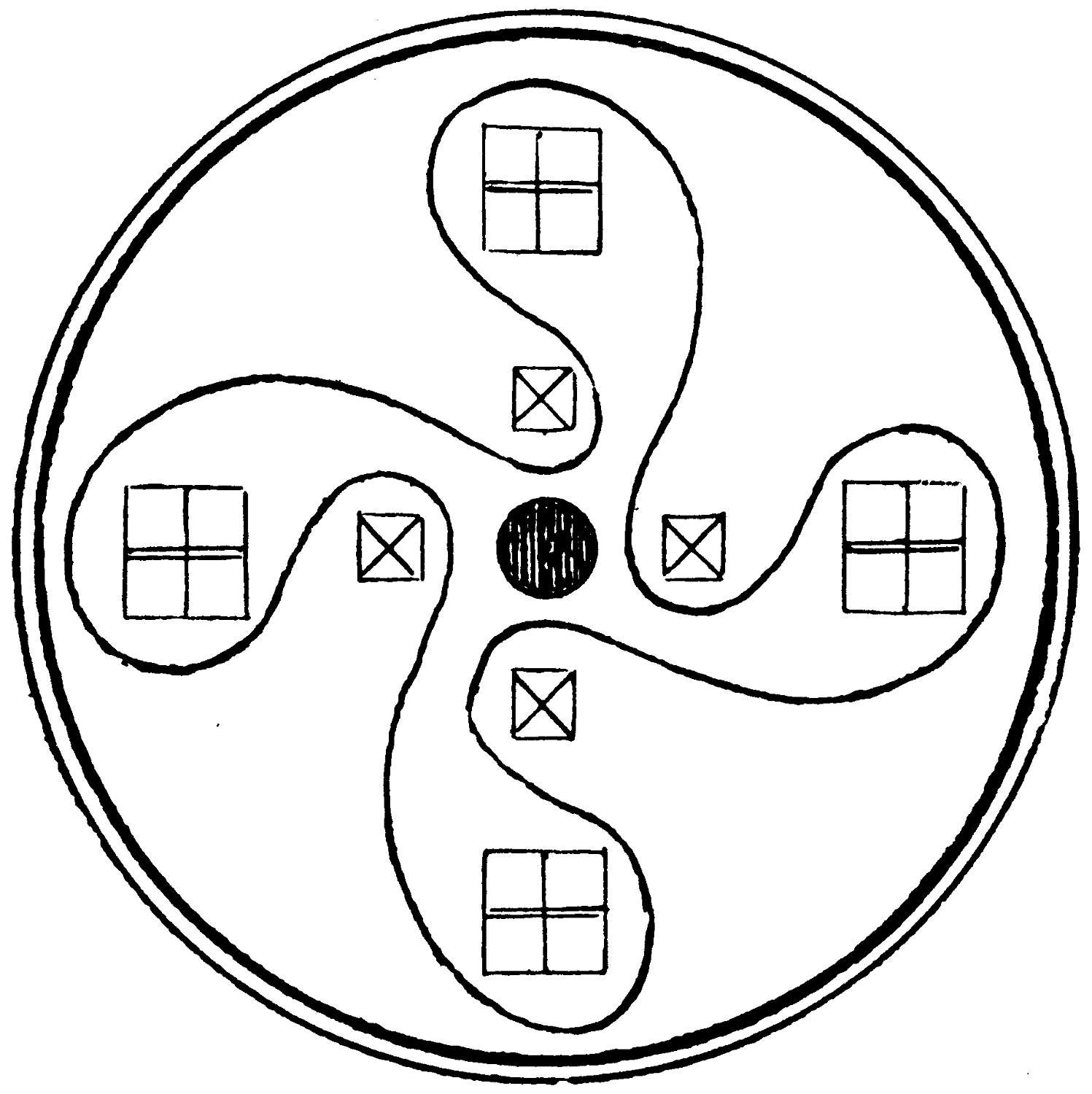
They built a high wall on the lines that are indicated which, while it left a way for each of them to the water, altogether shut it away from their poor neighbours.
Return to description
[245]
No. LIX
This is the square that can be formed with the ten pattern pieces given—
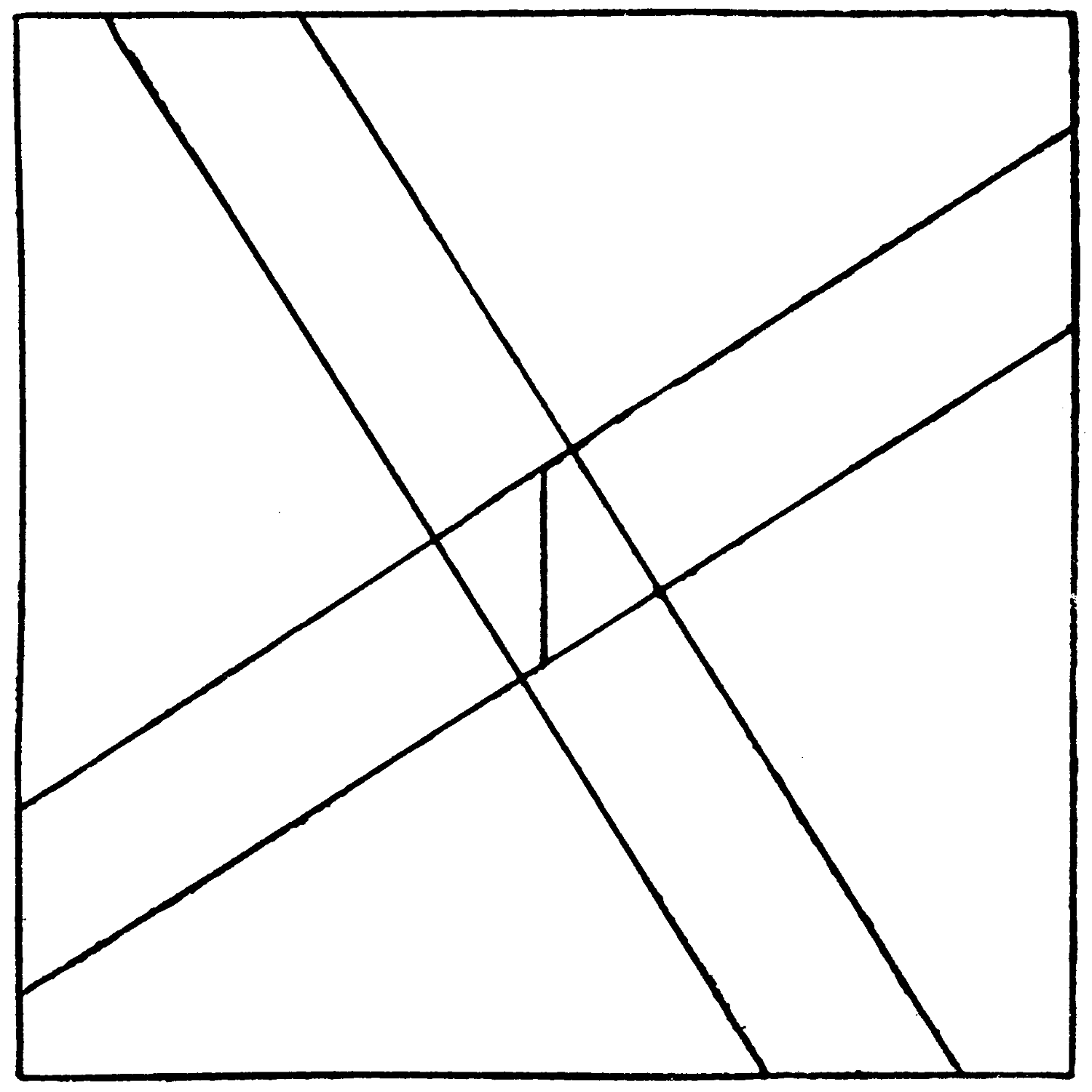
Return to description
[246]
No. LX
The dotted lines in this diagram show how the figure can be divided into nine parts by four straight cuts
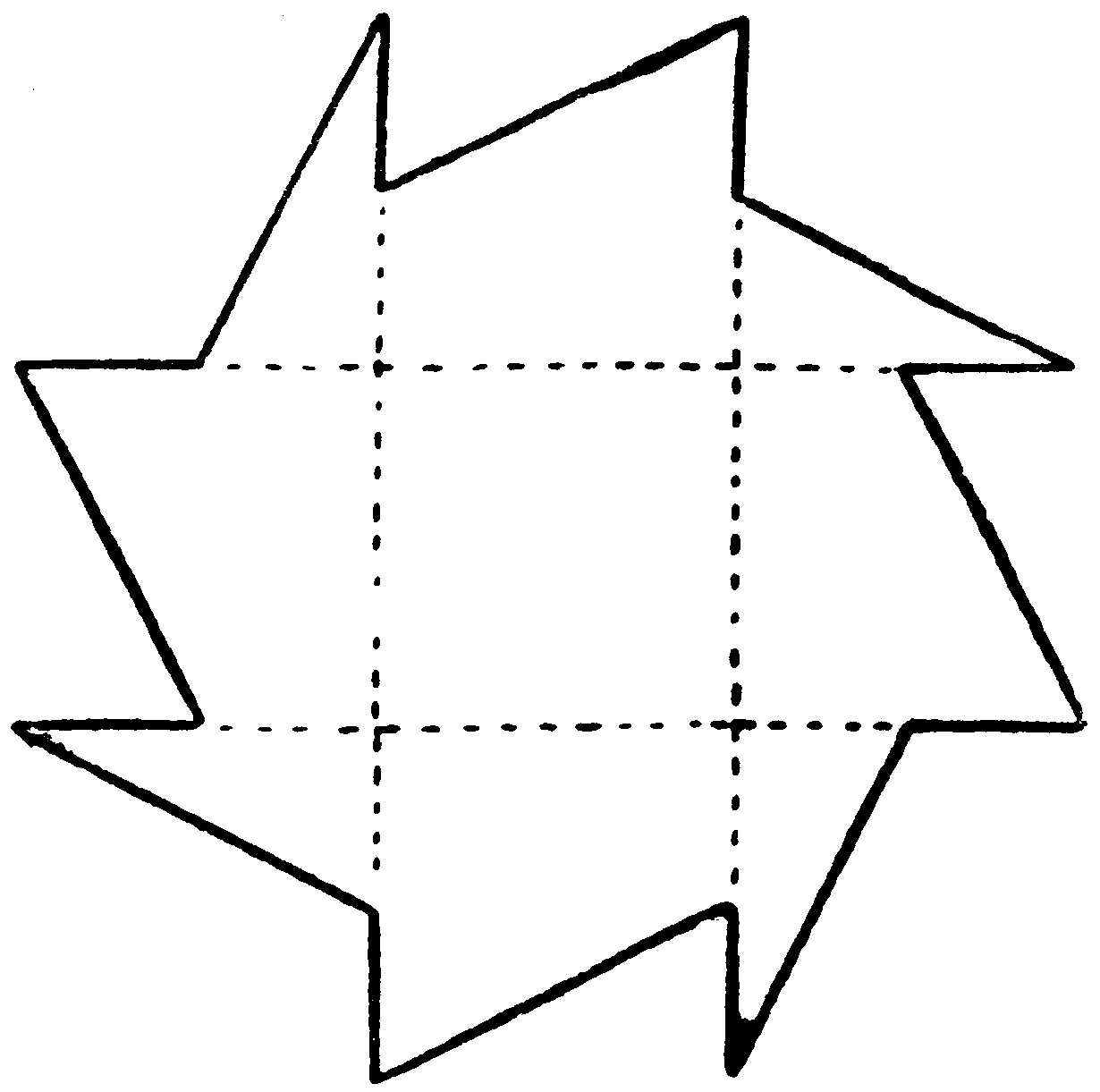
which can be reunited to form a perfect cross.
Return to description
No. LXI
This is a simple way by which the figure given can be divided by four straight cuts into four equal and similar parts—
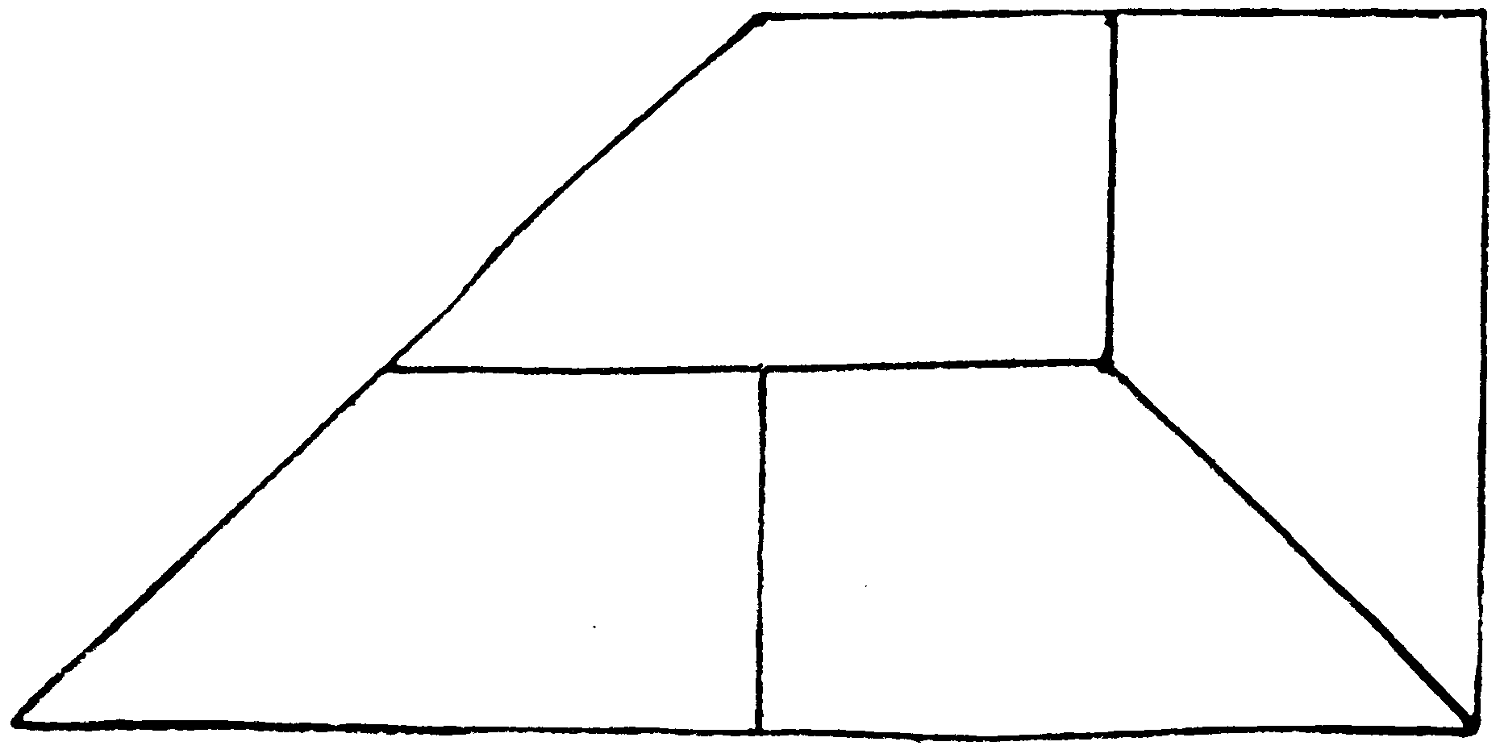
Return to description
[247]
No. LXII
This is the way to draw twenty-two straight lines within the circle at right-angles to each other, so that they divide it into four similar parts—
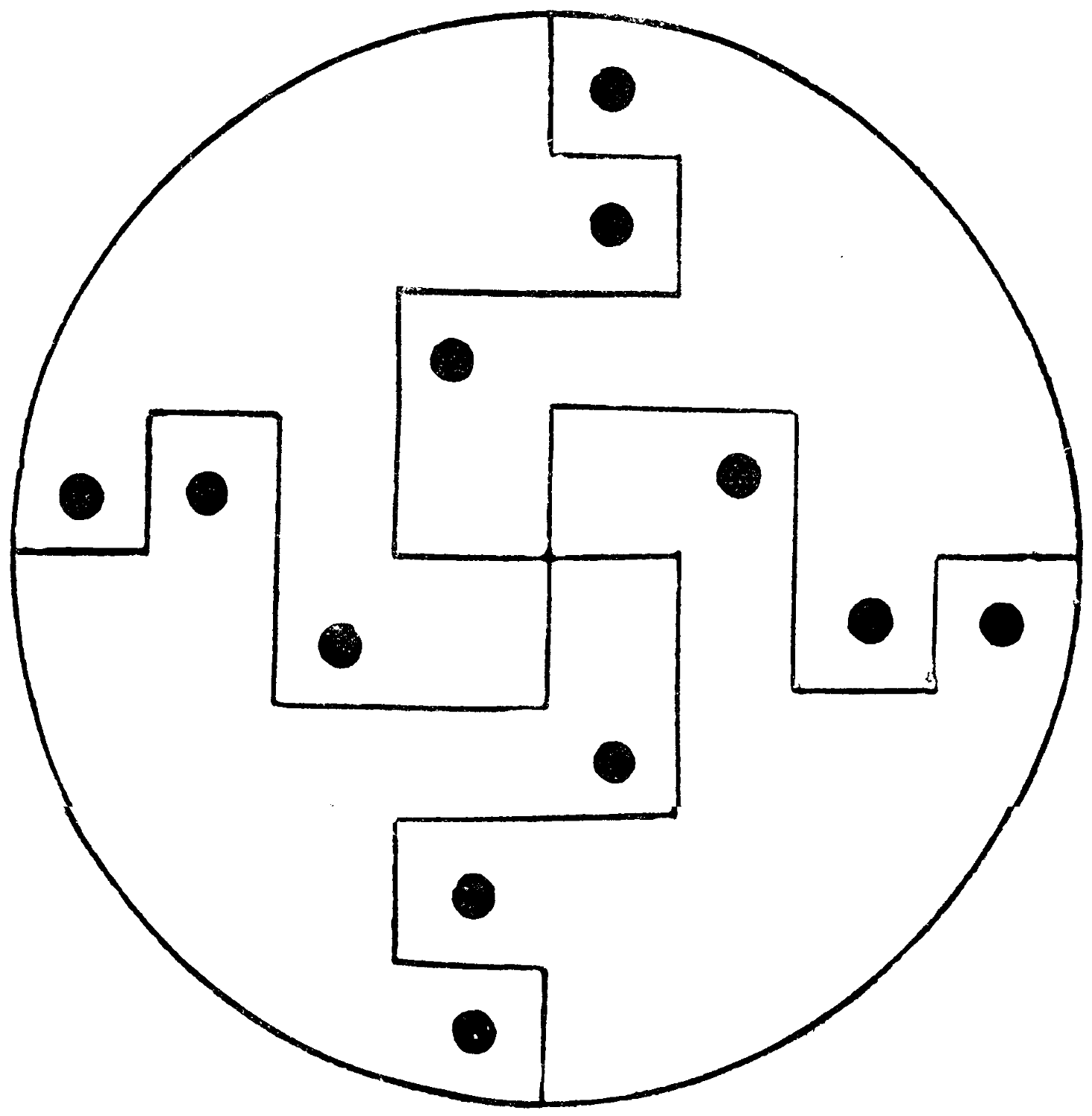
and each part has three dots within its borders.
Return to description
[248]
No. LXIII
These diagrams show how the upper triangle is divided into five parts, which can be rearranged to form the equilateral triangle below.
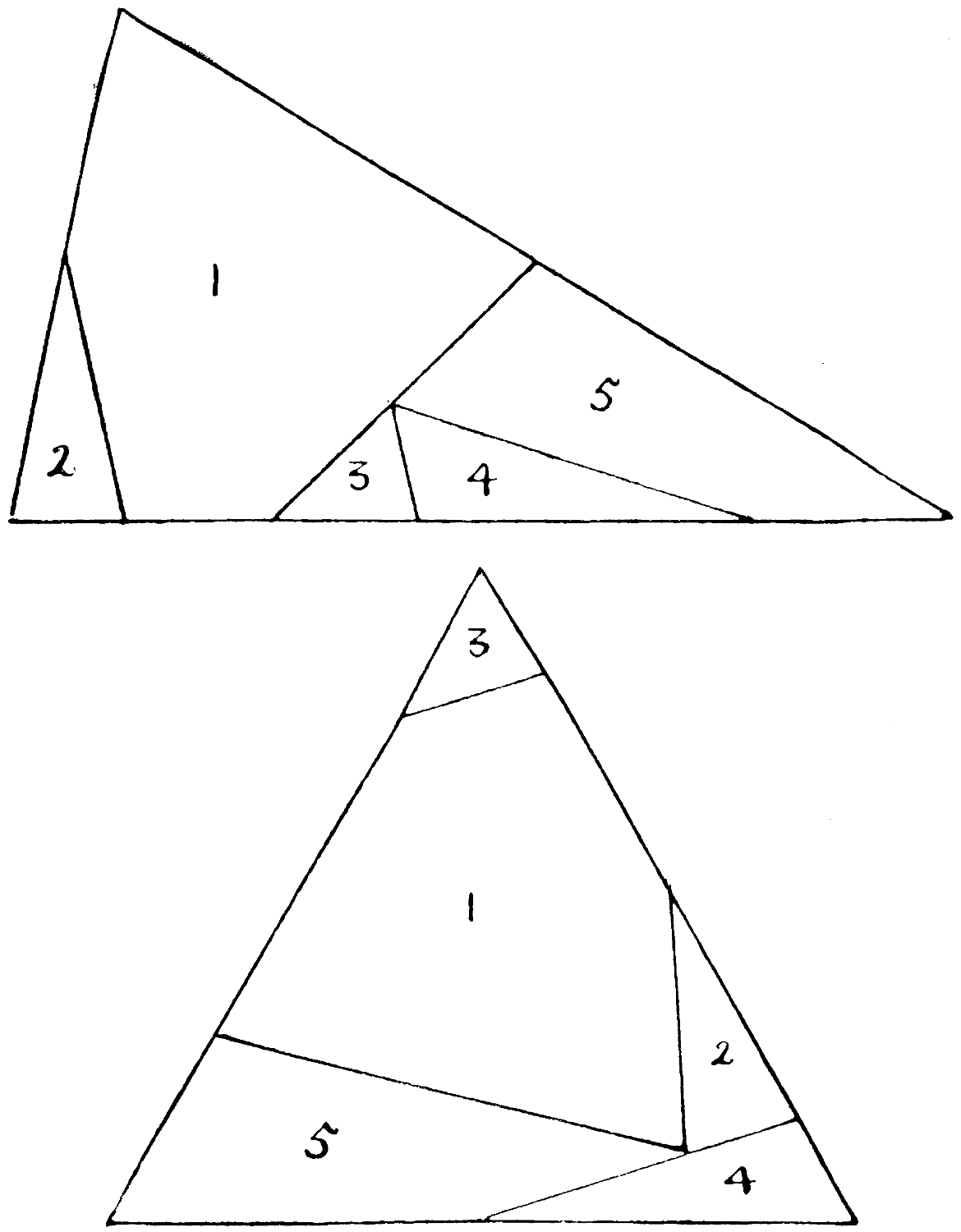
The originator of this ingenious novelty says, “The method of construction is not shown, but its application is general, and the result is easily verified by measurement.”
Return to description
[249]
No. LXVI
This is an arrangement of the twenty-seven counters in nine rows, six in a row, within the borders of an equilateral triangle.
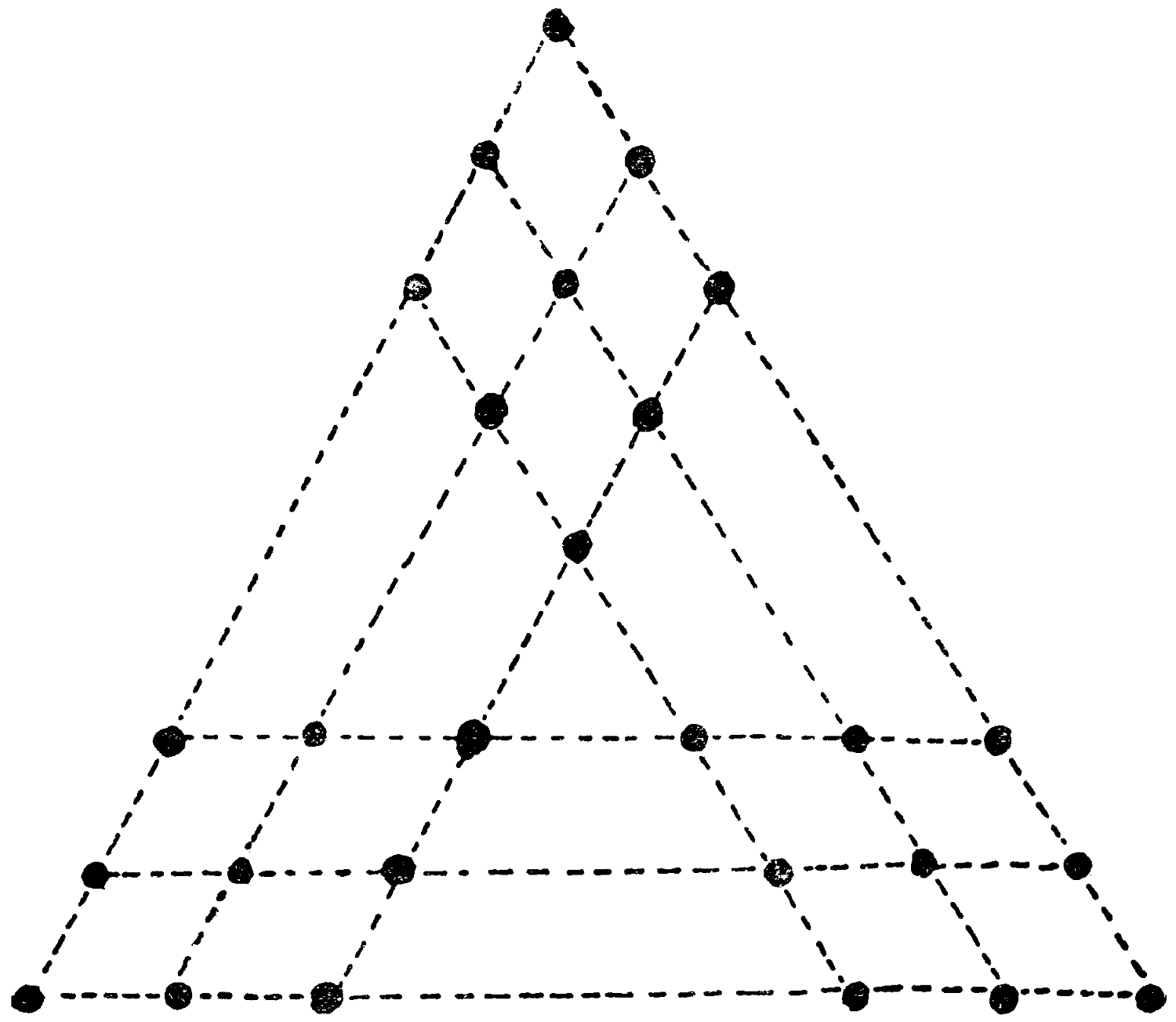
Return to description
No. LXVII
All the cards of one colour, when placed alternately, can be brought together in four moves, two at a time, thus—
| A ♠ |
2 ♡ |
3 ♣ |
4 ♢ |
5 ♣ |
6 ♢ |
7 ♣ |
8 ♡ |
Place two and three beyond eight;
Place five and six between one and four;
Place eight and two between four and seven;
Place one and five between seven and three.
Return to description
[250]
No. LXVIII
You can in a moment tell the number chosen on these cards, when you are told on which of them it appears,
| I. | II. | III. | IV. | |||||||||||||||
| 1 | 33 | 65 | 97 | 2 | 34 | 66 | 98 | 4 | 36 | 68 | 100 | 8 | 40 | 72 | 104 | |||
| 3 | 35 | 67 | 99 | 3 | 35 | 67 | 99 | 5 | 37 | 69 | 101 | 9 | 41 | 73 | 105 | |||
| 5 | 37 | 69 | 101 | 6 | 38 | 70 | 102 | 6 | 38 | 70 | 102 | 10 | 42 | 74 | 106 | |||
| 7 | 39 | 71 | 103 | 7 | 39 | 71 | 103 | 7 | 39 | 71 | 103 | 11 | 43 | 75 | 107 | |||
| 9 | 41 | 73 | 105 | 10 | 42 | 74 | 106 | 12 | 44 | 76 | 108 | 12 | 44 | 76 | 108 | |||
| 11 | 43 | 75 | 107 | 11 | 43 | 75 | 107 | 13 | 45 | 77 | 109 | 13 | 45 | 77 | 109 | |||
| 13 | 45 | 77 | 109 | 14 | 46 | 78 | 110 | 14 | 46 | 78 | 110 | 14 | 46 | 78 | 110 | |||
| 15 | 47 | 79 | 111 | 15 | 47 | 79 | 111 | 15 | 47 | 79 | 111 | 15 | 47 | 79 | 111 | |||
| 17 | 49 | 81 | 113 | 18 | 50 | 82 | 114 | 20 | 52 | 84 | 116 | 24 | 56 | 88 | 120 | |||
| 19 | 51 | 83 | 115 | 19 | 51 | 83 | 115 | 21 | 53 | 85 | 117 | 25 | 57 | 89 | 121 | |||
| 21 | 53 | 85 | 117 | 22 | 54 | 86 | 118 | 22 | 54 | 86 | 118 | 26 | 58 | 90 | 122 | |||
| 23 | 55 | 87 | 119 | 23 | 55 | 87 | 119 | 23 | 55 | 87 | 119 | 27 | 59 | 91 | 123 | |||
| 25 | 57 | 89 | 121 | 26 | 58 | 90 | 122 | 28 | 60 | 92 | 124 | 28 | 60 | 92 | 124 | |||
| 27 | 59 | 91 | 123 | 27 | 59 | 91 | 123 | 29 | 61 | 93 | 125 | 29 | 61 | 93 | 125 | |||
| 29 | 61 | 93 | 125 | 30 | 62 | 94 | 126 | 30 | 62 | 94 | 126 | 30 | 62 | 94 | 126 | |||
| 31 | 63 | 95 | 127 | 31 | 63 | 95 | 127 | 31 | 63 | 95 | 127 | 31 | 63 | 95 | 127 | |||
| V. | VI. | VII. | |||||||||||
| 16 | 48 | 80 | 112 | 32 | 48 | 96 | 112 | 64 | 80 | 96 | 112 | ||
| 17 | 49 | 81 | 113 | 33 | 49 | 97 | 113 | 65 | 81 | 97 | 113 | ||
| 18 | 50 | 82 | 114 | 34 | 50 | 98 | 114 | 66 | 82 | 98 | 114 | ||
| 19 | 51 | 83 | 115 | 35 | 51 | 99 | 115 | 67 | 83 | 99 | 115 | ||
| 20 | 52 | 84 | 116 | 36 | 52 | 100 | 116 | 68 | 84 | 100 | 116 | ||
| 21 | 53 | 85 | 117 | 37 | 53 | 101 | 117 | 69 | 85 | 101 | 117 | ||
| 22 | 54 | 86 | 118 | 38 | 54 | 102 | 118 | 70 | 86 | 102 | 118 | ||
| 23 | 55 | 87 | 119 | 39 | 55 | 103 | 119 | 71 | 87 | 103 | 119 | ||
| 24 | 56 | 88 | 120 | 40 | 56 | 104 | 120 | 72 | 88 | 104 | 120 | ||
| 25 | 57 | 89 | 121 | 41 | 57 | 105 | 121 | 73 | 89 | 105 | 121 | ||
| 26 | 58 | 90 | 122 | 42 | 58 | 106 | 122 | 74 | 90 | 106 | 122 | ||
| 27 | 59 | 91 | 123 | 43 | 59 | 107 | 123 | 75 | 91 | 107 | 123 | ||
| 28 | 60 | 92 | 124 | 44 | 60 | 108 | 124 | 76 | 92 | 108 | 124 | ||
| 29 | 61 | 93 | 125 | 45 | 61 | 109 | 125 | 77 | 93 | 109 | 125 | ||
| 30 | 62 | 94 | 126 | 46 | 62 | 110 | 126 | 78 | 94 | 110 | 126 | ||
| 31 | 63 | 95 | 127 | 47 | 63 | 111 | 127 | 79 | 95 | 111 | 127 | ||
by adding together the numbers at the top left-hand corner of these.
Return to description
[251]
No. LXIX
This diagram shows that the postman can take a course which involves fewer turnings than that indicated, when he had to pass round eighteen corners.
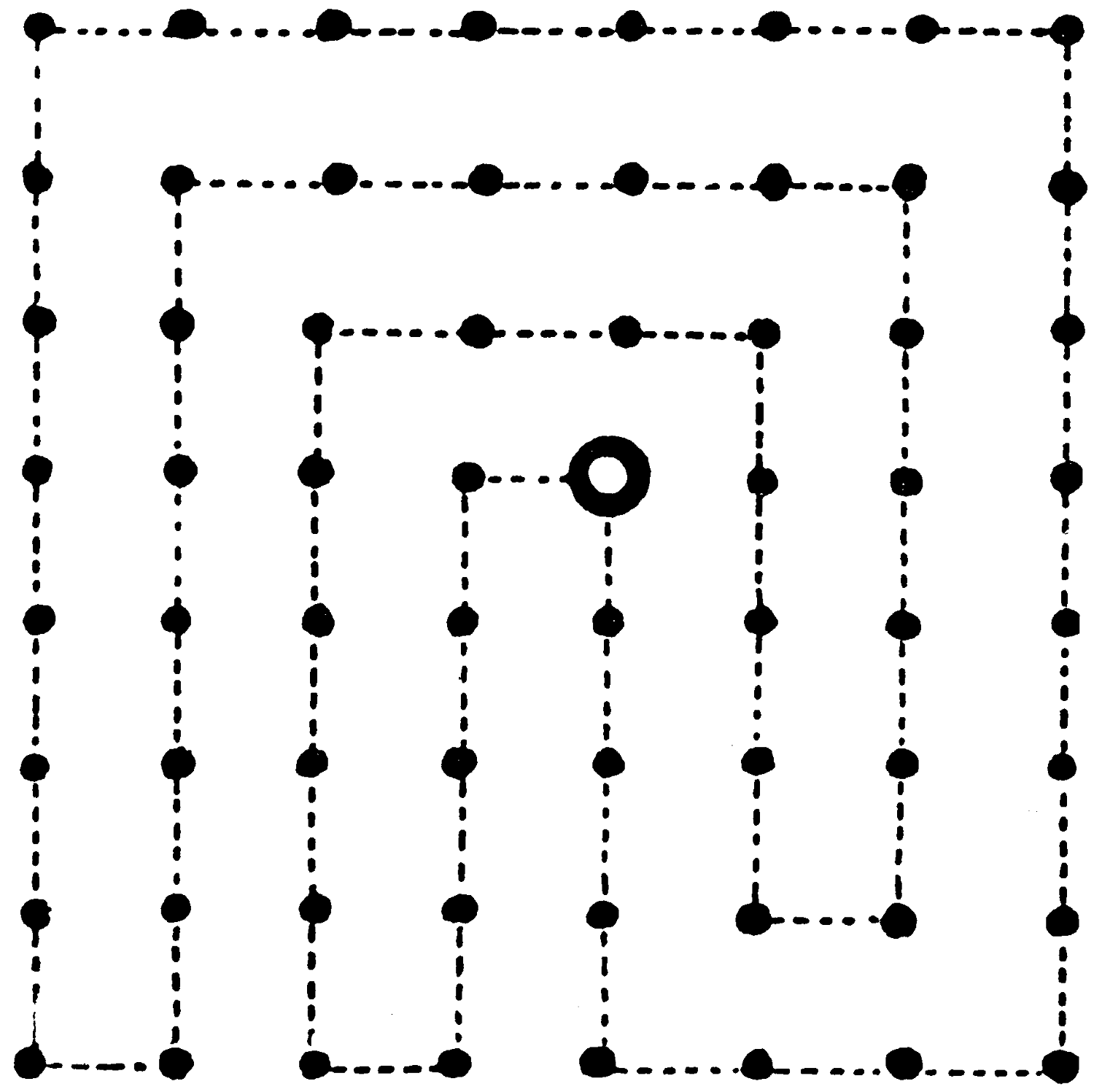
It will be seen that he has to turn only fifteen times.
Return to description
[252]
No. LXX
This shows how a square can be divided into three parts, so that these can be reunited to form No. 2 and No. 3 of the diagram.
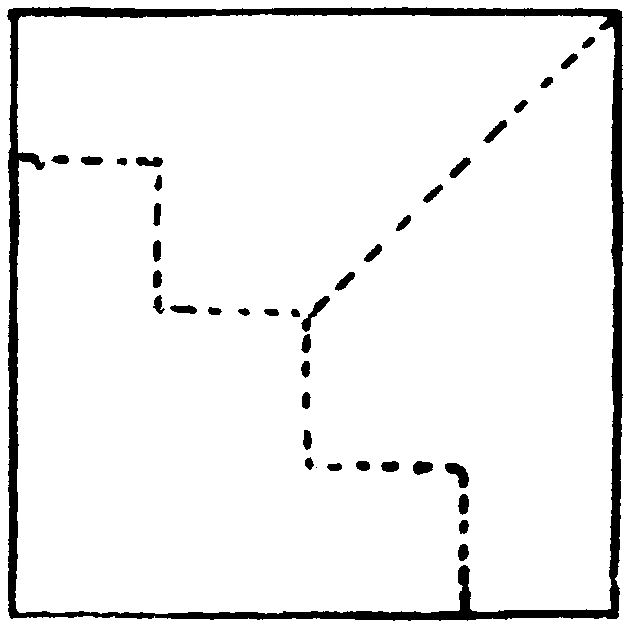
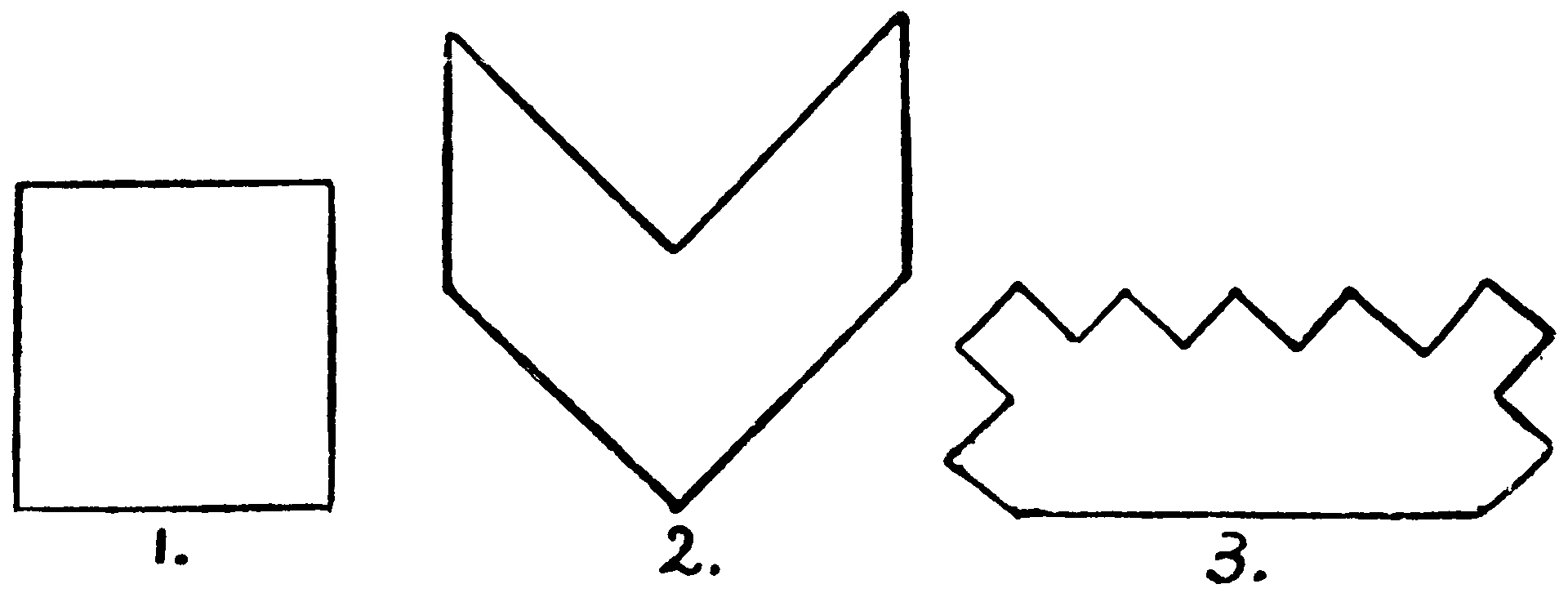
Try it with scissors and paper or cardboard.
Return to description
[253]
No. LXXI
| ♘ | ♖ | ♚ | ♖ | ||||
This position fulfils the conditions of the puzzle. Obviously it could not occur in actual play.
Return to description
[254]
No. LXXV
The dotted lines in this diagram show where the flag with a cross taken out from its centre must be cut, so that the two pieces can be rejoined to form a perfect flag.
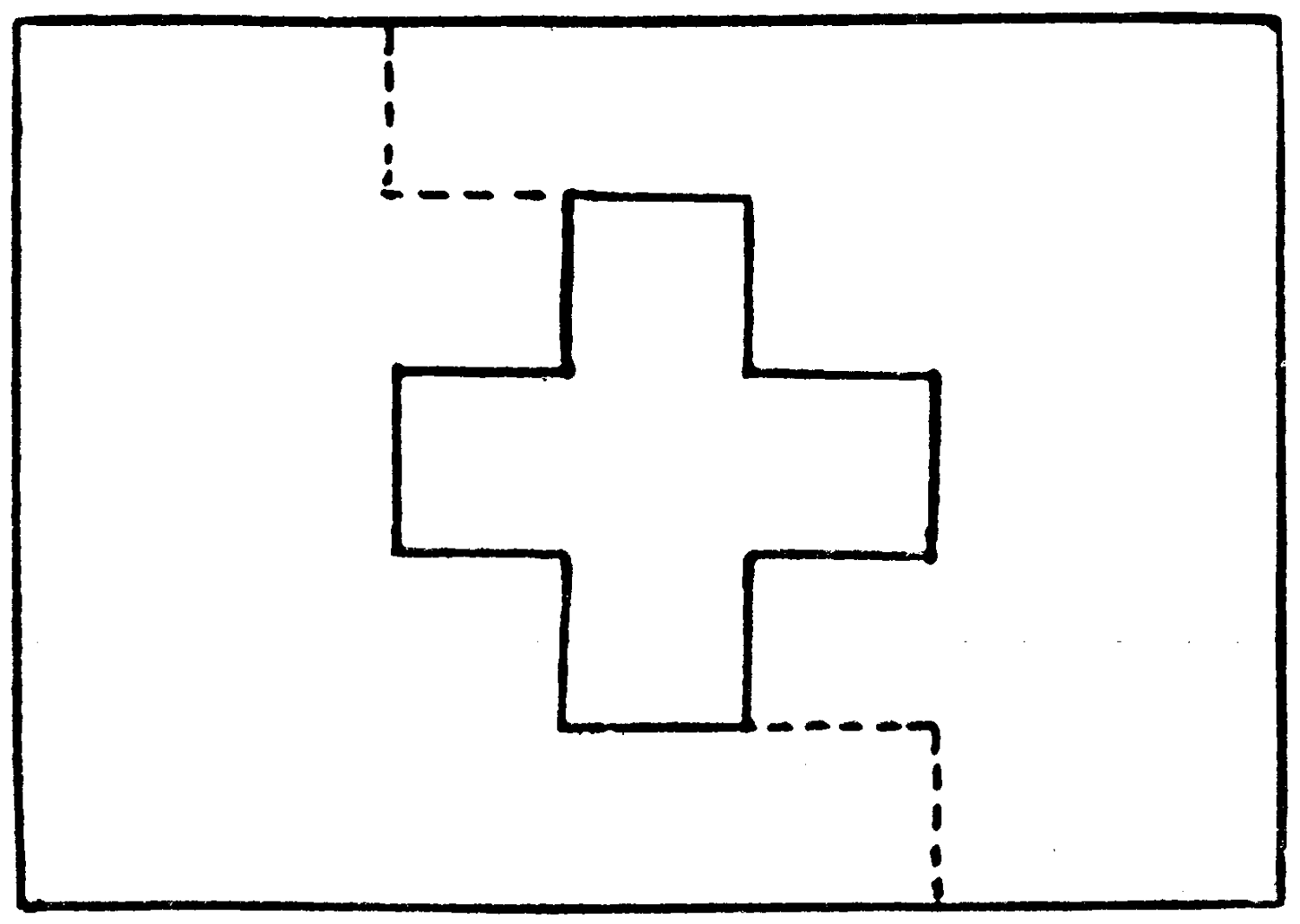
The piece on the right is moved upward, and to the left.
Return to description
[255]
No. LXXVI
This is a way in which the eleven parts can be readjusted to form a square:—
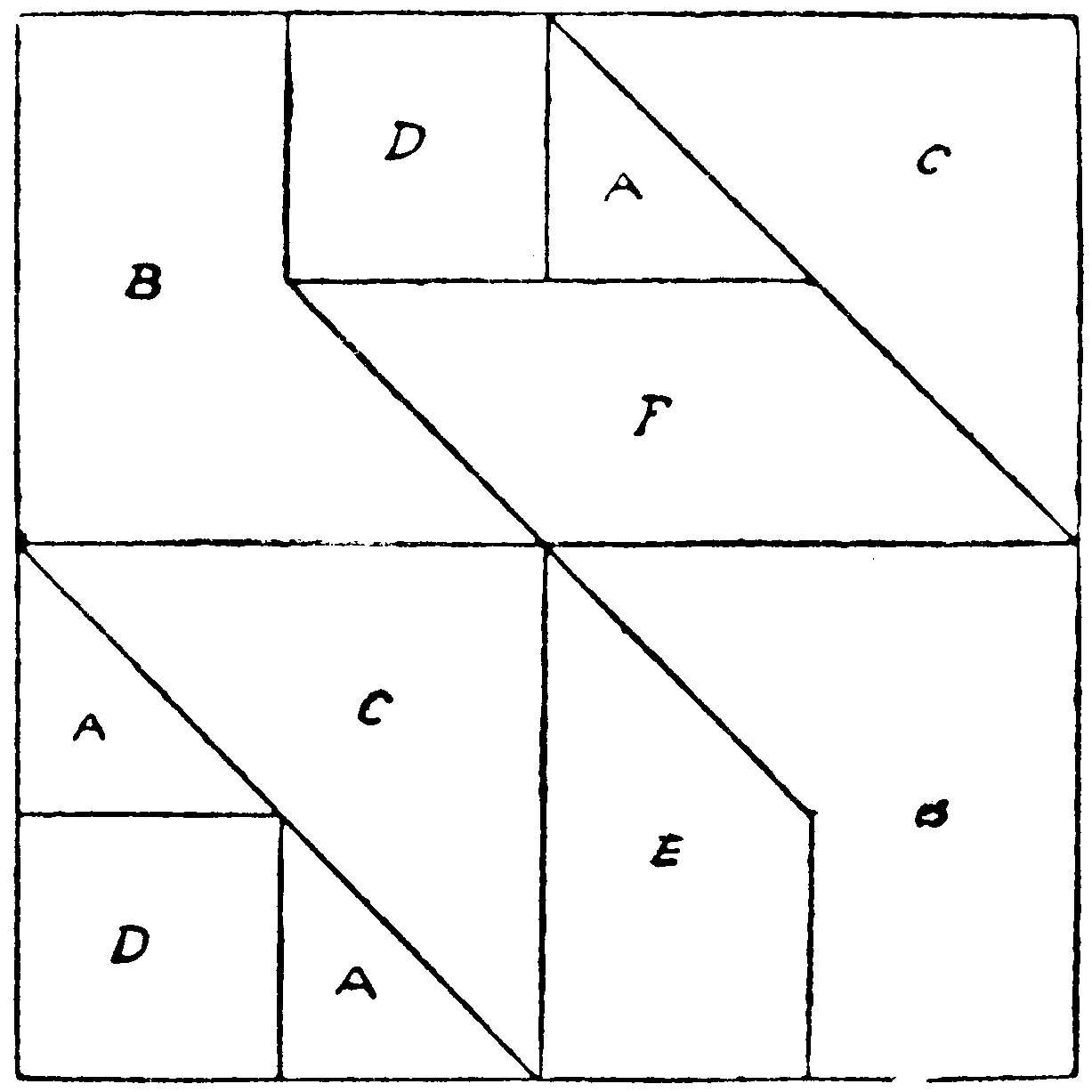
Return to description
No. LXXVIII
This shows the shortest course—
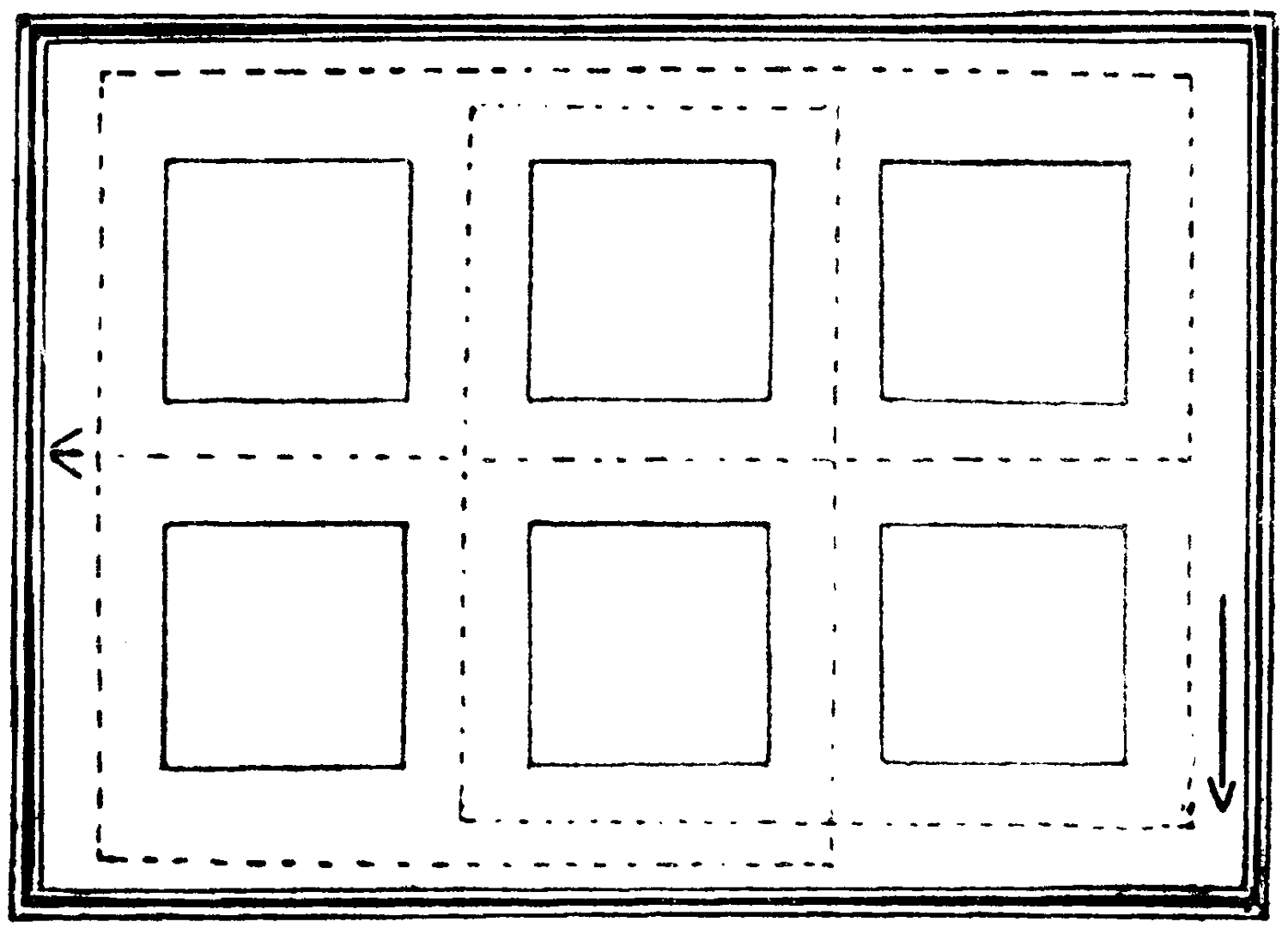
This track takes him completely round every block, passing only once round four of them.
Return to description
[256]
No. LXXIX
Here is a very simple and symmetrical arrangement, by which on a board of 36 squares twelve counters are so placed that there are two, and two only, on each line, column, and diagonal.
| ◎ | ◎ | ||||
| ◎ | ◎ | ||||
| ◎ | ◎ | ||||
| ◎ | ◎ | ||||
| ◎ | ◎ | ||||
| ◎ | ◎ |
There are other arrangements which fulfil the conditions.
Return to description
[257]
No. LXXXI
In this nest of triangles of five tiers there are 1196 separate triangles, or nearly double the number (653) of a similar nest of four tiers.
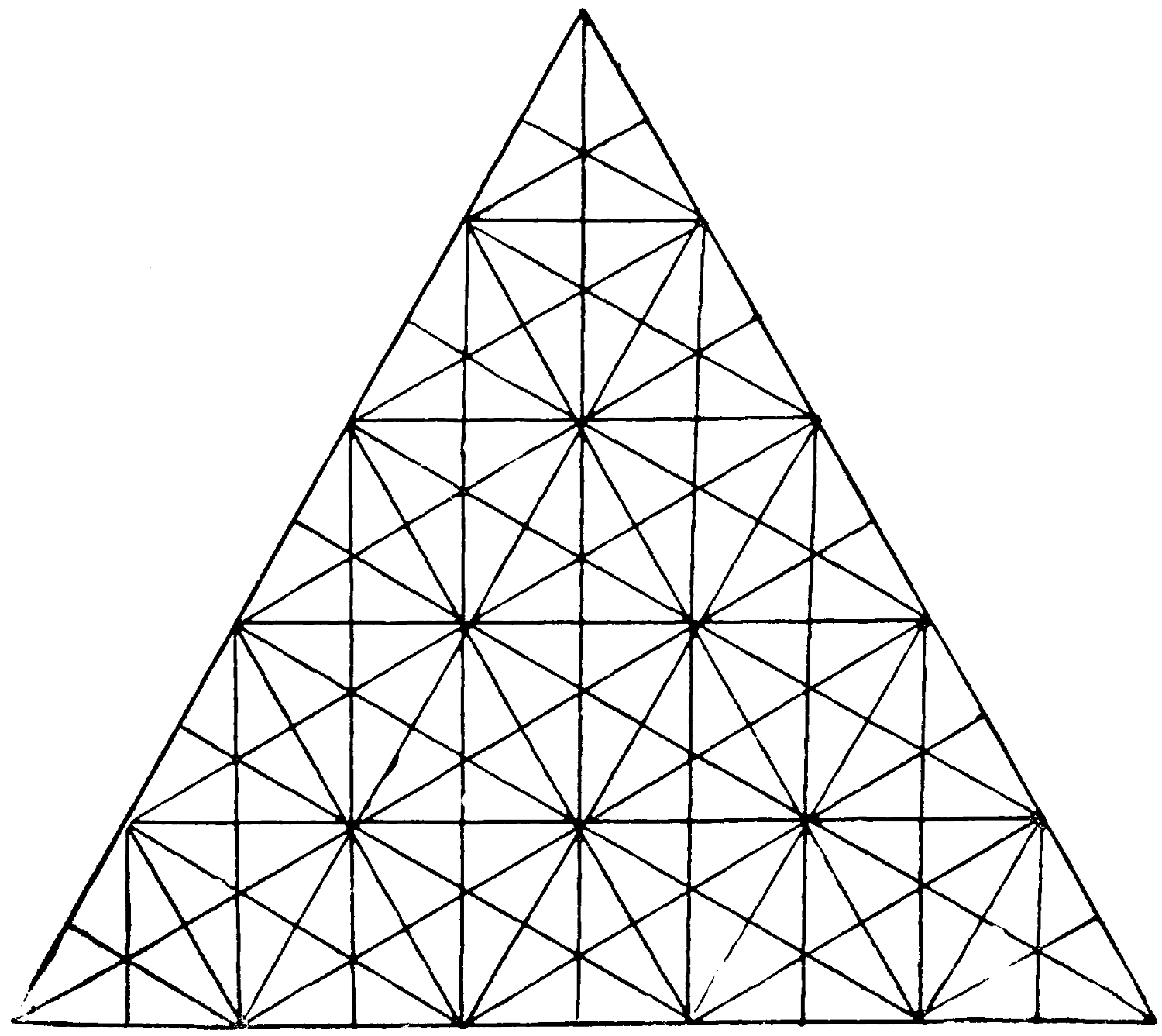
In such a figure with 10,000 tiers there would be 6,992,965,420,332 different triangles!
Return to description
[258]
No. LXXXII
The match puzzle, in which eight matches set in a row are to be rearranged in four pairs, by passing one match over two four times—
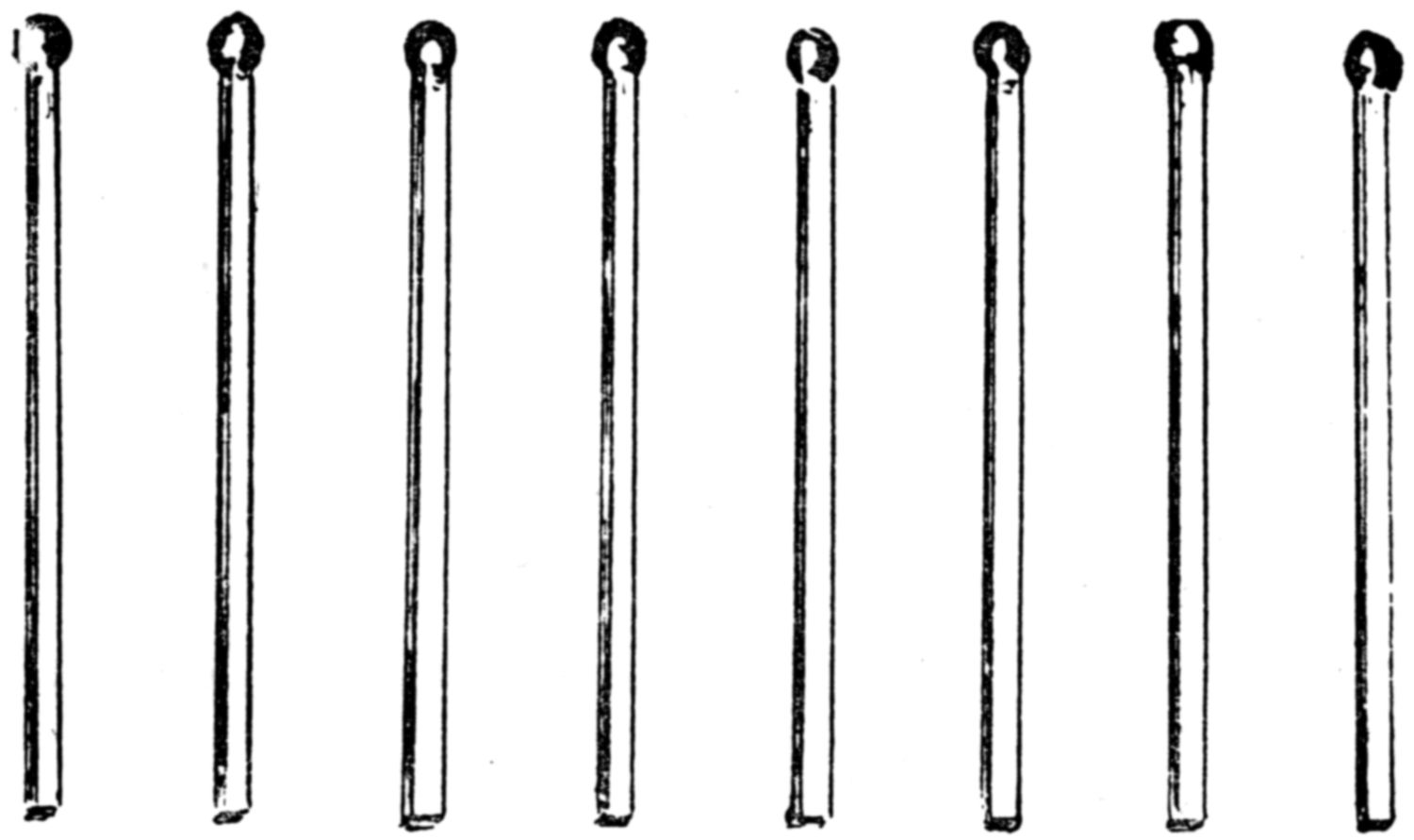
is solved, if the matches are numbered 1, 2, 3, 4, 5, 6, 7, 8, by moving 4 to 7, 6 to 2, 1 to 3, and 5 to 8.
Return to description
No. LXXXIII
The lower diagram shows how, when three matches are removed from the four squares, the[259] remaining nine can be readjusted to represent three squares—
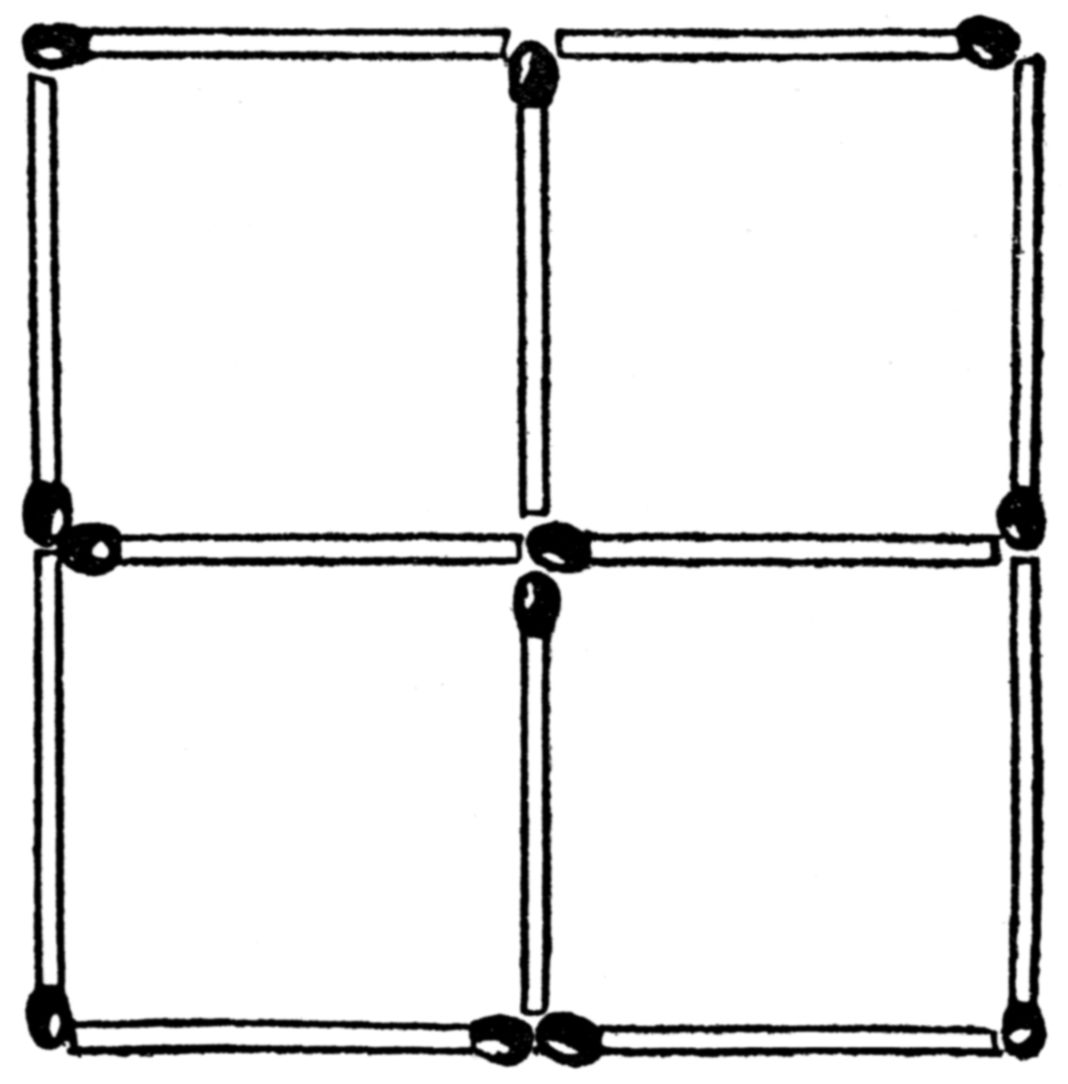
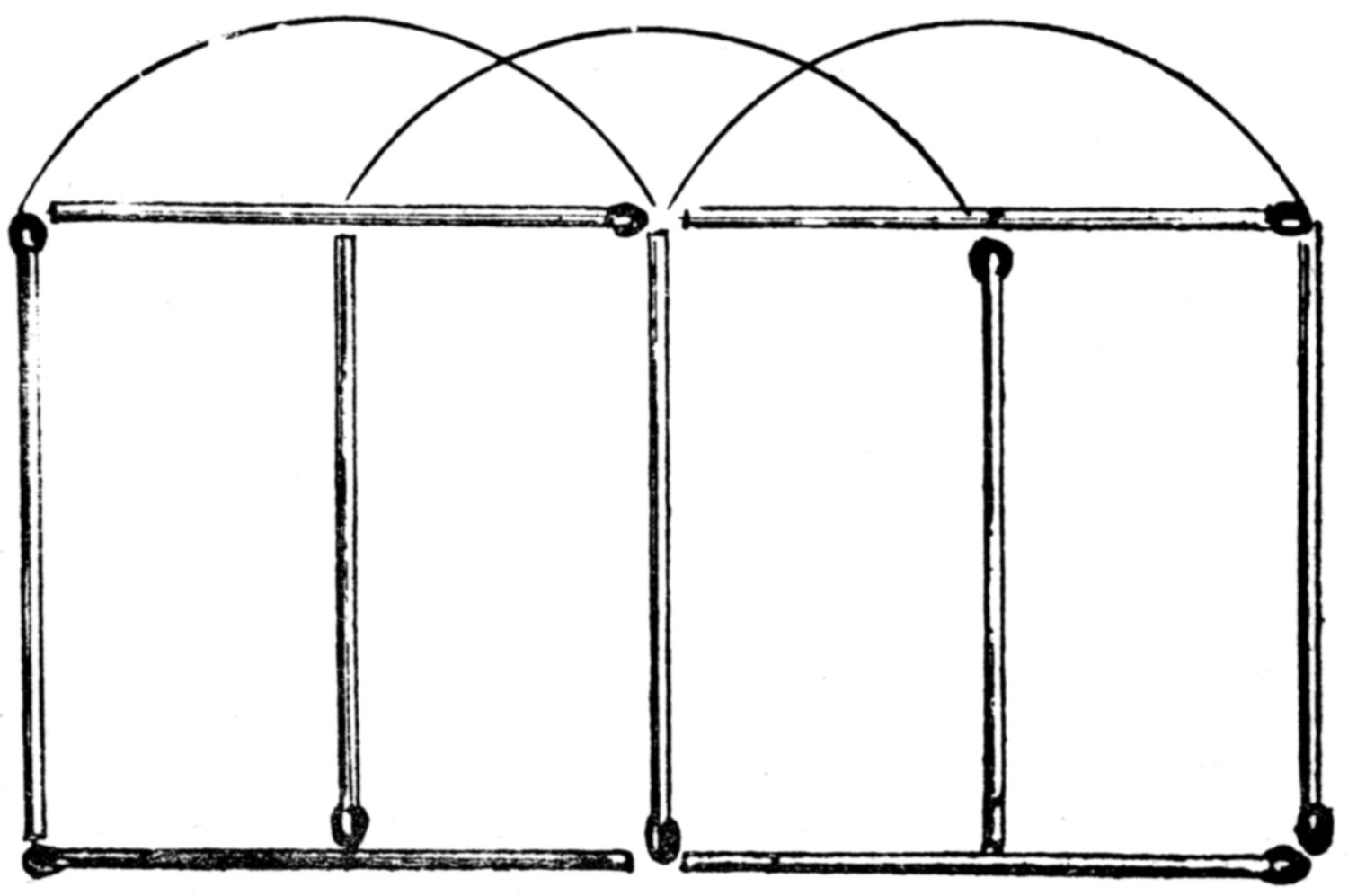
Return to description
[260]
No. LXXXIV
This diagram shows how different arrangements of four matches are possible in all the thirty-six cells of the square.
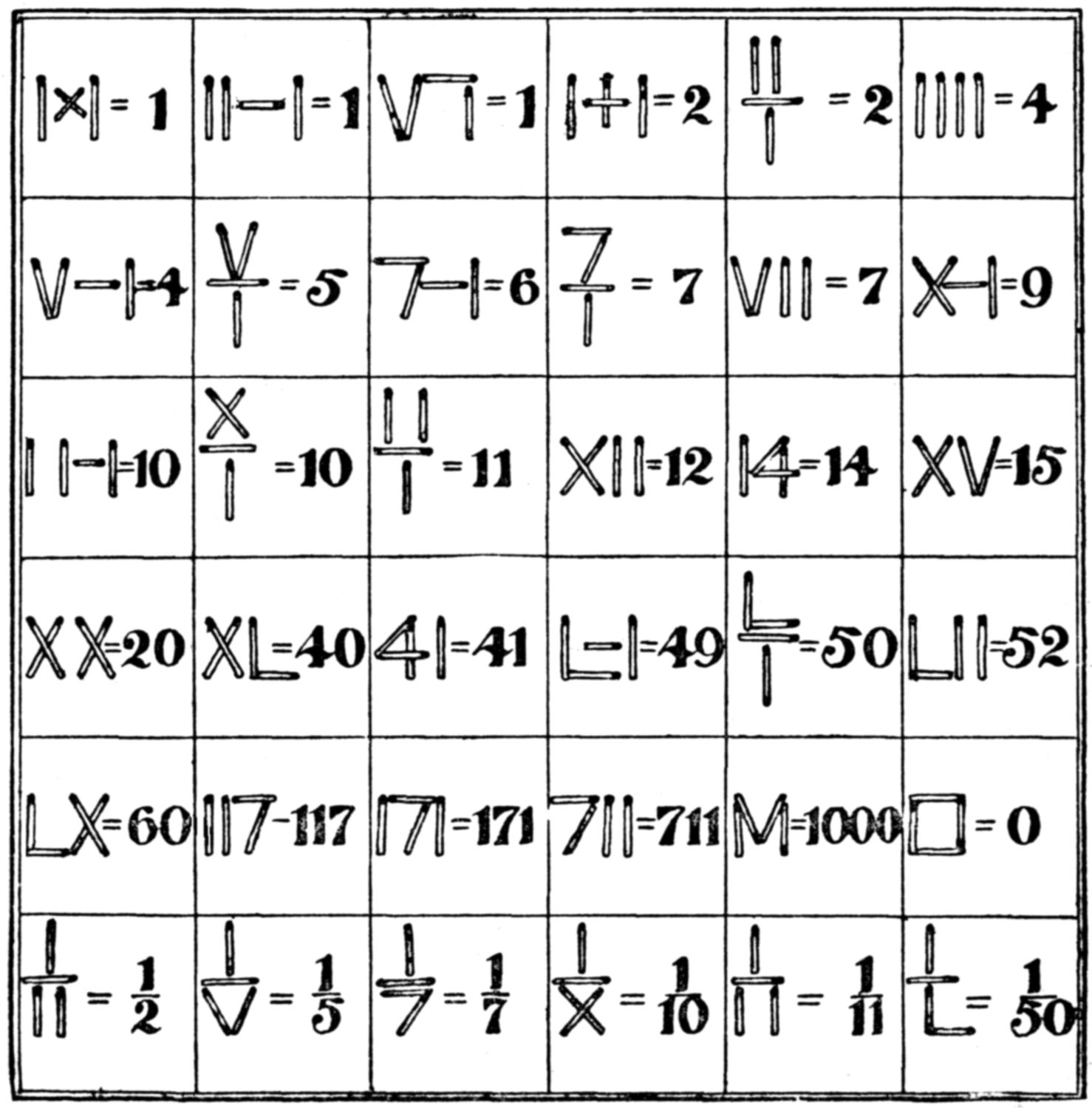
In every case a whole number or a fraction is represented, with such signs or lines as are necessary, and only four matches are used.
Return to description
[261]
No. LXXXV
It will be seen from the diagram below that the sentence, when filled in as required, is “Rise to vote, sir.”
| R | I | S | E | T | O | V | O | T | E | S | I | R |
| I | I | I | I | |||||||||
| S | S | S | S | |||||||||
| E | E | E | E | |||||||||
| T | T | T | T | |||||||||
| O | O | O | O | |||||||||
| V | V | V | ||||||||||
| O | O | O | O | |||||||||
| T | T | T | T | |||||||||
| E | E | E | E | |||||||||
| S | S | S | S | |||||||||
| I | I | I | I | |||||||||
| R | I | S | E | T | O | V | O | T | E | S | I | R |
As this sentence is a perfect palindrome, and reads alike from either end, it can be traced in a great number of different directions.
Return to description
[262]
No. LXXXVII
This subtraction sum may be very neatly worked, without reducing the distances to inches, thus:—
| miles | furlongs | rods | yards | feet | inches | |||||||
| 1 | „ | 0 | „ | 0 | „ | 0 | „ | 0 | „ | 0 | ||
| 7 | „ | 39 | „ | 5 | „ | 1 | „ | 5 | ||||
| 0 | „ | 0 | „ | 0 | „ | 0 | „ | 0 | „ | 1 | ||
Instead of borrowing one foot, we borrow half-a-foot—i.e., 6 inches; taking 5 from the 6 we have 1 as a remainder; now carrying the 6 inches to the 1 foot, and borrowing half a yard, and subtracting, we have 0 as remainder; carrying the half-yard to the 5 yards, we borrow the full 51⁄2 yards, which are one rod, and proceed in the usual manner afterwards, with the result that is shown.
Return to description
[263]
No. LXXXIX
This is an arrangement of nine counters on the irregular board of 67 squares.
| ● | ||||||||
| ● | ||||||||
| ● | ||||||||
| ● | ||||||||
| ● | ||||||||
| ● | ||||||||
| ● | ||||||||
| ● | ||||||||
| ● |
No two counters are in the same row, column, or diagonal.
Return to description
[264]
No. XC
This is the arrangement of nine cards in ten rows, three in each row—
| K ♢ |
Q ♠ |
K ♡ |
||||||
| A ♣ |
A ♢ |
A ♠ |
||||||
| 10 ♡ |
K ♣ |
J ♢ |
||||||
Return to description
No. XCI
The following diagram shows how the two ladies and their squires represented by white Knights and black, and dressed to impersonate Light,[265] Liberty, Love, and Learning, started from the four comer squares, and stepped a figure which exhibited at each pause a revolving square, and in three paces came together in the centre, by a course traced upon the lines of their combined monograms.
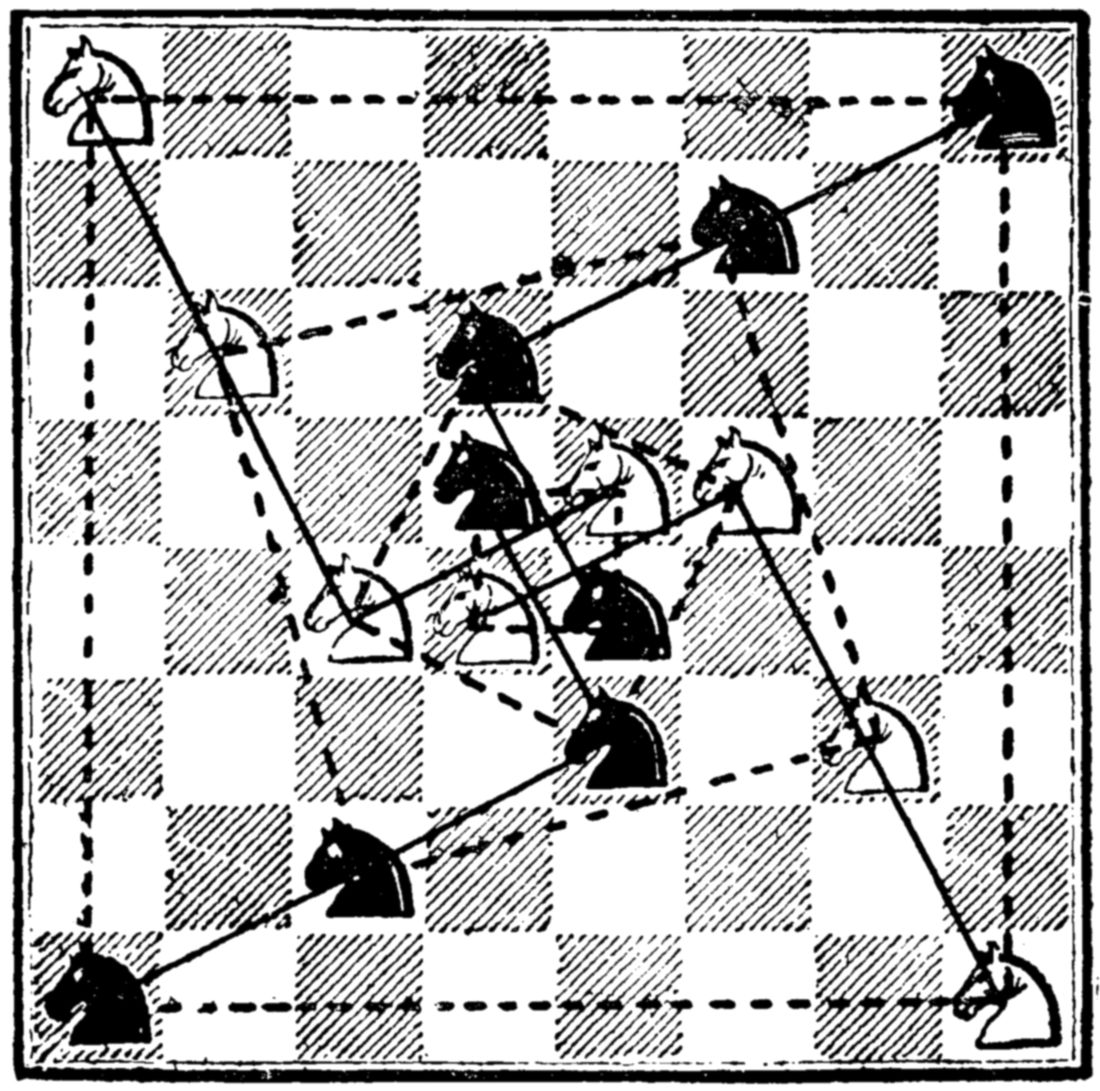
Return to description
[266]
No. XCII
The 5 maxims in these 36 cells—
| tell | you know | tells | knows | tells | he should not |
| do | you think of | does | thinks of | does | is not good |
| believe | you hear | believes | hears | believes | is false |
| spend | you have | spends | has | spends | he needs |
| judge | you see | judges | sees | judges | is not there |
| never | all | he who | all he | often | what |
are disentangled by reading the lowest line with each of the upper ones in turn. Thus the first maxim runs:—“Never tell all you know, he who tells all he knows often tells what he should not,” and so on throughout.
Return to description
[267]
No. XCIII
The dislocated circle is solved by making a single cut through the dotted line shown in the diagram below, and join up the pieces.
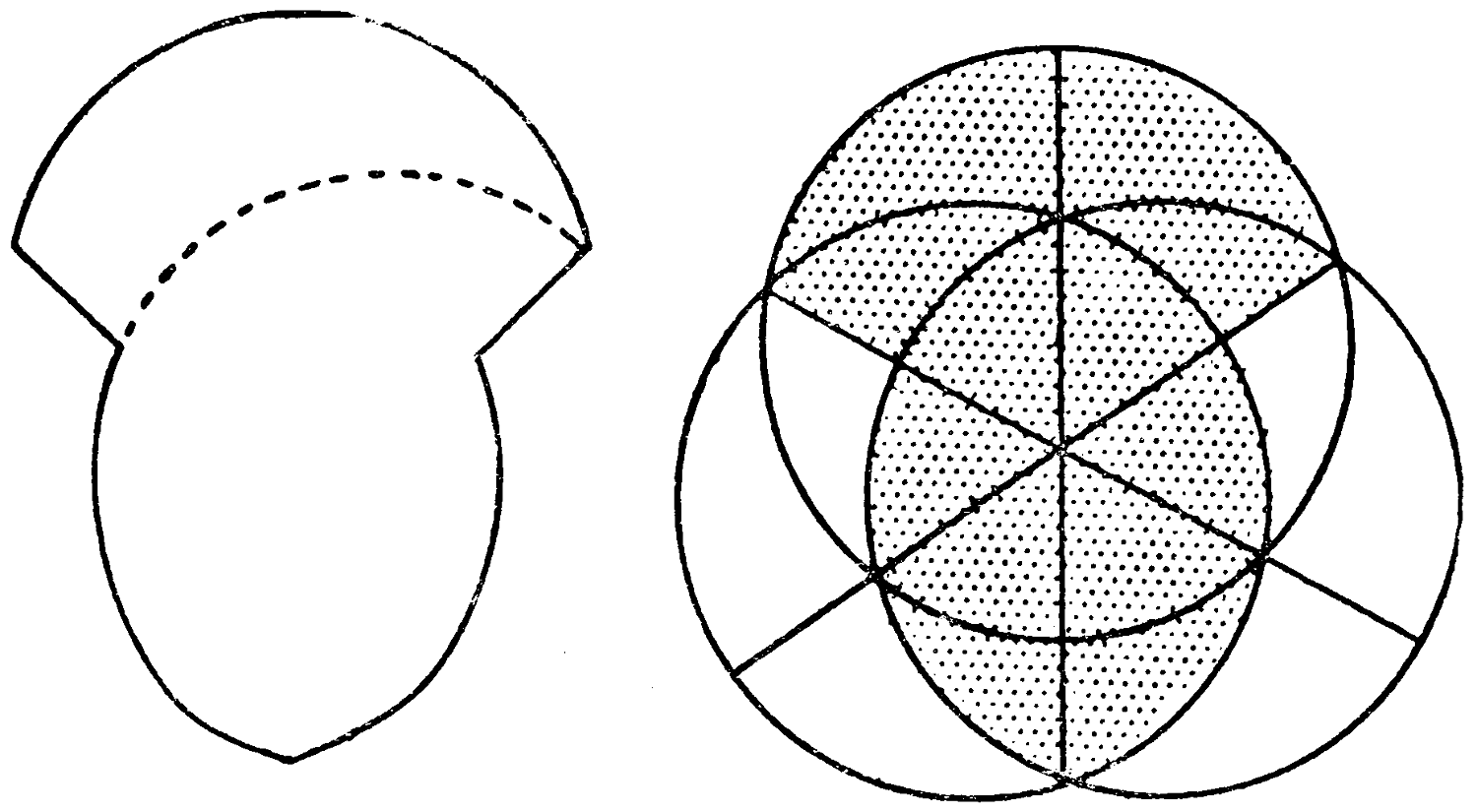
The second diagram shows how this figure is arrived at, by drawing three similar and intersecting circles, which have their centres at the angles of an equilateral triangle. The piece cut off by the dotted line corresponds to the section that completes the circle below.
Return to description
[268]
No. XCV
The catch-words Cleans, Scrubs, Scours, Polishes, which proclaim the merits of an “Old Dutch Cleanser” on the sails of this windmill,
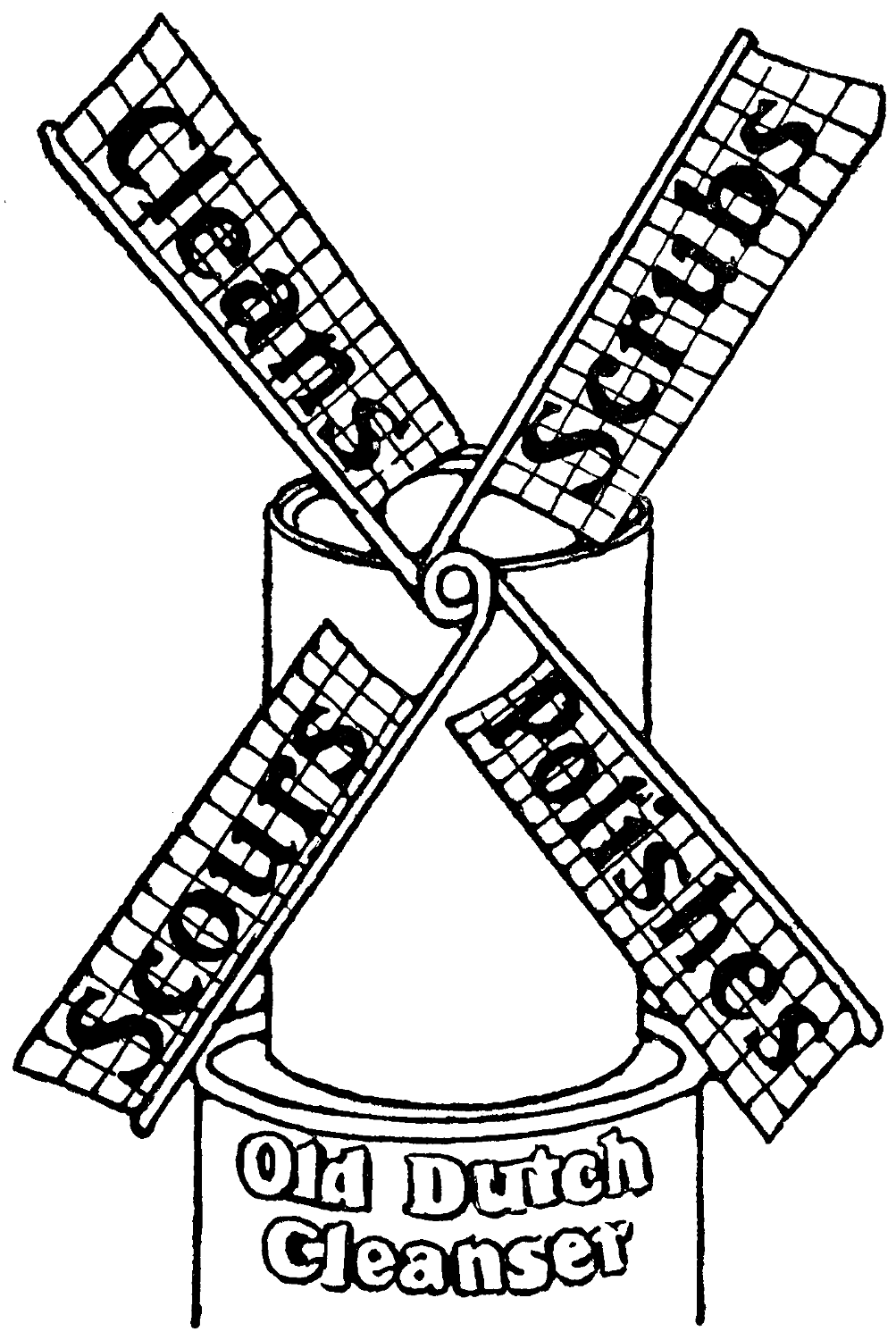
can be recast so that the same letters form the singularly appropriate sentence—
“O rub on, sir, success spells cash!”
Return to description
[269]
No. XCVI
The following diagram shows the solution of this new chess puzzle, and fulfils its conditions that no Queen should attack a Queen, no Rook a Rook, no Bishop a Bishop, and no Knight a Knight.
| B | B | B | B | Q | R | B | B |
| Kt | R | Kt | Kt | Q | |||
| Kt | R | Kt | Q | Kt | Kt | B | |
| Q | Kt | Kt | R | Kt | B | ||
| B | Kt | Kt | Q | R | |||
| B | Q | Kt | Kt | R | Kt | ||
| Kt | Kt | R | Kt | Q | Kt | ||
| R | B | Q | Kt | B | B | B | Kt |
Mr Dudeney explains that only 8 Queens or 8 Rooks can be thus placed upon the board, while the greatest number of Bishops is fourteen, and of Knights thirty-two. But as all Knights must be placed on squares of the same colour, while the Queens occupy four of each colour, and the bishops seven of each colour, it follows that only twenty-one Knights can be placed, and the arrangement shown above contains the maximum number of these pieces under the conditions.
Return to description
[270]
No. CII
This diagram shows the order in which the syllables or words of the eight-line verse are to be read on the course of a Knight’s moves at chess—
| 14 sor |
55 to |
22 king |
37 good |
12 say |
51 luck |
18 loy |
35 eth |
| 23 and |
38 moth |
13 a |
54 soon |
17 dis |
36 our |
11 to |
50 bad |
| 56 place |
15 ry |
40 church |
21 his |
52 force |
9 is |
34 hat |
19 al |
| 39 er |
24 queen |
53 him |
16 wight |
33 he |
20 to |
49 may |
10 truth |
| 2 man |
57 his |
28 and |
41 and |
8 chess |
61 es |
32 knight |
47 op’s |
| 25 a |
42 sneer |
1 the |
60 and |
29 un |
48 lawn |
7 of |
62 tates |
| 58 cas |
3 that |
44 at |
27 less |
64 pawn |
5 no |
46 bish |
31 lant |
| 44 eth |
26 faith |
59 tles |
4 hath |
45 the |
30 gal |
63 in |
6 love |
They run thus:—
Is, truth to say, a sorry wight;
Disloyal to his King and Queen,
A faithless and ungallant Knight.
He hateth our good mother Church,
And sneereth at the bishop’s lawn;
May bad luck force him soon to place
His castles and estates in pawn!
Return to description
[271]
No. CV
If such a network as is shown in the diagram below is drawn on clear tracing-paper and placed on the page of a book, it will conceal the words beneath it.
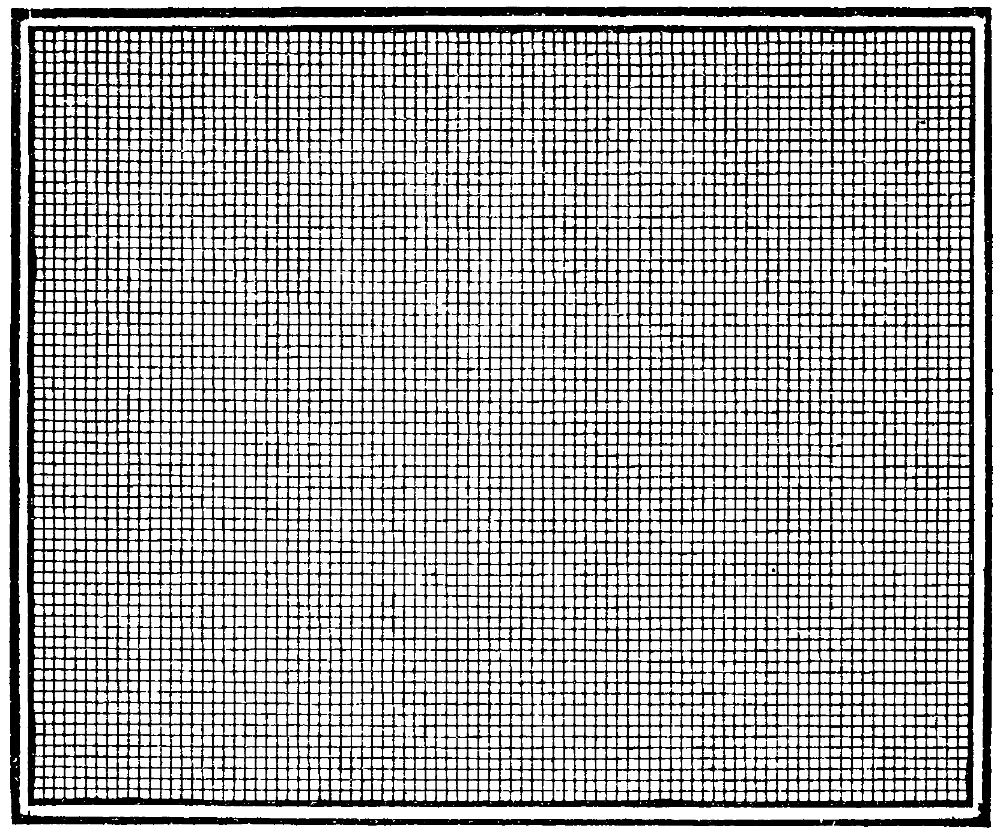
But if, while lying close to the page, it is moved quickly round and about, the letters and words will be distinctly seen, just as objects on the other side of close lattice-work become visible as we pass them quickly in a train.
Return to description
[272]
No. CVI
These are the results of cutting, in the direction of the dotted lines, completely round a simple paper ring, a ring with one twist, and a ring with a double twist.
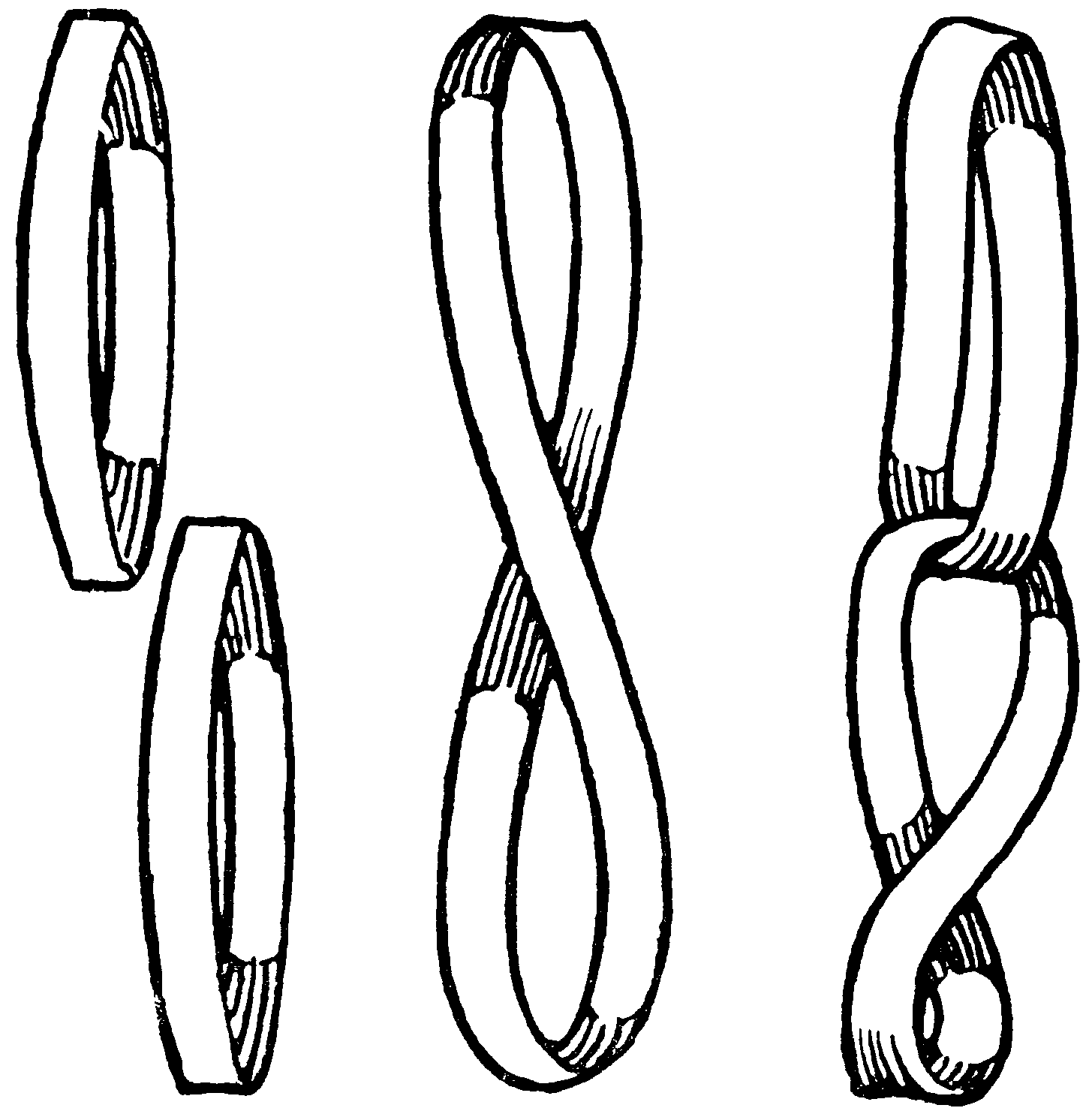
We have (1) two simple rings; (2) one large-twisted ring; (3) two rings linked together. If a third twist is given before cutting, a curious knot is formed.
Return to description
[273]
CVII
The string when it has been placed in the position shown in the diagram, and two buttons larger than the hole have been fixed upon its ends can be easily removed if the narrow slip of the leather is drawn through the hole.

Return to description
[274]
CVIII
The scissors, when securely fastened, as is shown in the diagram,
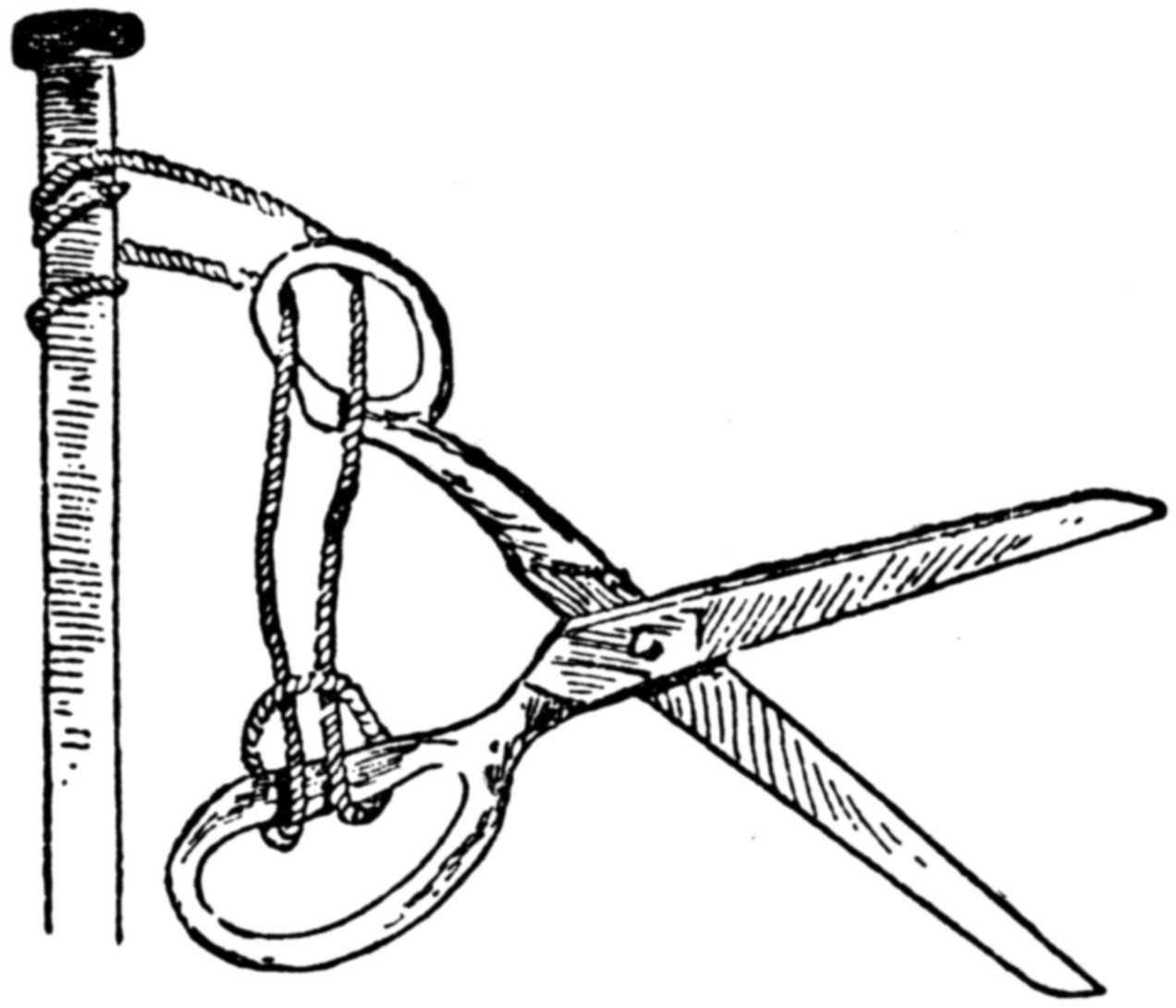
can be easily released by passing the loop upward through the handle, and then completely over them.
Return to description
[275]
CIX
The primitive wolf-trap consisted of two circular fences higher than a wolf could scale, with a gate as was shown on the former diagram. To set the trap a lamb was placed in the safe centre, and the gate was opened as is shown below—
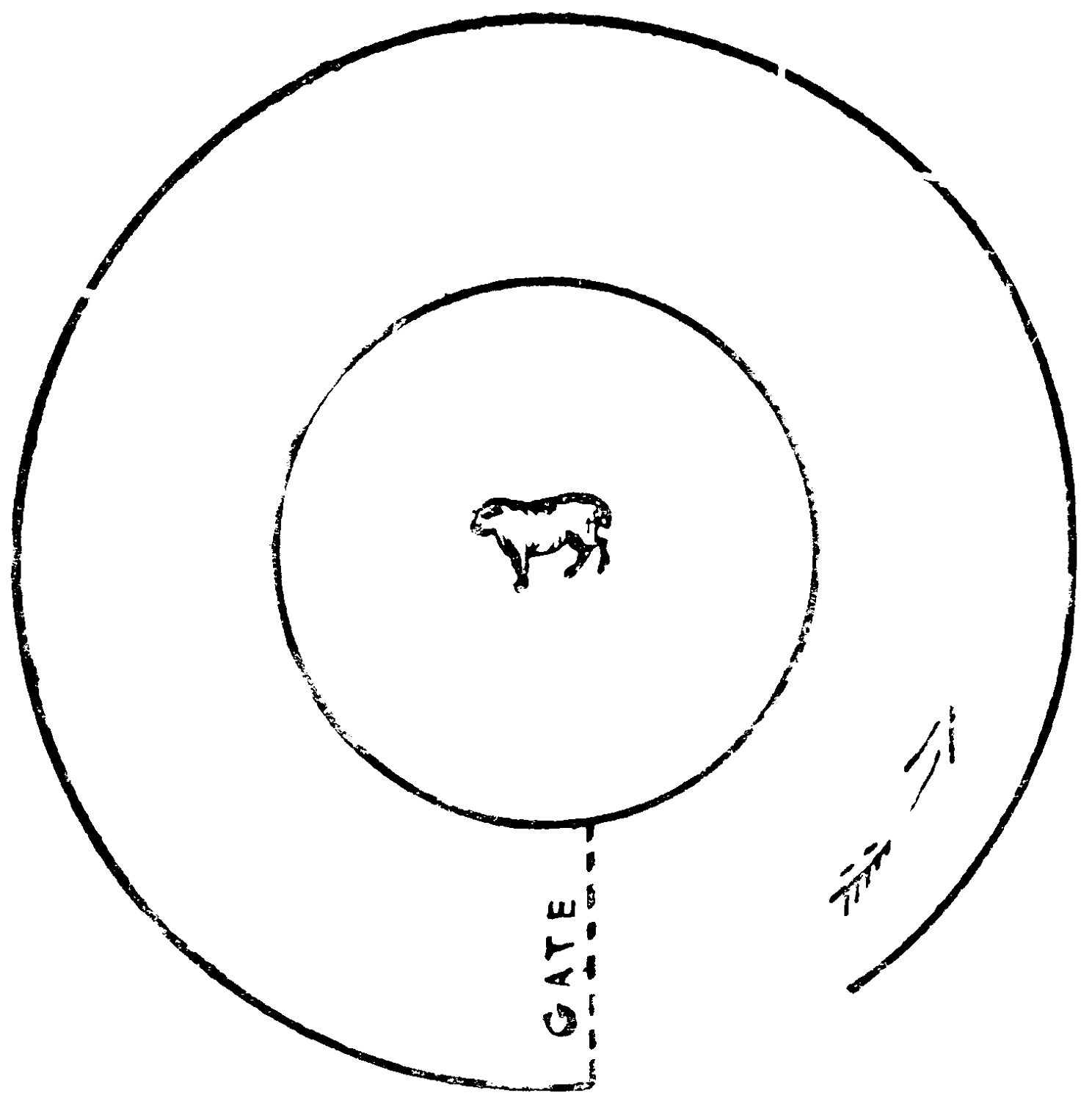
Attracted by the bleating of the lamb, the wolf entered the outer circle, made his way round, and presently pushed aside the gate, which closed with a spring, and shut off all escape.
Return to description
[276]
No. CXII
When you have told someone to think of a number between 5 and 15, and while you are not looking, to count upwards from the lowest card step, and round in the direction indicated by the arrow, until that number is reached, and then, starting afresh with “one” on that card to count backwards round the semi-circle, this time not including the central upright or the steps below it, until the number thought of is again reached,[277] you can tell at once which is the final card arrived at, for it will be as many places upwards on the left as there are step cards and their upright.
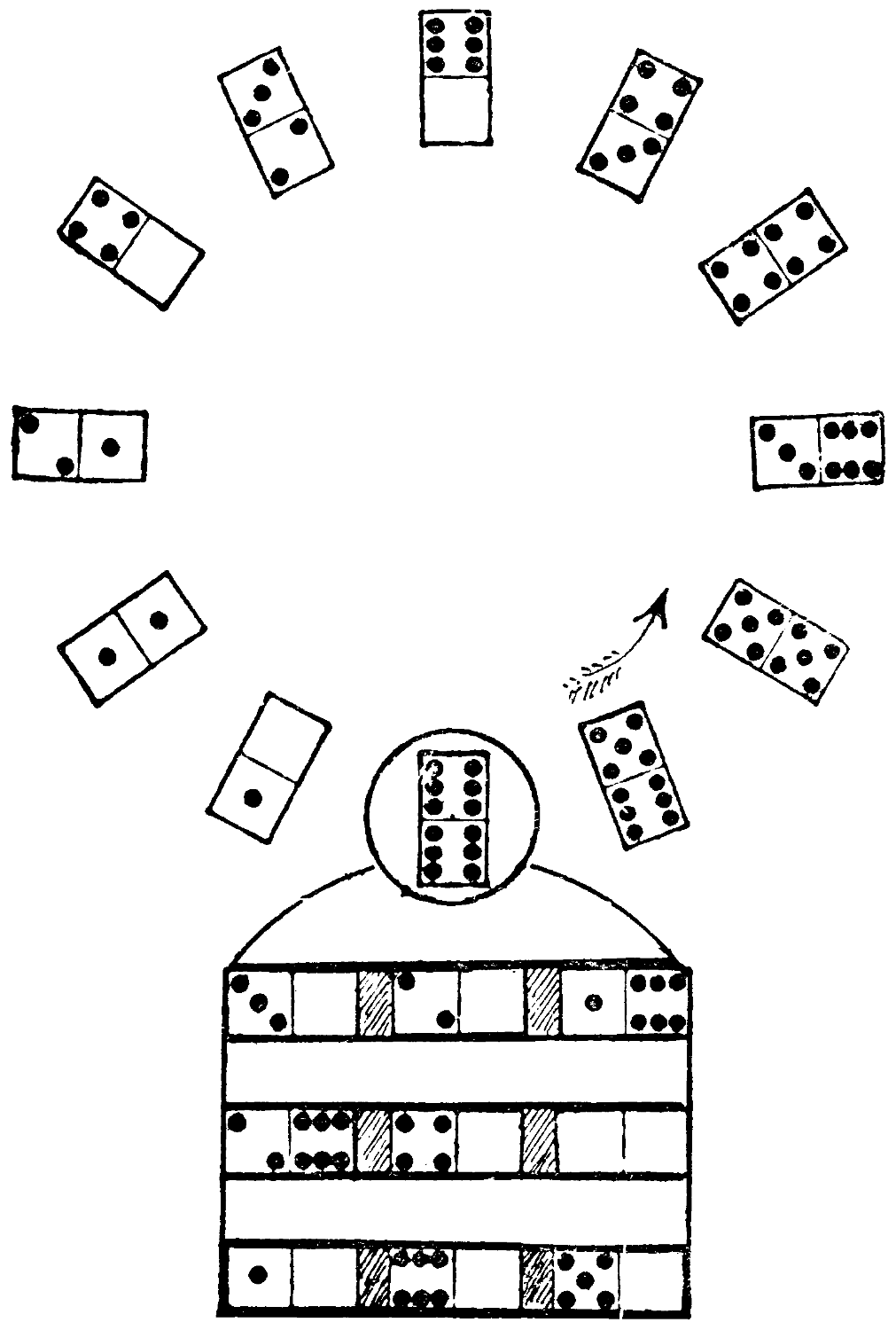
Thus if there are 3 steps, it must always be the fourth card upwards on the left of the semi-circle. To keep up the puzzle, the number of steps should each time be changed, on the pretext that their number does not signify.
Return to description
No. CXIII
This diagram shows how the apple may be divided into six pieces by two straight cuts, so that there shall be a gash in each piece.
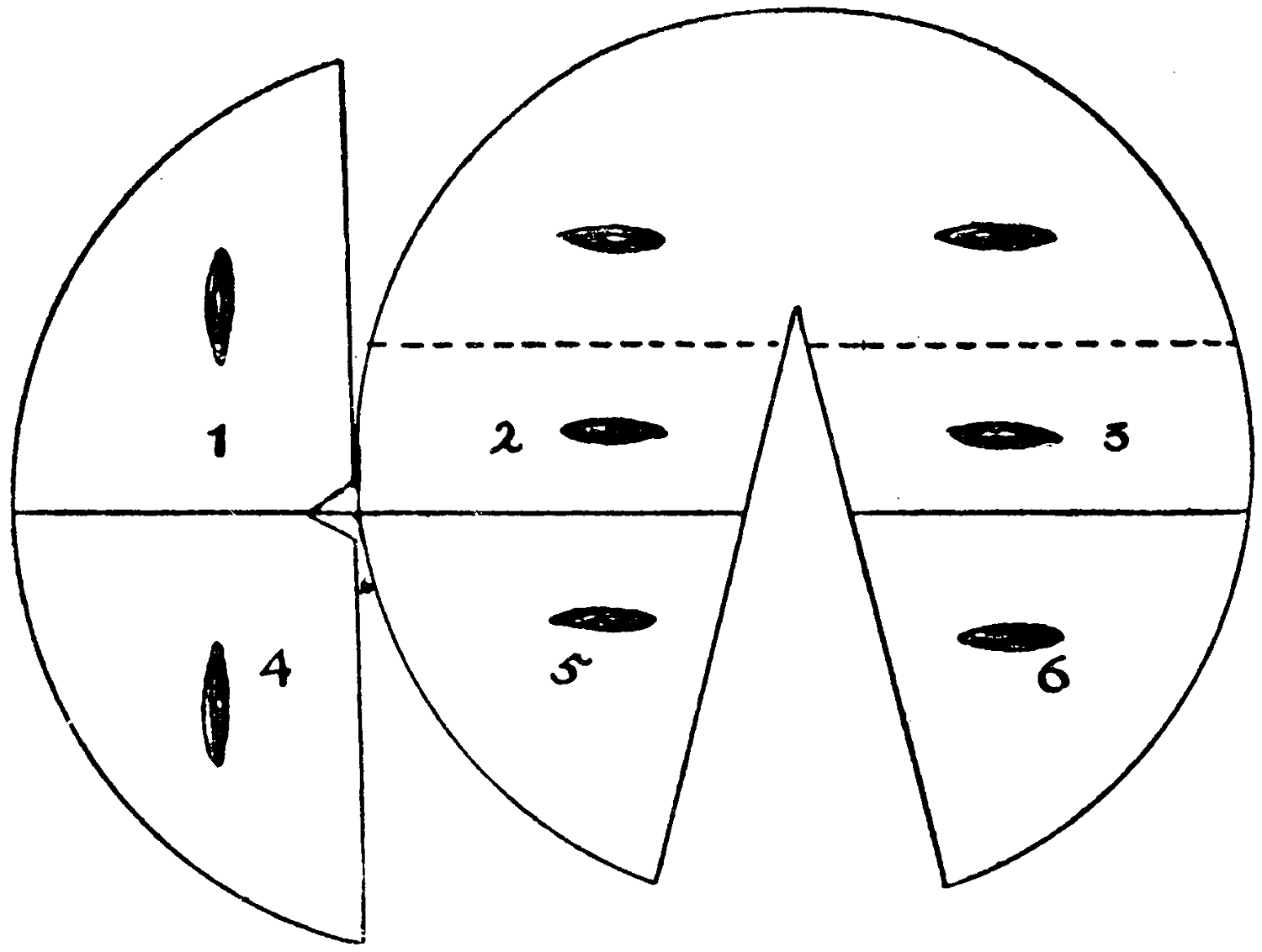
First cut the apple through the dotted line, then place the upper piece shown at the side of the larger piece, and make the second cut straight through, where the line is drawn.
Return to description
[278]
No. CXVII
The sixpence under the middle of the tumbler can be easily removed thus—
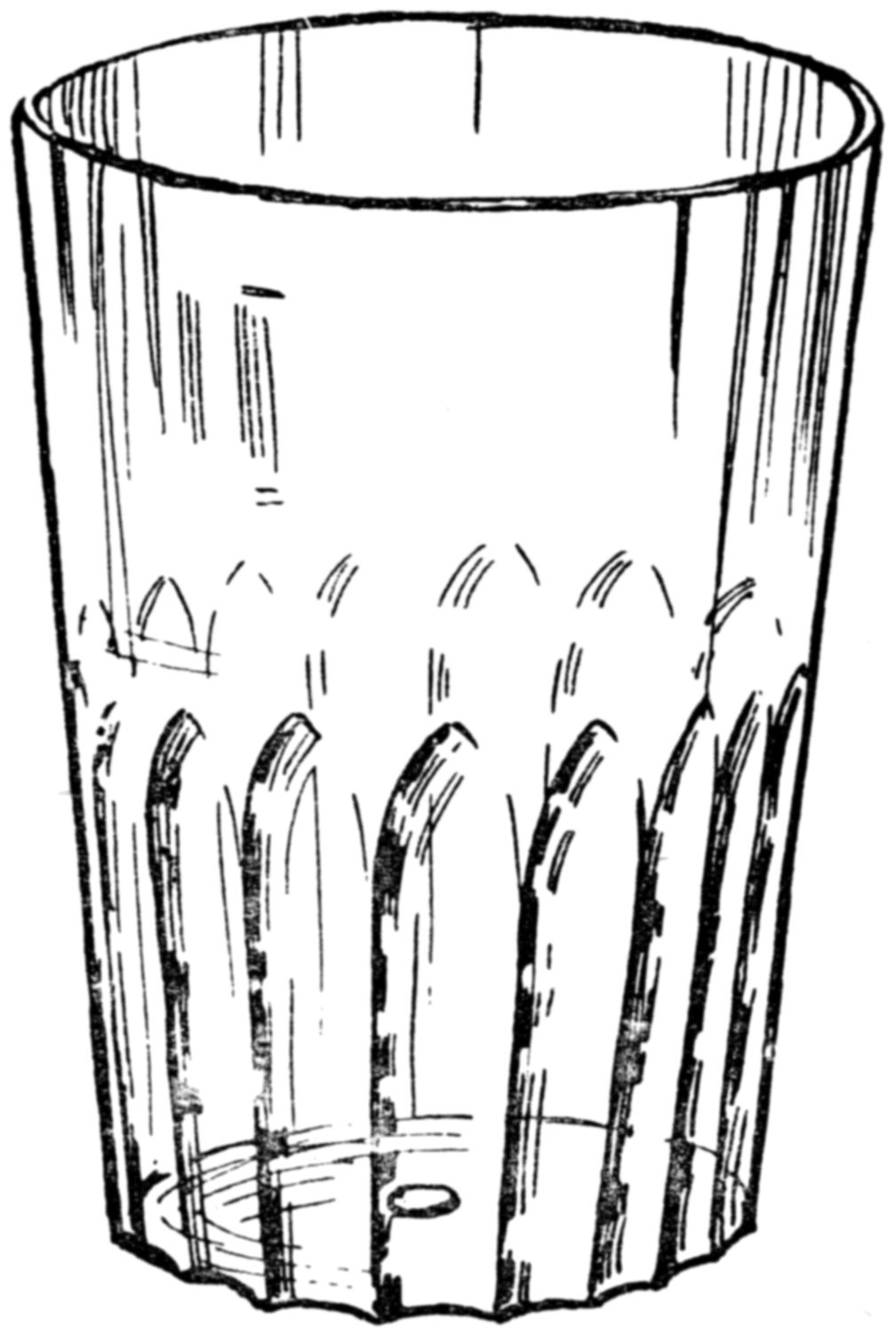
Slip larger coins under opposite edges of the tumbler to raise it slightly, and then scratch firmly on the cloth, from just outside the rim, in the direction you wish the sixpence to take. It will at once respond, and makes its own way gradually outside the circle that had surrounded it.
Return to description
[279]
No. CXVIII
This is the way to draw the spiral—
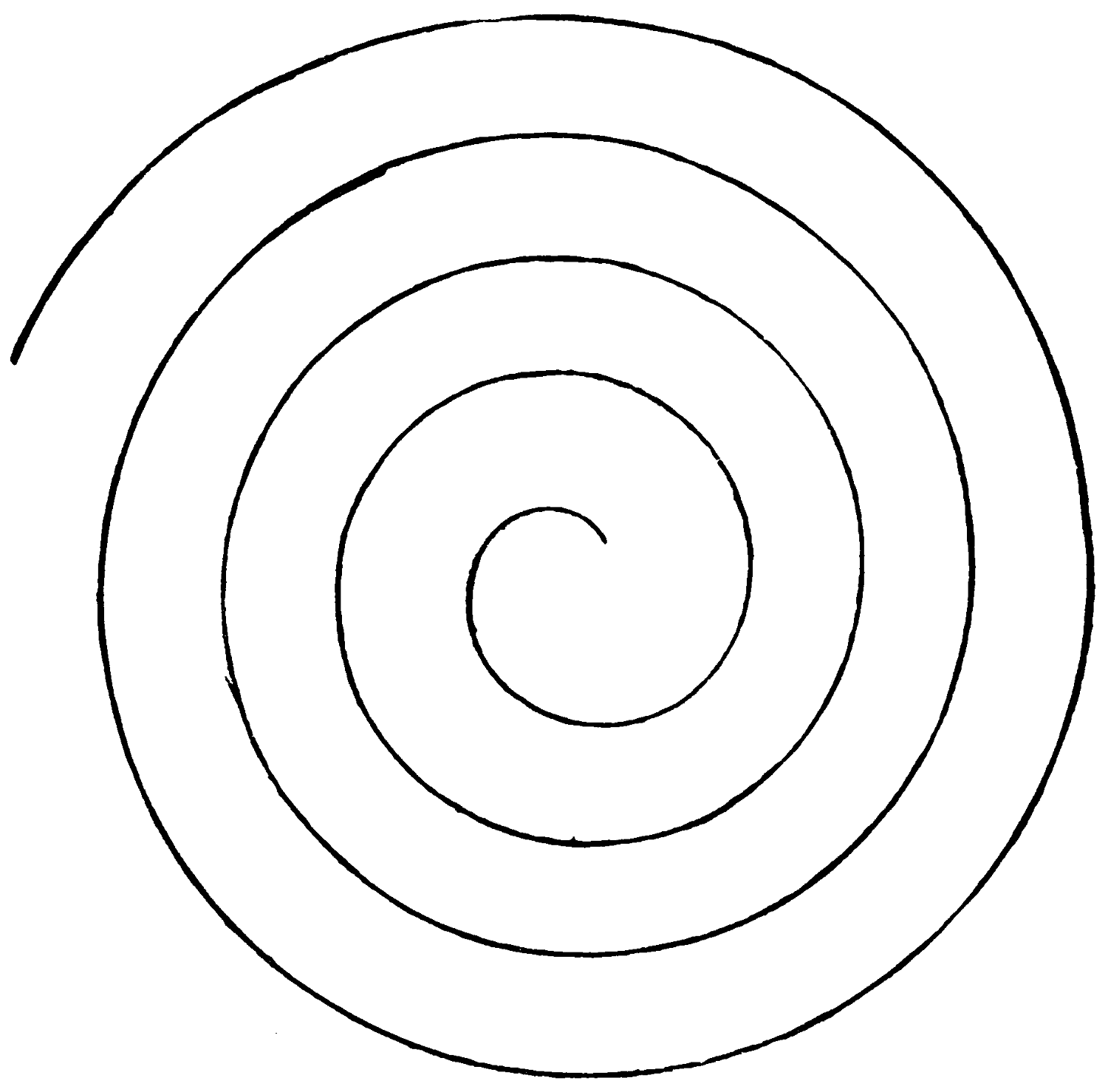
Tie a piece of strong thread with a loop at its end round the upper part of the windings of a screw. Drive the screw into a board, through the middle of a card, wind the thread down the screw so that its loop just reaches the card, place a pencil in this loop, and draw the spiral freely, unwinding the thread from the grooves of the screw, and keeping it always taut. A perfect spiral is the result.
Return to description
[280]
No. CXXII.
The secret of the talking head is simple indeed when you know it.
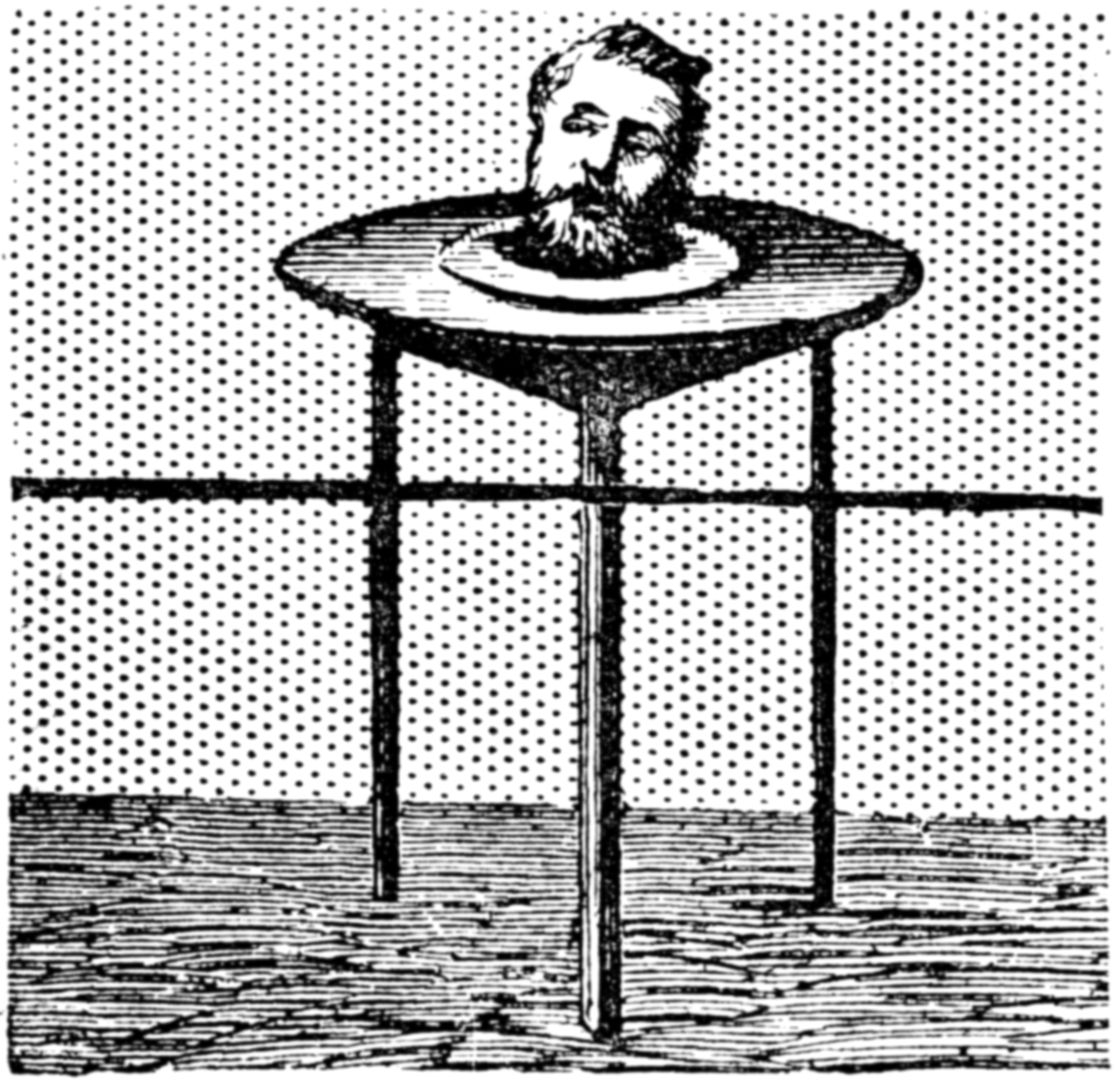
Between the front and two side legs of the table mirrors are fixed, which reflect the similar surroundings, so that the performer, kneeling behind these, and putting his head through a hole in the table top, completely conceals his body and limbs from the audience.
Return to description
[281]
No. CXXV
The picture charade is completed thus—
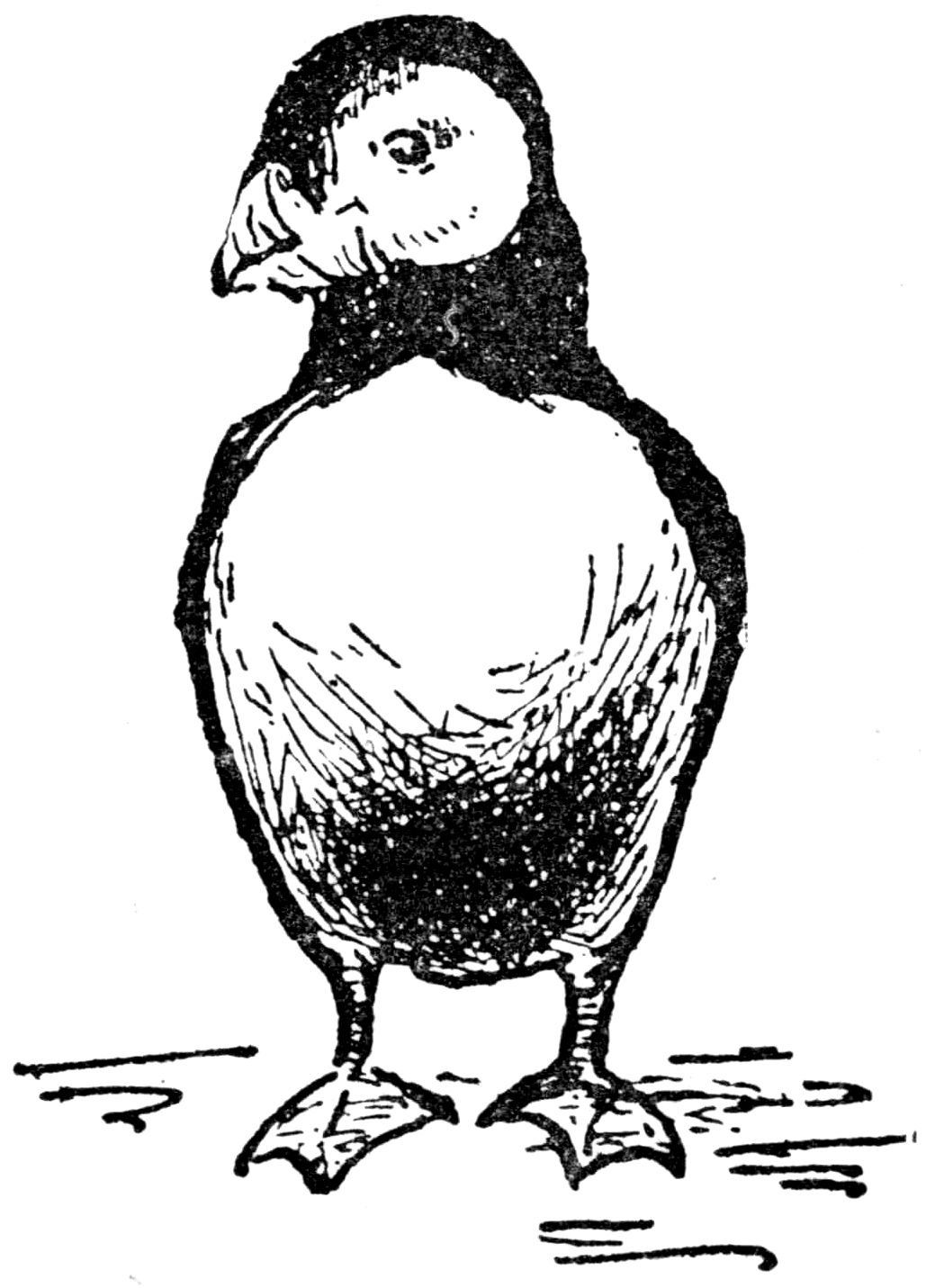
My second then comes in;
My whole in water moves about
Without an oar or fin—
and is solved by Puffin.
Return to description
[282]
No. CXXVI
When the walnuts and cobnuts have been arranged as is shown on the diagram—

they can be shifted so that they stand alternately, by moving two that are close together at a time, in four moves, as follows:—
(1) Move 2 and 3 beyond 8.
(2) Move 5 and 6 between 1 and 4.
(3) Move what are now 6th and 7th in the gap.
(4) Move what are now 1st and 2nd in the gap, and the alternate arrangement is complete.
Return to description
No. CXXVII
The question suggested by this picture riddle is: Why is a waiter like a racehorse? And the solution is: Because he runs for cups and plates.
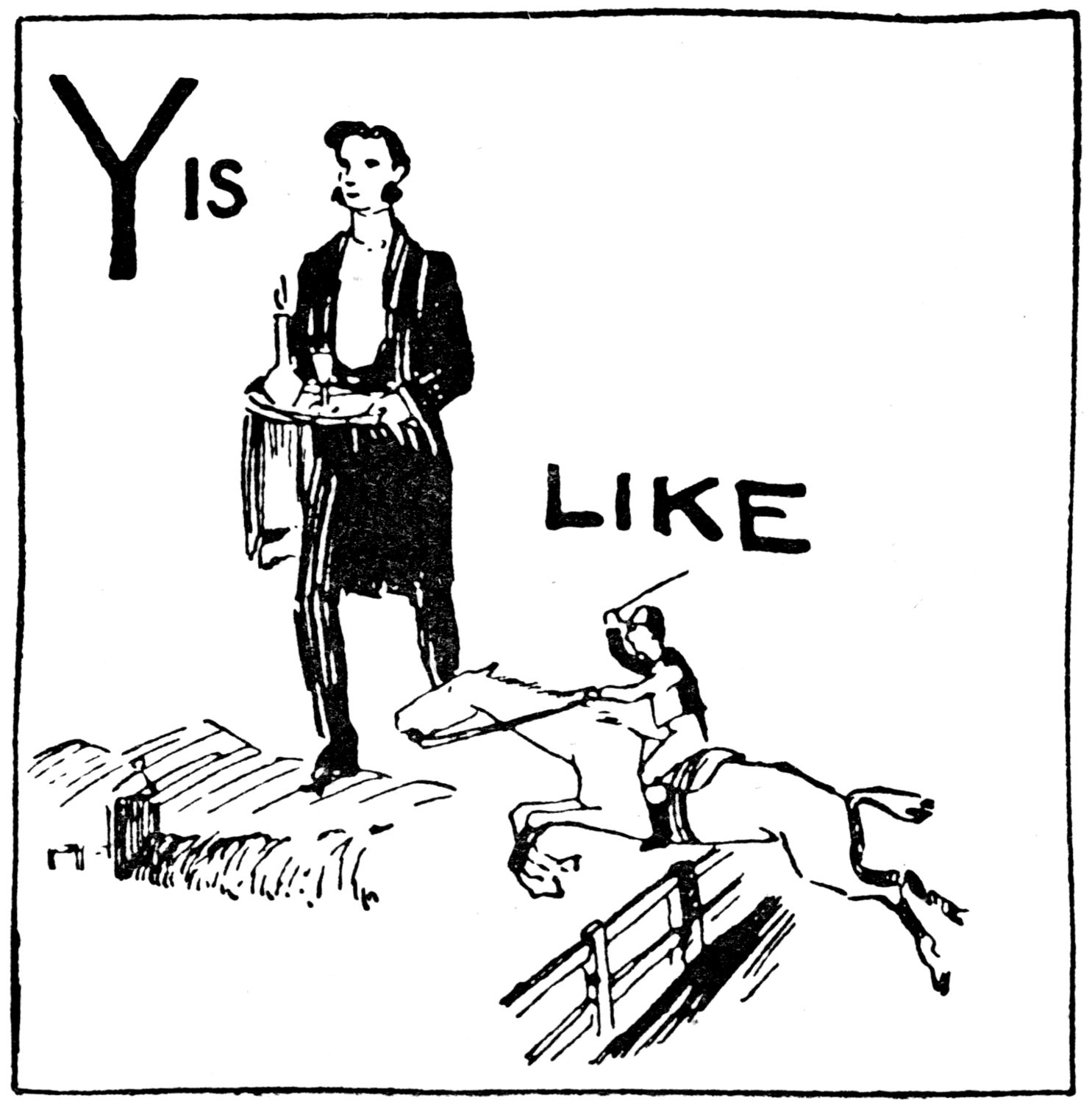
Return to description
[283]
WORD PLAY SOLUTIONS
1
The paradox—
And claim, through the passage of years,
That neither the pages of Johnson disclose,
While either in Murray appears.
is solved by the lines—
Johnson and Murray both give “neither,”
While, to complete the paradox,
Murray and Johnson both give “either!”
Return to description
2
The verse is completed thus—
Bulbs push, due culture nurtures fruitful flush;
Thrush builds, full sunhued plumes furze tufts unfurl,
Up bursts, pure flute-fugue, Bulbul’s tuneful gush.
Return to description
3
The enigma—
And both I sigh and see
Joined to my third, which much perplexed
And sorely puzzled me.
’Twas fifty, and ’twas something more,
Reversed ’twas scarce an ell,
With first and next it forms a whole
Clear as a crystal bell.
What is my whole? A splendid tear
Upheld in cruel thrall;
Blow soft, ye gales, bright sun, appear!
And bid it gently fall.
is solved by ICICLE.
Return to description
[284]
4
The charade—
Transpose one for my second;
My whole, a biped, quick or dead
Is dainty reckoned.
is solved by Pigeon (one becomes eon).
Return to description
5
Byron’s enigma—
But in infancy ever am known;
I’m a stranger alike to the fool and the sage,
And though I’m distinguish’d in history’s page
I always am greatest alone.
You may search all the sky—I’m not there;
In the morning and evening—though not in the noon—
You may plainly perceive me—for, like a balloon,
I am midway suspended in air.
I am never in sorrow nor gloom;
Though in wit and in wisdom I equally reign,
I’m the heart of all sin, and have long lived in vain,
Yet I ne’er shall be found in the tomb!
is solved by the letter I.
Return to description
6
Till you cut off my head;
Then as black as a coal,
Or a mortal instead.
Shaken up and recast
We with science are found,
Read us back from the last
And we live underground.
is solved by Star, tar, arts, rats.
Return to description
[285]
7
Horace Smith’s charade—
All prejudice must bend the knee before its iron will;
Yet “Onward!” is the Briton’s cry—a cry that doth express
A holy work but half begun, and speaks of hopefulness.
In palace or in lonely cot its name alike is heard,
And in the Senate’s lordly halls sit my second and my third.
Strange paradox, though for my first my total is designed,
Sad marks of vice and ignorance we in that whole may find.
is solved by Reformatory.
Return to description
8
Beheaded I lead upward more or less;
Again—with varied fragrance I am rife;
Again—but little value I express.
is solved by Nascent, ascent, scent, cent.
Return to description
9
The enigma—
A victory was won by me.
Behead me, and I may be found
In water or on hilly ground.
Behead again, and then transpose,
A snare my letters now disclose.
If yet again my head you sever,
No matter how sharp-set or clever,
’Tis all in vain you look about,
For no one yet has found me out.
is solved by Sling, ling, gin, in.
Return to description
[286]
10
The charade—
“Now I’d bet, were we not in this place,
That my first is my second a bottle of port,”
Then bright with my whole shone his face.
is solved by Pleasure.
Return to description
11
The answer to the problem—
Six horse ’buses and four motor ’buses travel each hour from Temple Bar to the Bank. The horses take 15 minutes, and the motors 10 minutes on the journey.
If I come to Temple Bar, and wish to reach the Bank as soon as possible, shall I take the first horse ’bus that turns up, or wait for a motor? It must be assumed that I can only see a ’bus as it actually passes me—
is (1) Take a motor if it comes first.
is (2) Take a horse ’bus if it comes first, and comes within 21⁄2 minutes of waiting.
is (3) Wait for a motor if a horse ’bus comes first, but does not come till after 21⁄2 minutes.
As I may have to wait 0 minutes or 15 minutes, the average time of waiting will be 71⁄2 minutes.
If I wait x min., and a horse ’bus arrives, I should reach the Bank in 15 mins, if I took it.
If I waited longer for a motor, which, on the average, will now turn up in 71⁄2 - x mins., I should reach the Bank in 171⁄2 - x mins.
If, therefore, x is greater than 21⁄2, the motor is the quicker.
Return to description
[287]
12
The historical charade—
May mar the future prospects of your life.
My second, by her fickle lord forsaken
(Sad type of many a gentle, patient wife).
May toil and moil to feed his many babies,
While he goes flirting off with other ladies.
The thrifty monarch of a former age
My whole a place in Britain’s history fills.
Immortalised in Shakespeare’s magic pages
As one who’d fain reform his tailor’s bills!
is solved by Stephen (Step-hen).
Return to description
13
My first had dangling at his side,
On chain securely hooked.
My first he came from o’er the sea,
A bundle of conceit looked he,
And he was all he looked.
Where in desponding mood was seen
My whole, with drooping head.
“Behold,” she said, “a perfect, true
And striking likeness, sir, of you!”
And, laughing, gaily fled.
is solved by Donkey.
Return to description
14
Lewis Carroll turns WHEAT into BREAD, changing one letter each time, and preserving their general order throughout, thus—
WHEAT; cheat; cheap; cheep; creep; creed; breed; BREAD.
Return to description
[288]
15
Unity is a probable solution of the old enigma, part of which evidently refers to “a house divided against itself”—
And very useful in my post;
There’s not a house in all the land
Without me properly can stand.
Though men disputed long ago
Whether I did exist or no,
Once more some thousands have been slain
Because they could not me attain.
Return to description
16
The anagram proverbs, “These grave lips chatter no ill,” and “Elephants, all to richest giver,” are both founded on Little pitchers have long ears, and spelt with exactly the same letters.
Return to description
17
The charade—
The rest is in a city found;
My whole to win its way is bound.
is solved by Pertinacity.
Return to description
18
The buried potentate in the lines—
My second in light, but not in sun;
My third is in night, but not in day;
My fourth is in game, but not in play;
My fifth is in head, but not in tail;
My sixth is in wind, but not in sail;
[289] My seventh in wrong, but not in right;
My eighth is in battle, but not in fight;
My ninth is in sword, but not in knife,
My tenth is in lady, but not in wife;
My whole is a monarch at war with strife.
is King Edward.
Return to description
19
The charade—
Is never seen or heard;
When it is heard the sound is tolled
Out of a Jewish beard.
My next was in imperial Rome,
It was her power and might;
Then you had but to write you wish,
And straightway ’twas in sight.
Of royal rank.
is solved by Clovis (vis in Latin is both power and you wish).
Return to description
20
Oft have I saved a castle tower
From war’s invading tide.
Transpose me, and how great my fall!
I am then the smallest of the small,
That nothing can divide.
is solved by Moat—atom.
Return to description
21
The puzzle—
All apart its letters shake.
Let your 6, 3, 5 be high,
Like 5, 1, 2 do or die.
[290] Who 4, 6, 5, 1 enjoys
More than 5, 6, 2 by boys?
While 5, 3, 2, 1 are mine,
May 4, 6, 3, 2 be thine.
4, 1, 5 is rich and rare,
6, 5, 1, 2 ends my prayer.
is solved by the word Enigma, from which are formed, as is indicated, the words aim, men, game, man, mine, gain, gem, and amen.
Return to description
22
The enigma—
Half an hour after his head was cut off.”
Old Couplet.
A warrior formed to deal a heavy blow.
Halve what remains, my second is a thing
Which nothing but my third can e’er make go,
My third will vary as you take your line,
This less than human, that way all divine!
is solved by Dog (Og, go, dog, God).
Return to description
23
The logograph—
Behead, I’m used by rich and poor;
In house and cottage, hut and hall,
I stand of service to them all.
Behead again, in time of need
I tell that strength and skill succeed.
is solved by Stable, table, able.
Return to description
24
The names that satisfy the conditions of this Single Acrostic—
[291]
Which Pope says does with eels abound?
What Scottish lake, by high hills bounded,
Is with bright birch and oak surrounded?
What stream is said in Devon to run
Into the sea near Otterton?
What bay on Cuba’s distant coast
Is justly deemed its pride and boast?
The initials of these names will show
A Scotch reformer, who, we know,
Flourished three hundred years ago.
are Kennet, Ness, Otter, Xagua, which give Knox.
Return to description
25
The charade—
So former may, or latter;
But twist my tail, and I become as mad
As any hatter!
Who never was called mister;
Cut off my tail, and instantly I can
Become a sister!
is solved by Madam (ma, dam, mad, Adam, Ada).
Return to description
26
In addition to the singularly appropriate anagram that has been so happily attached to the name of Florence Nightingale, Flit on, cheering angel, the same group of letters can be recast as an aspiration for her continuance in our loving memory, so that they form the sentence, Cling on, feeling heart.
Return to description
[292]
27
The rebus—
I am
a man
I rate you
a beast
You know me
reads thus:—I rate you lower than a man, above a beast. Know between you and me I am above the rest.
Return to description
28
The charade—
Rome’s fate my next, and one that all may dread.
Long may it be before that fate shall come
And sever with my whole thy life’s last thread!
is solved by Scissors (Lat. scis, thou knowest; sors, a lot).
Return to description
29
The poets’ names buried in the lines—
Upon the moor, enchanting spot;
Whose purpled heights, by Ronald loved,
Up open to his shepherd cot.
Are flying—aye, each to his nest;
And eager make at such an hour
All haste to reach the mansions blest.
are Gray, Moore, Byron, Pope, Dryden, Gay, Keats and Hemans.
[293]
Return to description
30
The enigma—
Though it reduces one;
A sty is foul if it is there,
By it a deed is done.
is solved by the letter n (me becomes men; one, none; a sty, nasty.)
Return to description
31
Studying Praed’s fable;
Lennie’s mother rasped the bread,
Sophy drapes the table.
“Work while you are spared,” they said,
“Spread while you are able!”
The words in italics have the same letters.
Return to description
32
The charade—
My whole is quite sure to be in.
Divided afresh, there is reckoned
A wit, or a something that’s thin.
Prefix a letter, and, as clear as paint,
You see the name of an old English Saint,
is solved by Within (Swithin).
Return to description
33
The puzzle lines—
To a slight noise may turn;
My second-twist, a stately word,
And it will bend we learn.
are solved by Pardon (rap-nod).
Return to description
[294]
34
The enigma—
Then half a score.
When this is duly done
Almost ten more.
This can be good for none,
But trial sore.
is solved by Vixen.
Return to description
35
The buried proverb—
I fancy this Tory outcry, this weary outrageous attempt to show illegality, is as a cat chasing snow-flakes. I must be forgiven if I shun his example—is—
If you swear you will catch no fish.
Return to description
36
Like reevers of ropes far too rotten to hold,
Reserve a severer reverse and disasters
For a State that reveres not incapable masters.
The six words in italics are spelt with the same letters.
Return to description
37
My second a snare,
My whole is the offspring of fancy,
Which I sent on its way
Last Valentine’s Day,
As a token of love to my Nancy.
is solved by Sonnet.
Return to description
[295]
38
The lover’s vow—
Shall never be my second;
It shall my all, come best, come worst,
Be surely reckoned.
is solved by Endless.
Return to description
39
The enigma—
I am a tree, I am a name,
Cut me in pieces with a sword,
You and your act would be the same.
Thrice you must leave the aspirate in doubt,
And use it twice if you would find me out.
is solved by U, You, Hugh, Yew, How.
Return to description
40
If you “resist disasters,” this may, by anagram, distress a sister.
Return to description
41
The charade—
When in rich hues it glows.
My next has vowels three;
My third was once a tree.
My fourth begins the year,
My whole the past makes clear.
is solved by Archæology.
Return to description
42
If you ask a schoolboy to estimate the value of the grass in a triangular field, of which the longest side measures 100 rods, and each of the other sides 50 rods, at £1 per acre, it may take him some little time to see that he is being sold, since the condition is not fulfilled that any two sides of a triangle must be greater than the third side.
Return to description
[296]
43
Between my first and second:
Second has body, arms and face;
First is by inches reckoned.
is solved by waistcoat.
Return to description
44
The historical charade—
And at its sound the soldier springs to arms;
My second nowadays fair ladies scorn,
Though in less dainty days it oft was worn.
My whole, a battle fought on Scottish ground,
With victory the rebel forces crowned.
is solved by the battle of Drumclog.
Return to description
45
Each spouter a Proteus in versatile skill;
Each posture so quaint, each idea so profound,
My barn’s at their service, whenever they will.
A company played there last night, but to-day
Ducks, pouters, and poultry have vanished away!
The five words in italics are spelt with the same seven letters.
Return to description
46
The Arithmorem “150 hat robe or tent” forms the name Charlotte Bronte.
Return to description
47
The Shedding Letters enigma—
Of all that are busy in country and town.
[297] Take from me one letter, and yet my good name
In spite of this loss will continue the same.
Take from me two letters, and still you will see
That precisely the same in effect I shall be.
Take from me three letters, or even take more,
Yet still I continue as sound as before.
is solved by The Postman!
Return to description
48
When Tom Larkins challenged his sisters to prove on a blackboard that if 50 is subtracted from the sum of the nine digits the result equals the number obtained by dividing their sum by 3, he showed them that the sum of the digits may be written thus: XLV, and that if the L, which represents 50, is removed, XV, or 15, the third of 45, remains.
Return to description
49
In the “Geese to Market” problem—
And met with Farmer A;
Said Farmer A, “How much apiece
For this lot did you pay?”
Said B, “I paid for all I drive
Just six pounds and a crown,
And I am selling all but five
At the next market town.
If fifteen pence a head I charge
Beyond the price I paid,
I shall secure a sum as large
As he who sold all made.”
B bought 25 geese at 5s. each, and proposed to sell 20 of them at 6s. 3d.
Return to description
[298]
50
The charade—
For best or for worst,
I thought myself happy to win her.
But what could I say
When the very next day
She gave me the whole for my dinner?
is solved by Herring.
Return to description
51
In the lines—
Blending so sweetly with the restful air;
The noiseless, deep-laced twilight shadows come,
And well I ken the lass who meets me there—
the familiar adage, “Be it ever so humble, there’s no place like home” is buried.
Return to description
52
The mutilations in—
Becomes a mighty beast instead:
But then the subject of my riddle
Is cut asunder in the middle;
And nothing this division gains,
Though unknown quantity remains.
are Fox, ox, o, x.
Return to description
53
Writing tales dramatic.
Did she steal the plots she planned?
Negative emphatic!
Stale to us the tales may be,
But at least they’re new to she!
Return to description
[299]
54
The old Sanscrit problem, quoted by Longfellow in his “Kavanagh,”
Ten times the square root of a flock of geese, seeing the clouds collect, flew to the Manus lake. One-eighth of the whole flew from the edge of the water among a tangle of water lilies, and three couple were seen playing in the water. Tell me, my young girl with beautiful locks, what was the whole number of geese?
is solved by 144.
Return to description
55
The enigma—
That if you divide the whole number by three
You find the result will exactly express
The half of six hundred and sixty, no less—
is solved by turning the sixes of 660 upside down, when it becomes 990, and satisfies the conditions.
Return to description
56
The press parody ran thus—
It cost very little to dress her;
Some breadcrumbs and thyme
About Thanksgiving time,
And they ate every bit from the dresser!
Return to description
57
He joins them after tea;
But both are swept by ruthless tides
Away on the western sea.
is solved by Hebrides.
Return to description
[300]
58
If I have 91 bananas on my barrow, and find, when I have sold one quality at four a penny, and the other at three a penny, that in mixed lots at seven for twopence I should have made a penny more, I had 64 of inferior and 27 of better sort.
Return to description
59
The words in italics have the same letters—
When rates are high, results are low.
His borders tares and bindweed spoil,
No careful culture tears the soil;
What weeds that stare are all alive
Where aster, pink, or rose should thrive.
Return to description
60
Varied, but welcome everywhere;
But met with in the open field
I’m banned if frequent, blest if rare.
To this peculiar difference the clue
Is called with much significance the cue.
is solved by Cheque, check (the letter Q).
Return to description
61
The three towns buried in the lines—
On holiday intent;
The best I’ve seen is surely Dover,
That pretty port of Kent.
are Leith, Thebes, St Ives.
Return to description
[301]
62
With a donkey bearing an obelisk;
But he did not venture to ford the tide,
For he had to good an ass to risk (asterisk).
Secure till the tide had ceased to swell,
For he knew that whenever the donkey died,
No other could be its parallel (‖).
Return to description
63
The charade—
While my final you can find in Amsterdam.
Think how a sound whole stays your hunger and your thirst,
Deftly readjusting bread and meat and jam.
is solved by Dietary (Amsterdam is on the River Y).
Return to description
64
The schoolboy who calculated that if he had made as many more runs at a cricket match, and half as many more, and two runs and a half, he would have made a score, scored seven runs.
Return to description
65
The enigma—
Of two in love made one.
The same six letters tell the fate
Of marriage ties undone.
is solved by United, untied.
Return to description
[302]
66
The riddle—
These own the rest of all my lay;
Busy my third; fourth like the pole,
Whose opposite my fifth makes goal.
is solved by Shackle, Tons, Ant, Arctic Expedition.
[Lieutenant Ernest H. Shackleton, R.N., leader of his South Polar Expedition.]
Return to description
67
Ere we were sent to Lord’s;
Alas! the score our champion made
Was what a nest affords.
The crowd in tens of thousands came,
But took scant notice of the game.
The words in italics have the same letters.
Return to description
68
When Edwin and Angelina received these mutual Marconigrams—
“No fickle girl is bonnie to my mind.”
“In love inconstant I no pleasure find,”
he was at Lisbon and she was at Constantinople, as is indicated by the fact that the names of these places are “buried” in the messages.
Return to description
69
The Mental Arithmetic—
Then multiply by four;
This, if you use the proper sign,
Makes five, and nothing more.
is solved by 1.25. In 11⁄4 the figures are not in a line.
Return to description
[303]
70
The doublet by missing words, in which a grilse is turned into a salmon, is solved thus—
The grilse of silver, sailer gay,
Guides on; the sailor morals draws
When salmon follows Nature’s laws.
One letter is changed in each link.
Return to description
71
The enigma—
From place to place all day;
Some loving swain, hot foot for fun,
Sees Dora in my way—
is solved by Road, which spells also Dora.
Return to description
72
The Letters—
HAATTCEUMSSSS
form the name of the State Massachusetts.
Return to description
73
The enigma—
Six English, and one Latin;
No need to twist them, or afresh to mix,
If puzzles you are pat in.
is solved by There: the words are—there, here, her, the, ere, he, re.
Return to description
[304]
74
The full solution of the answer by anagram to the question, “Why is every angler ipso facto an Ananias?” is—
A liar, he spins gay fancies to a woven yarn.
Question and answer are spelt with the same letters.
Return to description
75
The quaint riddle—
Will never go right;
Shall I tell you the reason why?
Wherever he goes,
He follows his nose,
And that stands all awry!
If this appendage had slanted more.
Why would it serve a hole to bore?
is solved thus—It would be Askewer (a skewer!)
Return to description
76
“S” is the missing letter which occurs 55 times, and these are the four lines:—
Assist us to assess success or loss.
Spring’s sweetness still possesses mossy grass,
As summer’s tresses mass soft shades across.
Return to description
77
The enigma—
Without my tail I’m flat;
I’m round, curtailed again;
Again, you have me pat!
is solved by Patent, paten, pate, pat.
Return to description
[305]
78
The logogriph—
But take a letter out,
That change of fare is ruling there,
You see, without a doubt.
Behead me twice; it is not nice
To have this in your skin;
Lop head and tail, and find a nail
Or tack to drive it in.
Behead this right, and in your sight
A little word you find;
But you will never make it out,
Though it is in your mind.
is solved by feasting, fasting, sting, tin, in.
Return to description
79
In many a burglary tried;
But when he prised open the till
There was only a spider inside.
The words in italics are spelt with the same letters.
Return to description
80
The enigma—
Three-fourths a bed for man;
Three-fourths have legs that cannot stray,
Three-fourths have legs that can.
I have a back without a spine,
An arm without a bone is mine.
is solved by Coat.
Return to description
81
The charade—
My whole a narcotic is reckoned
is solved by Lethe.
Return to description
[306]
82
The two palindrome words which can be formed from the letters of the sentence “Arrive to vote at it,” are Rotator and Evitative.
Return to description
83
The enigma—
Sweet-hearted then I show;
Decapitate again, I spread,
And cannot be below.
Served so once more, I am not dead,
But with fresh beauty glow.
is solved by Clover, lover, over, ver (Latin for Spring).
Return to description
84
When Tommy undertook to put a shilling in his money-box if his father would give him as much as he had in his purse, and after repeating the process for three more days found himself penniless, he had elevenpence farthing in his purse at first.
Return to description
85
And three from foreign source.
All these together you must take
Where dramas run their course.
is solved by Theatres (tres, Latin for three).
Return to description
86
When young Hopeful said, “If it were possible I should choose a life double as long,” and old Sobersides answered, “Yes, and you might turn it to better account if it was also begun old,” and the fact that their actual words “double as long,” and “also begun old,” were spelt with exactly the same letters, gave emphasis to the reply.
Return to description
[307]
87
The charade—
I have both tail and head.
Or if for spirits you’ve a mind
Set my tail first instead.
With many a darker page,
My whole in picture will disclose,
For “all the world’s a stage!”
is solved by Drama, ram, a dram.
Return to description
88
With patterns that true art has traced.
The words in italics have the same letters.
Return to description
89
The proof by anagram that the words of commendation “blessed in pain,” are properly applied to anæsthetics, is that exactly the same letters spell indispensable.
Return to description
90
The quotation buried in the sentence—
“What sin was it, sonny?” said an American negress to her lover, when she sat on his best hat, which was flattened. Wearily he heard her musical laugh, and arose to go. His hobby was botany, but not hers, for she was then a merry girl. “Bother the flowers! I would prefer this mellow pineapple, Leonidas,” she said; “I guess we Ethiopians just love fruit!”
is “What’s in a name? That which we call a rose by any other name would smell as sweet.”
Return to description
[308]
91
That half the garb gives way:
And home return with purses lean
To brag of “bargain-day”!
The words in italics are spelt with the same four letters.
Return to description
92
Out into the West as the sun sank low;
Each thought as she sailed of the lad she loved best
For they all had ideals, and each had a beau.
......
And they all were too ill of ideals to think,
So these ladies sailed back moaning!
The words in italics have the same six letters.
Return to description
93
The charade—
My second should in ample stores abound,
Or help to make the sweetest songster heard.
Peculiar, and quite proper, is my third.
My whole has found with England’s monarch grace,
The verdant home of many a goodly race,
is solved by Punchestown.
Return to description
94
The enigma—
An opening I appear;
In other fashion said
I charm all far and near—
is solved by Entrance.
Return to description
[309]
95
The two sentences—
A lamp shines out for thee,
Win me best by tears,
are anagrams of The Houses of Parliament and Westminster Abbey.
Return to description
96
When on the Brighton beach an excited collie in pursuit of stones thrown into the sea, suggested the riddle, “What is the difference between that dog and a hungry man?” The appropriate answer was, “The one stops and shakes himself; the other chops and steaks himself!”
Return to description
97
The hidden animal in—
A part in hail must be,
A part belongs to pain,
A part in bones we see,
A part in gleaming gold,
A part in common copper.
A part in peace behold,
A part in any topper,
Two parts are heard in sound,
And in our finals found.
is Rhinoceros.
Return to description
98
The smart enigma—
Book-learning I never could boast;
Yet I turn the leaves inside the cover,
And when I am found I am lost.
is solved by A Fox.
Return to description
[310]
99
Comparative, a toast is like a sot;
For when their substances in liquor sink
Both properly are said to be in drink.
The words in italics are spelt with the same letters, the t being repeated in toast.
Return to description
100
The pied proverb is “Fine words butter no parsnips.”
Return to description
101
The puzzle verse—
In youth its joys none need descry;
But where our elders take to it
Its name points loss of dignity,
is solved by Badinage (bad in age).
Return to description
102
The hero’s name, hidden in—
My next’s in praise, but not in bliss;
My third’s in man, but not in miss;
My fourth’s in we.
My sixth’s in cat, but not in dog;
My next’s in calm, but not in fog;
My eighth’s in we.
My tenth’s in light, but not in shine;
My next’s in four, but not in nine;
My twelfth’s in we.
is General Wolfe.
Return to description
[311]
103
Here is the sentence given with its appropriate and perfect anagram—
A defeat whose test is very sure.
Sweet are the uses of adversity.
Return to description
104
The phonetic missing words are given in italics:—
To pare a pair of pears;
A rake may often take a rake
To tear away the tares.
Return to description
105
The queer obstacle—
Yet no one I stop.
My four horns each day
Horizontally play,
And my head is nailed on at the top.
is A turnstile.
Return to description
106
The old enigma—
Put fifty in the middle;
Twice ten times five times ten
Will finish off my riddle,
And bring it to your ken
As fit as any fiddle!
is solved thus—
Composed his famous riddle,
His thoughts, perhaps, were resting on
The strings of his old FIDDLE.
Return to description
[312]
107
The phonetic gaps are filled thus—
A bough will bow before it;
We cannot rein the rain, or find
That earthly powers reign o’er it.
Return to description
108
Reverse us, and we indicate a county—
is solved by X S—S X.
Return to description
109
The cryptogram—
LLSKMTMXTTLLTSTHN!
is solved by inserting the letter “I” throughout, when this rhyming couplet is formed—
I’ll skim it, mix it, till it’s thin!
Return to description
110
The buried proverb in—
Old memories steal anew;
With a tear, with a sigh, with an old, old cry
They return in ghostly hue!
is ’Tis a long lane that has no turning.
Return to description
111
Lewis Carroll’s doublet, which changes ELM into OAK by seven links, introducing the name of another tree as one of them, is solved thus by him—
ELM, ELL, ALL, AIL, AIR, FIR, FAR, OAR, OAK.
[313]
A shorter solution is by these six links—Ely, sly, say, bay, bat, oat; and one of these (bay) is also a tree, as was fir, so that the conditions given are fulfilled.
Return to description
112
We are giving a ball;
First second we third,
Pray give us your all.
is solved by attendance.
Till I became my whole,
And told the tale of my repast,
A sad and greedy soul.
is solved by satiate.
Return to description
113
The charade—
His daily task to meet;
Behead, transpose a, lo! a sound
Of music soft and sweet;
Behead again, I make my way
With swiftness past belief;
Again, and where the fields are gay
My bounty brings relief.
is solved by Artisan, strain, train, rain.
Return to description
114
The lines by an old Oxbridge don—
Women should try for a B.A.
To College honours forward looking;
They’d best confine themselves to cooking!”
[314]
can be happily met by this retort in the same words, recast by a Girton girl—
To College honours forward looking;
’Tis an absurdity to say
They’d best confine themselves to cooking!”
Return to description
115
The enigma—
Three syllables contain;
Take one away, and see
Four syllables remain!
is solved by Beautify, Beatify.
Return to description
116
The beasts buried in the lines—
Ireland’s lot heals slowly. Troubles came long ago—at times in battalions—to attack and harass her. Ambitious democrats now countermine famous enthusiasts nearly akin to heroes. Anarchy enables cowards to sow hot terror and all amazement, are—
eland, sloth, camel, goat, bat, lion, stoat, ass, ram, fat, ermine, mouse, yak, roe, hyena, cow, sow, otter and llama.
Return to description
117
This is the palindrome verse that reads and rhymes from either end—
Brightly stars are waking;
Flies owlet hooting, holding revel high,
Nightly silence breaking.
[315]
Return to description
118
The anagram recast from “The Observatory at Greenwich in England” is completed thus—
On landing here begin to watch every star.
Return to description
119
The enigma—
And, if you turn me round,
To hear my warning cry
Not any men are found.
is solved by Nemo, omen, o men.
Return to description
120
The question—
When times are harder?
How do they greet with merry jest
An empty larder?
is solved thus—
FOWL IS FARE.
With lighter puffs,
And finds the thirsty sailor stout,
Brings food enough!
Return to description
121
The enigma—
Transpose me I am three;
Look in a book, you find me there,
And with me her and he—
is solved by There.
Return to description
[316]
122
The circle to a decimal;
His friends claimed that a brain so rare
Required attention medical.
The words in italics are spelt with the same letters.
Return to description
123
A Mr Harwood had two daughters by his first wife, the elder of these was married to John Coshick. This Coshick had a daughter by his first wife, whom old Harwood married. Thus Harwood’s daughter could say—
And I’m my mother’s mother;
My daughter and sister are one,
I’m grandam to my brother!
Return to description
124
The charade—
Add a simple word;
Then my whole may help a bit
Opportunely heard.
is solved by Catchword.
Return to description
125
The paradox—
Some little space we were apart.
When we had run a mile or more
We kept our distance, as before;
Shade of Colenso! could this be,
When twice as fast as I ran he?
is solved by the fact that the lines apply to the large and small wheels of a bicycle.
Return to description
[317]
126
The enigma from Lewis Carroll’s Papers—
Am I in all sincerity,
Half cat, half hindrance made.
If head and tail removed should be,
Then most of all you strengthen me.
Replace my head, the stand you see
On which my tail is laid.
is solved by Tablet.
Return to description
127
The charade—
And my worth by a child may be reckoned;
The least thing in nature is double my first,
And my whole is just half of my second.
is solved by Halfpenny.
Return to description
128
Is one and undivided;
My second shows its teeth, is frail,
And as a rule one-sided.
The two to hold my first avail,
By busy toil provided.
is solved by Honeycomb.
Return to description
129
The towns buried in the sentences—
I saw Nell out here last evening.
The general rode a large black mare.
I have ordered a cab at half-past one.
Meet me in the lane at half-past nine.
are Lewes, Louth, Deal, Bath and Neath.
Return to description
[318]
130
The anagram on “The leaning tower of Pisa, in Tuscany, Italy,” is completed thus—
A funny spot in a sweet city; I o’erhang it all.
Return to description
131
Near the Capitol at Rome
’Twas the topical discussion of the season;
But the optical effect
Of the skeletons select
Deprived the poor Professor of his reason!
The words in italics are spelt with the same letters.
Return to description
132
The charade—
My second a dandy;
When fogs are most dense
My whole will be handy.
is solved by Flambeau.
Return to description
133
If we adopt the old spelling of the final word, we can prove by anagram that Bacon had no hand at anyrate in Shakespeare’s play “Much Ado About Nothinge,” for the same letters exactly spell “Bacon? O, naught due to him!”
Return to description
134
Can any guess it right?
Transposed, and never seen at all,
It still is felt in sight.
Behead, transpose, then let it be,
And you at last a clue may see.
is solved by Left, felt, let.
Return to description
[319]
135
“Insanitary” and “sanitary reform” are very happily recast by anagram thus—In nasty air; Former air nasty.
Return to description
136
The charade—
When I come to table;
Though I cannot quench your thirst
Eat me—you are able.
is solved by Cutlet.
Return to description
137
These are the completed lines—
What days as dark as days that wars alarm?
Alas! ask any, ask at hand, afar,
All shall call war a harass and a harm.
Why call, as ballads talk, that ghastly art
All gallant acts—a grand and manly part?
It will be seen that “a” was the only missing letter.
Return to description
138
The charade—
The moon fresh brightness brings;
Cut off my tail, I’m blunt, but meet
To sharpen other things.
Soldiers to face the foe;
Headless and tailless, one remains
Though all the rest may go.
is solved by Honey (honey-moon; hone; Ney; one).
Return to description
[320]
139
The enigma—
Then there’s an end of you.
A vengeful goddess shows at last
What Antifat will do.
is solved by Attenuate:—at ten, u, Ate, goddess of Revenge.
Return to description
140
The charade—
To seek some hidden goal,
Over my first my second comes, and then
Quite overcomes my whole.
is solved by Overcomes.
Return to description
141
The cryptogram which was sent as a reliable tip before a race in which Petronel was to run—
Seek a plant for it, see Bob.
is deciphered thus—
Take every third letter, and you arrive at Lenortepnoteb. Read this backwards, and you have the tip, “Bet on Petronel!”
Return to description
142
The enigma—
From me all come, in me all end.
And it is strange but very true
That I am here and nowhere too—
is solved by Nothing.
[321]
Return to description
143
The broken sentence—
A sed end ought eat ease ain.
is thus filled in to describe a curse and to proclaim its cure—
A cursed fiend brought death, disease and pain;
A blessed friend brought breath and ease again.
Return to description
144
The charade—
My second a city;
The whole you discover
With this if you’re witty.
is solved by Capacity.
Return to description
145
The four rivers buried in the sentence—
The deaf and dumb girl began gesticulating with a message, and her delivery was ever neat, with graceful pose in every attitude.
are Ganges, Thames, Severn and Seine.
Return to description
146
If the “shingle” on the Brighton beach could speak, it might boast by anagram, “I am English!”
Return to description
147
The enigma—
Incurable I fear;
She is my guest, I am her host,
How can I make her hear?
is solved by adding an a to her, which becomes hear.
Return to description
[322]
148
The missing words in the “Plaint of the Rejected” are—The R.A., hater, heart, earth, Herat.
Return to description
149
The man who could attach a phonetic meaning to the words “Beta in Greek means letter B,” could in another fashion invite others to beat his wife by merely calling them and saying, “Hither!” (hit her).
Return to description
150
The rebus—
| storm? a th |
an umbrella me who |
with alls |
all mud |
is solved thus—Who follows me under an umbrella, with overalls all over mud, after a thunderstorm?
Return to description
151
This is the completed palindrome:—
Nor I nor Emma had level’d a hammer on iron.
It reads alike from either end.
Return to description
152
The tutor came to the conclusion that there is nothing in Ecclesiastical Law to prevent the Pope from burying the Archbishop of Canterbury, but the undergraduate who had proposed the question demurred to this reply; pressed for his reason he said, as his face broke into a smile, “He cannot do so, because the Archbishop is not dead!”
Return to description
[323]
153
The proverb buried in the sentence, “While there are very many as kind as this, they know no task unkind,” is, “Let every man skin his own skunk.”
Return to description
154
Tom, Jane, and Mary, chatter;
He leads the way and then we see
The other two come at her!
is solved by Heather (he, at her).
Return to description
155
The quotation from Shakespeare buried in—
Strange weather! What could equal it? Yesterday sunshine and soft breezes, to-day a summer cyclone raging noisily; then other changes, as floods of fiercest rain eddy beneath the blast.
is “The quality of mercy is not strained.”
Return to description
156
The beetroot palindrome, which reads alike from either end is—
RED ROOT PUT UP TO ORDER
Return to description
157
My next is heard in rain or hail;
My fourth a sheep of gender male;
My third is one without its tail;
My whole for foreign countries sail.
is solved by Missionaries.
Return to description
[324]
158
The words written on the walls of a Western college gained their ambiguous sense from the three final words, printed in italics—“Young women should set a good example, for young men will follow them!”
Return to description
159
The enigma—
I have my duties to fulfil;
If off you take
My tail, and make
An alteration in my lot,
Though I seem shorter I am not.
is solved by Note.
Return to description
160
This is the full text—
Why is it that the devil,
In spite of all his naughty ways
Can never be uncivil?”
To any mind that’s bright;
Because the imp o’ darkness, sir,
Cannot be imp o’ light!”
Return to description
161
Her bicycle she mounted;
And with a smile, ere she had gone
An hour, ten miles she counted.
It rained, it snowed, but nought could stop her,
Till in the slime, she came a cropper!
The words in italics have the same letters.
Return to description
[325]
162
The date of the new organ given by the English is concealed in the lines of this inscription above its keyboard at Ober Ammergau—
QVI CHRISTI LAVDES CANTANT
SANCTÆ PASSIONIS SVÆ VIRTVTE
IN IPSO ET PATRE VNVM SINT.
If the Roman numerals that occur in the words are added together, they amount to 1894, the date of its completion.
Return to description
163
Of foreign fame,
Hers was a noble mind.
Now, sir, transpose,
And I suppose
No smaller thing you’ll find.
is solved by Stael, least.
Return to description
164
The French charade—
Femme qui cache mon dernier
Manque souvent mon entier.
is solved by Mari-age.
Return to description
165
The charade—
Or you will make my second;
A stream of words will then outburst,
Swift as my whole is reckoned.
is solved by Current.
Return to description
[326]
166
And oft in frosty skies is seen to shine.
To an impulsive child the way that’s best.
Travelled by tube before the tube was known.
is solved by Ramrod.
Return to description
167
The enigma—
Last we end the same.
Starting merrily, our pleasure
Is to finish lame.
is solved by the letters me.
Return to description
168
When Tom declared that he could give his sister quite a simple sentence of seven common English words of one syllable, which she could not produce on her typewriter, he had in his mind, “We can spell (to, too, two) in three ways,” which cannot, of course, be expressed in seven written words.
Return to description
169
The French charade—
Mon tout est le diable lui-même.
Mais si mon premier est bon, mon second ne fait rien,
Et mon tout est le bonheur suprême.
is solved by Mariage.
Return to description
[327]
170
Sydney Smith’s conclusion as to the value and satisfaction of a City dinner was completed thus:—“I cannot wholly value a dinner by the test you do!” (Turtle, in Latin, testudo).
Return to description
171
DEAN SWIFT’S ENIGMA—
Or bathing in the streamlet fair,
Nature to form me took delight
And clothed my body all in white;
My person tall and slender waist
On either side with fringes graced;
Till me that tyrant Man espied,
And dragg’d me from my mother’s side.
No wonder that I look so thin,
The monster stripp’d me to the skin;
My body flay’d, my hair he cropp’d,
And head and foot both off he lopp’d;
Pick’d all the marrow from my bone.
And then, with heart more hard than stone,
To vex me more, he took a freak
To slit my tongue, and make me speak.
But that which wonderful appears,
I speak to eyes and not to ears.
All languages I now command
Yet not a word I understand.
is solved by A Goose-quill.
Return to description
172
The answer to the riddle propounded by the possessor of a new Keen Kut razor to his friend whose chin was disfigured by scars, “What is the difference between my razor and yours?” is—“Mine cuts thoroughly; yours also cuts, tho’ roughly!”
Return to description
[328]
173
The decapitated words are in italics—
Asleep astern the master lay,
A stern and rugged man was he,
And, like a tern, at home at sea.
Like swooping ern he caught his prey
Whene’er an R.N. came his way;
But while due N. the needle kept
He in his cabin lay and slept.
The ern, or erne, is the sea-eagle.
Return to description
174
Oft my first a shelter proves.
Say what fair one, though the proudest,
Spurns my next from one she loves?
When the storms of life are past
Earth provides my whole at last.
is solved by Covering.
Return to description
175
Of party strife or faction;
Recast me, and two syllables avail
To stop all further action.
is solved by vote, veto.
Return to description
176
The lines to an owl are filled in thus—
Thou lovest to hoot, thou lovest to howl.
Or on old oaks your hollow tone
So lost, so solemn, sounds alone,
So mournful no one loves to go
Or of your hooting howls to know.
The vowel “o” occurs forty-six times in the six lines.
Return to description
[329]
177
In the Army anagram—
O no cell now have I to dread;
For this one happy day to me
Are glen and hill and forest free,
I, if I will, can ride, or fish,
A pit can enter, if I wish,
In search of chalk or sand.
In peace alone I now can dine,
And sing to Anna’s lute at nine,
Nor fear a reprimand.
the words in italics spell also soldier, colonel, general, captain, and lieutenant.
Return to description
178
Which may quite mean be reckoned,
Two syllables combine the same,
With one or two for second.
And softly blows the wind,
Where the first signs of spring are seen
Within the woods we find.
is solved by Anemone, the wind flower (name, mean, anem, one, o, ne).
Return to description
179
The anagram enigma—
Bare is the woodland bough;
For waving trees in wintry breeze
Have “no buds now.”
is solved by snowbound, which contains exactly the same letters as “no buds now.”
Return to description
[330]
180
The question of time—
Killed the fattest young lamb of his flock.
To divide it these children between,
What must be the time by the clock?
is solved by a quarter to four.
Return to description
181
The Donkey drive—
Hitch on a pair of neddies;
Then you will hear, like steps of Cain,
The threat that in their tread is.
is solved by Ass-ass-in.
Return to description
182
The “Eating by Alphabet” enigma—
Its final letter out;
Then set the first where was the last,
And this you bring about:
Without a cook, without a fire,
A dainty dish which men desire.
is solved by A past Y (a pasty).
Return to description
183
The charade—
My whole in earlier days
Gave understanding to the feet
That moved in tragic plays.
is solved by Buskin.
Return to description
[331]
184
The sentence—
Behest on thy lips, Society;
forms an Anagram of the proverb
“Honesty is the best policy.”
Return to description
185
This sentence, fashioned by eight schoolboys as anagrams on their Christian names, arranged in order—
“I thy Tom am sober and lie or live in dew, but her brain sinned”—
reveals, when deciphered, the names Timothy, Ambrose, Daniel, Oliver, Edwin, Hubert, Brian and Dennis.
Return to description
186
The enigma—
That I have place.
Cut off my head, and from your mind
All wrong erase.
is solved by Fright.
Return to description
187
The double acrostic—
From “Punch,” 1875.
Chooses my second to expose his view.
1. I sit or stand for good or ill.
2. I rule alone from noon till night,
2. And when I am not am is right.
is solved
M. P.
P. M.
Return to description
[332]
188
A man in a rage should go to a “shooting gallery,” because by its Anagram it is largely soothing.
Return to description
189
The beatitude—
Give her little ease;
Then in safety seat her
All among the bees,
is solved by A Queen Bee. The Bee is made up of the letter b (let her be), in Greek called Beta (beat her), and two little e’s (ease).
Return to description
190
The puzzle-lines—
“Are not quite satisfied.”
“The story may be reckoned
Imperfect,” fourth replied.
Said third, “The fact indeed I tell,”
And so at last all ended well.
are cleared up by Satisfactory.
Return to description
191
The English proverb which is concealed under its anagram—
“I dare not admit faint women,”
is Time and tide wait for no man.
Return to description
192
The charade—
My third in Latin mouth is what it would be,
My whole would soon be ashes if it could be.
is solved by Asbestos (os is Latin for mouth).
Return to description
[333]
193
Sublet this haunted house to me,
In bluest funk I bustle round,
And fear a ghost in every sound.
The four words in italics have the same letters.
Return to description
194
That which is found in the centre of Australia and of America, and in no other place, is the letter “r” (no other place).
Return to description
195
Grandfather’s riddle, “Do you know why is the fourth of July?” is solved by the fact that the fourth letter of that word is y!
Return to description
196
My next in Latin found;
My third may rage by night or day;
All make melodious sound.
is solved by Nightingale.
Return to description
197
Softly coo the doves;
Let a softer breeze
Foster youthful loves!
The words in italics have the same letters.
Return to description
198
The enigma—
Then for my second write;
And let your table help to make
The total cosy quite.
is solved by Comfortable.
Return to description
[334]
199
The charade—
Beheaded I fall to your feet.
Behead me again and I fry,
Or am baked in a savoury pie.
is solved by Wheel, heel, eel.
Return to description
200
The anagram sentences are recast thus into single words—
See a pug dog.Red paper.
Pedagogues.Prepared.
Fat reward.
Afterward.
Stay, O morn.Set on a dish.
Astronomy.Astonished.
Return to description
201
The enigma—
One more than ten thousand it gives.
In the land of my birth I have dwindled and died,
In museums my memory lives.
is solved by Do-do.
Return to description
202
The paradox—
Of perfect form a token;
And all that centres round my ear
Is heard, though never spoken.
is solved by the word heard.
Return to description
203
The enigma—
That I my perfect self regain;
Restore both heads, and you shall see
That most imperfect I remain.
is solved by Incomplete.
Return to description
[335]
204
And give the coming valse to him,
For this will salve his jealous heart,
Stricken so sore by Cupid’s dart.
If not, he laves his hands of you,
To seek fresh vales and pastures new.
The words in italics have the same letters.
Return to description
205
“That thirty-two is freezing point:
And I can tell you, if you will,
Exactly what is squeezing-point!”
is solved by Two in the shade!
Return to description
206
The puzzle—
A third to five attach;
You have the means, when this is done,
To kindle any match.
is solved by Love.
Return to description
207
The missing words are in italics—
Is robbed by peculators without pity.
Return to description
208
Read backwards it becomes—
Prosperity and peace; no barns empty; bills long paid; not high rents; berries bright; no birds hungry; merry Christmas comes.
Return to description
[336]
209
The anagram plants concealed in the sentence—O rise love it lad never let this lamb chase trains, are: Osier, violet, lavender, thistle, balm, china asters.
Return to description
210
The enigma—
My third its simple cure;
My second puts an end to fame,
My whole of ease is sure.
is solved by Sinecure.
Return to description
211
The paradox—
Cut off my tail, you turn it round,
But if both head and tail are taken,
Unconquered still I hold my ground.
is solved by TIT.
Return to description
212
The charade—
With nought between us but a word?
Let third leave second unessayed
To heal the breach these letters made.
If your solution be writ fair
You find my whole disjointed there.
is solved by I.O.U.
Return to description
213
When Funniboy wrote from Naples to his friend, “Next week I am going ‘to plant onions, etc.,’” it was an intimation by anagram that he was bound for Constantinople.
Return to description
[337]
214
My dread first was my chum.
“With second of my first,” I cried,
“My whole I should become.”
is solved by Fearless.
Return to description
215
The enigma—
My second possessive and first.
Such banks most attractive are reckoned
By those for rich treasure athirst.
is solved by Thymy (thy, my).
Return to description
216
This is the completed palindrome—
REPEL EVIL AS A LIVE LEPER,
which reads alike from either end.
Return to description
217
When Tom Pickles’s father tried with a lusty puff to blow the small cork into the bottle, the sudden compression of the air inside, followed by its expansion, drove the cork in an unexpected direction, so that it flew out and struck him sharply on the mouth.
Return to description
218
Acorns are as strong as oaken posts when they propagate (prop-a-gate).
Return to description
219
The completed palindrome runs thus—
“Put it up but not on tub, put it up but not on tub, put it up,” which reads alike from either end.
Return to description
[338]
220
Have fair and dainty features;
But she I stake my hopes upon
Excels those lovely creatures.
From Keats she takes her name so dear,
She lives on steaks and honey:
She cannot skate, but she can steer,
And Madeline has money.
The words in italics have the same letters.
Return to description
221
The two long words used recently by a politician which can be recast by anagram to form the sentence, “Axiomatic intelligence, or dust” are—
TERMINOLOGICAL INEXACTITUDES.
Return to description
222
Whom you can trust, secure and unafraid.
My second, sounded double, tells of fate,
Or sounded single puts an end to hate.
My whole a hall’s arched roof, or soft or hard,
That lies beyond the gate with ivory barr’d.
is solved by Palate (Até, goddess of fate).
Return to description
223
The sentence “Woman without her man would be helpless” takes on a distinct meaning if the words “without her” are read together, and a comma is placed after “woman.” Thus—“Woman, without her man would be helpless.”
Return to description
[339]
224
The short sentences are recast into single words thus—
A moment’s cure. The old rocks.
Commensurate. Stockholder.
Cod is nice. It lures a cat.
Coincides. Articulates.
Return to description
225
The enigma—
With speed and inclination.
Without my bait, at anyrate,
I still have inclination.
Transpose three letters, in unbroken state
I then receive the ashes of the great.
is solved by Hearth, earth, heart (transpose eat to ate).
Return to description
226
Here is a metrical account of the anagram which, with some exaggeration, proclaims that Sims Reeves was often prevented from singing by his delicate throat—
Comes an excuse, and disappointment hisses,
Strange that Sims Reeves, whose singing ever hits,
By a mere shift of letters ever misses!
Return to description
227
Like cruel ulcer mars both love and life.
The words in italics have the same letters.
Return to description
228
This is the completed palindrome—
I maniac lived, a devil Cain am I.
Return to description
[340]
229
The lines—
A long aim I’d say, a libel O!
contain in anagram and in proper order the fruits tamarinds, gooseberries, and the flowers magnolia, daisy, lobelia.
Return to description
230
These are the anagrams—
Now one old fort
Tower of London.
Rabid owl
Wild Boar.
Return to description
231
When chivalry was nourish’d,
When none but friars learn’d to pray,
And beef and beauty flourish’d;
And fraud in kings was held accursed,
And falsehood sin was reckon’d,
And mighty chargers bore my first,
And fat monks wore my second!
And casque with flaunting feather,
And earn’d my spurs in battle-field,
In winter and rough weather;
And polish’d many a sonnet up
To ladies’ eyes and tresses;
And learn’d to drain my father’s cup,
And loose my falcon’s jesses!
[341]
The mongrel mob grows prouder;
And everything is done by steam,
And men are kill’d by powder;
And now I feel my swift decay,
And give unheeded orders;
And rot in paltry state away
With sheriffs and recorders.
is solved by Knighthood.
Return to description
232
My next harbours nonsense, and wisdom, and dust;
But, oh! what disaster might chance to accrue,
Should my whole, from my second, step into my first!
is solved by Earwig.
Return to description
233
Decapitation makes an organ play.
Behead again, it sounds o’er hill and vale;
Again, it tells of what we do not pay.
Take nothing off, it is an eagle’s sail.
Again behead, and half a string denote;
Again, and lo! a horse’s head and tail;
And last of all on music’s notes I float.
is solved by A’blowing (n-a-g).
Return to description
[342]
234
The proverb buried in the sentence—
Society—how her enthusiasts worship at her Juggernaut car. Cases exist here, proving how illogical are these eagle-sighted, place-hunting beings, scoffing at hereditary position, yet striving to get her smile.
is “Where the carcase is there will the eagles be gathered together.”
Return to description
235
The answer by anagram to—What should we put on a bird’s tail to catch it without a steel-trap? is Saltpetre.
Return to description
236
The charade—
The stately vessel glides alone.
And mournful on the crowded shore
There stands an aged crone,
Watching my second’s parting smile,
As he bids farewell to his native isle.
My whole comes back to other eyes,
With beauteous change of fruit and flowers,
But dim to her are those bright skies,
And sad those joyous hours;
For, alas! my first is dark and deep,
And my second cannot hear her weep.
is solved by Season.
Return to description
237
The sequel to the Arab and his ass runs thus—
The pair crossed over ’neath Allah’s protection,
And the Arab was happy beyond a doubt,
For he had the best donkey in all that section.
[343]
Though the donkey was bravest of all his race;
He luxuriates now in perpetual clover,
And his master has gone to the prophet’s embrace.
Return to description
238
Caught Pat’s heart in her meshes;
He left the reins in Cupid’s hands,
And watched her rinse her tresses;
Tresses of resin coloured gold,
Veiling, like any frock,
A tail which, as it did unfold,
Gave to poor Pat a shock.
The words in italics are spelt with the same letters.
Return to description
239
The answer by anagram to “Where can you be ‘in a stone-pine garden’?” is Pontresina, Engadine.
Return to description
240
The words in italics are spelt with the same letters—
Than when weird news, from Kingston wired, was known.
Return to description
241
According to its anagram, the bodily discomfort which follows an ague-fit is fatigue.
Return to description
[344]
242
This is the adjustment of the tangled square—
| I | S | I | S |
| S | I | D | E |
| I | D | E | A |
| S | E | A | T |
Return to description
243
The European rivers concealed in the eight anagrams: Set in red robe Henri Le Roi O sell me red pine nerves biter, are Dniester, Ebro, Rhine, Loire, Moselle, Dnieper, Severn, Tiber.
Return to description
244
The palindrome runs thus—
STOP ROSE, I PREFER PIES OR POTS.
Return to description
245
“Your food will cost you more!”
is the political parrot cry which can be evolved by anagram from—
O fool! O musty cry! O lurid woe!
Return to description
246
Sir Robert Peel was the statesman from whose name a “terrible poser” is formed by anagram.
Return to description
247
The letters of the sentence, “Yea, a glad sun rose red” can be recast into the well-known proverb Delays are dangerous.
Return to description
248
The question, “Has there been a poet of unusual solemnity?” is answered by “Yes, Milton.”
Return to description
[345]
249
The anagram enigma—
The thing which many love so much,
It has a place within these lines,
But is taboo where Delia dines.
is solved by Onion (no, no, I).
Return to description
250
When young Biceps, who had been plucked in Euclid declared that he could teach the examiners how to square a circle, this was his tricky method:—A circle may be aptly described as a “copper” or “Brown.” Having at hand your “copper” (P. C. Brown), when he has caught you on his rounds, proceed to square him in the customary way.
Return to description
251
As Biceps could not tell how to extract a circle from a square, his friend gave him the following solution: “Let the given square be Sloane Square; find the Inner Circle, and take its lines to any point, at any distance from that square, paying the proper fare. That’s the ticket!”
Return to description
252
And steeds that canter pant.
The gods drank nectar, old and dry,
And all men may recant.
Finally this key extend
Take from en(trance)d the end.
Return to description
[346]
253
The charade—
Might surlily bemoan his fate accurst;
Bemoan, or as alternative you find
My whole the word that fits his state of mind.
For meet enclosure, you can take a score
Of captive seconds, first deducting four.
is solved by Denounce (16 ozs. = 1 Pound).
Return to description
254
The cipher—
MNFTNRDRNRGTNNTHSPT.
becomes by the addition of E and O alternately—
Men often order one, or get one on the spot.
Return to description
255
When his brother put “Tim in a pet,” the explanation by anagram is that he was impatient.
Return to description
256
Famed for its teas, and long age
A seat of sage and seer.
The native there, so full of tricks,
To sate his hunger eats with sticks,
Nor knows his ways are queer.
The missing words are in italics.
Return to description
[347]
257
The charade—
Let third and second be reversed.
But if my last you would behold
Increase my first a hundredfold.
Combine them all, and you can trace
The four within an empty space.
is solved by Void.
Return to description
258
In the words spoken in the hay-field to a thirsty toiler, “Mower, I will tap the cask!” are concealed by anagram the poet and his poem—William Cowper, The task.
Return to description
259
The charade—
My next not large enough to heed or prize;
My whole is altogether consequential;
My third though small is counted very wise—
is solved by Important.
Return to description
260
To be
aaaaaaaaaa
tCrIiOfUlSes
standing
is the mark of a mean
is solved by To be tenacious in the midst of trifles is the mark of a mean understanding.
Return to description
261
The letters which spell RED NUTS AND GIN can be recast to form the one word UNDERSTANDING.
Return to description
[348]
262
The novel by Charles Dickens hidden in the pied letters—
CDEHHIILOOOPRSSTTUY
is The Old Curiosity Shop.
Return to description
263
Fresh layers to the heaps of slain;
And still, with lust of slaughter mad,
The slayer plies his hand amain!
The words in italics have the same six letters.
Return to description
264
The charade—
My second still more small,
My whole shows such a lack of fame
It has no name at all.
is solved by Nameless.
Return to description
265
When one of the children said, “If father gives us a new dog it will wake the lazy ones”—the words pointed to Susan and Ethel, whose names are buried in the sentence.
Return to description
266
The cipher—
NGOTRDSREAOHR
ETNSVEENUDOEO
is solved by starting with last letter of the second line, followed by the first letter of the first line, and so on throughout, taking always the last and first unused letters alternately, and forming thus the proverb “One good turn deserves another!”
Return to description
[349]
267
The enigma—
I died a death unknown before,
Nor ever to corruption came;
My shroud the waves cast on the shore.
is solved by Lot’s wife.
Return to description
268
The question—
How might an oyster, if it could speak and knew that unda is Latin for wave or water, complain in similar phonetic iteration when disturbed by thunder under unda?
is answered thus—
He could exclaim, “a noise annoys an oyster!”
Return to description
269
The words in italics have the same five letters—
Over acres he races, all frolic and fun.
For no whistle cares he, in his desperate hurry,
The slow sheep to scare, and the old cow to worry.
Return to description
270
The girls’ names shown by anagram in the sentence—“Bad hero set by thy door hurt me ma. Army may get ruder daily,” are Deborah, Betsy, Dorothy, Ruth, Emma, Mary, Amy, Gertrude, Lydia.
Return to description
271
The anagram is completed thus—
“Lord Beaconsfield’s statue.”
True as old Ben’s stolid face!
Return to description
[350]
272
The Shakespeare anagrams—
The tub sold has old rough shelves.
And e’en this fisherman caught best white smelts.
A living lord’s black dress, worn high, I vow!
are formed, letter for letter and line for line, from this passage in “Romeo and Juliet”—
“Love’s heralds should be thoughts,
Which ten times faster glide than the sun’s beams,
Driving black shadows over low’ring hills.”
Return to description
273
Who buries the rubies in Orient soil;
Yet busier mortals will ever abound,
Who bruise all the soil till the treasure is found.
The words in italics are spelt with the same six letters.
Return to description
274
The Puzzle acrostic—
Unfledged my second swings its wings;
My third on blackest pinions flies,
My fourth can float beneath the skies.
The letters to my first that fall
Are the initials of them all.
is solved thus—
| ◯ | ◯ | ◯ | ◯ |
| ◯ | ● | ● | ● |
| ◯ | ● | ● | ● |
| ◯ | ● | ● | ● |
| L | A | R | K |
| A | R | M | Y |
| R | O | O | K |
| K | I | T | E |
Return to description
[351]
275
Their irate captain, hot and riled,
To rate his men found vain indeed,
They only ate and smoked, and smiled!
One letter is dropped each time.
Return to description
276
In the doublets puzzle HARE is made into SOUP by the following six links, changing one letter each time, and preserving their order—
HARE, hark, hack, sack, sock, soak, soap, SOUP.
Return to description
277
The enigma—
To the beginning of an end,
A pointed weapon you will make
To wound a foe or praise a friend.
is solved by Epigram.
Return to description
278
If a “newspaper” could speak, it might say by anagram of the general work of its staff, We pen pars.
Return to description
279
The positive quantity 1011 is turned into a negative thus:—
NO.
Return to description
280
The one word formed by anagram from “O, I’m man’s trial” is Matrimonials.
Return to description
[352]
281
The rebus—
EEE and xxx URXXI XXX and eee.
is solved by “Great ease and small crosses before you are twenty-one, great crosses and little ease after that.”
Return to description
282
The answer to the riddle “Why may not the owner of a pine forest fell his timber?” is—Because no one is allowed to cut when it is his own deal.
Return to description
283
But he potted the dog, and despair was his lot!
The words in italics are spelt with the same letters.
Return to description
284
In the doublet, as solved by Lewis Carroll, ARMY is changed into NAVY with seven links, and preserving the sequence while changing a letter every time—thus: ARMY, arms, aims, dims, dams, dame, name, nave, NAVY.
Return to description
285
The anagram puzzle—
Turn these six words into one!
is solved by Unexceptionably, which contains exactly the same letters.
Return to description
286
The answer to the strange riddle, “When is an onion like music?” is “When you find it smell odious!” (it’s melodious).
Return to description
[353]
287
The bitter cry of Christianity is, by its anagram: I cry that I sin.
Return to description
288
That a Conservative is constant to his cause is shown by the anagram: Not vice versâ.
Return to description
289
As a rule Christmas Day and New Year’s Day fall upon the same day of the week, but they will not fall upon the same day of the week in 1910 (or indeed in any year), because the New Year’s Day must be after the Christmas Day to fulfil the conditions!
Return to description
290
Kings would not play at,” wrote the poet’s pen;
But in war’s issue will be staked the prize,
While kings and subjects are but erring men;
So Britain—native empress of the seas—
On ocean cradled, by her storm-king nursed—
Friend of the fallen, guardian of the free,
Rests on her well-tried last and trusty first.
Her first alone can well maintain her right,
Unscathed by any threat or mutinous blast;
And though, when needed, foremost in the fight,
Her first (strange paradox!) is always last!
But should the tide of war approach the shore
And threaten to engulf her island seat,
My whole, replying with defiant roar,
Would crash the audacious foe beneath her feet!
is solved by Armstrong.
Return to description
[354]
291
And turns at once to satisfy its master.
My next will ripen as a pleasant fruit,
For those whose simple taste its flavours suit.
My whole, when breezes blow and pennons fly,
Stands up aloft and points us to the sky.
is solved by Top-mast.
Return to description
292
In daily use from here to Humber.
Now almost any noun you take
By adding “S” you plural make;
But if you add an “S” to this,
Strange is the metamorphosis!
Plural is plural now no more;
Useless what useful was before.
is solved by Needles, needless.
Return to description
293
Add to this another
Figure of two little lines
Meeting with each other;
Then a perfect circle form,
Truly, neat, compactly,
Add another form to these,
Like the first exactly;
Then, to make it all complete,
Form a kind of angle,
With a straight line, that should meet
In a kind of tangle;
When you this have rightly done
(’Tis the truth I’m telling),
[355] You will get an article
Useful in a dwelling:
Should you this decapitate,
You may have another
Article, which, in its place,
Is useful as the other.
is solved by Clock, lock.
Return to description
294
Late autumn’s listless air;
And with my tainting second creep
On idle spade and share.
And sunny faces shine,
May both combined, a subtle whole,
Be far from me and mine!
is solved by Mistrust.
Return to description
295
Mark Lemon’s charade—
Was brought up at my first for making my second;
He was fined, and because he no money would pay
Had to work with my whole on the King’s highway.
is solved by Barrow.
Return to description
296
And pleasant pasture often yield;
[356] Behead me once, a suitor then
Is quickly brought before your ken;
Behead again, I am a word
That on the cricket-ground is heard.
Restore my heads, cut off my tail,
To name a spice you’ll not then fail;
Behead me now, and you will find
The master passion left behind.
Put on my head, my tail restore,
Complete me as I was before,
My second letter take away,
An envelope I am, you’ll say;
But now curtail me just once more,
I am an inlet on the shore.
is solved by Clover, lover, over, clove, love, cover, cove.
Return to description
297
My first is but half of my second;
And I’m sure you’ll admit that my whole
Is ten times the latter when reckon’d.
is solved by Ten score.
Return to description
298
And pretty surely reckon’d
A basket of fine fish to catch,
With hook and rod and second.
A very pretty she
Of her fair face show’d just my whole—
And pretty soon hook’d me.
is solved by Outline.
Return to description
[357]
299
A stranger to myself in every part;
Each India has a native in my breast,
The West my sweetness, and my fire the East.
While milder climes my virtue to complete,
Quicken my softness, and correct my heat;
My dearest friends upon my vitals prey,
And as they see me sinking, grow more gay.
is solved by Punch.
Return to description
300
That my next is not left a great distance behind;
But join them together, and plain to your view
It all is as firm and as tight as a screw.
is solved by Dovetail.
Return to description
301
Then, let two semi-circles a perpendicular meet;
Next, add a triangle that stands on two feet;
Then, two semi-circles, and a circle complete.
is solved by Tobacco.
Return to description
302
My head is reckoned;
A Turkish captain will suffice
To be my second.
My third is firm if well selected;
My whole a wanderer neglected.
is solved by Vagabond.
Return to description
[358]
303
Nothing, and one,
Transposed, give a word
Expressive of fun.
is solved by COMIC.
Return to description
304
Praed’s charade—
Through the mists of a dull October day,
When a minstrel came to its muddy bed,
With a harp on his shoulder, a wreath on his head;
“And how shall I reach,” the poor boy cried,
“To the courts and the cloisters on t’other side?”
And he dash’d the harp and the garland down;
Then he led the bard, with a stately march,
O’er my second’s long and cellar’d arch;—
“And see,” said the sage, “how every ass
Over the sacred stream must pass!”
He sigh’d for his laurel, he sobb’d for his lute;—
The youth took comfort, the youth took snuff,
And follow’d the lead of that teacher gruff;
And he sits, ever since, in my whole’s kind lap,
In a silken gown and a trencher cap.
is solved by Cambridge.
Return to description
305
My second you may see
Upon the frozen lake or stream;
My whole is equity.
is solved by Justice.
Return to description
[359]
306
A glittering and a stately band—
Of sturdy stuff, but graceful form,
In summer cold, in winter warm;
From hottest duty never swerving,
Night and day our place preserving;
Each serving to a different use,
Not to be changed without abuse.
And, pray, mark well another fact—
In unison we never act,
Except, as on occasion dread,
We watch the ashes of the dead;
When we are ranged, as you may see
As awful sentries, one, two, three.
is solved by Fire-irons.
Return to description
307
My next is vital to both man and brute.
It should be dear to all who hate the devil,
For it is ever the reverse of evil.
My all, when whole, is eloquent of peace,
Divided it invokes to life that will not cease.
is solved by Olive.
Return to description
308
Covered with rings, and whiskered like a dandy.
Wrapped up in furs, ’tis often on the housetop,
Oft in the chimney!
Stands at the head of quite a band of others,
Like a virago, straddling with feet apart,
And arms akimbo.
[360]
Parting the lovelocks on Neæra’s forehead;
Setting the golden lines wherewith she angles
For the unwary.
Tread on the dust of holy saints and martyrs,
Holy the place, may holy thoughts attend you,
Peacefully dreaming!
is solved by Catacomb.
Return to description
309
Chief ’midst the monuments of every land;
I may not lengthen life, but I
For centuries forbid to die.
The greatest truth in me you meet
Is but deception most complete.
Unchanged I last the changing crowds among,
And as I older grow, I grow too young.
is solved by A portrait.
Return to description
310
Two letters there are, and two only in me;
I’m double, I’m single, I’m black, blue, and gray,
I’m read from both ends, and the same either way.
is solved by Eye.
Return to description
311
My next old ladies wear;
My whole’s my first, as you will see,
As false, I do declare.
is solved by Falsehood.
Return to description
[361]
312
To puzzle you a bit;
Though parts of me are hard, at Bridge
The others make a hit;
Or you may make a car of some,
And fix a head to it.
is solved by Charade.
Return to description
313
How to mitigate bodily pains;
The five vowels are there,
And four consonants share
This function for medical brains.
is solved by Inoculate.
Return to description
314
For pleasure, trade, and war;
My first and second by my third
Are oft transported far.
But when my first my third doth pull,
’Tis then his lot is worst;
And should my second lack my whole,
He’s apt to leave my first.
is solved by Horsemanship.
Return to description
315
It is a fact that neither melons nor lemons grew on elms.
The words in italics have the same letters.
Return to description
316
The completed palindrome, which reads alike from either end, is—
DRAW NO DRAY A YARD ONWARD.
Return to description
[362]
317
For healthful sport I bring,
Yet I can harm create,
Though such a little thing:
Connubial bliss is form’d by me;
My nature is equality.
is solved by Match.
Return to description
318
Sinbad reminds us of the devil.
Return to description
319
If made wrong, I come undone;
O’er sweet strings I swift run,
Or appear with the bright sun,
And though by me fights were won,
I can greet you every one.
is solved by Bow.
Return to description
320
My next is always bad.
A rogue in grain much harm may do
And make the farmer mad.
is solved by Weevil.
Return to description
321
My first is welcome, as of old;
And though its grip may make you thinner,
It helps to cook your Christmas dinner.
[363]
At early dawn with cheerful voice,
I haste to find, with eager pleasure,
Some specimen of hidden treasure.
Far from his English kith and kind;
Though some at home, to England’s shame,
Are this in fact, if not in name.
is solved by Heathen.
Return to description
322
It will be yesterday;
Now it is near at hand
What is it? Who can say?
is solved by To-day.
Return to description
323
The second shadows all the mother’s brow;
My whole all men, all women, girls and boys,
Have had, and long to lose, and lost for ever now;
But know not, nor can know, when it was lost, and how.
is solved by Childhood.
Return to description
324
A soul in me may dwell;
Behead, I held a higher place,
Until, like man, I fell.
Again behead, and in the song
Of Burns I’m all your own;
Behead once more, it would be wrong
To find me out when known.
is solved by Train, rain, ain, in.
[364]
Return to description
325
And with tail always drunk,
You know well what to say
Of the worth of my trunk.
First cut off my tail,
I am Greek, and I’m not;
Then cut off my head,
And some Latin you’ve got.
Lopping both you know best
What remains, as I said,
For I really am you
If I lose tail and head!
is solved by Out.
Return to description
326
In running through the gaps;
My tail, as on I speed,
Is caught in many traps.
is solved by A Needle.
Return to description
327
The Chess charade—
My first is to but one appropriate,
So speak the word! nor silence shyly woo.
To find my next, go! wander in the Zoo!
My whole is a magician of the squares,
But Art, with Chess, his best affections shares,
So this, indeed, to him may be a law
When winning’s hopeless, grandly still to draw.
is solved by Boden.
Return to description
[365]
328
I sit enthroned on high;
My footsteps far above the earth,
My canopy the sky.
I bear despotic sway;
Yet on them hand and foot I wait
At break and close of day.
is solved by A coachman.
Return to description
329
Yet have I many a bone;
No limbs, except one leg,
And can’t stand on that alone.
In all lands of the human race;
But they poke my poor nose into the mud,
And shamefully spatter my face.
Stick me in gutter and rut;
I have never a window, and never a door,
Yet I often open and shut.
is solved by An umbrella.
Return to description
330
The head of England’s Queen,
Four Kings upon that royal throne
Of the same name had been.
Now if the signs which marked their name
Be joined unto a beast,
We have a food on which the same
(A quadruped) will feast.
is solved by Grass.
Return to description
[366]
331
Fox’s enigma—
Though I tempt some poor mortals to shorten their days;
Behead me, and then in my place will appear
What youngsters admire every day in the year;
Behead me once more, and without any doubt,
You must be what is left if you don’t find it out.
is solved by Glass, lass, ass.
Return to description
332
(Its doer by applauses warmed),
Bespeaks both skill and vigour.
When with my whole, so soft and light,
I saw my second gay bedight,
She made a splendid figure.
is solved by Feather.
Return to description
333
Above the aster chaste.
Stare as he may, the world declares
Is not a man of taste.
And, though my sympathy he shares,
No tears on him I’ll waste.
The words in italics have the same letters.
Return to description
334
Endangered the peace of his soul,
To atone for my second my first he repeated
Quite ten times a day on my whole.
is solved by Average.
Return to description
[367]
335
Makes a weird sound,
If, as its name you spell,
You turn it round.
Shift what remains,
Another insect will
Reward your pains.
is solved by Gnat, tang, ant.
Return to description
336
I am as slender as a bee;
Whether I stand on head or feet
My figure shows its symmetry.
The metamorphosis is strange;
Though both of them unaltered stay,
Body and head to nothing change.
is solved by The figure 8.
Return to description
337
Third must be reckoned part of second;
Fourth in boat, fifth in float,
Sixth you will find within your mind.
Seventh in blue, eighth in true,
These letters tell a fruit that they spell.
is solved by Cocoanut.
Return to description
[368]
338
My first to see.
Though men may call my next a stone,
Wood it may be.
My whole, an exile from his home,
Is doomed from place to place to roam.
is solved by Runagate.
Return to description
339
My next that it is done.
To be my whole belongs to few,
And perfectly to none.
is solved by Candid.
Return to description
340
All the sweetest sounds may dwell;
In my second, shells abound
That can catch no sort of sound;
In my whole securely rest
Those who neither jeer nor jest.
is solved by Earnest.
Return to description
341
Is never known to fly;
My next all who improve their mind
Seize as it passes by.
My whole may much occasion find
To make the truthful lie.
is solved by Bed-time.
Return to description
[369]
342
Without the aid of knife and fork;
It gives a shelf, rejoined with skill,
Where you may set this if you will.
Strike off instead the end, its place
Is plain as nose upon your face.
Cut this asunder in your mind,
And what is first put now behind;
Part of our foot you thus discover,
And in a measure all is over.
is solved by Chine, niche, chin, inch.
Return to description
343
Akin to strife and malice;
Split, it may grace a princely brow,
Or crown the curls of Alice.
That nourishment is lacking;
Stir them afresh until they spell
The needle’s help in tacking.
is solved by Hatred, hat red, dearth, thread.
Return to description
344
My whole you can never find out;
Add a letter, and all will be reckoned
A patron of water devout.
is solved by Within, Swithin.
Return to description
345
After officers’ mess, when cigars were well alight, the old conundrum was propounded,[370] “What is most like a cornet of horse?” A sharp sub. was ready with the reply, “A hornet, of course”; it was presently capped by this variant which occurred to a married captain, “a corset of horn”; and yet another reading was suggested by the deaf old colonel, “How much did you say the ‘horse ate of corn’?”
Return to description
346
Never can be nice;
Yet we live where Venus
Changes us to ice.
is solved by Venice (Venus changes to Venice).
Return to description
347
The very prosaic reply to the dainty lines—
Why are your feet
Like fairy-tales?”
is: Because they are leg ends (legends)!
Return to description
348
To study stained windows, the glory of fanes;
And instead of devoting his income to pleasure,
Our sainted dean spends his money on panes.
The words in italics have the same letters.
Return to description
349
Or crime for a variety,
To prison I am never sent,
But sparkle in society.
is solved by The letter E.
Return to description
[371]
350
No pudding worth its sauce is made.
Take on my third, my fourth I am,
My fifth includes myself and Sam.
My whole describes the royal fiddler Nero,
And shows him as an unheroic hero.
is solved by Suetonius.
Return to description
351
The geographical names buried in the sentences—
He has my R.N. as a monogram on all his paper.
I am her stupid sister.
The calmest man is sometimes made irate—
are Smyrna; Amherst; and Madeira.
Return to description
352
Sweet to the taste, in price not dear;
My second does my first produce,
And yet my whole my first doth bear.
is solved by Date-palm.
Return to description
353
My firm embrace is harbinger of death;
Not made by hands, a work of wondrous art,
Complete and perfected in every part;
Crush me to-day with all-determined care,
Then look to-morrow, and I shall be there!
is solved by A spider’s web.
Return to description
[372]
354
Though only three we see and sound;
The shepherd by the running river
May hear me where the rushes quiver;
And should a stroke my whole divide,
Leaving but half on either side,
These, backward read, will surely tell
What many a toper loves too well.
is solved by Murmur.
Return to description
355
Hundred and fifty were by none divided.
“Now,” said the bishop, “add two-thirds of ten
And so you’ll guess the riddle just as I did.”
is solved by Colenso.
Return to description
356
And the last is the head of his race;
Yet he, just as often as any,
Is won by my first’s fell embrace;
Yet we most of us apt are to fall,
When our heads cease our hearts to control,
Let us hope that not one of us all
May be e’er in the state of my whole.
is solved by Sinking.
Return to description
357
And light as the air,
Yet it is good on the platter,
And excellent fare.
[373]
And a lady you see,
Who will flatter and pose,
And with many do me.
is solved by trifle, flirt.
Return to description
358
All men have always worn behind,
And yet alike by sea and land
They carry it upon their hand.
My second, carefully matur’d,
Is never ill but often cured.
My whole, within unchanging lines,
Black men and white alike confines.
is solved by Backgammon.
Return to description
359
The Rebus—“We westand fall,”—is solved by United we stand, divided we fall.
Return to description
360
To guard from any ill;
And when preparing to engage
Men find it useful still.
My first against attraction set
Will neutralise its power;
Aided by it, with bargains, some
May spend a happy hour.
You find my whole by careful search,
Which must not be forsaken;
It stands before what comes beyond,
Which may from it be taken.
is solved by Counterfoil.
Return to description
[374]
362
And often by the vain possessed,
Heard by the deaf, seen by the blind,
I give the troubled spirit rest.
is solved by Nothing.
Return to description
[375]
ODDS AND ENDS
SOLUTIONS
1
Here is both the sum without figures, and its counterpart in numbers:—
| U | G | I | ) | G | E | V | P | P | N | D | O | ( | I | D | T | P | O |
| G | V | N | I | ||||||||||||||
| D | N | T | P | ||||||||||||||
| U | G | I | |||||||||||||||
| N | E | T | N | ||||||||||||||
| N | E | O | T | ||||||||||||||
| D | U | D | O | ||||||||||||||
| D | U | D | O | ||||||||||||||
| 9 | 5 | 6 | ) | 5 | 8 | 7 | 0 | 0 | 3 | 1 | 2 | ( | 6 | 1 | 4 | 0 | 2 |
| 5 | 7 | 3 | 6 | ||||||||||||||
| 1 | 3 | 4 | 0 | ||||||||||||||
| 9 | 5 | 6 | |||||||||||||||
| 3 | 8 | 4 | 3 | ||||||||||||||
| 3 | 8 | 2 | 4 | ||||||||||||||
| 1 | 9 | 1 | 2 | ||||||||||||||
| 1 | 9 | 1 | 2 | ||||||||||||||
The key sentence is: DON’T GIVE UP, the letters of which correspond to 1, 2, 3, 4, 5, 6, 7, 8, 9, 0.
Return to description
[376]
2
When I shot only birds and rabbits, and my bag at the end of the day showed 36 heads and 100 feet, I had killed 22 birds and 14 rabbits.
Return to description
3
There are no fewer than 40 distinct readings of the four words which form the square—
| D | E | L | F |
| E | V | I | L |
| L | I | V | E |
| F | L | E | D |
DELF and FLED have each four straight readings, while EVIL and LIVE can each be traced in 16 different ways, and the four words run straight from every side of the square.
Return to description
4
| A | ||||||
| A | ||||||
| E | ||||||
| D | N | R | E | G | D | N |
| I | ||||||
| T | ||||||
| V | ||||||
| S | ||||||
| S | ||||||
| T | ||||||
| A | ||||||
| E | V | E | N | I | N | G |
| D | ||||||
| A | ||||||
| R | ||||||
| D | ||||||
Return to description
5
When a man gave a sovereign to his son to be spent on presents of different values for him and his three sisters, each to cost an aliquot part of the pound, and each to be as good as possible;[377] and told him to give the change to the Fresh Air Fund, the presents cost 1⁄3, 1⁄4, 1⁄5, 1⁄6 of a pound respectively, or 6s. 8d., 5s., 4s., and 3s. 4d., and there was a shilling over for the Fresh Air Fund.
Return to description
6
This is the complete word-square—
| M | E | T | A | L |
| E | R | A | S | E |
| T | A | S | T | E |
| A | S | T | E | R |
| L | E | E | R | S |
Return to description
7
The key word to the addition sum is REPUBLICAN. It works out thus—
| R 1 |
E 2 |
P 3 |
U 4 |
B 5 |
L 6 |
I 7 |
C 8 |
A 9 |
N 0 |
| A | I | |
| L | C | |
| P | R | |
| U | N | |
| B | E | |
| E | C | C |
| 9 | 7 | |
| 6 | 8 | |
| 3 | 1 | |
| 4 | 0 | |
| 5 | 2 | |
| 2 | 8 | 8 |
Return to description
8
The word square is completed thus—
| T | O | A | S | T |
| O | T | T | E | R |
| A | T | O | N | E |
| S | E | N | S | E |
| T | R | E | E | S |
Return to description
[378]
9
The product of the first twelve prime numbers, 1, 2, 3, 5, 7, 11, 13, 17, 19, 23, 29, 31, can be written down by using no figures but 0, 1, 2, and 3, and of these 2 and 3 once only, thus—
10 × 1001 × 2001 × 10013:—
or
10 = 1 × 2 × 5
1001 = 7 × 11 × 13
2001 = 3 × 23 × 29
10013 = 17 × 19 × 31
Return to description
10
The question—
When pence we charge you thirty-three;
Seven collars and six cuffs to do,
The charge is only thirty-two;
The work is good and up-to-date,
So figure out in pence the rate.
is answered by—Collars, 2d. Cuffs, 3d.
Return to description
11
The word square is completed thus—
| W | E | E | K | S |
| E | L | L | E | N |
| E | L | U | D | E |
| K | E | D | G | E |
| S | N | E | E | R |
Return to description
[379]
12
To remove the table-napkin on a corner of which a wine-glass full of water stands near the edge of a polished table, take hold with the left hand of the part that hangs over the edge and raise it to a horizontal position. Then strike hard downward with the right hand, at about six inches from the table, and the cloth will come away, leaving the wineglass altogether undisturbed—an illustration of what is known as the vis inertiæ.
Return to description
13
My third and fourth are a quarter of my first and second; my fourth is half of them, and my third is half. What am I?
is solved by Twopence-half-penny.
Return to description
14
The London firm who had sent a telegram to Paris for 480 sets of Diabolo, and received to their surprise a huge consignment of 6336 sets, had worded their order thus: “Send us twenty two-dozen cases of Diabolo,” knowing that they were put up two dozen in a case. The wholesale firm read the order as twenty-two dozen cases—i.e., 264 cases of 24 in a case!
Return to description
16
When Mrs Evergreen said: “My husband’s age is represented by the figures of mine reversed; he is older than I am, and the difference between our ages is one-eleventh of their sum,” he was 54, and she was 45.
Return to description
[380]
17
This is the completed multiplication sum—
| 4 | * | * | ||
| 3 | * | |||
| 3 | 6 | * | * | |
| * | * | 7 | * | |
| * | * | 3 | * | * |
| 4 | 5 | 7 | ||
| 3 | 8 | |||
| 3 | 6 | 5 | 6 | |
| 1 | 3 | 7 | 1 | |
| 1 | 7 | 3 | 6 | 6 |
Return to description
18
Till 8 the sum has satisfied—
is solved by writing 13 in Roman numerals, XIII.; and then drawing a line across their middle, so that the upper half forms VIII.
Return to description
19
I bought fifty-eight plants for my new rosery, when I found that if I set them three in a row there would be one over; if four in a row two over; if five in a row three over; and if six in a row four over.
Return to description
20
Three nines arranged thus represent 20—
9 + 9·9
Return to description
21
If a house has nine windows on its front, as many as 511 signals can be given by merely leaving one or more of them open, including the case in which all are left open.
Return to description
[381]
22
The birthday puzzle by Sir John Evans is solved thus—
Write my age in figures Roman (LXV.).
My first, divided by my second,
Will make my third, if rightly reckoned,
Ten times the whole, and then you’ll see
My university degree (D.C.L.).”
Return to description
52
This is the way to arrange a strip of paper 9 in. by 2 in. so that it has only one surface and one edge.
Gum the ends together with a half twist in the slip. If a continuous line is now drawn along the middle of the band it will traverse the whole length of the paper and finish at its starting point. Again, if a mark is made on the edge, and the finger or a pencil starting from this runs along the edge, it also will return to its starting point.
Return to description
53
To divide nine into two parts which shall be together equal to ten, write IX in bold Roman numerals on a sheet of paper, and fold this across the middle of the figures, thus—
IX — IVIɅ
This gives a six on one side of the fold and a four upon the other side.
Return to description
[382]
54
The shepherd who had folded his flock with 100 hurdles, and whose master bade him the next day use 16 of these to pen some pigs, and to enclose nine times as many sheep with the remaining 84 as the 100 had contained, had originally placed the hurdles in two rows of 49 each, with one hurdle at each end. He made room for nine times as many sheep within 84 hurdles by arranging them in a square, with 21 on every side, thus increasing the area ninefold.
Return to description
55
When you have lifted three hats that cover three biscuits in a row, eaten the biscuits and replaced the hats, you can carry out your undertaking that the three biscuits shall be under whichever hat is selected by solemnly placing that hat upon your head!
Return to description
56
The number of different ways in which 7s. 3d. can be paid away in current coin of the realm, without ever using exactly the same set of coins a second time, is 1,062,102!
Return to description
PRINTED AT THE MERCAT PRESS, EDINBURGH.
Images
No. I.—A GOOD SPECIMEN
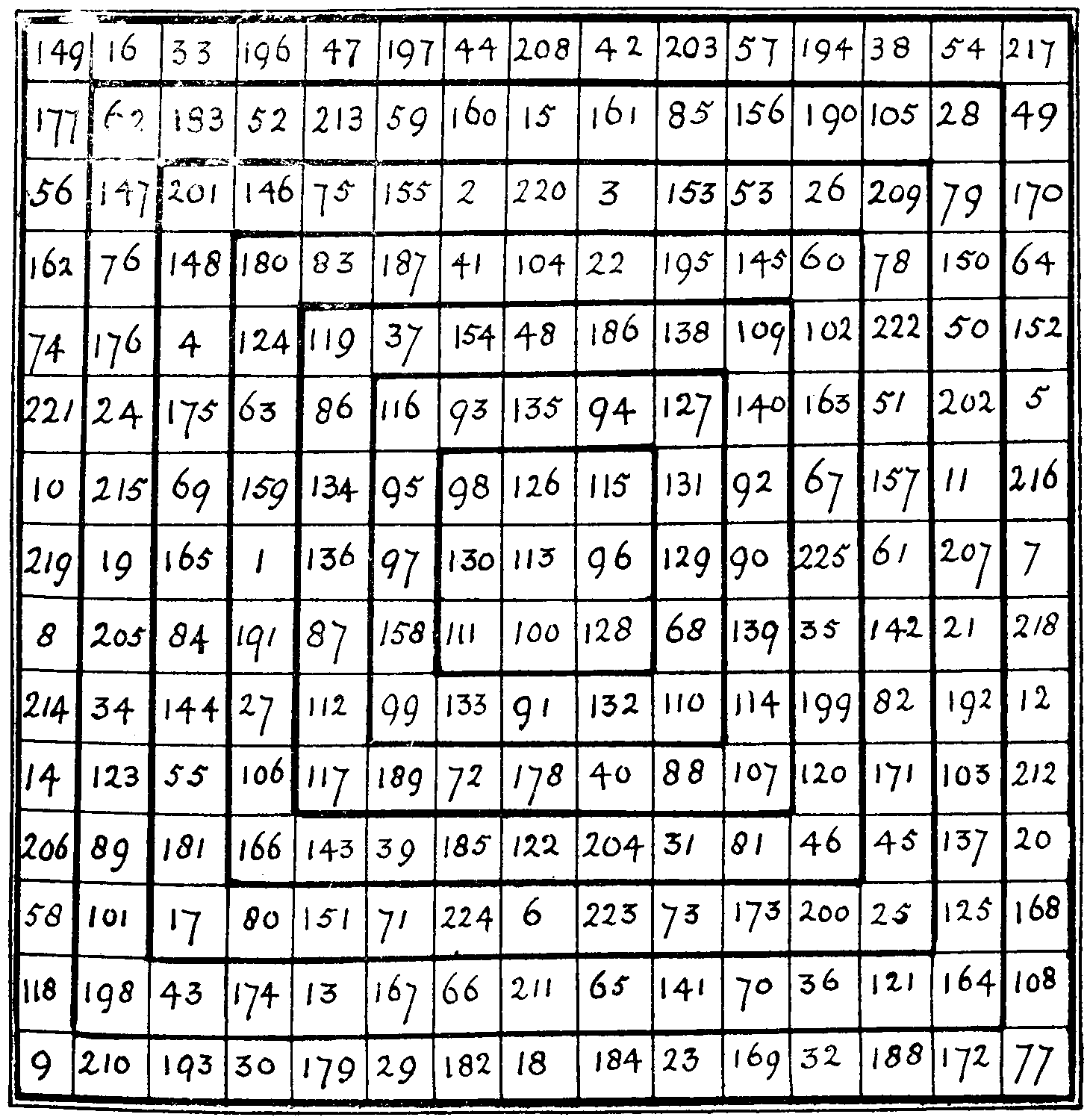
Return to description
No. II—A BORDERED DIAMOND
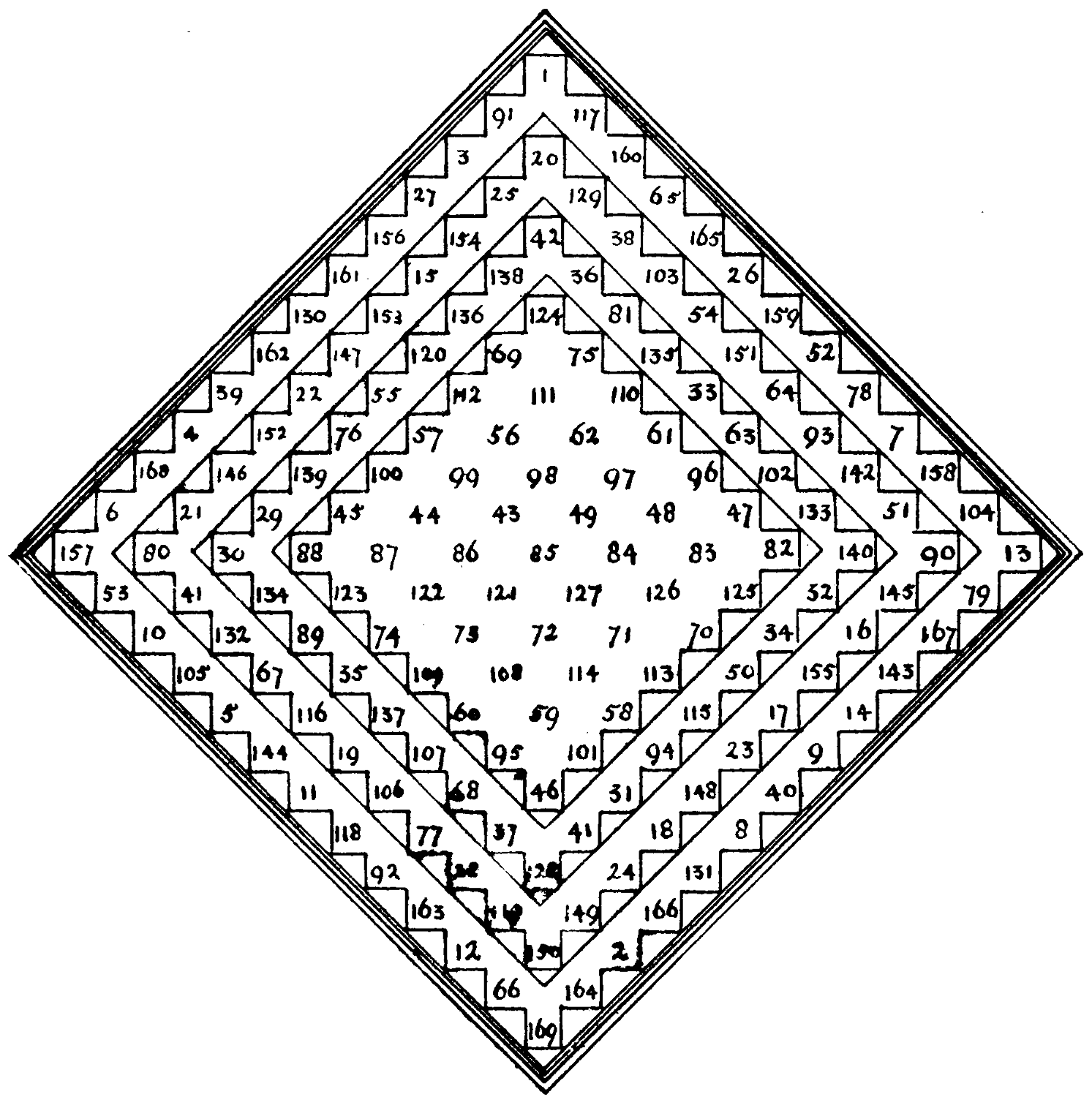
Return to description
No. III.—A MULTIFOLD MAGIC SQUARE
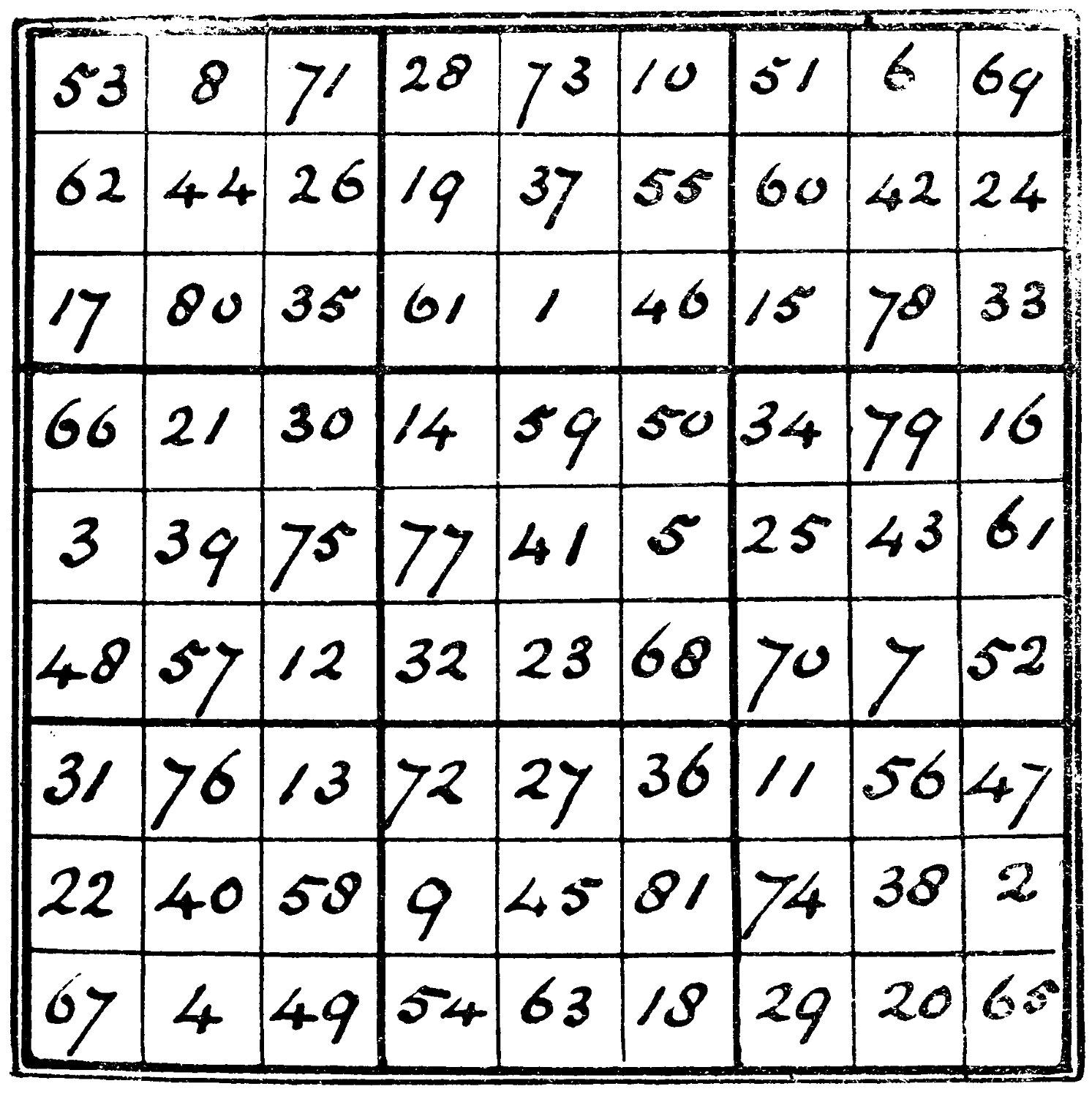
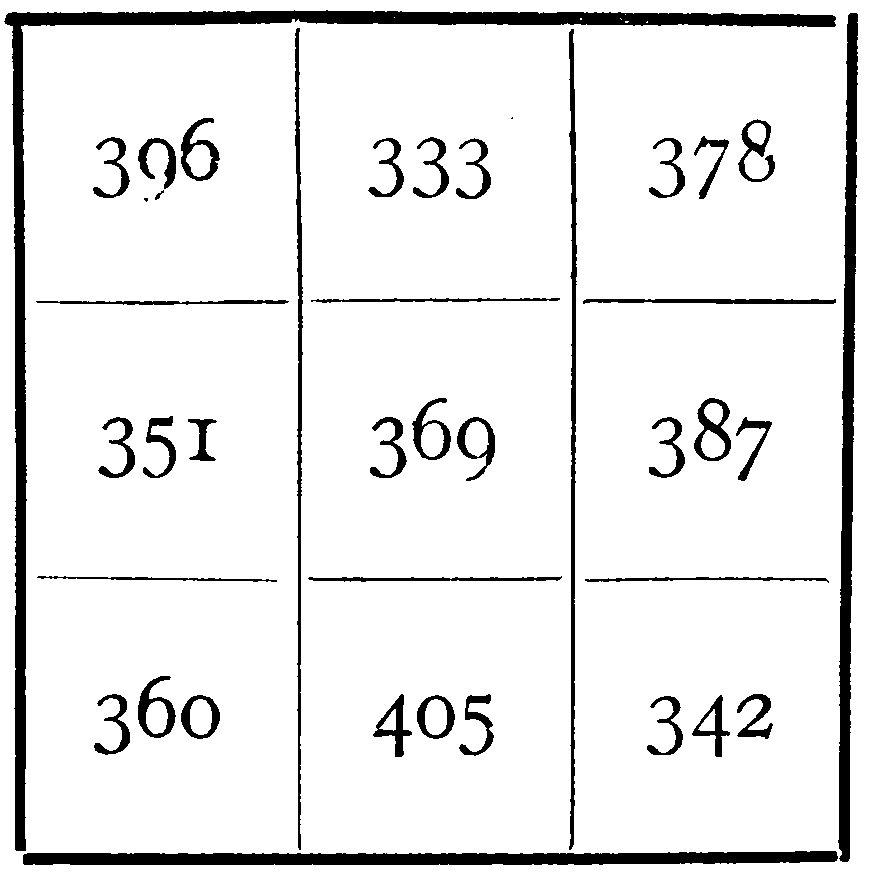
Return to descriptions
No. IV.—A MODEL MAGIC SQUARE
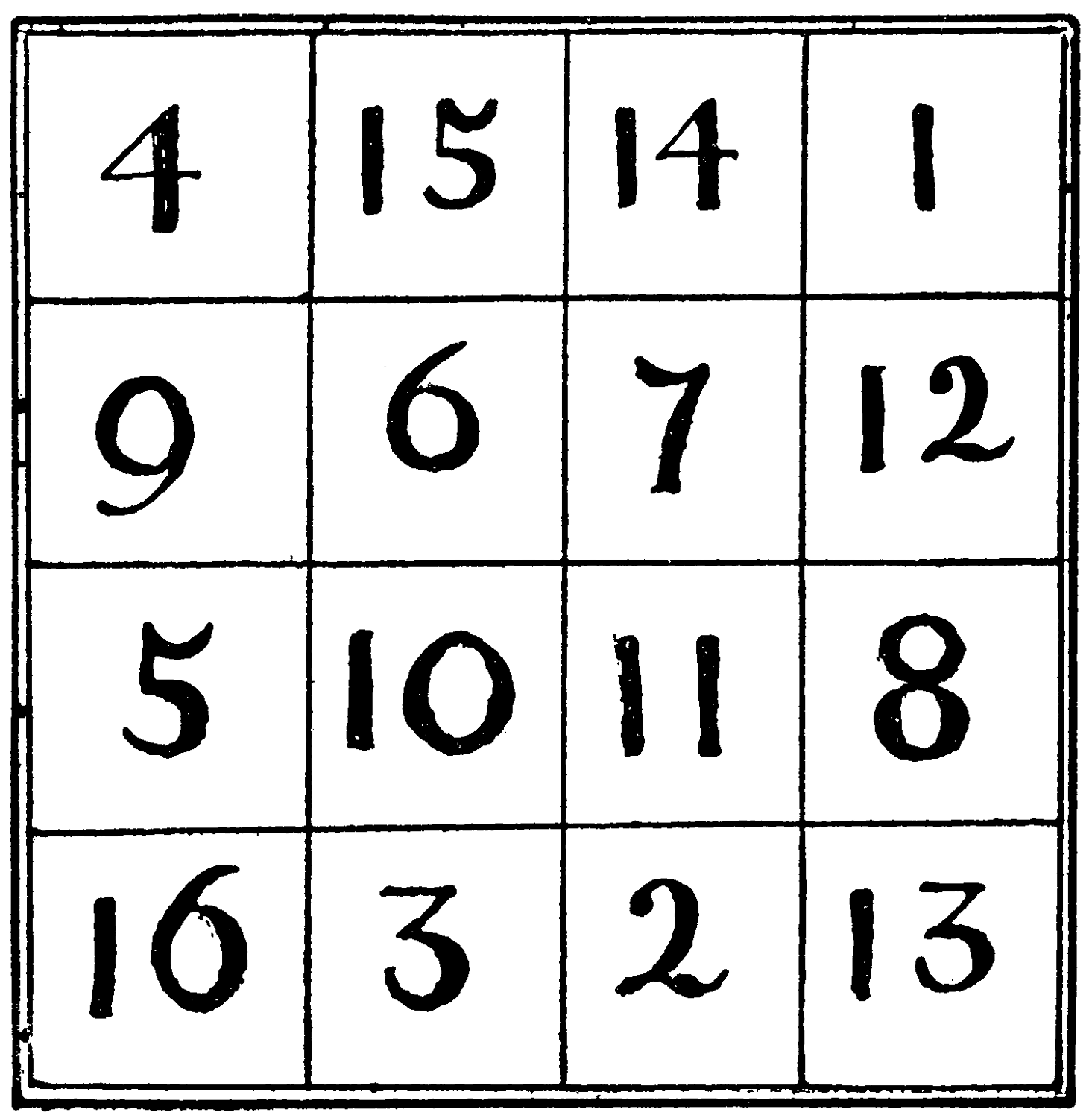
Return to description
No. V.—TESSELATED DIAMOND
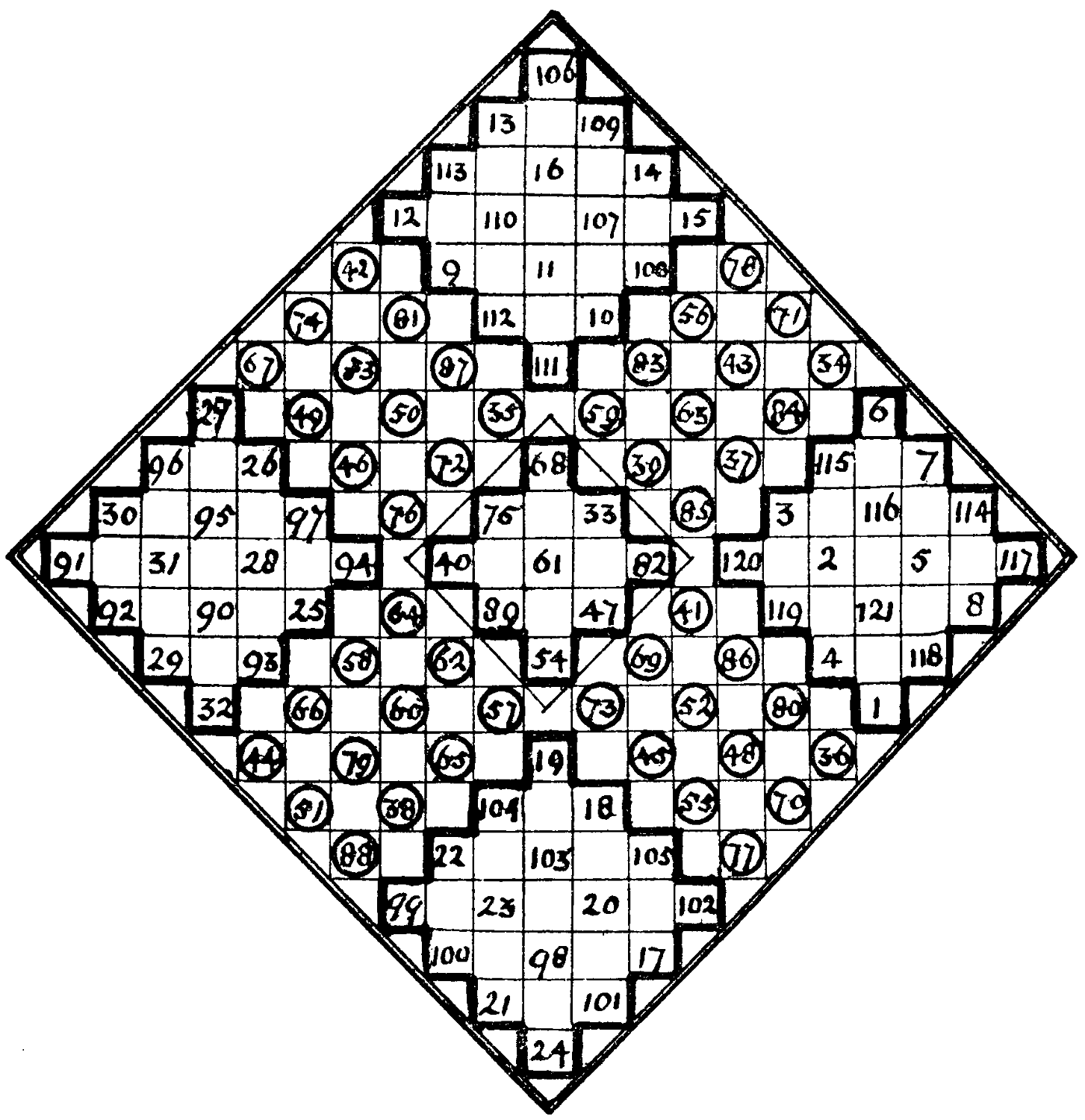
Return to description
No. VI.—MAGIC SQUARE BY MULTIPLICATION
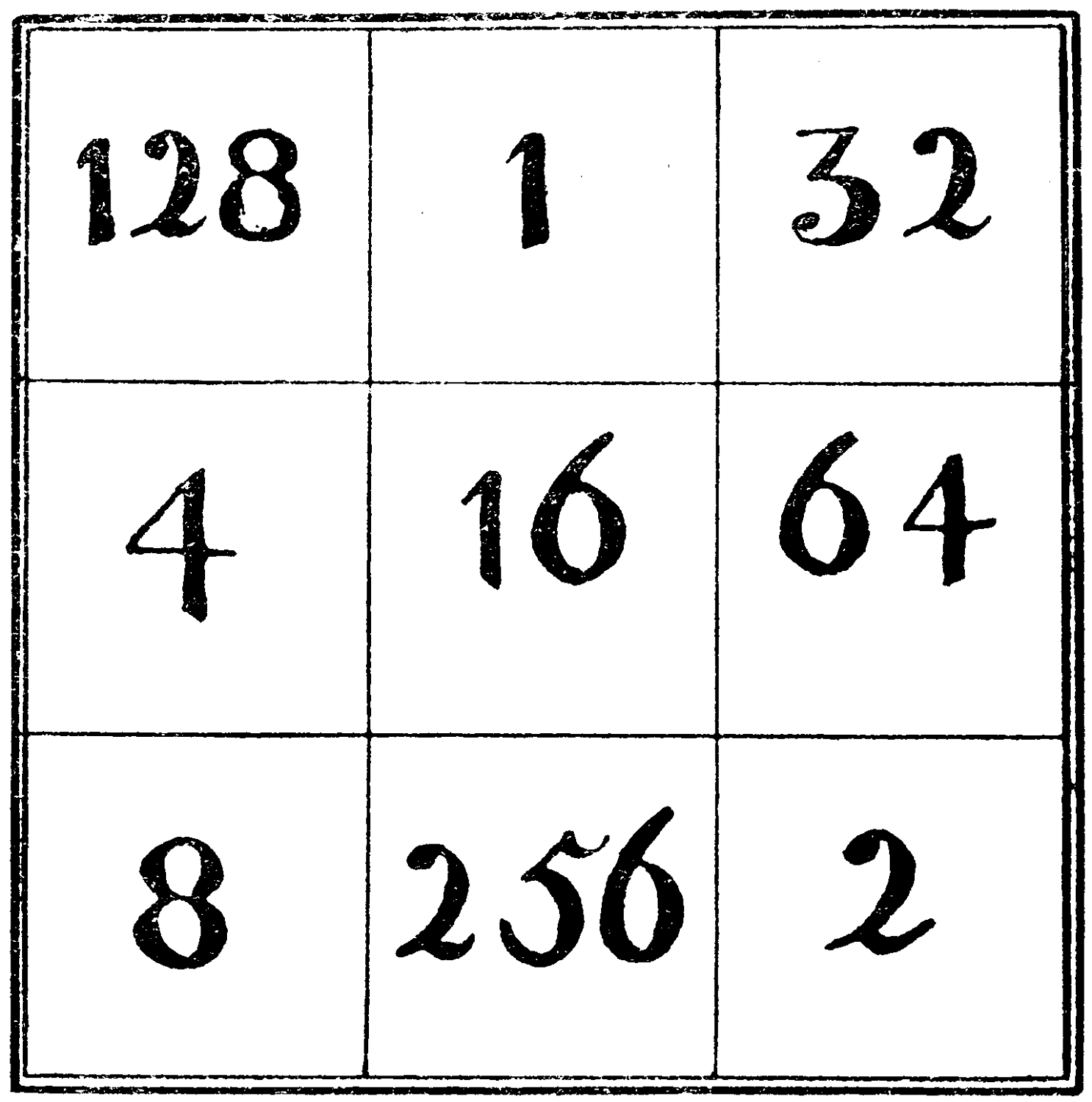
Return to description
No. VII.—ANOTHER BORDERED MAGIC SQUARE
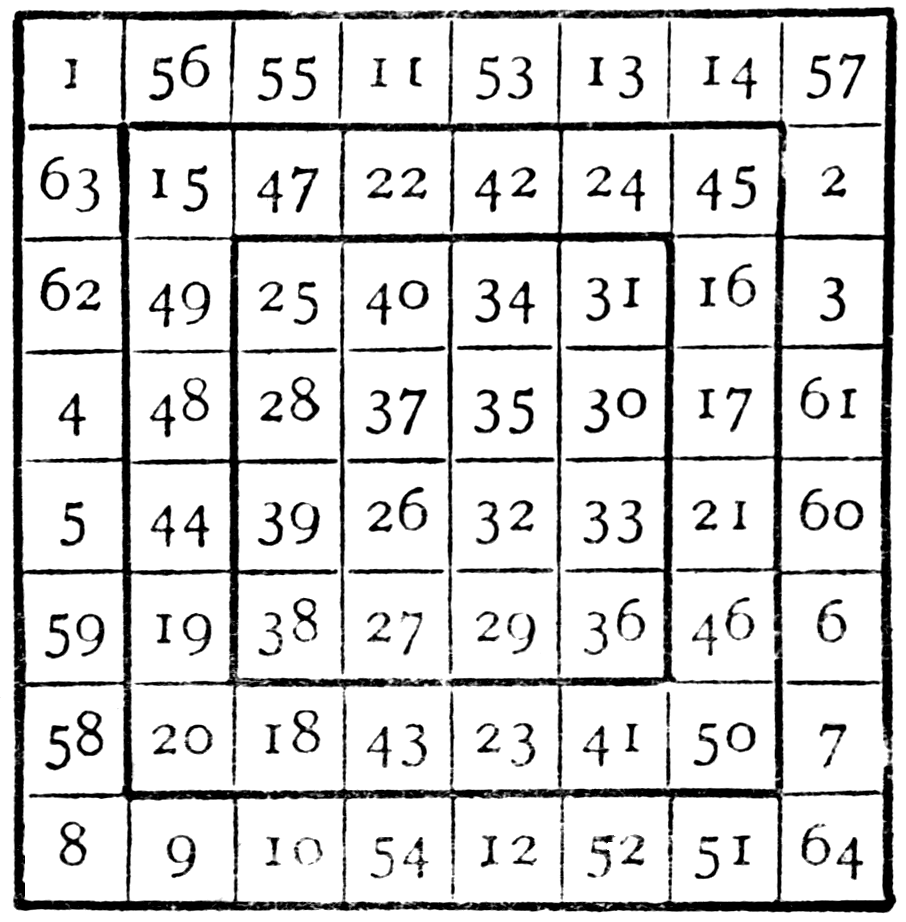
Return to description
No. VIII.—A HARDY ANNUAL
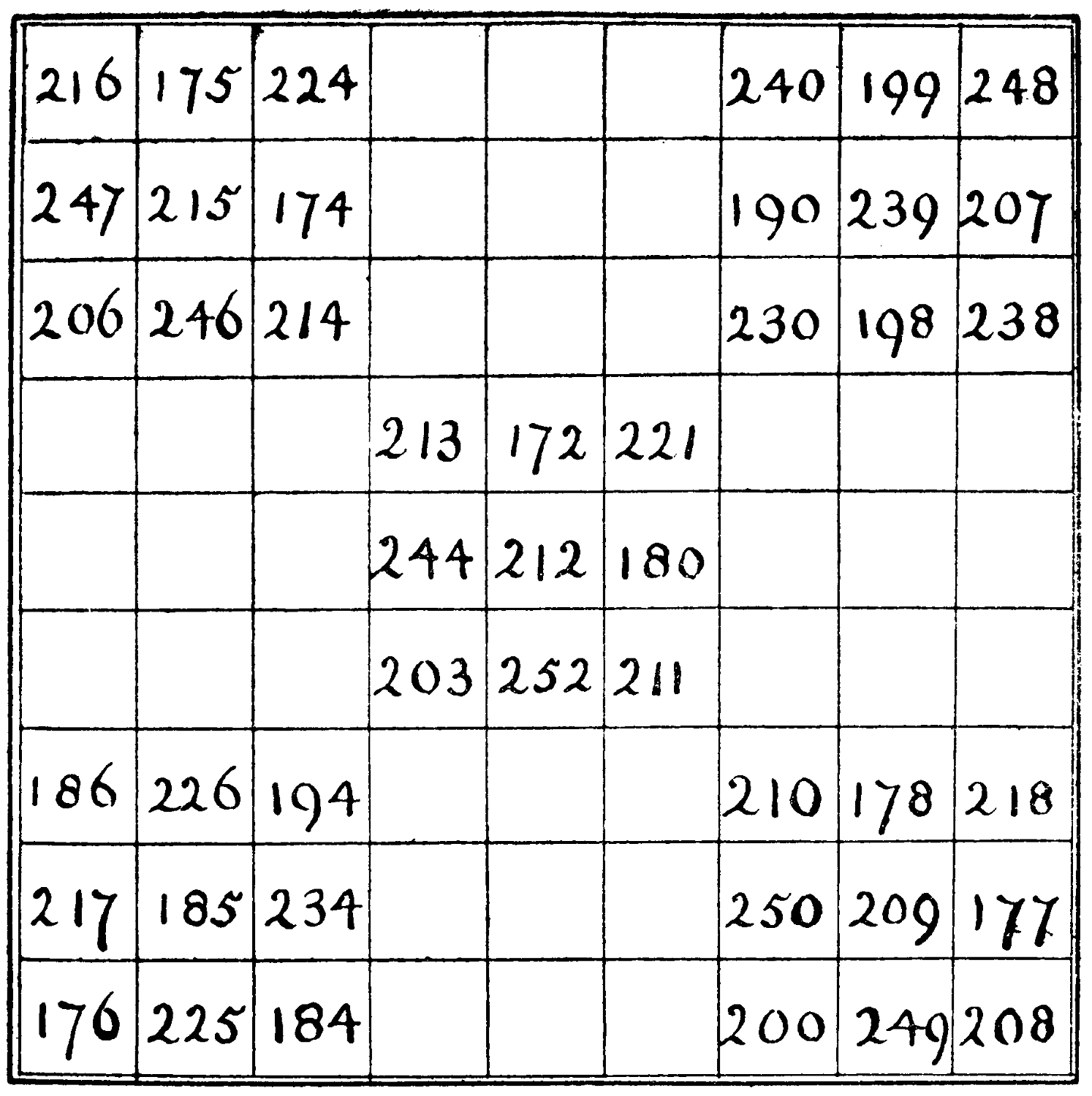
Return to description
No. IX.—ANOTHER “ANNO DOMINI”
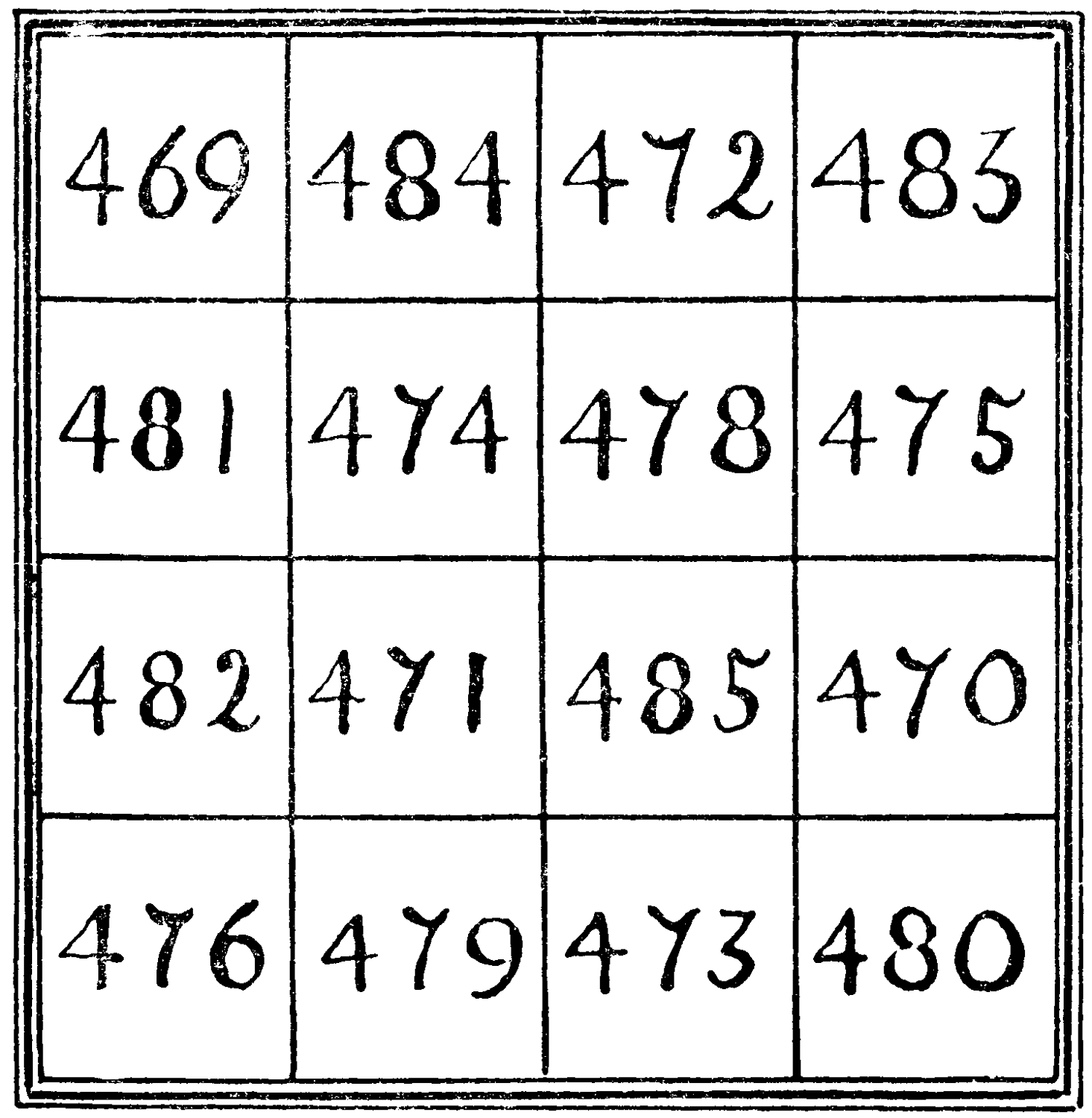
Return to description
No. X.—A DOMINO MAGIC SQUARE
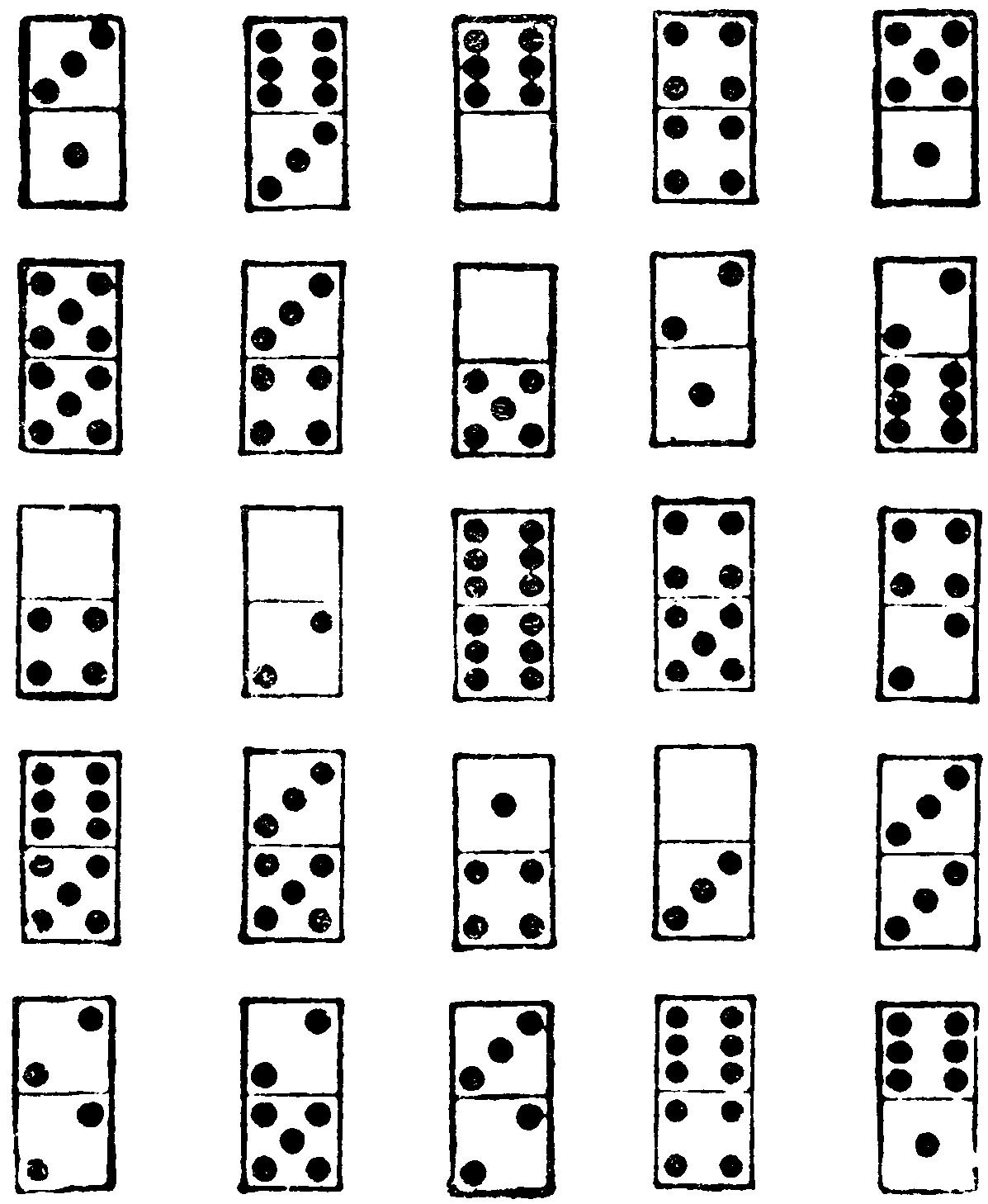
Return to description
No. XI.—CHESS AND NUMBERS
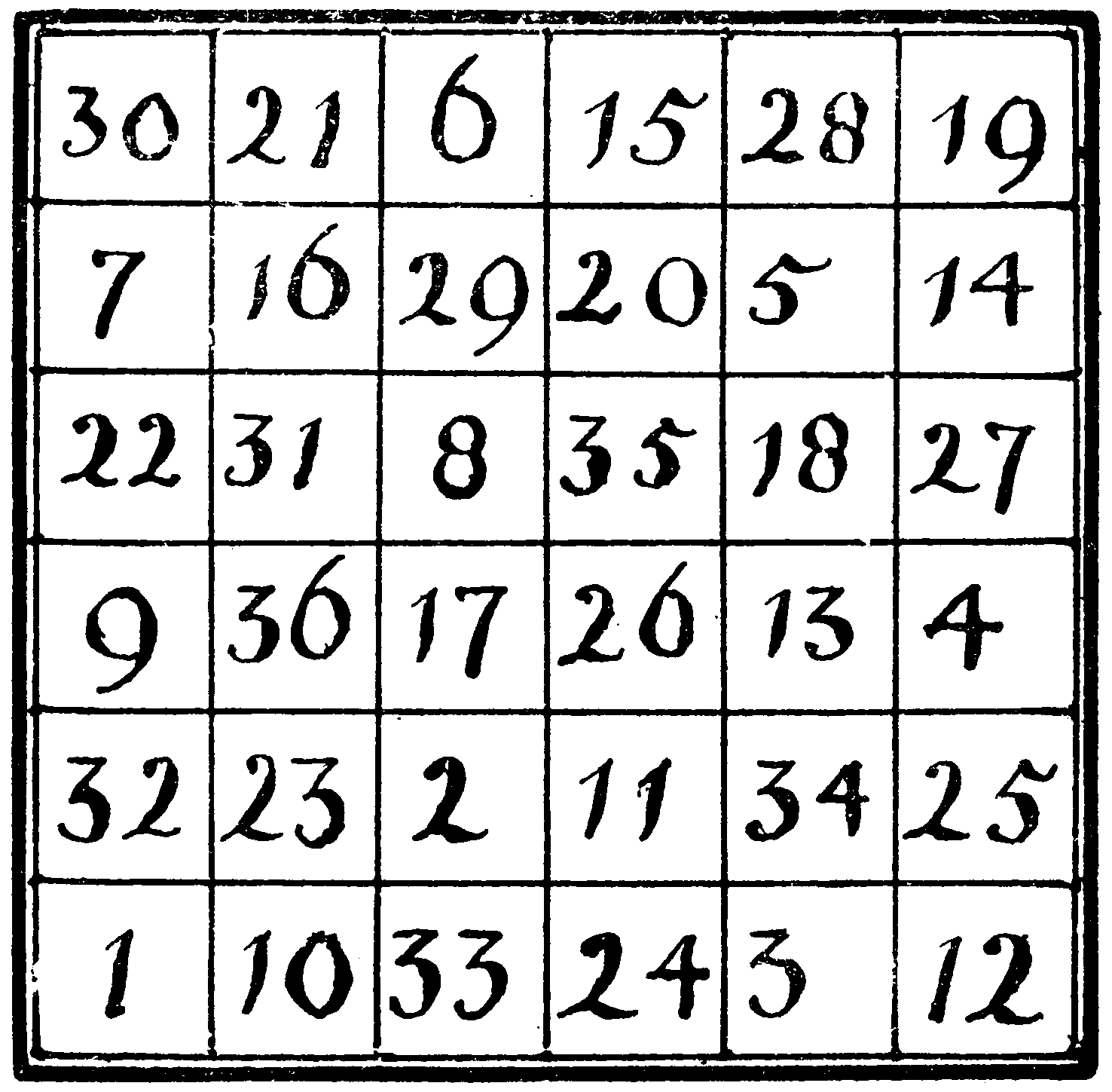
Return to description
No. XII.—NUMBERS PATIENCE
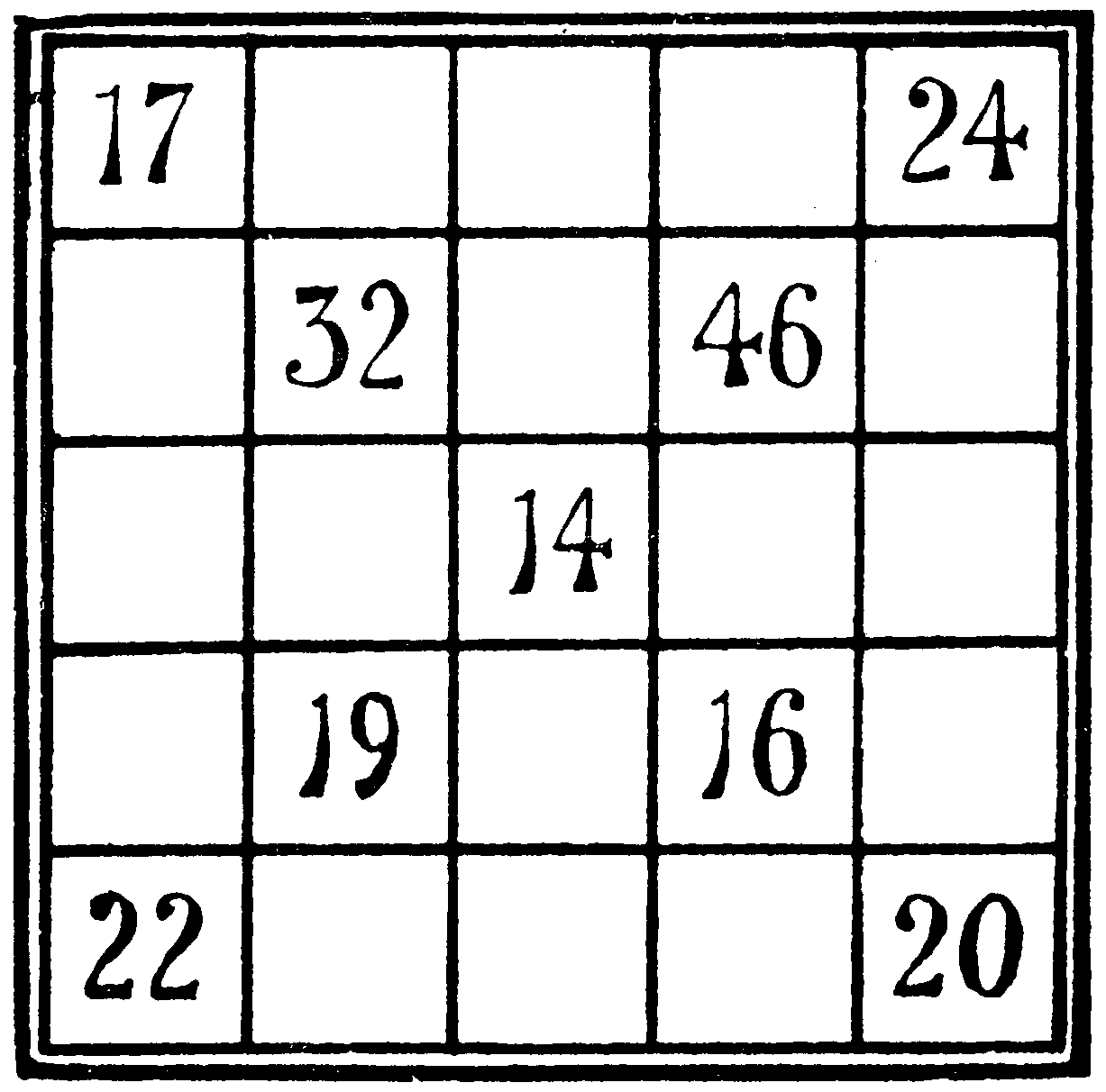
Return to description
No. XIV.—A NEST OF RECTANGLES
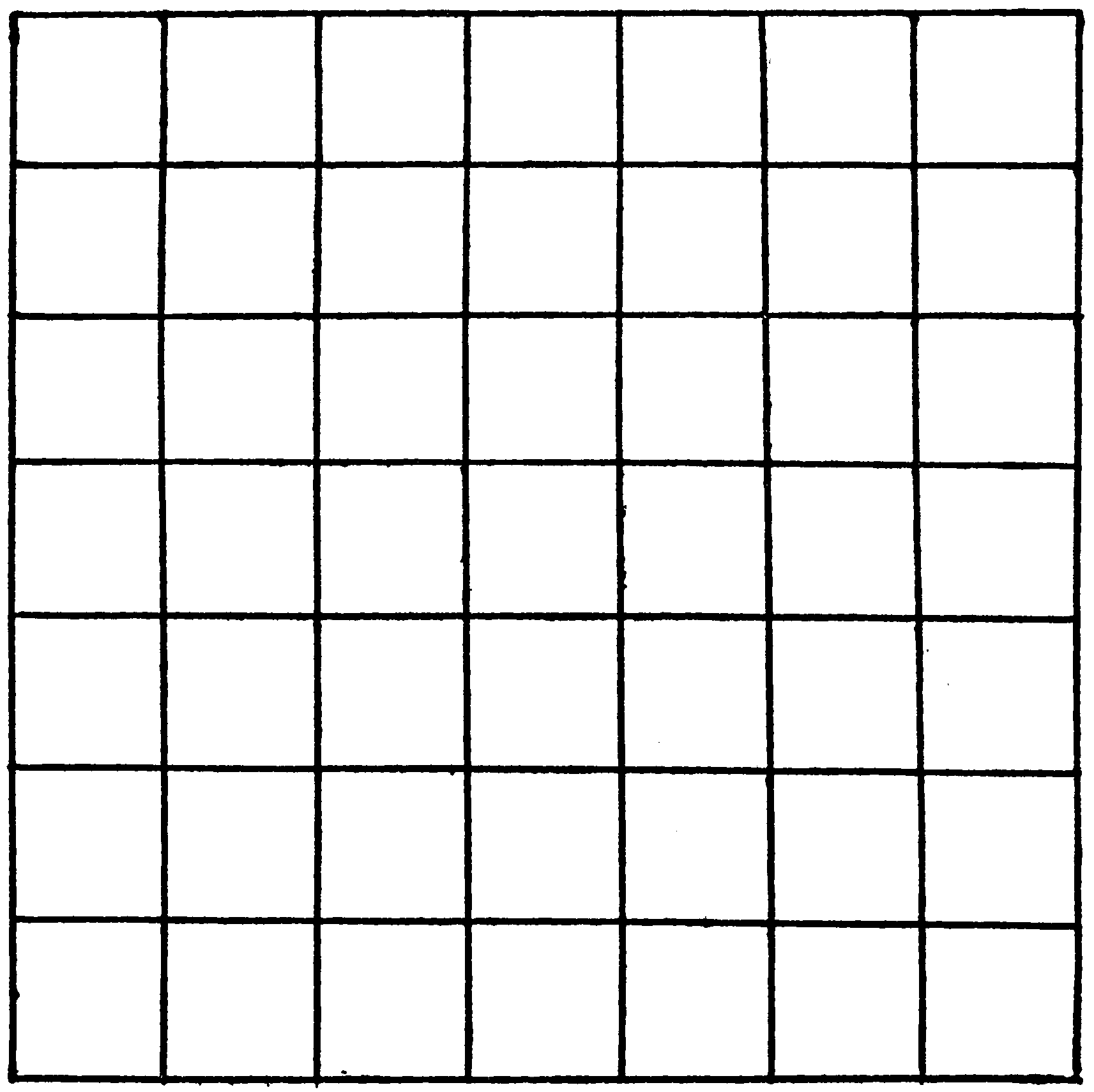
Return to description
No. XV.—ANOTHER DOMINO MAGIC SQUARE
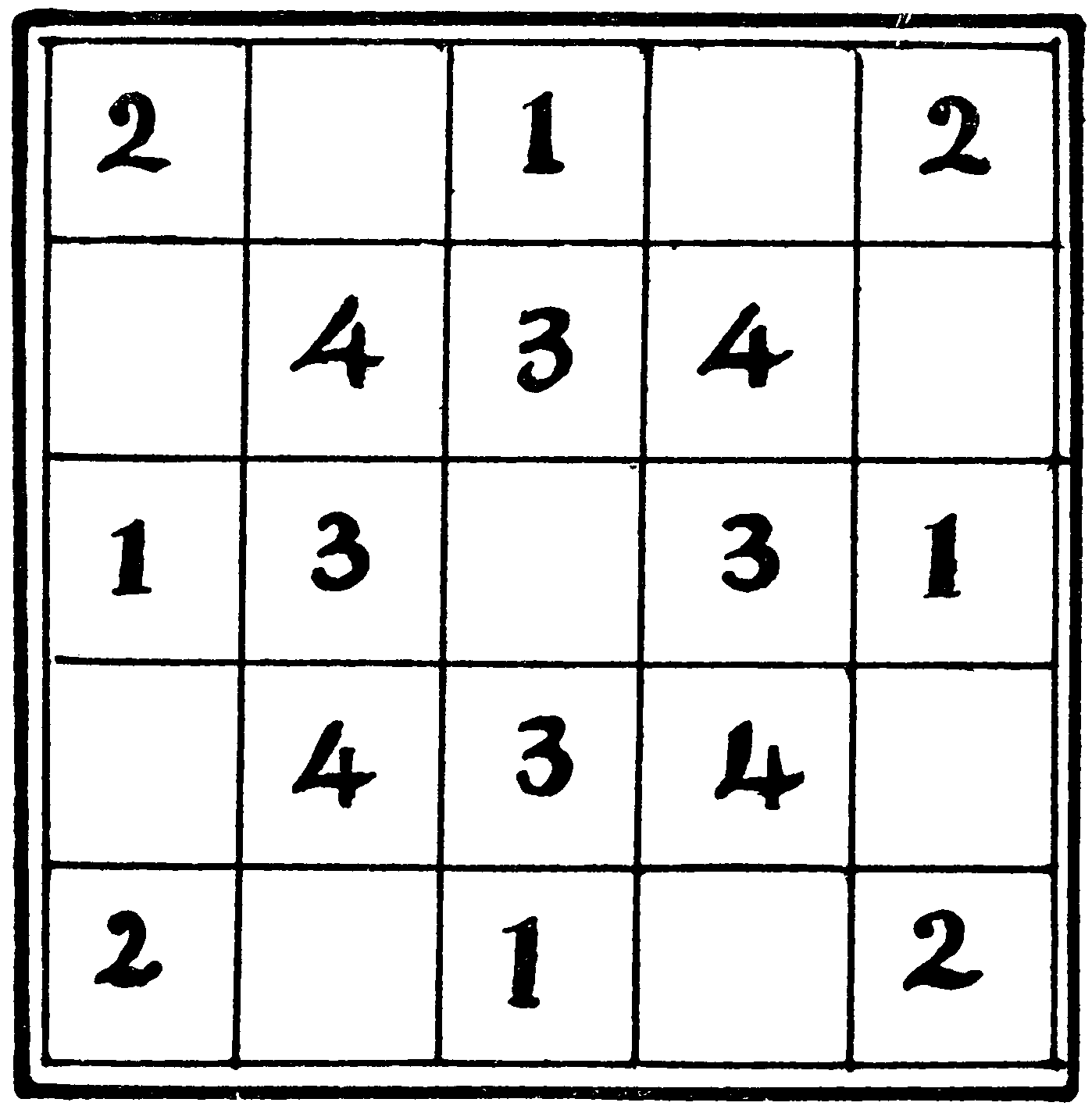
Return to description
No. XXXII.—A GOOD LETTER PUZZLE
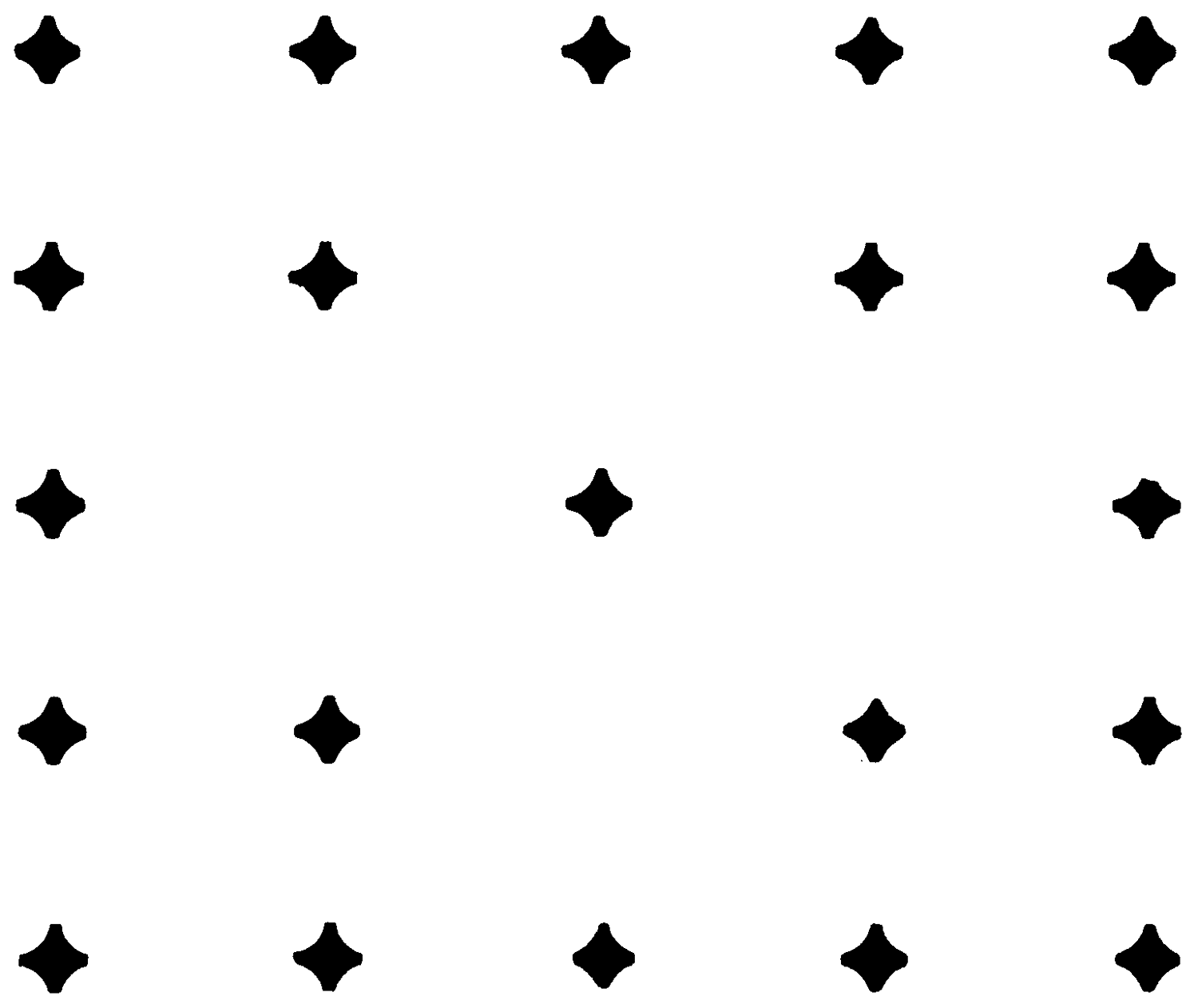
Return to description
No. XXXIII.—ANAGRAM ARITHMETIC
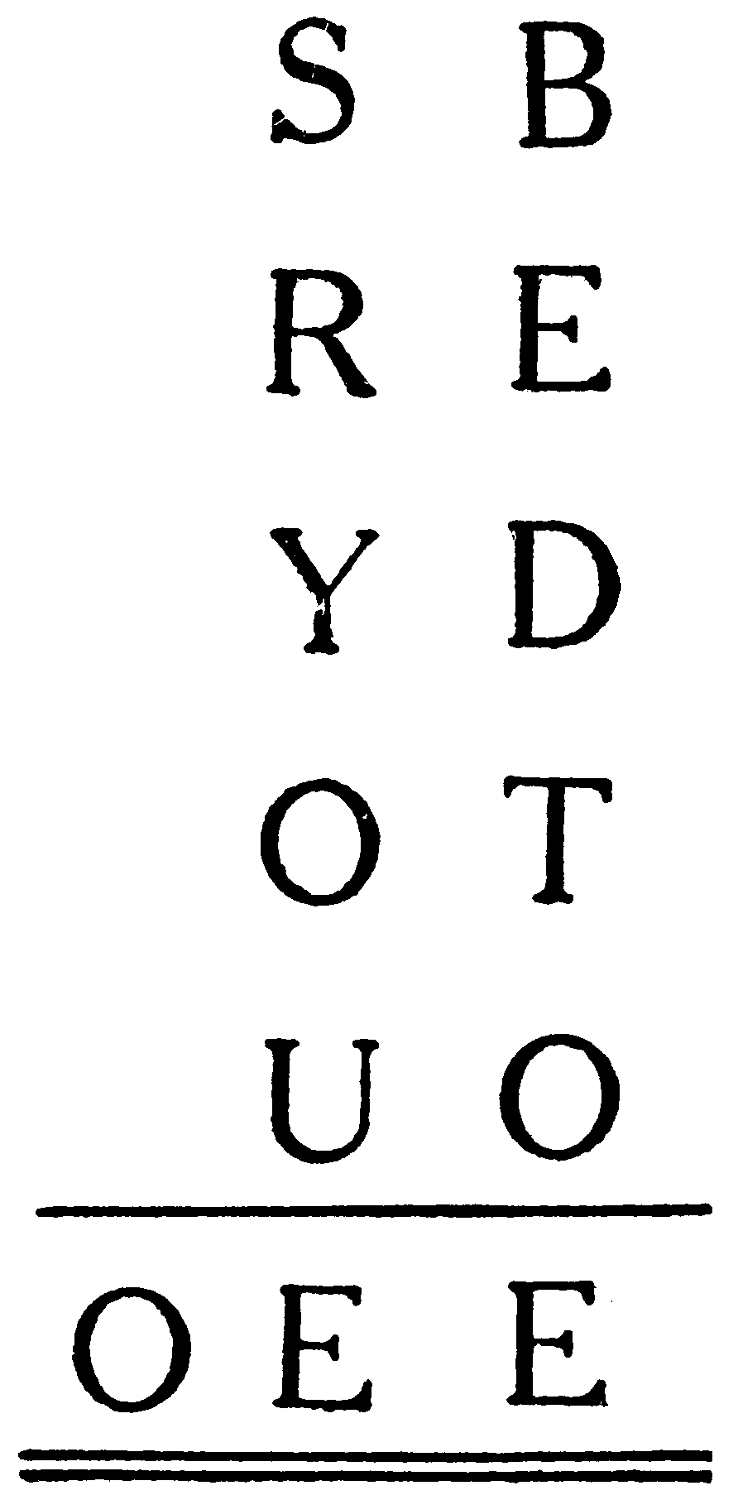
Return to description
No. XXXIV.—A BUNCH OF FLOWERS
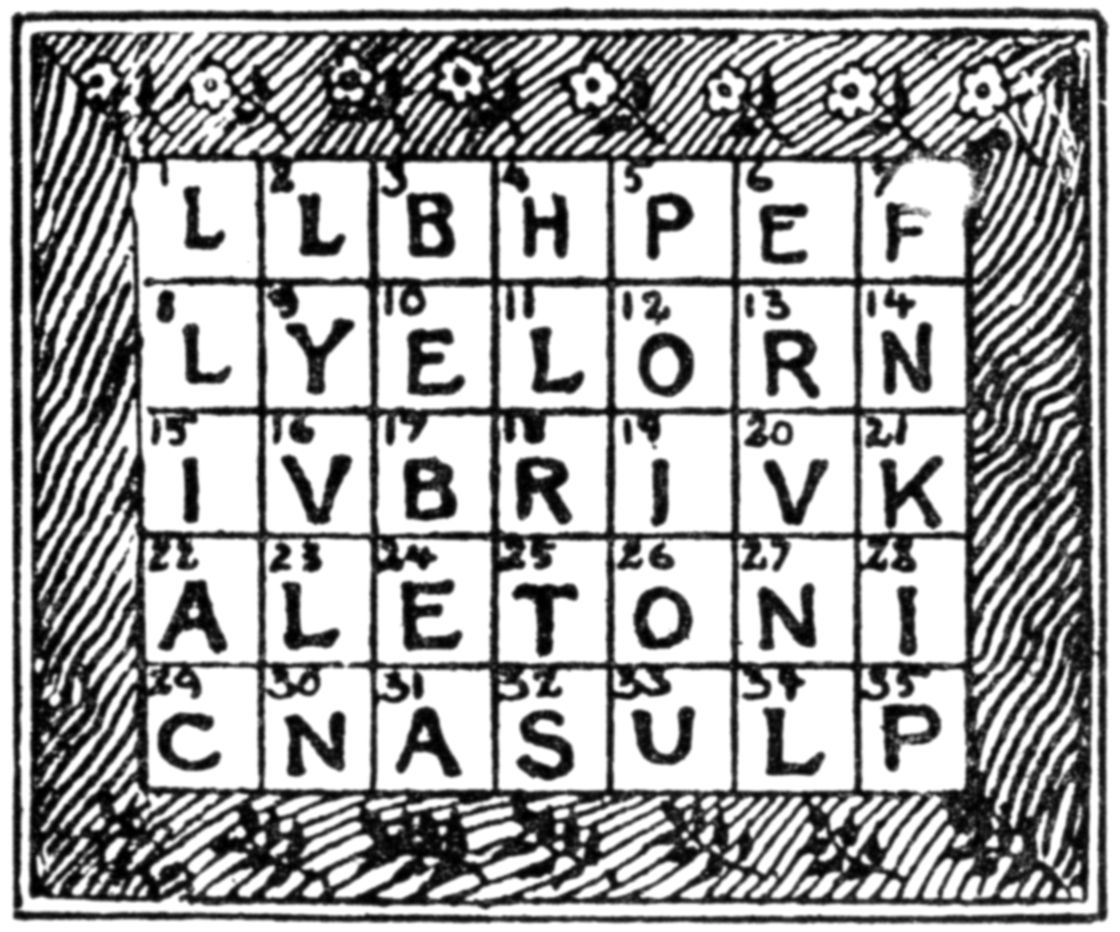
Return to description
No. XXXV.—ON A BLACKBOARD
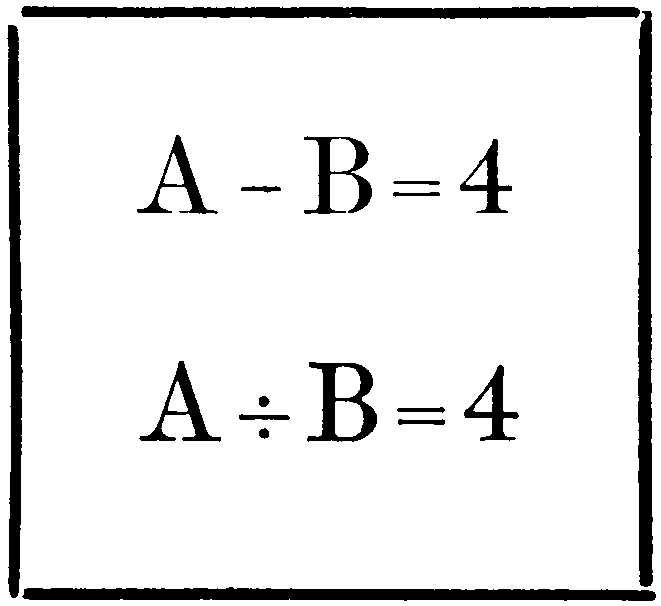
Return to description
No. XXXVI.—SQUARING A DIAMOND
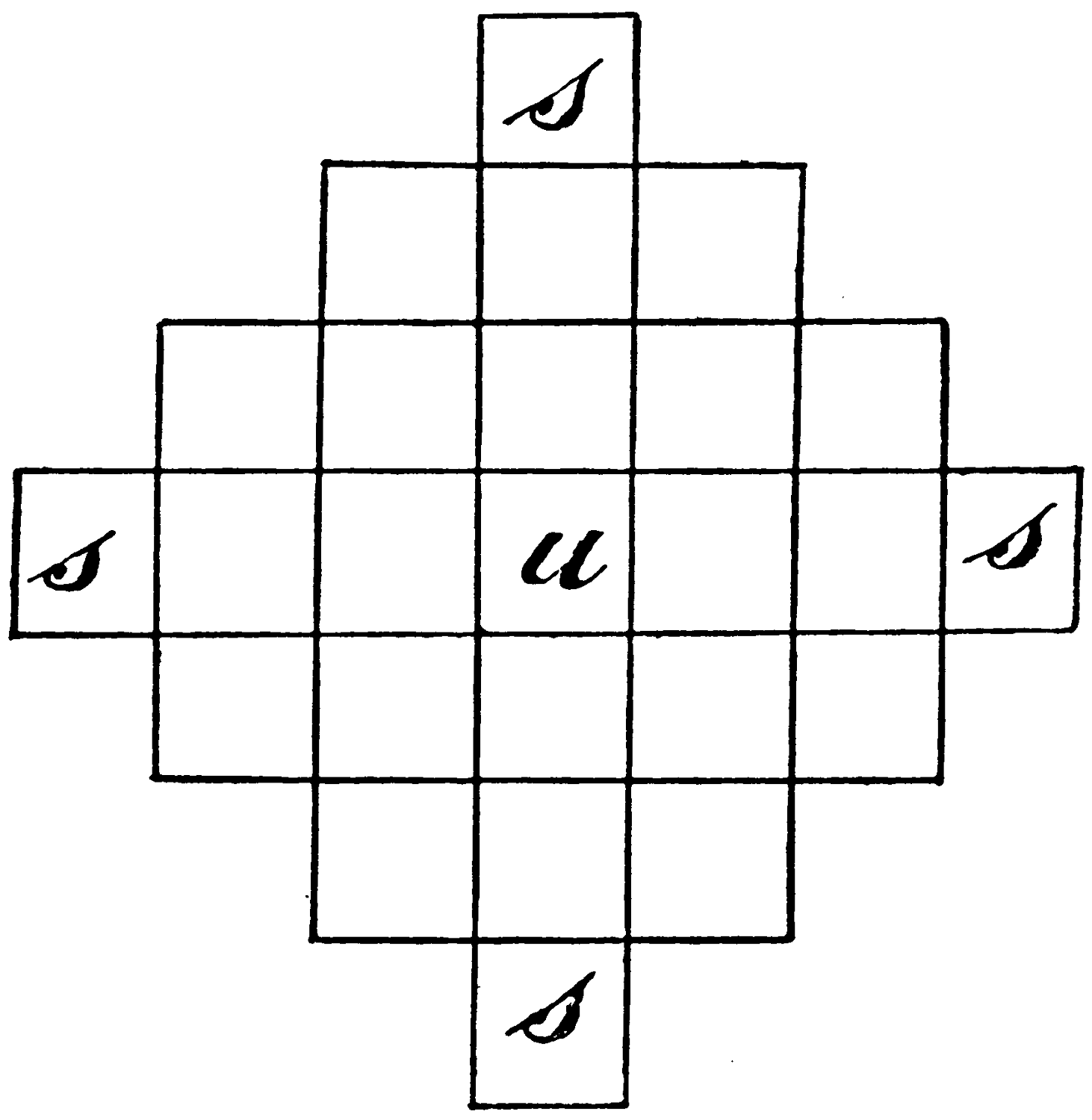
Return to description
No. XXXVII.
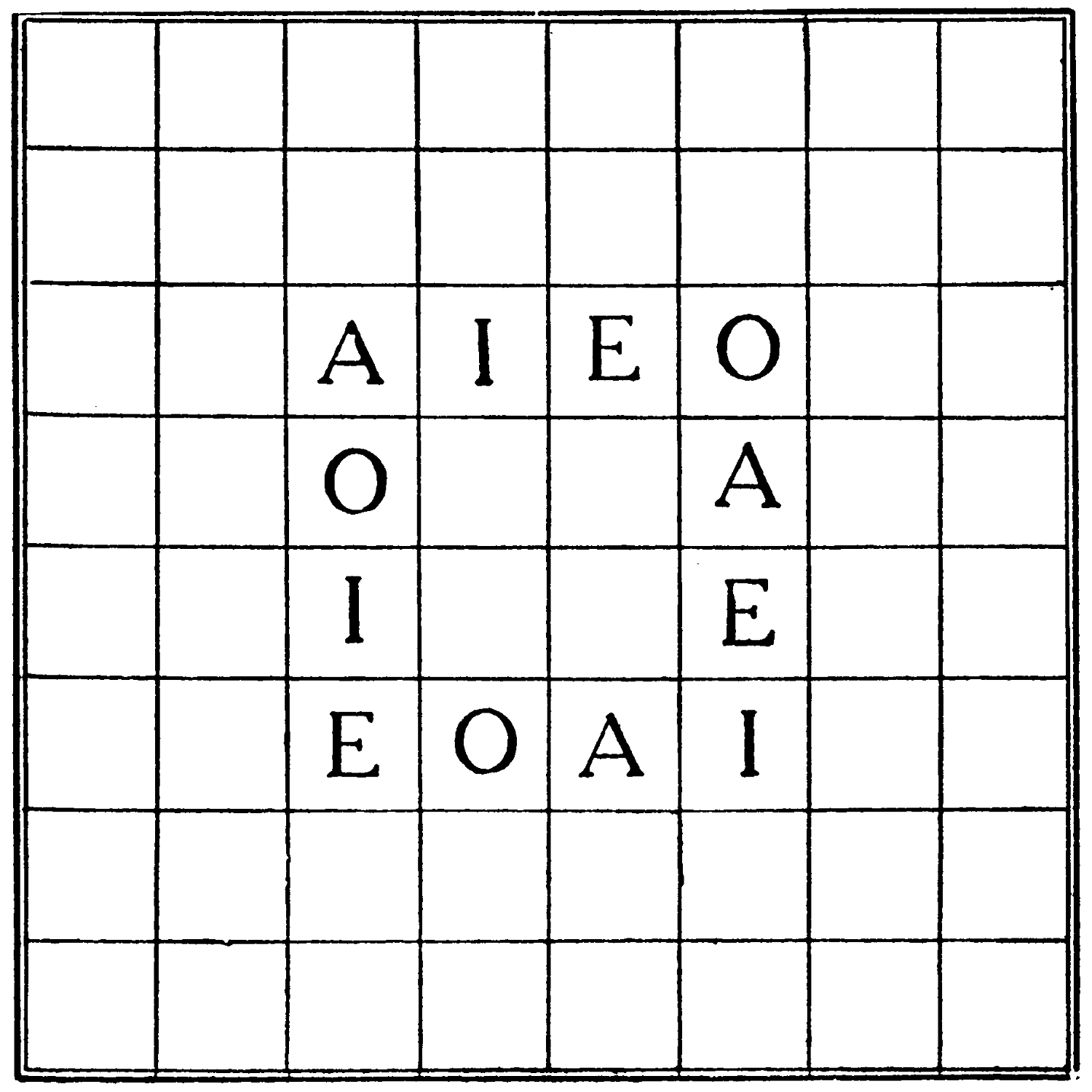
Return to description
No. XXXVIII.—AN ANAGRAM SQUARE
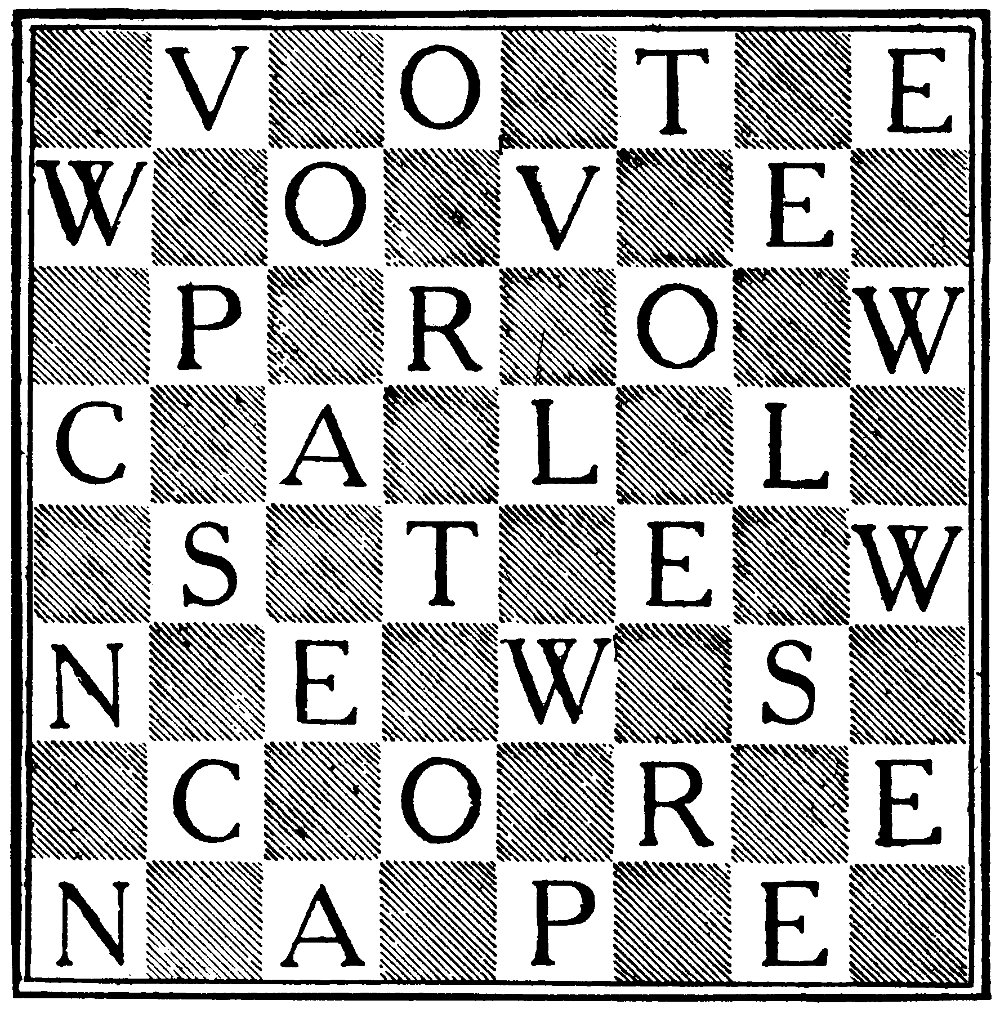
Return to description
No. XXXIX.—ARITHMETIC BY ANAGRAM
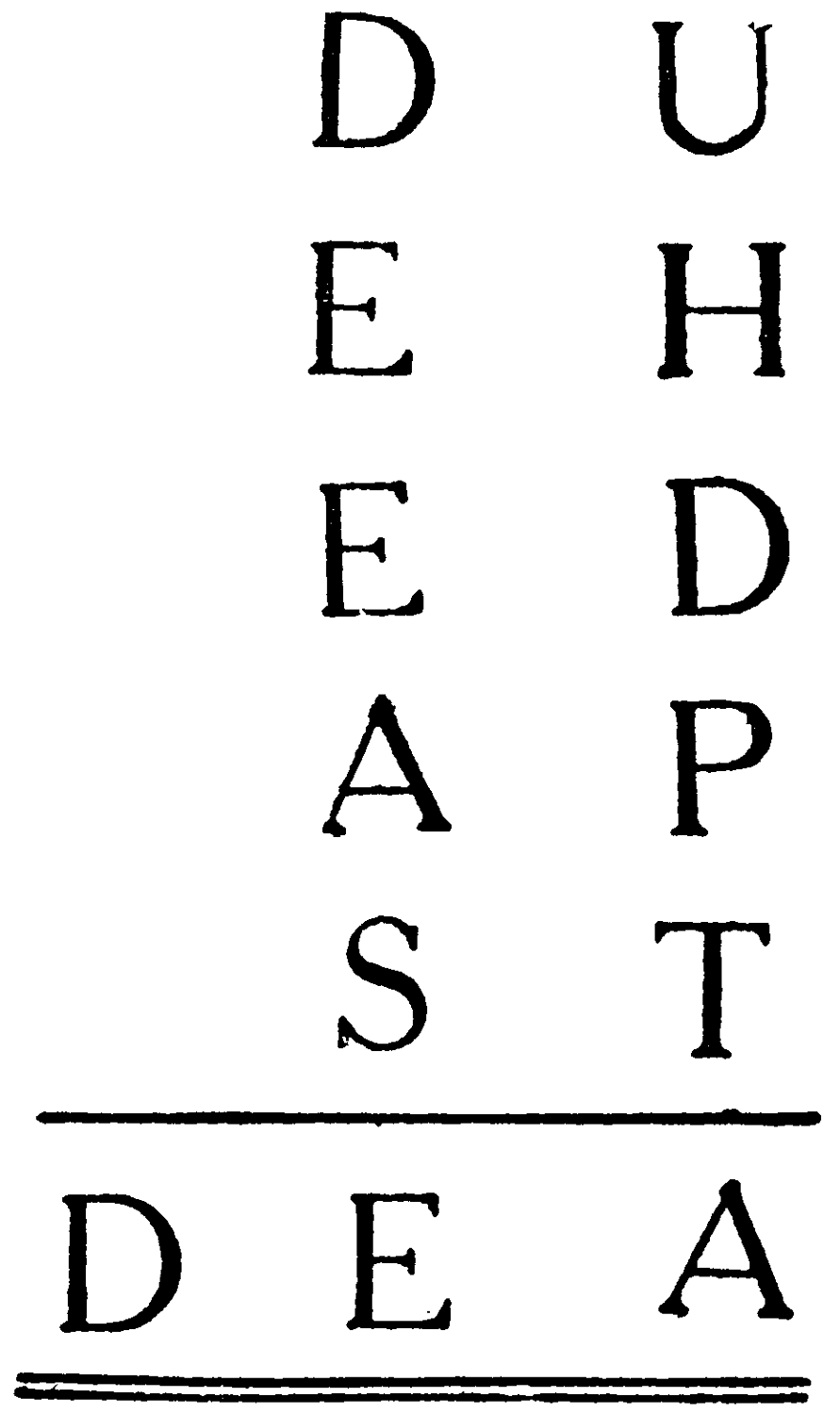
Return to description
No. XL.—ANAGRAMS SQUARED
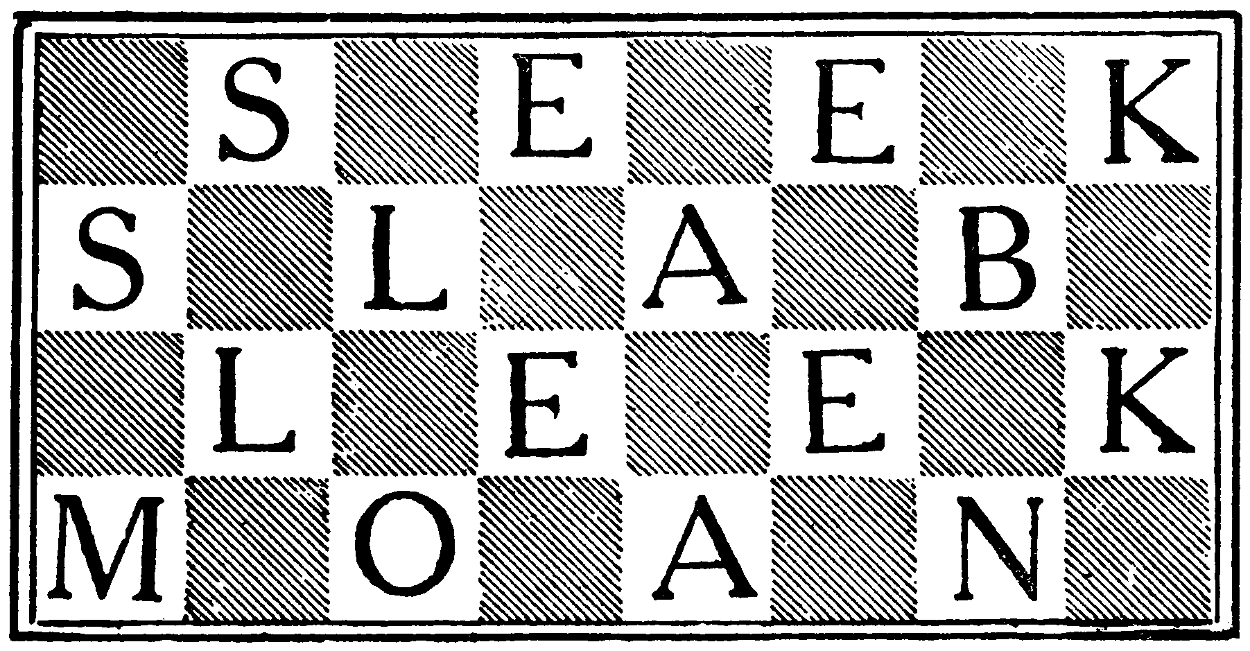
Return to description
No. XLI.—A WORD SQUARE BY ANAGRAM
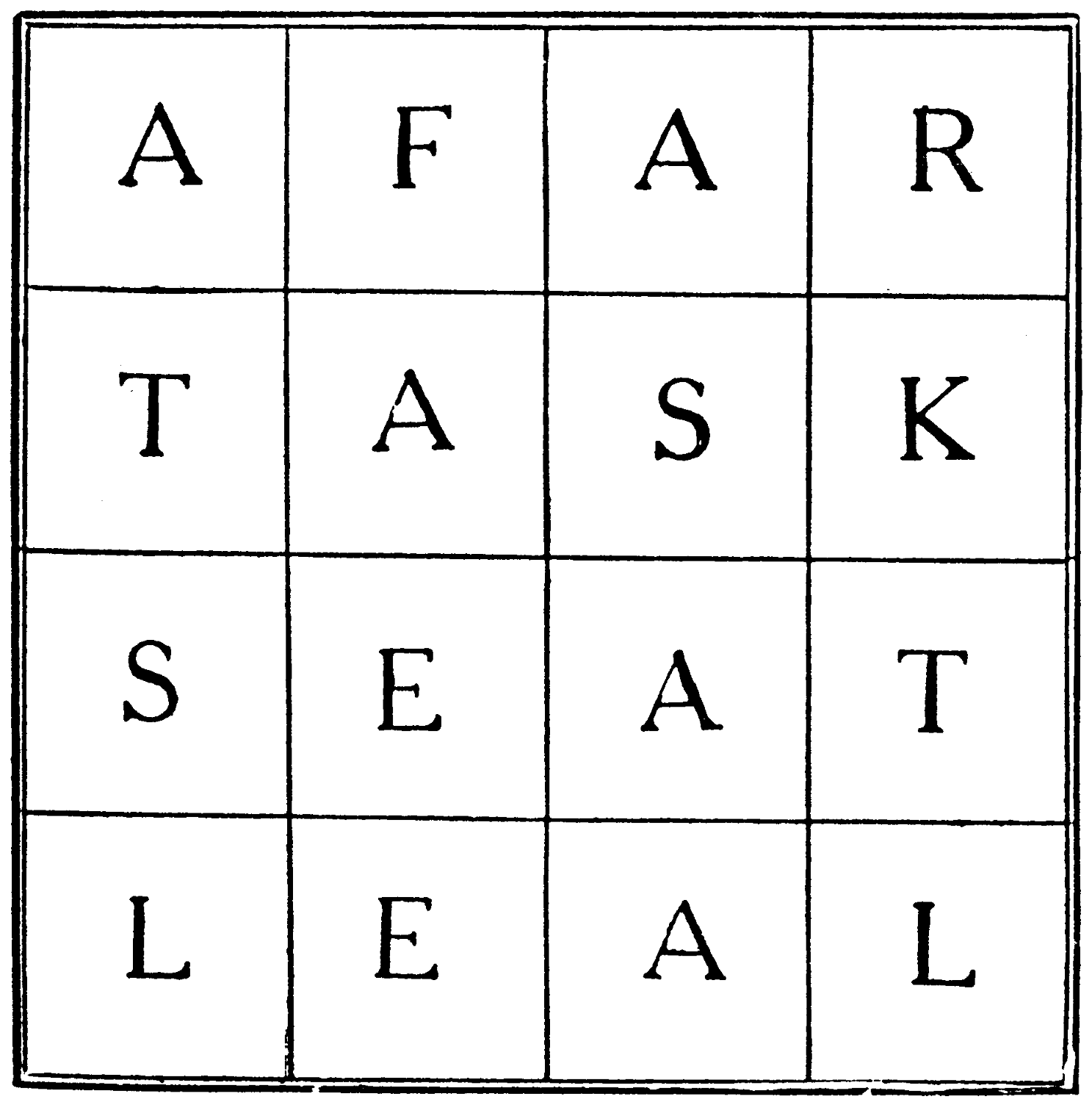
Return to description
No. XLII.—QUITE A NOVELTY
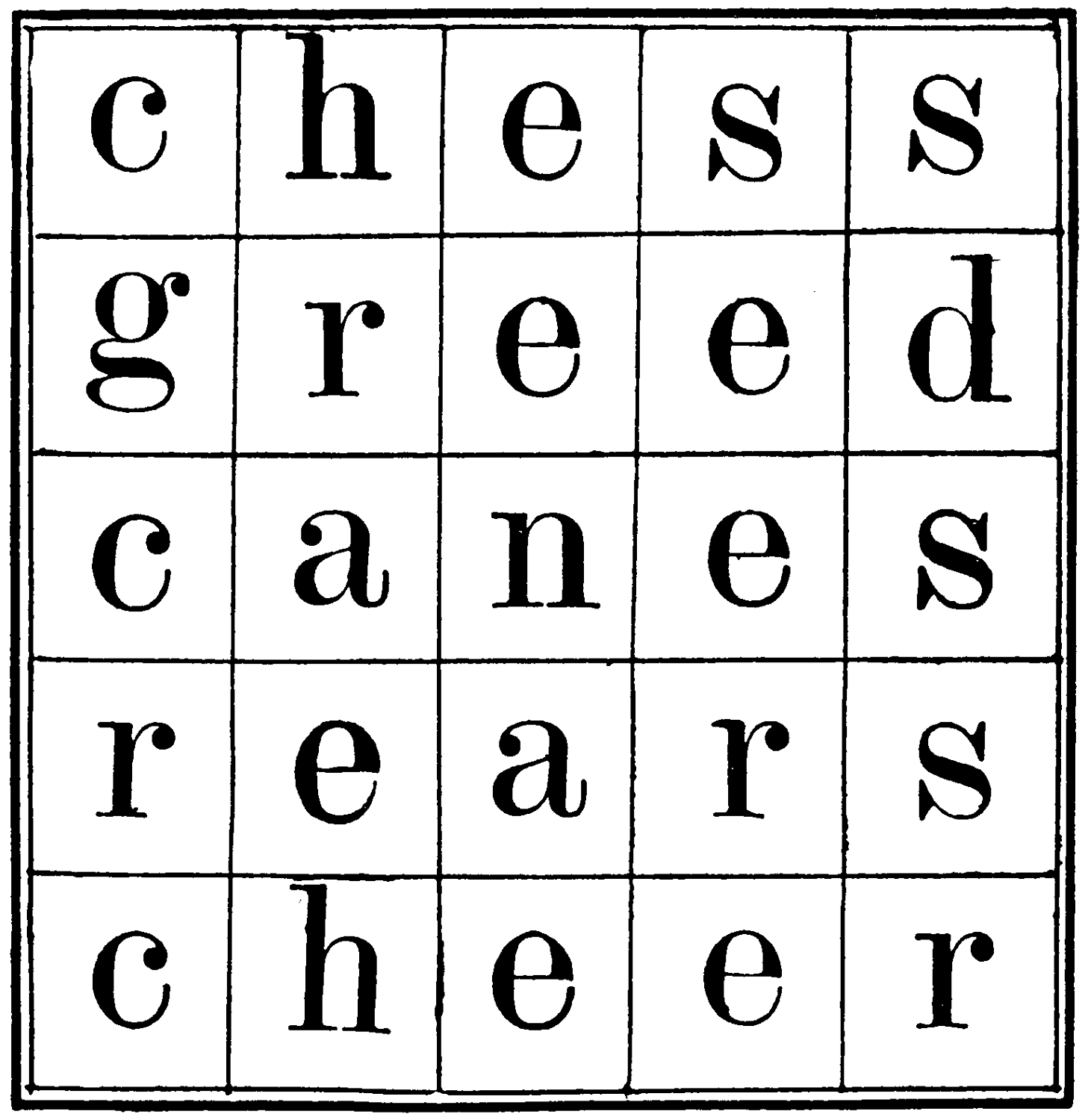
Return to description
No. XLIII.—HIDDEN PROVERBS
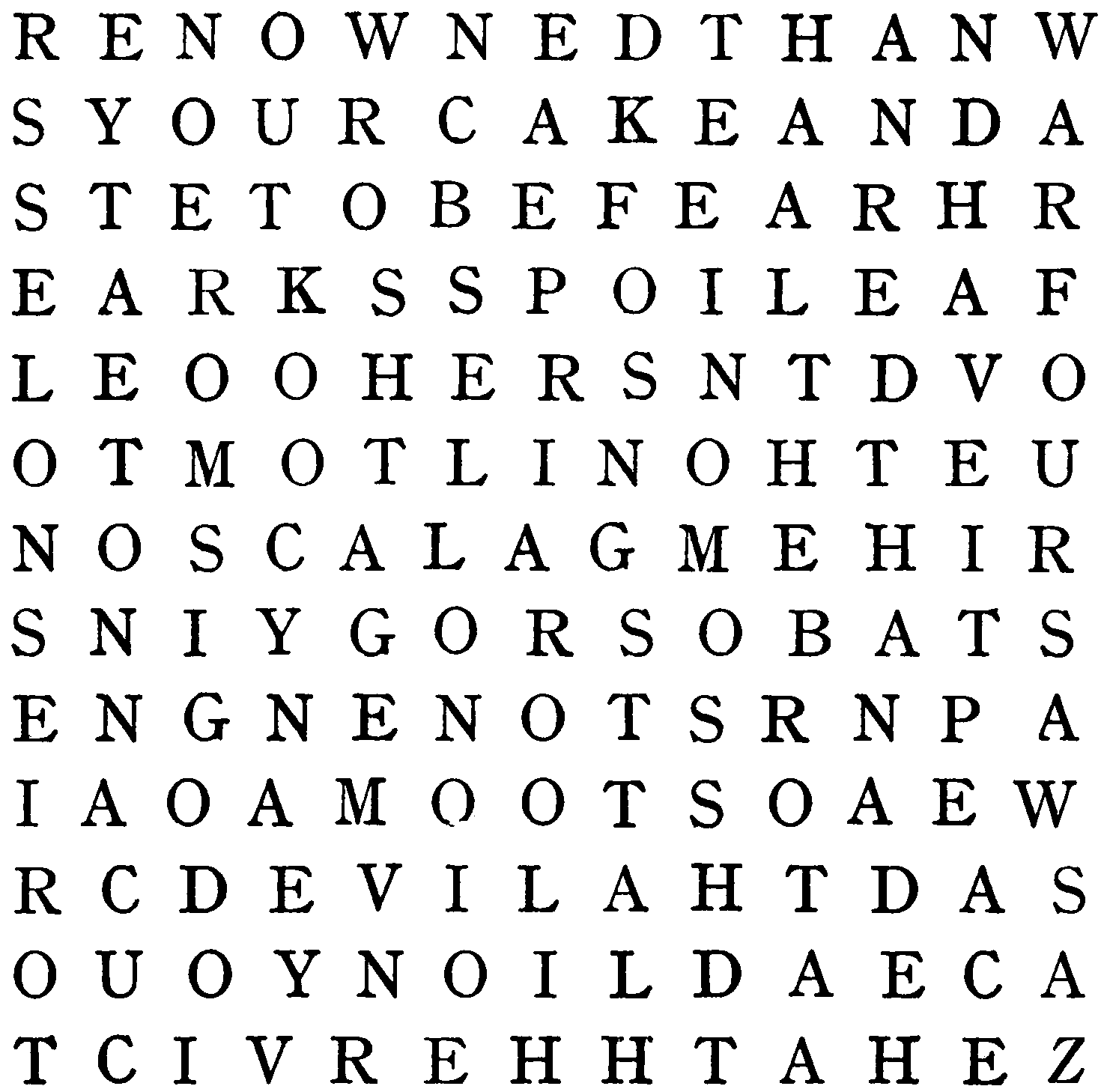
Return to description
Return to solution
No. XLIV.—A CLEVER CRYPTOGRAM
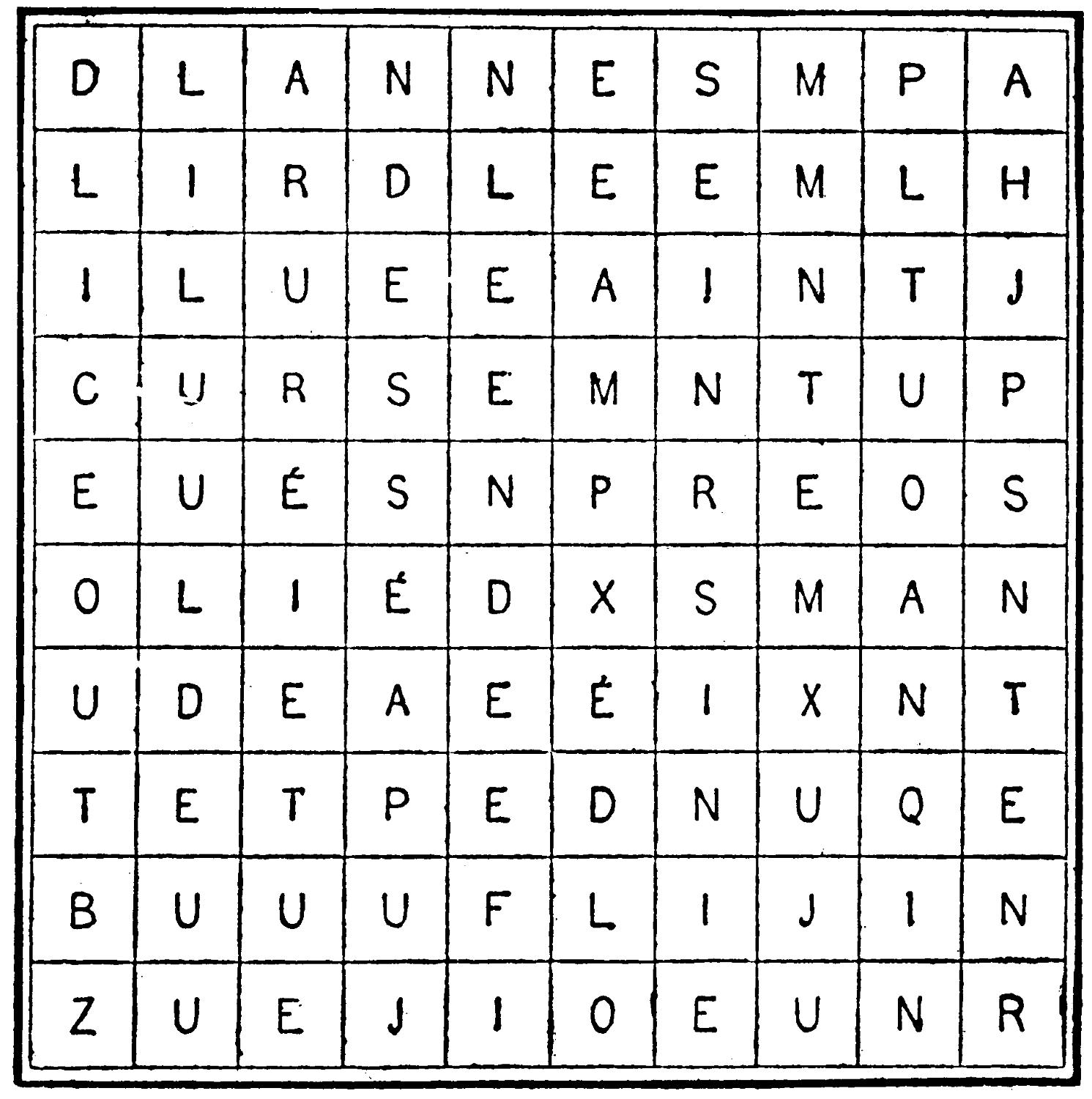
Return to description
No. LXIV.—ARITHMETICAL TRIANGLE
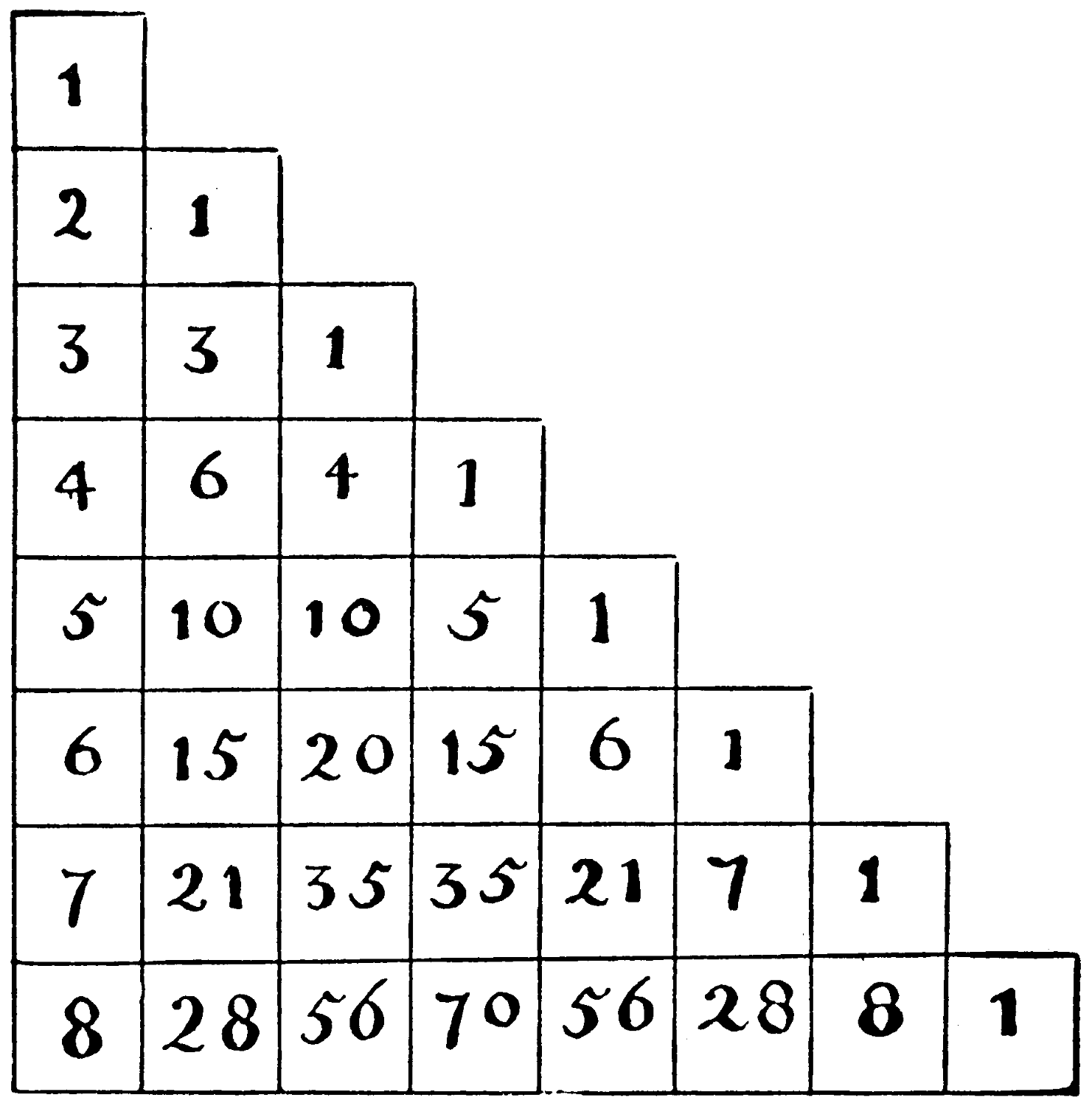
Return to description
No. LXVII.—AN EIGHT-CARD PUZZLE

Return to description
No. LXVIII.—THOUGHT READING
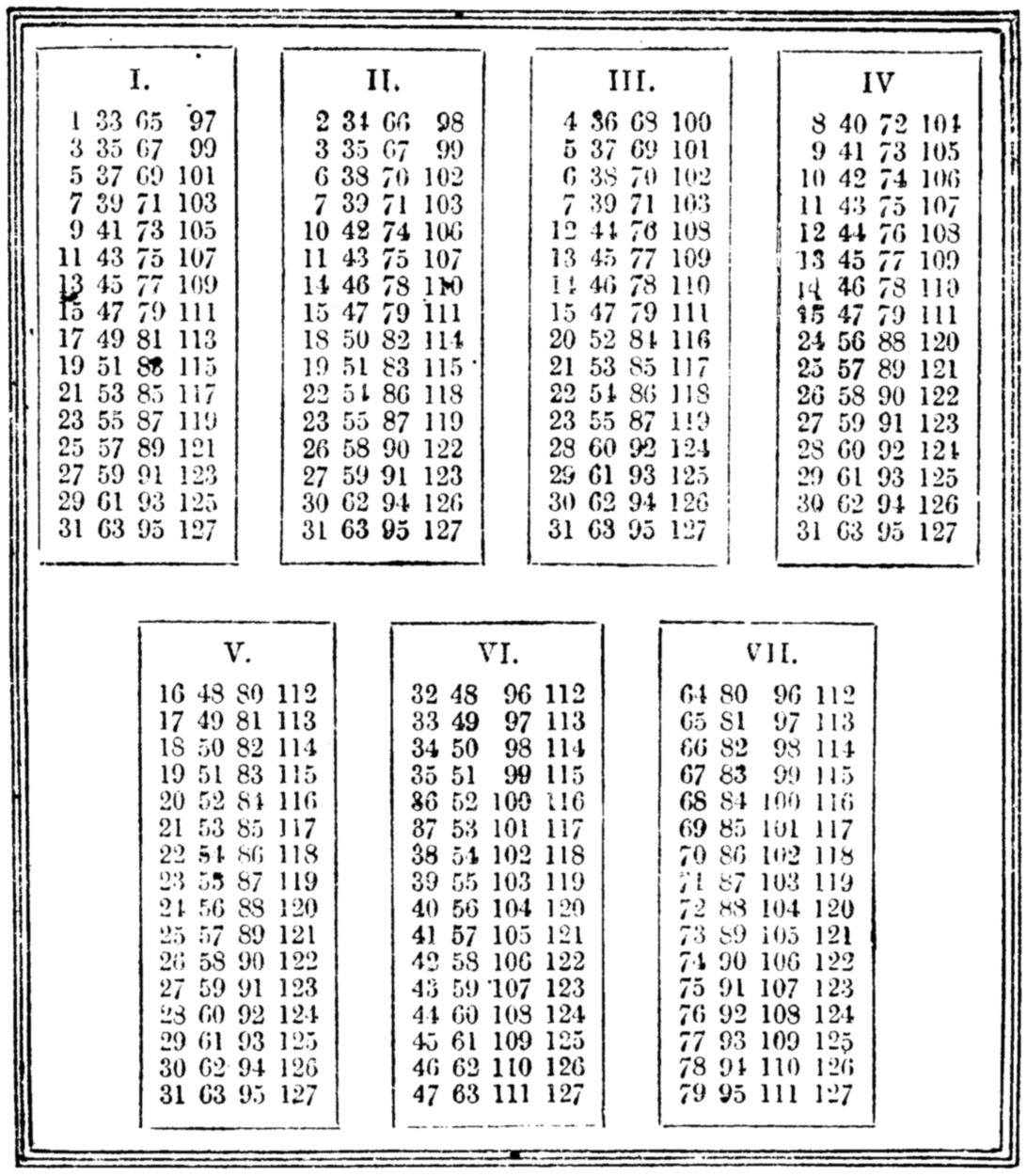
Return to description
No. LXXI.—A PUZZLE WITH CHESS PIECES
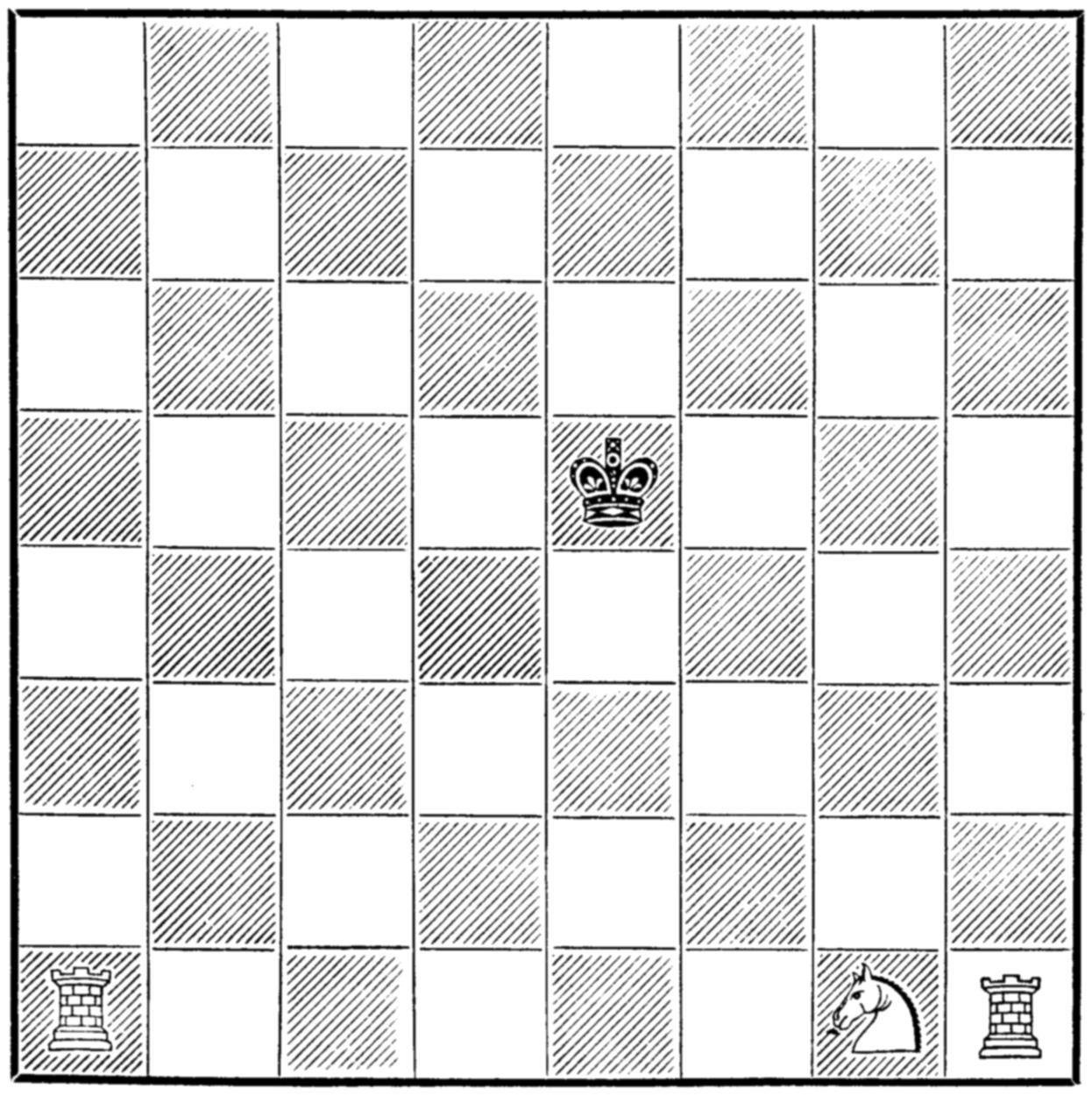
Return to description
No. LXXIX
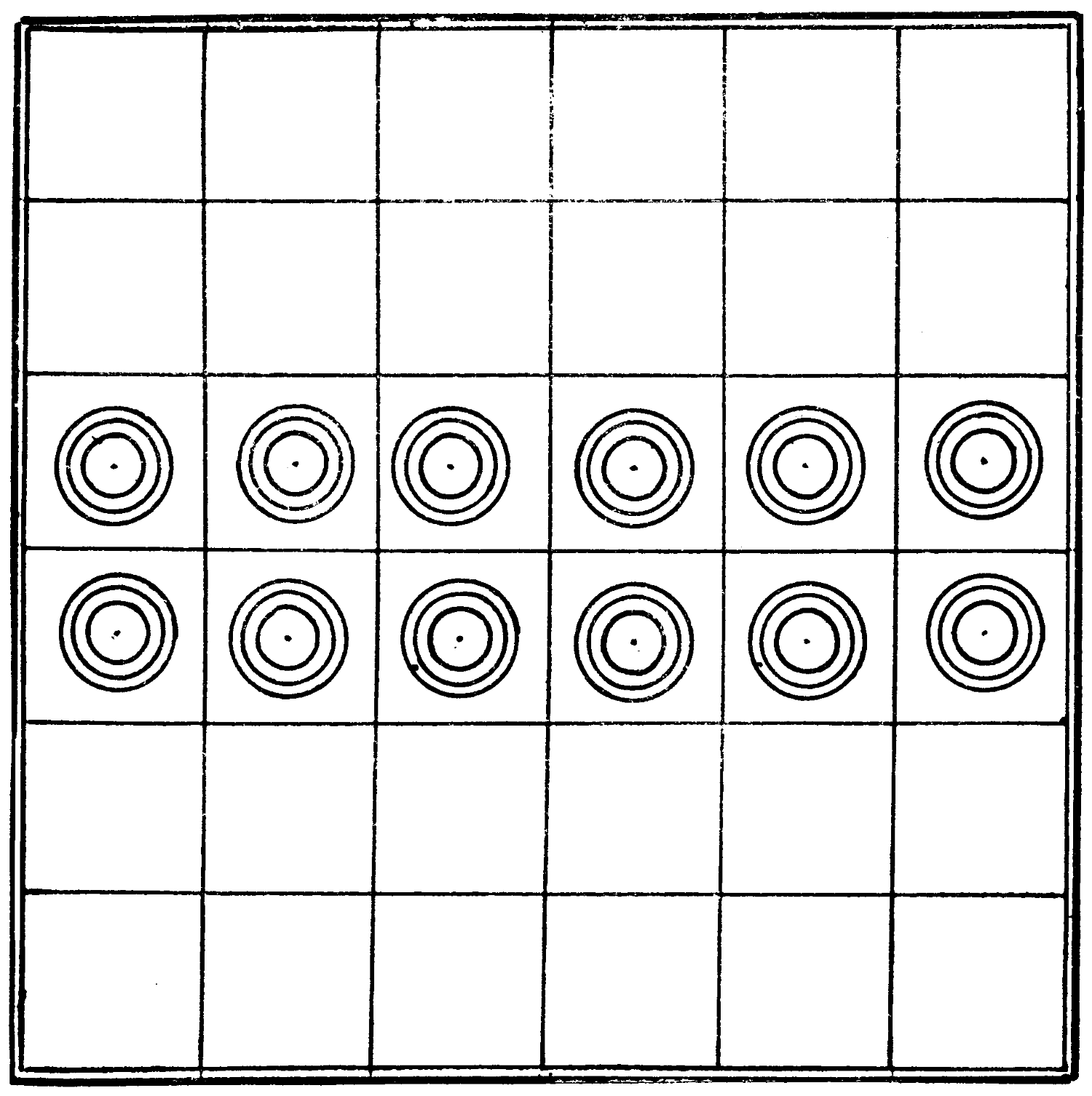
Return to description
No. LXXXV.—MANY READINGS
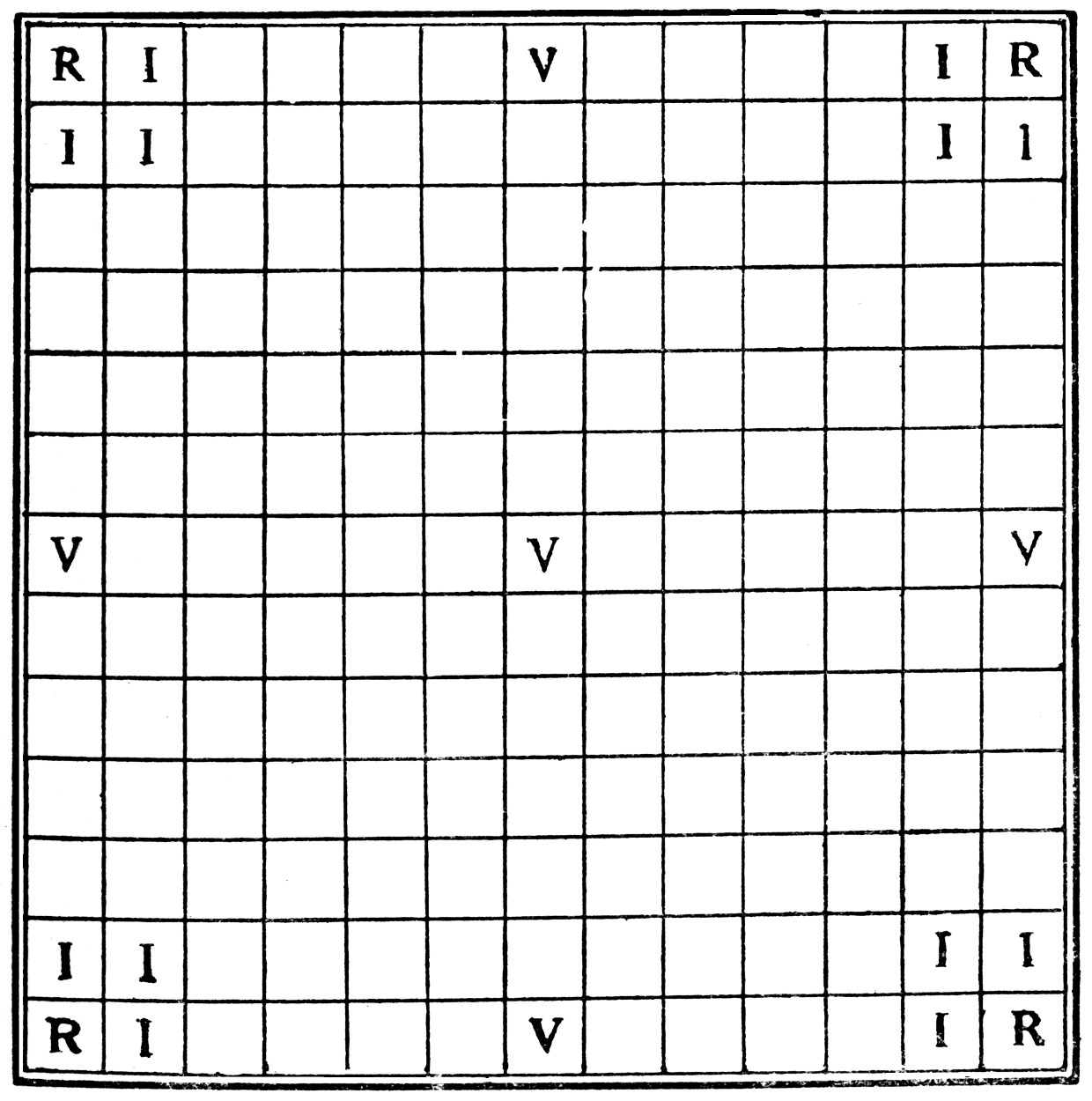
Return to description
No. LXXXVI.—TOLD AT A GLANCE
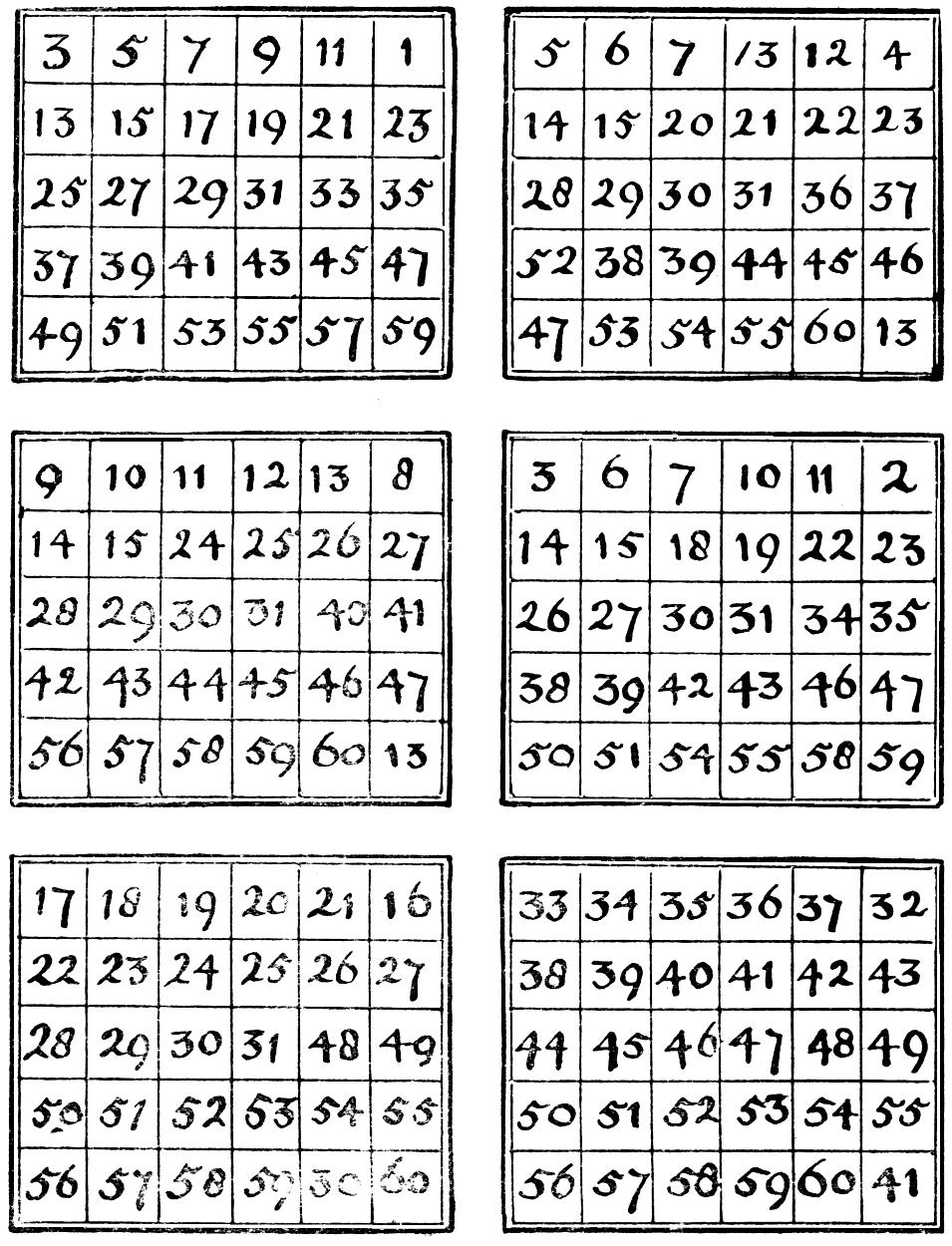
Return to description
No. LXXXVII.
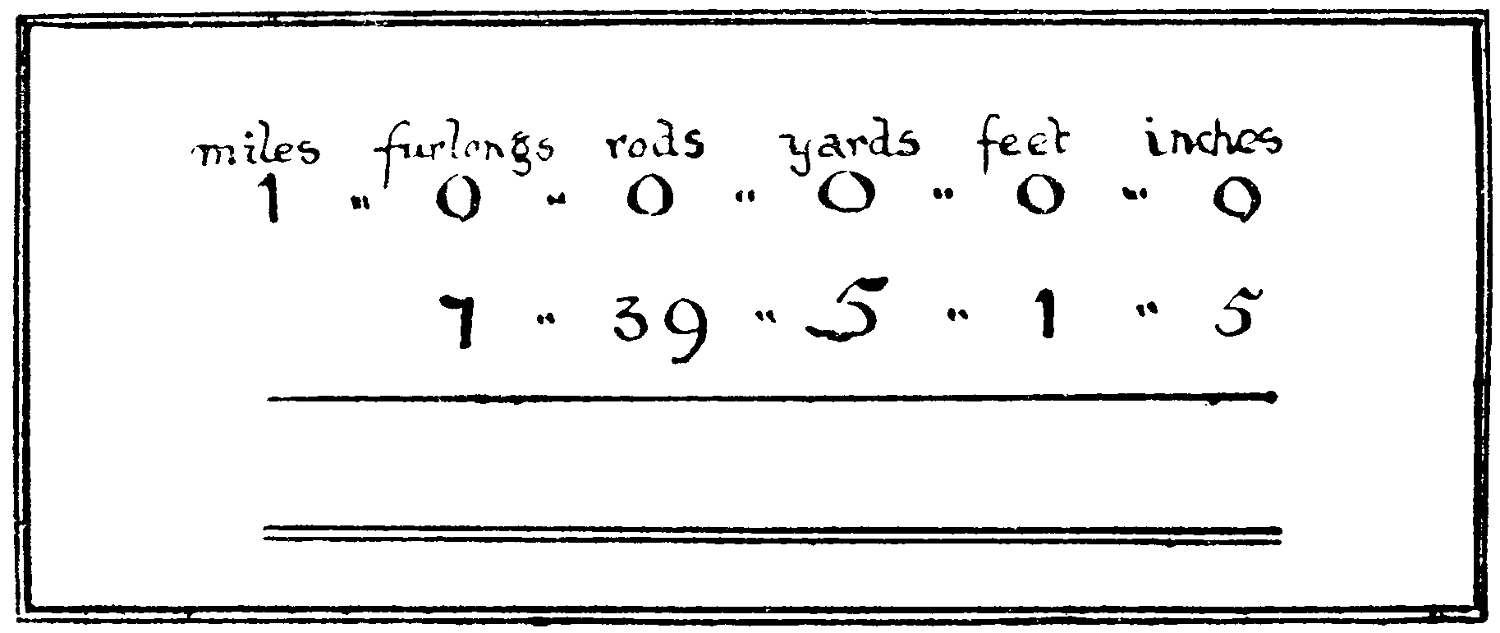
Return to description
No. LXXXVIII.—RANGING THE DIGITS
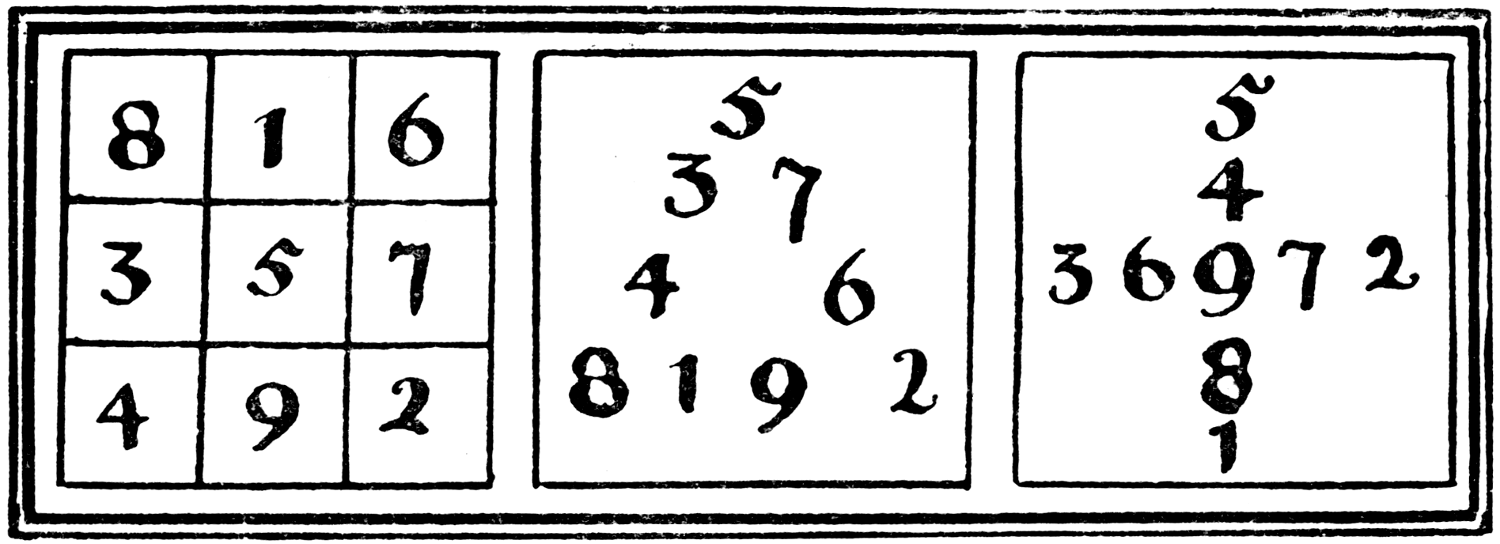
Return to description
No. LXXXIX.—NO TWO IN A ROW
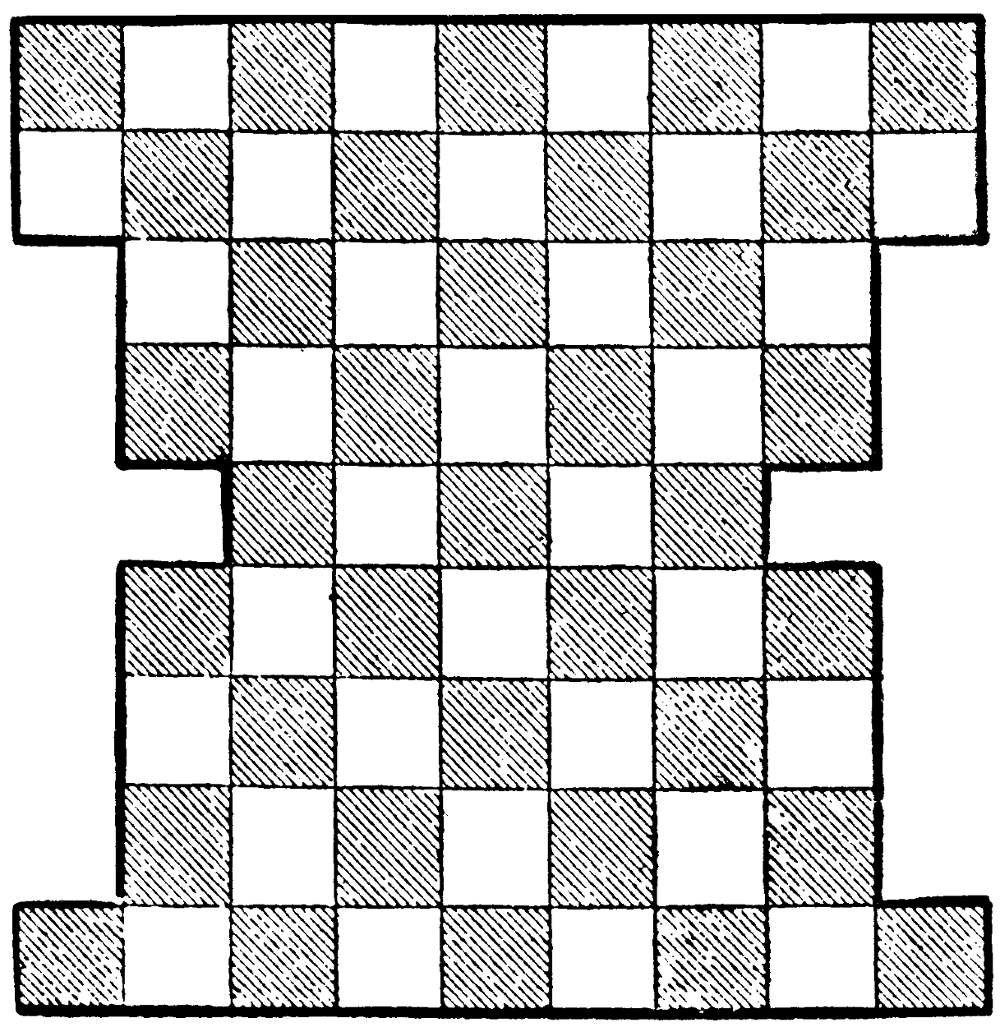
Return to description
No. XC.—EXACT ALIGNMENT
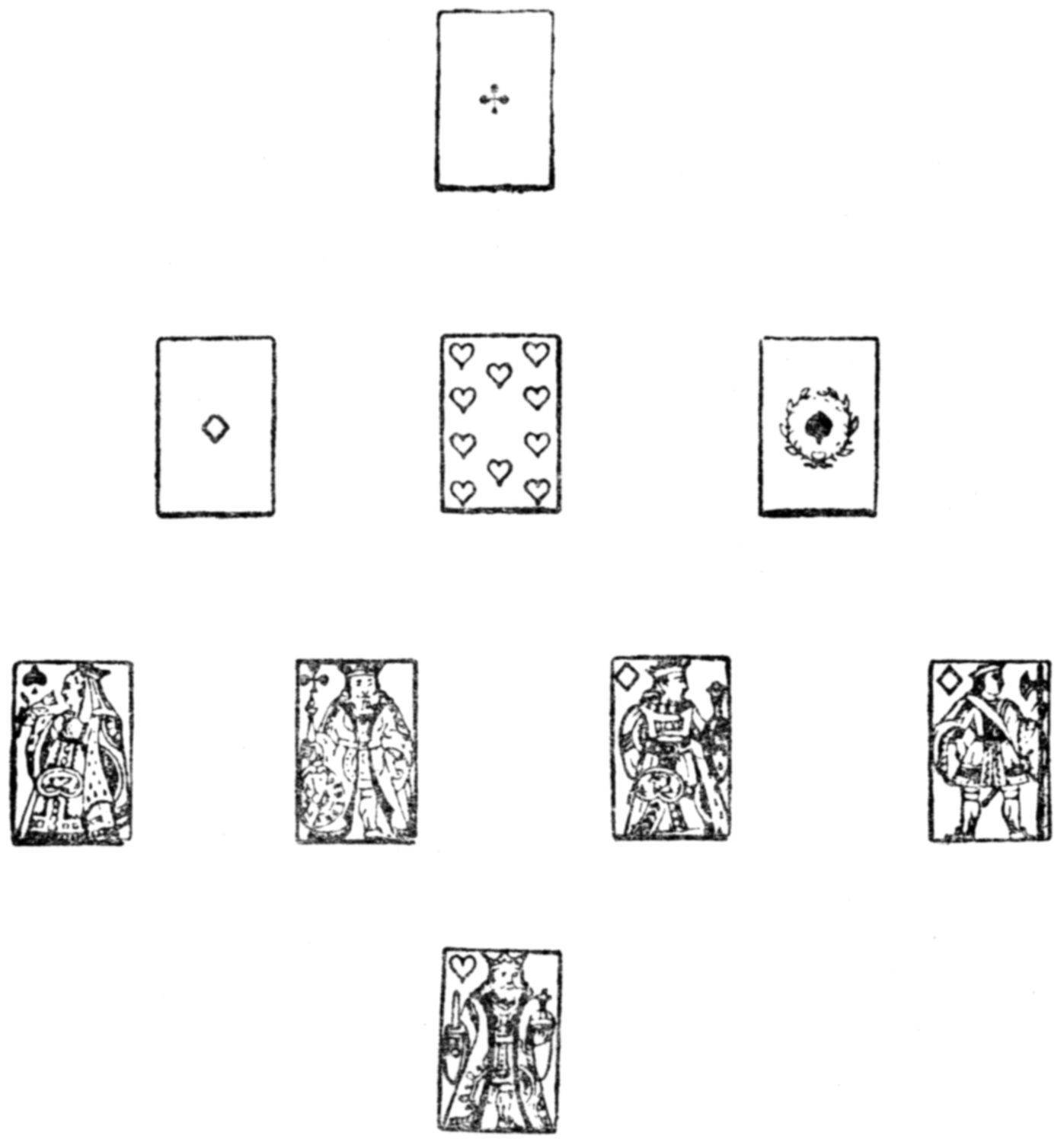
Return to description
No. XCI.—AT A FANCY BALL
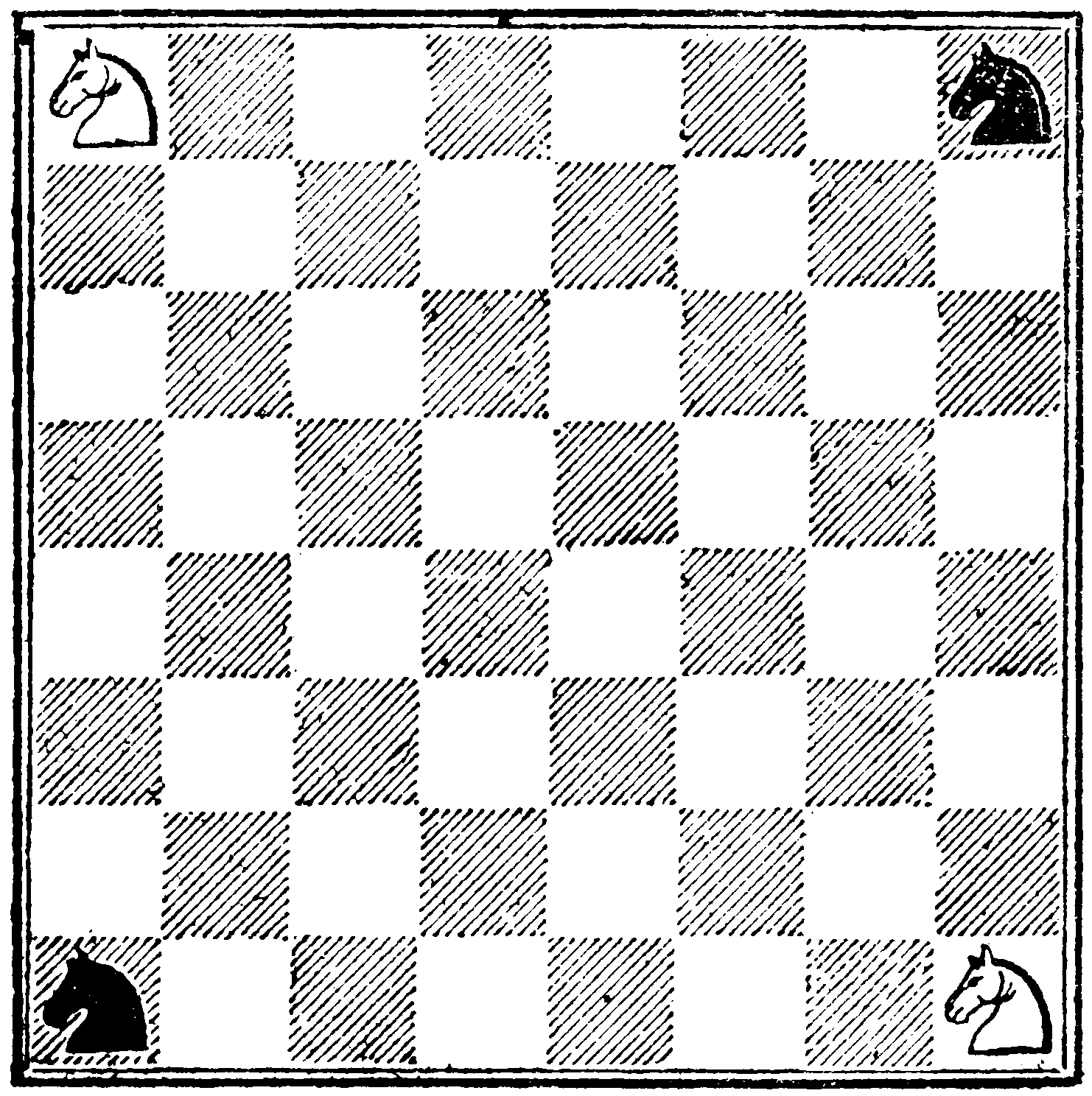
Return to description
No. XCII.—PROVERBIAL PHILOSOPHY IN CELLS
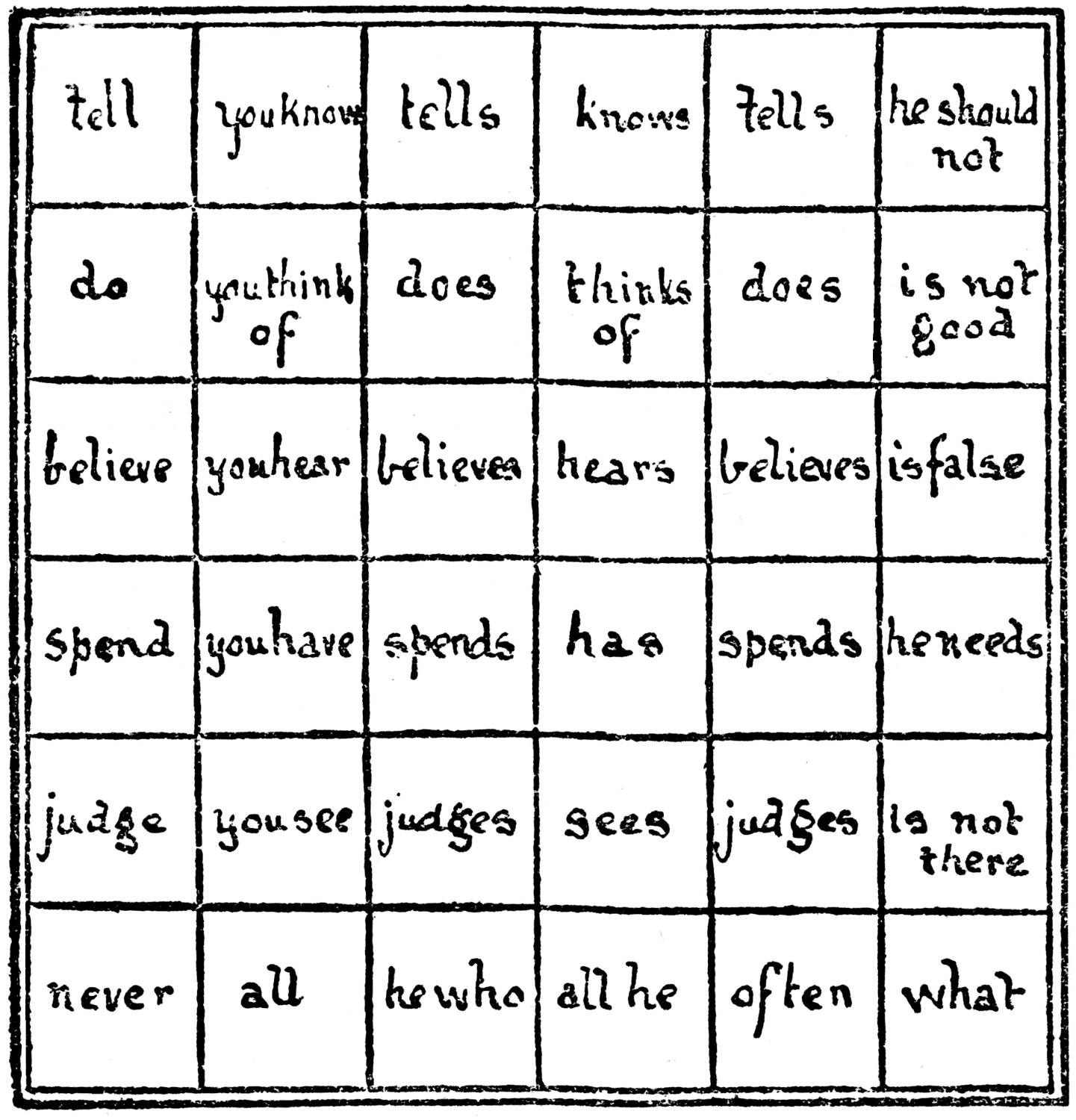
Return to description
No. XCVI.—A NEW CHESS PUZZLE
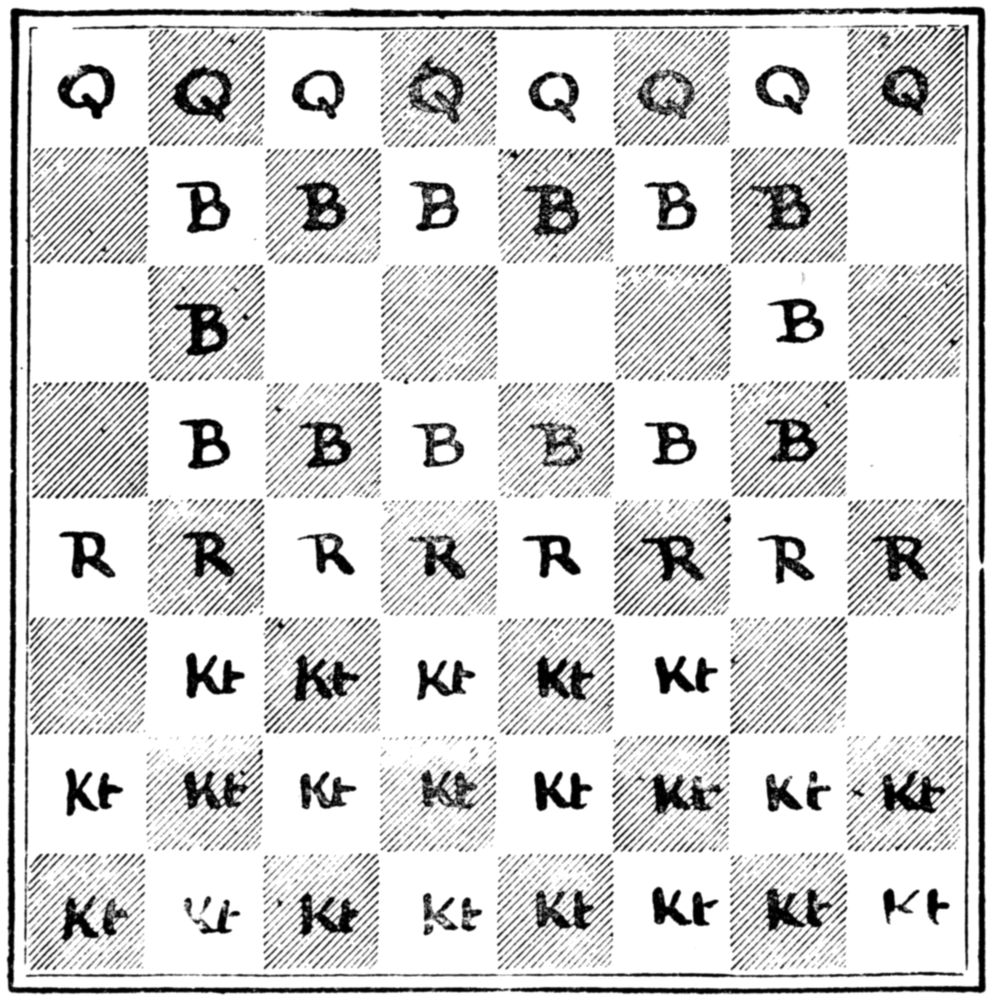
Return to description
No. CII.—A KNIGHT’S POETIC TOUR
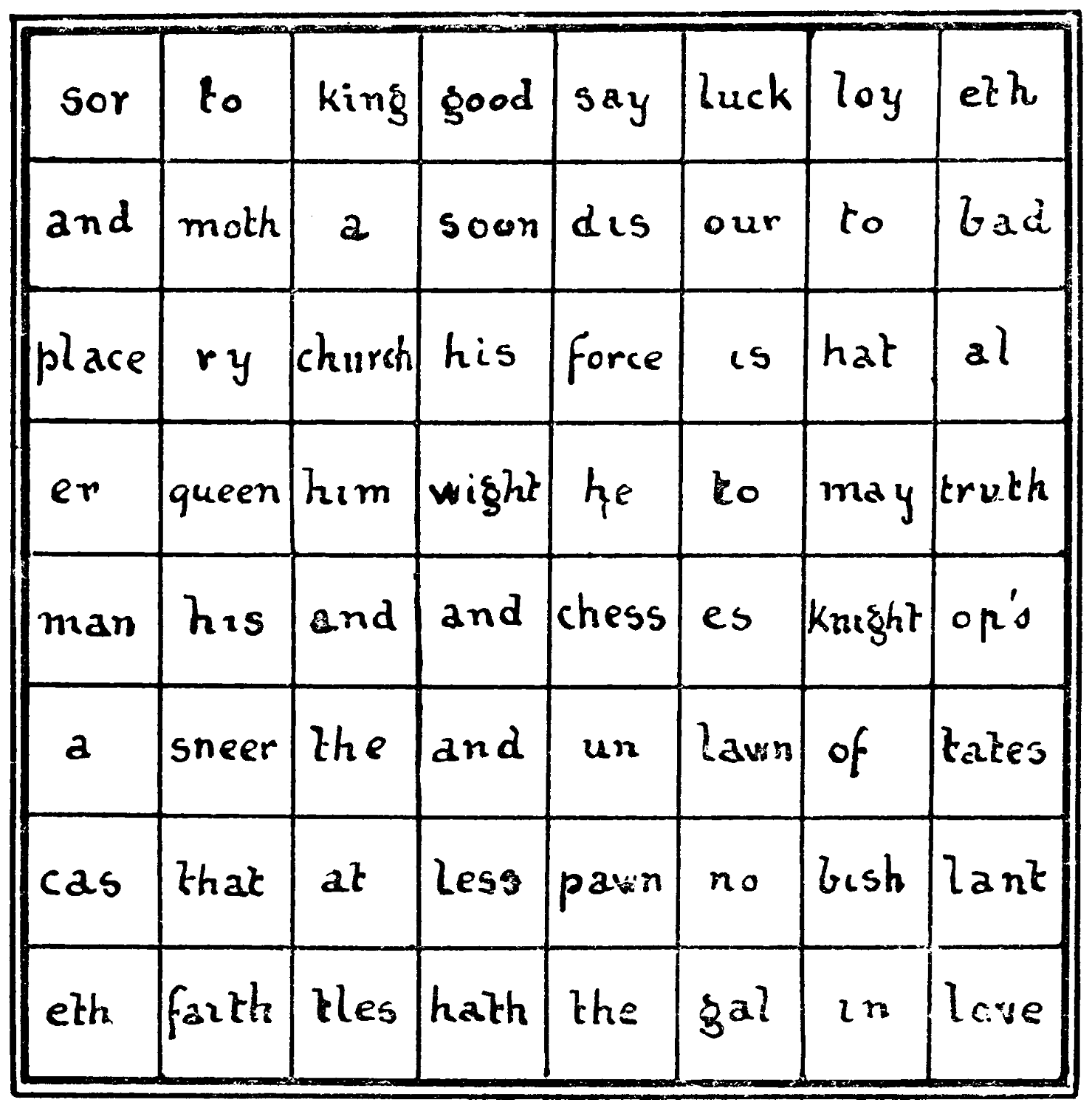
Return to description
No. CIV.—SCORING A CENTURY
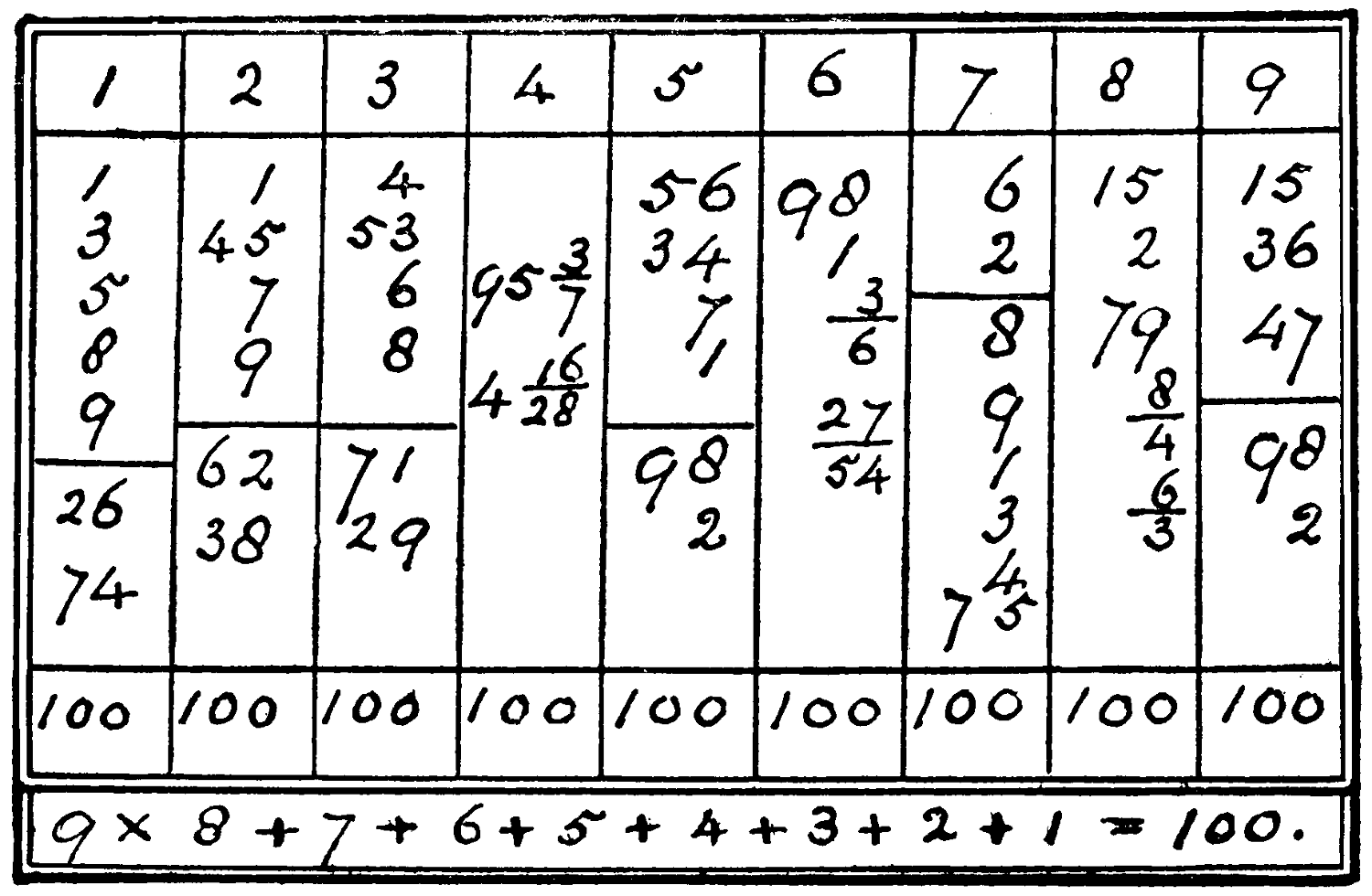
Return to description
No. CXXI.—DOMINO SQUARE
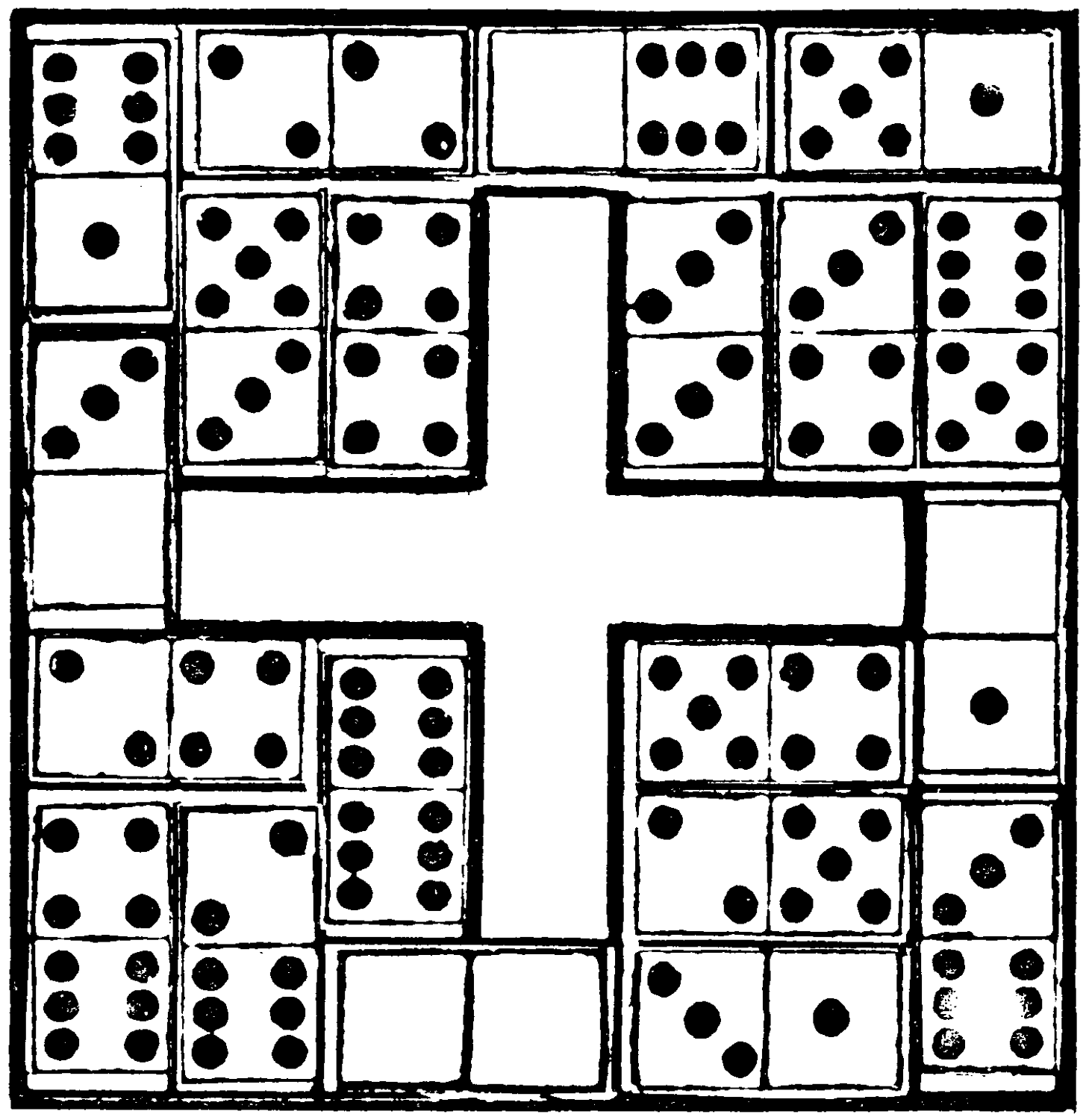
Return to description
242. A TANGLED SQUARE
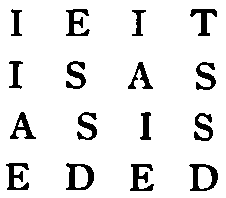
Return to description
274. A PUZZLE ACROSTIC
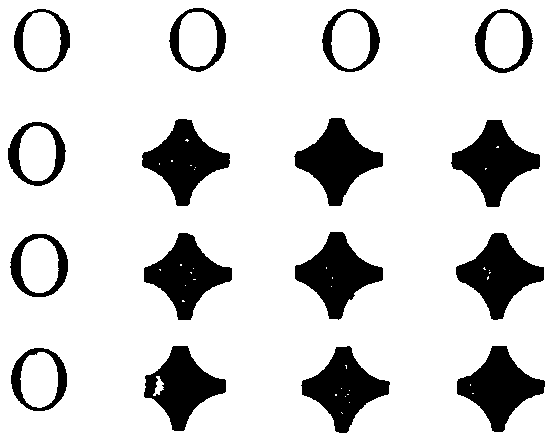
Return to description
1. A SUM WITHOUT FIGURES
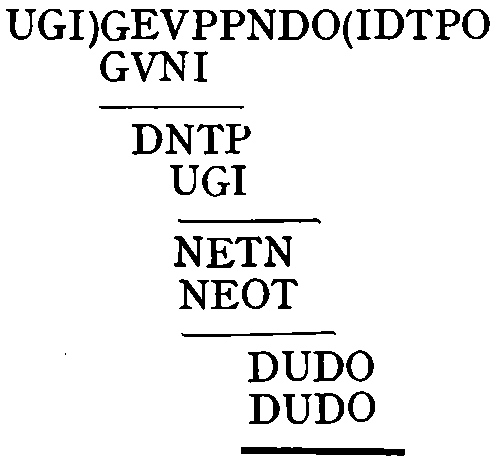
Return to description
3. THE SQUAREST WORD
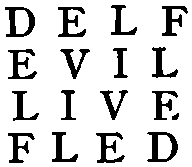
Return to description
4. A CROSS PURPOSE
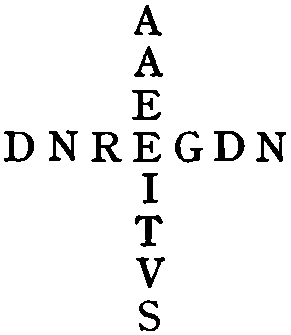
Return to description
6. A WORD SQUARE
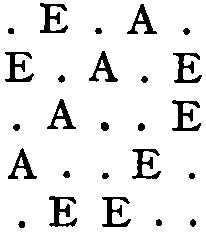
Return to description
7. VERBAL ARITHMETIC
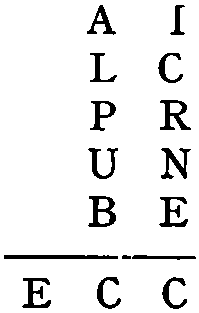
Return to description
8. A WORD SQUARE
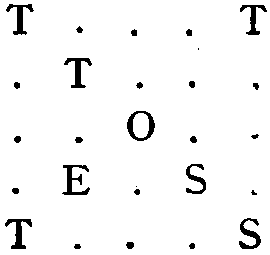
Return to description
11. GAPS TO FILL
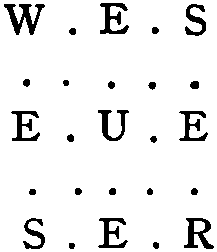
Return to description
17. MISSING FIGURES
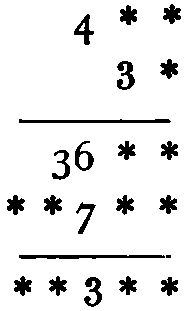
Return to description
No. IV
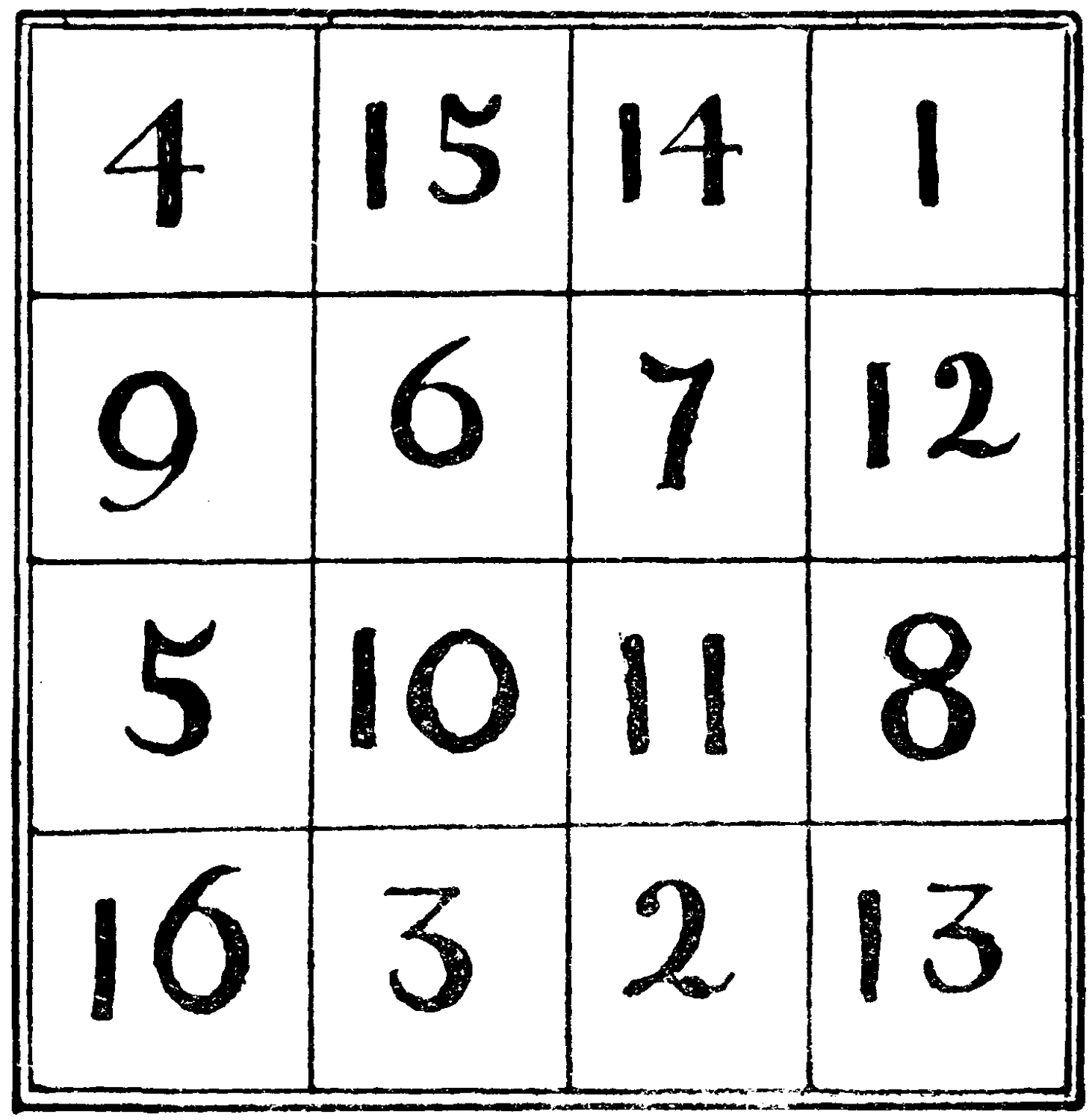
Return to solution
No. VIII
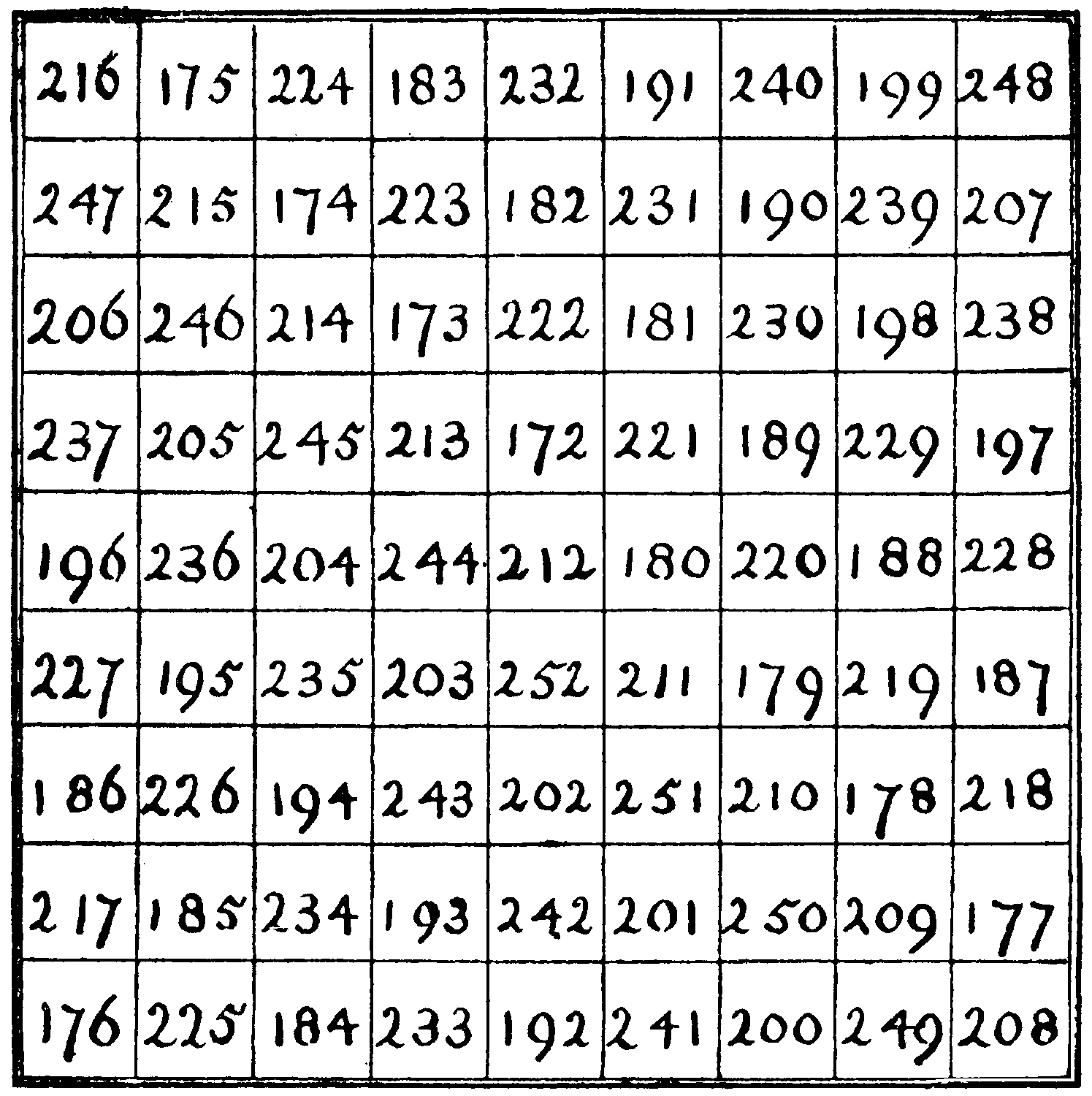
Return to solution
No. IX
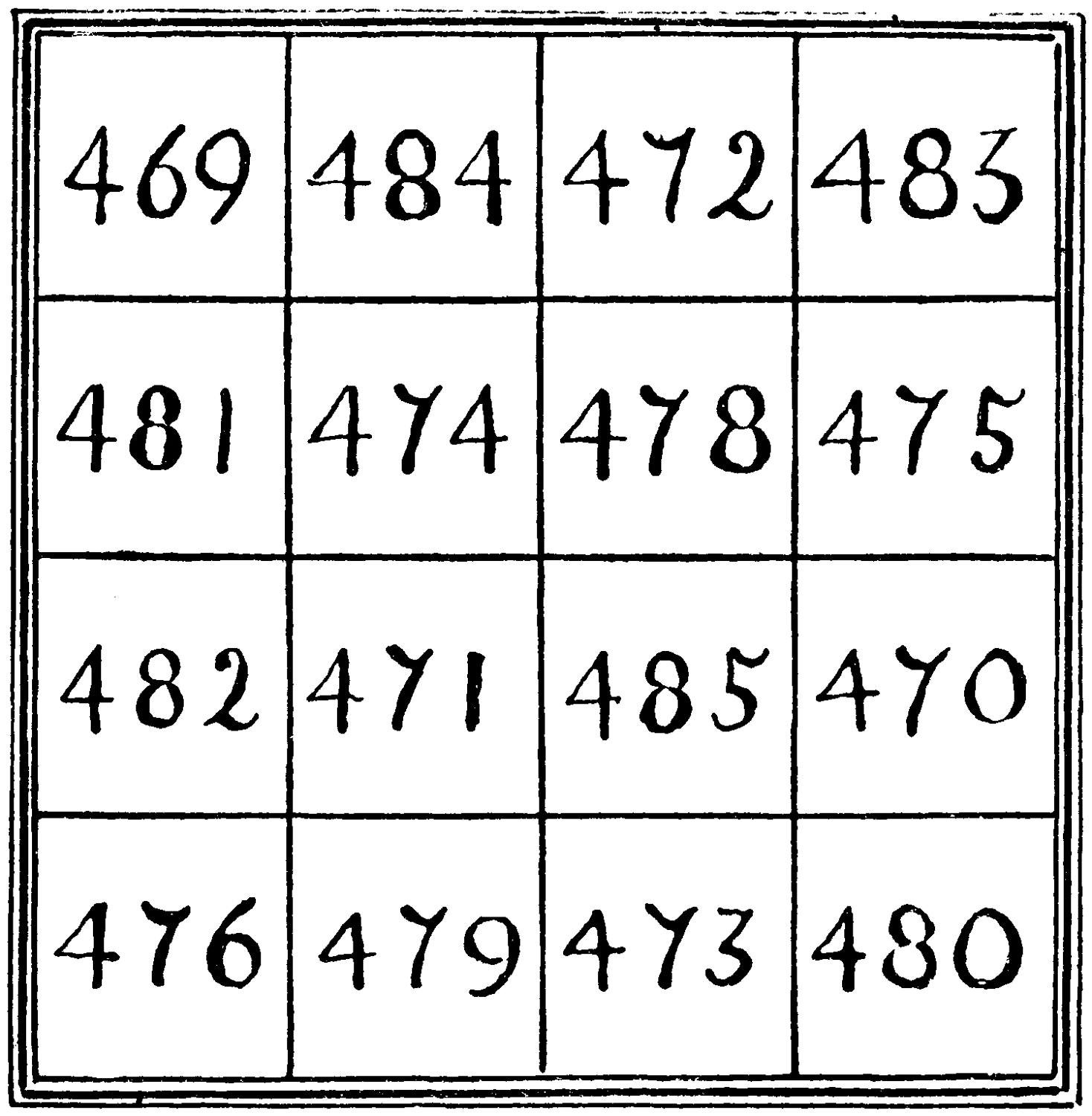
Return to solution
No. X
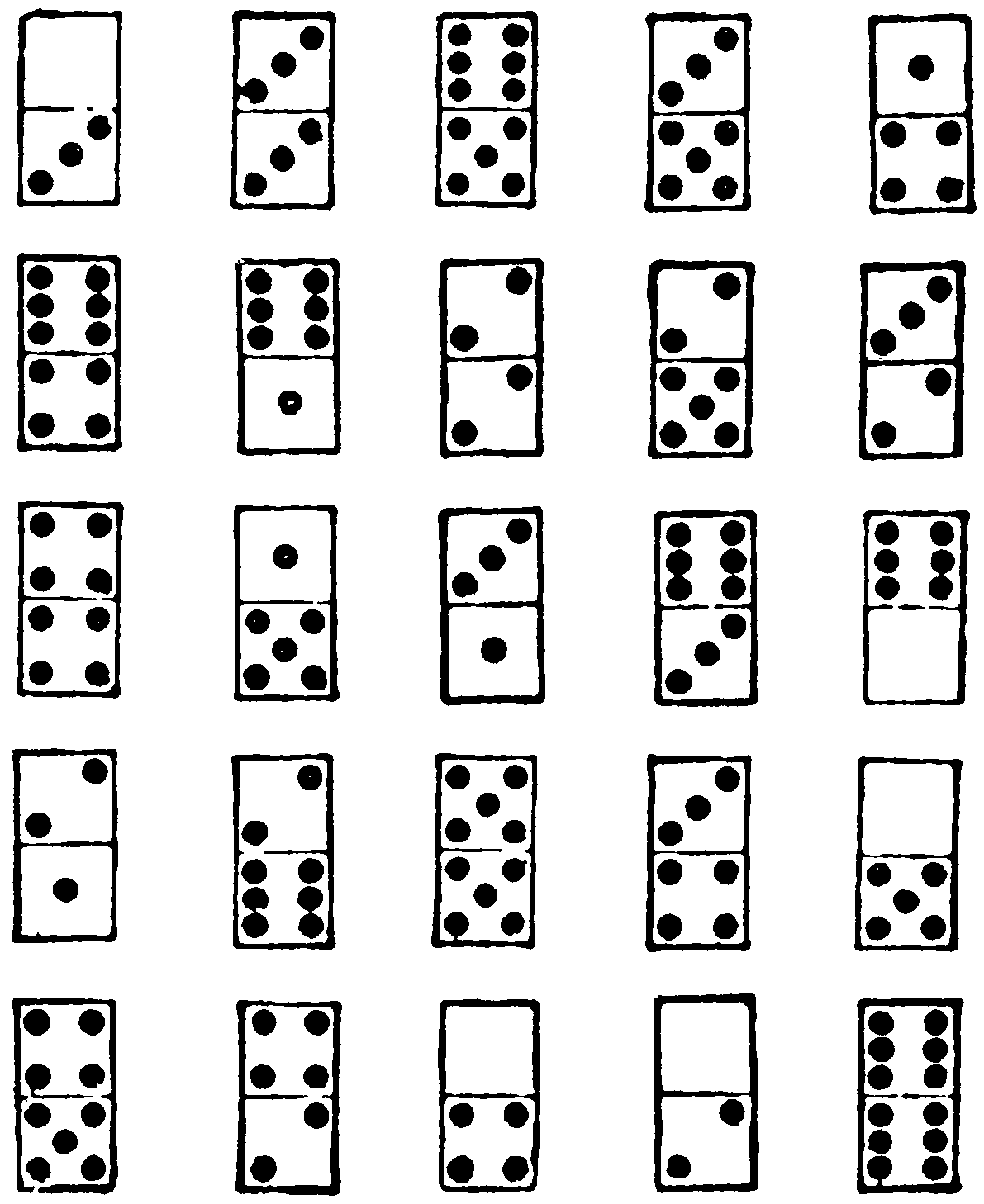
Return to solution
No. XII
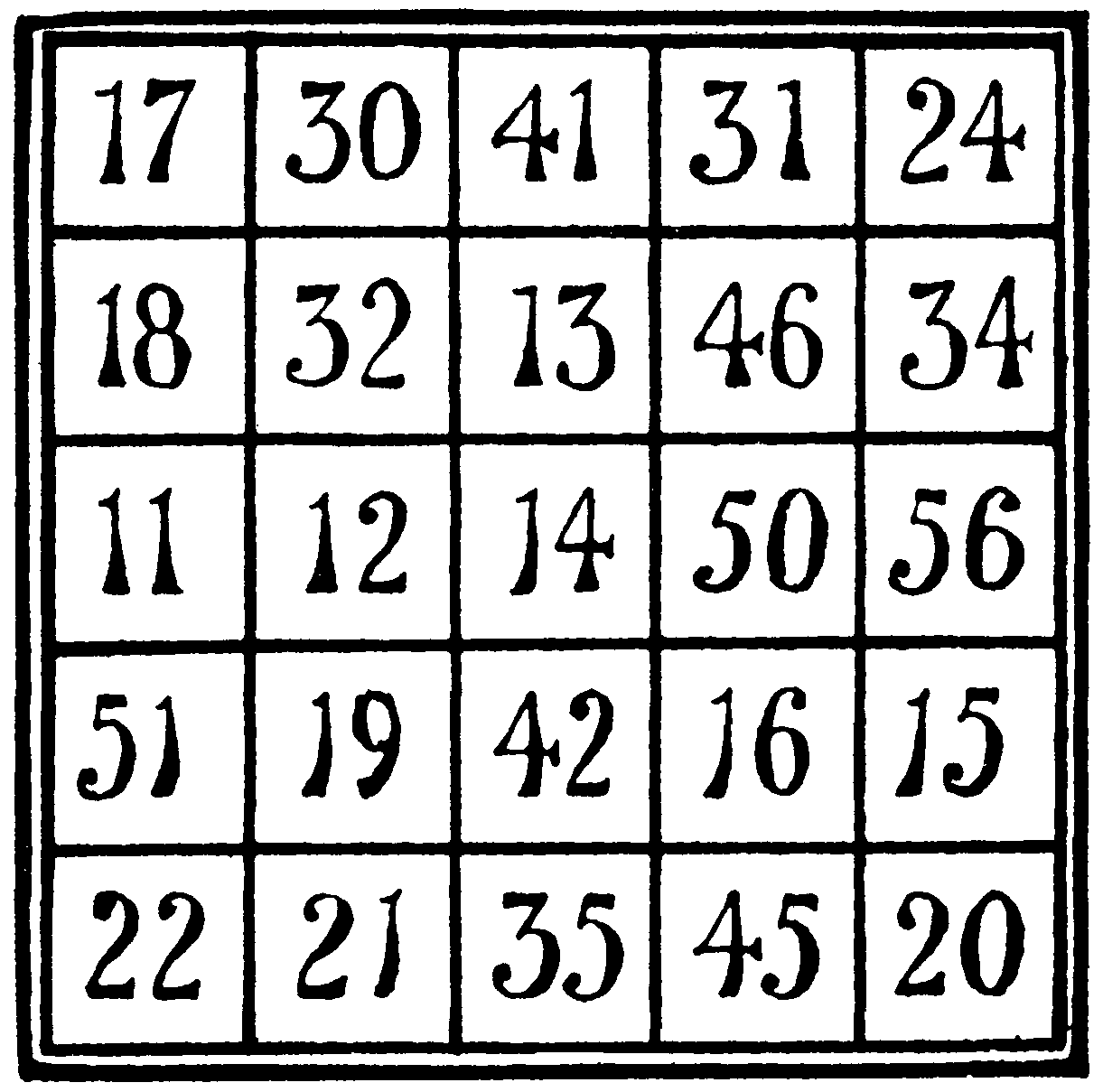
Return to solution
No. XIV
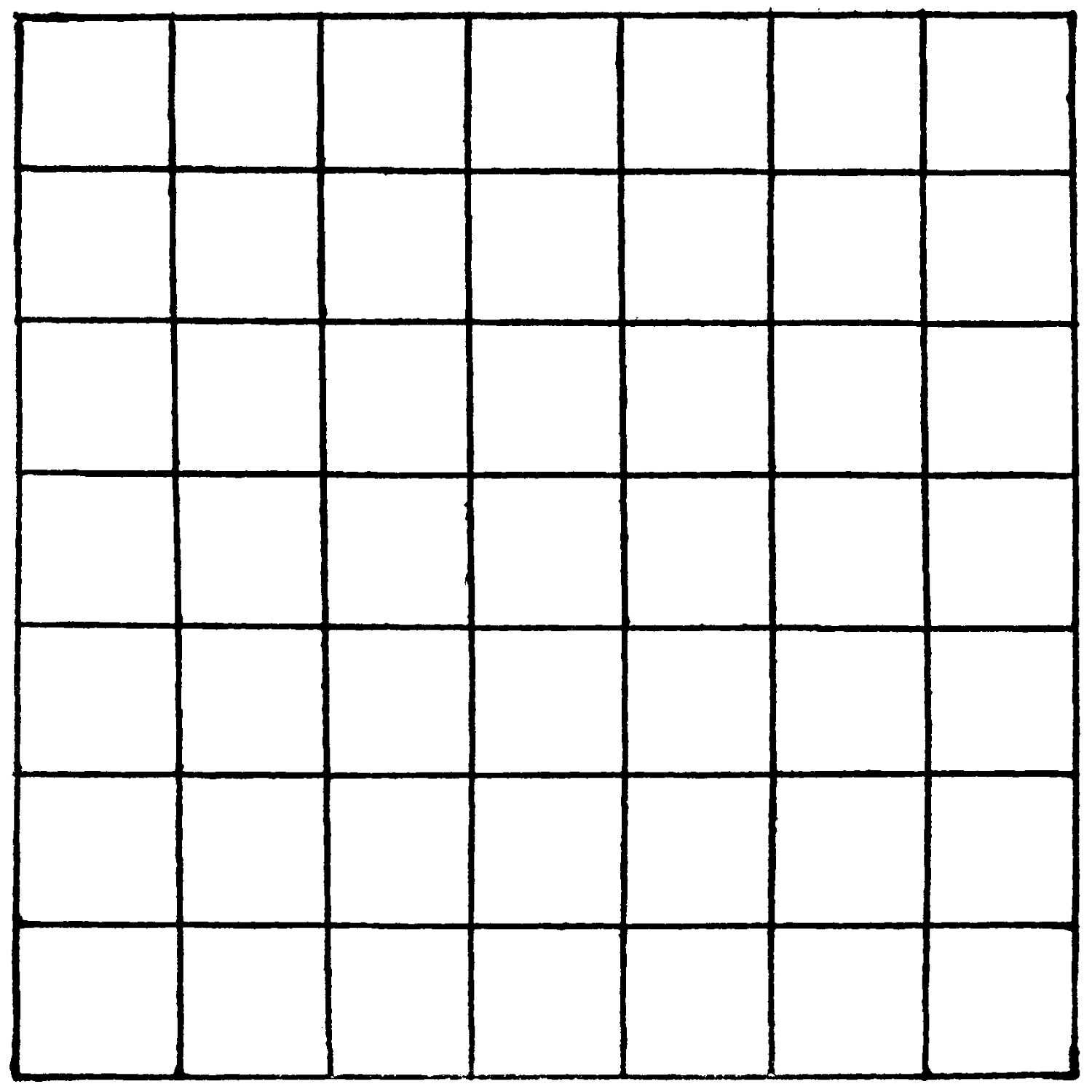
Return to solution
No. XV
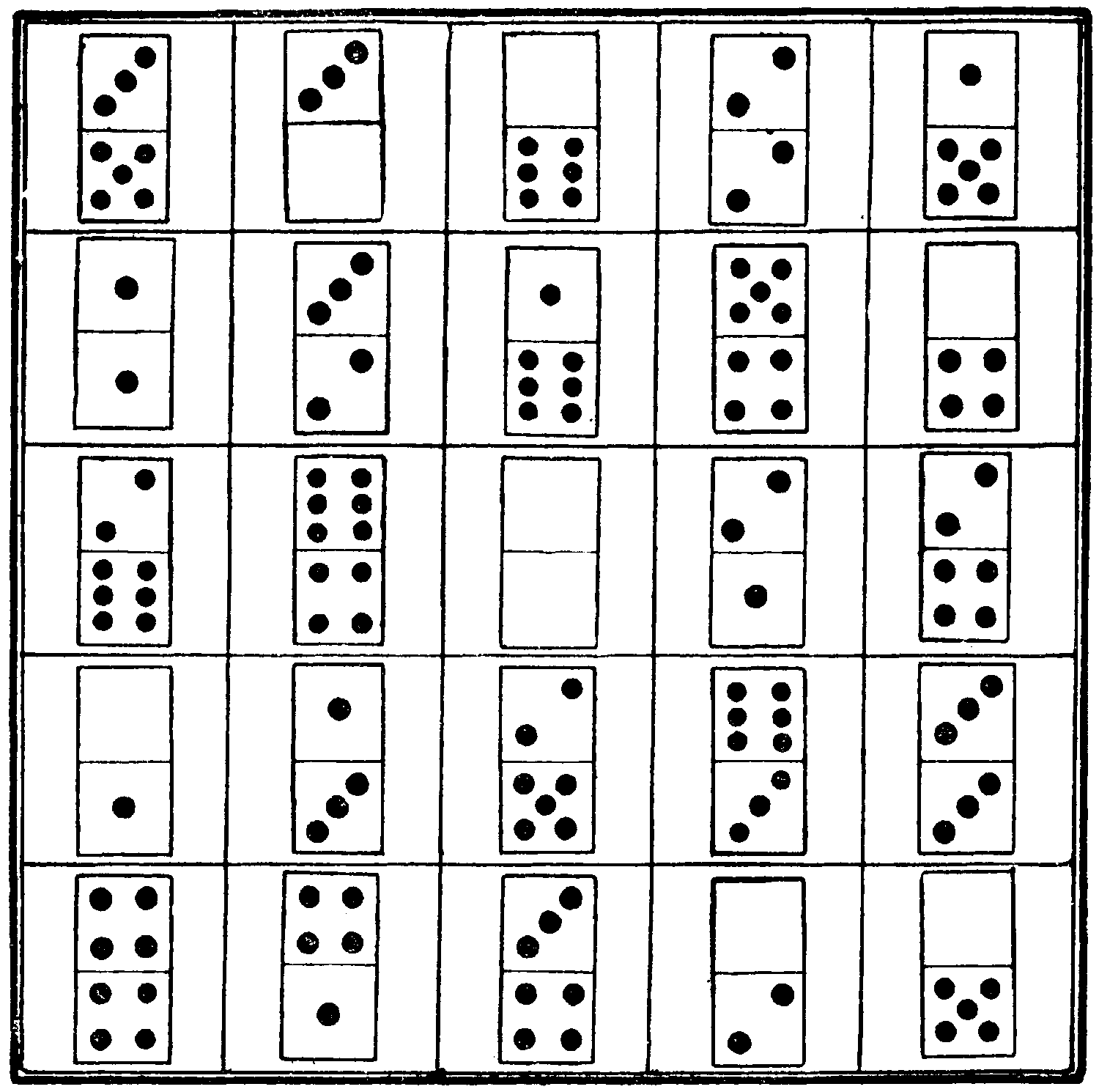
Return to solution
No. XVI
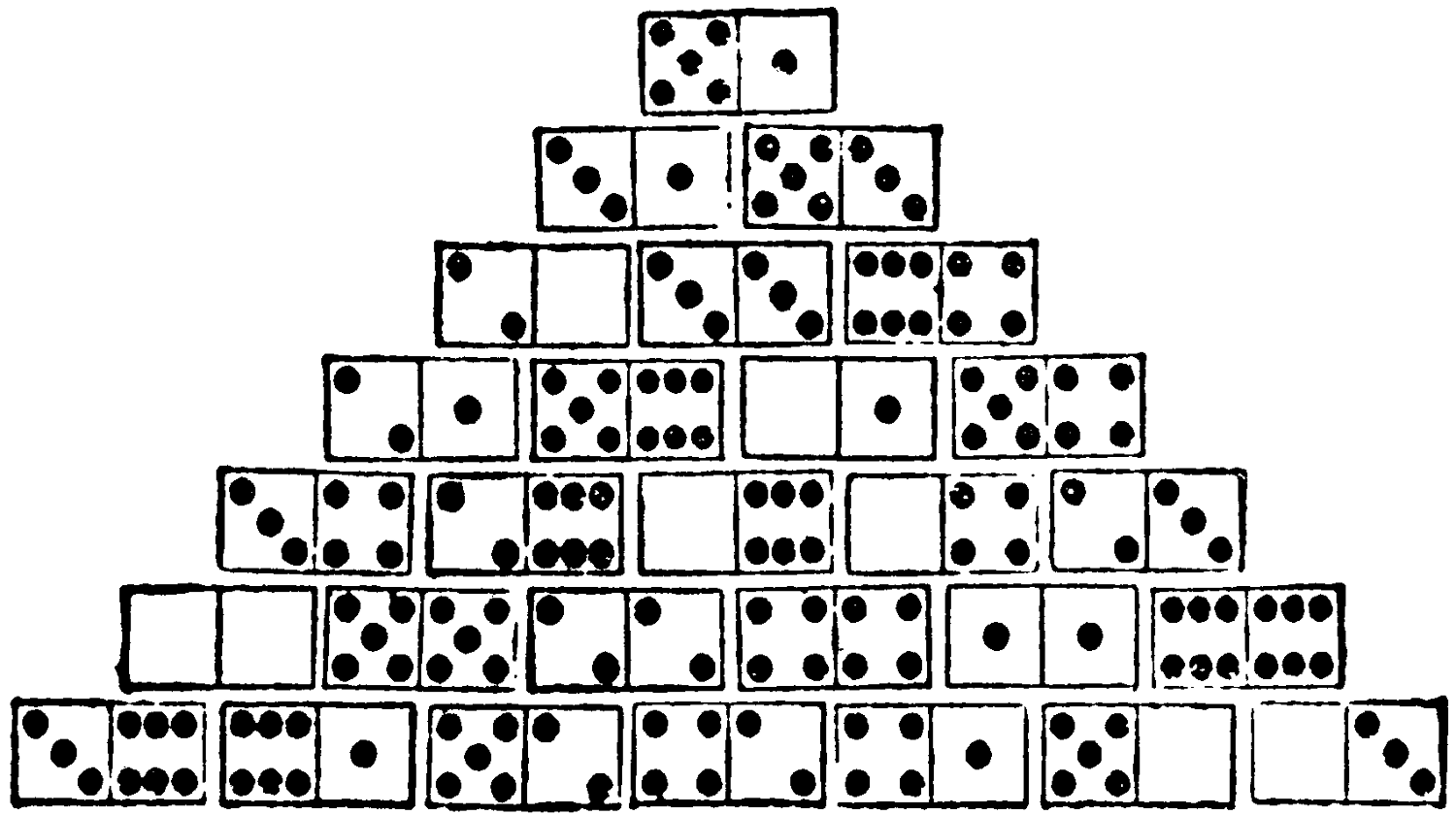
Return to solution
No. XXXII
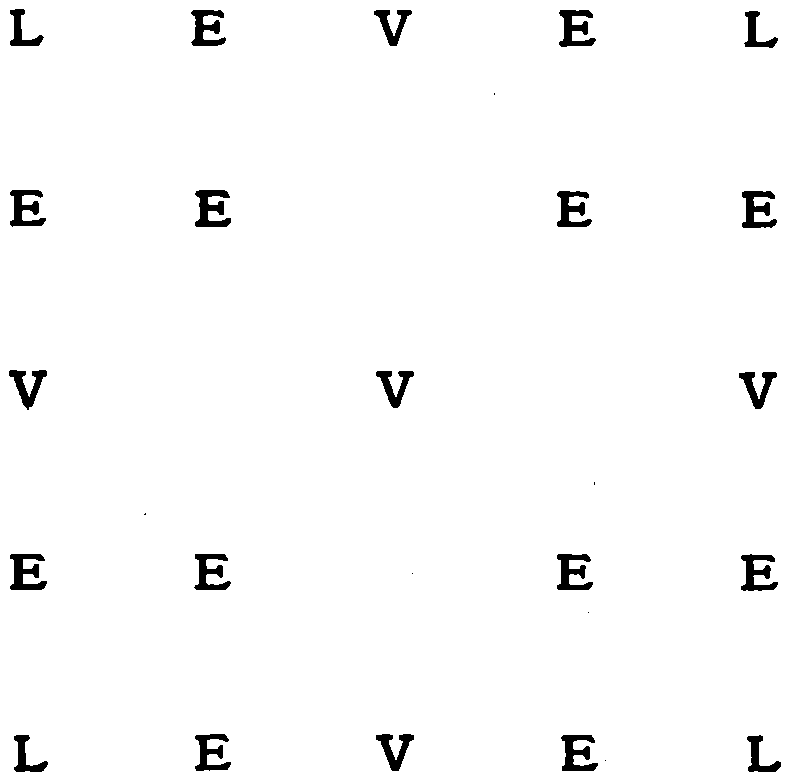
Return to solution
No. XXXIII
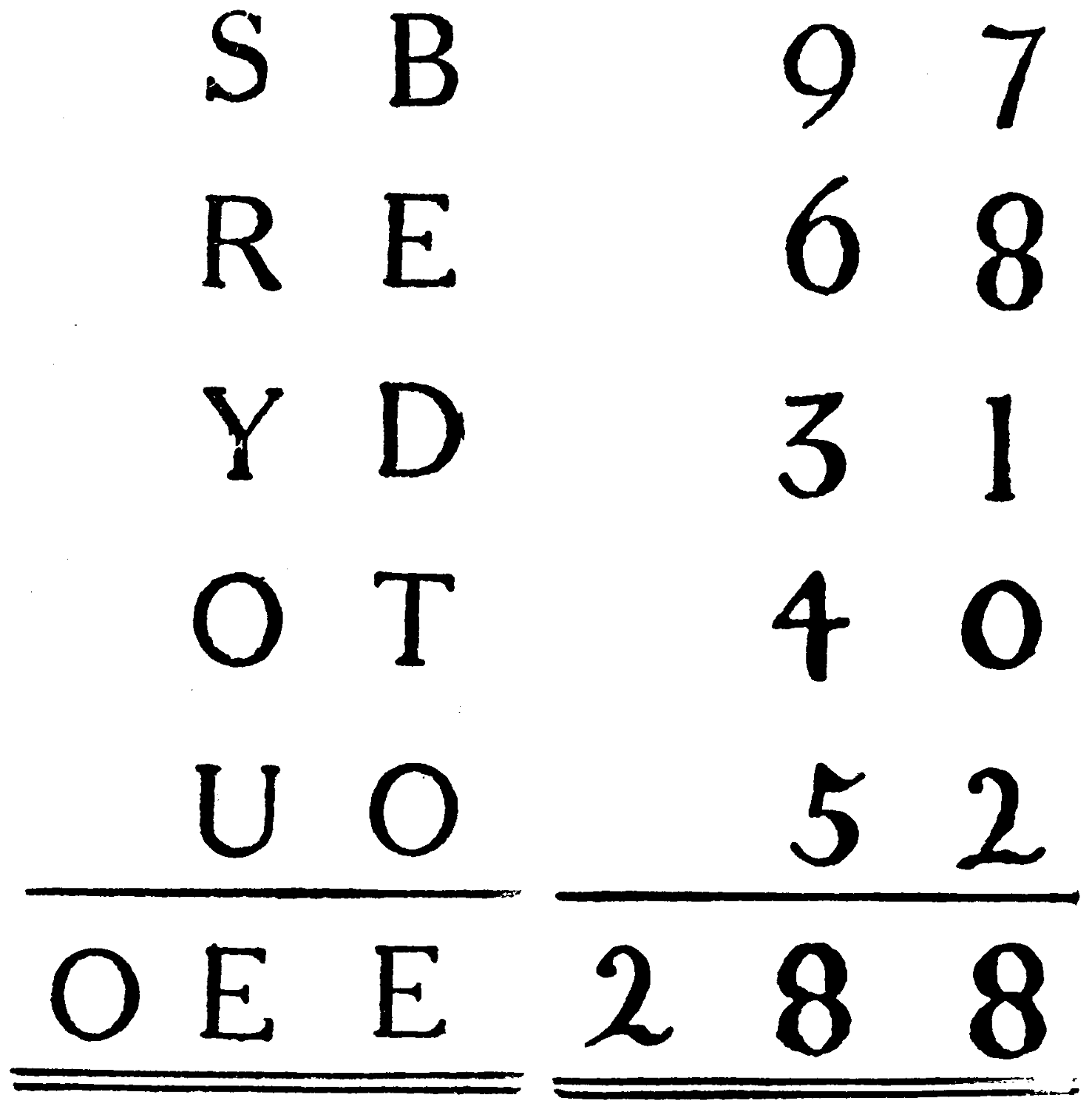
Return to solution
No. XXXIV
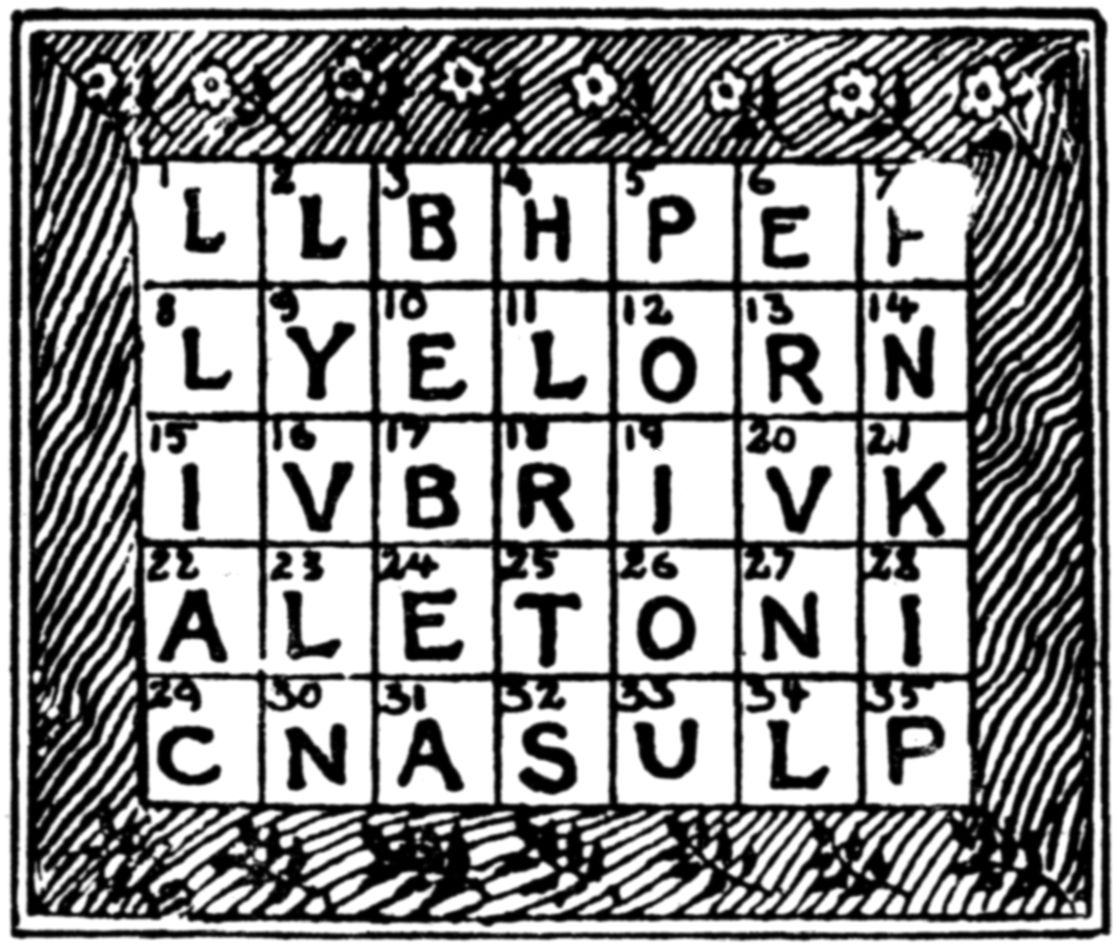
Return to solution
No. XXXV
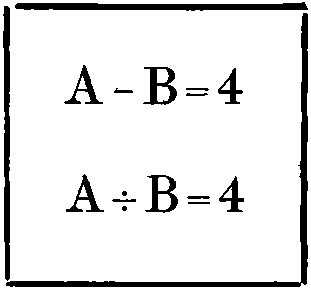
Return to solution
No. XXXVI
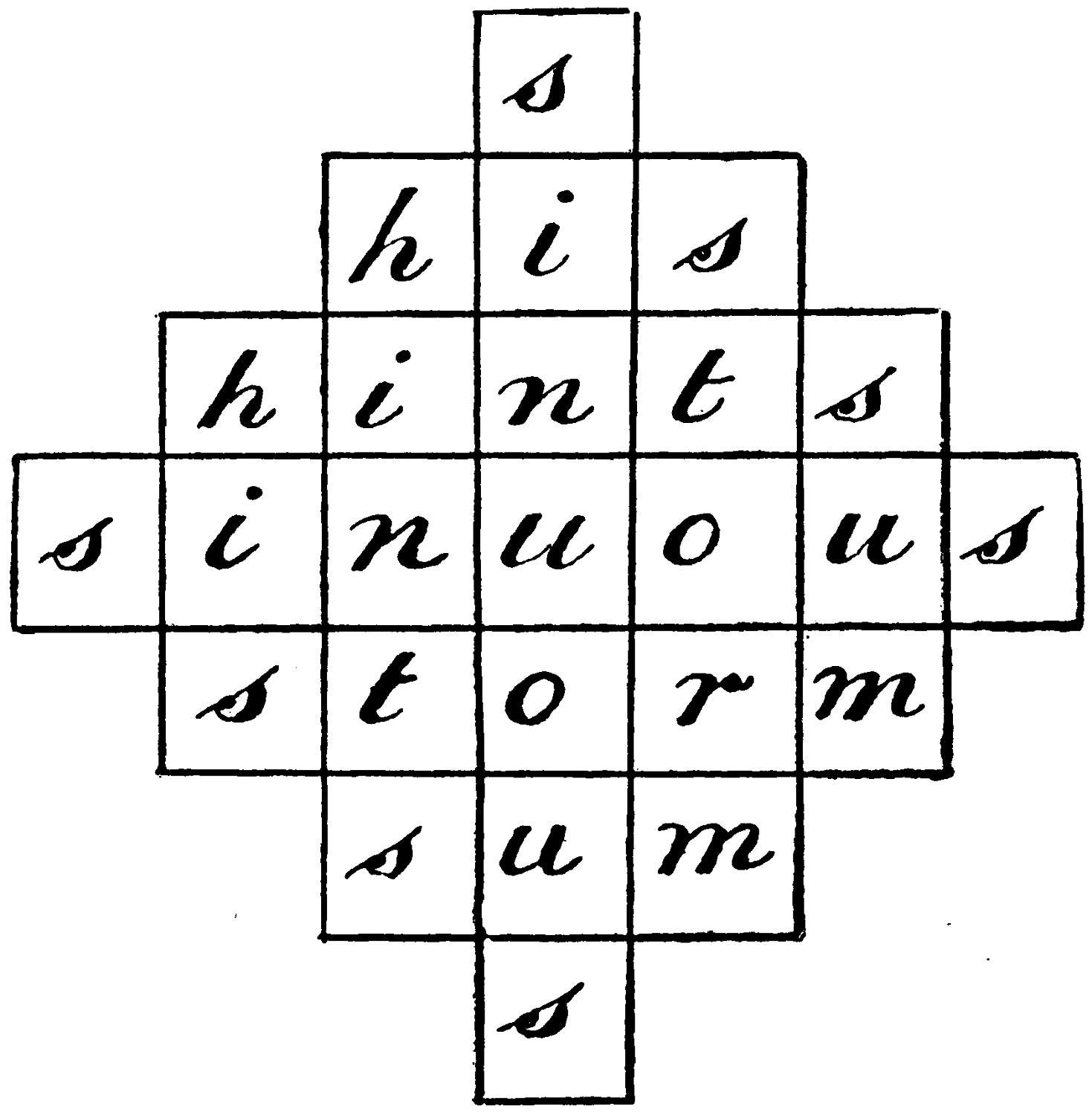
Return to solution
No. XXXVII
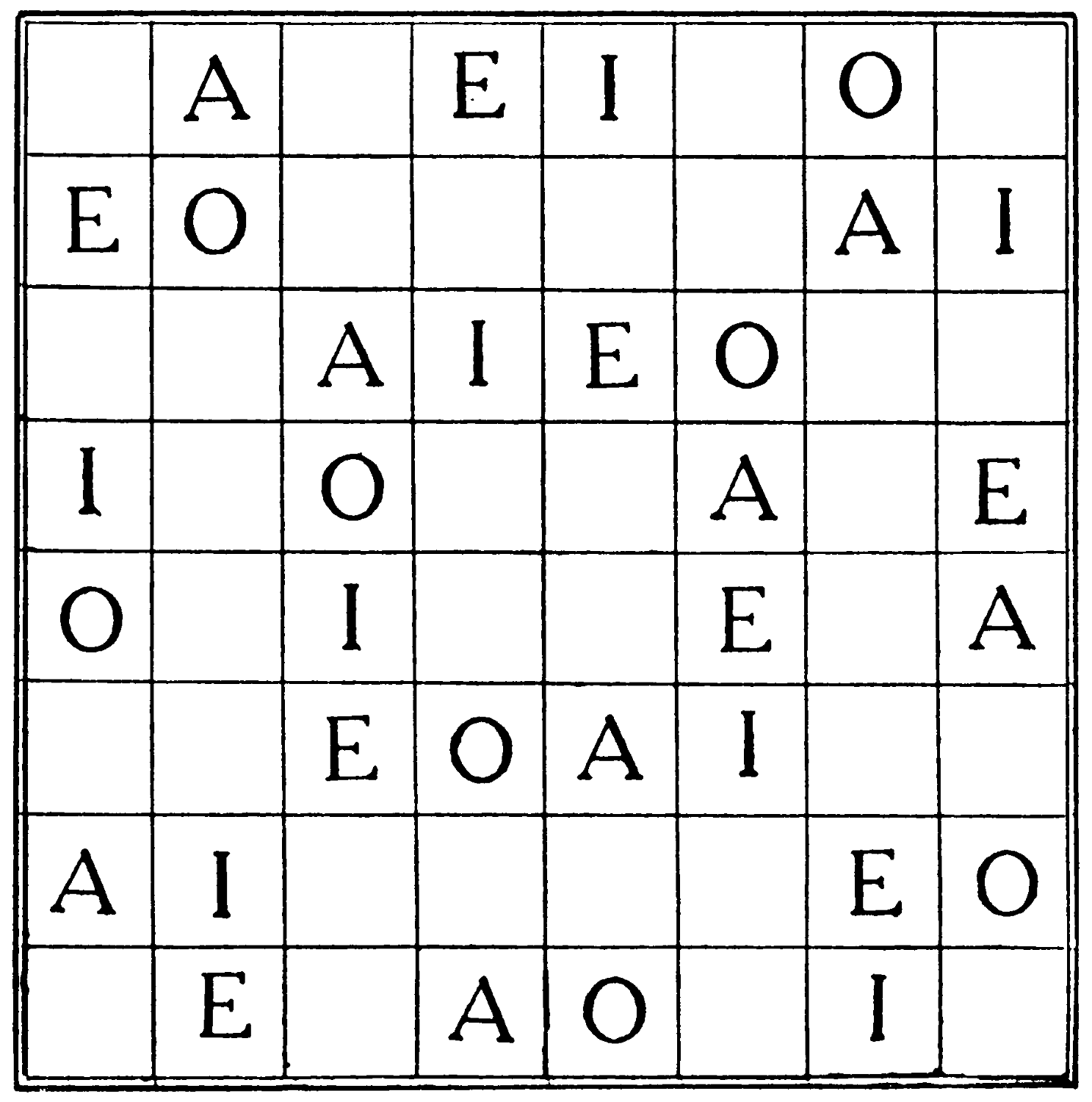
Return to solution
No. XXXVIII
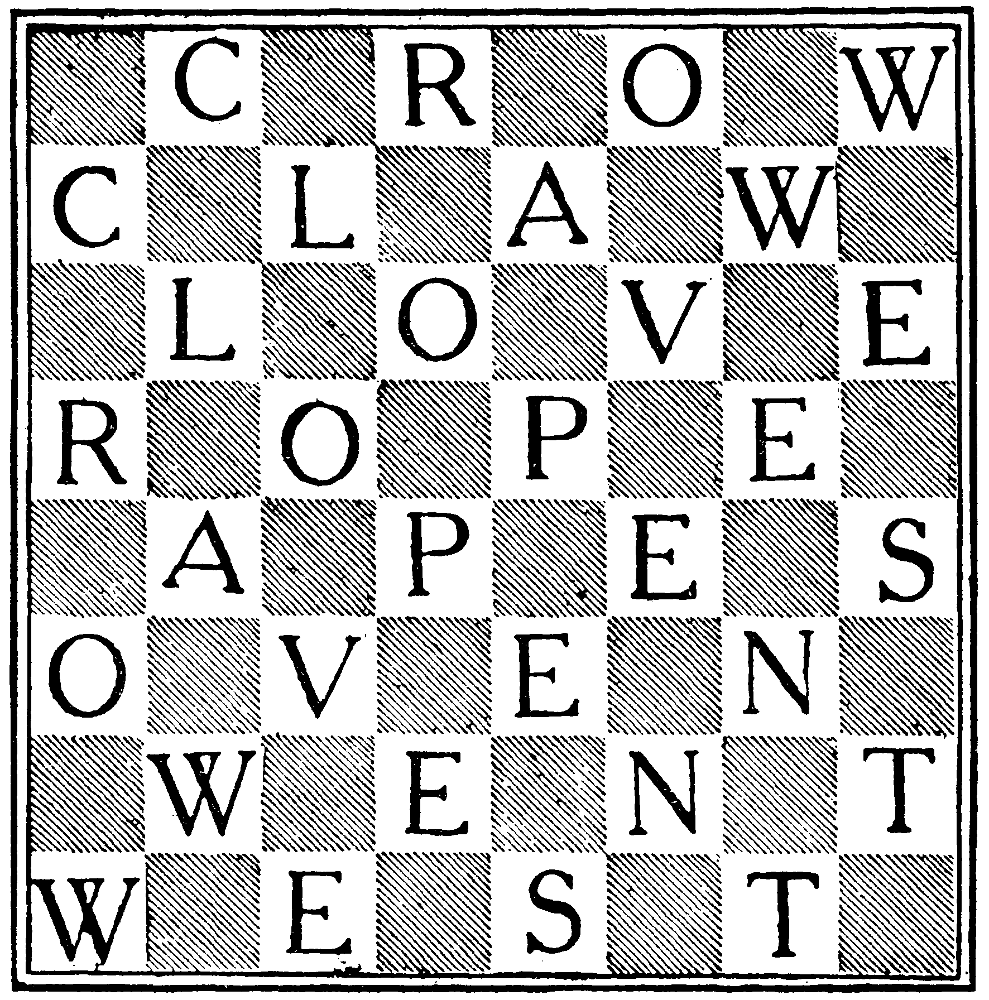
Return to solution
No. XXXIX
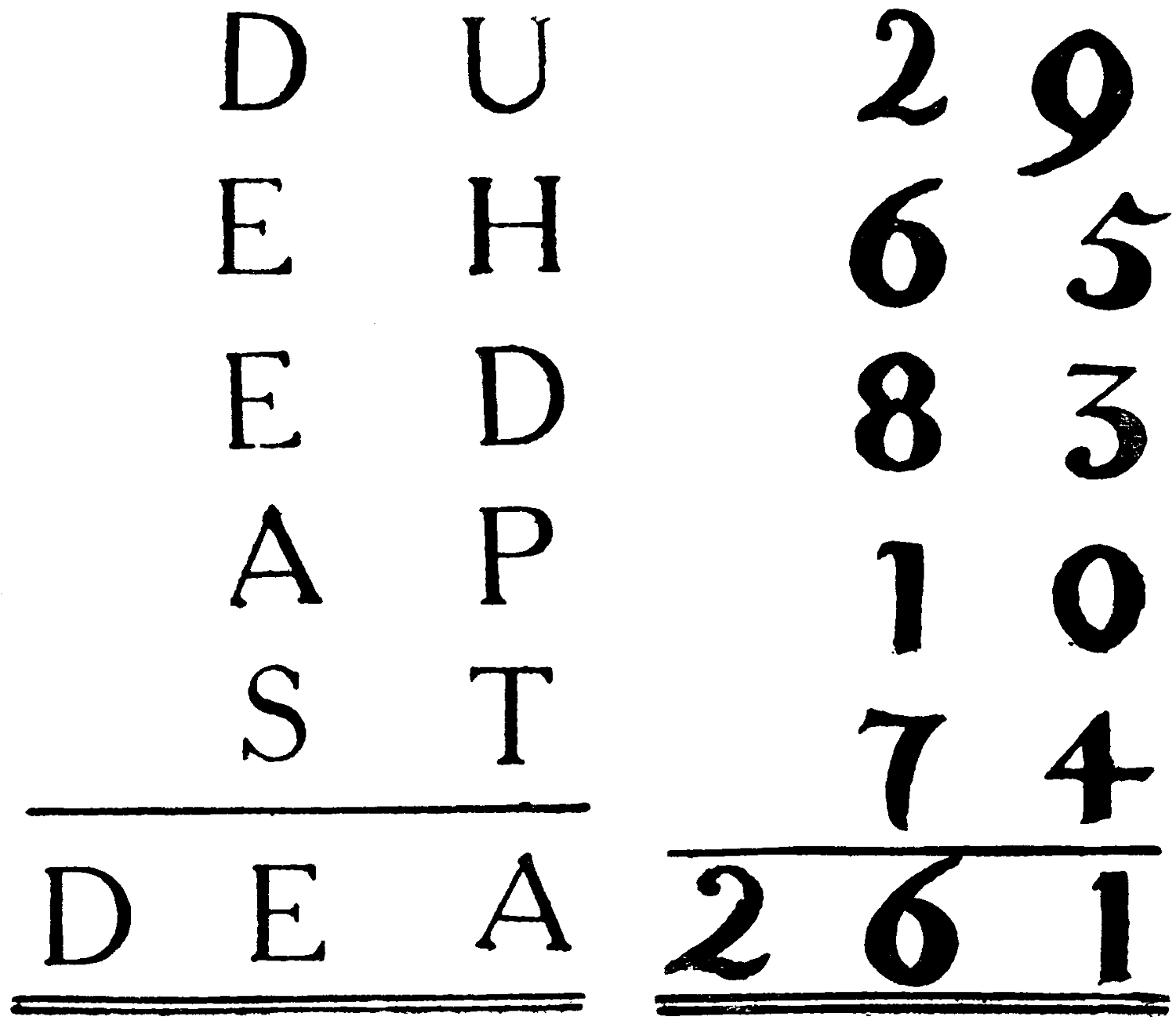
Return to solution
No. XL
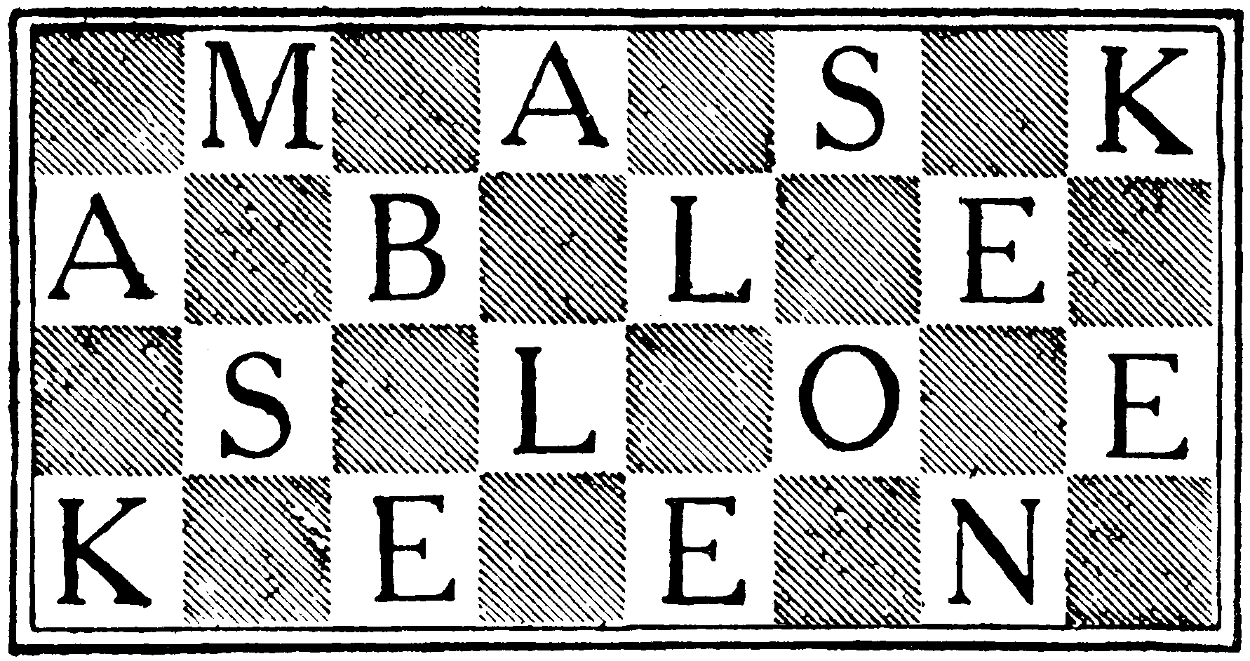
Return to solution
No. XLI
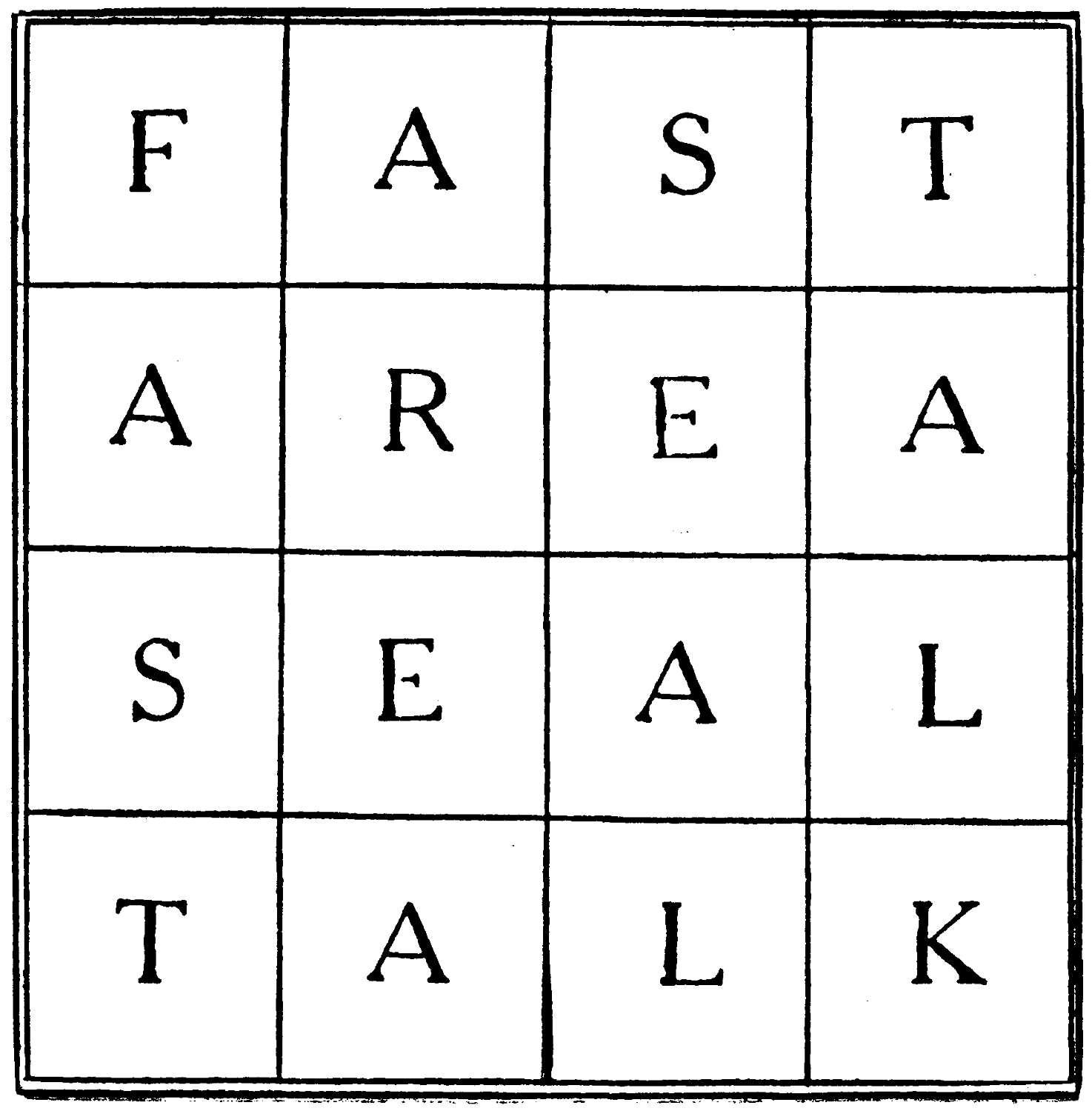
Return to solution
No. XLII
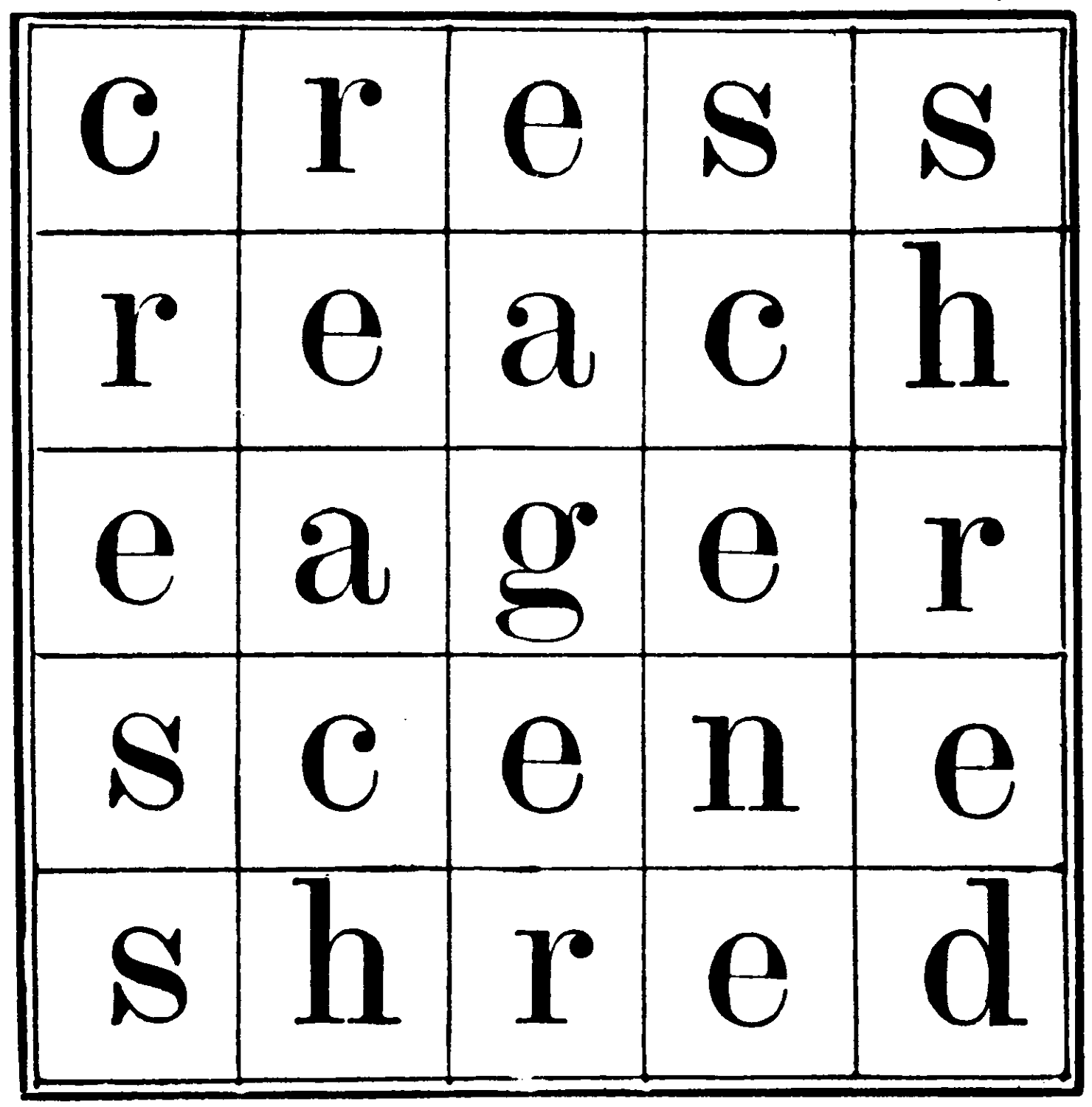
Return to solution
No. LXVII

Return to solution
No. LXVIII
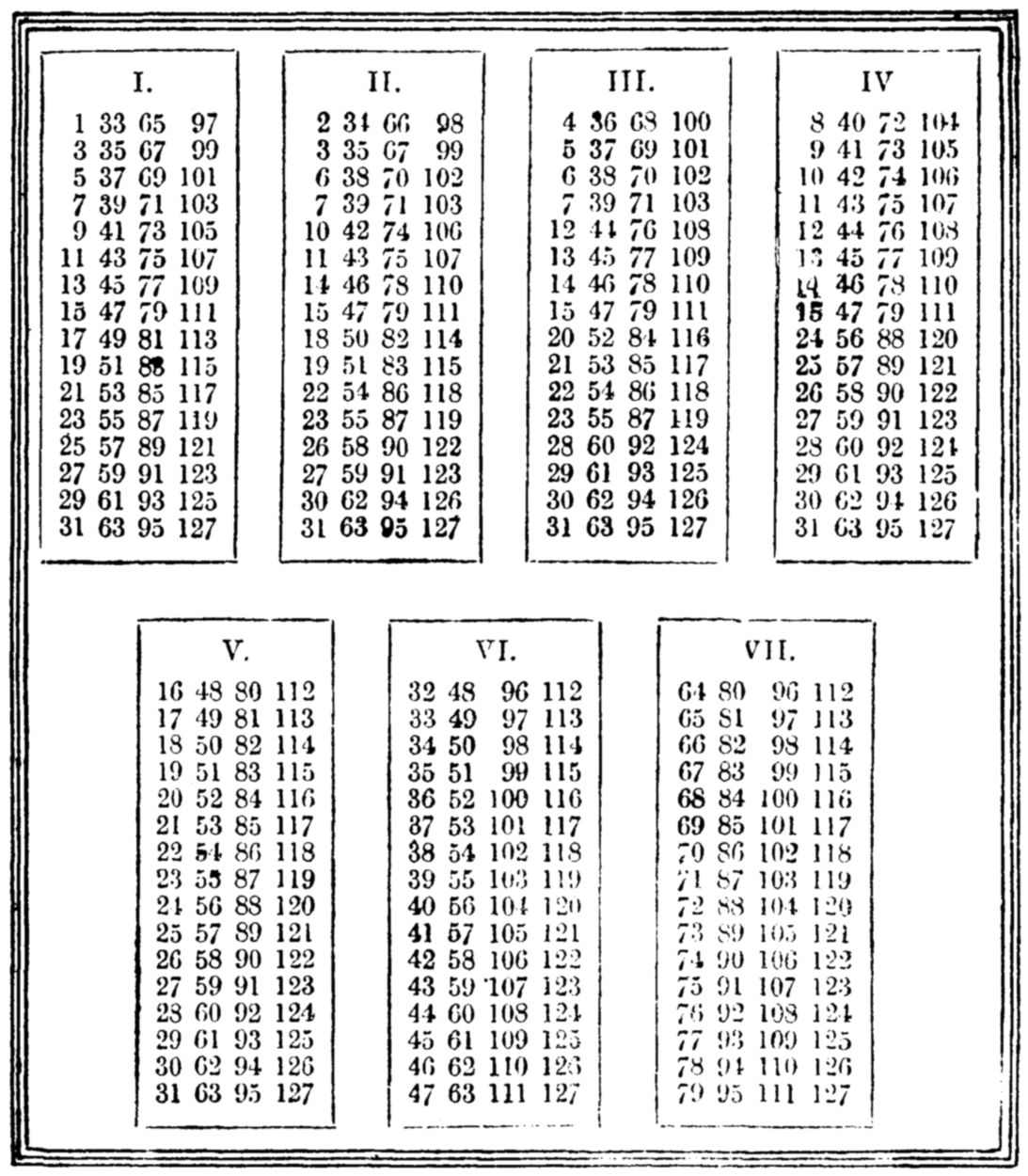
Return to solution
No. LXXI
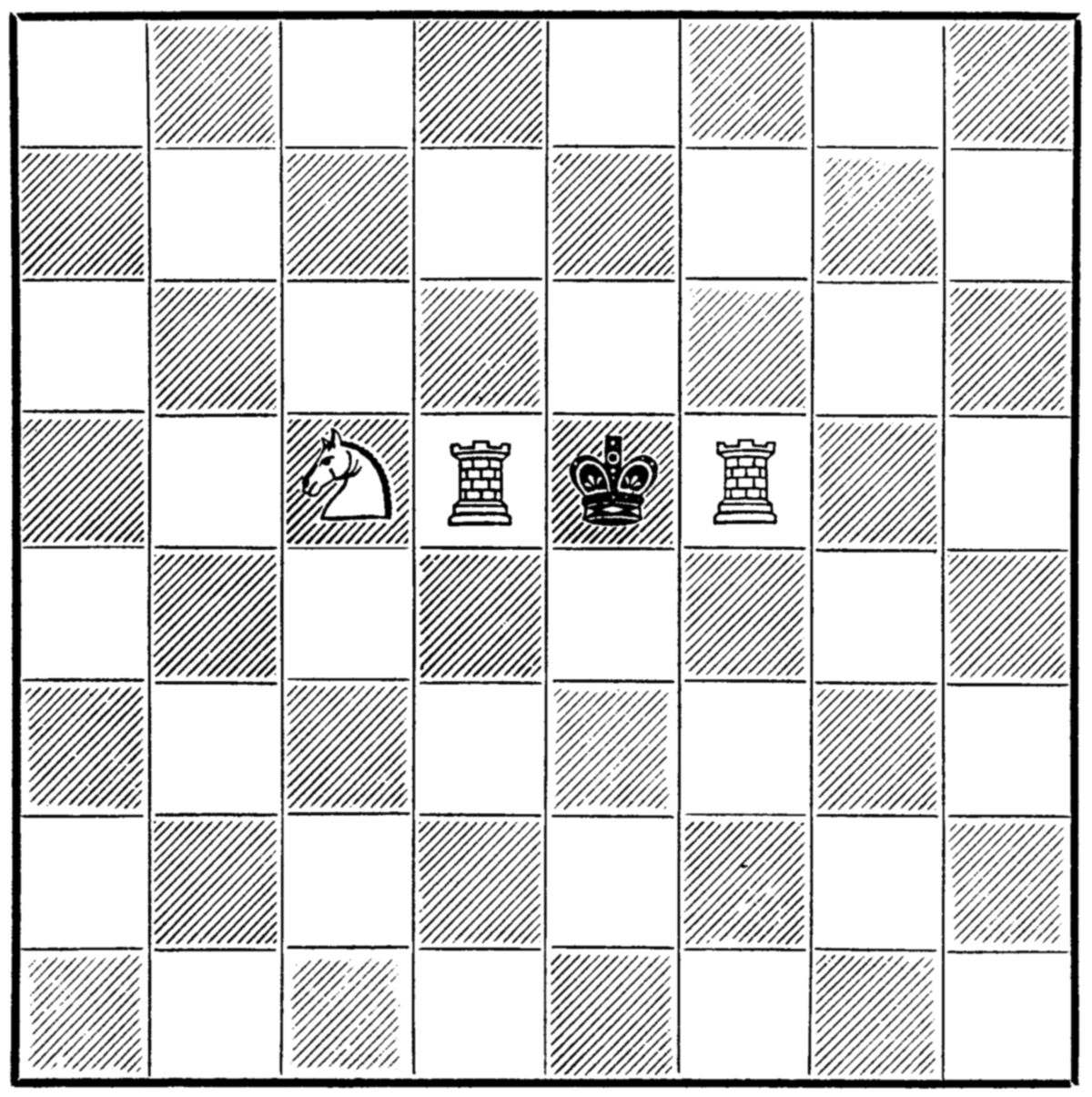
Return to solution
No. LXXIX
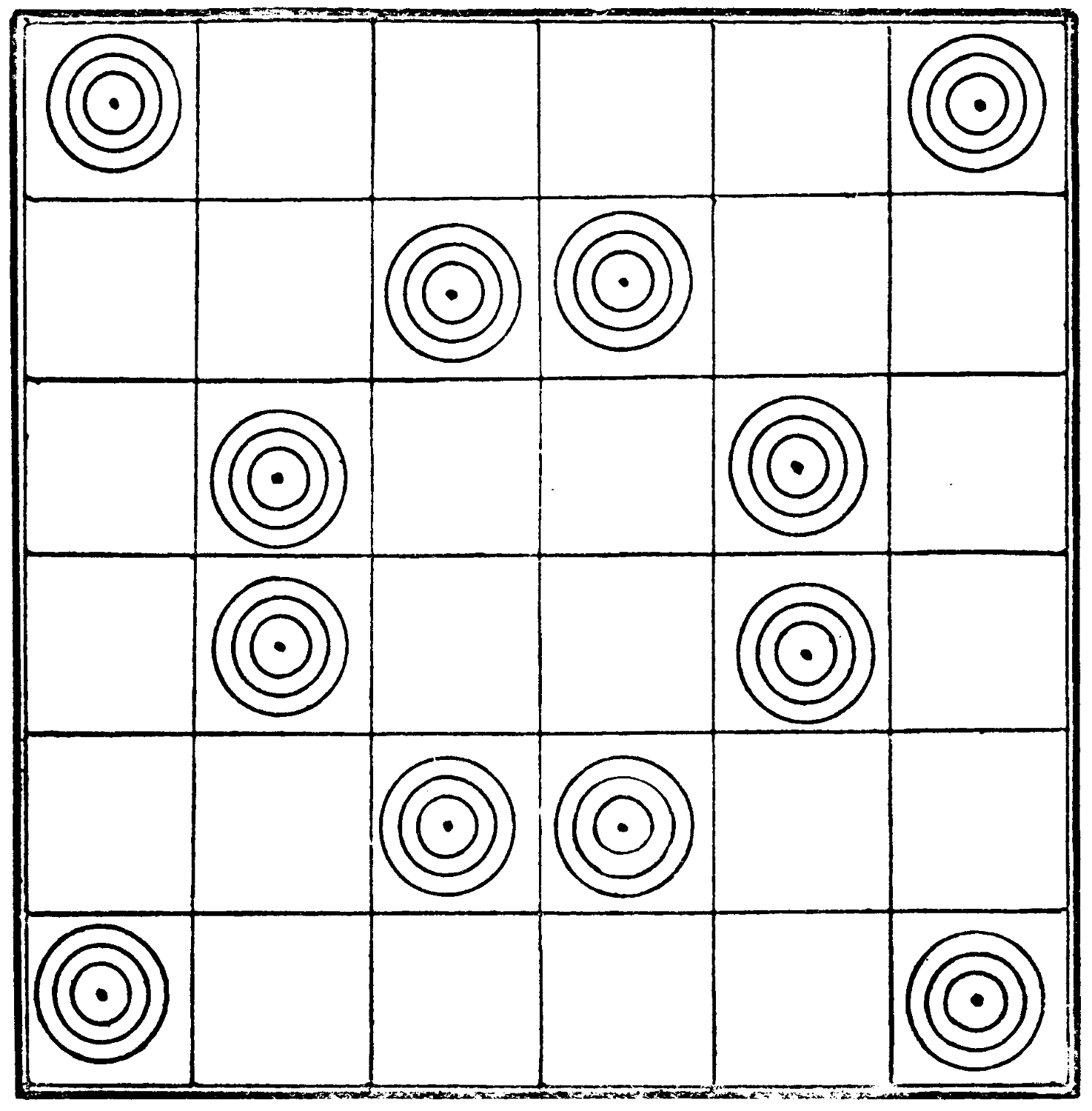
Return to solution
No. LXXXV
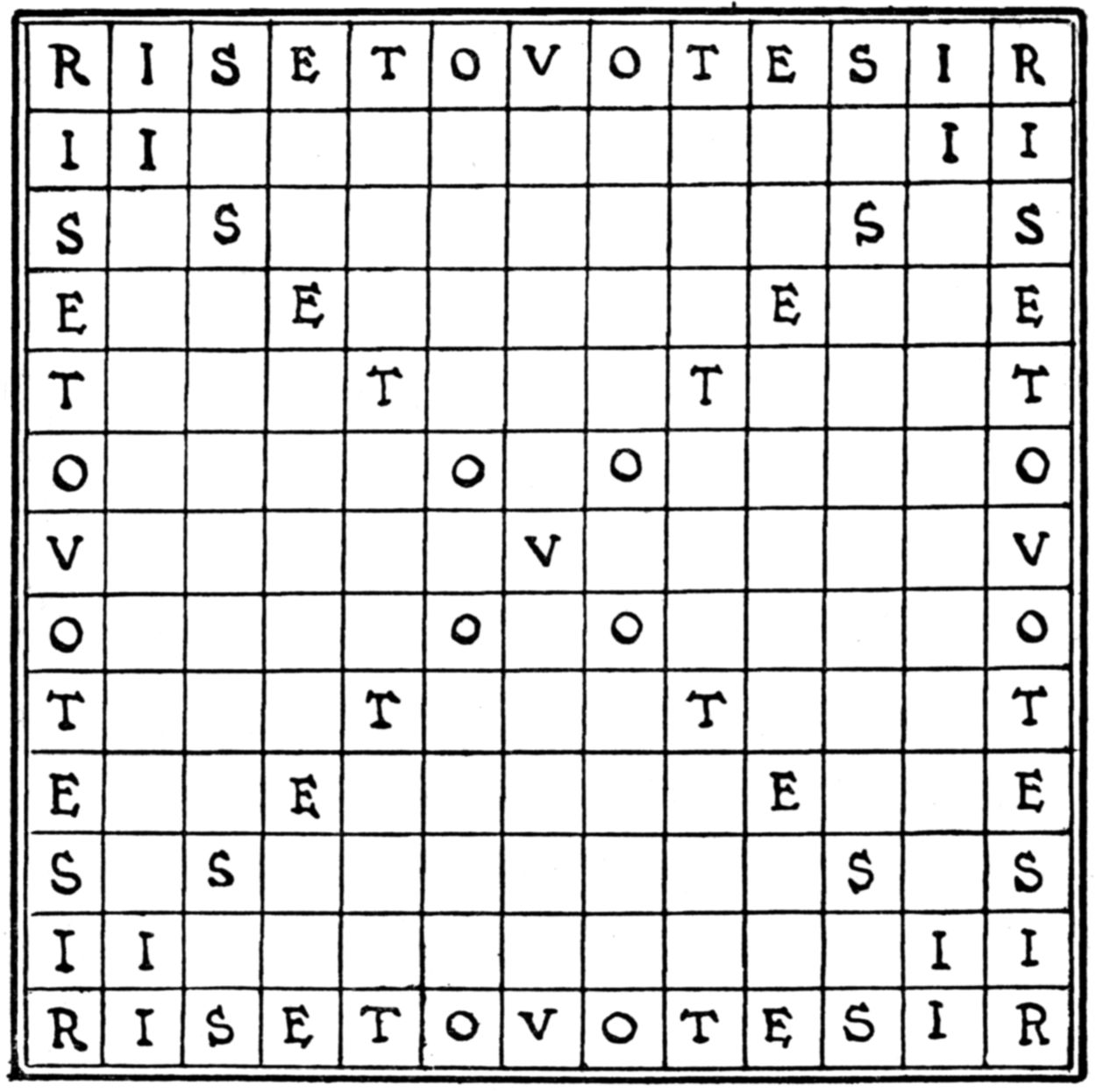
Return to solution
No. LXXXVII
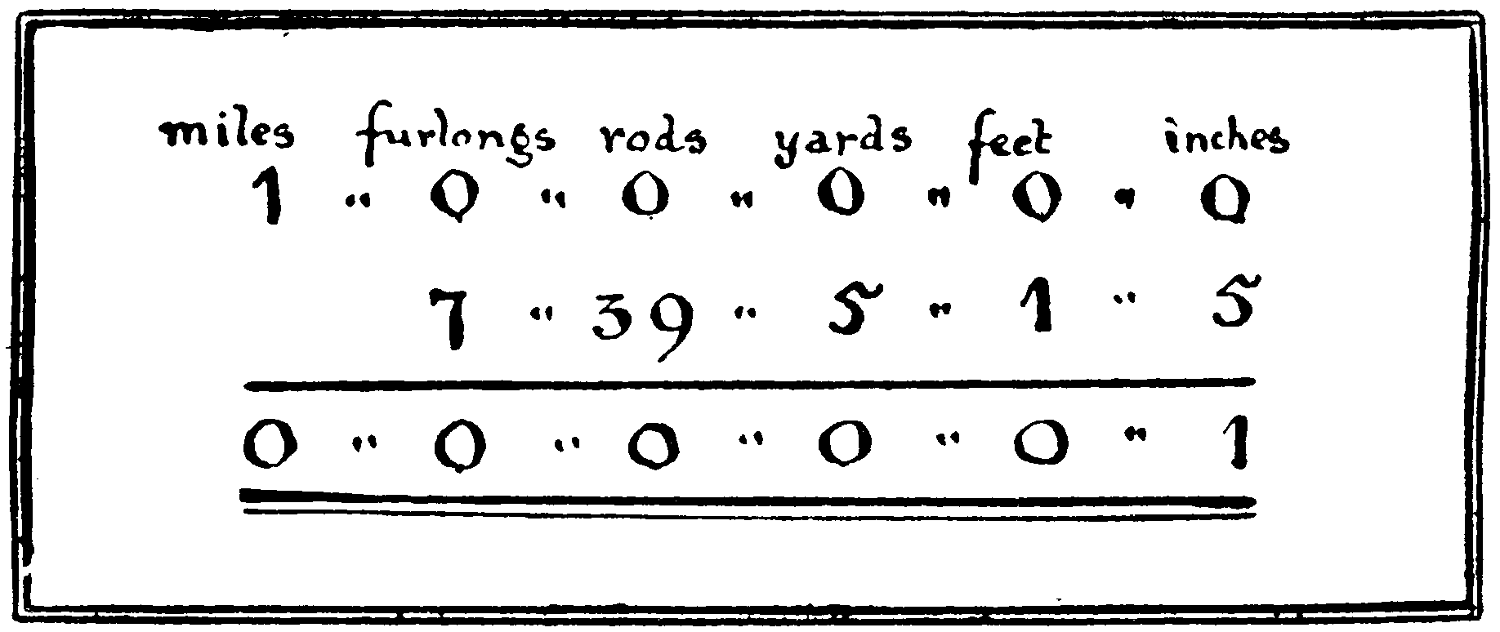
Return to solution
No. LXXXIX
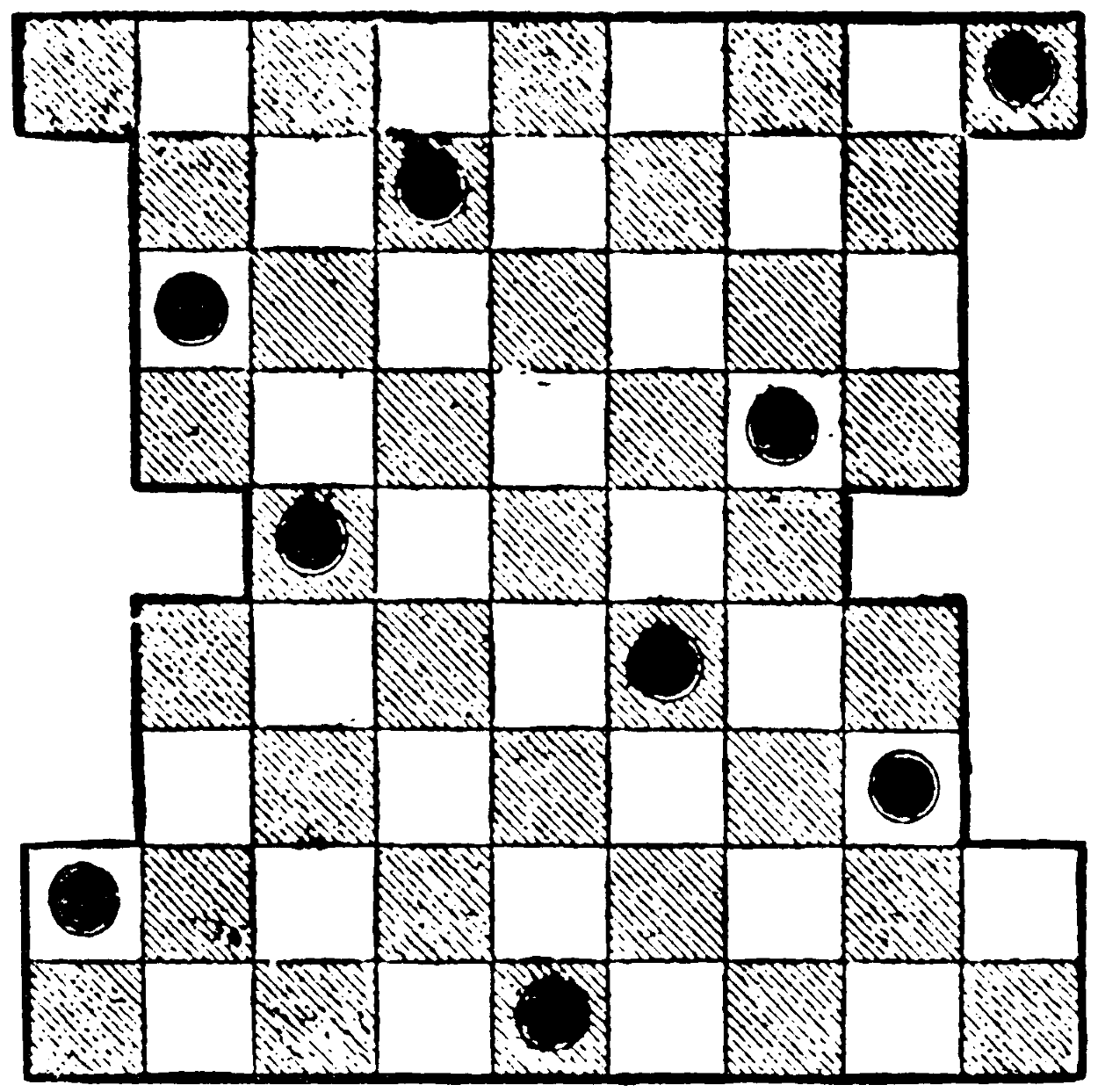
Return to solution
No. XC
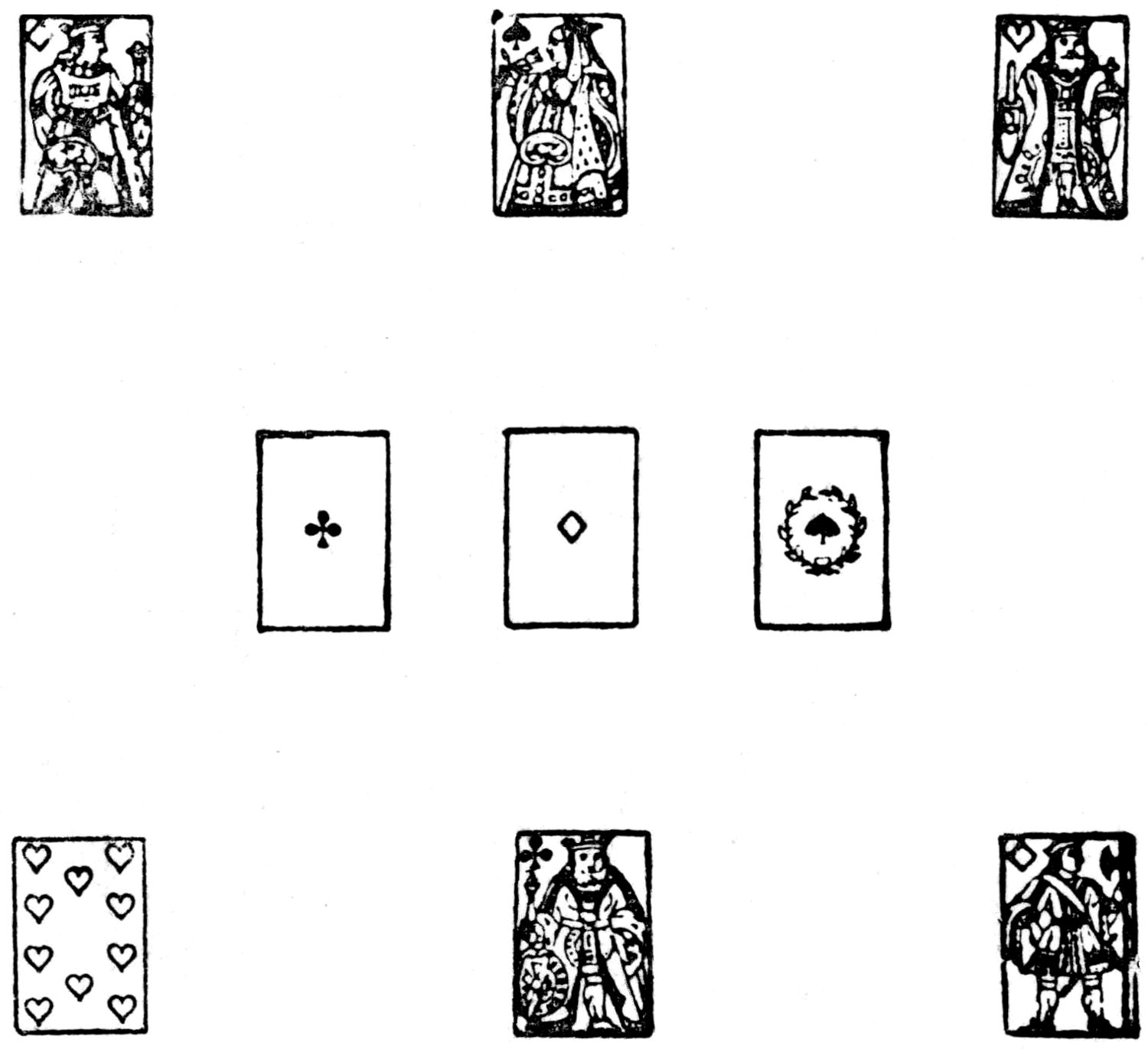
Return to solution
No. XCII
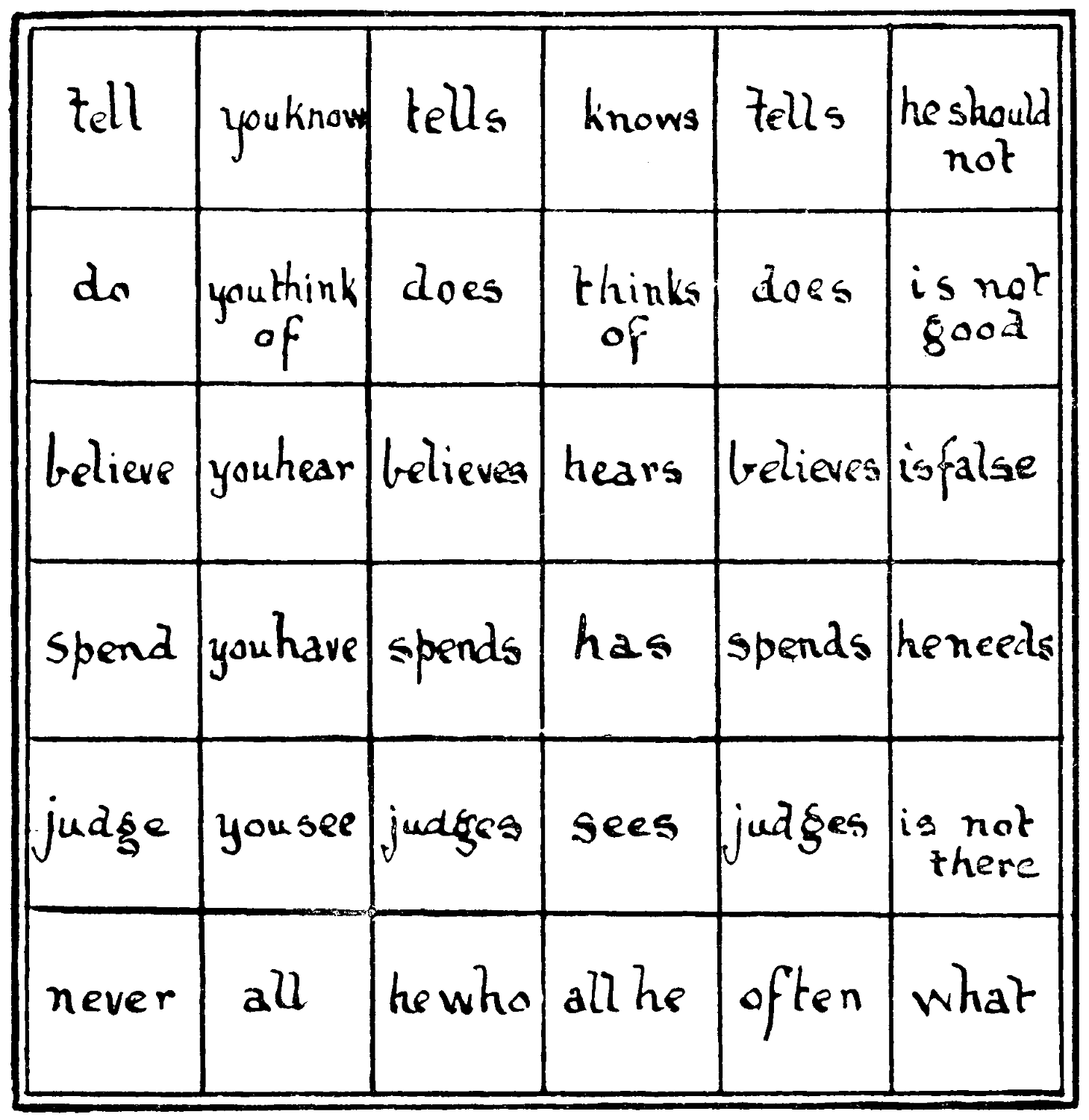
Return to solution
No. XCVI
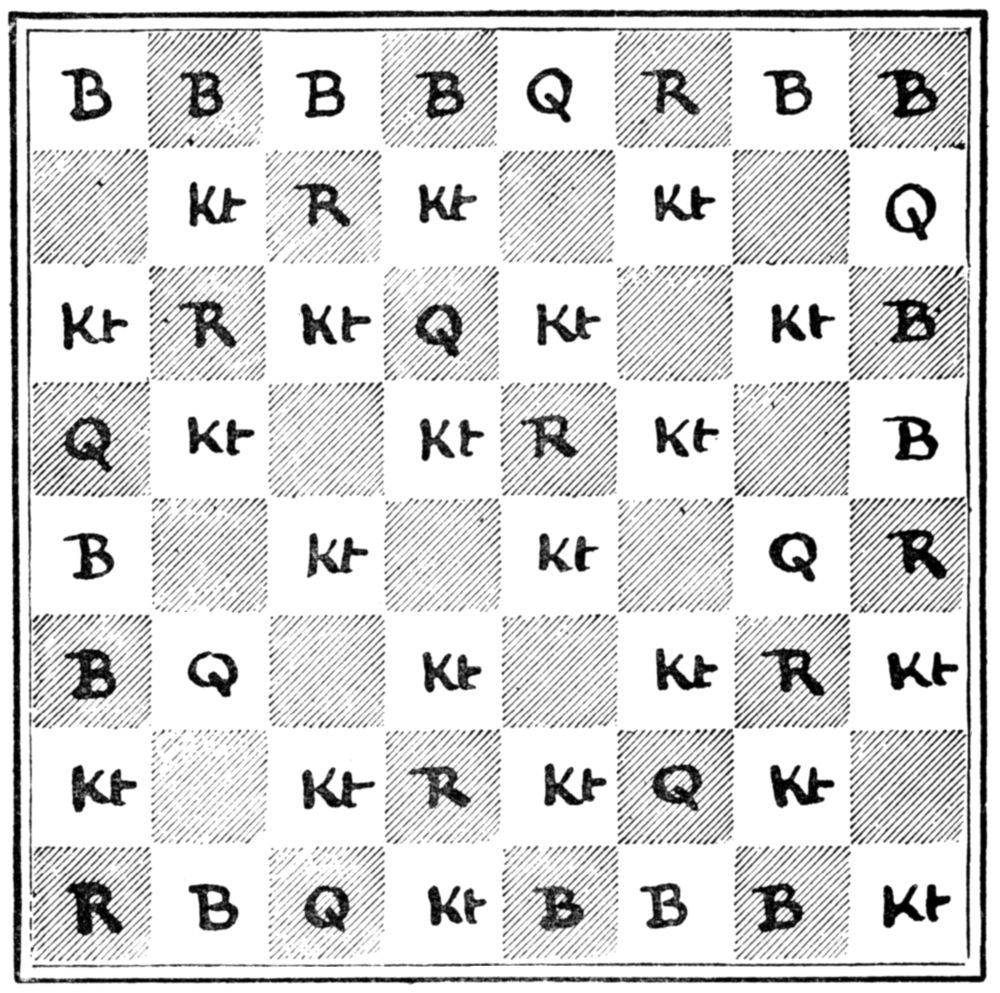
Return to solution
No. CII
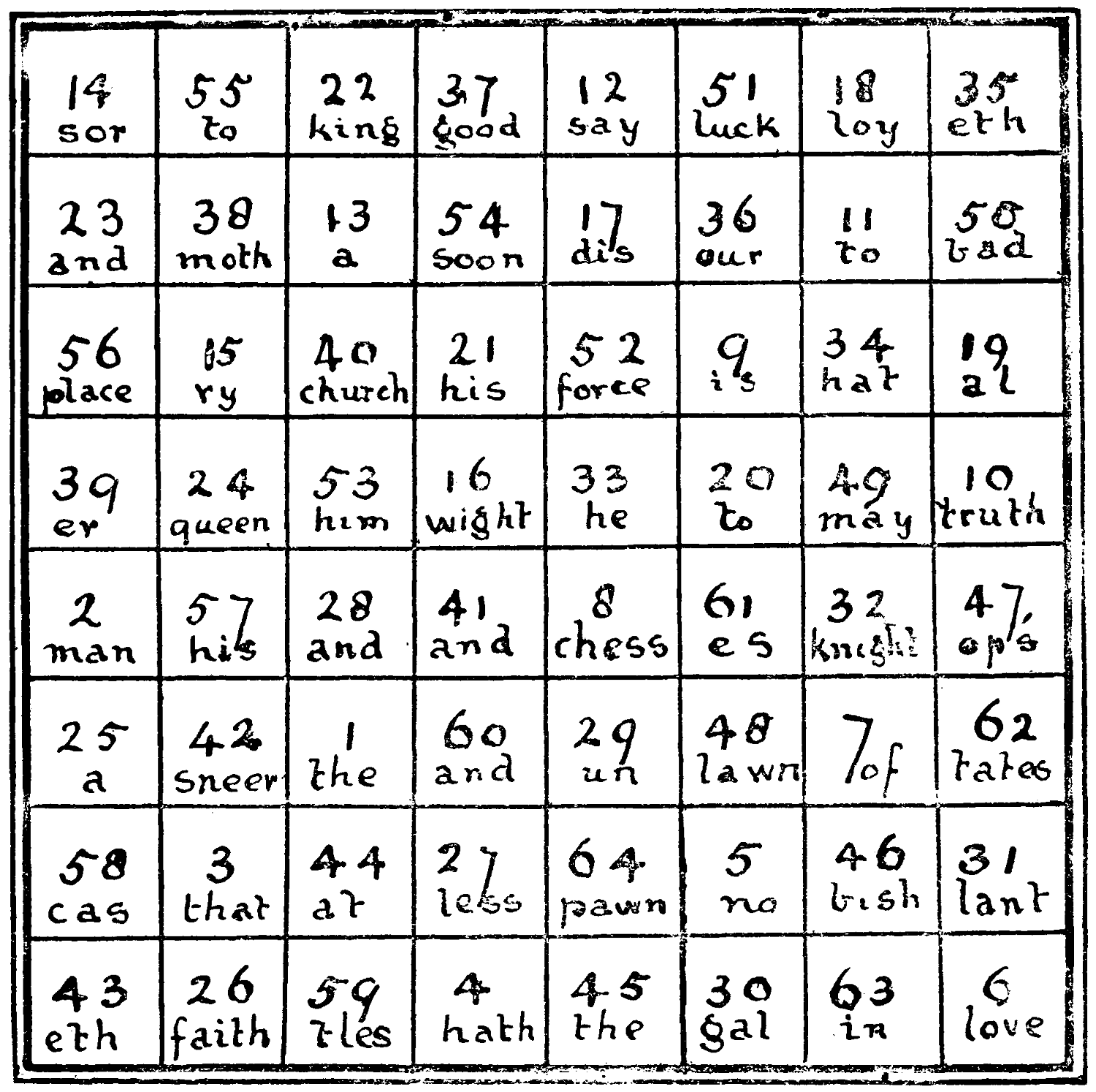
Return to solution
1
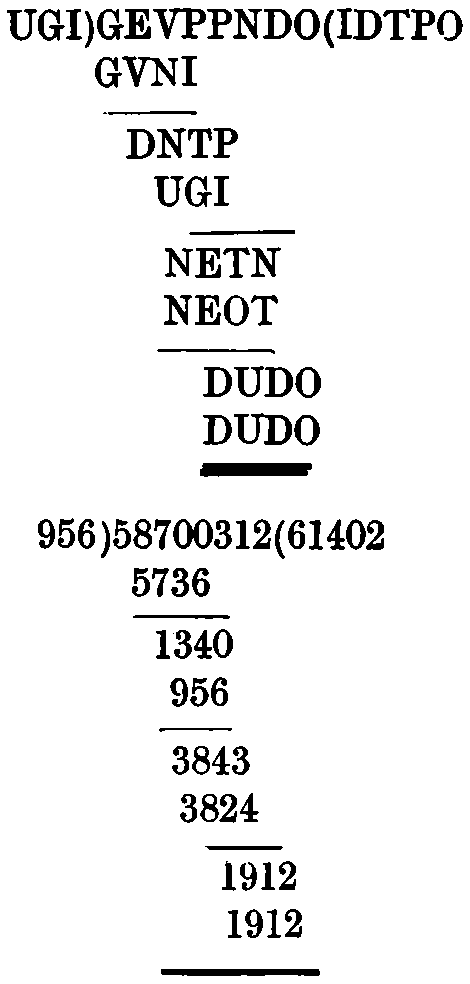
Return to solution
3
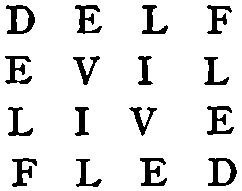
Return to solution
4
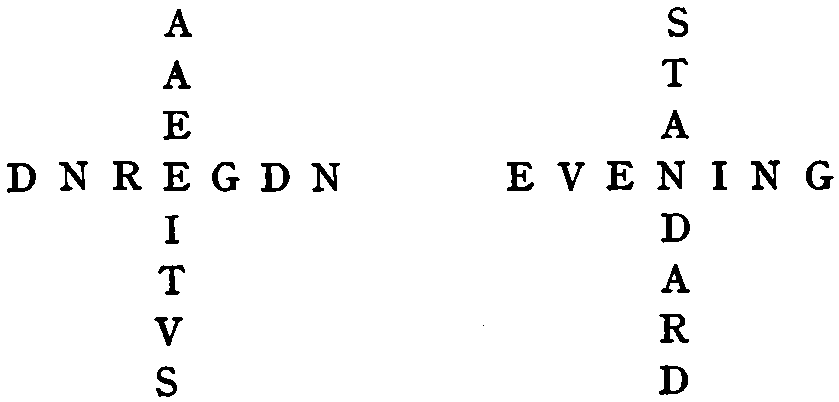
Return to solution
6
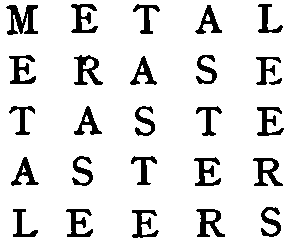
Return to solution
7
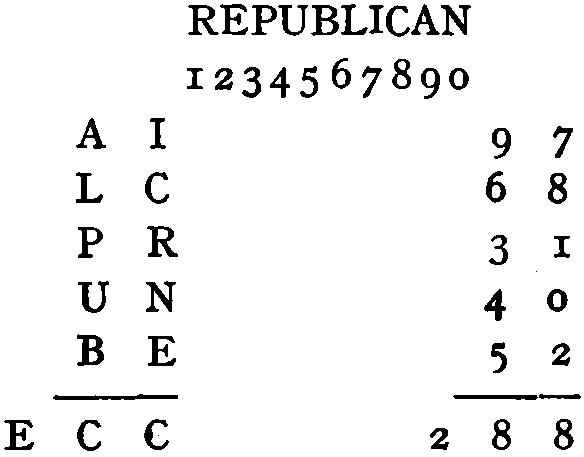
Return to solution
8
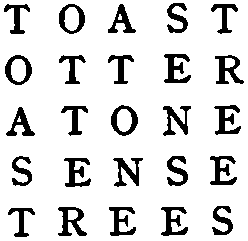
Return to solution
11
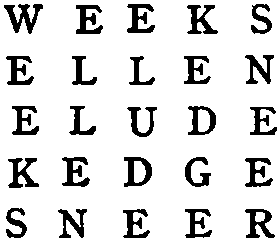
Return to solution
17
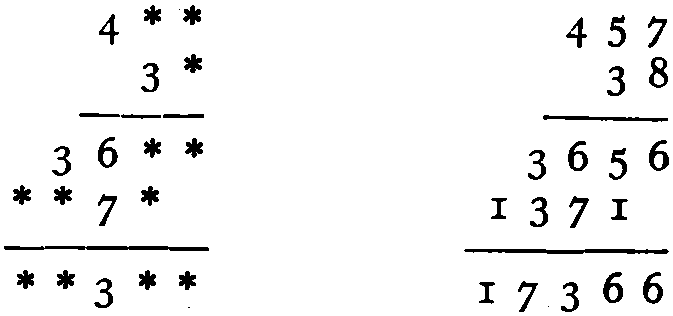
Return to solution
53

Return to solution
Transcriber’s Notes
Inconsistent spelling, hyphenation, capitalisation, etcetera have been retained, unless listed under Changes below.
Unless listed below, the riddles, puzzles and tricks and their solutions are given here as printed in the source document, even though some of them arguably contain ambiguities, errors and/or misprints. Inconsistencies in lay-out between the puzzles and their solutions have not been standardised.
The source document has several pages that contain a Pictured Puzzle at the top (Roman numerals) and one or more Word Play puzzles or jokes (Latin numerals). This has been retained in this text; any auto-generated Tables of Contents may therefore look jumbled up with intermixed Roman and Latin numerals.
Depending on the hard- and software used to read this text and on their settings, not all elements may display as intended. The larger diagrams may be illegible on small screens or in small windows.
Where possible and relevant, illustrations have been “transcribed”, occasionally discarding some of the ornamentation. For reference and for the sake of completeness, images of the transcribed illustrations have been provided at the end of this e-book, with hyperlinks (“Image”) pointing to them. Hyperlinks from these images point back to the riddle, puzzle, etc. (“Return to description”) or to its solution (“Return to solution”). In addition, hyperlinks are provided from the puzzles etc. to their solutions (“Solution”) and from the solutions back to the puzzle etc. (“Return to description”).
Table of Contents, page 130: The Enigmas, Charades, Puzzles, &c., &c. do not actually start on this page (they start on page 2), but there are no more Pictured Puzzles and Word Play from this page on.
Page 49, Se Pierot or Lun: possibly an error for See Pierot or L’un or Le Pierot or L’un.
Page 60, No. LX: the description is confusing, as the puzzle consists of drawing the four dotted lines, and they are therefore not given.
Page 89 and 263, Pictured puzzle LXXXIX and solution: either the puzzle or the solution has been printed upside-down in the source document.
Page 114, ... as nearly as possible of the size and pattern ...: based on the size of the physical book (around 7″ or 18 cm tall), the boomerang’s width would be some 3″ or 7.5 cm.
Page 149, ... six single words: the solution provided gives five single words.
Page 205, Solution IX: the table as printed lacks values for Opposite pairs of short diagonals (of which there are four) and Such combinations as 482, 484, 472, 470 (of which there ought to be two in order to reach the given total).
Changes made
In the source document, jokes, riddles and puzzles may be split over multiple pages (for example, Word Play 5 may be found on page 7 (first part) and page 9 (second part)). In this e-text, the second part has been re-combined with the first, and references to the separate first and second parts have been deleted.
Some minor obvious typographical errors have been corrected silently. Similarly, minor discrepancies (such as the number of blanks or periods) have been rectified silently. Fractions (the forms x⁄y, xy and x-y all occur in the source document) have (bar a single exception) been standardised to x⁄y.
Unless they fitted better within the text paragraphs, illustrations, verses, diagrams, etc. have been moved out of the text paragraphs. The footnote has been moved to directly underneath the Word Play in which it is referenced.
Texts in a dashed box has been transcribed from the accompanying diagram or illustration, and does not appear as text in the source document.
Page 10: ... cut of my head; changed to ... cut off my head;
Page 62: ... thought myself happy to win her ... changed to ... I thought myself happy to win her ... (cf. solution).
Page 89: ... indentations do not effect ... changed to ... indentations do not affect ....
Page 93: the logogriph has been laid out as in the solution on page 305.
Page 110-111: Word Play 92 in this text (Missing Words) was erroneously numbered 93 (first part) and 39 (second part) in the source document.
Page 130: “Tis an absurdity to say ... changed to ’Tis an absurdity to say ....
Page 139: !” inserted after the dots cf. solution.
Page 144, Nr. 176, last line: space inserted between F and R in R FR H; H T G changed to H T N G.
Page 152: ... his destination from these words.” changed to ... his destination from these words?
Page 196: ... sa Majéste impériale ... changed to ...sa Majesté impériale ...; ... a jamais! changed to ... à jamais!
Page 197-198: Odds and Ends 38 appears twice; the second one has been renamed 38a.
Page 201: ... a flock of sheep in a fold enclosed by 10 hurdles ... changed to ... a flock of sheep in a fold enclosed by 100 hurdles ....
Page 294: Number 34 inserted before first solution.
Page 309: The Houses of Parliament and Westminster Abbey changed to The Houses of Parliament and Westminster Abbey.
Page 310: The words italics are spelt ... changed to The words in italics are spelt ....
Page 379: vis inertiœ changed to vis inertiæ.